Birds of United States of America in taxonomic hierarchy
Schellente am Südende des Pfäffikersee Ich hätte gern ein besseres Foto aber die Schellenten waren nur etwa 100 Meter vom
Weg entfernt und dazu hinter Schilf. Auch mein 600mm Objektiv hat nicht gereicht,
aber zugegeben, ein Stativ hätte geholfen. 2021-01-26 15.36.26 Pfäffikersee
First observed in 🇨🇭 on 2021-01-26.
This bird appears across the great seas in the following continents:
Europe, North America.
Etymology: Nabu: Schellenten verdanken ihren Namen dem pfeifenden und wie ein Klingeln («Schellen») tönenden Fluggeräusch. [Vogelwarte.ch erklärt: ]
Gruener Kopf mit gelbem Auge (Goldeneye), weisser Kreis zwischen Auge und (schwarzem) Schnabel, weisser Bauch und Seiten mit etwa 5 duennen schwarzen Streifen, schwarzer Ruecken. In Island gibt's eine sehr aehnliche Ente und in kleineren Mengen auch diese.
Wintergast am Pfäffikersee.
Vocalization: ![]() Male display sound a dry nasal disyllabic "Ka-weerr". First note introductory and second longer and descending. Usually accompanied by back-throwing head motion. Female: dry harsh "aahrrrr aahrrrr aahrrrr ". Wings make a characteristic whistling sound. [Link]
Male display sound a dry nasal disyllabic "Ka-weerr". First note introductory and second longer and descending. Usually accompanied by back-throwing head motion. Female: dry harsh "aahrrrr aahrrrr aahrrrr ". Wings make a characteristic whistling sound. [Link]
Physical details: length=42-50 cm,
wingspan=65-80 cm,
weight=650-1200 g
Habitats:
River and lake

Wikipedia: Bufflehead Source: OTHER
1200px-Bucephala-albeola-007.jpg
General: ![]() The bufflehead (Bucephala albeola) is a small sea duck of the genus Bucephala, the goldeneyes. This species was first described by Carl Linnaeus in his landmark 1758 10th edition of Systema Naturae as Anas albeola.[2]
[more]
The bufflehead (Bucephala albeola) is a small sea duck of the genus Bucephala, the goldeneyes. This species was first described by Carl Linnaeus in his landmark 1758 10th edition of Systema Naturae as Anas albeola.[2]
[more]
Spatelenten, Myvatn, Iceland. 2015-06-05 11.20.16 Iceland
First observed in Iceland on 2015-06-05.
This bird appears across the great seas in the following continents:
Europe, North America.
![]() Barrow's goldeneye (Bucephala islandica) is a medium-sized sea duck of the genus Bucephala, the goldeneyes. This bird was named after Sir John Barrow. The genus name is derived from Ancient Greek boukephalos, "bullheaded", from bous, "bull " and kephale, "head", a reference to the bulbous head shape of the bufflehead. The species name islandica means Iceland.[2]
[more]
Barrow's goldeneye (Bucephala islandica) is a medium-sized sea duck of the genus Bucephala, the goldeneyes. This bird was named after Sir John Barrow. The genus name is derived from Ancient Greek boukephalos, "bullheaded", from bous, "bull " and kephale, "head", a reference to the bulbous head shape of the bufflehead. The species name islandica means Iceland.[2]
[more]
Mittelsaeger Weibchen auf Lago Maggiore, Locarno. 2021-04-06 13.18.48 Northern Lago Maggiore
First observed in 🇨🇭 on 2021-04-06.
This bird appears across the great seas in the following continents:
Europe, North America.
Personal notes: ![]() Zuerst gesehen in Lago Maggiore in Locarno. Jan 2022 auch als Wintergast am Pfaeffikersee. [Link]
Zuerst gesehen in Lago Maggiore in Locarno. Jan 2022 auch als Wintergast am Pfaeffikersee. [Link]
Appearance and identification: ![]() In winter you can admire a few of these birds with the straggly tuft. [Link]
In winter you can admire a few of these birds with the straggly tuft. [Link]
Habitats:
River and lake
Looks similar to:
Greater scaup.
Gänsesäger am Nordende des Pfäffikersee 2021-01-26 17.02.58 Pfäffikersee
First observed in 🇨🇭 on 2021-01-26.
This bird appears across the great seas in the following continents:
Europe, North America.
Zuerst gesehen am Pfäffikersee.
Vocalization: ![]() Male: Mostly heard when courting. A twanging, disyllabic "whip-ooooo", first syllable ascending and second whistle-like and rapidly falling. Female: A coarse "ahrrr ahrrrr", or a raspy drawn "ah-ahrrrrrr ah-ahrrrrr", slightly rising, then falling in pitch. Also various cackling sounds. [Link]
Male: Mostly heard when courting. A twanging, disyllabic "whip-ooooo", first syllable ascending and second whistle-like and rapidly falling. Female: A coarse "ahrrr ahrrrr", or a raspy drawn "ah-ahrrrrrr ah-ahrrrrr", slightly rising, then falling in pitch. Also various cackling sounds. [Link]
Physical details: length=58-66 cm,
wingspan=82-97 cm,
weight=900-2100 g
Habitats:
River and lake
Call:
Automatically generated from Xeno-Canto recording
♫ Source: BirdNet
20210510_090939 birdnet 1539 - Common Merganser plus Golden Oriole - = - Common Merganser - Locarno.mp3
2021-05-10 09.09.39 Locarno (song?)
Eiderente, vom Steg aus gesehen in Rapperswil. 2021-02-12 13.42.20 Rapperswil
First observed in Iceland on 2015-06-09.
This bird appears across the great seas in the following continents:
Europe, North America.
Etymology: Nabu: Auch heute noch erinnert ihr wissenschaftlicher Name an die Bedeutung ihrer isolierenden Daunen für die Menschen. Übersetzt bedeutet ihr Name nämlich „die Allerweichste mit dem schwarzen Körper“. [Link]
Geography: ![]() Die im Norden Europas häufige und wegen ihren Daunenfedern bekannte Eiderente war in der Schweiz früher ein seltener Gast. Doch in der zweiten Hälfte des 20. Jahrhunderts erfolgten mehrere grosse Einflüge. Dank der Wandermuschelvermehrung war das Nahrungsangebot ausreichend und die Vögel verbrachten zunehmend den Sommer bei uns. Mittlerweile gehört die Eiderente sogar zu den Brutvögeln, was für einen ans Meer angepassten Vogel bemerkenswert ist. [Link]
Die im Norden Europas häufige und wegen ihren Daunenfedern bekannte Eiderente war in der Schweiz früher ein seltener Gast. Doch in der zweiten Hälfte des 20. Jahrhunderts erfolgten mehrere grosse Einflüge. Dank der Wandermuschelvermehrung war das Nahrungsangebot ausreichend und die Vögel verbrachten zunehmend den Sommer bei uns. Mittlerweile gehört die Eiderente sogar zu den Brutvögeln, was für einen ans Meer angepassten Vogel bemerkenswert ist. [Link]
Calls: ![]() Males call a typical, pleasant, clear, 2-3 second long "aaaooooooh". Starting on a low note, slowly ascending and ending on a descending note. Usually accompanied by the female "ga ga ga ga". [Link]
Males call a typical, pleasant, clear, 2-3 second long "aaaooooooh". Starting on a low note, slowly ascending and ending on a descending note. Usually accompanied by the female "ga ga ga ga". [Link]
Physical details: length=50-71 cm,
wingspan=80-108 cm,
weight=1500-2800 g
Habitats:
River and lake
Profile Wikipedia eBird Audubon AllAboutBirds Xeno-Canto

Wikipedia: King eider Source: OTHER
1200px-King_Eider_%28Somateria_spectabilis%29_%2813667616745%29.jpg
General: ![]() The king eider (pronounced /ˈaɪ.dər/) (Somateria spectabilis) is a large sea duck that breeds along Northern Hemisphere Arctic coasts of northeast Europe, North America and Asia. The birds spend most of the year in coastal marine ecosystems at high latitudes, and migrate to Arctic tundra to breed in June and July. They lay four to seven eggs in a scrape on the ground lined with grass and down.
[more]
The king eider (pronounced /ˈaɪ.dər/) (Somateria spectabilis) is a large sea duck that breeds along Northern Hemisphere Arctic coasts of northeast Europe, North America and Asia. The birds spend most of the year in coastal marine ecosystems at high latitudes, and migrate to Arctic tundra to breed in June and July. They lay four to seven eggs in a scrape on the ground lined with grass and down.
[more]
Calls: ![]() Male: Calls similar to Eider but easily distinguished by the vibrating quality. A "aaaooooooh" (shorter in duration than Eider) Starting on a low note, slowly ascending and ending on a descending note with a distinct vibrato/pulse. Often in the form of three calls: "oohh, a-ohhh hahahaoohohohoh". Usually accompanied by the female "ga ga ga ga". [Link]
Male: Calls similar to Eider but easily distinguished by the vibrating quality. A "aaaooooooh" (shorter in duration than Eider) Starting on a low note, slowly ascending and ending on a descending note with a distinct vibrato/pulse. Often in the form of three calls: "oohh, a-ohhh hahahaoohohohoh". Usually accompanied by the female "ga ga ga ga". [Link]
Physical details: length=47-63 cm,
wingspan=86-102 cm,
weight=1500-2000 g
Mother and 4 of 9 babies on the Pfäffikersee 2020-05-20 09.12.44 Pfäffikersee
First observed in 🇨🇭 on 2020-05-20.
This bird appears across the great seas in the following continents:
Europe, North America, South America, Africa.
Common waterbird at Pfäffikersee
Etymology: ![]() Der heutige Name kann als Hinweis auf ihre Brutplätze verstanden werden, zu denen auf Stock gesetzte Weiden, Weidengebüsch oder auch Reisighaufen gehören.
['Stock' wird weiter erklärt: Als Stockausschlag bezeichnet man bei Bäumen und Sträuchern Triebe, die nach dem Verlust der primären Sprossachse
neu aus dem Stumpf oder Stubben (der dann „Stock“ genannt wird) austreiben.] [Link]
Der heutige Name kann als Hinweis auf ihre Brutplätze verstanden werden, zu denen auf Stock gesetzte Weiden, Weidengebüsch oder auch Reisighaufen gehören.
['Stock' wird weiter erklärt: Als Stockausschlag bezeichnet man bei Bäumen und Sträuchern Triebe, die nach dem Verlust der primären Sprossachse
neu aus dem Stumpf oder Stubben (der dann „Stock“ genannt wird) austreiben.] [Link]
![]() The name 'was derived from the Old French malart or mallart for "wild drake"' [Link]
The name 'was derived from the Old French malart or mallart for "wild drake"' [Link]
Vocalization: ![]() Female: A distinct coarse, laughing quacking; "haaa ha ha ha ha ha", with first note accented and then descending in pitch. Male: a more silent, very nasal "rriib". [Link]
Female: A distinct coarse, laughing quacking; "haaa ha ha ha ha ha", with first note accented and then descending in pitch. Male: a more silent, very nasal "rriib". [Link]
Calls: ![]() Display call a high-pitched short whistle. [Link]
Display call a high-pitched short whistle. [Link]
Physical details: length=50-65 cm,
wingspan=81-98 cm,
weight=750-1450 g
Habitats:
River and lake
Krickente am Aa-Bach beim Südende des Pfäffikersee 2021-01-26 15.41.54 Pfäffikersee
First observed in 🇨🇭 on 2021-01-26.
This bird appears across the great seas in the following continents:
Europe, North America, South America, Africa, Asia.
Wintergast am Teich am Aa-Bach beim Südende des Pfäffikersee
Etymology: ![]() Die hellen «krrik»-Rufe der stimmfreudigen Erpel verhalfen dieser Art zu ihrem deutschen Namen. [Link]
Die hellen «krrik»-Rufe der stimmfreudigen Erpel verhalfen dieser Art zu ihrem deutschen Namen. [Link]
Vocalization: ![]() Male: characteristic, short, highly resonant and metallic "plytt". A bit similar to Pintail, but higher pitched and lacking accompanying whistling sound. Female: various quacking sounds generally quicker paced, more nasal and noticeably higher pitched than Mallard. [Link]
Male: characteristic, short, highly resonant and metallic "plytt". A bit similar to Pintail, but higher pitched and lacking accompanying whistling sound. Female: various quacking sounds generally quicker paced, more nasal and noticeably higher pitched than Mallard. [Link]
Physical details: length=34-38 cm,
wingspan=58-64 cm,
weight=200-450 g
Habitats:
River and lake
Call:
Blup blup, fast wie vom Computer generiert, fur mich nohe Noten (obwohl Sonogram nur 2.5 KHz zeigt)
Krickente Ruf von XenoCanto
♫ Krickente Ruf von XenoCanto Source: XENOCANTO
XC619133-Krickente von Peter Bosman, Belgium.mp3
(call)

Call attributes:
Call melody: simple rhythmic, slow, Frequency: low (1-3 KHz),
Loeffelenten am Greifensee bei Silberweide Es gab dutzende davon, dazwischen eine Krickente. 2021-02-08 15.20.36
First observed in 🇨🇭 on 2021-02-08.
This bird appears across the great seas in the following continents:
Europe, North America, South America, Africa.
Wintergast am Greifensee.
PK: white, black, rust-brown, yellow eyes, black spoonbill, red legs.
Vocalization: ![]() Male is characteristic and most often heard: A hoarse nasal knocking sound "took took", often staccato or disyllabic. Female similar to Mallard but flatter and more creaking. [Link]
Male is characteristic and most often heard: A hoarse nasal knocking sound "took took", often staccato or disyllabic. Female similar to Mallard but flatter and more creaking. [Link]
Physical details: length=44-52 cm,
wingspan=70-84 cm,
weight=470-800 g
Habitats:
River and lake
Profile Wikipedia eBird Vogelwarte BirdLife ZH ornitho.ch Audubon AllAboutBirds Xeno-Canto BirdID NABU
Spiessente Paar. 2022-02-05 13.14.54 Klingnauer Stausee (man-made lake)
First observed in 🇨🇭 on 2022-02-05.
This bird appears across the great seas in the following continents:
Europe, North America, South America, Africa, Asia.
Long tailfeathers make the name obvious, also a thin white stripe from the white neck up the back of the head.
Vocalization: ![]() Female: similar to Mallards coarse laughing sound, but with a more emphasized first "haaa", and a more silent accelerating subsequent "laugh". Male: Pleasant, resonant "plop" similar to Teal, but lower pitched, richer, mellower and not so metallic. Accompanied by a higher pitched, slightly raspy whistling "aiiooo" rising and falling in pitch. [Link]
Female: similar to Mallards coarse laughing sound, but with a more emphasized first "haaa", and a more silent accelerating subsequent "laugh". Male: Pleasant, resonant "plop" similar to Teal, but lower pitched, richer, mellower and not so metallic. Accompanied by a higher pitched, slightly raspy whistling "aiiooo" rising and falling in pitch. [Link]
Physical details: length=51-66 cm,
wingspan=51-66 cm,
weight=500-1100 g
Habitats:
River and lake
Profile Wikipedia eBird Audubon AllAboutBirds Xeno-Canto

Wikipedia: Pacific black duck Source: OTHER
1200px-Pacific_Black_Duck_%28Anas_superciliosa%29_RWD2.jpg
This bird appears across the great seas in the following continents:
North America, Australia.
General: ![]() The Pacific black duck (Anas superciliosa), commonly known as the PBD, is a dabbling duck found in much of Indonesia, New Guinea, Australia, New Zealand, and many islands in the southwestern Pacific, reaching to the Caroline Islands in the north and French Polynesia in the east. It is usually called the grey duck in New Zealand, where it is also known by its Maori name, pārera.
[more]
The Pacific black duck (Anas superciliosa), commonly known as the PBD, is a dabbling duck found in much of Indonesia, New Guinea, Australia, New Zealand, and many islands in the southwestern Pacific, reaching to the Caroline Islands in the north and French Polynesia in the east. It is usually called the grey duck in New Zealand, where it is also known by its Maori name, pārera.
[more]

Wikipedia: American black duck Source: OTHER
1200px-Blackduck.jpg
![]() The American black duck (Anas rubripes) is a large dabbling duck in the family Anatidae. It was described by William Brewster in 1902. It is the heaviest species in the genus Anas, weighing 720–1,640 g (1.59–3.62 lb) on average and measuring 54–59 cm (21–23 in) in length with a 88–95 cm (35–37 in) wingspan. It somewhat resembles the female mallard in coloration, but has a darker plumage. The male and female are generally similar in appearance, but the male's bill is yellow while the female's is dull green with dark marks on the upper mandible. It is native to eastern North America. During the breeding season, it is usually found in coastal and freshwater wetlands from Saskatchewan to the Atlantic in Canada and the Great Lakes and the Adirondacks in the United States. It is a partially migratory species, mostly wintering in the east-central United States, especially in coastal areas.
[more]
The American black duck (Anas rubripes) is a large dabbling duck in the family Anatidae. It was described by William Brewster in 1902. It is the heaviest species in the genus Anas, weighing 720–1,640 g (1.59–3.62 lb) on average and measuring 54–59 cm (21–23 in) in length with a 88–95 cm (35–37 in) wingspan. It somewhat resembles the female mallard in coloration, but has a darker plumage. The male and female are generally similar in appearance, but the male's bill is yellow while the female's is dull green with dark marks on the upper mandible. It is native to eastern North America. During the breeding season, it is usually found in coastal and freshwater wetlands from Saskatchewan to the Atlantic in Canada and the Great Lakes and the Adirondacks in the United States. It is a partially migratory species, mostly wintering in the east-central United States, especially in coastal areas.
[more]
Profile Wikipedia eBird Audubon AllAboutBirds Xeno-Canto
MerlinBirdID says mottled ducks near Mark's place in St Petersburg - they resembled female mallards but darker, males have yellow bills, females they call olive but pictures show orange and brown too. 2023-09-25 09.52.18 Florida
First observed in Florida on 2023-09-25.
![]() The mottled duck (Anas fulvigula)[note 1] or mottled mallard is a medium-sized dabbling duck. It is intermediate in appearance between the female mallard and the American black duck. It is closely related to those species, and is sometimes considered a subspecies of the former, but this is inappropriate (see Systematics below).
[more]
The mottled duck (Anas fulvigula)[note 1] or mottled mallard is a medium-sized dabbling duck. It is intermediate in appearance between the female mallard and the American black duck. It is closely related to those species, and is sometimes considered a subspecies of the former, but this is inappropriate (see Systematics below).
[more]
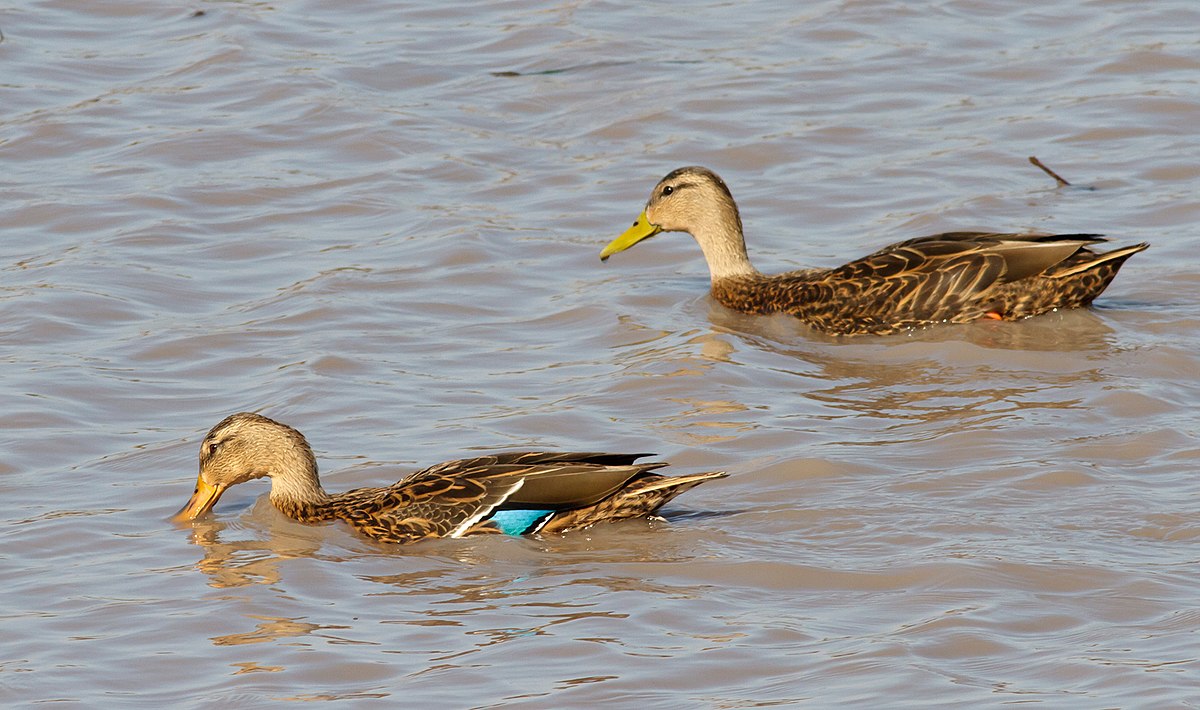
Wikipedia: Mexican duck Source: OTHER
1200px-Mexican_duck_breeding_pair.jpg
![]() The Mexican duck (Anas diazi,[1] and see below) is a species of dabbling duck that breeds in Mexico and the southwestern United States. Most of the population is resident, but some northern birds migrate south to Mexico in winter. The species also occurs widely, but in limited numbers, in Colorado in all seasons and there are photographs of birds referable to this taxon from Utah, Wyoming, Nebraska, and Montana.[2]
[more]
The Mexican duck (Anas diazi,[1] and see below) is a species of dabbling duck that breeds in Mexico and the southwestern United States. Most of the population is resident, but some northern birds migrate south to Mexico in winter. The species also occurs widely, but in limited numbers, in Colorado in all seasons and there are photographs of birds referable to this taxon from Utah, Wyoming, Nebraska, and Montana.[2]
[more]
Pfeifente Erpel , Neeracher Ried. Die zehnte Entenart, die ich gefunden habe. 2021-02-24 14.05.08 Neeracherried
First observed in 🇨🇭 on 2021-02-24.
This bird appears across the great seas in the following continents:
Europe, North America, Africa.
Etymology: ![]() Es ist der Ruf des Männchens, der zu dem deutschen Namen der Art geführt hat. Das Männchen leitet seine kurzen, scharfen, zwei- bis dreisilbigen pfeifenden wiu-Rufe häufig mit einem krr krkrkrr ein. [Link]
Es ist der Ruf des Männchens, der zu dem deutschen Namen der Art geführt hat. Das Männchen leitet seine kurzen, scharfen, zwei- bis dreisilbigen pfeifenden wiu-Rufe häufig mit einem krr krkrkrr ein. [Link]
Funny red head (made me confused it with the Kolbente) that's brown with a golden forehead (Kolbente is brown, a bit lighter at the back of the head) is the obvious characteristic. Also has a nice black and white pattern on its back and wings with white-rimmed black feathers at the end of the wing, a bit of white before a black butt.
Vocalization: ![]() Male: a pleasant high pitched whistle "piiiiuuu", rapidly rising in pitch and then falling. Quite vocal. Female: a harsh "kraaa kraaa kraa" more like female diving-ducks than other dabbling-ducks. [Link]
Male: a pleasant high pitched whistle "piiiiuuu", rapidly rising in pitch and then falling. Quite vocal. Female: a harsh "kraaa kraaa kraa" more like female diving-ducks than other dabbling-ducks. [Link]
Physical details: length=45-51 cm,
wingspan=75-86 cm,
weight=500-1000 g
Habitats:
River and lake
Call:
Pfeifen, fast wie ein Rotmilan oder Maeusebussard. Ton steigt und faellt!
Pfeifente von XenoCanto
♫ Pfeifente von XenoCanto Source: XENOCANTO
XC613742-Pfeifente von Adrien Mauss.mp3
(call)
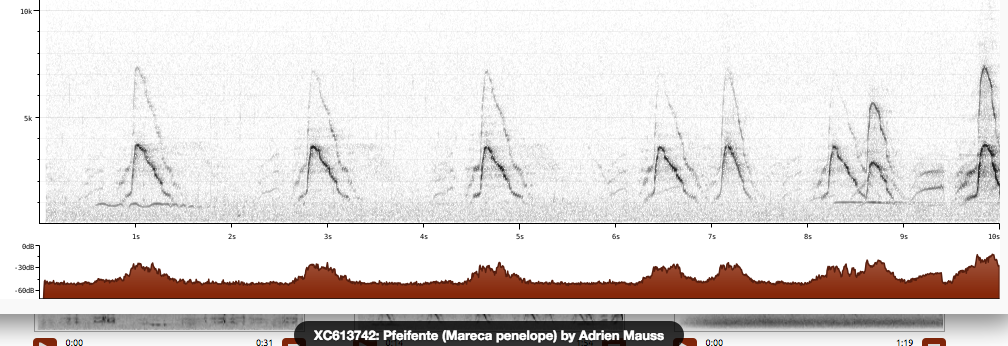
Call attributes:
Call melody: simple rhythmic, slow, Frequency: low (1-3 KHz),
Schnatterente am Greifensee bei Silberweide Es gab dutzende davon, dazwischen eine Krickente. 2021-02-08 15.45.18
First observed in 🇨🇭 on 2021-02-08.
This bird appears across the great seas in the following continents:
Europe, North America, Africa.
In my mind this is the chocolate duck.
Etymology: ![]() The etymology of the word gadwall is not known, but the name has been in use since 1666.[9] [Link]
The etymology of the word gadwall is not known, but the name has been in use since 1666.[9] [Link]
Nabu: Die Schnatterente fällt aber – wie ihr Name schon vermuten lässt – durch ihre Art der Nahrungssuche auf. Sie durchschnattert das Wasser mit ihrem Schnabel. [Link]
Chocolate bill, black-and-white pattern on head, shoulders, belly, sides of wings, chocolate patterned wings, black butt, a bit of white before the butt.
Appearance and identification: Nabu: Die Schnatterente ähnelt auf den ersten Blick so sehr der weiblichen Stockente, dass man diese schnell verwechseln kann. [Link]
Wintergast am Greifensee.
Calls: ![]() Males display-call a short dry rattling or croaking sound and some high whistling notes. Female quacking similar to Mallard, but drier and shriller. [Link]
Males display-call a short dry rattling or croaking sound and some high whistling notes. Female quacking similar to Mallard, but drier and shriller. [Link]
Physical details: length=46-56 cm,
wingspan=84-95 cm,
weight=550-1000 g
Habitats:
River and lake
Call:
Automatically generated from Xeno-Canto recording
♫ Schnatterenten, Moewen und an 29 Sekunden eindeutig ein Jet von Swiss, da wir in Neeracherried sehr nach am Kloten Flughafen sind, BirdNet schlaegt auch Teichrohrsaenger vor, wie auch ein Moewe-Typ aus Kalifornien. ![]() Source: Zoom H6 2021-10-24 13.12.46 Neeracherried (song?)
Source: Zoom H6 2021-10-24 13.12.46 Neeracherried (song?)

Wikipedia: American wigeon Source: OTHER
1200px-Anas_americana_-_drake.jpg
This bird appears across the great seas in the following continents:
Europe, North America, South America.
General: ![]() The American wigeon (Mareca americana), also known as the baldpate, is a species of dabbling duck found in North America. Formerly assigned to Anas, this species is classified with the other wigeons in the dabbling duck genus Mareca. It is the New World counterpart of the Eurasian wigeon. Mareca is from the Brazilian-Portuguese word Marréco for a small duck and americana refers to America.[2][3]
[more]
The American wigeon (Mareca americana), also known as the baldpate, is a species of dabbling duck found in North America. Formerly assigned to Anas, this species is classified with the other wigeons in the dabbling duck genus Mareca. It is the New World counterpart of the Eurasian wigeon. Mareca is from the Brazilian-Portuguese word Marréco for a small duck and americana refers to America.[2][3]
[more]
Tafelente in Rapperswil. 2021-02-12 13.34.38 Rapperswil
First observed in 🇨🇭 on 2021-02-08.
This bird appears across the great seas in the following continents:
Europe, North America, Africa.
Wintergast am Greifensee.
Etymology: ![]() Die in der deutschen Sprache übliche Bezeichnung Tafelente ist ein Hinweis auf das als schmackhaft angesehene Fleisch dieses Entenvogels. [Link]
Die in der deutschen Sprache übliche Bezeichnung Tafelente ist ein Hinweis auf das als schmackhaft angesehene Fleisch dieses Entenvogels. [Link]
Tafelente: Wiederspruch: wer isst ein Tier mit roten Augen?Rostbraun, schwarz, schwarz-weiss-gemustert, Schnabel schwarz UND weiss.
Vocalization: ![]() Female: a coarse "ahrrrrrrr-ahrrrrr-ahrrrr" with a vibrating quality. [Link]
Female: a coarse "ahrrrrrrr-ahrrrrr-ahrrrr" with a vibrating quality. [Link]
Calls: ![]() Male courting call a pleasant, drawn out, nasal whistle "tweeeeep", rising in pitch, often followed by a falling "puuuh" (e.g a long disyllabic tweeepuuuuuuh). Also a sharper "ki-ki-ki" or "ki-ki-kiko". [Link]
Male courting call a pleasant, drawn out, nasal whistle "tweeeeep", rising in pitch, often followed by a falling "puuuh" (e.g a long disyllabic tweeepuuuuuuh). Also a sharper "ki-ki-ki" or "ki-ki-kiko". [Link]
Physical details: length=42-49 cm,
wingspan=72-82 cm,
weight=650-1200 g
Habitats:
River and lake

Wikipedia: Greater scaup Source: OTHER
1200px-2017-03-24_Aythya_marila%2C_male%2C_Killingworth_Lake%2C_Northumberland_15.jpg
This bird appears across the great seas in the following continents:
Europe, North America.
Deutschland: Zugvogel, Wintergast RL R
Calls: ![]() Male call carries only a few meters: a whistling "po-ho" last syllable slowly descending. Female calls with harsh "harr-harrr-harrr". [Link]
Male call carries only a few meters: a whistling "po-ho" last syllable slowly descending. Female calls with harsh "harr-harrr-harrr". [Link]
Physical details: length=42-51 cm,
wingspan=72-84 cm,
weight=700-1300 g
Habitats:
River and lake
Looks similar to:
Red-breasted merganser.

Wikipedia: Redhead Source: OTHER
1200px-Woman_redhead_natural_portrait_1.jpg
General: ![]() Die Rotkopfente (Aythya americana) ist eine Tauchente aus der Familie der Entenvögel. Sie ist ein nordamerikanischer Brutvogel. In ihrem Federkleid ähnelt sie der ebenfalls in Nordamerika brütenden Riesentafelente und der in Europa beheimateten Tafelente. Die drei Arten können jedoch anhand ihrer Schnabelfärbung unterschieden werden. Die Riesentafelente hat einen durchgängig dunkelgrauen Schnabel. Die Stirn fällt außerdem flach ab, wodurch ihr Profil keilförmig wie bei der Eiderente wirkt. Die Tafelente hat eine schwarze Schnabelbasis, so dass der Schnabel in der Mitte ein hellgraues Band aufweist. Bei der Rotkopfente dagegen ist nur die Schnabelspitze dunkelgrau bis schwarz.
[more]
Die Rotkopfente (Aythya americana) ist eine Tauchente aus der Familie der Entenvögel. Sie ist ein nordamerikanischer Brutvogel. In ihrem Federkleid ähnelt sie der ebenfalls in Nordamerika brütenden Riesentafelente und der in Europa beheimateten Tafelente. Die drei Arten können jedoch anhand ihrer Schnabelfärbung unterschieden werden. Die Riesentafelente hat einen durchgängig dunkelgrauen Schnabel. Die Stirn fällt außerdem flach ab, wodurch ihr Profil keilförmig wie bei der Eiderente wirkt. Die Tafelente hat eine schwarze Schnabelbasis, so dass der Schnabel in der Mitte ein hellgraues Band aufweist. Bei der Rotkopfente dagegen ist nur die Schnabelspitze dunkelgrau bis schwarz.
[more]

Wikipedia: Lesser scaup Source: OTHER
1200px-Lesser_scaup_-_Aythya_affinis.jpg
![]() The lesser scaup (Aythya affinis) is a small North American diving duck that migrates south as far as Central America in winter. It is colloquially known as the little bluebill or broadbill because of its distinctive blue bill. The origin of the name scaup may stem from the bird's preference for feeding on scalp—the Scottish word for clams, oysters, and mussels; however, some credit it to the female's discordant scaup call as the name's source.[2] It is apparently a very close relative of the Holarctic greater scaup or "bluebill" (A. marila), with which it forms a superspecies.[3][4] The scientific name is derived from Ancient Greek aithuia an unidentified seabird mentioned by authors including Hesychius and Aristotle, and Latin, affinis "related to", from its resemblance to the greater scaup.[5]
[more]
The lesser scaup (Aythya affinis) is a small North American diving duck that migrates south as far as Central America in winter. It is colloquially known as the little bluebill or broadbill because of its distinctive blue bill. The origin of the name scaup may stem from the bird's preference for feeding on scalp—the Scottish word for clams, oysters, and mussels; however, some credit it to the female's discordant scaup call as the name's source.[2] It is apparently a very close relative of the Holarctic greater scaup or "bluebill" (A. marila), with which it forms a superspecies.[3][4] The scientific name is derived from Ancient Greek aithuia an unidentified seabird mentioned by authors including Hesychius and Aristotle, and Latin, affinis "related to", from its resemblance to the greater scaup.[5]
[more]
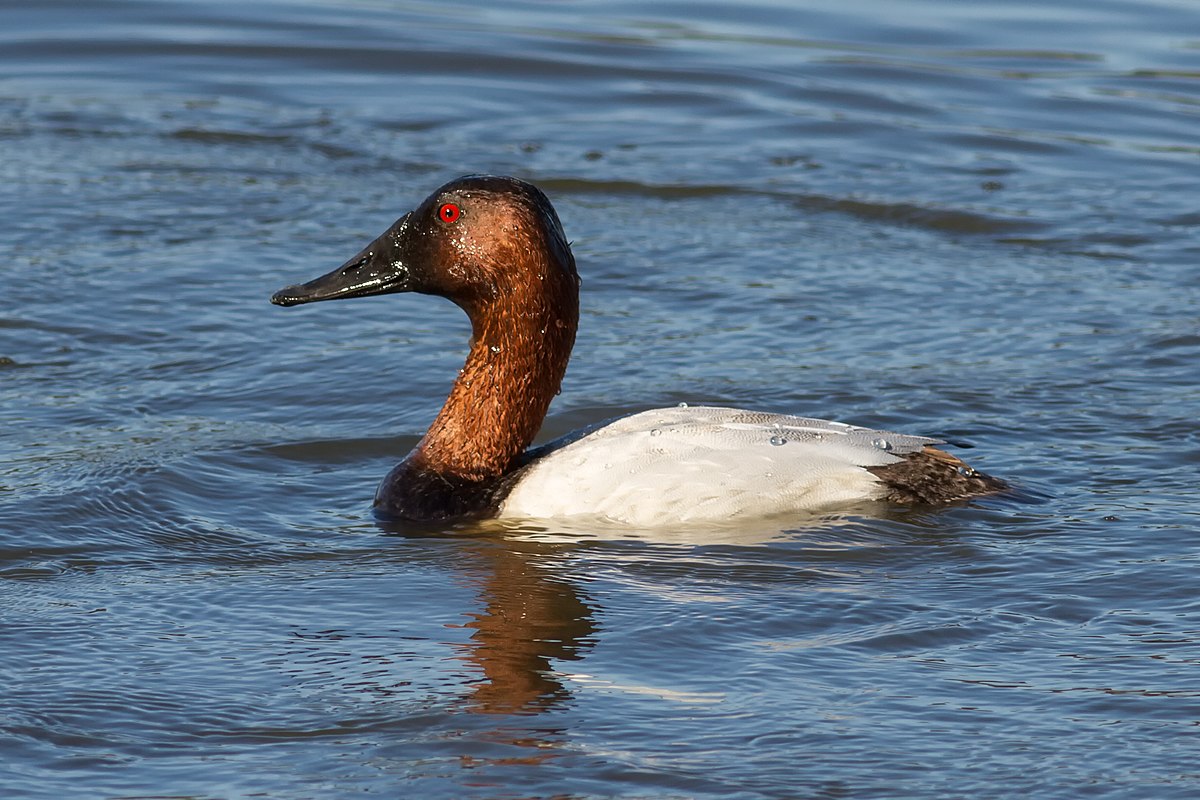
Wikipedia: Canvasback Source: OTHER
1200px-Aythya_valisineria_at_Las_Gallinas_Wildlife_Ponds.jpg
![]() The canvasback (Aythya valisineria) is a species of diving duck, the largest found in North America.
[more]
The canvasback (Aythya valisineria) is a species of diving duck, the largest found in North America.
[more]

Wikipedia: Ring-necked duck Source: OTHER
Aythya-collaris-001.jpg
![]() The ring-necked duck (Aythya collaris) is a diving duck from North America commonly found in freshwater ponds and lakes.[2] The scientific name is derived from Greek aithuia, an unidentified seabird mentioned by authors including Hesychius and Aristotle, and Latin collaris, "of the neck" from collum, "neck".[3]
[more]
The ring-necked duck (Aythya collaris) is a diving duck from North America commonly found in freshwater ponds and lakes.[2] The scientific name is derived from Greek aithuia, an unidentified seabird mentioned by authors including Hesychius and Aristotle, and Latin collaris, "of the neck" from collum, "neck".[3]
[more]
Nilgans am Südende des Greifensee 2021-02-08 15.21.56
First observed in Botswana on 2016-09-24.
This bird appears across the great seas in the following continents:
Europe, North America, Africa.
Wintergast am Greifensee. Invasiv. Nach Vogelwarte.ch: 'als Ziervogel im 18. Jahrhundert in Europa eingeführt...
Ausgehend von einer in den 1970er Jahren in den Niederlanden und Belgien gebildeten Population breitete sich die Nilgans rasant dem Rhein und seinen Nebenflüssen entlang aus und hat inzwischen auch die Schweiz erreicht.
Vocalization: ![]() Quite vocal when interacting. [Link]
Quite vocal when interacting. [Link]
Calls: ![]() Female calls may resemble RS, but are coarser, harder and trills are more rolling. Single calls are longer, and falls markedly in pitch. Male calls quite different, with husky, wheezing or hissing "kaahhh", or with the same timbre in series lika a steam engine. [Link]
Female calls may resemble RS, but are coarser, harder and trills are more rolling. Single calls are longer, and falls markedly in pitch. Male calls quite different, with husky, wheezing or hissing "kaahhh", or with the same timbre in series lika a steam engine. [Link]
Physical details: length=63-73 cm,
wingspan=134-154 cm,
weight=1500-2250 g

Wikipedia: Mandarin duck Source: OTHER
1200px-Aix_galericulata_-_Z%C3%BCrich_-_Hafen_Riesbach_2011-01-14_15-58-32.JPG
This bird appears across the great seas in the following continents:
Europe, North America, Africa.
Deutschland: etabliertes Neozoon, Brut-, Jahresvogel
Vocalization: ![]() Other sounds include a short and sharp, coot-like "ket", and a short "ack". [Link]
Other sounds include a short and sharp, coot-like "ket", and a short "ack". [Link]
Calls: ![]() Display call a thin, whistling and rapidly rising "hueessst, accompanied by deeper clappering sounds. [Link]
Display call a thin, whistling and rapidly rising "hueessst, accompanied by deeper clappering sounds. [Link]
Physical details: length=41-49 cm,
wingspan=68-74 cm,
weight=571-608 g
Habitats:
River and lake
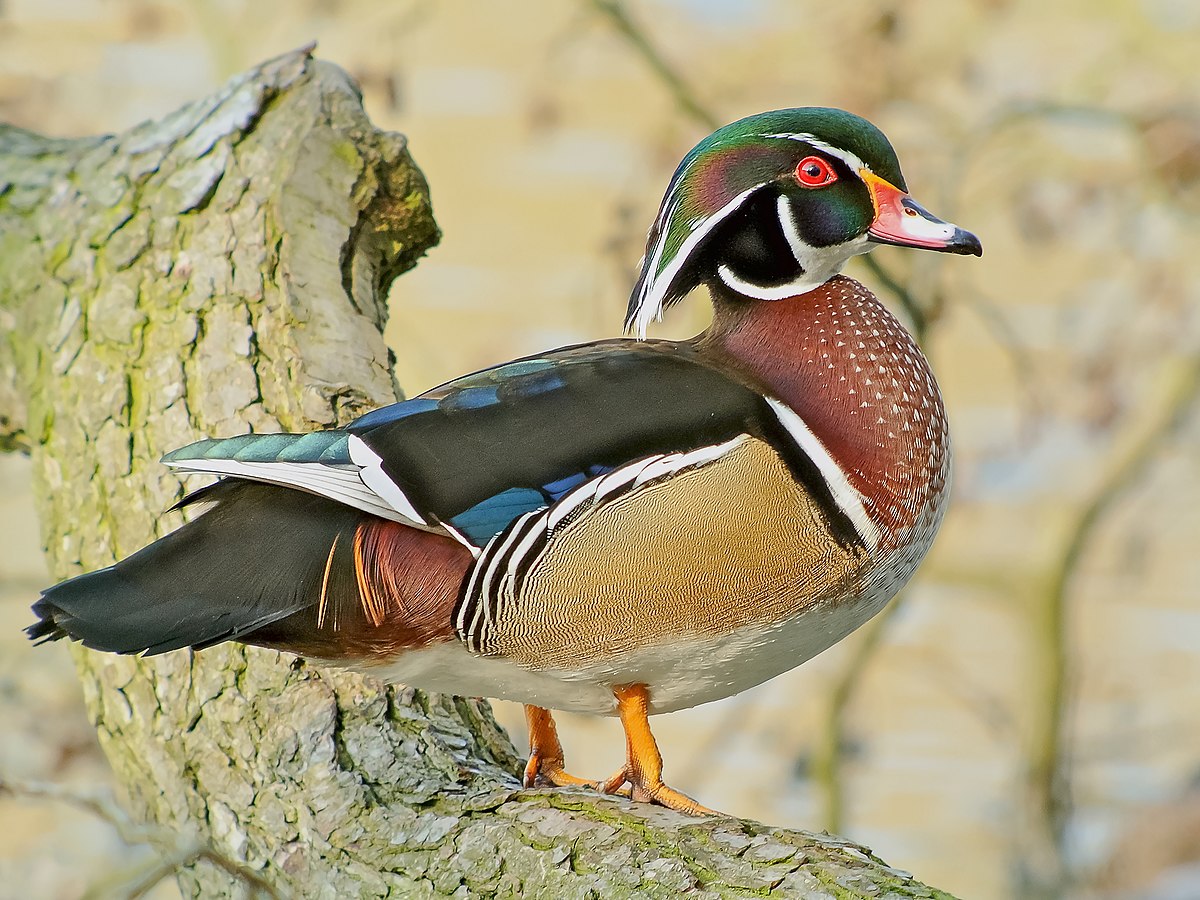
Wikipedia: Wood duck Source: OTHER
1200px-Wood_Duck_%28Aix_sponsa%29%2C_Parc_du_Rouge-Clo%C3%AEtre%2C_Brussels.jpg
This bird appears across the great seas in the following continents:
Europe, North America.
General: ![]() The wood duck or Carolina duck (Aix sponsa) is a species of perching duck found in North America. It is one of the most colorful North American waterfowl.[2][3]
[more]
The wood duck or Carolina duck (Aix sponsa) is a species of perching duck found in North America. It is one of the most colorful North American waterfowl.[2][3]
[more]

Wikipedia: Muscovy duck Source: OTHER
MuscovyDuck.jpg
![]() The Muscovy duck (Cairina moschata) is a large duck native to Mexico and Central and South America. Small wild and feral breeding populations have established themselves in the United States, particularly in Florida, Louisiana, Massachusetts, and the lower Rio Grande Valley of Texas, the Big Island of Hawaii, as well as in many other parts of North America, including southern Canada. Feral Muscovy ducks are found in New Zealand, Australia, and in parts of Europe.
[more]
The Muscovy duck (Cairina moschata) is a large duck native to Mexico and Central and South America. Small wild and feral breeding populations have established themselves in the United States, particularly in Florida, Louisiana, Massachusetts, and the lower Rio Grande Valley of Texas, the Big Island of Hawaii, as well as in many other parts of North America, including southern Canada. Feral Muscovy ducks are found in New Zealand, Australia, and in parts of Europe.
[more]
Profile Wikipedia eBird Audubon AllAboutBirds Xeno-Canto NABU
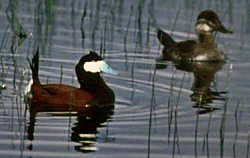
Wikipedia: Ruddy duck Source: OTHER
Oxyura_jamaicensis_FWS.jpg
This bird appears across the great seas in the following continents:
Europe, North America, South America.
Deutschland: eingebürgertes Neozoon, ausnahmsweise Brutvogel
Profile Wikipedia eBird Audubon AllAboutBirds Xeno-Canto NABU

Wikipedia: Harlequin duck Source: OTHER
1200px-Histrionicus_histrionicus_drake_Barnegat.jpg
This bird appears across the great seas in the following continents:
Europe, North America.
General: ![]() The harlequin duck (Histrionicus histrionicus) is a small sea duck. It takes its name from Harlequin (French Arlequin, Italian Arlecchino), a colourfully dressed character in Commedia dell'arte. The species name comes from the Latin word "histrio", meaning "actor".[2] In North America it is also known as lords and ladies. Other names include painted duck, totem pole duck, rock duck, glacier duck, mountain duck, white-eyed diver, squeaker and blue streak.
[more]
The harlequin duck (Histrionicus histrionicus) is a small sea duck. It takes its name from Harlequin (French Arlequin, Italian Arlecchino), a colourfully dressed character in Commedia dell'arte. The species name comes from the Latin word "histrio", meaning "actor".[2] In North America it is also known as lords and ladies. Other names include painted duck, totem pole duck, rock duck, glacier duck, mountain duck, white-eyed diver, squeaker and blue streak.
[more]

Wikipedia: Masked duck Source: OTHER
1200px-Masked_duck_%28Nomonyx_dominicus%29.jpg
![]() The masked duck (Nomonyx dominicus) is a tiny stiff-tailed duck ranging through the tropical Americas. They are found from Mexico to South America and also in the Caribbean. Primarily not migratory, masked ducks are reported as very uncommon vagrants in the southernmost United States, along the Mexican border and in Florida. As of 2000, the conservation status for masked ducks in Texas is 3,800 birds.[2] On April 1, 1962, it was recorded from Lowndes County, Georgia, where it was photographed by Alexander Wetmore.[3]
[more]
The masked duck (Nomonyx dominicus) is a tiny stiff-tailed duck ranging through the tropical Americas. They are found from Mexico to South America and also in the Caribbean. Primarily not migratory, masked ducks are reported as very uncommon vagrants in the southernmost United States, along the Mexican border and in Florida. As of 2000, the conservation status for masked ducks in Texas is 3,800 birds.[2] On April 1, 1962, it was recorded from Lowndes County, Georgia, where it was photographed by Alexander Wetmore.[3]
[more]
Profile Wikipedia eBird Vogelwarte BirdLife ZH ornitho.ch Audubon AllAboutBirds Xeno-Canto NABU

Wikipedia: Long-tailed duck Source: OTHER
Long-tailed-duck.jpg
This bird appears across the great seas in the following continents:
Europe, North America.
Deutschland: Zugvogel, Wintergast
Habitats:
River and lake
Sieben Samtenten, Durchzuegler die nicht in der Schweiz bleiben. 2023-02-09 16.15.58 Sils
First observed in 🇨🇭 on 2023-02-09.
This bird appears across the great seas in the following continents:
Europe, North America.
Deutschland: Zugvogel, Wintergast
Vocalization: ![]() Seldom heard. [Link]
Seldom heard. [Link]
Calls: ![]() Calls: Short accented "tup tup tup" and a shivering "gahhahahaha". [Link]
Calls: Short accented "tup tup tup" and a shivering "gahhahahaha". [Link]
Physical details: length=51-58 cm,
wingspan=90-99 cm,
weight=1100-2000 g
Habitats:
River and lake

Wikipedia: Surf scoter Source: OTHER
Melanitta_perspicillata.jpg
General: ![]() The surf scoter (Melanitta perspicillata) is a large sea duck native to North America.[2] Adult males are almost entirely black with characteristic white patches on the forehead and the nape and adult females are slightly smaller and browner.[3] Surf scoters breed in Northern Canada and Alaska and winter along the Pacific and Atlantic coasts of North America.[2] Those diving ducks mainly feed on benthic invertebrates, mussels representing an important part of their diet.[3]
[more]
The surf scoter (Melanitta perspicillata) is a large sea duck native to North America.[2] Adult males are almost entirely black with characteristic white patches on the forehead and the nape and adult females are slightly smaller and browner.[3] Surf scoters breed in Northern Canada and Alaska and winter along the Pacific and Atlantic coasts of North America.[2] Those diving ducks mainly feed on benthic invertebrates, mussels representing an important part of their diet.[3]
[more]
Profile Wikipedia eBird Audubon AllAboutBirds Xeno-Canto NABU

Wikipedia: White-winged scoter Source: OTHER
White-winged_Scoter.jpg
This bird appears across the great seas in the following continents:
Europe, North America.
![]() Melanitta fusca deglandi
[more]
Melanitta fusca deglandi
[more]

Wikipedia: Common scoter Source: OTHER
1200px-Eurasian_common_scoter.jpg
This bird appears across the great seas in the following continents:
Europe, North America, Africa.
![]() Anas nigra Linnaeus, 1758
[more]
Anas nigra Linnaeus, 1758
[more]
Vocalization: ![]() More vocal than other Scoters. Short, whistling sounds, sometimes reminiscent of a male teal, but a little bit deeper in pitch. [Link]
More vocal than other Scoters. Short, whistling sounds, sometimes reminiscent of a male teal, but a little bit deeper in pitch. [Link]
Physical details: length=44-54 cm,
wingspan=79-90 cm,
weight=650-1300 g
Habitats:
River and lake
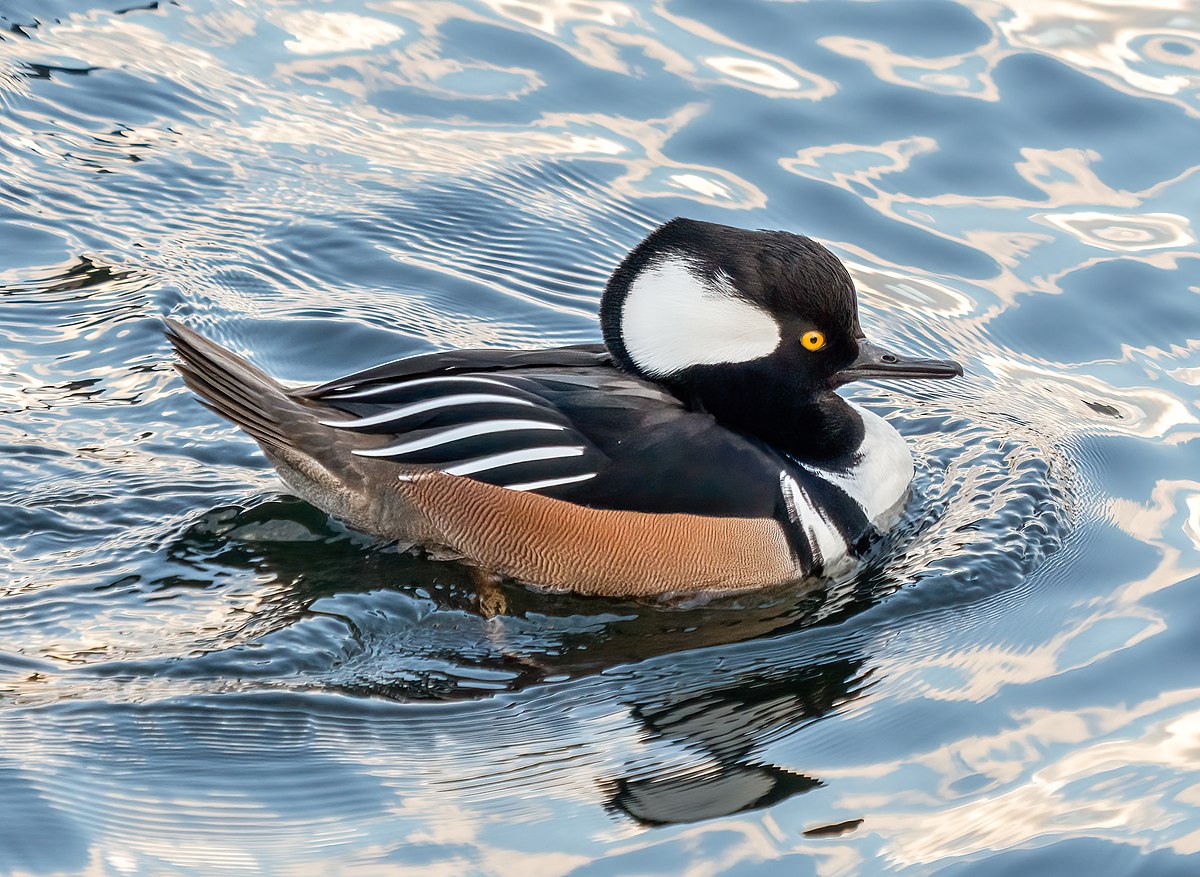
Wikipedia: Hooded merganser Source: OTHER
1200px-Hooded_merganser_male_in_Central_Park_%2895790%29.jpg
General: ![]() The hooded merganser (Lophodytes cucullatus) is a species of merganser. It is the only extant species in the genus Lophodytes. The genus name derives from the Greek language: lophos meaning 'crest', and dutes meaning 'diver'.[2] The bird is striking in appearance; both sexes have crests that they can raise or lower, and the breeding plumage of the male is handsomely patterned and coloured. The hooded merganser has a sawbill but is not classified as a typical merganser.
[more]
The hooded merganser (Lophodytes cucullatus) is a species of merganser. It is the only extant species in the genus Lophodytes. The genus name derives from the Greek language: lophos meaning 'crest', and dutes meaning 'diver'.[2] The bird is striking in appearance; both sexes have crests that they can raise or lower, and the breeding plumage of the male is handsomely patterned and coloured. The hooded merganser has a sawbill but is not classified as a typical merganser.
[more]

Wikipedia: Taiga bean goose Source: OTHER
Bean.goose.600pix.jpg
This bird appears across the great seas in the following continents:
Europe, North America, Africa.
Deutschland: Zugvogel, Wintergast Bruten gehen auf entflogene Tiere zurück
Calls: ![]() Do not call as much as other grey geese. Sounds similar to the lower sounds of Pink-footed goose, with various reedy calls, but harder, less nasal and more of a "sore throat". [Link]
Do not call as much as other grey geese. Sounds similar to the lower sounds of Pink-footed goose, with various reedy calls, but harder, less nasal and more of a "sore throat". [Link]
Physical details: length=66-84 cm,
wingspan=142-175 cm,
weight=2220-4060 g
Habitats:
River and lake
White-fronted goose closeup, on the way home from Laphroiag? 2023-08-11 13.38.38 Islay
First observed in Islay on 2023-08-11.
This bird appears across the great seas in the following continents:
Europe, North America, Africa.
Deutschland: Zugvogel, Wintergast Bruten gehen auf entflogene Tiere zurück
Habitats:
River and lake

Wikipedia: Snow goose Source: OTHER
1200px-Snow_goose_in_Central_Park_%2833138%29.jpg
This bird appears across the great seas in the following continents:
Europe, North America.
General: ![]() The snow goose (Anser caerulescens) is a species of goose native to North America. Both white and dark morphs exist, the latter often known as blue goose. Its name derives from the typically white plumage. The species was previously placed in the genus Chen, but is now typically included in the "gray goose" genus Anser.[2][3]
[more]
The snow goose (Anser caerulescens) is a species of goose native to North America. Both white and dark morphs exist, the latter often known as blue goose. Its name derives from the typically white plumage. The species was previously placed in the genus Chen, but is now typically included in the "gray goose" genus Anser.[2][3]
[more]

Wikipedia: Tundra bean goose Source: OTHER
Tundra_Bean_Goose.jpg
This bird appears across the great seas in the following continents:
Europe, North America.
![]() The tundra bean goose (Anser serrirostris) is a goose that breeds in northern Siberia. This and the taiga bean goose are recognised as separate species by the American Ornithological Society and International Ornithologists' Union, but are considered a single species by other authorities (collectively called bean goose). It is migratory and winters further south in Asia. The taiga and tundra bean goose diverged about 2.5 million years ago and established secondary contact ca. 60,000 years ago, resulting in extensive gene flow.[1]
[more]
The tundra bean goose (Anser serrirostris) is a goose that breeds in northern Siberia. This and the taiga bean goose are recognised as separate species by the American Ornithological Society and International Ornithologists' Union, but are considered a single species by other authorities (collectively called bean goose). It is migratory and winters further south in Asia. The taiga and tundra bean goose diverged about 2.5 million years ago and established secondary contact ca. 60,000 years ago, resulting in extensive gene flow.[1]
[more]
On the frozen Pfäffikersee with coots After a week of freezing temperatures, the lake developed a thin layer of ice. 2021-02-15 08.28.58
First observed in 🇨🇭 on 2021-02-12.
This bird appears across the great seas in the following continents:
Europe, North America, Africa.
Common waterbird at Pfäffikersee, very common on Lake Zurich.
Vocalization: ![]() Silent compared to other swans. A repertoire of snorting, grunting and hissing sound when interacting. No far carrying sounds. [Link]
Silent compared to other swans. A repertoire of snorting, grunting and hissing sound when interacting. No far carrying sounds. [Link]
Calls: ![]() Wings produce prominent singing sound which may function as a flight contact-call. [Link]
Wings produce prominent singing sound which may function as a flight contact-call. [Link]
Physical details: length=145-160 cm,
wingspan=208-238 cm,
weight=7000-14000 g
Habitats:
River and lake
Whooper swan, Iceland. 2015-06-03 16.01.16 Iceland
First observed in Iceland on 2015-06-03.
This bird appears across the great seas in the following continents:
Europe, North America.
Deutschland: Zugvogel, Wintergast RL R
Vocalization: ![]() Quite vocal. Trumpet-like clear honks of half a second length most frequent in flight and take-off/landing. Often voiced with a register break. [Link]
Quite vocal. Trumpet-like clear honks of half a second length most frequent in flight and take-off/landing. Often voiced with a register break. [Link]
Physical details: length=145-160 cm,
wingspan=218-243 cm,
weight=8500-10000 g
Habitats:
River and lake

Wikipedia: Tundra swan Source: OTHER
1200px-Cygnus_bewickii_01.jpg
This bird appears across the great seas in the following continents:
Europe, North America.
General: ![]() The tundra swan (Cygnus columbianus) is a small Holarctic swan. The two taxa within it are usually regarded as conspecific, but are also sometimes[2][3] split into two species: Bewick's swan (Cygnus bewickii) of the Palaearctic and the whistling swan (C. columbianus) proper of the Nearctic. Birds from eastern Russia (roughly east of the Taimyr Peninsula) are sometimes separated as the subspecies C. c. jankowskii, but this is not widely accepted as distinct, with most authors including them in C. c. bewickii. Tundra swans are sometimes separated in the subgenus Olor together with the other Arctic swan species.
[more]
The tundra swan (Cygnus columbianus) is a small Holarctic swan. The two taxa within it are usually regarded as conspecific, but are also sometimes[2][3] split into two species: Bewick's swan (Cygnus bewickii) of the Palaearctic and the whistling swan (C. columbianus) proper of the Nearctic. Birds from eastern Russia (roughly east of the Taimyr Peninsula) are sometimes separated as the subspecies C. c. jankowskii, but this is not widely accepted as distinct, with most authors including them in C. c. bewickii. Tundra swans are sometimes separated in the subgenus Olor together with the other Arctic swan species.
[more]
Vocalization: ![]() More vocal than other swans. Both higher pitched and deeper sounds. Birds on the water often gives crooning, crane-like notes with less defined pitch. [Link]
More vocal than other swans. Both higher pitched and deeper sounds. Birds on the water often gives crooning, crane-like notes with less defined pitch. [Link]
Calls: ![]() Tone is less full-bodied in these calls. Flight call a deep, yelping, soft barking sound. Each call short, with a "helpless" quality. [Link]
Tone is less full-bodied in these calls. Flight call a deep, yelping, soft barking sound. Each call short, with a "helpless" quality. [Link]
Physical details: length=115-127 cm,
wingspan=180-211 cm,
weight=3400-7800 g
Canada goose. 2022-05-01 09.55.20 Maryland
First observed in Maryland on 2022-05-01.
This bird appears across the great seas in the following continents:
Europe, North America, Australia.
vagrant, presumably from introduced NZ population
Vocalization: ![]() Trumpet like, resonant, honking sounds. Closer to Whooper Swans than many of the other geese. [Link]
Trumpet like, resonant, honking sounds. Closer to Whooper Swans than many of the other geese. [Link]
Physical details: length=80-105 cm,
wingspan=160-175 cm,
weight=3670-5410 g
Call:
Automatically generated from Xeno-Canto recording
♫ Source: BirdNet
20220503_104414 birdnet - Canada Goose - 2022-05-03 10:44:14 - Canada Goose - Cockeysville.mp3
2022-05-03 10.44.14 Cockeysville (song?)

Wikipedia: Brant Source: OTHER
Brent-Goose.jpg
This bird appears across the great seas in the following continents:
Europe, North America.
Deutschland: Zugvogel, Wintergast
Vocalization: ![]() A bubbling, trembling, ascending, three syllable "ahrahrrhit", quite different from other geese. [Link]
A bubbling, trembling, ascending, three syllable "ahrahrrhit", quite different from other geese. [Link]
Physical details: length=56-61 cm,
wingspan=110-120 cm,
weight=1300-1600 g
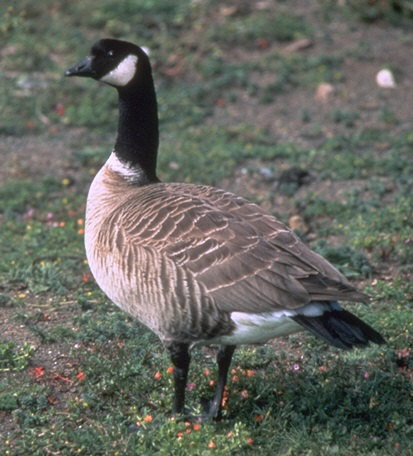
Wikipedia: Cackling goose Source: OTHER
AleutianCanadaGoose2.jpg
This bird appears across the great seas in the following continents:
Europe, North America.
General: ![]() The cackling goose (Branta hutchinsii) is a North American bird of the genus Branta of black geese, which contains species with largely black plumage, distinguishing them from the grey Anser species.
[more]
The cackling goose (Branta hutchinsii) is a North American bird of the genus Branta of black geese, which contains species with largely black plumage, distinguishing them from the grey Anser species.
[more]
Blue-winged teal (Spatula discors)
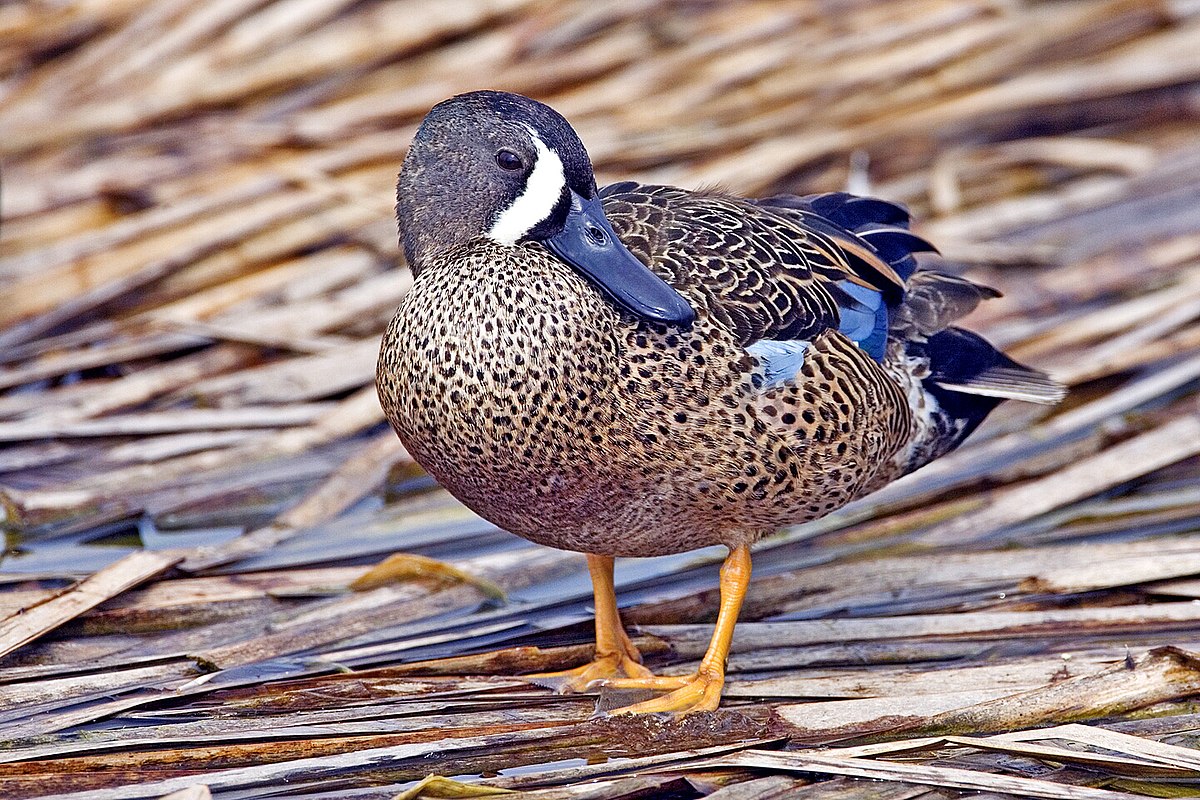
Wikipedia: Blue-winged teal Source: OTHER
1200px-Blue-Winged_Teal.jpg
![]() The blue-winged teal (Spatula discors) is a species of bird in the duck, goose, and swan family Anatidae. One of the smaller members of the dabbling duck group, it occurs in North America, where it breeds from southern Alaska to Nova Scotia, and south to northern Texas. It winters along the Pacific and Atlantic coasts and south into the Caribbean islands and Central America.
[more]
The blue-winged teal (Spatula discors) is a species of bird in the duck, goose, and swan family Anatidae. One of the smaller members of the dabbling duck group, it occurs in North America, where it breeds from southern Alaska to Nova Scotia, and south to northern Texas. It winters along the Pacific and Atlantic coasts and south into the Caribbean islands and Central America.
[more]
Black billed whistling duck. 2020-02-19 07.35.22 Panama
First observed in Panama on 2020-02-19.
We saw this on the Pipeline Road near Gamboa, Panama - see tiger heron for more on that.
General: ![]() Anas arborea Linnaeus, 1758
[more]
Anas arborea Linnaeus, 1758
[more]

Wikipedia: Fulvous whistling-duck Source: OTHER
1200px-Dendrocygna_bicolor_wilhelma.jpg
This bird appears across the great seas in the following continents:
North America, South America, Africa.
![]() The fulvous whistling duck or fulvous tree duck (Dendrocygna bicolor) is a species of whistling duck that breeds across the world's tropical regions in much of Mexico and South America, the West Indies, the southern United States, sub-Saharan Africa and the Indian subcontinent. It has plumage that is mainly reddish brown, long legs and a long grey bill, and shows a distinctive white band across its black tail in flight. Like other members of its ancient lineage, it has a whistling call which is given in flight or on the ground. Its preferred habitat consists of wetlands with plentiful vegetation, including shallow lakes and paddy fields.
The nest, built from plant material and unlined, is placed among dense vegetation or in a tree hole. The typical clutch is around ten whitish eggs. The breeding adults, which pair for life, take turns to incubate, and the eggs hatch in 24–29 days. The downy grey ducklings leave the nest within a day or so of hatching, but the parents continue to protect them until they fledge around nine weeks later.
[more]
The fulvous whistling duck or fulvous tree duck (Dendrocygna bicolor) is a species of whistling duck that breeds across the world's tropical regions in much of Mexico and South America, the West Indies, the southern United States, sub-Saharan Africa and the Indian subcontinent. It has plumage that is mainly reddish brown, long legs and a long grey bill, and shows a distinctive white band across its black tail in flight. Like other members of its ancient lineage, it has a whistling call which is given in flight or on the ground. Its preferred habitat consists of wetlands with plentiful vegetation, including shallow lakes and paddy fields.
The nest, built from plant material and unlined, is placed among dense vegetation or in a tree hole. The typical clutch is around ten whitish eggs. The breeding adults, which pair for life, take turns to incubate, and the eggs hatch in 24–29 days. The downy grey ducklings leave the nest within a day or so of hatching, but the parents continue to protect them until they fledge around nine weeks later.
[more]

Wikipedia: Black-bellied whistling-duck Source: OTHER
1200px-Whistling_duck_flight02_-_natures_pics-edit1.jpg
![]() The black-bellied whistling duck (Dendrocygna autumnalis), formerly called the black-bellied tree duck, is a whistling duck that breeds from the southernmost United States, Mexico, and tropical Central to south-central South America. In the US, it can be found year-round in peninsular Florida, parts of southeast Texas, coastal Alabama and seasonally in southeast Arizona, and Louisiana's Gulf Coast. It is a rare breeder in such disparate locations as Arkansas, Georgia, Tennessee, and South Carolina, though it is now a common breeder in parts of central Florida. There is a large population of several hundred that winter each year in Audubon Park in uptown New Orleans, Louisiana. Since it is one of only two whistling duck species native to North America, it is occasionally just known as the "whistling duck" or "Mexican squealer" in the southern USA.
[more]
The black-bellied whistling duck (Dendrocygna autumnalis), formerly called the black-bellied tree duck, is a whistling duck that breeds from the southernmost United States, Mexico, and tropical Central to south-central South America. In the US, it can be found year-round in peninsular Florida, parts of southeast Texas, coastal Alabama and seasonally in southeast Arizona, and Louisiana's Gulf Coast. It is a rare breeder in such disparate locations as Arkansas, Georgia, Tennessee, and South Carolina, though it is now a common breeder in parts of central Florida. There is a large population of several hundred that winter each year in Audubon Park in uptown New Orleans, Louisiana. Since it is one of only two whistling duck species native to North America, it is occasionally just known as the "whistling duck" or "Mexican squealer" in the southern USA.
[more]
Great cormorant / Kormoran (Phalacrocorax carbo)
Profile Wikipedia eBird Vogelwarte BirdLife ZH ornitho.ch Audubon AllAboutBirds Xeno-Canto BirdID NABU
Cormorant Cormorants' feathers lack the waterproofing that ducks have,
so you often see them drying their wings on a convenient perch. 2021-01-26 15.56.30 Pfäffikersee
First observed in 🇨🇭 on 2021-01-26.
This bird appears across the great seas in the following continents:
Europe, North America, Africa, Asia.
Seasonal Behavior: ![]() Lokaler Brutvogel, regelmässiger, häufiger Durchzügler und Wintergast.[Brutpaare am Zuerichsee und Greifensee bei Moenchaltorf] [Link]
Lokaler Brutvogel, regelmässiger, häufiger Durchzügler und Wintergast.[Brutpaare am Zuerichsee und Greifensee bei Moenchaltorf] [Link]
Vocalization: ![]() Mostly heard at breeding ground. Also deep, rattling and creaking sounds. [Link]
Mostly heard at breeding ground. Also deep, rattling and creaking sounds. [Link]
Calls: ![]() Coarse, vibrating calls "hahahahaharo". [Link]
Coarse, vibrating calls "hahahahaharo". [Link]
Physical details: length=80-100 cm,
wingspan=130-160 cm,
weight=1700-3000 g
Habitats:
River and lake
Call:
Automatically generated from Xeno-Canto recording
♫ Source: BirdNet
20210519_073923 birdnet 1559 - Great Cormorant - 2021-05-19 07:39:23 - Great Cormorant - Cudrefin.mp3
2021-05-19 07.39.23 La Sauge (song?)
Pelagic cormorant (Phalacrocorax pelagicus)

Wikipedia: Pelagic cormorant Source: OTHER
1200px-Pelagic_Cormorant_flying.jpg
General: ![]() The pelagic cormorant (Phalacrocorax pelagicus), also known as Baird's cormorant, is a small member of the cormorant family Phalacrocoracidae. Analogous to other smallish cormorants, it is also called the pelagic shag occasionally. This seabird lives along the coasts of the northern Pacific; during winter it can also be found in the open ocean.[2] Pelagic cormorants have relatively short wings due to their need for economical movement underwater, and consequently have the highest flight costs of any bird.[3]
[more]
The pelagic cormorant (Phalacrocorax pelagicus), also known as Baird's cormorant, is a small member of the cormorant family Phalacrocoracidae. Analogous to other smallish cormorants, it is also called the pelagic shag occasionally. This seabird lives along the coasts of the northern Pacific; during winter it can also be found in the open ocean.[2] Pelagic cormorants have relatively short wings due to their need for economical movement underwater, and consequently have the highest flight costs of any bird.[3]
[more]
Red-faced cormorant (Phalacrocorax urile)
Profile Wikipedia eBird Audubon AllAboutBirds Xeno-Canto

Wikipedia: Red-faced cormorant Source: OTHER
1200px-Red-faced_Cormorant_on_St._Paul_Island_by_Lisa_Hupp_USFWS.jpg
![]() The red-faced cormorant (Phalacrocorax urile), red-faced shag or violet shag, is a bird species of the family Phalacrocoracidae.
[more]
The red-faced cormorant (Phalacrocorax urile), red-faced shag or violet shag, is a bird species of the family Phalacrocoracidae.
[more]
Brandt's cormorant / Pinselscharbe (Phalacrocorax penicillatus)

Wikipedia: Brandt's cormorant Source: OTHER
1200px-Brandt%27s_Cormorant.jpg
![]() Brandt's cormorant (Phalacrocorax penicillatus) is a strictly marine bird of the cormorant family of seabirds that inhabits the Pacific coast of North America. It ranges, in the summer, from Alaska to the Gulf of California, but the population north of Vancouver Island migrates south during the winter. Its specific name, penicillatus is Latin for a painter's brush (pencil of hairs), in reference to white plumes on its neck and back during the early breeding season. The common name honors the German naturalist Johann Friedrich von Brandt of the Academy of Sciences at St. Petersburg, who described the species from specimens collected on expeditions to the Pacific during the early 19th century. The average size of a Brandt's cormorant is 4.6 pounds. They have a length of about 34 inches and their wingspan is 4 feet.[2]
[more]
Brandt's cormorant (Phalacrocorax penicillatus) is a strictly marine bird of the cormorant family of seabirds that inhabits the Pacific coast of North America. It ranges, in the summer, from Alaska to the Gulf of California, but the population north of Vancouver Island migrates south during the winter. Its specific name, penicillatus is Latin for a painter's brush (pencil of hairs), in reference to white plumes on its neck and back during the early breeding season. The common name honors the German naturalist Johann Friedrich von Brandt of the Academy of Sciences at St. Petersburg, who described the species from specimens collected on expeditions to the Pacific during the early 19th century. The average size of a Brandt's cormorant is 4.6 pounds. They have a length of about 34 inches and their wingspan is 4 feet.[2]
[more]
Neotropic cormorant / Olivenscharbe (Phalacrocorax brasilianus)
Profile Wikipedia eBird Audubon AllAboutBirds Xeno-Canto

Wikipedia: Neotropic cormorant Source: OTHER
1200px-Phalacrocorax_brasilianus_%28Costa_Rica%29.jpg
![]() The neotropic cormorant or olivaceous cormorant (Phalacrocorax brasilianus) is a medium-sized cormorant found throughout the American tropics and subtropics, from the middle Rio Grande and the Gulf and Californian coasts of the United States south through Mexico and Central America to southern South America, where it is called by the Indian name of biguá. It also breeds on the Bahamas, Cuba and Trinidad. It can be found both at coasts (including some mangrove areas) and on inland waters. There are at least two subspecies: P. b. mexicanus from Nicaragua northwards and P. b. brasilianus further south. In Peru the neotropic cormorant is used by the Uru people for fishing.
[more]
The neotropic cormorant or olivaceous cormorant (Phalacrocorax brasilianus) is a medium-sized cormorant found throughout the American tropics and subtropics, from the middle Rio Grande and the Gulf and Californian coasts of the United States south through Mexico and Central America to southern South America, where it is called by the Indian name of biguá. It also breeds on the Bahamas, Cuba and Trinidad. It can be found both at coasts (including some mangrove areas) and on inland waters. There are at least two subspecies: P. b. mexicanus from Nicaragua northwards and P. b. brasilianus further south. In Peru the neotropic cormorant is used by the Uru people for fishing.
[more]
Great egret / Silberreiher (Ardea alba)
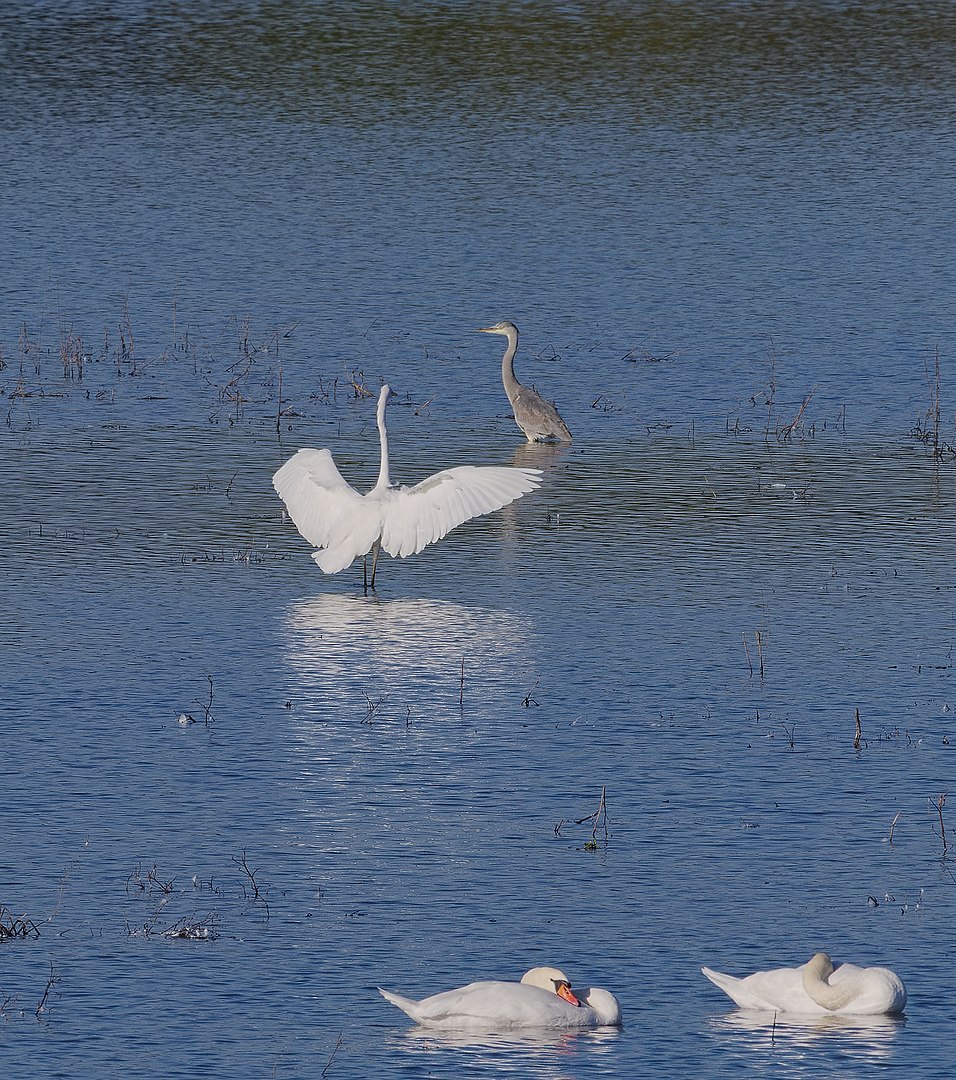
Silberreiher in Deutschland, von WikiCommons Von Andreas Eichler, CC BY-SA 4.0, https://commons.wikimedia.org/w/index.php?curid=59954907 Source: OTHER
Wikicommons 2016.10.30--Silberreiher.jpg
First observed in 🇨🇭 on 2021-02-24.
This bird appears across the great seas in the following continents:
Europe, North America, South America, Africa, Asia.
Auf dem Heimweg von Schwanden haben wir bei Benken ganz weisse Reiher gesehen.
Laut ornitho.ch waren sie Silberreiher.
Bei den meisten Quellen heisst es, sie sind in der Schweiz nur Durchzüger oder Wintergäste.
Aber laut Balzari und Gygax, brüten auch einige Vögel am Lac Neuchatel seit 2013.
Vocalization: ![]() Silent outside breeding ground. [Link]
Silent outside breeding ground. [Link]
Calls: ![]() In colonies various harsh calls like a dry, and mechanical "kerrrrrrr", and a very nasal "geet" or "ga-geet ga-geet" are heard. [Link]
In colonies various harsh calls like a dry, and mechanical "kerrrrrrr", and a very nasal "geet" or "ga-geet ga-geet" are heard. [Link]
Physical details: length=85-102 cm,
wingspan=140-170 cm,
weight=960-1030 g
Habitats:
Wetland
Call:
Partly an awkward quack: uck uck. Rattles. Deep-toned urrr. Higher-toned trill.
Call attributes:
Call melody: non-musical, slow, Frequency: low (1-3 KHz),
Great blue heron / Kanadareiher (Ardea herodias)
Profile Wikipedia eBird A-Z Animals Audubon AllAboutBirds Xeno-Canto
Great blue heron. 2022-04-28 18.15.08 Maryland
First observed in Maryland on 2021-06-17.
General: ![]() The great blue heron (Ardea herodias) is a large wading bird in the heron family Ardeidae, common near the shores of open water and in wetlands over most of North America and Central America, as well as the Caribbean and the Galápagos Islands. It is a rare vagrant to coastal Spain, the Azores, and areas of far southern Europe. An all-white population found in south Florida and the Florida Keys is known as the great white heron. Debate exists about whether this represents a white color morph of the great blue heron, a subspecies of it, or an entirely separate species.[2][3] The status of white individuals known to occur elsewhere in the Caribbean, and very rarely elsewhere in eastern North America, is unclear.[3]
[more]
The great blue heron (Ardea herodias) is a large wading bird in the heron family Ardeidae, common near the shores of open water and in wetlands over most of North America and Central America, as well as the Caribbean and the Galápagos Islands. It is a rare vagrant to coastal Spain, the Azores, and areas of far southern Europe. An all-white population found in south Florida and the Florida Keys is known as the great white heron. Debate exists about whether this represents a white color morph of the great blue heron, a subspecies of it, or an entirely separate species.[2][3] The status of white individuals known to occur elsewhere in the Caribbean, and very rarely elsewhere in eastern North America, is unclear.[3]
[more]
Black-crowned night-heron / Nachtreiher (Nycticorax nycticorax)

Wikipedia: Black-crowned night-heron Source: OTHER
1200px-BCNH_CMCNJ_for_Wiki.png
This bird appears across the great seas in the following continents:
Europe, North America, South America, Africa, Asia.
![]() The black-crowned night heron (Nycticorax nycticorax), or black-capped night heron, commonly shortened to just night heron in Eurasia, is a medium-sized heron found throughout a large part of the world, except in the coldest regions and Australasia (where it is replaced by the closely related nankeen night heron, with which it has hybridized in the area of contact).
[more]
The black-crowned night heron (Nycticorax nycticorax), or black-capped night heron, commonly shortened to just night heron in Eurasia, is a medium-sized heron found throughout a large part of the world, except in the coldest regions and Australasia (where it is replaced by the closely related nankeen night heron, with which it has hybridized in the area of contact).
[more]
Calls: ![]() Most commonly hear call is a nasal, soft croaking "roack", like cross between Raven and frog. [Link]
Most commonly hear call is a nasal, soft croaking "roack", like cross between Raven and frog. [Link]
Physical details: length=58-65 cm,
wingspan=105-112 cm,
weight=500-800 g
Habitats:
Wetland
Snowy egret / Schmuckreiher (Egretta thula)
Profile Wikipedia eBird Audubon AllAboutBirds Xeno-Canto
Snowy egret at John's Pass, Madeira Beach, Florida. 2023-09-27 11.51.14 Florida
First observed in Yucatan on 2023-04-15.
This bird appears across the great seas in the following continents:
North America, South America, Africa.
General: ![]() The snowy egret (Egretta thula) is a small white heron. The genus name comes from Provençal French for the little egret, aigrette, which is a diminutive of aigron, 'heron'. The species name thula is the Araucano term for the black-necked swan, applied to this species in error by Chilean naturalist Juan Ignacio Molina in 1782.[3]
[more]
The snowy egret (Egretta thula) is a small white heron. The genus name comes from Provençal French for the little egret, aigrette, which is a diminutive of aigron, 'heron'. The species name thula is the Araucano term for the black-necked swan, applied to this species in error by Chilean naturalist Juan Ignacio Molina in 1782.[3]
[more]
Little blue heron / Blaureiher (Egretta caerulea)
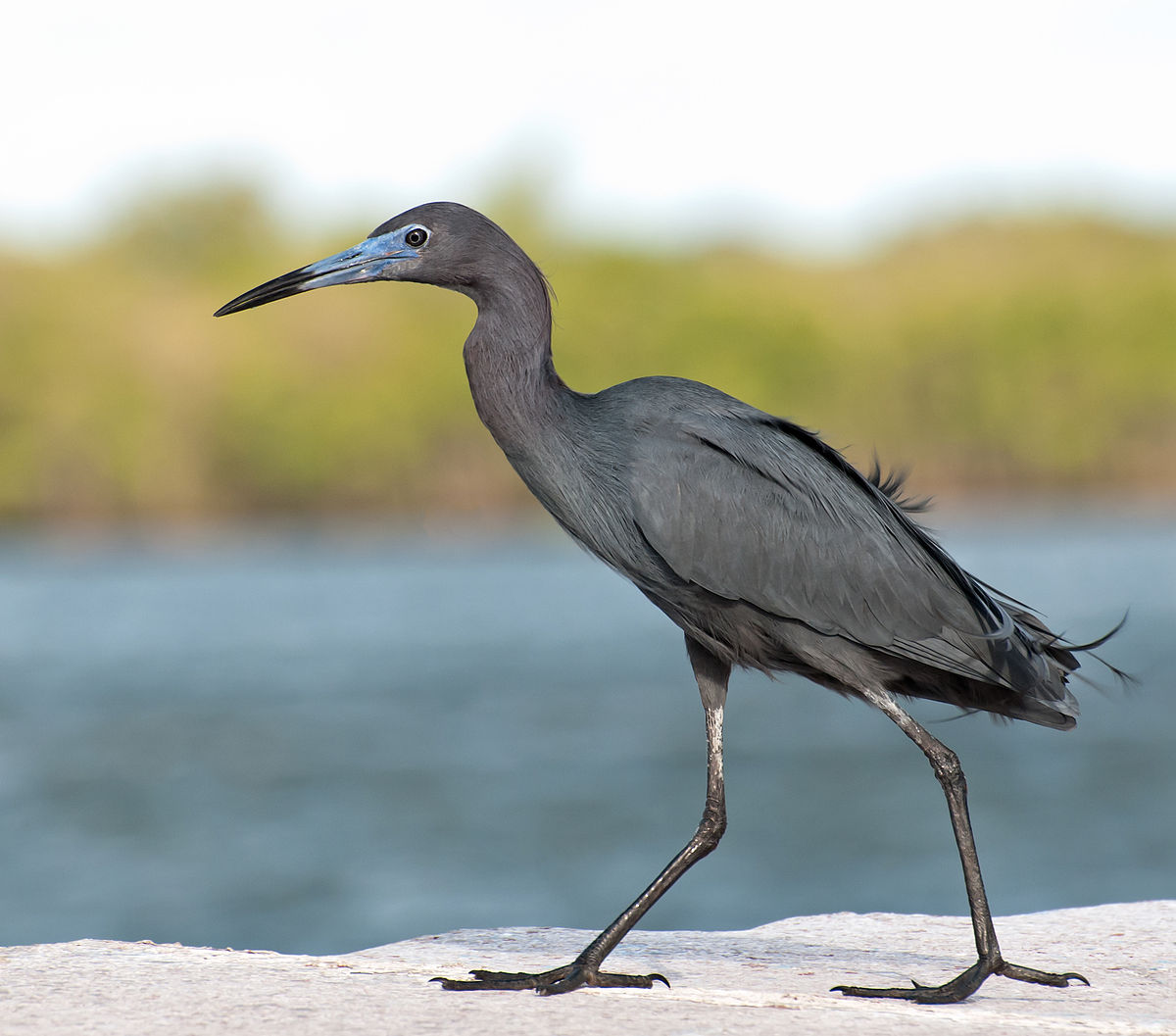
Wikipedia: Little blue heron Source: OTHER
1200px-Egretta_caerulea_-Cananeia%2C_Sao_Paulo%2C_Brasil-8.jpg
This bird appears across the great seas in the following continents:
North America, South America, Africa.
![]() The little blue heron (Egretta caerulea) is a small heron belonging to the family Ardeidae.
[more]
The little blue heron (Egretta caerulea) is a small heron belonging to the family Ardeidae.
[more]
Pacific reef-egret / Riffreiher (Egretta sacra)

Wikipedia: Pacific reef-egret Source: OTHER
1200px-Egretta_sacra.jpg
This bird appears across the great seas in the following continents:
North America, Asia, Australia.
![]() The Pacific reef heron (Egretta sacra), also known as the eastern reef heron or eastern reef egret, is a species of heron found throughout southern Asia and Oceania.[2]
[more]
The Pacific reef heron (Egretta sacra), also known as the eastern reef heron or eastern reef egret, is a species of heron found throughout southern Asia and Oceania.[2]
[more]
Tricolored heron / Dreifarbenreiher (Egretta tricolor)
Profile Wikipedia eBird Audubon AllAboutBirds Xeno-Canto
Beautiful tricolored heron near Las Coloradas. 2023-04-15 10.04.30 Yucatan
First observed in Yucatan on 2023-04-15.
![]() The tricolored heron (Egretta tricolor), formerly known as the Louisiana heron, is a small species of heron native to coastal parts of the Americas; in the Atlantic region, it ranges from the northeastern United States, south along the coast, through the Gulf of Mexico and the Caribbean, to northern South America as far south as Brazil. In the Pacific region, it ranges from Peru to California, but it is only a nonbreeding visitor to the far north.
[more]
The tricolored heron (Egretta tricolor), formerly known as the Louisiana heron, is a small species of heron native to coastal parts of the Americas; in the Atlantic region, it ranges from the northeastern United States, south along the coast, through the Gulf of Mexico and the Caribbean, to northern South America as far south as Brazil. In the Pacific region, it ranges from Peru to California, but it is only a nonbreeding visitor to the far north.
[more]
Reddish egret / Rötelreiher (Egretta rufescens)
Profile Wikipedia eBird Audubon AllAboutBirds Xeno-Canto
Elegant reddish egret near Las Coloradas. 2023-04-15 10.05.52 Yucatan
First observed in Yucatan on 2023-04-15.
![]() The reddish egret (Egretta rufescens) is a medium-sized heron. It is a resident breeder in Central America, The Bahamas, the Caribbean, the Gulf Coast of the United States, and Mexico.[2] There is post-breeding dispersal to well north of the nesting range. In the past, this bird was a victim of the plume trade.
[more]
The reddish egret (Egretta rufescens) is a medium-sized heron. It is a resident breeder in Central America, The Bahamas, the Caribbean, the Gulf Coast of the United States, and Mexico.[2] There is post-breeding dispersal to well north of the nesting range. In the past, this bird was a victim of the plume trade.
[more]
Yellow-crowned night heron / Krabbenreiher (Nyctanassa violacea)
Yellow-crowned night heron in Manzanillo, Costa Rica. 2020-03-13 09.00.32 Costa Rica
First observed in Costa Rica on 2020-03-13.
![]() The yellow-crowned night heron (Nyctanassa violacea), is one of two species of night herons found in the Americas, the other one being the black-crowned night heron. It is known as the "bihoreau violacé" in French and the "pedrete corona clara" in Spanish.
[more]
The yellow-crowned night heron (Nyctanassa violacea), is one of two species of night herons found in the Americas, the other one being the black-crowned night heron. It is known as the "bihoreau violacé" in French and the "pedrete corona clara" in Spanish.
[more]
American bittern / Nordamerikanische Rohrdommel (Botaurus lentiginosus)

Wikipedia: American bittern Source: OTHER
1200px-Botaurus_lentiginosus_28079.JPG
This bird appears across the great seas in the following continents:
North America, South America, Africa.
![]() The American bittern (Botaurus lentiginosus) is a species of wading bird in the heron family. It has a Nearctic distribution, breeding in Canada and the northern and central parts of the United States, and wintering in the U.S. Gulf Coast states, all of Florida into the Everglades, the Caribbean islands and parts of Central America.
[more]
The American bittern (Botaurus lentiginosus) is a species of wading bird in the heron family. It has a Nearctic distribution, breeding in Canada and the northern and central parts of the United States, and wintering in the U.S. Gulf Coast states, all of Florida into the Everglades, the Caribbean islands and parts of Central America.
[more]
Cattle egret / Kuhreiher (Bubulcus ibis)
Cow-plus-cattle egret. 2020-03-07 15.17.34 Panama
First observed in Costa Rica on 2018-02-27.
This bird appears across the great seas in the following continents:
Europe, North America, South America, Africa, Asia.
![]() The cattle egret (Bubulcus ibis) is a cosmopolitan species of heron (family Ardeidae) found in the tropics, subtropics, and warm-temperate zones. It is the only member of the monotypic genus Bubulcus, although some authorities regard two of its subspecies as full species, the western cattle egret and the eastern cattle egret. Despite the similarities in plumage to the egrets of the genus Egretta, it is more closely related to the herons of Ardea. Originally native to parts of Asia, Africa, and Europe, it has undergone a rapid expansion in its distribution and successfully colonised much of the rest of the world in the last century.
[more]
The cattle egret (Bubulcus ibis) is a cosmopolitan species of heron (family Ardeidae) found in the tropics, subtropics, and warm-temperate zones. It is the only member of the monotypic genus Bubulcus, although some authorities regard two of its subspecies as full species, the western cattle egret and the eastern cattle egret. Despite the similarities in plumage to the egrets of the genus Egretta, it is more closely related to the herons of Ardea. Originally native to parts of Asia, Africa, and Europe, it has undergone a rapid expansion in its distribution and successfully colonised much of the rest of the world in the last century.
[more]
Vocalization: ![]() Usually silent away from breeding ground. In the colonies a chorus of various coarse sounds can be heard. Most distinct is a disyllabic "rick-rack". Other sounds includes short, guttural utterings, or drawn, harsh shrieks. [Link]
Usually silent away from breeding ground. In the colonies a chorus of various coarse sounds can be heard. Most distinct is a disyllabic "rick-rack". Other sounds includes short, guttural utterings, or drawn, harsh shrieks. [Link]
Physical details: length=48-53 cm,
wingspan=90-96 cm,
weight=300-400 g
Call:
Automatically generated from Xeno-Canto recording
♫ XC353848 - Western Cattle Egret - Bubulcus ibis - flight call - sevilla, andalucía, Spain. Source: XENOCANTO
XC353848 - Western Cattle Egret - Bubulcus ibis - flight call - sevilla, andalucía, Spain.mp3
Spain (flight call)
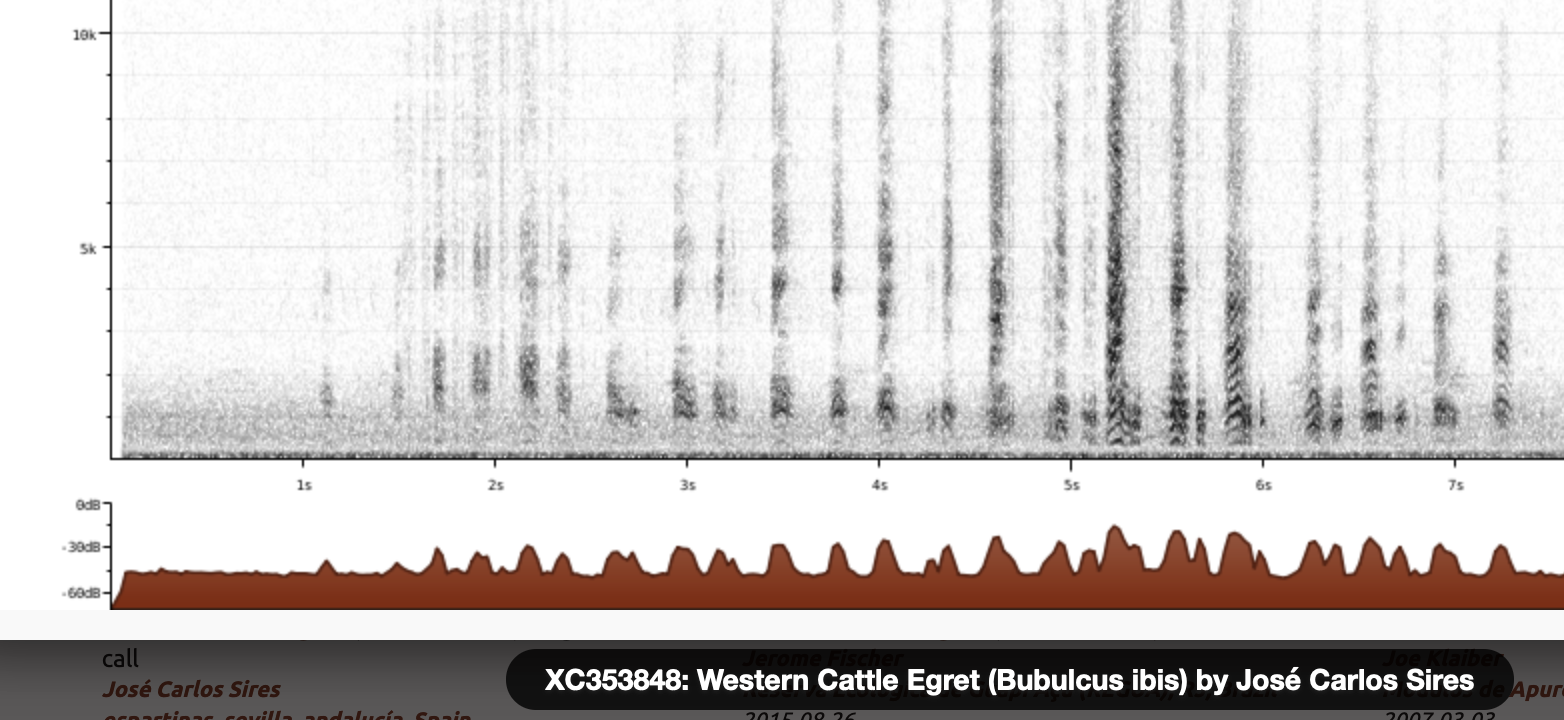
Call attributes:
flight call Frequency: ,
Green heron / Grünreiher (Butorides virescens)
Green heron. 2023-04-16 08.37.04 Yucatan
First observed in Yucatan on 2023-04-16.
General: ![]() The green heron (Butorides virescens) is a small heron of North and Central America. Butorides is from Middle English butor "bittern" and Ancient Greek -oides, "resembling", and virescens is Latin for "greenish".[2]
[more]
The green heron (Butorides virescens) is a small heron of North and Central America. Butorides is from Middle English butor "bittern" and Ancient Greek -oides, "resembling", and virescens is Latin for "greenish".[2]
[more]
Least bittern / Amerikanische Zwergdommel (Ixobrychus exilis)
Profile Wikipedia eBird Audubon AllAboutBirds Xeno-Canto
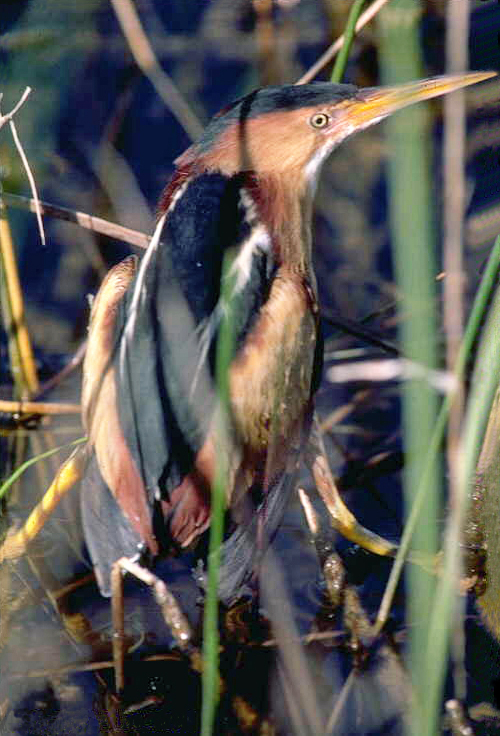
Wikipedia: Least bittern Source: OTHER
Ixobrychus_exilis.jpg
![]() The least bittern (Ixobrychus exilis) is a small heron, the smallest member of the family Ardeidae found in the Americas.
[more]
The least bittern (Ixobrychus exilis) is a small heron, the smallest member of the family Ardeidae found in the Americas.
[more]
American anhinga (Anhinga anhinga)
Wonderful patterns of an anhinga near RIo Lagartos. 2023-04-15 08.57.48 Yucatan
First observed in Yucatan on 2023-04-15.
Great frigatebird / Bindenfregattvogel (Fregata minor)
Profile Wikipedia eBird Audubon AllAboutBirds Xeno-Canto
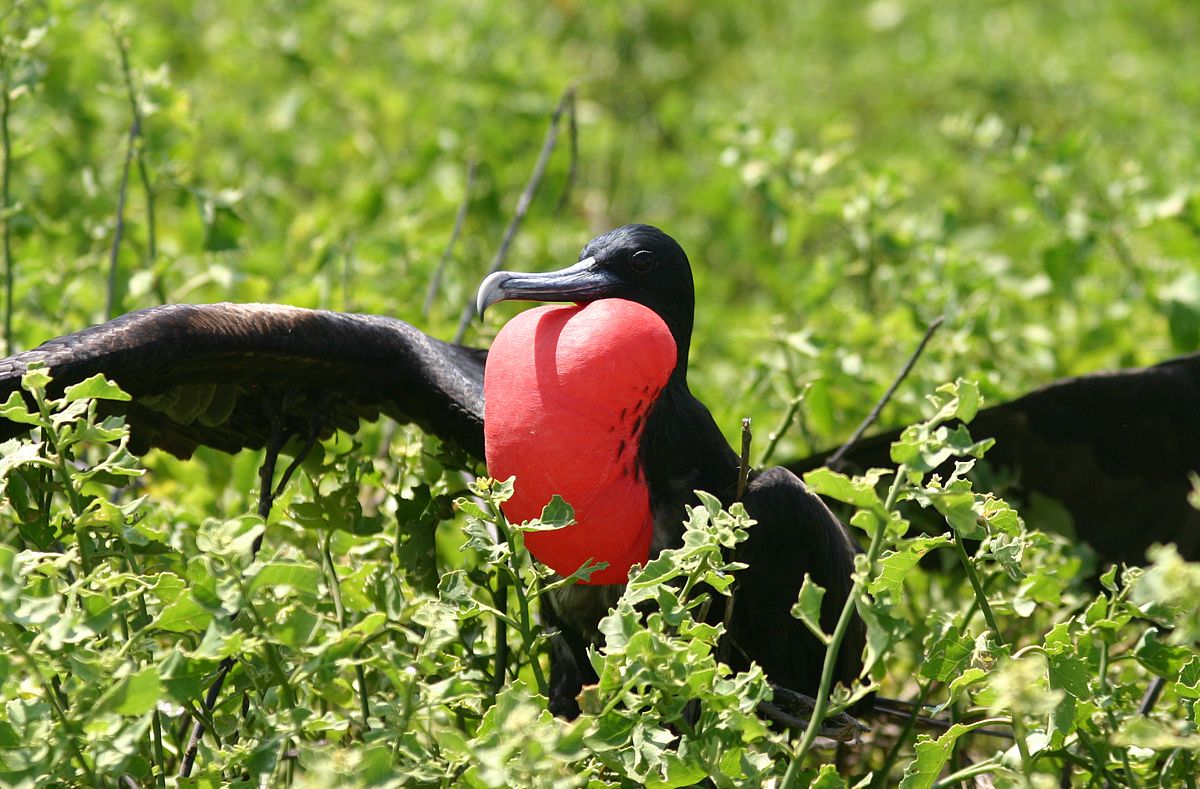
Wikipedia: Great frigatebird Source: OTHER
1200px-Male_greater_frigate_bird_displaying.jpg
This bird appears across the great seas in the following continents:
North America, South America, Africa, Asia.
![]() The great frigatebird (Fregata minor) is a large seabird in the frigatebird family. There are major nesting populations in the tropical Pacific (including the Galapagos Islands) and Indian Oceans, as well as a tiny population in the South Atlantic.
[more]
The great frigatebird (Fregata minor) is a large seabird in the frigatebird family. There are major nesting populations in the tropical Pacific (including the Galapagos Islands) and Indian Oceans, as well as a tiny population in the South Atlantic.
[more]
Magnificent frigatebird / Prachtfregattvogel (Fregata magnificens)
Profile Wikipedia eBird Audubon AllAboutBirds Xeno-Canto
Magnificent frigatebirds in Puerto Morelos. 2023-03-26 13.47.02 Yucatan
First observed in Yucatan on 2023-03-26.
This bird appears across the great seas in the following continents:
North America, South America, Africa.
![]() The magnificent frigatebird (Fregata magnificens) or man o' war is a seabird of the frigatebird family Fregatidae. With a length of 89–114 centimetres (35–45 in) and wingspan of 2.17–2.44 m (7.1–8.0 ft) it is the largest species of frigatebird. It occurs over tropical and subtropical waters off America, between northern Mexico and Perú on the Pacific coast and between Florida and southern Brazil along the Atlantic coast.[1] There are also populations on the Galápagos Islands in the Pacific and the Cape Verde islands in the Atlantic.
[more]
The magnificent frigatebird (Fregata magnificens) or man o' war is a seabird of the frigatebird family Fregatidae. With a length of 89–114 centimetres (35–45 in) and wingspan of 2.17–2.44 m (7.1–8.0 ft) it is the largest species of frigatebird. It occurs over tropical and subtropical waters off America, between northern Mexico and Perú on the Pacific coast and between Florida and southern Brazil along the Atlantic coast.[1] There are also populations on the Galápagos Islands in the Pacific and the Cape Verde islands in the Atlantic.
[more]
American white pelican / Nashornpelikan (Pelecanus erythrorhynchos)

Wikipedia: American white pelican Source: OTHER
1200px-American_White_Pelican.jpg
![]() The American white pelican (Pelecanus erythrorhynchos) is a large aquatic soaring bird from the order Pelecaniformes. It breeds in interior North America, moving south and to the coasts, as far as Central America and South America, in winter.[2]
[more]
The American white pelican (Pelecanus erythrorhynchos) is a large aquatic soaring bird from the order Pelecaniformes. It breeds in interior North America, moving south and to the coasts, as far as Central America and South America, in winter.[2]
[more]
Brown pelican (Pelecanus occidentalis)
Profile Wikipedia eBird Audubon AllAboutBirds Xeno-Canto
Brown pelican, Madeira Beach, Florida. 2023-09-27 11.48.26 Florida
First observed in Panama on 2020-03-08.
![]() The brown pelican (Pelecanus occidentalis) is a bird of the pelican family, Pelecanidae, one of three species found in the Americas and one of two that feed by diving into water. It is found on the Atlantic Coast from New Jersey to the mouth of the Amazon River, and along the Pacific Coast from British Columbia to northern Chile, including the Galapagos Islands. The nominate subspecies in its breeding plumage has a white head with a yellowish wash on the crown. The nape and neck are dark maroon–brown. The upper sides of the neck have white lines along the base of the gular pouch, and the lower fore neck has a pale yellowish patch. The male and female are similar, but the female is slightly smaller. The nonbreeding adult has a white head and neck. The pink skin around the eyes becomes dull and gray in the nonbreeding season. It lacks any red hue, and the pouch is strongly olivaceous ochre-tinged and the legs are olivaceous gray to blackish-gray.
[more]
The brown pelican (Pelecanus occidentalis) is a bird of the pelican family, Pelecanidae, one of three species found in the Americas and one of two that feed by diving into water. It is found on the Atlantic Coast from New Jersey to the mouth of the Amazon River, and along the Pacific Coast from British Columbia to northern Chile, including the Galapagos Islands. The nominate subspecies in its breeding plumage has a white head with a yellowish wash on the crown. The nape and neck are dark maroon–brown. The upper sides of the neck have white lines along the base of the gular pouch, and the lower fore neck has a pale yellowish patch. The male and female are similar, but the female is slightly smaller. The nonbreeding adult has a white head and neck. The pink skin around the eyes becomes dull and gray in the nonbreeding season. It lacks any red hue, and the pouch is strongly olivaceous ochre-tinged and the legs are olivaceous gray to blackish-gray.
[more]
Red-tailed tropicbird / Rotschwanz-Tropikvogel (Phaethon rubricauda)
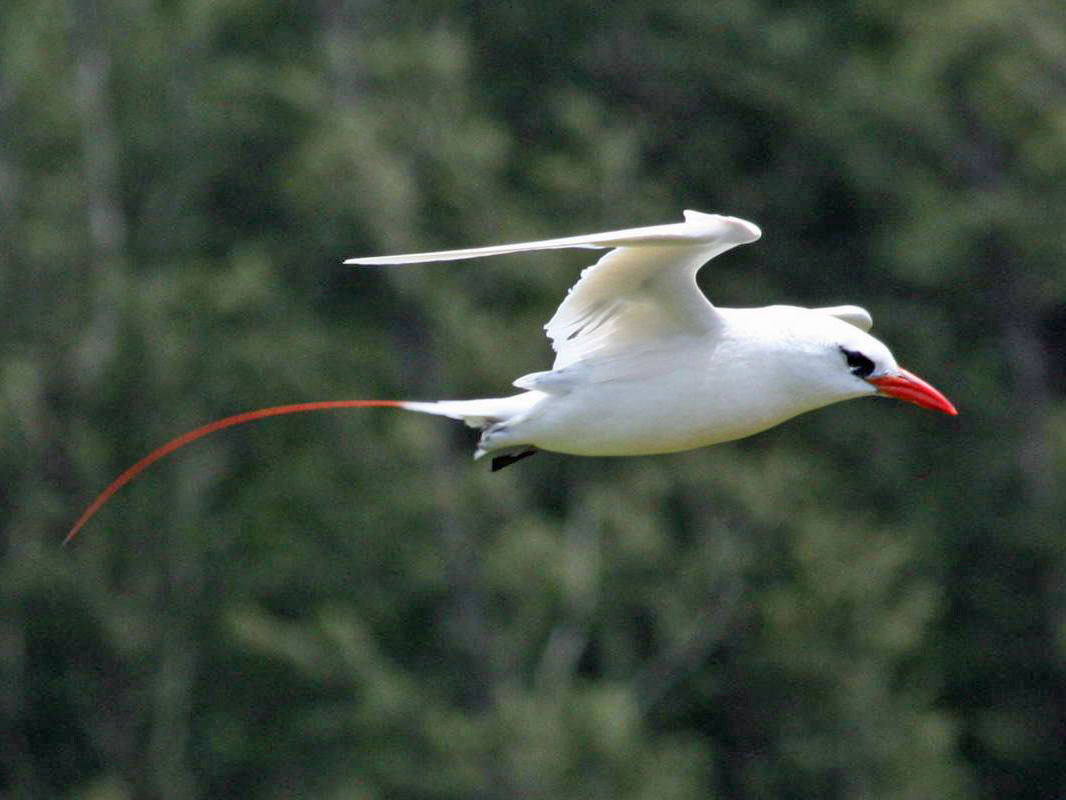
Wikipedia: Red-tailed tropicbird Source: OTHER
Red-tailed_Tropicbird_RWD2.jpg
This bird appears across the great seas in the following continents:
North America, Africa.
![]() The red-tailed tropicbird (Phaethon rubricauda) is a seabird native to tropical parts of the Indian and Pacific Oceans. One of three closely related species of tropicbird (Phaethontidae), it was described by Pieter Boddaert in 1783. Superficially resembling a tern in appearance, it has almost all-white plumage with a black mask and a red bill. The sexes have similar plumage. As referenced in the common name, adults have red tail streamers that are about twice their body length. Four subspecies are recognised, but there is evidence of clinal variation in body size—with smaller birds in the north and larger in the south—and hence no grounds for subspecies.
[more]
The red-tailed tropicbird (Phaethon rubricauda) is a seabird native to tropical parts of the Indian and Pacific Oceans. One of three closely related species of tropicbird (Phaethontidae), it was described by Pieter Boddaert in 1783. Superficially resembling a tern in appearance, it has almost all-white plumage with a black mask and a red bill. The sexes have similar plumage. As referenced in the common name, adults have red tail streamers that are about twice their body length. Four subspecies are recognised, but there is evidence of clinal variation in body size—with smaller birds in the north and larger in the south—and hence no grounds for subspecies.
[more]
Red-billed tropicbird / Rotschnabel-Tropikvogel (Phaethon aethereus)
Profile Wikipedia eBird Audubon AllAboutBirds Xeno-Canto

Wikipedia: Red-billed tropicbird Source: OTHER
1200px-Red-billed_tropicbird.jpg
This bird appears across the great seas in the following continents:
North America, South America, Africa.
![]() The red-billed tropicbird (Phaethon aethereus) is a tropicbird, one of three closely related species of seabird of tropical oceans. Superficially resembling a tern in appearance, it has mostly white plumage with some black markings on the wings and back, a black mask and, as its common name suggests, a red bill. Most adults have tail streamers that are about two times their body length, with those in males being generally longer than those in females. The red-billed tropicbird itself has three subspecies recognized, including the nominate. The subspecies mesonauta is distinguished from the nominate by the rosy tinge of its fresh plumage, and the subspecies indicus can be differentiated by its smaller size, more restricted mask, and more orange bill. This species ranges across the tropical Atlantic, eastern Pacific, and Indian Oceans. The nominate is found in the southern Atlantic Ocean, the subspecies indicus in the waters off of the Middle East and in the Indian Ocean, and the subspecies mesonauta in the eastern portions of both the Atlantic and the Pacific Oceans and in the Caribbean. It was one of the many species described by Carl Linnaeus in his 1758 10th edition of Systema Naturae.
[more]
The red-billed tropicbird (Phaethon aethereus) is a tropicbird, one of three closely related species of seabird of tropical oceans. Superficially resembling a tern in appearance, it has mostly white plumage with some black markings on the wings and back, a black mask and, as its common name suggests, a red bill. Most adults have tail streamers that are about two times their body length, with those in males being generally longer than those in females. The red-billed tropicbird itself has three subspecies recognized, including the nominate. The subspecies mesonauta is distinguished from the nominate by the rosy tinge of its fresh plumage, and the subspecies indicus can be differentiated by its smaller size, more restricted mask, and more orange bill. This species ranges across the tropical Atlantic, eastern Pacific, and Indian Oceans. The nominate is found in the southern Atlantic Ocean, the subspecies indicus in the waters off of the Middle East and in the Indian Ocean, and the subspecies mesonauta in the eastern portions of both the Atlantic and the Pacific Oceans and in the Caribbean. It was one of the many species described by Carl Linnaeus in his 1758 10th edition of Systema Naturae.
[more]
White-tailed tropicbird / Weißschwanz-Tropikvogel (Phaethon lepturus)
Profile Wikipedia eBird Audubon AllAboutBirds Xeno-Canto
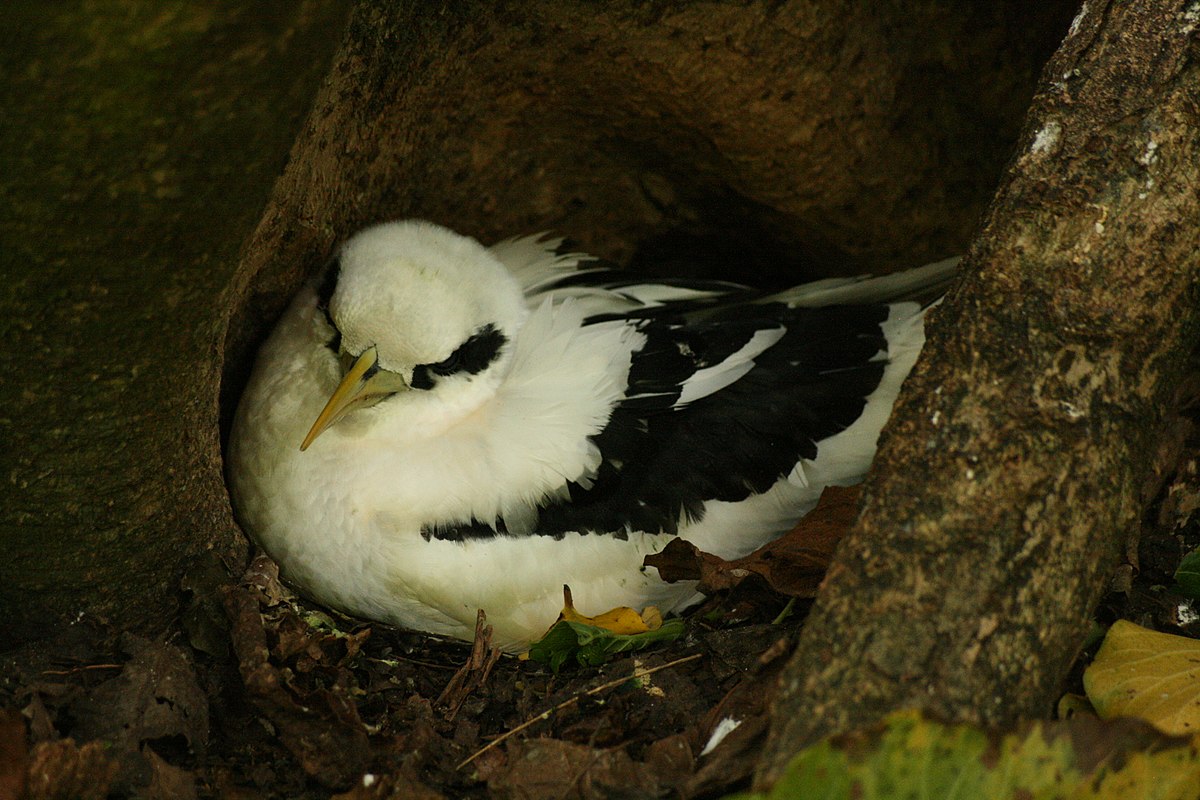
Wikipedia: White-tailed tropicbird Source: OTHER
1200px-White-tailed_Tropicbird_-_Phaeton_lepturus.jpg
This bird appears across the great seas in the following continents:
North America, Africa, Asia.
![]() The white-tailed tropicbird (Phaethon lepturus) is a species of tropicbird. It is the smallest of three closely related seabirds of the tropical oceans and smallest member of the order Phaethontiformes. It is found in the tropical Atlantic, western Pacific and Indian Oceans. It also breeds on some Caribbean islands, and a few pairs have started nesting recently on Little Tobago, joining the red-billed tropicbird colony. In addition to the tropical Atlantic, it nests as far north as Bermuda, where it is locally called a "longtail".[2]
[more]
The white-tailed tropicbird (Phaethon lepturus) is a species of tropicbird. It is the smallest of three closely related seabirds of the tropical oceans and smallest member of the order Phaethontiformes. It is found in the tropical Atlantic, western Pacific and Indian Oceans. It also breeds on some Caribbean islands, and a few pairs have started nesting recently on Little Tobago, joining the red-billed tropicbird colony. In addition to the tropical Atlantic, it nests as far north as Bermuda, where it is locally called a "longtail".[2]
[more]
Brown booby / Weißbauchtölpel (Sula leucogaster)
Profile Wikipedia eBird Audubon AllAboutBirds Xeno-Canto

Wikipedia: Brown booby Source: OTHER
1200px-Atob%C3%A1-pardo.jpg
This bird appears across the great seas in the following continents:
North America, South America, Africa, Asia.
![]() The brown booby (Sula leucogaster) is a large seabird of the booby family, Sulidae, of which it is perhaps the most common and widespread species.[3] It has a pantropical range, which overlaps with that of other booby species. The gregarious brown booby commutes and forages at low height over inshore waters. Flocks plunge-dive to take small fish, especially when these are driven near the surface by their predators. They only nest on the ground, and roost on solid objects rather than the water surface.[3]
[more]
The brown booby (Sula leucogaster) is a large seabird of the booby family, Sulidae, of which it is perhaps the most common and widespread species.[3] It has a pantropical range, which overlaps with that of other booby species. The gregarious brown booby commutes and forages at low height over inshore waters. Flocks plunge-dive to take small fish, especially when these are driven near the surface by their predators. They only nest on the ground, and roost on solid objects rather than the water surface.[3]
[more]
Red-footed booby / Rotfußtölpel (Sula sula)
Profile Wikipedia eBird Audubon AllAboutBirds Xeno-Canto
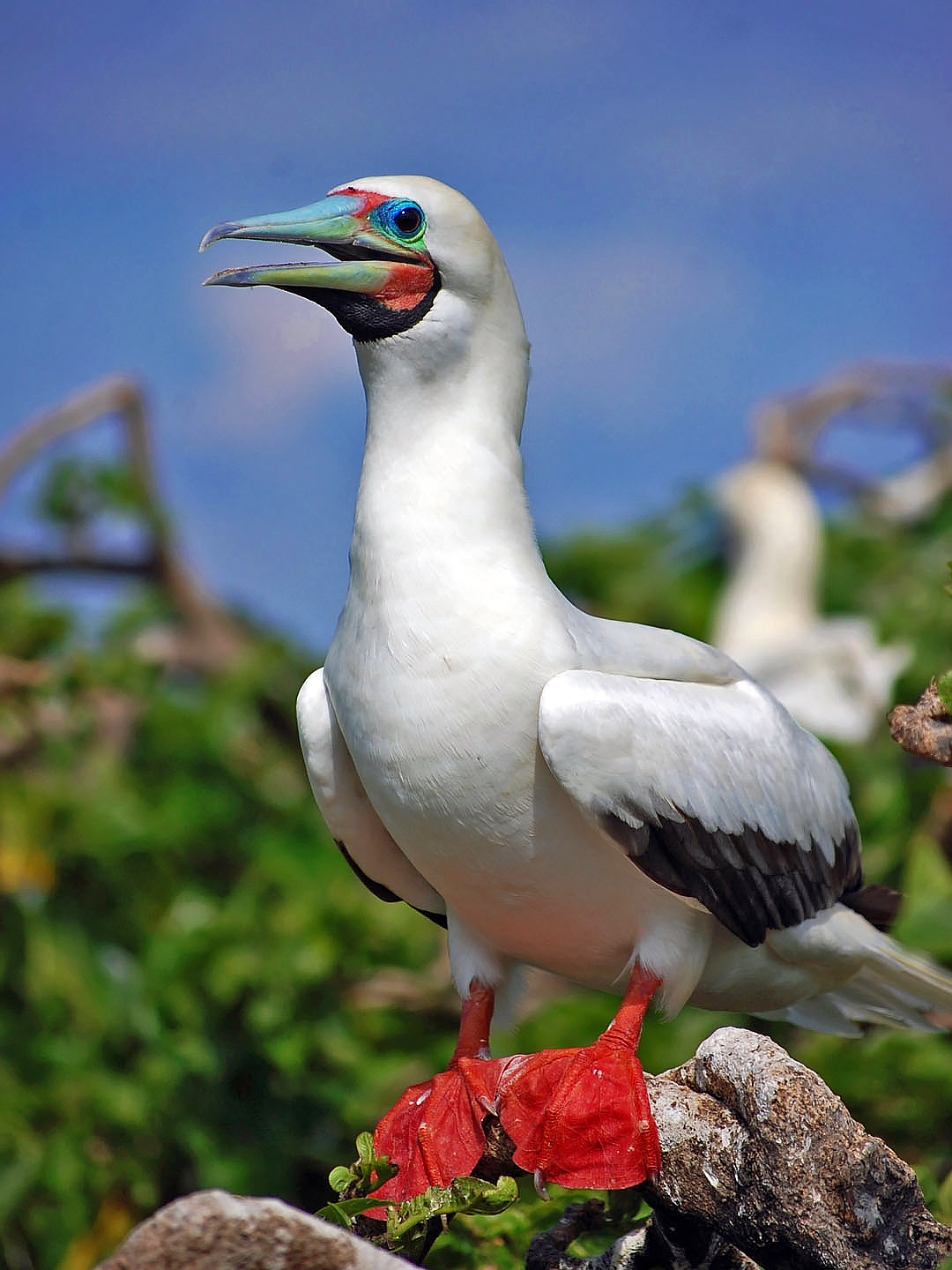
Wikipedia: Red-footed booby Source: OTHER
Sula_sula_by_Gregg_Yan_01.jpg
This bird appears across the great seas in the following continents:
North America, South America, Africa.
![]() The red-footed booby (Sula sula) is a large seabird of the booby family, Sulidae. Adults always have red feet, but the colour of the plumage varies. They are powerful and agile fliers, but they are clumsy in takeoffs and landings. They are found widely in the tropics, and breed colonially in coastal regions, especially islands. The species faces few natural or man-made threats, although its population is declining; it is considered to be a least-concern species by the International Union for Conservation of Nature (IUCN).
[more]
The red-footed booby (Sula sula) is a large seabird of the booby family, Sulidae. Adults always have red feet, but the colour of the plumage varies. They are powerful and agile fliers, but they are clumsy in takeoffs and landings. They are found widely in the tropics, and breed colonially in coastal regions, especially islands. The species faces few natural or man-made threats, although its population is declining; it is considered to be a least-concern species by the International Union for Conservation of Nature (IUCN).
[more]
Masked booby (Sula dactylatra)

Wikipedia: Masked booby Source: OTHER
1200px-Starr_080606-6808_Coronopus_didymus.jpg
This bird appears across the great seas in the following continents:
North America, South America, Africa, Asia.
![]() The masked booby (Sula dactylatra), also called the masked gannet or the blue-faced booby, is a large seabird of the booby and gannet family, Sulidae. First described by the French naturalist René-Primevère Lesson in 1831, the masked booby is one of six species of booby in the genus Sula. It has a typical sulid body shape, with a long pointed yellowish bill, long neck, aerodynamic body, long slender wings and pointed tail. The adult is bright white with black wings, a black tail and a dark face mask; at 75–85 cm (30–33 in) long, it is the largest species of booby. The sexes have similar plumage. This species ranges across tropical oceans, except in the eastern Atlantic and eastern Pacific. In the latter, it is replaced by the Nazca booby (Sula granti), which was formerly regarded as a subspecies of masked booby.
[more]
The masked booby (Sula dactylatra), also called the masked gannet or the blue-faced booby, is a large seabird of the booby and gannet family, Sulidae. First described by the French naturalist René-Primevère Lesson in 1831, the masked booby is one of six species of booby in the genus Sula. It has a typical sulid body shape, with a long pointed yellowish bill, long neck, aerodynamic body, long slender wings and pointed tail. The adult is bright white with black wings, a black tail and a dark face mask; at 75–85 cm (30–33 in) long, it is the largest species of booby. The sexes have similar plumage. This species ranges across tropical oceans, except in the eastern Atlantic and eastern Pacific. In the latter, it is replaced by the Nazca booby (Sula granti), which was formerly regarded as a subspecies of masked booby.
[more]
Northern gannet / Basstölpel (Morus bassanus)

Wikipedia: Northern gannet Source: OTHER
1200px-Morus_bassanus_adu.jpg
This bird appears across the great seas in the following continents:
Europe, North America, Africa.
Deutschland: Brut-, Jahres-, Zugvogel, Wintergast RL R
Vocalization: ![]() Heard mostly at breeding ground. Even, rhythmical series of harsh "harrr, harrr, harrr,". [Link]
Heard mostly at breeding ground. Even, rhythmical series of harsh "harrr, harrr, harrr,". [Link]
Physical details: length=87-100 cm,
wingspan=165-180 cm,
weight=2400-3600 g
Glossy ibis / Brauner Sichler (Plegadis falcinellus)
Sichler nach ornitho, Brauner Sichler nach Wikipedia oder Plegadis falcinellus, Neeracherried. Source: WIKIPEDIA
20220904_071146-DSC_0059 Sichler nach ornitho, Brauner Sichler nach Wikipedia oder Plegadis falcinellus, Neeracherried.JPG
2022-09-04 07.11.46
First observed in 🇨🇭 on 2022-09-04.
This bird appears across the great seas in the following continents:
Europe, North America, South America, Africa, Asia.
General: ![]() The glossy ibis (Plegadis falcinellus) is a water bird in the order Pelecaniformes and the ibis and spoonbill family Threskiornithidae. The scientific name derives from Ancient Greek plegados and Latin, falcis, both meaning "sickle" and referring to the distinctive shape of the bill.[2]
[more]
The glossy ibis (Plegadis falcinellus) is a water bird in the order Pelecaniformes and the ibis and spoonbill family Threskiornithidae. The scientific name derives from Ancient Greek plegados and Latin, falcis, both meaning "sickle" and referring to the distinctive shape of the bill.[2]
[more]
Vocalization: ![]() Generally silent away from breeding ground. Dry, crow-like "garr garr", may be heard occasionally in flight. At breeding ground various guttural grunts, and piping, hissing sounds. [Link]
Generally silent away from breeding ground. Dry, crow-like "garr garr", may be heard occasionally in flight. At breeding ground various guttural grunts, and piping, hissing sounds. [Link]
Physical details: length=55-65 cm,
wingspan=80-95 cm,
weight=530-768 g
White-faced ibis / Brillensichler (Plegadis chihi)
Profile Wikipedia eBird Audubon AllAboutBirds Xeno-Canto
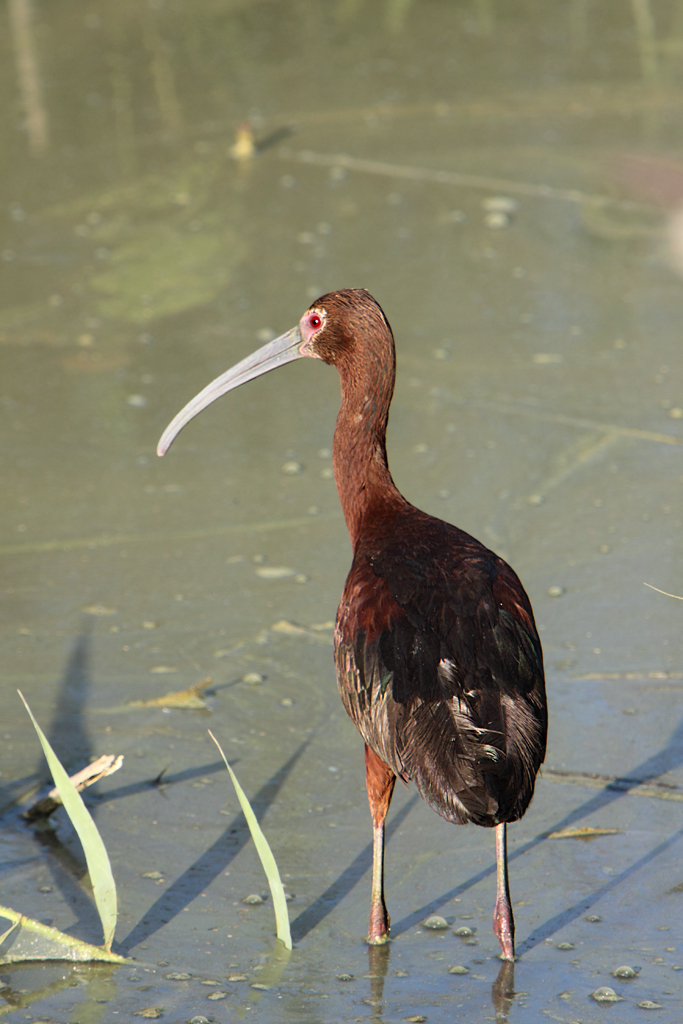
Wikipedia: White-faced ibis Source: OTHER
White-faced_Ibis_Great_Salt_Lake_1.jpg
General: ![]() The white-faced ibis (Plegadis chihi) is a wading bird in the ibis family, Threskiornithidae.
[more]
The white-faced ibis (Plegadis chihi) is a wading bird in the ibis family, Threskiornithidae.
[more]
Roseate spoonbill / Rosalöffler (Platalea ajaja)
Roseate spoonbills near Rio Lagartos. 2023-04-15 08.56.42 Yucatan
First observed in Yucatan on 2023-04-15.
![]() The roseate spoonbill (Platalea ajaja) is a gregarious wading bird of the ibis and spoonbill family, Threskiornithidae. It is a resident breeder in South America mostly east of the Andes, and in coastal regions of the Caribbean, Central America, Mexico, the Gulf Coast of the United States,[2][3] and from central Florida's Atlantic coast[4] at Merritt Island National Wildlife Refuge, adjoined with NASA Kennedy Space Center at least as far north as South Carolina's Myrtle Beach.[5]
[more]
The roseate spoonbill (Platalea ajaja) is a gregarious wading bird of the ibis and spoonbill family, Threskiornithidae. It is a resident breeder in South America mostly east of the Andes, and in coastal regions of the Caribbean, Central America, Mexico, the Gulf Coast of the United States,[2][3] and from central Florida's Atlantic coast[4] at Merritt Island National Wildlife Refuge, adjoined with NASA Kennedy Space Center at least as far north as South Carolina's Myrtle Beach.[5]
[more]
White ibis (Eudocimus albus)
Profile Wikipedia eBird Audubon AllAboutBirds Xeno-Canto
White ibises in flight, St Petersburg. 2023-09-23 19.16.50 Florida
First observed in Florida on 2023-09-23.

Wikipedia: Bushtit Source: OTHER
1200px-Aegithalos_caudatus_side-on.jpg
![]() The bushtits or long-tailed tits, Aegithalidae, are a family of small, drab passerine birds with moderately long tails. The family contains 13 species in four genera, all but one of which are found in Eurasia. Bushtits are active birds, moving almost constantly while they forage for insects in shrubs and trees. During non-breeding season, birds live in flocks of up to 50 individuals.[1] Several bushtit species display cooperative breeding behavior, also called helpers at the nest.[1][2][3]
[more]
The bushtits or long-tailed tits, Aegithalidae, are a family of small, drab passerine birds with moderately long tails. The family contains 13 species in four genera, all but one of which are found in Eurasia. Bushtits are active birds, moving almost constantly while they forage for insects in shrubs and trees. During non-breeding season, birds live in flocks of up to 50 individuals.[1] Several bushtit species display cooperative breeding behavior, also called helpers at the nest.[1][2][3]
[more]

Wikipedia: Saipan reed warbler Source: OTHER
Saipan_Reed_Warbler_Acrocephalus_hiwae_on_Saipan.jpg
![]() The Saipan reed warbler (Acrocephalus hiwae) is a critically endangered songbird of the Northern Mariana Islands. It is considered a subspecies of the nightingale reed warbler by some taxonomists. It occurs on two islands : Saipan and Alamagan. An estimated population of 2700 specimen was reported in 2009 on Saipan, and on Alamagan 950 specimen were reported in 2010.[1]
[more]
The Saipan reed warbler (Acrocephalus hiwae) is a critically endangered songbird of the Northern Mariana Islands. It is considered a subspecies of the nightingale reed warbler by some taxonomists. It occurs on two islands : Saipan and Alamagan. An estimated population of 2700 specimen was reported in 2009 on Saipan, and on Alamagan 950 specimen were reported in 2010.[1]
[more]
Profile Wikipedia eBird A-Z Animals Audubon AllAboutBirds Xeno-Canto

Wikipedia: Golden-crowned kinglet Source: OTHER
Regulus_satrapa_-Canada-8a.jpg
![]() The golden-crowned kinglet (Regulus satrapa) is a very small songbird in the family Regulidae that lives throughout much of North America.
[more]
The golden-crowned kinglet (Regulus satrapa) is a very small songbird in the family Regulidae that lives throughout much of North America.
[more]
Profile Wikipedia eBird Audubon AllAboutBirds Xeno-Canto
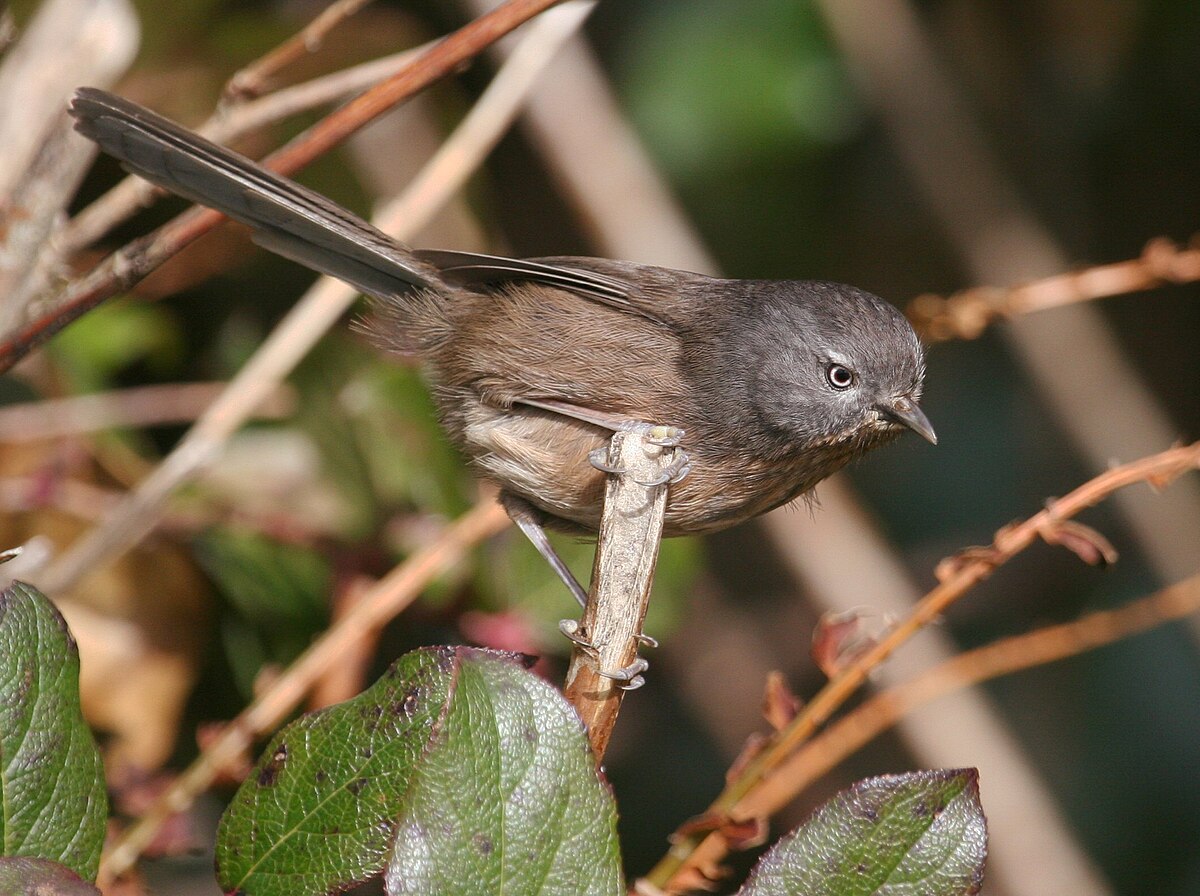
Wikipedia: Wrentit Source: OTHER
1200px-Wrentit_edit.jpg
![]() The wrentit (Chamaea fasciata) is a small bird that lives in chaparral, oak woodlands, and bushland on the western coast of North America. It is the only species in the genus Chamaea.
[more]
The wrentit (Chamaea fasciata) is a small bird that lives in chaparral, oak woodlands, and bushland on the western coast of North America. It is the only species in the genus Chamaea.
[more]
Profile Wikipedia eBird Audubon AllAboutBirds Xeno-Canto
Five red-whiskered bulbuls. 2024-02-10 15.05.58 Laos
First observed in Thailand on 2024-01-21.
This bird appears across the great seas in the following continents:
North America, Asia, Australia.
introduced
Call:
Automatically generated from Xeno-Canto recording
♫ XC776525 - Red-whiskered Bulbul - Pycnonotus jocosus pattani. Source: XENOCANTO
XC776525 - Red-whiskered Bulbul - Pycnonotus jocosus pattani.mp3
(song?)

Profile Wikipedia eBird Audubon AllAboutBirds Xeno-Canto

Wikipedia: Red-vented bulbul Source: OTHER
Red_Vented_Bulbul_India.jpg
General: ![]() The red-vented bulbul (Pycnonotus cafer) is a member of the bulbul family of passerines. It is a resident breeder across the Indian subcontinent, including Sri Lanka extending east to Burma and parts of Tibet. It has been introduced in many other parts of the world and has established itself in the wild on several Pacific islands including Fiji, Samoa, Tonga and Hawaii. It has also established itself in parts of the United Arab Emirates, Bahrain, the United States and Argentina.[2] It is included in the list of the world's 100 worst invasive alien species.[3]
[more]
The red-vented bulbul (Pycnonotus cafer) is a member of the bulbul family of passerines. It is a resident breeder across the Indian subcontinent, including Sri Lanka extending east to Burma and parts of Tibet. It has been introduced in many other parts of the world and has established itself in the wild on several Pacific islands including Fiji, Samoa, Tonga and Hawaii. It has also established itself in parts of the United Arab Emirates, Bahrain, the United States and Argentina.[2] It is included in the list of the world's 100 worst invasive alien species.[3]
[more]
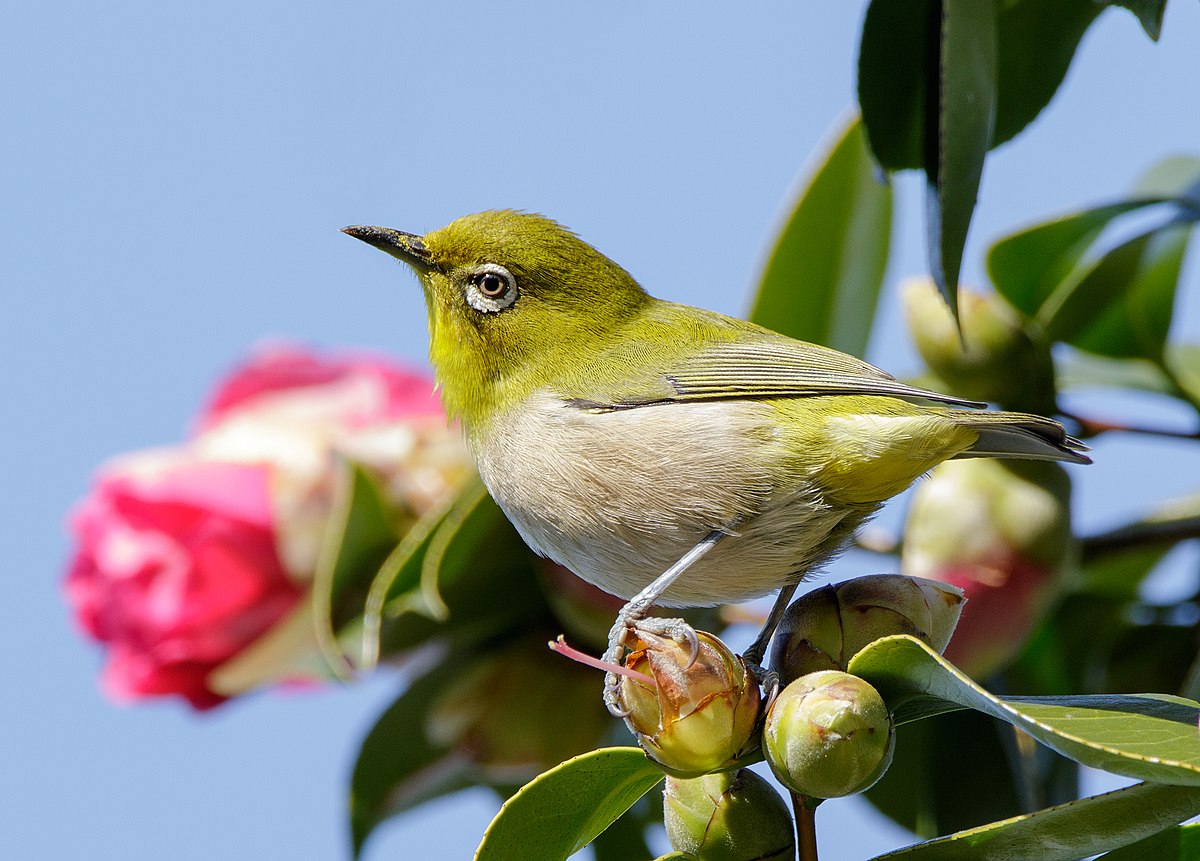
Wikipedia: Japanese white-eye Source: OTHER
1200px-Japanese_white-eye_at_Tenn%C5%8Dji_Park_in_Osaka%2C_January_2016_III.jpg
![]() The warbling white-eye (Zosterops japonicus), also known as the Japanese white-eye and mountain white-eye, is a small passerine bird in the white-eye family. The specific epithet is occasionally written japonica, but this is incorrect due to the gender of the genus. Its native range includes much of East Asia, including the Russian Far East, Japan, Indonesia, Korea, and the Philippines. It has been intentionally introduced to other parts of the world as a pet and as pest control, with mixed results. As one of the native species of the Japanese islands, it has been depicted in Japanese art on numerous occasions, and historically was kept as a cage bird.
[more]
The warbling white-eye (Zosterops japonicus), also known as the Japanese white-eye and mountain white-eye, is a small passerine bird in the white-eye family. The specific epithet is occasionally written japonica, but this is incorrect due to the gender of the genus. Its native range includes much of East Asia, including the Russian Far East, Japan, Indonesia, Korea, and the Philippines. It has been intentionally introduced to other parts of the world as a pet and as pest control, with mixed results. As one of the native species of the Japanese islands, it has been depicted in Japanese art on numerous occasions, and historically was kept as a cage bird.
[more]
Profile Wikipedia eBird Audubon AllAboutBirds Xeno-Canto
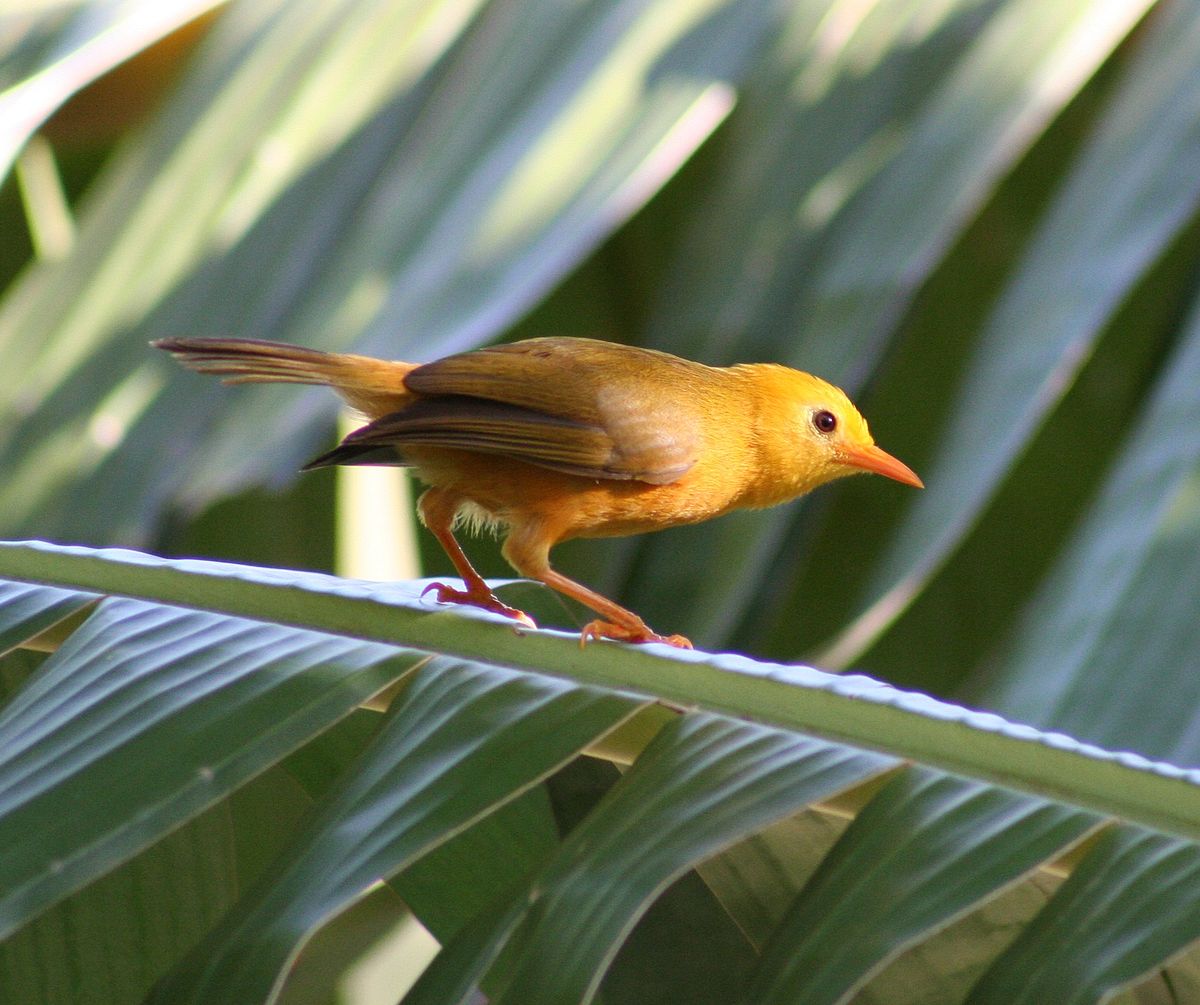
Wikipedia: Golden white-eye Source: OTHER
1200px-Golden_White-Eye_palm.jpg
![]() The golden white-eye (Cleptornis marchei) is a species of bird in the white-eye family, Zosteropidae. It is the only species within the genus Cleptornis. The golden white-eye was once considered to be a honeyeater in the family Meliphagidae and although it is now known to be a white-eye, its position within that family is still uncertain. The species is restricted to the islands of Saipan and Aguijan in the Northern Mariana Islands, where it is sympatric (shares its range) and competes with the related bridled white-eye. The golden white-eye has golden plumage and a pale eye-ring. It feeds on insects, fruit, and nectar and forages in pairs or small family groups. The bird is monogamous and lays two eggs in a small cup nest.
[more]
The golden white-eye (Cleptornis marchei) is a species of bird in the white-eye family, Zosteropidae. It is the only species within the genus Cleptornis. The golden white-eye was once considered to be a honeyeater in the family Meliphagidae and although it is now known to be a white-eye, its position within that family is still uncertain. The species is restricted to the islands of Saipan and Aguijan in the Northern Mariana Islands, where it is sympatric (shares its range) and competes with the related bridled white-eye. The golden white-eye has golden plumage and a pale eye-ring. It feeds on insects, fruit, and nectar and forages in pairs or small family groups. The bird is monogamous and lays two eggs in a small cup nest.
[more]
Profile Wikipedia eBird A-Z Animals Vogelwarte BirdLife ZH ornitho.ch bird-song.ch Audubon AllAboutBirds Xeno-Canto BirdID NABU
Barn swallow. 2022-05-05 09.41.44 Maryland
First observed in 🇨🇭 on 2020-04-16.
This bird appears across the great seas in the following continents:
Europe, North America, South America, Africa, Asia.
Die langen Schwanzfedern vom Rauchschwalbe und anderen geben auch dem Schmetterling Schwalbenschwanz seine deutschen Namen.
Etymology: ![]() In früheren Jahrhunderten flogen sie vielfach durch die Öffnungen im Giebel ein und aus, durch die auch der Rauch des Herdfeuers abzog. So erhielten sie den Namen Rauchschwalben. [Link]
In früheren Jahrhunderten flogen sie vielfach durch die Öffnungen im Giebel ein und aus, durch die auch der Rauch des Herdfeuers abzog. So erhielten sie den Namen Rauchschwalben. [Link]
Appearance and identification: ![]() Rauchschwalbes Bauch ist etwas braun rot, nicht weiss wie der von der Mehlschwalbe - was wahrscheinlich Quelle der zwei Namen ist. [Link]
Rauchschwalbes Bauch ist etwas braun rot, nicht weiss wie der von der Mehlschwalbe - was wahrscheinlich Quelle der zwei Namen ist. [Link]
Song: ![]() Characteristic calls and song. Song a sparkling, squeaky energetic improvisation with interspersed contact calls, often with diagnostic ending; an electric and drawn-out "su-eerrrrrrrrrrrrrrr". [Link]
Characteristic calls and song. Song a sparkling, squeaky energetic improvisation with interspersed contact calls, often with diagnostic ending; an electric and drawn-out "su-eerrrrrrrrrrrrrrr". [Link]
Calls: ![]() Contact call a short and sharp "weet" or "kee-weet". [Link]
Contact call a short and sharp "weet" or "kee-weet". [Link]
Physical details: length=17-19 cm,
wingspan=32-34 cm,
weight=16-22 g
Habitats:
Settlement
Looks similar to:
Common house martin.
Song:
General: Squeaky with occasional buzzes, usually heard in flock.
Song: ![]() Kann melodisch sein wenn einzeln gehört statt viele zusammen. [Link]
Kann melodisch sein wenn einzeln gehört statt viele zusammen. [Link]
Song attributes:
Melody: stereotype melodic, fast, Frequency: 2-6 KHz
Call:
Automatically generated from Xeno-Canto recording
♫ Barn swallows on the hunt, some quite high. 2020-08-18 13.01.00 Luppmen (song?)
Tree swallow at Cromwell. 2022-04-29 12.44.58 Maryland
First observed in Maryland on 2021-06-14.
General: ![]() The tree swallow (Tachycineta bicolor) is a migratory bird of the family Hirundinidae. Found in the Americas, the tree swallow was first described in 1807 by French ornithologist Louis Vieillot as Hirundo bicolor. It has since been moved to its current genus, Tachycineta, within which its phylogenetic placement is debated. The tree swallow has glossy blue-green upperparts, with the exception of the blackish wings and tail, and white underparts. The bill is black, the eyes dark brown, and the legs and feet pale brown. The female is generally duller than the male, and the first-year female has mostly brown upperparts, with some blue feathers. Juveniles have brown upperparts, and a grey-brown-washed breast. The tree swallow breeds in the US and Canada. It winters along southern US coasts south, along the Gulf Coast, to Panama and the northwestern coast of South America, and in the West Indies.
[more]
The tree swallow (Tachycineta bicolor) is a migratory bird of the family Hirundinidae. Found in the Americas, the tree swallow was first described in 1807 by French ornithologist Louis Vieillot as Hirundo bicolor. It has since been moved to its current genus, Tachycineta, within which its phylogenetic placement is debated. The tree swallow has glossy blue-green upperparts, with the exception of the blackish wings and tail, and white underparts. The bill is black, the eyes dark brown, and the legs and feet pale brown. The female is generally duller than the male, and the first-year female has mostly brown upperparts, with some blue feathers. Juveniles have brown upperparts, and a grey-brown-washed breast. The tree swallow breeds in the US and Canada. It winters along southern US coasts south, along the Gulf Coast, to Panama and the northwestern coast of South America, and in the West Indies.
[more]
Profile Wikipedia eBird Audubon AllAboutBirds Xeno-Canto

Wikipedia: Violet-green swallow Source: OTHER
Tachycineta_thalassina_-San_Luis_Obispo%2C_California%2C_USA_-male-8_%281%29.jpg
![]() The violet-green swallow (Tachycineta thalassina) is a small North American passerine bird in the swallow family. These aerial insectivores are distributed along the west coast from Alaska to Mexico, extending as far east as Montana and Texas. With an appearance very similar to the tree swallow, these individuals can be identified by the white rump side-patches that appear to separate their green back and purple tail. Violet-green swallows are secondary cavity nesters, found in a number of habitats including deciduous and coniferous forest. In addition to nesting in tree holes within these habitats, they are also widely observed nesting in the cracks of large cliffs.[2]
[more]
The violet-green swallow (Tachycineta thalassina) is a small North American passerine bird in the swallow family. These aerial insectivores are distributed along the west coast from Alaska to Mexico, extending as far east as Montana and Texas. With an appearance very similar to the tree swallow, these individuals can be identified by the white rump side-patches that appear to separate their green back and purple tail. Violet-green swallows are secondary cavity nesters, found in a number of habitats including deciduous and coniferous forest. In addition to nesting in tree holes within these habitats, they are also widely observed nesting in the cracks of large cliffs.[2]
[more]
Profile Wikipedia eBird Audubon AllAboutBirds Xeno-Canto
Could be a wild guess - MerlinBirdID says purple martin - it says identification features are (in part) best left unidentified. 2023-04-01 14.20.30 Yucatan
First observed in Yucatan on 2023-04-01.
![]() The purple martin (Progne subis) is the largest swallow in North America. Despite their name, purple martins are not truly purple. Their dark blackish-blue feathers have an iridescent sheen caused by the refraction of incident light[2] giving them a bright blue to navy blue or deep purple appearance. In some light they may even appear green in color.
[more]
The purple martin (Progne subis) is the largest swallow in North America. Despite their name, purple martins are not truly purple. Their dark blackish-blue feathers have an iridescent sheen caused by the refraction of incident light[2] giving them a bright blue to navy blue or deep purple appearance. In some light they may even appear green in color.
[more]
Profile Wikipedia eBird Audubon AllAboutBirds Xeno-Canto
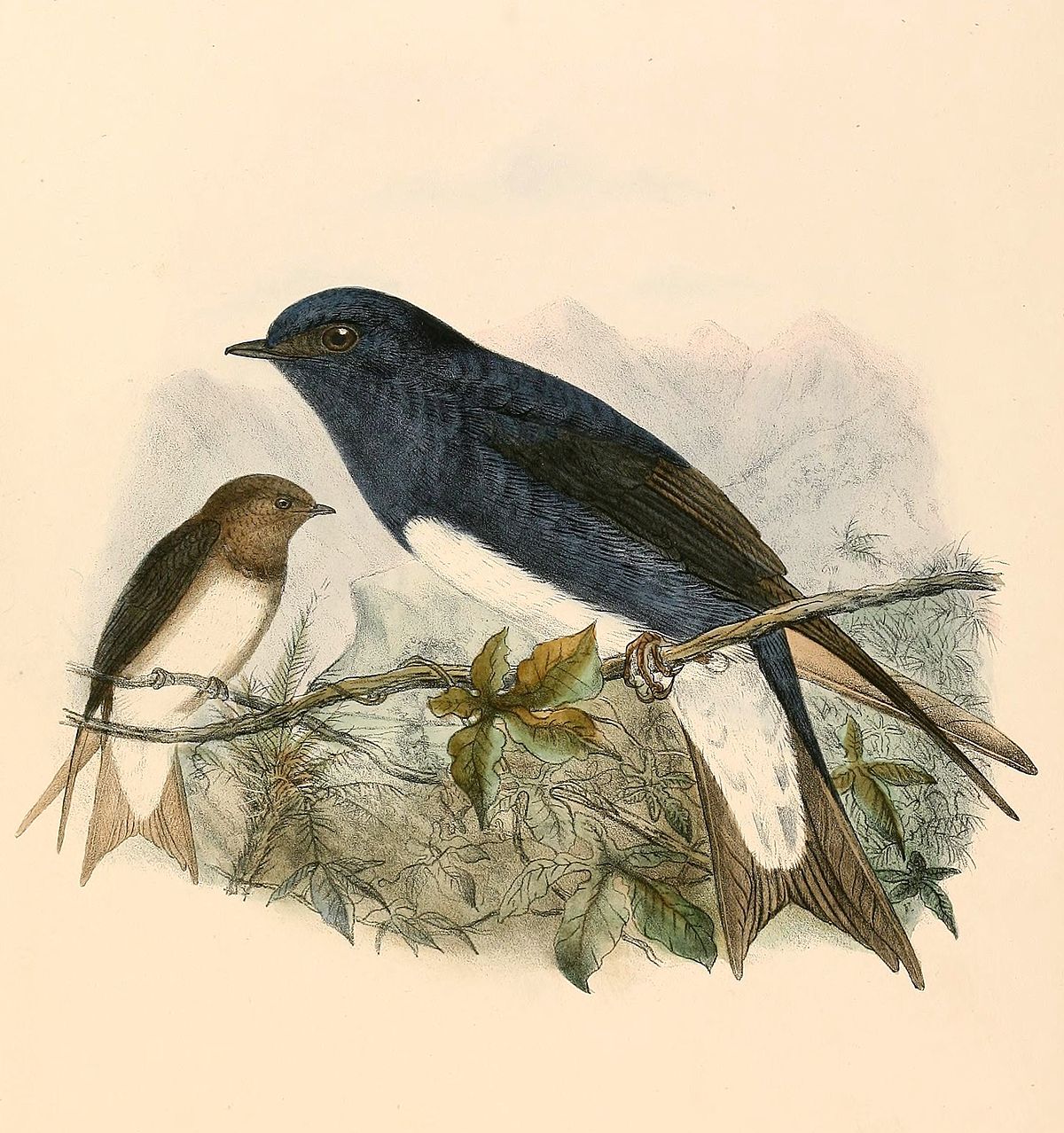
Wikipedia: Caribbean martin Source: OTHER
1200px-Progne_dominicensis_1894.jpg
![]() The Caribbean martin or white-bellied martin (Progne dominicensis) is a large swallow.
[more]
The Caribbean martin or white-bellied martin (Progne dominicensis) is a large swallow.
[more]
Profile Wikipedia eBird Audubon AllAboutBirds Xeno-Canto
Northern rough-winged swallow. 2022-05-01 09.39.08 Maryland
First observed in Maryland on 2022-05-01.
![]() The northern rough-winged swallow (Stelgidopteryx serripennis) is a small, migratory swallow. It is very similar to the southern rough-winged swallow, Stelgidopteryx ruficollis.
[more]
The northern rough-winged swallow (Stelgidopteryx serripennis) is a small, migratory swallow. It is very similar to the southern rough-winged swallow, Stelgidopteryx ruficollis.
[more]
Bank swallow. 2024-01-26 15.58.58 Thailand
First observed in Thailand on 2024-01-26.
This bird appears across the great seas in the following continents:
Europe, North America, South America, Africa, Asia.
![]() The sand martin (Riparia riparia) or European sand martin, bank swallow, and collared sand martin in India, is a migratory passerine bird in the swallow family. It has a wide range in summer, embracing practically the whole of Europe and the Mediterranean countries and across the Palearctic to the Pacific Ocean. It is a Holarctic species also found in North America. It winters in eastern and southern Africa, South America, and the Indian Subcontinent.
[more]
The sand martin (Riparia riparia) or European sand martin, bank swallow, and collared sand martin in India, is a migratory passerine bird in the swallow family. It has a wide range in summer, embracing practically the whole of Europe and the Mediterranean countries and across the Palearctic to the Pacific Ocean. It is a Holarctic species also found in North America. It winters in eastern and southern Africa, South America, and the Indian Subcontinent.
[more]
Song: ![]() Song a primitive improvisation on the contact call. [Link]
Song a primitive improvisation on the contact call. [Link]
Calls: ![]() Contact call a mono- or disyllabic "trrrrt". Similar to House Martin but more raucous and less crisp, with less rolling r's, and with stable pitch throughout. Alarm call similar to House Martin; a sharp plaintive "tseep", but somewhat purer and more drawn. [Link]
Contact call a mono- or disyllabic "trrrrt". Similar to House Martin but more raucous and less crisp, with less rolling r's, and with stable pitch throughout. Alarm call similar to House Martin; a sharp plaintive "tseep", but somewhat purer and more drawn. [Link]
Physical details: length=12 cm,
wingspan=26-29 cm,
weight=11-16 g
Habitats:
Wetland
Song:
Fast raspy one-noter.
Song attributes:
Melody: non-musical, fast, Frequency: 1-7 KHz Special sounds: rasp
♫ Source: XENOCANTO
XC344092 - Sand Martin - Riparia riparia - raspy song but note, does not sing often.mp3
(song)


Wikipedia: Cliff swallow Source: OTHER
Petrochelidon_pyrrhonota_-flight_-Palo_Alto_Baylands-8.jpg
This bird appears across the great seas in the following continents:
Europe, North America, South America.
General: ![]() The cliff swallow or American cliff swallow (Petrochelidon pyrrhonota) is a member of the passerine bird family Hirundinidae, the swallows and martins.[2] The scientific name is derived from Ancient Greek; Petrochelidon originates from the petros meaning "rock" and khelidon "swallow", pyrrhonota comes from purrhos meaning "flame-coloured" and -notos "-backed".[3]
[more]
The cliff swallow or American cliff swallow (Petrochelidon pyrrhonota) is a member of the passerine bird family Hirundinidae, the swallows and martins.[2] The scientific name is derived from Ancient Greek; Petrochelidon originates from the petros meaning "rock" and khelidon "swallow", pyrrhonota comes from purrhos meaning "flame-coloured" and -notos "-backed".[3]
[more]
Profile Wikipedia eBird Audubon AllAboutBirds Xeno-Canto
Cave swallows at Izamal, from the name an unlikely city dweller but others also identify them as such. 2023-04-11 18.23.06 Yucatan
First observed in Yucatan on 2023-04-11.
![]() The cave swallow (Petrochelidon fulva) is a medium-sized, squarish tailed swallow belonging to the same genus as the more familiar and widespread cliff swallow of North America. The cave swallow, also native to the Americas, nests and roosts primarily in caves and sinkholes.
[more]
The cave swallow (Petrochelidon fulva) is a medium-sized, squarish tailed swallow belonging to the same genus as the more familiar and widespread cliff swallow of North America. The cave swallow, also native to the Americas, nests and roosts primarily in caves and sinkholes.
[more]
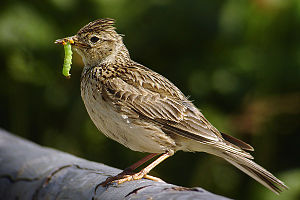
Wikipedia Eurasian Skylark (Alauda arvensis). Source: WIKIPEDIA
Wikipedia Eurasian Skylark (Alauda_arvensis).jpg
First observed in 🇨🇭 on 2022-06-25.
This bird appears across the great seas in the following continents:
Europe, North America (introduced), Africa.
Good to know: ![]() Aus dem Kurzjahresbericht BirdLife Schweiz 2022: Die Feldlerche, vogel der Jahres 2022..., ist eihne dieser bredrohten Arten, welche durch die Industrialisierung der Landwirtschaft ausgerottet wird. [Link]
Aus dem Kurzjahresbericht BirdLife Schweiz 2022: Die Feldlerche, vogel der Jahres 2022..., ist eihne dieser bredrohten Arten, welche durch die Industrialisierung der Landwirtschaft ausgerottet wird. [Link]
Appearance and identification: ![]() Somewhat like a house sparrow but 18-19 cm long, not 14-15, kleiner als Star. Ruffled head feathers. NABU says streaks on breast contrast with white belly. [Link]
Somewhat like a house sparrow but 18-19 cm long, not 14-15, kleiner als Star. Ruffled head feathers. NABU says streaks on breast contrast with white belly. [Link]
Geography: ![]() Introduced population in North America is gradually declining. [Link]
Introduced population in North America is gradually declining. [Link]
Stark gefährdet durch Verlust von geeignetem Lebensraum. Eine Massnahme ist die Erstellung von Lerchenfenstern auf den Feldern - eine kleine Fläche mitten im Feld, die nicht bepflanzt oder gemäht wird. So was sieht man bei uns, z.B. zwischen Freudwil und Gutenswil, wobei ich nicht genau weiss, ob Feldlerchen das Ziel davon sind. Die Infos habe ich vom FOK Kurs 2021-2022 von Christina Ebneter.
Song: ![]() Song a pleasing energetic stream of chirping, merry trills, interspersed with mimicry. Trills quite resonant with fairly full tone. Song usually given in flight high in the air. Less characteristic, shorter, weaker and more varied song when given from ground. [Link]
Song a pleasing energetic stream of chirping, merry trills, interspersed with mimicry. Trills quite resonant with fairly full tone. Song usually given in flight high in the air. Less characteristic, shorter, weaker and more varied song when given from ground. [Link]
Calls: ![]() Most typical flight call a short trilling "chirrup", with the end note noticeably lower pitched than the start. Also several other more cryptic calls. [Link]
Most typical flight call a short trilling "chirrup", with the end note noticeably lower pitched than the start. Also several other more cryptic calls. [Link]
Physical details: length=18-19 cm,
wingspan=30-36 cm,
weight=26-50 g
Habitats:
Agricultural
Song:
Fast chirpy improvization without a break, not very high, reminds me of a nightingale or a Eurasian reed warbler/Teichrohrsänger with the exact rhythm, but most likely sung in a cornfield. Or a Singdrossel that repeats its elements longer that that guy. Repeats elements 1-8 times. Sometimes buzzy/trilly. Can go on for minutes at a time. Ich habe es auch mit einem Amsel verwechselt, da er lang und melodisch, fast wie Amsel aber hört nicht auf.
Song attributes:
Melody: sings 30 seconds or longer, slow, Frequency: 2-6 KHz Special sounds: mimicry
♫ Source: XENOCANTO
XC685846 - Eurasian Skylark - Alauda arvensis - song, recorded in France.mp3
(song)

Call:
Automatically generated from Xeno-Canto recording
♫ Source: BirdNet
20220625_082224 birdnet - Feldlerche im Maisfeld bei La Sauge - birdnet_mobile_5867288364_recording_3659.mp3
2022-06-25 08.22.24 La Sauge (song?)
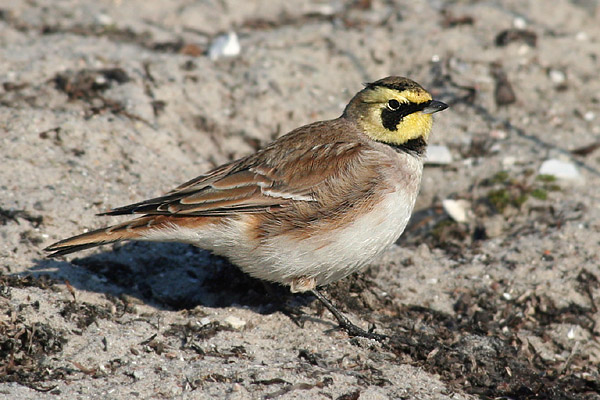
Wikipedia: Horned lark Source: OTHER
Eremophila_alpestris2.jpg
This bird appears across the great seas in the following continents:
Europe, North America, Africa.
Deutschland: Wintergast
Song: ![]() Song a stream of thin and tinkling, squeaking notes with a recurring, drawn, ringing and slightly ascending chirp. Timbre resemblant to Lapland Bunting. Often given from high in the air, being difficult to locate. More hesitantly when given from the ground with a stumbling introduction. [Link]
Song a stream of thin and tinkling, squeaking notes with a recurring, drawn, ringing and slightly ascending chirp. Timbre resemblant to Lapland Bunting. Often given from high in the air, being difficult to locate. More hesitantly when given from the ground with a stumbling introduction. [Link]
Calls: ![]() Flight call quite similar to Meadow Pipit's "tseep" call, but less anxious. [Link]
Flight call quite similar to Meadow Pipit's "tseep" call, but less anxious. [Link]
Physical details: length=14-17 cm,
wingspan=30-35 cm,
weight=26-46 g

Wikipedia: Arctic warbler Source: OTHER
Arctic_Warbler_4683b.jpg
This bird appears across the great seas in the following continents:
Europe, North America, Asia, Australia.
vagrant
Song: ![]() Call and song diagnostic. Song a rattling series of 20-30 single syllables. Repeated as a monotonous phrase in stable pitch, lasting 2-4 seconds. Starts more softly with volume rising throughout each phrase. Often given as introductory part of song. [Link]
Call and song diagnostic. Song a rattling series of 20-30 single syllables. Repeated as a monotonous phrase in stable pitch, lasting 2-4 seconds. Starts more softly with volume rising throughout each phrase. Often given as introductory part of song. [Link]
Calls: ![]() Contact call equally unique. A hard and short "tsrrt", recalling contact call of Dipper. [Link]
Contact call equally unique. A hard and short "tsrrt", recalling contact call of Dipper. [Link]
Physical details: length=10-11 cm,
wingspan=16-22 cm,
weight=8-12 g
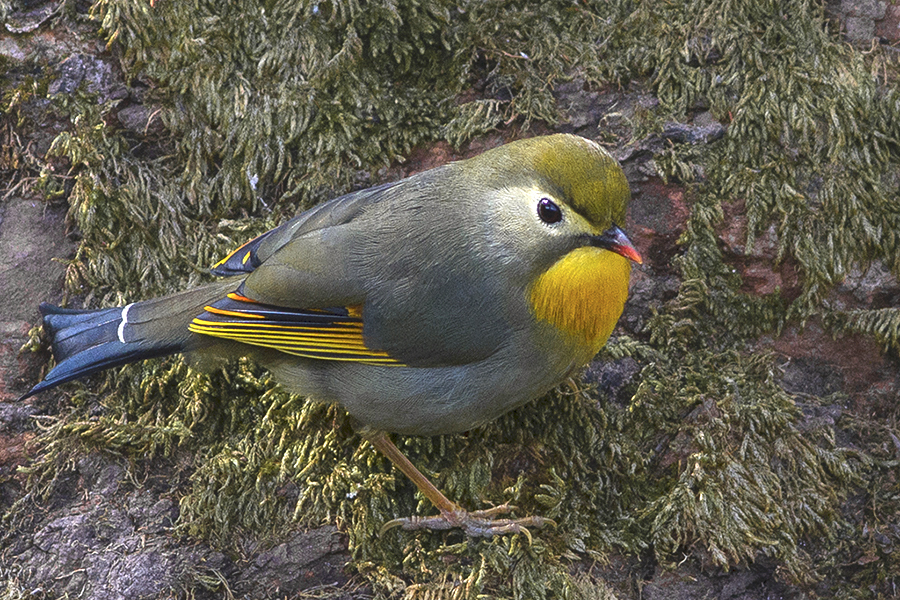
Wikipedia: Red-billed leiothrix Source: OTHER
Red-billed_Leiothrix_Mangoli_Nainital_Uttarakhand_03.02.2015.jpg
This bird appears across the great seas in the following continents:
Europe, North America.
General: ![]() The red-billed leiothrix (Leiothrix lutea) is a member of the family Leiothrichidae, native to southern China and the Himalayas. Adults have bright red bills and a dull yellow ring around their eyes. Their backs are dull olive green, and they have a bright yellow-orange throat with a yellow chin; females are somewhat duller than males, and juveniles have black bills. It has also been introduced in various parts of the world, with small populations of escapees having existed in Japan since the 1980s. It has become a common cagebird and amongst aviculturists it goes by various names: Pekin robin, Pekin nightingale, Japanese nightingale, and Japanese (hill) robin, the last two being misnomers as it is not native to Japan (although it has been introduced and naturalised there).[2]
[more]
The red-billed leiothrix (Leiothrix lutea) is a member of the family Leiothrichidae, native to southern China and the Himalayas. Adults have bright red bills and a dull yellow ring around their eyes. Their backs are dull olive green, and they have a bright yellow-orange throat with a yellow chin; females are somewhat duller than males, and juveniles have black bills. It has also been introduced in various parts of the world, with small populations of escapees having existed in Japan since the 1980s. It has become a common cagebird and amongst aviculturists it goes by various names: Pekin robin, Pekin nightingale, Japanese nightingale, and Japanese (hill) robin, the last two being misnomers as it is not native to Japan (although it has been introduced and naturalised there).[2]
[more]

Wikipedia: Chinese hwamei Source: OTHER
Garrulax_canorus_-_Watching_Back.jpg
![]() The Chinese hwamei or melodious laughingthrush (Garrulax canorus) is a passerine bird of eastern Asia in the family Leiothrichidae. The name "hwamei" comes from the Chinese 画眉 (huà-méi) means "painted eyebrow"[2] referring to the distinctive marking around the bird's eyes. The species is a popular cagebird because of its attractive song.
[more]
The Chinese hwamei or melodious laughingthrush (Garrulax canorus) is a passerine bird of eastern Asia in the family Leiothrichidae. The name "hwamei" comes from the Chinese 画眉 (huà-méi) means "painted eyebrow"[2] referring to the distinctive marking around the bird's eyes. The species is a popular cagebird because of its attractive song.
[more]
Profile Wikipedia eBird Audubon AllAboutBirds Xeno-Canto

Wikipedia: Greater necklaced laughingthrush Source: OTHER
1200px-Garrulax_pectoralis_-_Kaeng_Krachan.jpg
![]() The greater necklaced laughingthrush (Pterorhinus pectoralis) is a species of passerine bird in the family Leiothrichidae. It is found in Bangladesh, Bhutan, China, India, Laos, Myanmar, Nepal, Thailand and Vietnam. It is introduced to the United States. Its natural habitats are subtropical or tropical moist lowland forest and subtropical or tropical moist montane forest.
[more]
The greater necklaced laughingthrush (Pterorhinus pectoralis) is a species of passerine bird in the family Leiothrichidae. It is found in Bangladesh, Bhutan, China, India, Laos, Myanmar, Nepal, Thailand and Vietnam. It is introduced to the United States. Its natural habitats are subtropical or tropical moist lowland forest and subtropical or tropical moist montane forest.
[more]
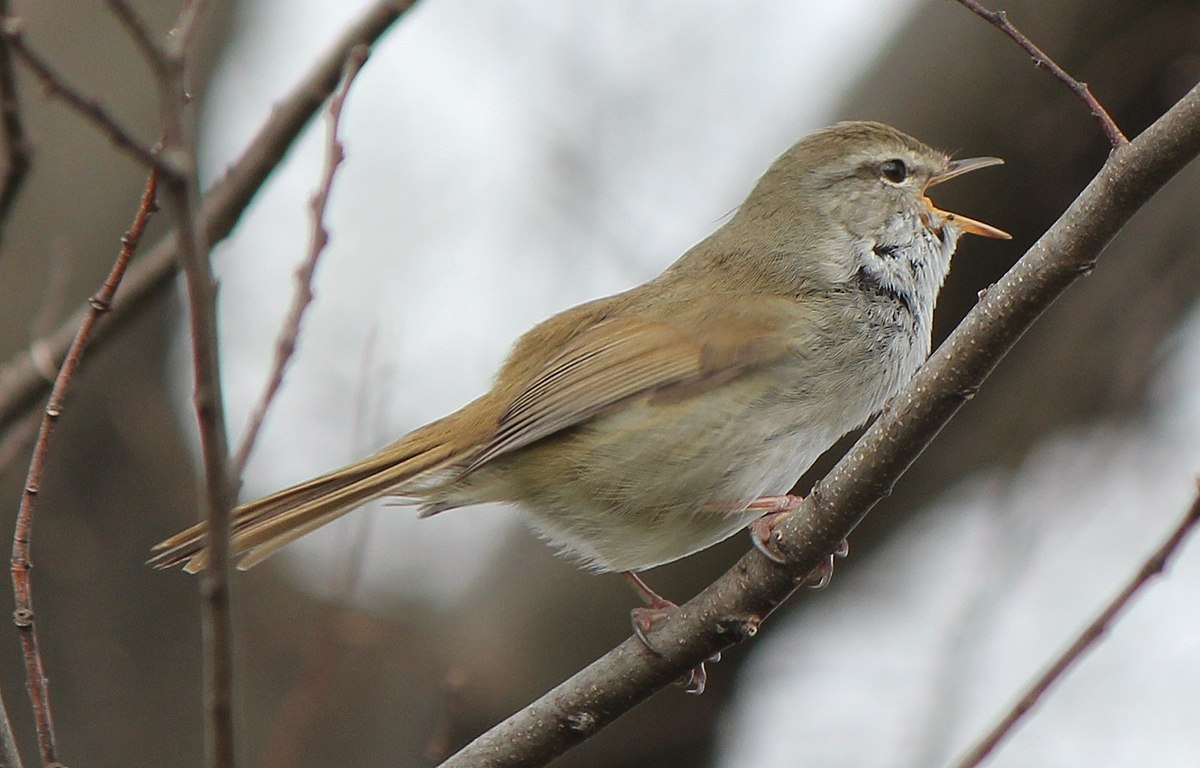
Wikipedia: Japanese bush warbler Source: OTHER
1200px-Cettia_diphone_%28crying%29.JPG
![]() The Japanese bush warbler (Horornis diphone), known in Japanese as uguisu (鶯), is an Asian passerine bird more often heard than seen. Its distinctive breeding song can be heard throughout much of Japan from the start of spring.
[more]
The Japanese bush warbler (Horornis diphone), known in Japanese as uguisu (鶯), is an Asian passerine bird more often heard than seen. Its distinctive breeding song can be heard throughout much of Japan from the start of spring.
[more]
Profile Wikipedia eBird Vogelwarte BirdLife ZH ornitho.ch bird-song.ch Audubon AllAboutBirds Xeno-Canto BirdID NABU
Pair of house sparrows in a tree near Zürichstrasse, Fehraltorf 2020-04-11 07.54.30 Luppmen
First observed in 🇨🇭 on 2019-05-14.
This bird appears across the great seas in the following continents:
Europe, North America (introduced), South America, Africa, Asia.
One of the most common birds anywhere in Europe and North America.
In Fehraltorf there are 5 house sparrows for every one tree sparrow.
Eugene Schieffelin brought house sparrows and starlings to North Ameria.
As a Shakespeare fan, it is often claimed that he wanted to introduce all species to North America that are mentioned in Shakespeare,
but apparently this is not supported by any records
Found practically everywhere. Often on the ground or on your table in a cafe (they're very bold)
or in groups in bushes and hedges
Song: ![]() Song a primitive, monosyllabic, or slightly disyllabic "chilp", hard to distinguish from Tree Sparrow. [Link]
Song a primitive, monosyllabic, or slightly disyllabic "chilp", hard to distinguish from Tree Sparrow. [Link]
Calls: ![]() Most calls very similar to Tree Sparrow, but lacks said species' distinct high pitched call (chew-itt), and alarm call is less dry and raucous. [Link]
Most calls very similar to Tree Sparrow, but lacks said species' distinct high pitched call (chew-itt), and alarm call is less dry and raucous. [Link]
Physical details: length=14-15 cm,
wingspan=21-25 cm,
weight=24-38 g
not sexually dimporphic.
No breeding plumage
Identifying characteristics:
Youth:
beak = yellow (Makes it look like a finch)
Habitats:
Settlement
Song:
An monotone chirping. Mainly 2-5 KHz with higher overtones.
Song attributes:
Melody: simple rhythmic, slow, Frequency: 2-5 KHz Singing season: 01-01 - 08-31 Dawn chorus start, 30 minutes before dawn.
Call:
Automatically generated from Xeno-Canto recording
♫ Source: BirdNet
20200507_071255 birdnet 457 - good one note recording - House sparrow.mp3
2020-05-07 07.12.55 Luppmen (song?)
Profile Wikipedia eBird Vogelwarte BirdLife ZH ornitho.ch bird-song.ch Audubon AllAboutBirds Xeno-Canto BirdID NABU

In tree by First, ZH. 2020-05-04 17.33.32 Luppmen
First observed in 🇨🇭 on 2020-04-10.
This bird appears across the great seas in the following continents:
Europe, North America (introduced), Africa, Asia.
Similar to the house sparrow, but with the black cheek patch seen here.
in Fehraltorf there are 5 times as many house sparrows as tree sparrows.
Geography: ![]() Brought from Germany, about 20 of these birds were released in St. Louis in 1870. The population took hold there, and they might have spread except that the House Sparrow, seemingly more aggressive and adaptable, reached the St. Louis area at about the same time. Eurasian Tree Sparrows are still found in parts of Missouri and Illinois, and have reached southeastern Iowa, but they are fairly local in farmland and suburbs. The tougher House Sparrow may keep them out of other areas. [Link]
Brought from Germany, about 20 of these birds were released in St. Louis in 1870. The population took hold there, and they might have spread except that the House Sparrow, seemingly more aggressive and adaptable, reached the St. Louis area at about the same time. Eurasian Tree Sparrows are still found in parts of Missouri and Illinois, and have reached southeastern Iowa, but they are fairly local in farmland and suburbs. The tougher House Sparrow may keep them out of other areas. [Link]
Vocalization: ![]() Most other sounds similar to House Sparrow, and may be difficult to identify. [Link]
Most other sounds similar to House Sparrow, and may be difficult to identify. [Link]
Song: ![]() Chattering sounds are generally harder, and song slightly higher pitched than House Sparrow. [Link]
Chattering sounds are generally harder, and song slightly higher pitched than House Sparrow. [Link]
Calls: ![]() Distinct, high-pitched and explosive contact-call; "che-witt" typically given in flight. Second syllable rising rapidly in pitch. [Link]
Distinct, high-pitched and explosive contact-call; "che-witt" typically given in flight. Second syllable rising rapidly in pitch. [Link]
Physical details: length=14 cm,
wingspan=20-22 cm,
weight=18-29 g
Habitats:
Settlement
Song:
Monotone chirping, rougher than that of the house sparrow. Most 2-7 KHz mit many overtones,
i.e. somewhat higher than the house sparrow.
Song attributes:
Melody: simple rhythmic, slow, Frequency: 2-7 KHz
Call:
Automatically generated from Xeno-Canto recording
♫ XC558751-Feldsperling. Source: XENOCANTO
XC558751-Feldsperling.mp3
(song?)

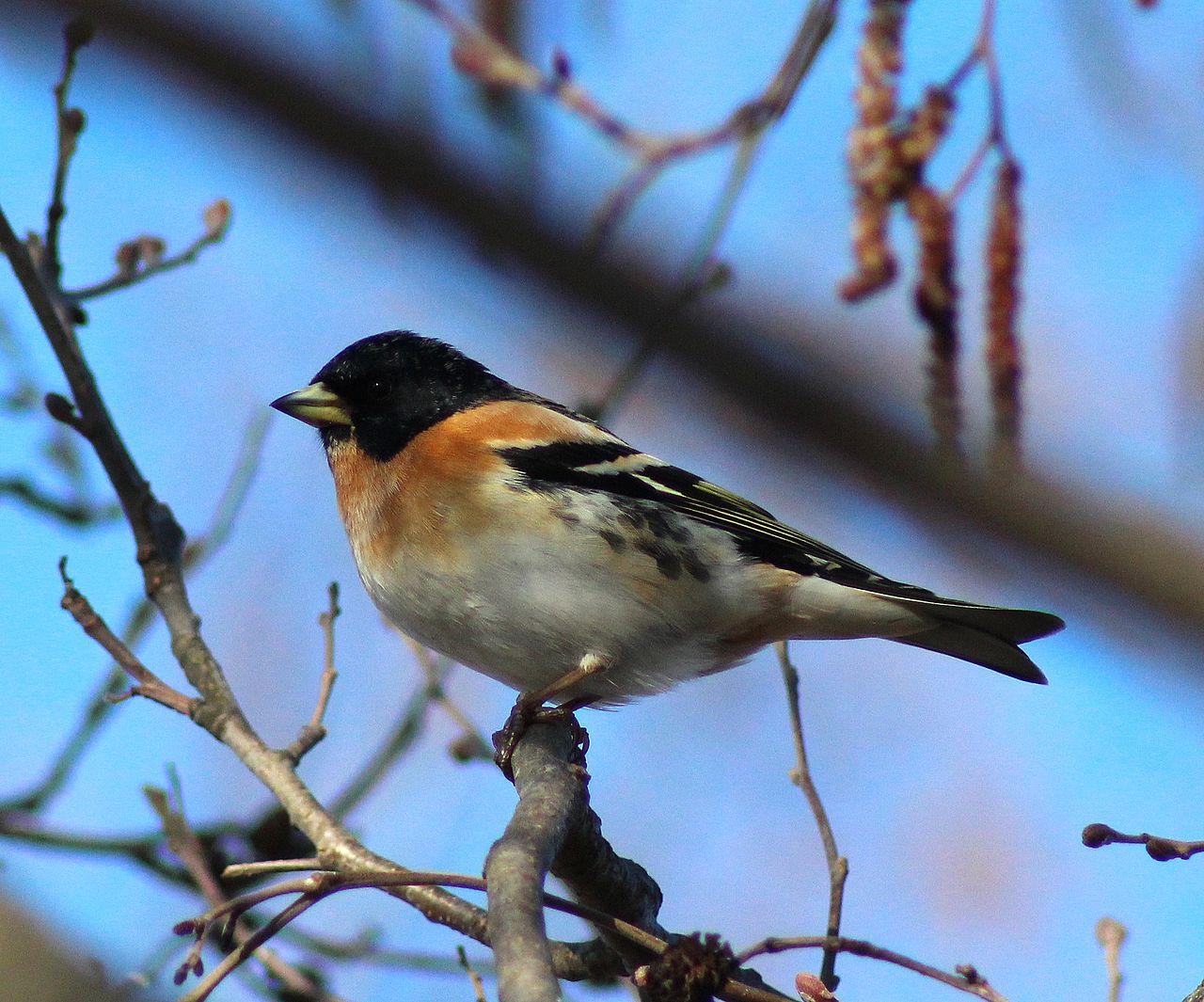
Wikipedia Bergfink. Foto: Source: WIKIPEDIA
Wikipedia Bergfink.jpg
This bird appears across the great seas in the following continents:
Europe, North America, Africa.
Geography: ![]() the Brambling appears regularly in small numbers in Alaska during migration, straying the short distance across the Bering Sea. Some of those that stray across in autumn apparently then continue south on the American side, and there have been winter records for numerous states and provinces east to the Atlantic Coast and south to Colorado. Many of these vagrant Bramblings have been found visiting bird feeders. [Link]
the Brambling appears regularly in small numbers in Alaska during migration, straying the short distance across the Bering Sea. Some of those that stray across in autumn apparently then continue south on the American side, and there have been winter records for numerous states and provinces east to the Atlantic Coast and south to Colorado. Many of these vagrant Bramblings have been found visiting bird feeders. [Link]
Vocalization: ![]() Large repertoire of mostly characteristic sounds. [Link]
Large repertoire of mostly characteristic sounds. [Link]
Song: ![]() Song very distinct; a soft, wheezing, drawn-out single note. Repeated at the same pitch in a monotonous manner. [Link]
Song very distinct; a soft, wheezing, drawn-out single note. Repeated at the same pitch in a monotonous manner. [Link]
Calls: ![]() Contact calls include a short, nasal, ascending "keeaa", a short high-pitched, piercing "tzeet" and a linnet-like "chepp". May be mistaken for Greenfinch, but note softer timbre and stable pitch throughout the call. [Link]
Contact calls include a short, nasal, ascending "keeaa", a short high-pitched, piercing "tzeet" and a linnet-like "chepp". May be mistaken for Greenfinch, but note softer timbre and stable pitch throughout the call. [Link]
Physical details: length=14 cm,
wingspan=25-26 cm,
weight=17-30 g
Habitats:
Forest
Song:
General: Bergfink - call cheep plus two ascending Grünfink squawks. Song? Grünfink squawk but not descending, every 3-4 seconds.
Song: ![]() Song very distinct; a soft, wheezing, drawn-out single note. Repeated at the same pitch in a monotonous manner. [Link]
Song very distinct; a soft, wheezing, drawn-out single note. Repeated at the same pitch in a monotonous manner. [Link]
Song attributes:
Melody: simple rhythmic, slow, Frequency: medium (1-5 KHz) Special sounds: rasp Singing season: 04-14 - 09-15
♫ Source: XENOCANTO
XC731031 - Brambling - Fringilla montifringilla.mp3
(song)
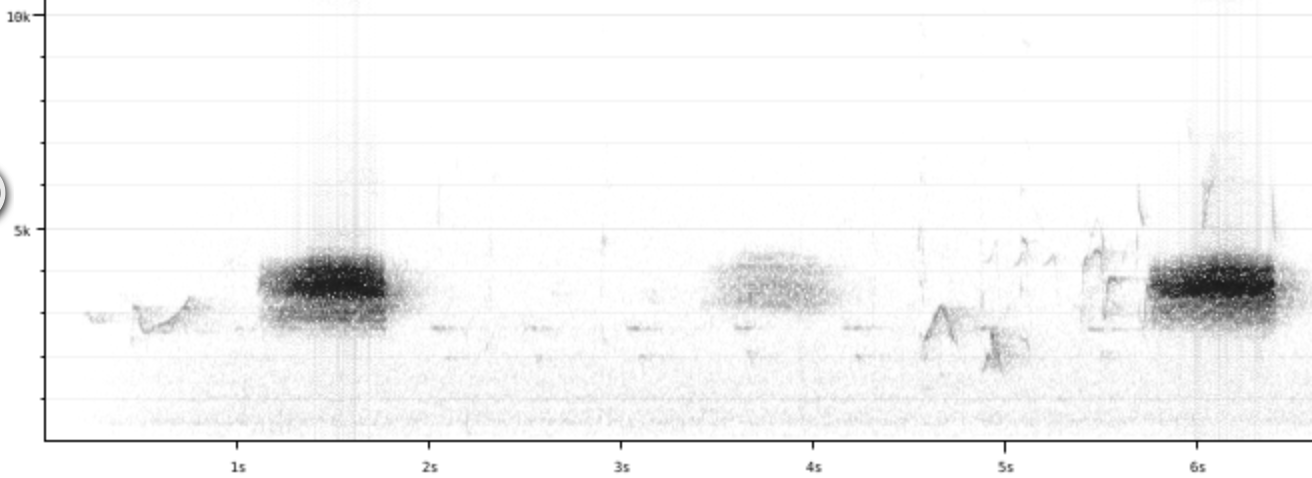
Call:
Automatically generated from Xeno-Canto recording
♫ XC731031 - Brambling - Fringilla montifringilla. Source: XENOCANTO
XC731031 - Brambling - Fringilla montifringilla.mp3
(song?)

Erste Sicht eines Kanarengirlitz in Madeira bei Ponta de Sao Lourenco. 2023-03-10 15.18.06 Madeira
First observed in Canary Islands on 2022-03-08.
This bird appears across the great seas in the following continents:
Europe, North America, Africa.
It's unusual that the name of a bird refers to dogs. Wikipedia writes: The name Islas Canarias is likely derived from the Latin name Canariae Insulae, meaning "Islands of the Dogs", a name that was evidently generalized from the ancient name of one of these islands, Canaria – presumably Gran Canaria. According to the historian Pliny the Elder, the island Canaria contained "vast multitudes of dogs of very large size".
The common canary kept as a pet is subspecies Serinus canaria forma domestica.
Song:
Automatically generated from Xeno-Canto recording
Song attributes:
Frequency:
♫ Quinta San Antonio da Serra, Madeira - Kanarengirlitz Gesang. ![]() Source: Zoom H6 2023-03-11 11.58.22 Madeira (song)
Source: Zoom H6 2023-03-11 11.58.22 Madeira (song)

Wikipedia: Common redpoll Source: OTHER
1200px-Carduelis_flammea_CT6.jpg
This bird appears across the great seas in the following continents:
Europe, North America.
roter Punkt auf Kopf, sonst weiss+braun, teilweise hell-rot auf brust.
Behavior: ![]() Trotz Ihrer roten Abzeichen sind die bräunlich-weiss gestreiften Vögel wenig auffällig, und wenn sie nicht gerade rufen, bleiben sie meist unentdeckt. Oft fliegen sie unvermittelt auf, drehen im Schwarm eine Runde und fallen wieder ein. [Link]
Trotz Ihrer roten Abzeichen sind die bräunlich-weiss gestreiften Vögel wenig auffällig, und wenn sie nicht gerade rufen, bleiben sie meist unentdeckt. Oft fliegen sie unvermittelt auf, drehen im Schwarm eine Runde und fallen wieder ein. [Link]
Song: ![]() Song an improvised chattering on various contact calls with no apparent phrasing. [Link]
Song an improvised chattering on various contact calls with no apparent phrasing. [Link]
Calls: ![]() Contact call diagnostic. A chattering "Chutt-utt-utt", with a more metallic and nasal timbre than Linnet and Twite. Other sound includes plaintive call mostly given when perched. Uttered as a continuous sound, but with a disyllabic feel. First part ascending slowly, then faster before it is cut off "tsooeet". [Link]
Contact call diagnostic. A chattering "Chutt-utt-utt", with a more metallic and nasal timbre than Linnet and Twite. Other sound includes plaintive call mostly given when perched. Uttered as a continuous sound, but with a disyllabic feel. First part ascending slowly, then faster before it is cut off "tsooeet". [Link]
Physical details: length=11-14 cm,
wingspan=20-25 cm,
weight=9-16 g
Habitats:
Mountain
Song:
A few chirps and a trill, then repeat.
Song attributes:
Melody: simple rhythmic, fast, Frequency: 2-6 KHz Special sounds: trill

Wikipedia: Hoary redpoll Source: OTHER
1200px-Arctic_Redpoll_%28Acanthis_hornemanni%29_%2813667519855%29.jpg
This bird appears across the great seas in the following continents:
Europe, North America.
General: ![]() The Arctic redpoll or hoary redpoll (Acanthis hornemanni) is a bird species in the finch family Fringillidae. It breeds in tundra birch forest. It has two subspecies, A. h. hornemanni (Greenland or Hornemann's Arctic redpoll) of Greenland and neighbouring parts of Canada, and A. h. exilipes (Coues' Arctic redpoll), which breeds in the tundra of northern North America and the Palearctic. Many birds remain in the far north; some birds migrate short distances south in winter, sometimes travelling with common redpolls.
[more]
The Arctic redpoll or hoary redpoll (Acanthis hornemanni) is a bird species in the finch family Fringillidae. It breeds in tundra birch forest. It has two subspecies, A. h. hornemanni (Greenland or Hornemann's Arctic redpoll) of Greenland and neighbouring parts of Canada, and A. h. exilipes (Coues' Arctic redpoll), which breeds in the tundra of northern North America and the Palearctic. Many birds remain in the far north; some birds migrate short distances south in winter, sometimes travelling with common redpolls.
[more]
Vocalization: ![]() Very similar to Common Redpoll, but possibly with a softer tone and slightly longer pauses between each syllable. See Common Redpoll. [Link]
Very similar to Common Redpoll, but possibly with a softer tone and slightly longer pauses between each syllable. See Common Redpoll. [Link]
Physical details: length=13-15 cm,
wingspan=21-27 cm,
weight=10-16 g

Wikimedia Red Crossbills (Male). Source: WIKIPEDIA
Wikimedia Red_Crossbills_(Male).jpg
First observed in 🇨🇭 on 2020-06-13.
This bird appears across the great seas in the following continents:
Europe, North America, Africa.
Forests with conifers. Some spend the winter in Switzerland, others are here year-round.
Appearance and identification: ![]() Nabu.de: das Männchen schon von weitem durch seine ziegelrote Farbe auf. Das Weibchen dagegen ist unscheinbar graugrün gefärbt.Größe: 15 bis 17 Zentimeter
Zugtyp: Teilzieher
Beobachtungszeitraum: Oktober bis April, im Mittelgebirge und Alpenraum ganzjährig. [Link]
Nabu.de: das Männchen schon von weitem durch seine ziegelrote Farbe auf. Das Weibchen dagegen ist unscheinbar graugrün gefärbt.Größe: 15 bis 17 Zentimeter
Zugtyp: Teilzieher
Beobachtungszeitraum: Oktober bis April, im Mittelgebirge und Alpenraum ganzjährig. [Link]
![]() New research suggests that there may be as many as eight different full species of Red Crossbills on [North America]. [Link]
New research suggests that there may be as many as eight different full species of Red Crossbills on [North America]. [Link]
Behavior: ![]() Wikipedia: a small passerine bird in the finch family Fringillidae, also known as the Common Crossbill in Eurasia. Crossbills have distinctive mandibles, crossed at the tips, which enable them to extract seeds from conifer cones and other fruits. [Link]
Wikipedia: a small passerine bird in the finch family Fringillidae, also known as the Common Crossbill in Eurasia. Crossbills have distinctive mandibles, crossed at the tips, which enable them to extract seeds from conifer cones and other fruits. [Link]
Song: ![]() The song consist of improvised, resonant twittering, and series of contact calls with no apparent phrases. It is generally faster, with less marked pauses than in Parrot Crossbill, and the phrasing seems more random. [Link]
The song consist of improvised, resonant twittering, and series of contact calls with no apparent phrases. It is generally faster, with less marked pauses than in Parrot Crossbill, and the phrasing seems more random. [Link]
Calls: ![]() Contact call similar to Parroy Crossbill's "tupp", but is on average higher and less powerful, with a "cut-off" ending. In sum: Parrot Crossbill; hard attack, soft ending, Crossbill: softer attack, cut-off ending. Beware regional variations and overlap in pitch of calls with Parrot. [Link]
Contact call similar to Parroy Crossbill's "tupp", but is on average higher and less powerful, with a "cut-off" ending. In sum: Parrot Crossbill; hard attack, soft ending, Crossbill: softer attack, cut-off ending. Beware regional variations and overlap in pitch of calls with Parrot. [Link]
Physical details: length=16 cm,
wingspan=27-30 cm,
weight=35-50 g
Habitats:
Forest
Song:
Repeated hi-low pattern...well, doesn't always sound like that.
The very short beginning of my Stazersee recording before the static sets in does,
as well as a song found online.
One recording reminds me of cicada sounds.
Song attributes:
Melody: stereotype melodic, slow, Frequency: 2-10 KHz
Call:
Automatically generated from Xeno-Canto recording
♫ Source: BirdNet
20200613_122851 birdnet 641 near stazersee - Red crossbill.mp3
2020-06-13 12.28.51 Sils (song?)
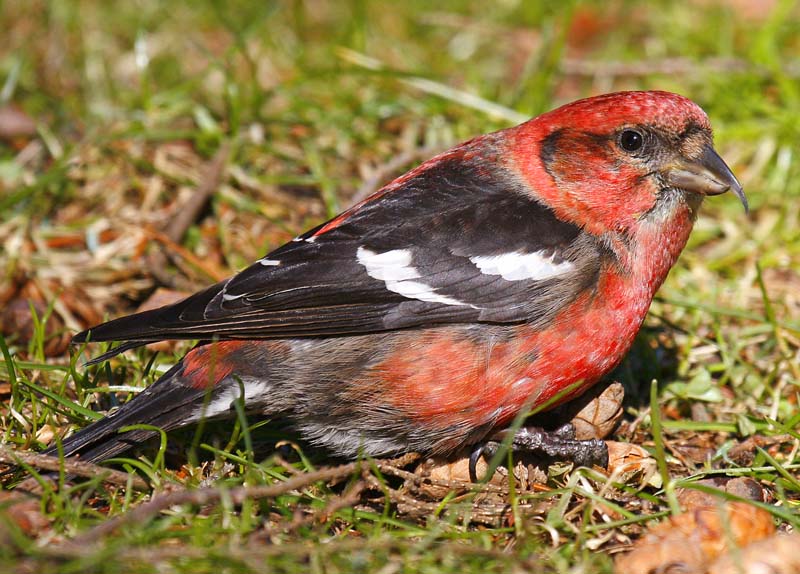
Wikipedia: White-winged crossbill Source: OTHER
Whitewingedcrossbillmale09.jpg
This bird appears across the great seas in the following continents:
Europe, North America.
General: ![]() The two-barred crossbill or white-winged crossbill (Loxia leucoptera) is a small passerine bird in the finch family Fringillidae.
[more]
The two-barred crossbill or white-winged crossbill (Loxia leucoptera) is a small passerine bird in the finch family Fringillidae.
[more]
Profile Wikipedia eBird Audubon AllAboutBirds Xeno-Canto

Wikipedia: Cassia crossbill Source: OTHER
1200px-965.5_-_CASSIA_CROSSBILL_%286-30-2018%29_trail_n-w_from_upper_penstamon_c_g%2C_cassia_co%2C_id_-17_male_%26_juv_%2843245983821%29.jpg
![]() The Cassia crossbill (Loxia sinesciuris) is a passerine bird in the family Fringillidae. It is endemic to the South Hills and Albion Mountains in southern Idaho.[1] Cassia crossbill rarely interbreeds with other call types that move into the South Hills of Idaho yearly, and can be considered to represent a distinct species via ecological speciation.[1] The Cassia crossbill have specialized beaks to access the seeds of the lodgepole pine cones in this region, but are poorly adapted to other pine cones in surrounding regions.[2]
[more]
The Cassia crossbill (Loxia sinesciuris) is a passerine bird in the family Fringillidae. It is endemic to the South Hills and Albion Mountains in southern Idaho.[1] Cassia crossbill rarely interbreeds with other call types that move into the South Hills of Idaho yearly, and can be considered to represent a distinct species via ecological speciation.[1] The Cassia crossbill have specialized beaks to access the seeds of the lodgepole pine cones in this region, but are poorly adapted to other pine cones in surrounding regions.[2]
[more]
Profile Wikipedia eBird Audubon AllAboutBirds Xeno-Canto BirdID NABU

Wikipedia: Pine grosbeak Source: OTHER
1200px-Pine_Grosbeak_%28Pinicola_enucleator%29_%2813667564073%29.jpg
This bird appears across the great seas in the following continents:
Europe, North America.
![]() The pine grosbeak (Pinicola enucleator) (this scientific name roughly translates to "the bird that lives in the pines and shells the seeds") is a large member of the true finch family, Fringillidae. It is the only species in the genus Pinicola. It is found in coniferous woods across Alaska, the western mountains of the United States, Canada, and in subarctic Fennoscandia and across the Palearctic to Siberia. The species is a frugivore, especially in winter, favoring small fruits, such as rowans (mountain-ashes in the New World). With fruit-crop abundance varying from year to year, pine grosbeak is one of many subarctic-resident bird species that exhibit irruptive behavior. In irruption years, individuals can move long distances in search of suitable food supplies, bringing them farther south and/or downslope than is typical of years with large fruit crops.
[more]
The pine grosbeak (Pinicola enucleator) (this scientific name roughly translates to "the bird that lives in the pines and shells the seeds") is a large member of the true finch family, Fringillidae. It is the only species in the genus Pinicola. It is found in coniferous woods across Alaska, the western mountains of the United States, Canada, and in subarctic Fennoscandia and across the Palearctic to Siberia. The species is a frugivore, especially in winter, favoring small fruits, such as rowans (mountain-ashes in the New World). With fruit-crop abundance varying from year to year, pine grosbeak is one of many subarctic-resident bird species that exhibit irruptive behavior. In irruption years, individuals can move long distances in search of suitable food supplies, bringing them farther south and/or downslope than is typical of years with large fruit crops.
[more]
Song: ![]() Song a soft, flowing, melodic yodeling in clear, flute-like tones. [Link]
Song a soft, flowing, melodic yodeling in clear, flute-like tones. [Link]
Calls: ![]() Contact call a melodic, plaintive "cliu-wee", with both syllables falling in pitch. Analogoues to Siskin, but much more full-bodied and lower pitched (like a mix of Siskin and Bullfinch). [Link]
Contact call a melodic, plaintive "cliu-wee", with both syllables falling in pitch. Analogoues to Siskin, but much more full-bodied and lower pitched (like a mix of Siskin and Bullfinch). [Link]
Physical details: length=18 cm,
wingspan=30-35 cm,
weight=47-64 g

Wikipedia: Grey-crowned rosy-finch Source: OTHER
Gray-Crowned_Rosy-Finch.jpg
This bird appears across the great seas in the following continents:
Europe, North America.
General: ![]() The gray-crowned rosy finch, or gray-crowned rosy-finch, (Leucosticte tephrocotis) is a species of passerine bird in the family Fringillidae native to Alaska, western Canada, and the north-western United States. Due to its remote and rocky alpine habitat it is rarely seen. There are currently six recognized subspecies. It is one of four species of rosy finches.
[more]
The gray-crowned rosy finch, or gray-crowned rosy-finch, (Leucosticte tephrocotis) is a species of passerine bird in the family Fringillidae native to Alaska, western Canada, and the north-western United States. Due to its remote and rocky alpine habitat it is rarely seen. There are currently six recognized subspecies. It is one of four species of rosy finches.
[more]
Profile Wikipedia eBird Audubon AllAboutBirds Xeno-Canto
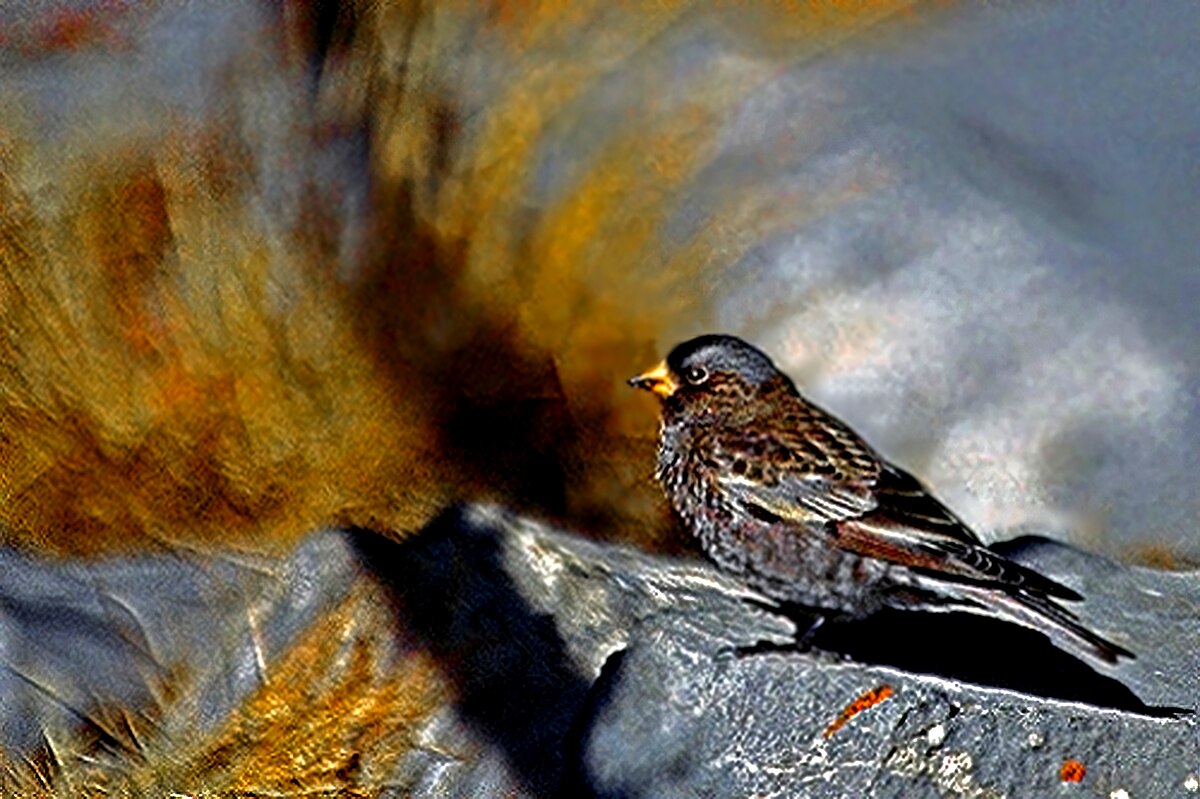
Wikipedia: Black rosy-finch Source: OTHER
1200px-Black_Rosy-Finch.jpg
![]() The black rosy finch, or black rosy-finch, (Leucosticte atrata) is a species of passerine bird in the family Fringillidae native to alpine areas above treeline, of the western United States. It is the most range-restricted member of its genus, and a popular photography subject for birdwatchers.
[more]
The black rosy finch, or black rosy-finch, (Leucosticte atrata) is a species of passerine bird in the family Fringillidae native to alpine areas above treeline, of the western United States. It is the most range-restricted member of its genus, and a popular photography subject for birdwatchers.
[more]
Profile Wikipedia eBird Audubon AllAboutBirds Xeno-Canto
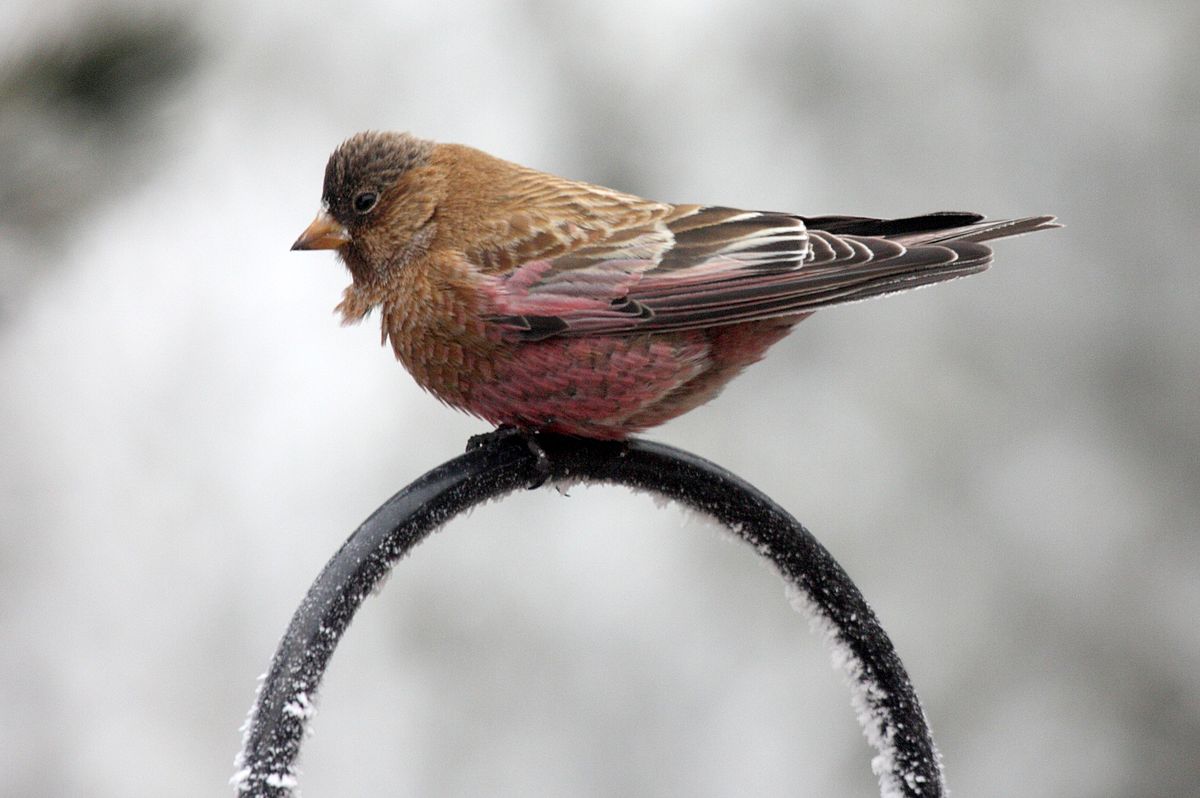
Wikipedia: Brown-capped rosy-finch Source: OTHER
1200px-Brown-capped_rosy_finch.jpg
![]() The brown-capped rosy finch (Leucosticte australis) is a medium-sized finch endemic to North America.
[more]
The brown-capped rosy finch (Leucosticte australis) is a medium-sized finch endemic to North America.
[more]

Wikipedia: Evening grosbeak Source: OTHER
1200px-Hesperiphona_vespertina_CT3.jpg
![]() The evening grosbeak (Hesperiphona vespertina) is a passerine bird in the finch family Fringillidae found in North America.
[more]
The evening grosbeak (Hesperiphona vespertina) is a passerine bird in the finch family Fringillidae found in North America.
[more]
House Finch on Cherrywood Court. 2022-04-28 11.03.30 Maryland
First observed in Cockeysville on 2021-06-11.
![]() The house finch (Haemorhous mexicanus) is a bird in the finch family Fringillidae. It is native to western North America and has been introduced to the eastern half of the continent and Hawaii. This species and the other "American rosefinches" are placed in the genus Haemorhous.
[more]
The house finch (Haemorhous mexicanus) is a bird in the finch family Fringillidae. It is native to western North America and has been introduced to the eastern half of the continent and Hawaii. This species and the other "American rosefinches" are placed in the genus Haemorhous.
[more]
Call:
Automatically generated from Xeno-Canto recording
♫ Source: BirdNet
20210612_155654 birdnet 1622 - House Finch plus northern cardinal - House Finch - Cockeysville.mp3
2021-06-12 15.56.54 Cockeysville (song?)

Wikipedia: Purple finch Source: OTHER
1200px-Carpodacus_purpureus_CT3.jpg
![]() The purple finch (Haemorhous purpureus) is a bird in the finch family, Fringillidae.
[more]
The purple finch (Haemorhous purpureus) is a bird in the finch family, Fringillidae.
[more]

Wikipedia: Cassin's finch Source: OTHER
Cassin%27s_Finch_%28male%29.jpg
![]() Cassin's finch (Haemorhous cassinii) is a bird in the finch family, Fringillidae. This species and the other "American rosefinches" are placed in the genus Haemorhous.
[more]
Cassin's finch (Haemorhous cassinii) is a bird in the finch family, Fringillidae. This species and the other "American rosefinches" are placed in the genus Haemorhous.
[more]
I observed something new practically every day at Cherrywood Court, hear an American goldfinch. 2021-06-17 05.49.04 Maryland
First observed in Maryland on 2021-06-17.
![]() The American goldfinch (Spinus tristis) is a small North American bird in the finch family. It is migratory, ranging from mid-Alberta to North Carolina during the breeding season, and from just south of the Canada–United States border to Mexico during the winter.
[more]
The American goldfinch (Spinus tristis) is a small North American bird in the finch family. It is migratory, ranging from mid-Alberta to North Carolina during the breeding season, and from just south of the Canada–United States border to Mexico during the winter.
[more]

Wikipedia: Pine siskin Source: OTHER
1200px-Carduelis_pinus_CT7.jpg
![]() The pine siskin (Spinus pinus) is a North American bird in the finch family. It is a migratory bird with an extremely sporadic winter range.
[more]
The pine siskin (Spinus pinus) is a North American bird in the finch family. It is a migratory bird with an extremely sporadic winter range.
[more]

Wikipedia: Lesser goldfinch Source: OTHER
1200px-%E2%99%82_lesser_goldfinch.jpg
![]() The lesser goldfinch (Spinus psaltria) is a very small songbird of the Americas. Together with its relatives the American goldfinch and Lawrence's goldfinch, it forms the American goldfinches clade in the genus Spinus sensu stricto.
[more]
The lesser goldfinch (Spinus psaltria) is a very small songbird of the Americas. Together with its relatives the American goldfinch and Lawrence's goldfinch, it forms the American goldfinches clade in the genus Spinus sensu stricto.
[more]

Wikipedia: Lawrence's goldfinch Source: OTHER
Lawrence_Goldfinch.jpg
![]() Lawrence's goldfinch (Spinus lawrencei) is a small songbird of erratic distribution that breeds in California and Baja California and winters in the southwestern United States and northern Mexico.
[more]
Lawrence's goldfinch (Spinus lawrencei) is a small songbird of erratic distribution that breeds in California and Baja California and winters in the southwestern United States and northern Mexico.
[more]
Profile Wikipedia eBird A-Z Animals Audubon AllAboutBirds Xeno-Canto
Northern Cardinal, female. 2022-05-01 09.02.04 Maryland
First observed in Cockeysville on 2021-06-10.
![]() The northern cardinal (Cardinalis cardinalis) is a bird in the genus Cardinalis; it is also known colloquially as the redbird, common cardinal, red cardinal, or just cardinal (which was its name prior to 1985). It can be found in southeastern Canada, through the eastern United States from Maine to Minnesota to Texas, and south through Mexico, Belize, and Guatemala. It is also an introduced species in a few locations such as Bermuda and Hawaii. Its habitat includes woodlands, gardens, shrublands, and wetlands.
[more]
The northern cardinal (Cardinalis cardinalis) is a bird in the genus Cardinalis; it is also known colloquially as the redbird, common cardinal, red cardinal, or just cardinal (which was its name prior to 1985). It can be found in southeastern Canada, through the eastern United States from Maine to Minnesota to Texas, and south through Mexico, Belize, and Guatemala. It is also an introduced species in a few locations such as Bermuda and Hawaii. Its habitat includes woodlands, gardens, shrublands, and wetlands.
[more]
Song:
Automatically generated from Xeno-Canto recording
Song attributes:
Frequency:
♫ Morning at Cherrywood Court - northern cardinal, gray catbirds, song sparrow. 2021-06-19 07.38.01 Cherrywood (song)
Call:
Automatically generated from Xeno-Canto recording
♫ Source: BirdNet
20220503_104300 birdnet - Northern Cardinal - 2022-05-03 10:43:00 - Northern Cardinal - Cockeysville.mp3
2022-05-03 10.43.00 Cockeysville (song?)
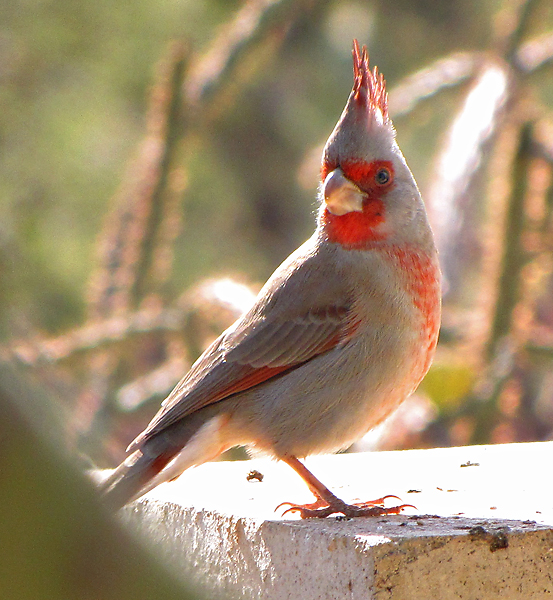
Wikipedia: Pyrrhuloxia Source: OTHER
Cardinalis_sinuatus_3.jpg
![]() The pyrrhuloxia /ˌpɪrəˈlɒksiə/[2] or desert cardinal (Cardinalis sinuatus) is a medium-sized North American song bird found in the American southwest and northern Mexico. This distinctive species with a short, stout bill and red crest and wings, and closely resembles the Northern cardinal and the Vermilion cardinal which are in the same genus.
[more]
The pyrrhuloxia /ˌpɪrəˈlɒksiə/[2] or desert cardinal (Cardinalis sinuatus) is a medium-sized North American song bird found in the American southwest and northern Mexico. This distinctive species with a short, stout bill and red crest and wings, and closely resembles the Northern cardinal and the Vermilion cardinal which are in the same genus.
[more]
Profile Wikipedia eBird Audubon AllAboutBirds Xeno-Canto
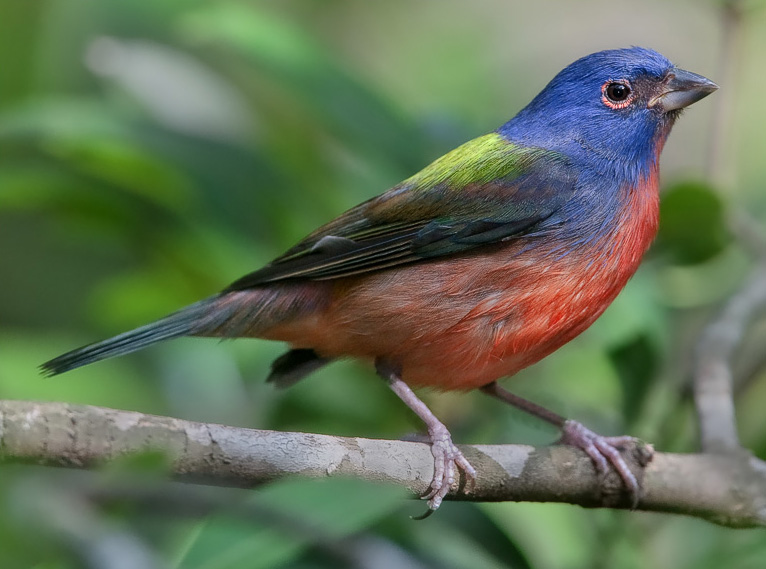
Wikipedia: Painted bunting Source: OTHER
Passerina_ciris-20090208.jpg
![]() The painted bunting (Passerina ciris) is a species of bird in the cardinal family, Cardinalidae, that is native to North America. The bright plumage of the male only comes in the second year of life; in the first year they can only be distinguished from the female by close inspection.
[more]
The painted bunting (Passerina ciris) is a species of bird in the cardinal family, Cardinalidae, that is native to North America. The bright plumage of the male only comes in the second year of life; in the first year they can only be distinguished from the female by close inspection.
[more]
Profile Wikipedia eBird Audubon AllAboutBirds Xeno-Canto
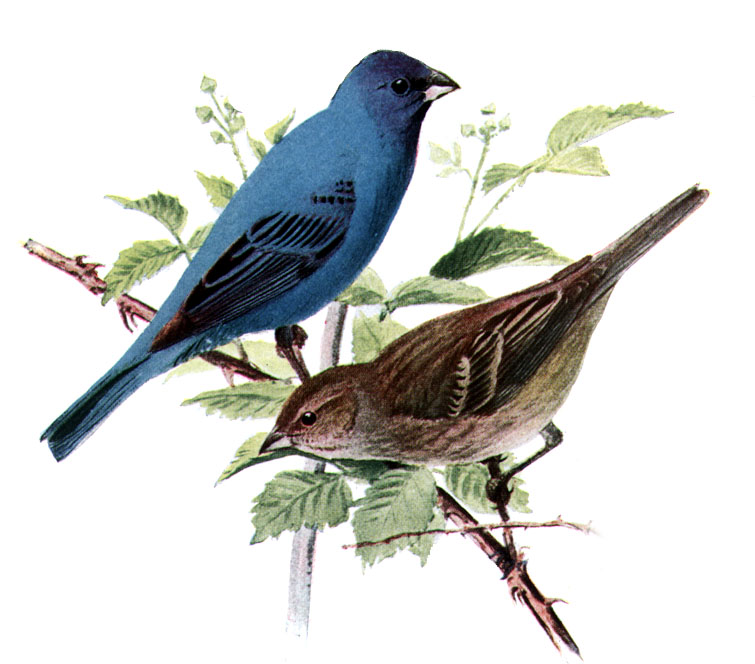
Wikipedia: Indigo bunting Source: OTHER
Passerina_cyaneaAAP086CA.jpg
![]() The indigo bunting (Passerina cyanea) is a small seed-eating bird in the cardinal family, Cardinalidae. It is migratory, ranging from southern Canada to northern Florida during the breeding season, and from southern Florida to northern South America during the winter.[2] It often migrates by night, using the stars to navigate.[3] Its habitat is farmland, brush areas, and open woodland.[4] The indigo bunting is closely related to the lazuli bunting and interbreeds with the species where their ranges overlap.
[more]
The indigo bunting (Passerina cyanea) is a small seed-eating bird in the cardinal family, Cardinalidae. It is migratory, ranging from southern Canada to northern Florida during the breeding season, and from southern Florida to northern South America during the winter.[2] It often migrates by night, using the stars to navigate.[3] Its habitat is farmland, brush areas, and open woodland.[4] The indigo bunting is closely related to the lazuli bunting and interbreeds with the species where their ranges overlap.
[more]

Wikipedia: Blue grosbeak Source: OTHER
1200px-Blue_Grosbeak_by_Dan_Pancamo.jpg
![]() The blue grosbeak (Passerina caerulea), is a medium-sized North American passerine bird in the cardinal family Cardinalidae. It is mainly migratory, wintering in Central America and breeding in northern Mexico and the southern United States. The male is blue with two brown wing bars. The female is mainly brown with scattered blue feathers on the upperparts and two brown wing bars.
[more]
The blue grosbeak (Passerina caerulea), is a medium-sized North American passerine bird in the cardinal family Cardinalidae. It is mainly migratory, wintering in Central America and breeding in northern Mexico and the southern United States. The male is blue with two brown wing bars. The female is mainly brown with scattered blue feathers on the upperparts and two brown wing bars.
[more]
Profile Wikipedia eBird Audubon AllAboutBirds Xeno-Canto

Wikipedia: Varied bunting Source: OTHER
Passerina_versicolorAOP02CA.jpg
![]() The varied bunting (Passerina versicolor) is a species of songbird in the cardinal family, Cardinalidae.
[more]
The varied bunting (Passerina versicolor) is a species of songbird in the cardinal family, Cardinalidae.
[more]
Profile Wikipedia eBird Audubon AllAboutBirds Xeno-Canto

Wikipedia: Lazuli bunting Source: OTHER
Lazuli_Bunting.jpg
![]() The lazuli bunting (Passerina amoena) is a North American songbird named for the gemstone lapis lazuli.
[more]
The lazuli bunting (Passerina amoena) is a North American songbird named for the gemstone lapis lazuli.
[more]
Profile Wikipedia eBird Audubon AllAboutBirds Xeno-Canto
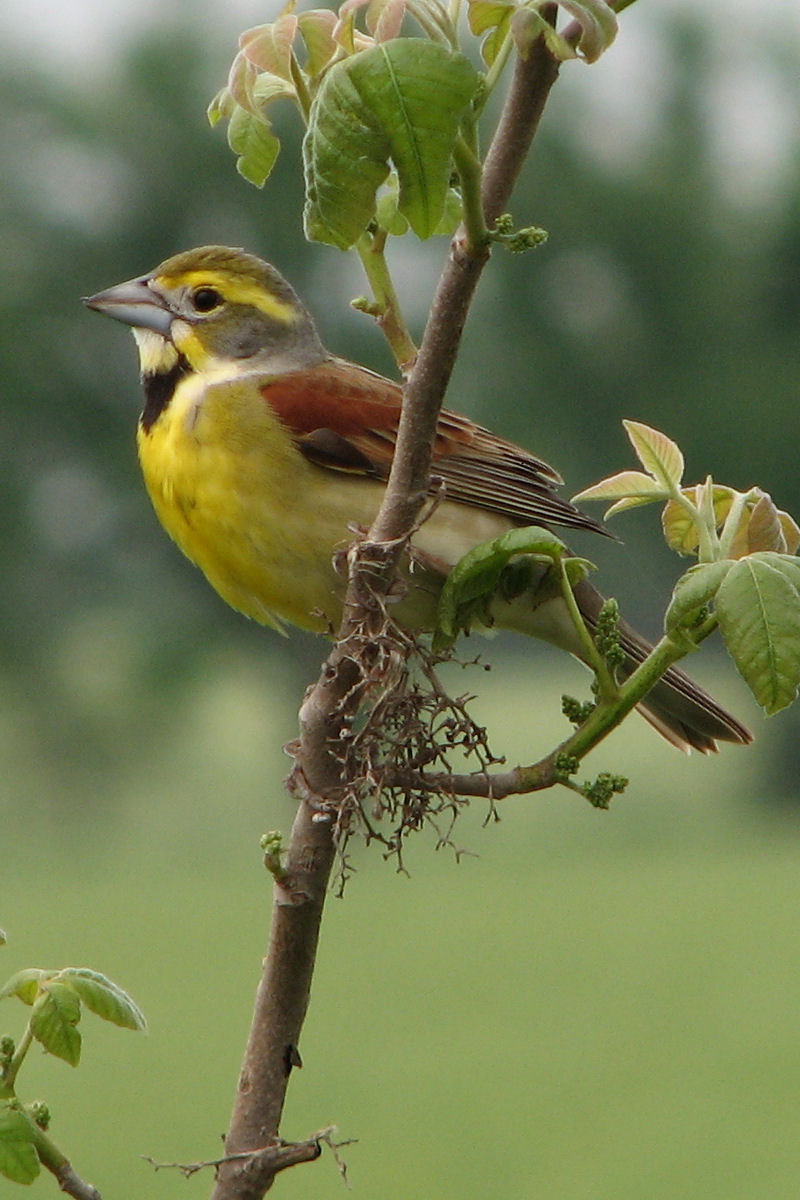
Wikipedia: Dickcissel Source: OTHER
DickcisselA.jpg
![]() Emberiza townsendi
Emberiza townsendi
Emberiza townsendii (lapsus)
Spiza townsendi
Spiza townsendii (lapsus)
(see text)
[more]
Profile Wikipedia eBird A-Z Animals Audubon AllAboutBirds Xeno-Canto
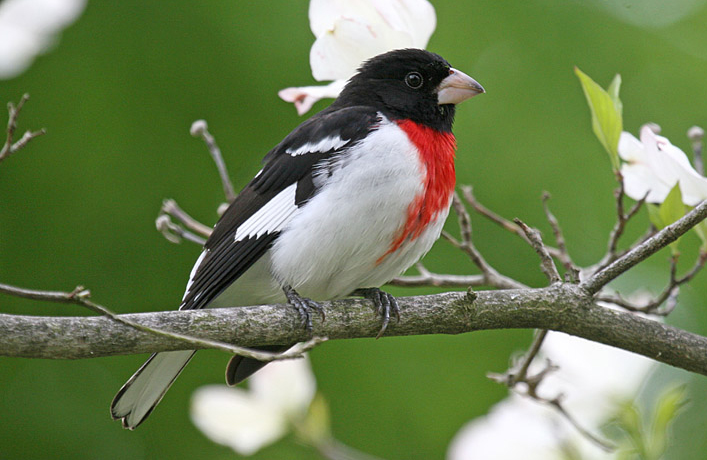
Wikipedia: Rose-breasted grosbeak Source: OTHER
RosebreastedGrosbeak08.jpg
![]() The rose-breasted grosbeak (Pheucticus ludovicianus) is a large, seed-eating grosbeak in the cardinal family (Cardinalidae). It is primarily a foliage gleaner.[2] Males have black heads, wings, backs, and tails, and a bright rose colored patch on their white breast. Males and females exhibit marked sexual dimorphism.
[more]
The rose-breasted grosbeak (Pheucticus ludovicianus) is a large, seed-eating grosbeak in the cardinal family (Cardinalidae). It is primarily a foliage gleaner.[2] Males have black heads, wings, backs, and tails, and a bright rose colored patch on their white breast. Males and females exhibit marked sexual dimorphism.
[more]
Profile Wikipedia eBird Audubon AllAboutBirds Xeno-Canto
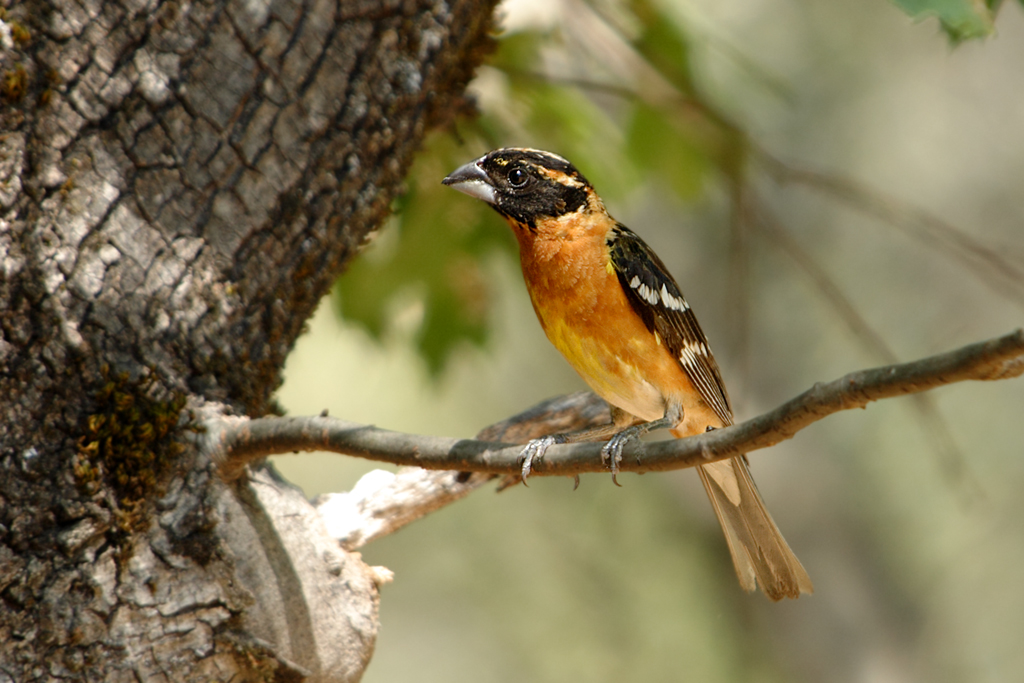
Wikipedia: Black-headed grosbeak Source: OTHER
Pheucticus_melanocephalus_-California%2C_USA-8.jpg
![]() The black-headed grosbeak (Pheucticus melanocephalus) is a medium-sized, seed-eating bird in the same family as the northern cardinal, the Cardinalidae. It is sometimes considered conspecific with the rose-breasted grosbeak (P. ludovicianus) with which it hybridizes on the American Great Plains.
[more]
The black-headed grosbeak (Pheucticus melanocephalus) is a medium-sized, seed-eating bird in the same family as the northern cardinal, the Cardinalidae. It is sometimes considered conspecific with the rose-breasted grosbeak (P. ludovicianus) with which it hybridizes on the American Great Plains.
[more]
Profile Wikipedia eBird Audubon AllAboutBirds Xeno-Canto BirdID NABU
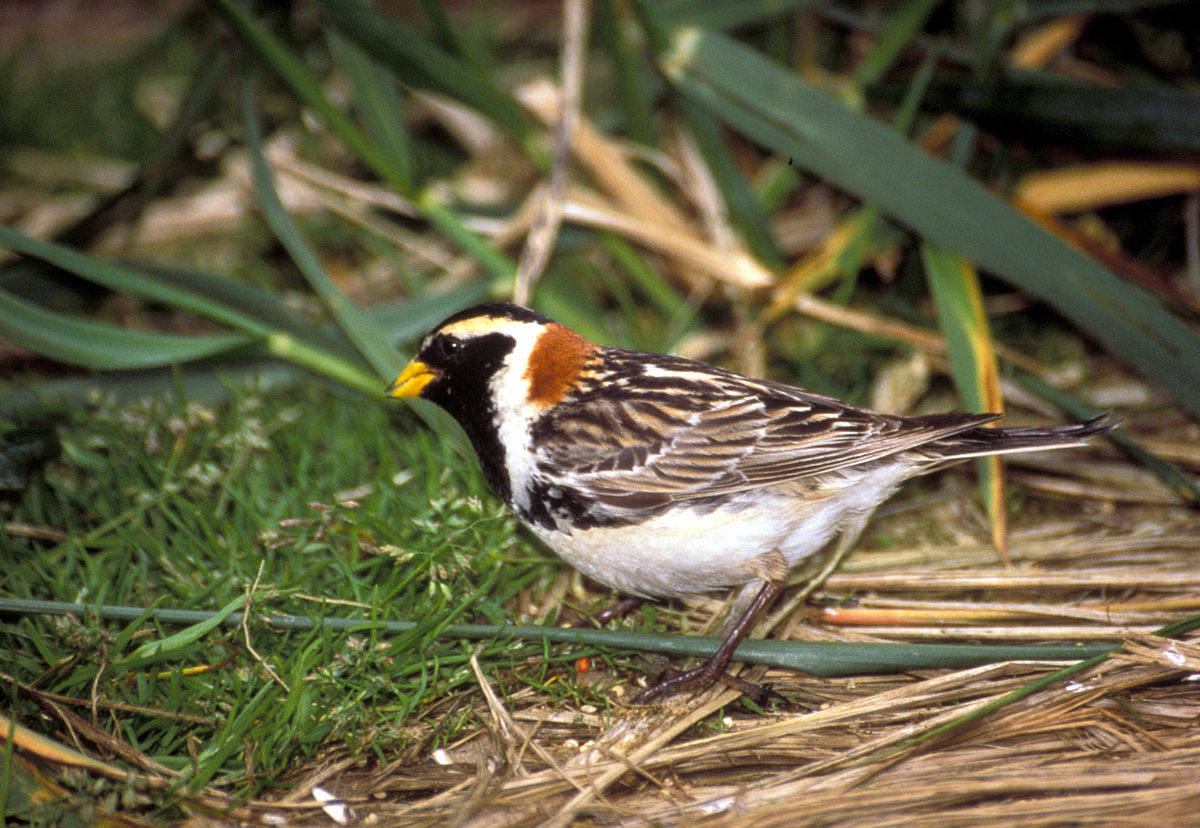
Wikipedia: Lapland longspur Source: OTHER
1200px-Lapland_Longspur_%28Calcarius_lapponicus%29.jpg
This bird appears across the great seas in the following continents:
Europe, North America.
Deutschland: Zugvogel, Wintergast
Song: ![]() Song: a short, creaky, brittle phrase, rich in harmonics; "kril-trrlrtt-ti-trlllkrlltrrt". Somewhat reminiscent of Horned Lark, but without its hesitating intro. In form a bit like Snow Bunting, but much less clear tones. [Link]
Song: a short, creaky, brittle phrase, rich in harmonics; "kril-trrlrtt-ti-trlllkrlltrrt". Somewhat reminiscent of Horned Lark, but without its hesitating intro. In form a bit like Snow Bunting, but much less clear tones. [Link]
Calls: ![]() Call: A Snow Bunting-like "prrrrit", but tone harder. Also a Snow Bunting-like "pjuu". Other sounds: soft, whistling calls reminiscent of Bullfinch, but with richer harmonics. [Link]
Call: A Snow Bunting-like "prrrrit", but tone harder. Also a Snow Bunting-like "pjuu". Other sounds: soft, whistling calls reminiscent of Bullfinch, but with richer harmonics. [Link]
Physical details: length=15-16 cm,
wingspan=25-28 cm,
weight=20-28 g
Profile Wikipedia eBird Audubon AllAboutBirds Xeno-Canto
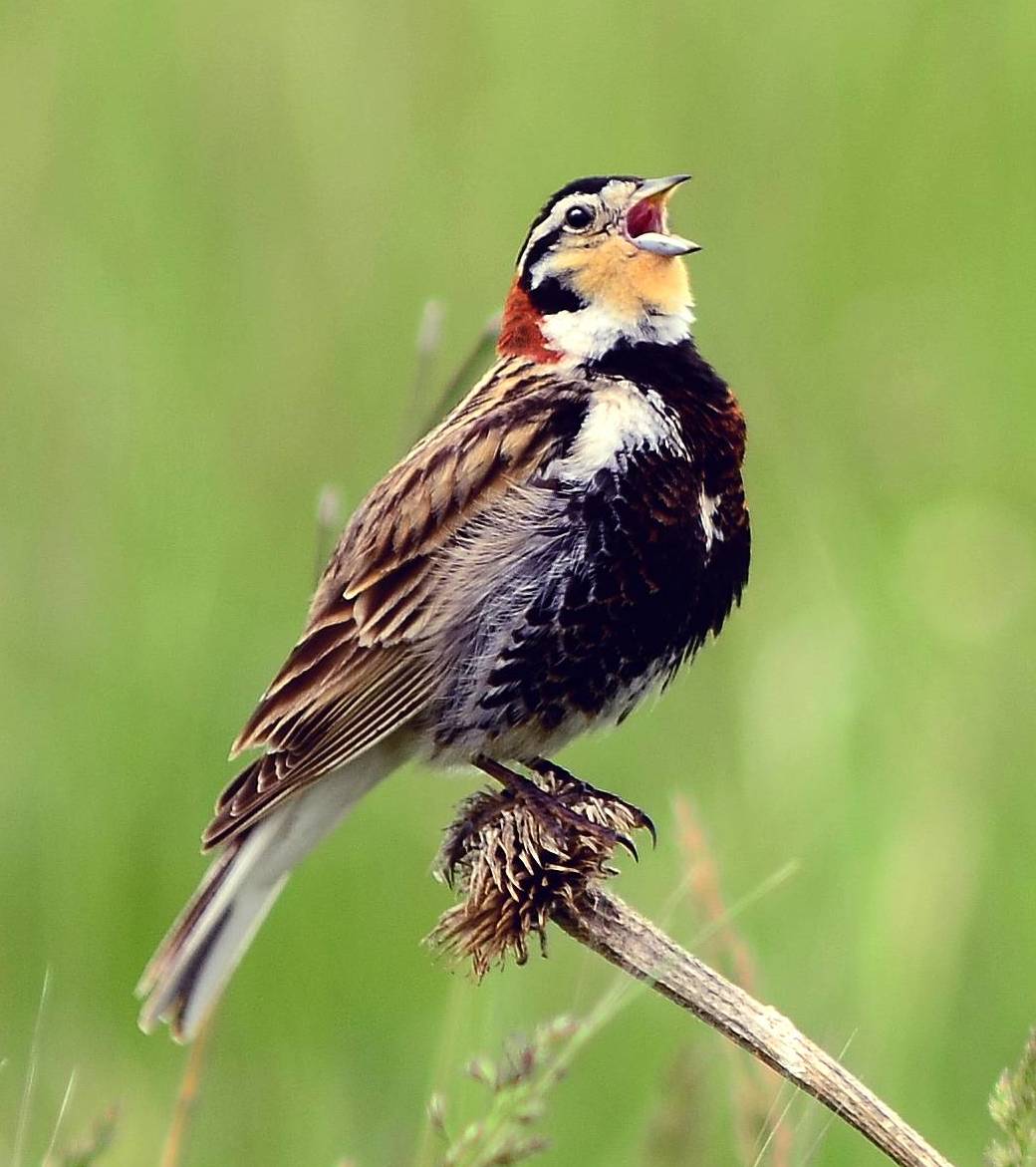
Wikipedia: Chestnut-collared longspur Source: OTHER
Chestnut-collared_longspur_male_%2816381245751%29_%28cropped%29.jpg
General: ![]() The chestnut-collared longspur (Calcarius ornatus) is a species of bird in the family Calcariidae. Like the other longspurs, it is a small ground-feeding bird that primarily eats seeds. It breeds in prairie habitats in Canada and the northern United States and winters to the south in the United States and Mexico.
[more]
The chestnut-collared longspur (Calcarius ornatus) is a species of bird in the family Calcariidae. Like the other longspurs, it is a small ground-feeding bird that primarily eats seeds. It breeds in prairie habitats in Canada and the northern United States and winters to the south in the United States and Mexico.
[more]
Profile Wikipedia eBird Audubon AllAboutBirds Xeno-Canto
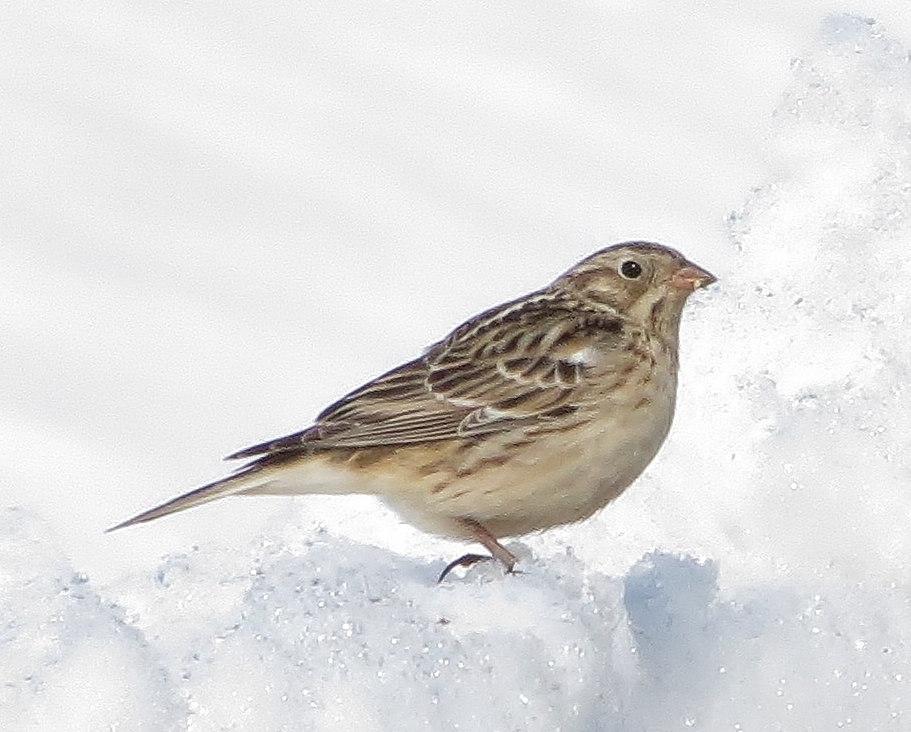
Wikipedia: Smith's longspur Source: OTHER
Calcarius_pictus_1584569.jpg
![]() Smith's longspur (Calcarius pictus) is a bird from the family Calcariidae, which also contains the other species of longspurs. A bird of open habitats, it breeds in northern Canada and Alaska, and winters in the southern United States. Primarily a ground-feeding seed-eater, it supplements its diet with insects in the summer.
[more]
Smith's longspur (Calcarius pictus) is a bird from the family Calcariidae, which also contains the other species of longspurs. A bird of open habitats, it breeds in northern Canada and Alaska, and winters in the southern United States. Primarily a ground-feeding seed-eater, it supplements its diet with insects in the summer.
[more]
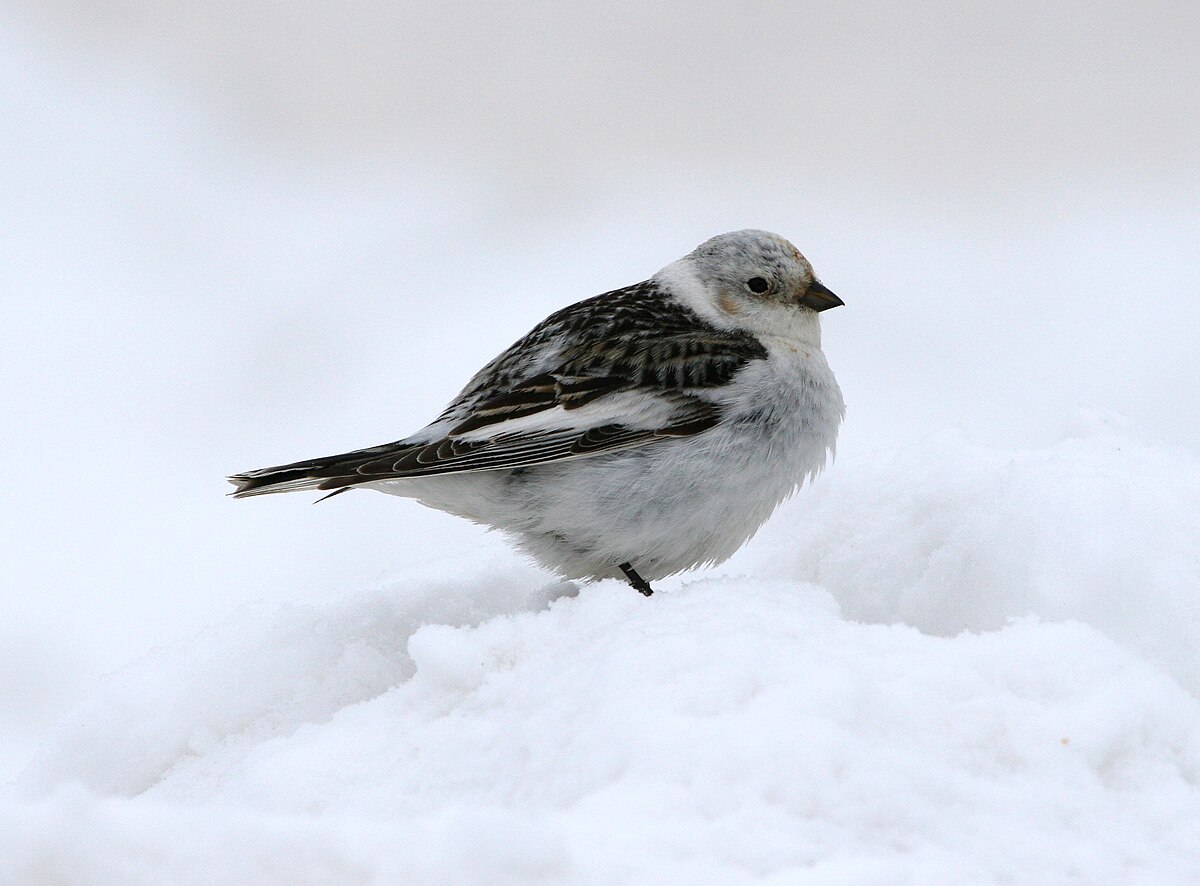
Wikipedia: Snow bunting Source: OTHER
1200px-Plectrophenax_nivalis1.jpg
This bird appears across the great seas in the following continents:
Europe, North America.
Deutschland: Wintergast
Song: ![]() Song simple and melodic. 2-5 syllable motifs with fairly wide tonal range. Can be confused with Lapland Bunting, but is much purer in tone with a less jingling timbre. Local dialects. [Link]
Song simple and melodic. 2-5 syllable motifs with fairly wide tonal range. Can be confused with Lapland Bunting, but is much purer in tone with a less jingling timbre. Local dialects. [Link]
Calls: ![]() Contact call a short, melodic and rapidly descending "peeuu". Often alternating with a rattling "trrreet". "Peeuu"-call quite similar to Lapland Bunting, but harder, purer in tone and less nasal. [Link]
Contact call a short, melodic and rapidly descending "peeuu". Often alternating with a rattling "trrreet". "Peeuu"-call quite similar to Lapland Bunting, but harder, purer in tone and less nasal. [Link]
Physical details: length=16-17 cm,
wingspan=32-38 cm,
weight=28-50 g
Profile Wikipedia eBird Audubon AllAboutBirds Xeno-Canto

Wikipedia: McKay's bunting Source: OTHER
1200px-Plectrophenax_hyperboreus_Bering_Land_Bridge_Visitor_Center_2.jpg
General: ![]() McKay's bunting (Plectrophenax hyperboreus) is a passerine bird in the longspur family Calcariidae. It is most closely related to the snow bunting (P. nivalis). Hybrids between the two species have been observed, leading some authorities to treat McKay's as a subspecies of snow bunting. As the Plectrophenax buntings are nested within the Calcarius clade, their closest relatives are the longspurs. McKay's bunting breeds on two islands in the Bering Sea, St. Matthew and Hall islands, and winters on the western coast of the U.S. state of Alaska.
[more]
McKay's bunting (Plectrophenax hyperboreus) is a passerine bird in the longspur family Calcariidae. It is most closely related to the snow bunting (P. nivalis). Hybrids between the two species have been observed, leading some authorities to treat McKay's as a subspecies of snow bunting. As the Plectrophenax buntings are nested within the Calcarius clade, their closest relatives are the longspurs. McKay's bunting breeds on two islands in the Bering Sea, St. Matthew and Hall islands, and winters on the western coast of the U.S. state of Alaska.
[more]

Wikipedia: Bachman's sparrow Source: OTHER
Bachmanssparrow.jpg
![]() Bachman's sparrow (Peucaea aestivalis) (also known as the "Pinewoods Sparrow" or "Oakwoods Sparrow") is a small American sparrow that is endemic to the southeastern United States. This species was named in honor of Reverend John Bachman.[3]
[more]
Bachman's sparrow (Peucaea aestivalis) (also known as the "Pinewoods Sparrow" or "Oakwoods Sparrow") is a small American sparrow that is endemic to the southeastern United States. This species was named in honor of Reverend John Bachman.[3]
[more]

Wikipedia: Cassin's sparrow Source: OTHER
Cassin%27s_Sparrow%2C_Peucaea_cassinii.jpg
![]() Cassin's sparrow (Peucaea cassinii) is a medium-sized sparrow.
[more]
Cassin's sparrow (Peucaea cassinii) is a medium-sized sparrow.
[more]
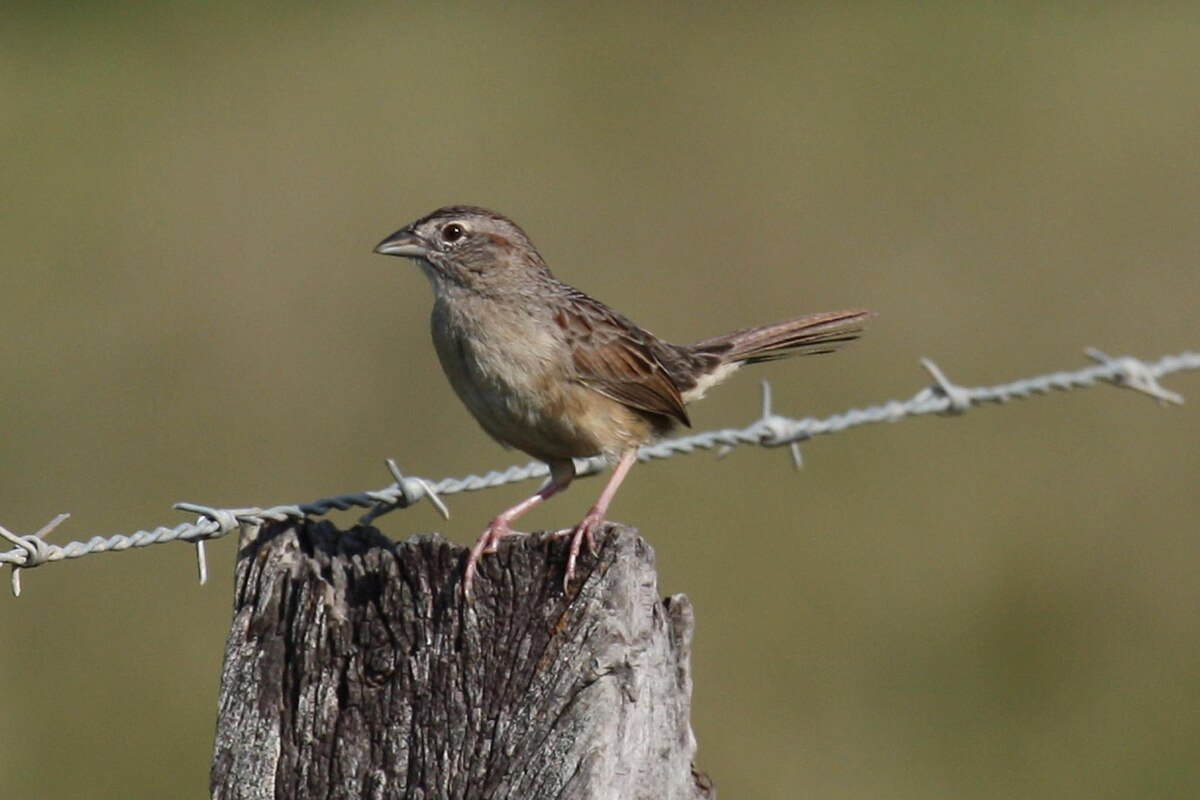
Wikipedia: Botteri's sparrow Source: OTHER
1200px-Aimophila_botterii.jpg
![]() Botteri's sparrow (Peucaea botterii) is a medium-sized sparrow.
[more]
Botteri's sparrow (Peucaea botterii) is a medium-sized sparrow.
[more]
Profile Wikipedia eBird Audubon AllAboutBirds Xeno-Canto

Wikipedia: Rufous-winged sparrow Source: OTHER
1200px-Rufous-winged_sparrow.jpg
![]() The rufous-winged sparrow (Peucaea carpalis) is a medium-small, long-tailed New World sparrow with a gray face and rusty crown and supercilium; the rufous lesser coverts of the wing for which it is named are often concealed.
[more]
The rufous-winged sparrow (Peucaea carpalis) is a medium-small, long-tailed New World sparrow with a gray face and rusty crown and supercilium; the rufous lesser coverts of the wing for which it is named are often concealed.
[more]
Profile Wikipedia eBird Audubon AllAboutBirds Xeno-Canto

Wikipedia: Antillean euphonia Source: OTHER
Antillean_Euphonia.jpg
![]() The Antillean euphonia (Euphonia musica) is a bird species in the finch family, Fringillidae (formerly in Thraupidae).
It is found in all the main islands of the Lesser Antilles, as well as Hispaniola (Dominican Republic and Haiti) and Puerto Rico.[2]
Its natural habitats are subtropical or tropical dry forest, subtropical or tropical moist lowland forest, and heavily degraded former forest.
[more]
The Antillean euphonia (Euphonia musica) is a bird species in the finch family, Fringillidae (formerly in Thraupidae).
It is found in all the main islands of the Lesser Antilles, as well as Hispaniola (Dominican Republic and Haiti) and Puerto Rico.[2]
Its natural habitats are subtropical or tropical dry forest, subtropical or tropical moist lowland forest, and heavily degraded former forest.
[more]
Profile Wikipedia eBird Audubon AllAboutBirds Xeno-Canto
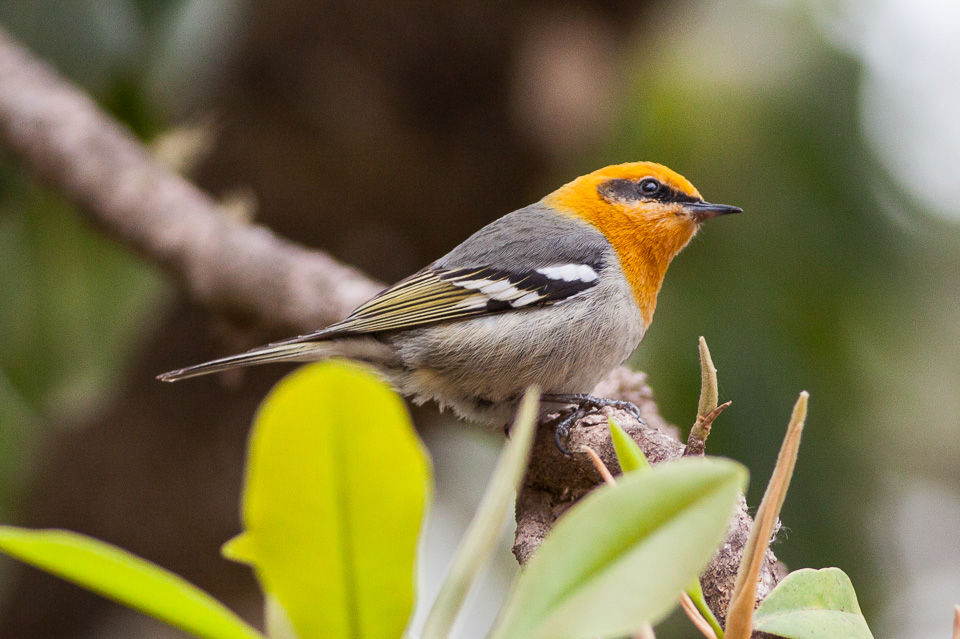
Wikipedia: Olive warbler Source: OTHER
Peucedramus_taeniatus_Durango_Highway_Sinaloa.jpg
![]() The olive warbler (Peucedramus taeniatus) is a small passerine bird. It is the only member of the genus Peucedramus and the family Peucedramidae.
[more]
The olive warbler (Peucedramus taeniatus) is a small passerine bird. It is the only member of the genus Peucedramus and the family Peucedramidae.
[more]
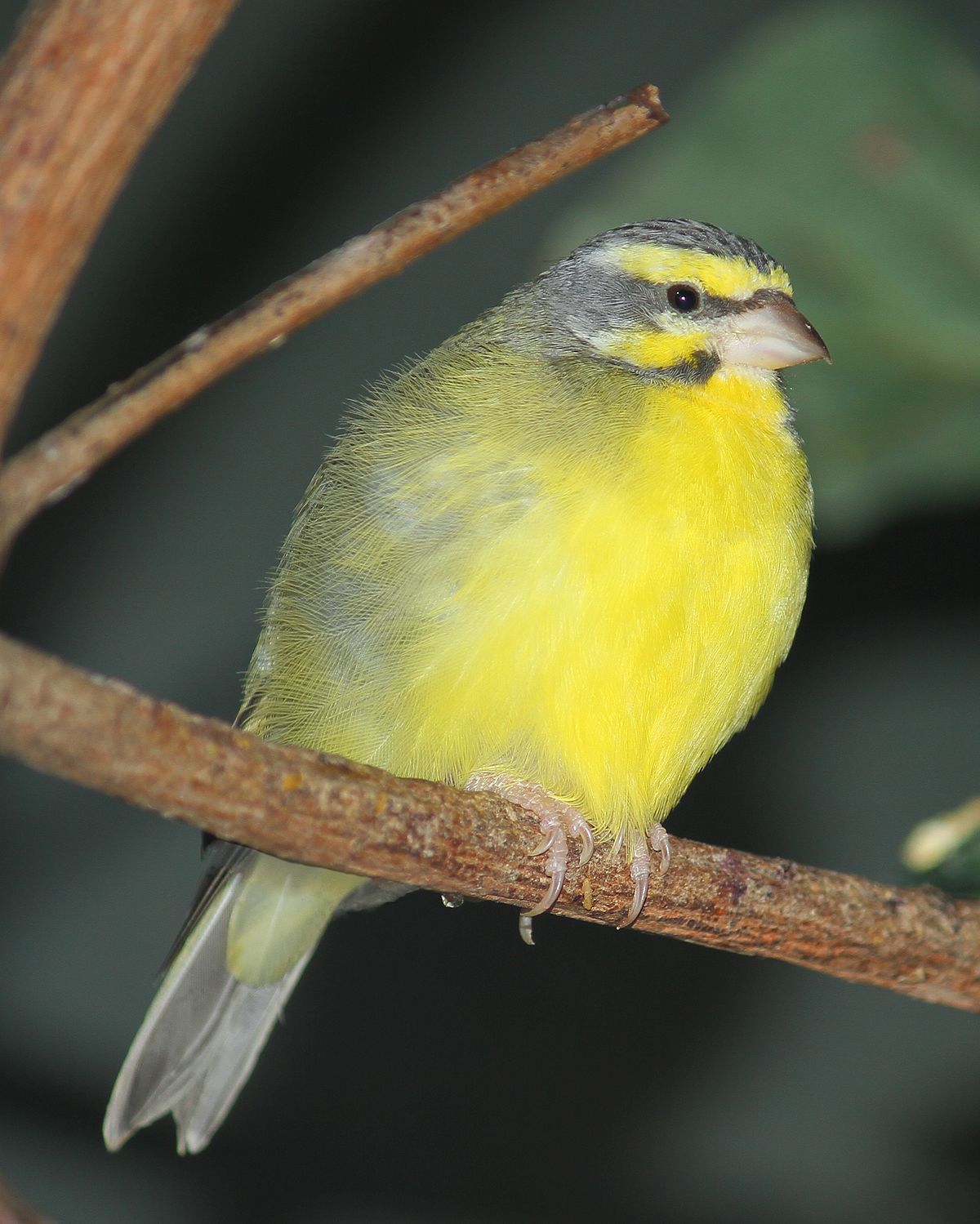
Wikipedia: Yellow-fronted canary Source: OTHER
1200px-Serinus_masambicus_25.jpg
This bird appears across the great seas in the following continents:
North America, Africa.
![]() The yellow-fronted canary (Crithagra mozambica), also called the yellow-eyed canary, is a small passerine bird in the finch family. It is known elsewhere and in aviculture as the green singing finch.
[more]
The yellow-fronted canary (Crithagra mozambica), also called the yellow-eyed canary, is a small passerine bird in the finch family. It is known elsewhere and in aviculture as the green singing finch.
[more]

Wikipedia: Red-throated pipit Source: OTHER
1200px-Red-throated_Pipit.jpg
This bird appears across the great seas in the following continents:
Europe, North America, Africa, Asia.
![]() The red-throated pipit (Anthus cervinus) is a small passerine bird which breeds in the far north of Europe and the Palearctic, with a foothold in northern Alaska. It is a long-distance migrant moving in winter to Africa, south and east Asia and west coast United States. It is a vagrant to western Europe.
[more]
The red-throated pipit (Anthus cervinus) is a small passerine bird which breeds in the far north of Europe and the Palearctic, with a foothold in northern Alaska. It is a long-distance migrant moving in winter to Africa, south and east Asia and west coast United States. It is a vagrant to western Europe.
[more]
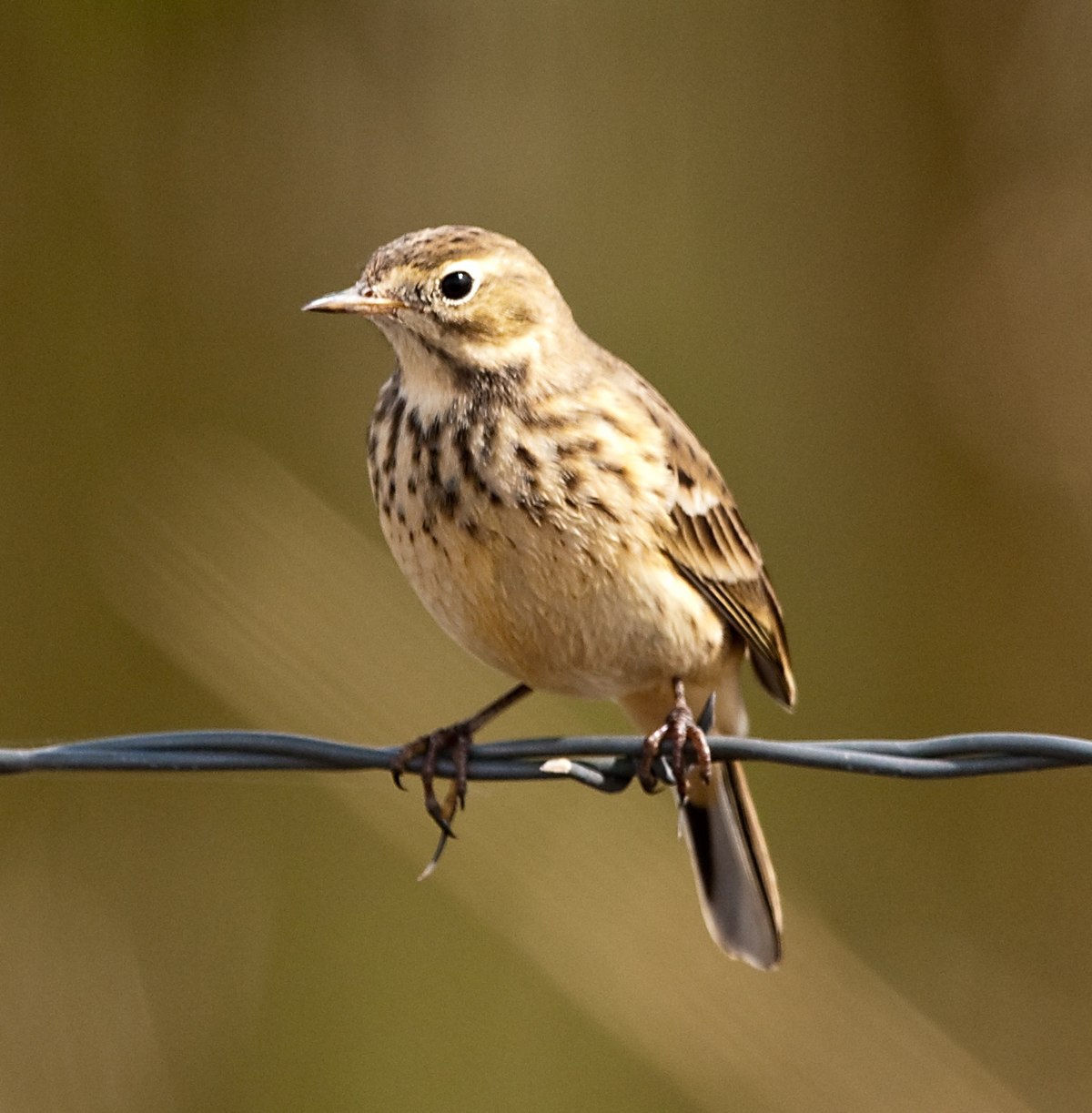
Wikipedia: American pipit Source: OTHER
1200px-Anthus_rubescens_-Harney_County%2C_Oregon%2C_USA-8.jpg
![]() The buff-bellied pipit or American pipit (Anthus rubescens) is a small songbird found on both sides of the northern Pacific. It was first described by Marmaduke Tunstall in his 1771 Ornithologia Britannica.[2] It was formerly classified as a form of the water pipit. It is known as "American pipit" in North America and "buff-bellied pipit" in Eurasia.
[more]
The buff-bellied pipit or American pipit (Anthus rubescens) is a small songbird found on both sides of the northern Pacific. It was first described by Marmaduke Tunstall in his 1771 Ornithologia Britannica.[2] It was formerly classified as a form of the water pipit. It is known as "American pipit" in North America and "buff-bellied pipit" in Eurasia.
[more]
Olive-backed pipit. 2024-01-29 11.44.04 Laos
First observed in Laos on 2024-01-29.
This bird appears across the great seas in the following continents:
North America, Africa, Asia.
Song:
Automatically generated from Xeno-Canto recording
Song attributes:
Frequency:
♫ XC832525 - Olive-backed Pipit - Anthus hodgsoni - song, Ulaanbaatar, Mongolia. Source: XENOCANTO
XC832525 - Olive-backed Pipit - Anthus hodgsoni - song, Ulaanbaatar, Mongolia.mp3
(song)


Wikipedia: Sprague's pipit Source: OTHER
Anthus_spragueii_1870.jpg
![]() Sprague's pipit (Anthus spragueii) is a small songbird (passerine) in the family Motacillidae that breeds in the short- and mixed-grass prairies of North America. Migratory, it spends the winters in the southwestern United States and northern Mexico. Sprague's pipits are unusual among songbirds in that they sing high in the sky, somewhat like a goldfinch or skylark. It is more often identified by its distinctive descending song heard from above than by being seen on the ground. Males and females are cryptically coloured and similar in appearance; they are a buffy brown with darker streaking, slender bills and pinkish to yellow legs. Sprague's pipit summer habitat is primarily native grasslands in the north central prairies of the United States and Canada (distinguishing them from the American subspecies of the buff-bellied pipit, which breed in the northern Rocky Mountains and the Arctic). The species was named after the botanical illustrator Isaac Sprague.
[more]
Sprague's pipit (Anthus spragueii) is a small songbird (passerine) in the family Motacillidae that breeds in the short- and mixed-grass prairies of North America. Migratory, it spends the winters in the southwestern United States and northern Mexico. Sprague's pipits are unusual among songbirds in that they sing high in the sky, somewhat like a goldfinch or skylark. It is more often identified by its distinctive descending song heard from above than by being seen on the ground. Males and females are cryptically coloured and similar in appearance; they are a buffy brown with darker streaking, slender bills and pinkish to yellow legs. Sprague's pipit summer habitat is primarily native grasslands in the north central prairies of the United States and Canada (distinguishing them from the American subspecies of the buff-bellied pipit, which breed in the northern Rocky Mountains and the Arctic). The species was named after the botanical illustrator Isaac Sprague.
[more]
Profile Wikipedia eBird Vogelwarte BirdLife ZH ornitho.ch bird-song.ch Audubon AllAboutBirds Xeno-Canto BirdID NABU
White wagtail at edge of field near Mesikon 2020-04-25 07.21.02 Luppmen
First observed in Iceland on 2015-06-05.
This bird appears across the great seas in the following continents:
Europe, North America, Africa, Asia.
![]() The white wagtail (Motacilla alba) is a small passerine bird in the family Motacillidae, which also includes pipits and longclaws. The species breeds in much of Europe and the Asian Palearctic and parts of North Africa. It has a toehold in Alaska as a scarce breeder. It is resident in the mildest parts of its range, but otherwise migrates to Africa. In Ireland and Great Britain, the darker subspecies, the pied wagtail or water wagtail[2] (M. a. yarrellii) predominates. In total, there are between 9 and 11 subspecies.
[more]
The white wagtail (Motacilla alba) is a small passerine bird in the family Motacillidae, which also includes pipits and longclaws. The species breeds in much of Europe and the Asian Palearctic and parts of North Africa. It has a toehold in Alaska as a scarce breeder. It is resident in the mildest parts of its range, but otherwise migrates to Africa. In Ireland and Great Britain, the darker subspecies, the pied wagtail or water wagtail[2] (M. a. yarrellii) predominates. In total, there are between 9 and 11 subspecies.
[more]
Song: ![]() Song either slow and primitive, consisting of sharp falling notes given by perched birds, or longer fast and energic bursts in excited song-flight. [Link]
Song either slow and primitive, consisting of sharp falling notes given by perched birds, or longer fast and energic bursts in excited song-flight. [Link]
Calls: ![]() Contact calls short and sharp. Usually with disyllabic, "bouncing" quality, and with each syllable only accented, not clearly separated from the other (see Grey Wagtail). [Link]
Contact calls short and sharp. Usually with disyllabic, "bouncing" quality, and with each syllable only accented, not clearly separated from the other (see Grey Wagtail). [Link]
Physical details: length=18 cm,
wingspan=25-30 cm,
weight=17-25 g
Habitats:
Settlement
Song:
General: Usually just calls. This song is just a few chirpy slurs, sometimes rising-rising-falling.
Song: ![]() Zirpt wie ein Sperling aber weniger Noten. Lh lh lh [Link]
Zirpt wie ein Sperling aber weniger Noten. Lh lh lh [Link]
Song attributes:
Melody: stereotype melodic, slow, Frequency: 2-7 KHz
♫ Source: XENOCANTO
XC694995 - White Wagtail - Motacilla alba - song recorded in Spain.mp3
Spain (song)

Call:
bird-song.ch: zweisilbig «zilipp» oder einsilbig «zipp»
♫ Source: XENOCANTO
XC644775 - White Wagtail - Motacilla alba alba - call, recorded in Estonia.mp3
(call)

Call attributes:
Call melody: one note, slow, Frequency: 3-7 KHz,
Presence: 03-01 - 10-28

Wikipedia: Eastern yellow wagtail Source: OTHER
1200px-Motacilla_tschutschensis%2C_Tomohon%2C_North_Sulawesi.jpg
This bird appears across the great seas in the following continents:
Europe, North America, Asia, Australia.
General: ![]() The eastern yellow wagtail (Motacilla tschutschensis) is a small passerine in the wagtail family Motacillidae, which also includes the pipits and longclaws. It was often classified as a subspecies of the Western yellow wagtail.
[more]
The eastern yellow wagtail (Motacilla tschutschensis) is a small passerine in the wagtail family Motacillidae, which also includes the pipits and longclaws. It was often classified as a subspecies of the Western yellow wagtail.
[more]
Profile Wikipedia eBird Audubon AllAboutBirds Xeno-Canto
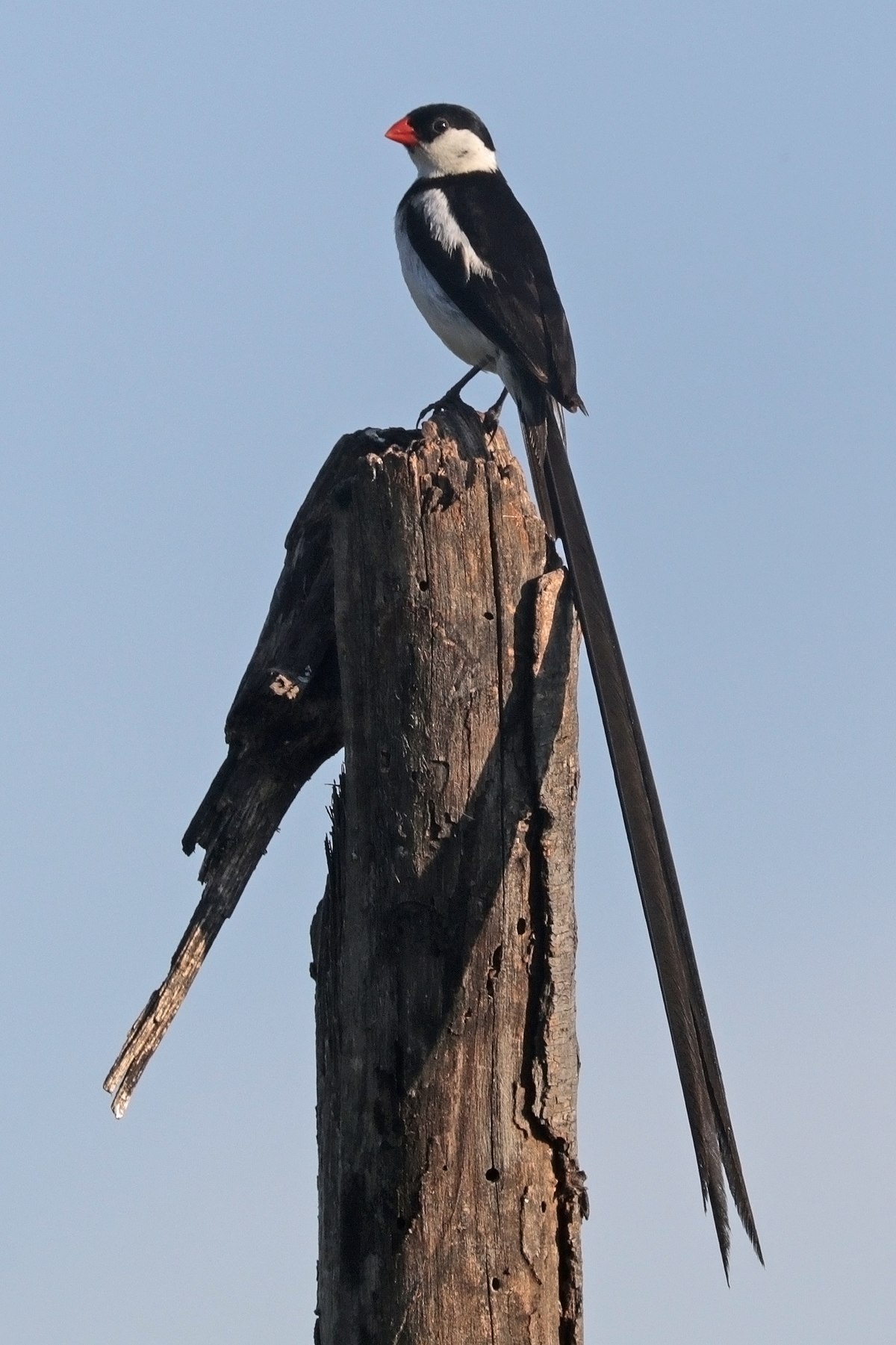
Wikipedia: Pin-tailed whydah Source: OTHER
1200px-Pin-tailed_whydah_%28Vidua_macroura%29_breeding_male.jpg
This bird appears across the great seas in the following continents:
North America, Africa.
![]() The pin-tailed whydah (Vidua macroura) is a small songbird with a conspicuous pennant-like tail in breeding males. It is a resident breeding bird in most of Africa south of the Sahara Desert.
[more]
The pin-tailed whydah (Vidua macroura) is a small songbird with a conspicuous pennant-like tail in breeding males. It is a resident breeding bird in most of Africa south of the Sahara Desert.
[more]
Profile Wikipedia eBird Audubon AllAboutBirds Xeno-Canto NABU
Scaly breasted munia, Vientiane. 2024-02-18 06.54.12 Laos
First observed in Laos on 2024-02-18.
This bird appears across the great seas in the following continents:
Europe, North America, Asia, Australia.
introduced, mainland; vagrant, Ashmore Reef
Song:
Automatically generated from Xeno-Canto recording
Song attributes:
Frequency:
♫ XC797137 - Scaly-breasted Munia - Lonchura punctulata topela - song, Pha Chang Park, Wiang Chai District, Chiang Rai, Thailand. Source: XENOCANTO
XC797137 - Scaly-breasted Munia - Lonchura punctulata topela - song, Pha Chang Park, Wiang Chai District, Chiang Rai, Thailand.mp3
Thailand (song)

Profile Wikipedia eBird Audubon AllAboutBirds Xeno-Canto NABU
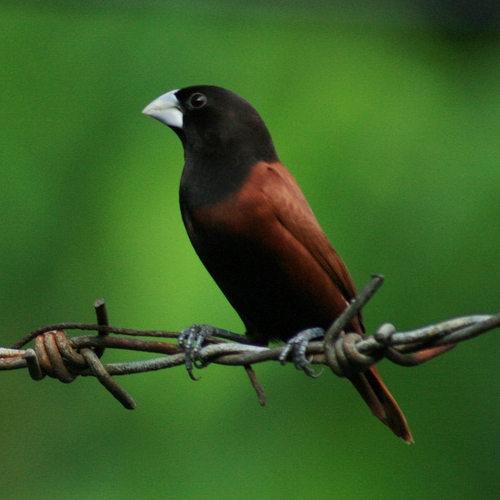
Wikipedia: Chestnut munia Source: OTHER
Lonchura_atricapilla_jagori_-Cebu-8-3c.jpg
This bird appears across the great seas in the following continents:
Europe, North America, Asia, Australia.
introduced
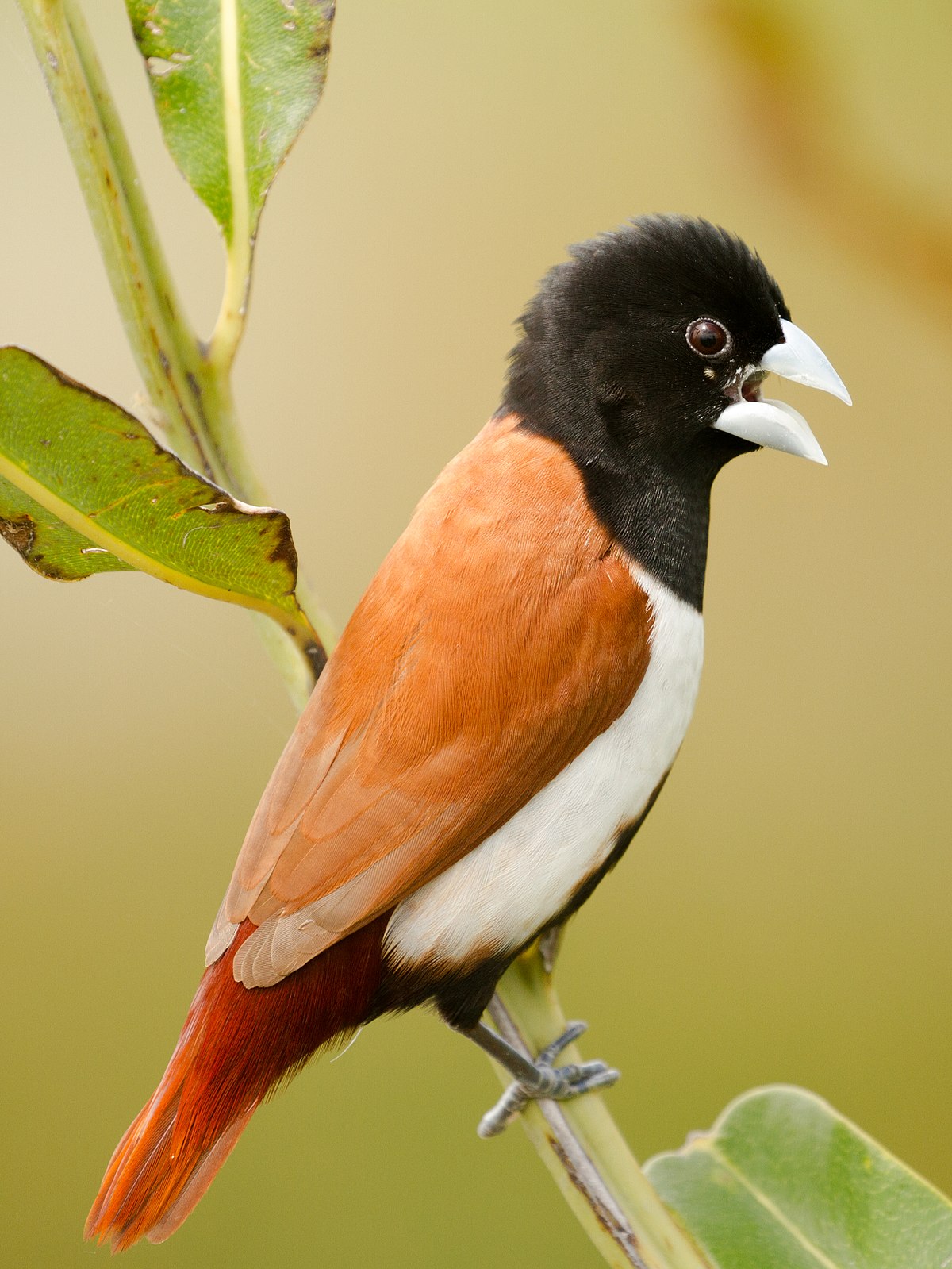
Wikipedia: Tricolored munia Source: OTHER
1200px-Tricoloured_munia_%28cropped%29.jpg
This bird appears across the great seas in the following continents:
Europe, North America, South America, Asia.
General: ![]() The tricoloured munia (Lonchura malacca) is an estrildid finch, native to Bangladesh,[2] India, Sri Lanka, Pakistan, and southern China. The species has also introduced to the Caribbean, in Trinidad, Jamaica, Hispaniola, Puerto Rico, Cuba, and Venezuela. This species, like the chestnut munia has been known as the black-headed munia. Immature birds have pale brown upperparts, lack the dark head found in adults, and have uniform buff underparts that can be confused with immatures of other munias such as the scaly-breasted munia.
[more]
The tricoloured munia (Lonchura malacca) is an estrildid finch, native to Bangladesh,[2] India, Sri Lanka, Pakistan, and southern China. The species has also introduced to the Caribbean, in Trinidad, Jamaica, Hispaniola, Puerto Rico, Cuba, and Venezuela. This species, like the chestnut munia has been known as the black-headed munia. Immature birds have pale brown upperparts, lack the dark head found in adults, and have uniform buff underparts that can be confused with immatures of other munias such as the scaly-breasted munia.
[more]

Wikipedia: African silverbill Source: OTHER
1200px-African_Silverbill.jpg
This bird appears across the great seas in the following continents:
North America, Africa.
![]() The African silverbill (Euodice cantans) is a small passerine bird formerly considered conspecific with the Asian species Indian silverbill, (Euodice malabarica). This estrildid finch is a common resident breeding bird in dry savanna habitat, south of the Sahara Desert. This species has also been introduced to other countries such as Portugal, Qatar and United States.
[more]
The African silverbill (Euodice cantans) is a small passerine bird formerly considered conspecific with the Asian species Indian silverbill, (Euodice malabarica). This estrildid finch is a common resident breeding bird in dry savanna habitat, south of the Sahara Desert. This species has also been introduced to other countries such as Portugal, Qatar and United States.
[more]
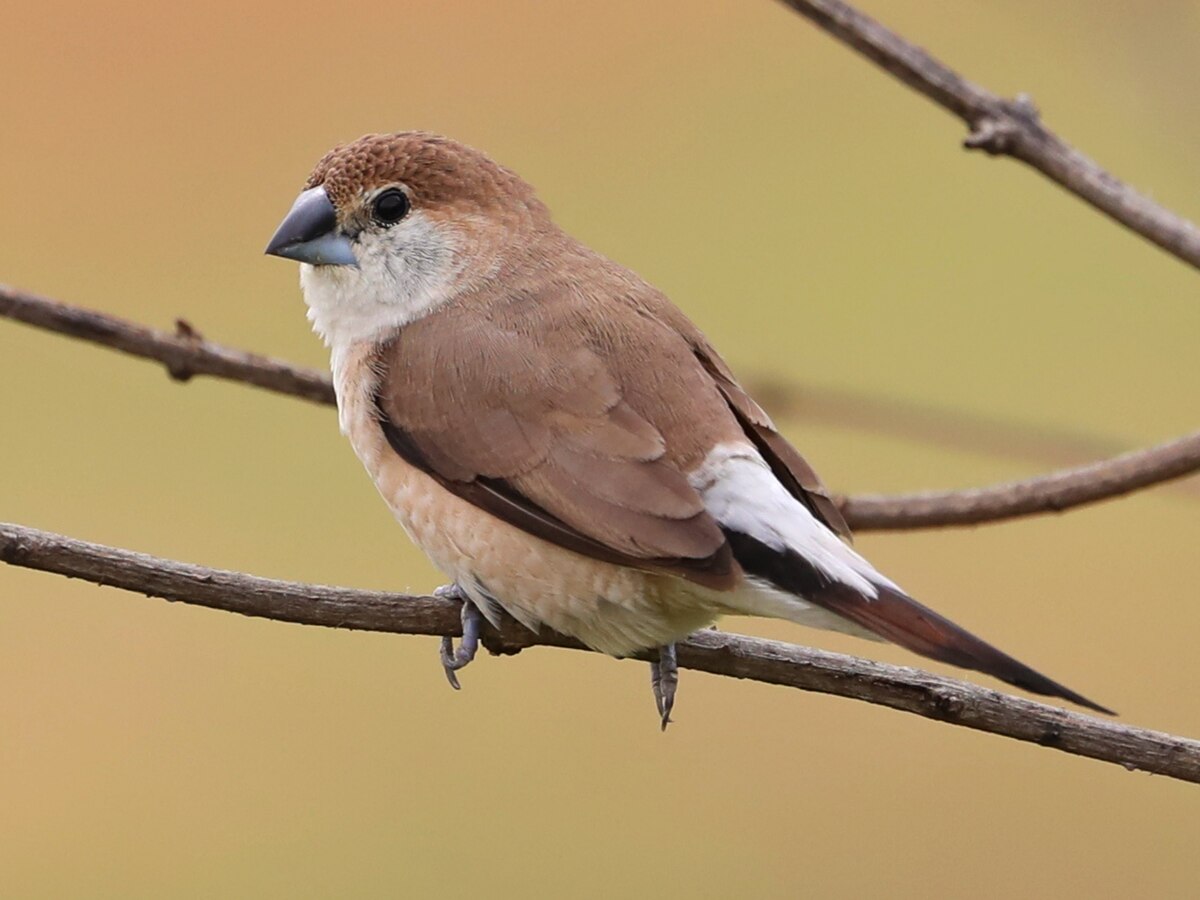
Wikipedia: White-throated silverbill Source: OTHER
1200px-Indian_Silverbill3.jpg
![]() The Indian silverbill or white-throated munia (Euodice malabarica) is a small passerine bird found in the Indian Subcontinent and adjoining regions that was formerly considered to include the closely related African silverbill (Euodice cantans). This estrildid finch is a common resident breeding bird in the drier regions of the Middle East and the Indian Subcontinent. It has also been introduced into many other parts of the world and has become established in some areas. They forage in small flocks in grassland and scrub habitats.
[more]
The Indian silverbill or white-throated munia (Euodice malabarica) is a small passerine bird found in the Indian Subcontinent and adjoining regions that was formerly considered to include the closely related African silverbill (Euodice cantans). This estrildid finch is a common resident breeding bird in the drier regions of the Middle East and the Indian Subcontinent. It has also been introduced into many other parts of the world and has become established in some areas. They forage in small flocks in grassland and scrub habitats.
[more]
Profile Wikipedia eBird Audubon AllAboutBirds Xeno-Canto

Wikipedia: Bronze mannikin Source: OTHER
1200px-Bronze_Mannikin_%288568589949%29%2C_crop.jpg
This bird appears across the great seas in the following continents:
North America, Africa.
![]() The bronze mannikin or bronze munia (Spermestes cucullata) is a small passerine (i.e. perching) bird of the Afrotropics. This very social estrildid finch is an uncommon to locally abundant bird in much of Africa south of the Sahara Desert, where it is resident, nomadic or irruptive in mesic savanna or forest margin habitats.[5][6] It has an estimated global extent of occurrence of 8,100,000 km2. It is the smallest and most widespread of four munia species on the African mainland, the other being black-and-white, red-backed and magpie mannikin. It co-occurs with the Madagascan mannikin on the Comoro Islands, and was introduced to Puerto Rico. Especially in the West Africa, it is considered a pest in grain and rice fields. It is locally trapped for the pet bird trade.[4]
[more]
The bronze mannikin or bronze munia (Spermestes cucullata) is a small passerine (i.e. perching) bird of the Afrotropics. This very social estrildid finch is an uncommon to locally abundant bird in much of Africa south of the Sahara Desert, where it is resident, nomadic or irruptive in mesic savanna or forest margin habitats.[5][6] It has an estimated global extent of occurrence of 8,100,000 km2. It is the smallest and most widespread of four munia species on the African mainland, the other being black-and-white, red-backed and magpie mannikin. It co-occurs with the Madagascan mannikin on the Comoro Islands, and was introduced to Puerto Rico. Especially in the West Africa, it is considered a pest in grain and rice fields. It is locally trapped for the pet bird trade.[4]
[more]

Wikipedia: Red avadavat Source: OTHER
A_pair_of_Red_avadavat_%28Amandava_amandava%29_Photograph_by_Shantanu_Kuveskar.jpg
This bird appears across the great seas in the following continents:
Europe, North America, Africa, Asia.
![]() The red avadavat (Amandava amandava), red munia or strawberry finch, is a sparrow-sized bird of the family Estrildidae. It is found in the open fields and grasslands of tropical Asia and is popular as a cage bird due to the colourful plumage of the males in their breeding season. It breeds in the Indian Subcontinent in the monsoon season. The species name of amandava and the common name of avadavat are derived from the city of Ahmedabad in Gujarat, India, from where these birds were exported into the pet trade in former times.[2][3]
[more]
The red avadavat (Amandava amandava), red munia or strawberry finch, is a sparrow-sized bird of the family Estrildidae. It is found in the open fields and grasslands of tropical Asia and is popular as a cage bird due to the colourful plumage of the males in their breeding season. It breeds in the Indian Subcontinent in the monsoon season. The species name of amandava and the common name of avadavat are derived from the city of Ahmedabad in Gujarat, India, from where these birds were exported into the pet trade in former times.[2][3]
[more]
Profile Wikipedia eBird Audubon AllAboutBirds Xeno-Canto NABU

Wikipedia: Common waxbill Source: OTHER
1200px-Estrilda_astrild_-Gran_Canaria%2C_Canary_Islands%2C_Spain-8_%281%29.jpg
This bird appears across the great seas in the following continents:
Europe, North America, Africa.
![]() The common waxbill (Estrilda astrild), also known as the St Helena waxbill, is a small passerine bird belonging to the estrildid finch family. It is native to sub-Saharan Africa but has been introduced to many other regions of the world and now has an estimated global extent of occurrence of 10,000,000 km2. It is popular and easy to keep in captivity.
[more]
The common waxbill (Estrilda astrild), also known as the St Helena waxbill, is a small passerine bird belonging to the estrildid finch family. It is native to sub-Saharan Africa but has been introduced to many other regions of the world and now has an estimated global extent of occurrence of 10,000,000 km2. It is popular and easy to keep in captivity.
[more]
Profile Wikipedia eBird Audubon AllAboutBirds Xeno-Canto

Wikipedia: Lavender waxbill Source: OTHER
1200px-Lavender_waxbill_%28Estrilda_caerulescens%29.jpg
![]() The lavender waxbill (Glaucestrilda caerulescens) is a common species of estrildid finch native to Central Africa and successfully introduced on Hawai'i. It has an estimated global extent of occurrence of 620,000 km2.
[more]
The lavender waxbill (Glaucestrilda caerulescens) is a common species of estrildid finch native to Central Africa and successfully introduced on Hawai'i. It has an estimated global extent of occurrence of 620,000 km2.
[more]
Red winged blackbird, female. 2022-05-03 10.27.30 Maryland
First observed in Maryland on 2021-06-14.
![]() The red-winged blackbird (Agelaius phoeniceus) is a passerine bird of the family Icteridae found in most of North America and much of Central America. It breeds from Alaska and Newfoundland south to Florida, the Gulf of Mexico, Mexico, and Guatemala, with isolated populations in western El Salvador, northwestern Honduras, and northwestern Costa Rica. It may winter as far north as Pennsylvania and British Columbia, but northern populations are generally migratory, moving south to Mexico and the southern United States. Claims have been made that it is the most abundant living land bird in North America, as bird-counting censuses of wintering red-winged blackbirds sometimes show that loose flocks can number in excess of a million birds per flock and the full number of breeding pairs across North and Central America may exceed 250 million in peak years. It also ranks among the best-studied wild bird species in the world.[2][3][4][5][6] The red-winged blackbird is sexually dimorphic; the male is all black with a red shoulder and yellow wing bar, while the female is a nondescript dark brown. Seeds and insects make up the bulk of the red-winged blackbird's diet.
[more]
The red-winged blackbird (Agelaius phoeniceus) is a passerine bird of the family Icteridae found in most of North America and much of Central America. It breeds from Alaska and Newfoundland south to Florida, the Gulf of Mexico, Mexico, and Guatemala, with isolated populations in western El Salvador, northwestern Honduras, and northwestern Costa Rica. It may winter as far north as Pennsylvania and British Columbia, but northern populations are generally migratory, moving south to Mexico and the southern United States. Claims have been made that it is the most abundant living land bird in North America, as bird-counting censuses of wintering red-winged blackbirds sometimes show that loose flocks can number in excess of a million birds per flock and the full number of breeding pairs across North and Central America may exceed 250 million in peak years. It also ranks among the best-studied wild bird species in the world.[2][3][4][5][6] The red-winged blackbird is sexually dimorphic; the male is all black with a red shoulder and yellow wing bar, while the female is a nondescript dark brown. Seeds and insects make up the bulk of the red-winged blackbird's diet.
[more]
Call:
Automatically generated from Xeno-Canto recording
♫ Source: BirdNet
20220501_101845 birdnet - Red-winged Blackbird - 2022-05-01 10:18:45 - Red-winged Blackbird - Cockeysville.mp3
2022-05-01 10.18.45 Cockeysville (song?)

Wikipedia: Tricolored blackbird Source: OTHER
Blackbird_tricolored_male_summer_california_monte-m-taylor.jpg
![]() The tricolored blackbird (Agelaius tricolor) is a passerine bird of the family Icteridae. Its range is limited to the coastal areas of the Pacific coast of North America, from Northern California in the U.S. (with occasional strays into Oregon), to upper Baja California in Mexico.
[more]
The tricolored blackbird (Agelaius tricolor) is a passerine bird of the family Icteridae. Its range is limited to the coastal areas of the Pacific coast of North America, from Northern California in the U.S. (with occasional strays into Oregon), to upper Baja California in Mexico.
[more]
Profile Wikipedia eBird A-Z Animals Audubon AllAboutBirds Xeno-Canto
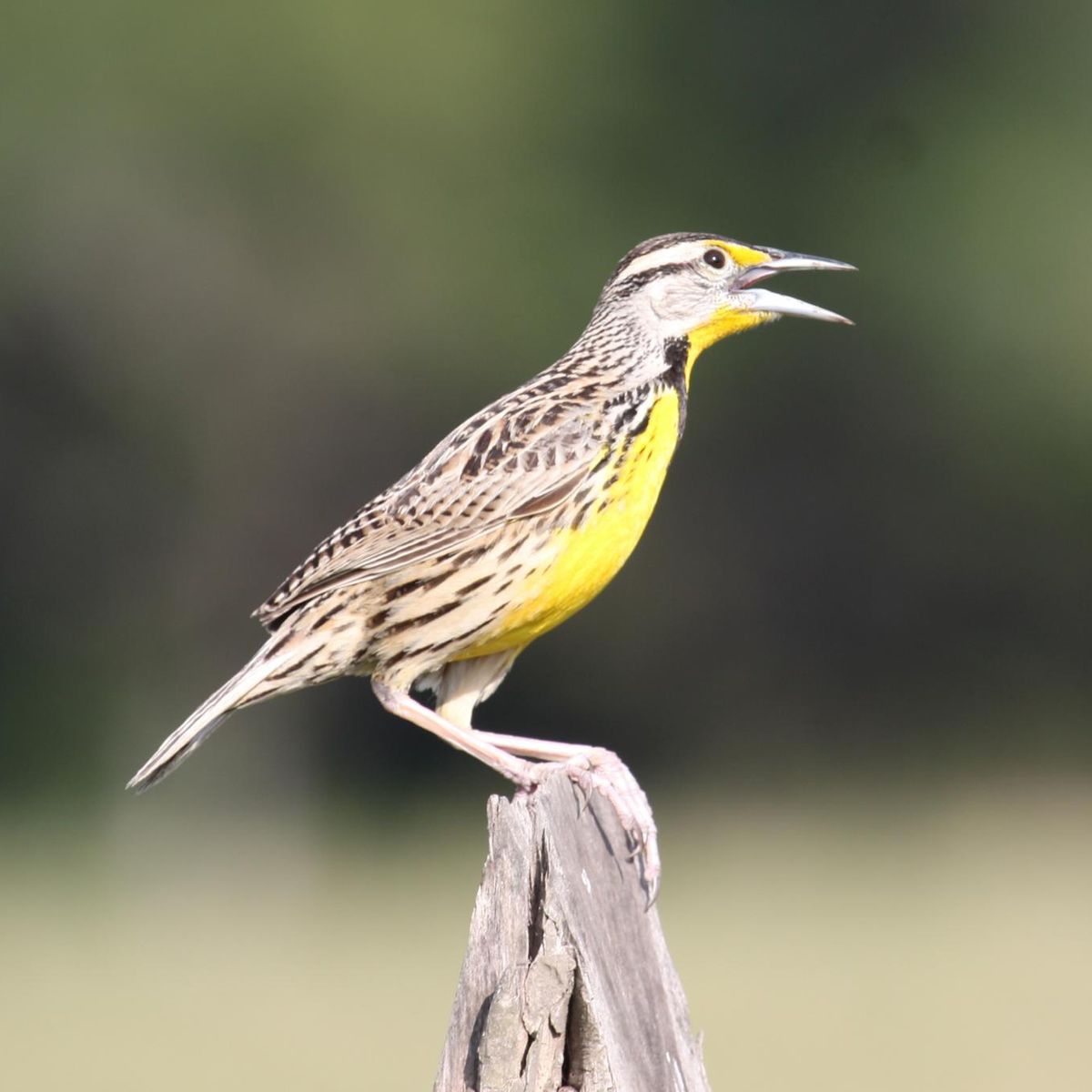
Wikipedia: Eastern meadowlark Source: OTHER
1200px-Sturnella_magna_-Mexico-8.jpg
Mexico
First observed in Panama on 2020-03-02.
![]() The eastern meadowlark (Sturnella magna) is a medium-sized icterid bird, very similar in appearance to the western meadowlark. It occurs from eastern North America to South America, where it is also most widespread in the east.
[more]
The eastern meadowlark (Sturnella magna) is a medium-sized icterid bird, very similar in appearance to the western meadowlark. It occurs from eastern North America to South America, where it is also most widespread in the east.
[more]
Call:
Automatically generated from Xeno-Canto recording
♫ Source: BirdNet
20200302_220235 birdnet 24 - Eastern Meadowlark - 2020-03-02 22:02:35 - Eastern Meadowlark - Bajo Boquete.mp3
2020-03-02 22.02.35 Panama (song?)
Profile Wikipedia eBird Audubon AllAboutBirds Xeno-Canto

Wikipedia: Western meadowlark Source: OTHER
1200px-Western_Meadowlark.jpg
![]() The western meadowlark (Sturnella neglecta) is a medium-sized icterid bird, about 8.5 in (22 cm) in length. It nests on the ground in open grasslands across western and central North America. It feeds mostly on bugs, but will also feed on seeds and berries. The western meadowlark has distinctive calls described as watery or flute-like, which distinguish it from the closely related eastern meadowlark. The western meadowlark is the state bird of six states: Montana, Kansas, Nebraska, North Dakota, Oregon, and Wyoming.
[more]
The western meadowlark (Sturnella neglecta) is a medium-sized icterid bird, about 8.5 in (22 cm) in length. It nests on the ground in open grasslands across western and central North America. It feeds mostly on bugs, but will also feed on seeds and berries. The western meadowlark has distinctive calls described as watery or flute-like, which distinguish it from the closely related eastern meadowlark. The western meadowlark is the state bird of six states: Montana, Kansas, Nebraska, North Dakota, Oregon, and Wyoming.
[more]
Profile Wikipedia eBird Audubon AllAboutBirds Xeno-Canto
Boat-tailed grackles. 2023-09-24 09.53.28 Florida
First observed in Florida on 2023-09-24.
![]() The boat-tailed grackle (Quiscalus major) is a passerine bird of the family Icteridae found as a permanent resident on the coasts of the Southeastern United States.
[more]
The boat-tailed grackle (Quiscalus major) is a passerine bird of the family Icteridae found as a permanent resident on the coasts of the Southeastern United States.
[more]
Profile Wikipedia eBird A-Z Animals Audubon AllAboutBirds Xeno-Canto
The Common Grackle has yellow eyes, unlike the boat-tailed. 2023-09-27 14.24.20 Florida
First observed in Maryland on 2021-06-17.
![]() The common grackle (Quiscalus quiscula) is a large icterid found in large numbers through much of North America. First described in 1758 by Carl Linnaeus, the common grackle has three subspecies. Adult common grackles have a long and dark bill, pale yellow eyes, and a long tail. Adults often have an iridescent appearance on their head, especially males. Common grackles are found in much of North America east of the Rocky Mountains.
[more]
The common grackle (Quiscalus quiscula) is a large icterid found in large numbers through much of North America. First described in 1758 by Carl Linnaeus, the common grackle has three subspecies. Adult common grackles have a long and dark bill, pale yellow eyes, and a long tail. Adults often have an iridescent appearance on their head, especially males. Common grackles are found in much of North America east of the Rocky Mountains.
[more]
Profile Wikipedia eBird Audubon AllAboutBirds Xeno-Canto
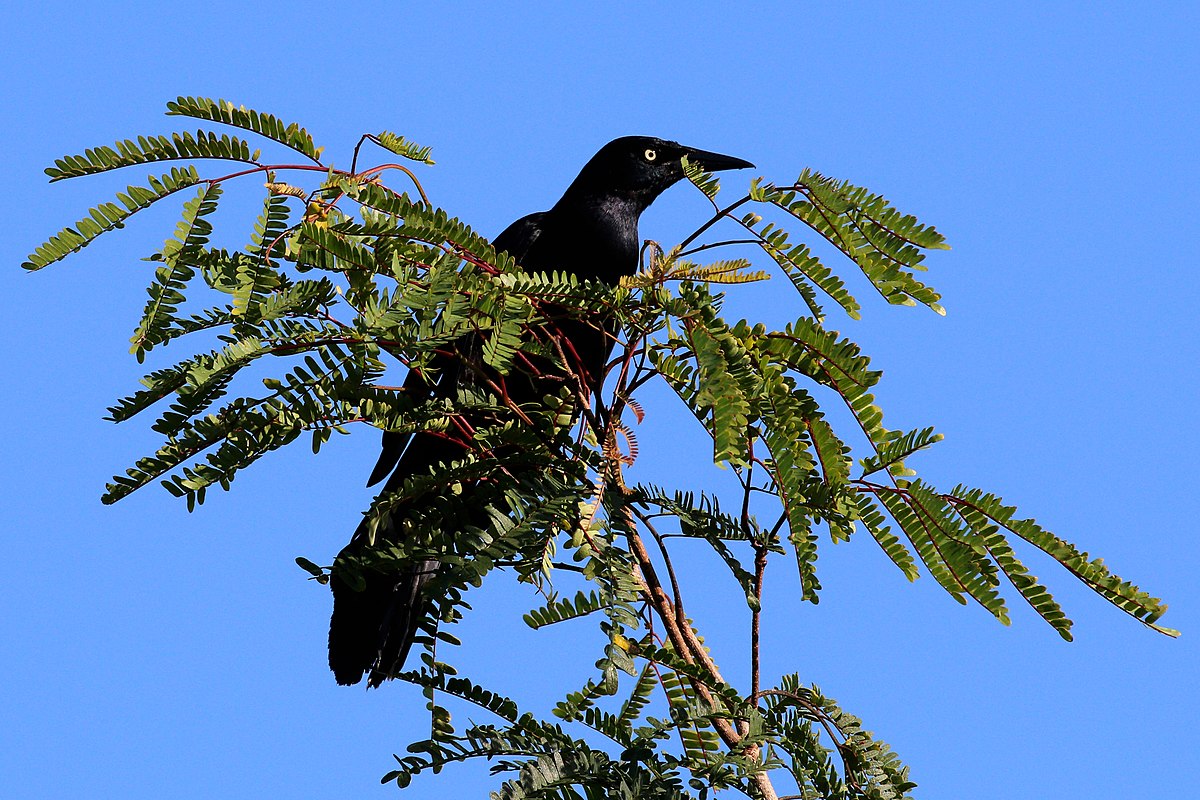
Wikipedia: Greater Antillean grackle Source: OTHER
1200px-Greater_antillean_grackle_%28Quiscalus_niger_gundlachii%29.JPG
![]() The Greater Antillean grackle (Quiscalus niger) is a grackle found throughout the Greater Antilles as well as smaller, nearby islands. Like all Quiscalus grackles, it is a rather large, gregarious bird.[2] It lives largely in heavily settled areas. It is also known as the 'kling-kling' and 'chinchilín' in the Dominican Republic, and as a ‘chango’ in Puerto Rico.[3]
[more]
The Greater Antillean grackle (Quiscalus niger) is a grackle found throughout the Greater Antilles as well as smaller, nearby islands. Like all Quiscalus grackles, it is a rather large, gregarious bird.[2] It lives largely in heavily settled areas. It is also known as the 'kling-kling' and 'chinchilín' in the Dominican Republic, and as a ‘chango’ in Puerto Rico.[3]
[more]
Profile Wikipedia eBird A-Z Animals Audubon AllAboutBirds Xeno-Canto

Wikipedia: Bobolink Source: OTHER
Bobolink%2C_Mer_Bleue.jpg
![]() The bobolink (Dolichonyx oryzivorus) is a small New World blackbird and the only member of the genus Dolichonyx. An old name for this species is the "Rice Bird", from its tendency to feed on cultivated grains. Adults are 16–18 cm (6.3–7.1 in) long with short finch-like bills and weigh about 1 oz (28 g). Adult males are mostly black with creamy napes and white scapulars, lower backs, and rumps. Adult females are mostly light brown with black streaks on the back and flanks, and dark stripes on the head; their wings and tails are darker. The bobolink breeds in the summer in North America and southern Canada, often wintering in South America. Considered a pest by some farmers, the numbers of these birds are declining and are a species at risk throughout Canada.
[more]
The bobolink (Dolichonyx oryzivorus) is a small New World blackbird and the only member of the genus Dolichonyx. An old name for this species is the "Rice Bird", from its tendency to feed on cultivated grains. Adults are 16–18 cm (6.3–7.1 in) long with short finch-like bills and weigh about 1 oz (28 g). Adult males are mostly black with creamy napes and white scapulars, lower backs, and rumps. Adult females are mostly light brown with black streaks on the back and flanks, and dark stripes on the head; their wings and tails are darker. The bobolink breeds in the summer in North America and southern Canada, often wintering in South America. Considered a pest by some farmers, the numbers of these birds are declining and are a species at risk throughout Canada.
[more]

Wikipedia: Rusty blackbird Source: OTHER
Euphagus-carolinus-001.jpg
![]() The rusty blackbird (Euphagus carolinus) is a medium-sized blackbird, closely related to grackles ("rusty grackle" is an older name for the species). It is a bird that prefers wet forested areas, breeding in the boreal forest and muskeg across northern Canada, and migrating southeast to the United States during winter.
[more]
The rusty blackbird (Euphagus carolinus) is a medium-sized blackbird, closely related to grackles ("rusty grackle" is an older name for the species). It is a bird that prefers wet forested areas, breeding in the boreal forest and muskeg across northern Canada, and migrating southeast to the United States during winter.
[more]
Profile Wikipedia eBird Audubon AllAboutBirds Xeno-Canto

Wikipedia: Brewer's blackbird Source: OTHER
Brewers_Blackbird_Esquimalt_Lagoon.jpg
![]() Brewer's blackbird (Euphagus cyanocephalus) is a medium-sized New World blackbird. It is named after the ornithologist Thomas Mayo Brewer.
[more]
Brewer's blackbird (Euphagus cyanocephalus) is a medium-sized New World blackbird. It is named after the ornithologist Thomas Mayo Brewer.
[more]
Baltimore oriole at Cromwell. 2022-04-29 12.40.24 Maryland
First observed in Maryland on 2021-06-18.
![]() The Baltimore oriole (Icterus galbula) is a small icterid blackbird common in eastern North America as a migratory breeding bird. It received its name from the resemblance of the male's colors to those on the coat-of-arms of Lord Baltimore. Observations of interbreeding between the Baltimore oriole and the western Bullock's oriole, Icterus bullockii, led to both being classified as a single species, called the northern oriole, from 1973 to 1995. Research by James Rising, a professor of zoology at the University of Toronto, and others showed that the two birds actually did not interbreed significantly.[2]
[more]
The Baltimore oriole (Icterus galbula) is a small icterid blackbird common in eastern North America as a migratory breeding bird. It received its name from the resemblance of the male's colors to those on the coat-of-arms of Lord Baltimore. Observations of interbreeding between the Baltimore oriole and the western Bullock's oriole, Icterus bullockii, led to both being classified as a single species, called the northern oriole, from 1973 to 1995. Research by James Rising, a professor of zoology at the University of Toronto, and others showed that the two birds actually did not interbreed significantly.[2]
[more]
Profile Wikipedia eBird Audubon AllAboutBirds Xeno-Canto
Monteverde Bullocks oriole tenative ID by MerlinBirdID. 2018-02-21 16.23.04 Costa Rica
First observed in Costa Rica on 2018-02-21.
![]() Bullock's oriole (Icterus bullockii) is a small New World blackbird. At one time, this species and the Baltimore oriole were considered to be a single species, the northern oriole. This bird is named after William Bullock, an English amateur naturalist.
[more]
Bullock's oriole (Icterus bullockii) is a small New World blackbird. At one time, this species and the Baltimore oriole were considered to be a single species, the northern oriole. This bird is named after William Bullock, an English amateur naturalist.
[more]
Profile Wikipedia eBird A-Z Animals Audubon AllAboutBirds Xeno-Canto

Wikipedia: Orchard oriole Source: OTHER
1200px-Orchard_Oriole_by_Dan_Pancamo_1.jpg
![]() The orchard oriole (Icterus spurius) is the smallest species of icterid. The subspecies of the Caribbean coast of Mexico, I. s. fuertesi, is sometimes considered a separate species, the ochre oriole or Fuertes's oriole.
[more]
The orchard oriole (Icterus spurius) is the smallest species of icterid. The subspecies of the Caribbean coast of Mexico, I. s. fuertesi, is sometimes considered a separate species, the ochre oriole or Fuertes's oriole.
[more]
Profile Wikipedia eBird Audubon AllAboutBirds Xeno-Canto

Wikipedia: Spot-breasted oriole Source: OTHER
Icterus_pectoralis.jpg
![]() The spot-breasted oriole (Icterus pectoralis) is a species of bird in the family Icteridae.
[more]
The spot-breasted oriole (Icterus pectoralis) is a species of bird in the family Icteridae.
[more]
Profile Wikipedia eBird A-Z Animals Audubon AllAboutBirds Xeno-Canto
Another yellow bird, probably a hooded oriole at Uxmal. 2023-04-07 15.44.14 Yucatan
First observed in Yucatan on 2023-04-07.
![]() The hooded oriole (Icterus cucullatus) is a medium-sized New World oriole. The male of this species ranges in color from a bright orange to a paler yellow, with a black back, face, tail and bib, with the wing containing two white bars. The female is more of an olive color with some yellow accents.[2]
[more]
The hooded oriole (Icterus cucullatus) is a medium-sized New World oriole. The male of this species ranges in color from a bright orange to a paler yellow, with a black back, face, tail and bib, with the wing containing two white bars. The female is more of an olive color with some yellow accents.[2]
[more]
Profile Wikipedia eBird Audubon AllAboutBirds Xeno-Canto

Wikipedia: Scott's oriole Source: OTHER
1200px-Scott%27s_Oriole_%2833206326043%29.jpg
![]() The Scott's oriole (Icterus parisorum) is a medium-sized icterid (the same family as many blackbirds, meadowlarks, cowbirds, grackles, and others, including the New World orioles).
[more]
The Scott's oriole (Icterus parisorum) is a medium-sized icterid (the same family as many blackbirds, meadowlarks, cowbirds, grackles, and others, including the New World orioles).
[more]
Profile Wikipedia eBird Audubon AllAboutBirds Xeno-Canto
Altamira oriole on second bird tour with Erik. 2023-04-16 06.37.22 Yucatan
First observed in Yucatan on 2023-03-31.
![]() The Altamira oriole (Icterus gularis) is a New World oriole. The bird is widespread in subtropical lowlands of the Mexican Gulf Coast and northern Central America, the Pacific coast and inland. They have since spread to southern Texas, but this was not until 1939.[2]
[more]
The Altamira oriole (Icterus gularis) is a New World oriole. The bird is widespread in subtropical lowlands of the Mexican Gulf Coast and northern Central America, the Pacific coast and inland. They have since spread to southern Texas, but this was not until 1939.[2]
[more]
Profile Wikipedia eBird Audubon AllAboutBirds Xeno-Canto

Wikipedia: Venezuelan troupial Source: OTHER
1200px-Curacao-Icterus-Icterus-2013.JPG
![]() The Venezuelan troupial (Icterus icterus) is the national bird of Venezuela. It is found in Colombia, Venezuela, and the Caribbean islands of Aruba, Curaçao, Bonaire, Trinidad, and Puerto Rico. Previously part of a superspecies simply named the troupial, it was recently split together with the orange-backed troupial and Campo troupial.
[more]
The Venezuelan troupial (Icterus icterus) is the national bird of Venezuela. It is found in Colombia, Venezuela, and the Caribbean islands of Aruba, Curaçao, Bonaire, Trinidad, and Puerto Rico. Previously part of a superspecies simply named the troupial, it was recently split together with the orange-backed troupial and Campo troupial.
[more]
Profile Wikipedia eBird Audubon AllAboutBirds Xeno-Canto
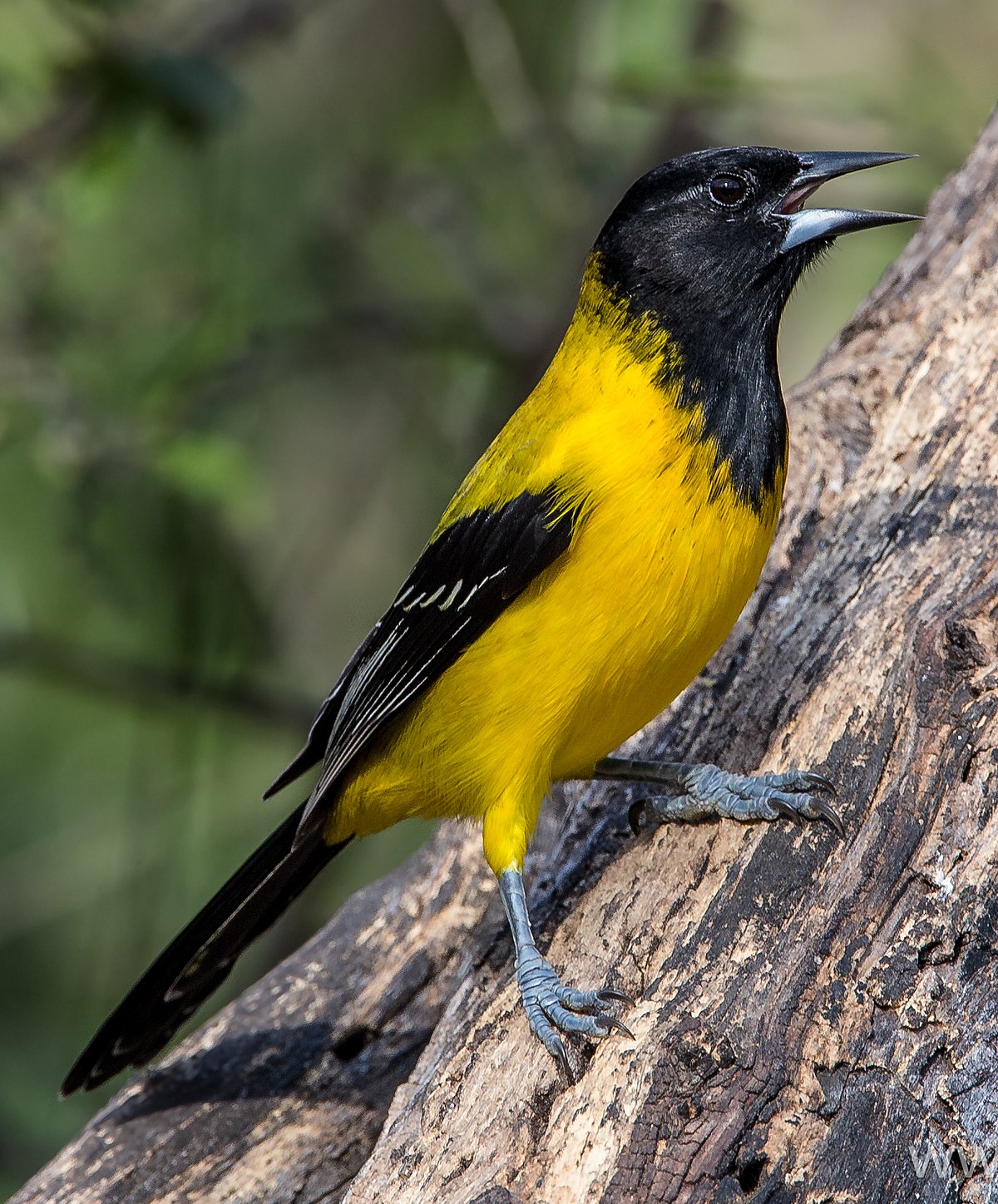
Wikipedia: Audubon's oriole Source: OTHER
1200px-Audubon%27s_Oriole_%2812626811374%29.jpg
![]() Audubon's oriole (Icterus graduacauda), formerly known as the black-headed oriole, is a New World passerine inhabiting the forests and thickets of southeastern Texas and the Mexican coast. It is the only species to have a black hood and yellow body. It is divided into four subspecies and two allopatric breeding ranges. The westernmost range extends from Nayarit south to southern Oaxaca, whereas the eastern range stretches from the lower Rio Grande valley to northern Querétaro. The most common in the western range are the subspecies I. g. dickeyae and I. g. nayaritensis; I. g. graduacauda and I. g. audubonii can be found in the eastern range. Like most Central American birds, it is not a migratory species and does not display significant sexual dimorphism. DNA analysis of the ND2 and cyt-b genes strongly suggests that I. graduacauda is most closely related to I. chrysater, the yellow-backed oriole.[2] It is a member of the genus Icterus and therefore should not be confused with the Old World orioles.
[more]
Audubon's oriole (Icterus graduacauda), formerly known as the black-headed oriole, is a New World passerine inhabiting the forests and thickets of southeastern Texas and the Mexican coast. It is the only species to have a black hood and yellow body. It is divided into four subspecies and two allopatric breeding ranges. The westernmost range extends from Nayarit south to southern Oaxaca, whereas the eastern range stretches from the lower Rio Grande valley to northern Querétaro. The most common in the western range are the subspecies I. g. dickeyae and I. g. nayaritensis; I. g. graduacauda and I. g. audubonii can be found in the eastern range. Like most Central American birds, it is not a migratory species and does not display significant sexual dimorphism. DNA analysis of the ND2 and cyt-b genes strongly suggests that I. graduacauda is most closely related to I. chrysater, the yellow-backed oriole.[2] It is a member of the genus Icterus and therefore should not be confused with the Old World orioles.
[more]
Profile Wikipedia eBird Audubon AllAboutBirds Xeno-Canto

Wikipedia: Shiny cowbird Source: OTHER
1200px-Shiny_cowbird_%28Molothrus_bonariensis%29_male.JPG
![]() The shiny cowbird (Molothrus bonariensis) is a passerine bird in the New World family Icteridae. It breeds in most of South America except for dense forests and areas of high altitude such as mountains.[1] Since 1900 the shiny cowbirds' range has shifted northward, and it was recorded in the Caribbean islands as well as the United States, where it is found breeding in southern Florida.[2] It is a bird associated with open habitats, including disturbed land from agriculture and deforestation.[1]
[more]
The shiny cowbird (Molothrus bonariensis) is a passerine bird in the New World family Icteridae. It breeds in most of South America except for dense forests and areas of high altitude such as mountains.[1] Since 1900 the shiny cowbirds' range has shifted northward, and it was recorded in the Caribbean islands as well as the United States, where it is found breeding in southern Florida.[2] It is a bird associated with open habitats, including disturbed land from agriculture and deforestation.[1]
[more]
Profile Wikipedia eBird Audubon AllAboutBirds Xeno-Canto
Brown-headed cowbird, Paper Mill Road. 2021-06-20 11.34.20 Maryland
First observed in Maryland on 2021-06-14.
![]() The brown-headed cowbird (Molothrus ater) is a small, obligate brood parasitic icterid native to temperate and subtropical North America. It is a permanent resident in the southern parts of its range; northern birds migrate to the southern United States and Mexico in winter, returning to their summer habitat around March or April.[2]
[more]
The brown-headed cowbird (Molothrus ater) is a small, obligate brood parasitic icterid native to temperate and subtropical North America. It is a permanent resident in the southern parts of its range; northern birds migrate to the southern United States and Mexico in winter, returning to their summer habitat around March or April.[2]
[more]
Profile Wikipedia eBird Audubon AllAboutBirds Xeno-Canto
The red-eyed bronzed cowbird at Chichen Itza. 2023-04-13 11.57.06 Yucatan
First observed in Yucatan on 2023-04-13.
![]()
The bronzed cowbird (once known as the red-eyed cowbird, Molothrus aeneus) is a small icterid.
[more]
Profile Wikipedia eBird Audubon AllAboutBirds Xeno-Canto

Wikipedia: Yellow-headed blackbird Source: OTHER
1200px-Male_Yellow-headed_Blackbird.jpg
![]() The yellow-headed blackbird (Xanthocephalus xanthocephalus) is a medium-sized blackbird, and the only member of the genus Xanthocephalus.
[more]
The yellow-headed blackbird (Xanthocephalus xanthocephalus) is a medium-sized blackbird, and the only member of the genus Xanthocephalus.
[more]

Wikipedia: Golden-winged warbler Source: OTHER
Golden-winged_Warbler_NGM-v31-p308-C.jpg
![]() The golden-winged warbler (Vermivora chrysoptera) is a New World warbler. It breeds in southeastern and south-central Canada and in the Appalachian Mountains in northeastern to north-central United States. The majority (~70%) of the global population breeds in Wisconsin, Minnesota, and Manitoba. Golden-winged warbler populations are slowly expanding northwards, but are generally declining across its range, most likely as a result of habitat loss and competition/interbreeding with the very closely related blue-winged warbler, Vermivora cyanoptera.
[more]
The golden-winged warbler (Vermivora chrysoptera) is a New World warbler. It breeds in southeastern and south-central Canada and in the Appalachian Mountains in northeastern to north-central United States. The majority (~70%) of the global population breeds in Wisconsin, Minnesota, and Manitoba. Golden-winged warbler populations are slowly expanding northwards, but are generally declining across its range, most likely as a result of habitat loss and competition/interbreeding with the very closely related blue-winged warbler, Vermivora cyanoptera.
[more]

Wikipedia: Blue-winged warbler Source: OTHER
Vermivora_cyanoptera_-North_Berwick%2C_Maine%2C_USA-8.jpg
![]() The blue-winged warbler (Vermivora cyanoptera) is a fairly common New World warbler, 11.5 cm (4.5 in) long and weighing 8.5 g (0.30 oz). It breeds in eastern North America in southern Ontario and the eastern United States. Its range is extending northwards, where it is replacing the very closely related golden-winged warbler, Vermivora chrysoptera.
[more]
The blue-winged warbler (Vermivora cyanoptera) is a fairly common New World warbler, 11.5 cm (4.5 in) long and weighing 8.5 g (0.30 oz). It breeds in eastern North America in southern Ontario and the eastern United States. Its range is extending northwards, where it is replacing the very closely related golden-winged warbler, Vermivora chrysoptera.
[more]
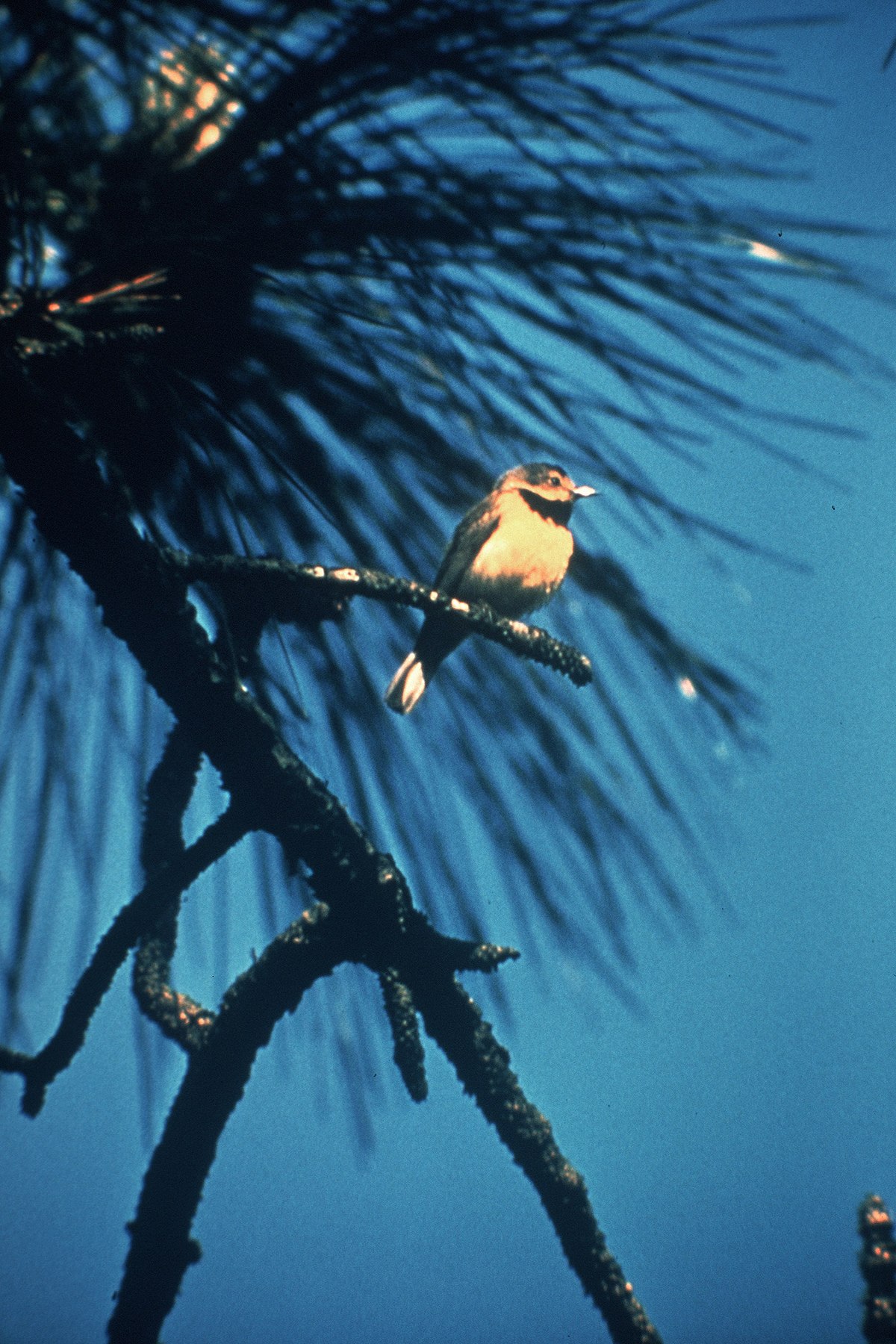
Wikipedia: Bachman's warbler Source: OTHER
1200px-Dendroica_bachmanii.jpg
![]() Bachman's warbler (Vermivora bachmanii) is a small passerine migratory bird that is critically endangered or extinct. This warbler was a migrant, breeding in swampy blackberry and cane thickets of the Southeastern and Midwestern United States and wintering in Cuba. There are some reports of the bird from the twenty-first century, but none are widely accepted. Some authorities accept a sighting in Louisiana, in August 1988 as confirmed,[2] but the last uncontroversial sightings date to the 1960s.
[more]
Bachman's warbler (Vermivora bachmanii) is a small passerine migratory bird that is critically endangered or extinct. This warbler was a migrant, breeding in swampy blackberry and cane thickets of the Southeastern and Midwestern United States and wintering in Cuba. There are some reports of the bird from the twenty-first century, but none are widely accepted. Some authorities accept a sighting in Louisiana, in August 1988 as confirmed,[2] but the last uncontroversial sightings date to the 1960s.
[more]

Wikipedia: Rufous-capped warbler Source: OTHER
Rufous-capped_Warbler_-_Panama_H8O8781_%2823053413302%29.jpg
![]() The rufous-capped warbler (Basileuterus rufifrons) is a New World warbler native from Mexico south to much of Central America, rarely occurring as far north as southeastern Arizona and south Texas.
[more]
The rufous-capped warbler (Basileuterus rufifrons) is a New World warbler native from Mexico south to much of Central America, rarely occurring as far north as southeastern Arizona and south Texas.
[more]
Profile Wikipedia eBird Audubon AllAboutBirds Xeno-Canto

Wikipedia: Swainson's warbler Source: OTHER
1200px-Limnothlypis_swainsonii_4702971_%28cropped%29.jpg
![]() Swainson's warbler (Limnothlypis swainsonii) is a small species of New World warbler. It is monotypic, the only member of the genus Limnothlypis. Swainson's warbler was named after William Swainson, an English ornithologist.
[more]
Swainson's warbler (Limnothlypis swainsonii) is a small species of New World warbler. It is monotypic, the only member of the genus Limnothlypis. Swainson's warbler was named after William Swainson, an English ornithologist.
[more]

Wikipedia: Kentucky warbler Source: OTHER
Oporornis_formosus_FWS.jpg
![]() The Kentucky warbler (Geothlypis formosa) is a small species of New World warbler. It is a sluggish and heavy warbler with a short tail, preferring to spend most of its time on or near the ground, except when singing.
[more]
The Kentucky warbler (Geothlypis formosa) is a small species of New World warbler. It is a sluggish and heavy warbler with a short tail, preferring to spend most of its time on or near the ground, except when singing.
[more]
MerlinBirdID suggests common yellowthroat - Kohunlich. 2023-04-03 10.51.28 Yucatan
First observed in Yucatan on 2023-04-03.
![]() The common yellowthroat (Geothlypis trichas) is a New World warbler. It is an abundant breeder in North America, ranging from southern Canada to central Mexico. The genus name Geothlypis is from Ancient Greek geo, "ground", and thlupis, an unidentified small bird; thlypis is often used in the scientific names of New World warblers. The specific trichas is also from Greek; trikhas is a kind of thrush, the word being derived from trikhos, "hair".[2]
[more]
The common yellowthroat (Geothlypis trichas) is a New World warbler. It is an abundant breeder in North America, ranging from southern Canada to central Mexico. The genus name Geothlypis is from Ancient Greek geo, "ground", and thlupis, an unidentified small bird; thlypis is often used in the scientific names of New World warblers. The specific trichas is also from Greek; trikhas is a kind of thrush, the word being derived from trikhos, "hair".[2]
[more]

Wikipedia: Mourning warbler Source: OTHER
Oporornis_philadelphiaAAP100CB1.jpg
![]() The mourning warbler (Geothlypis philadelphia) is a small songbird of the New World warbler family. Mourning warblers are native to eastern and central North America as well as some countries in Central America.[2] They are neotropical migrants and tend to be found in dense second growth forests.[3] They are under the Wood-warbler category, which consists of arboreal and terrestrial colorful passerines. Wood warblers are in the order Passeriformes, which are perching birds including more than half of all bird species, and the family Parulidae which also includes the Common Yellowthroat, Black and White Warbler, Nashville Warbler, ovenbird, and American Redstart. They are very similar to the MacGillivray's Warbler in appearance, especially in females and immature birds, but their breeding range does not overlap into the west.[4]
[more]
The mourning warbler (Geothlypis philadelphia) is a small songbird of the New World warbler family. Mourning warblers are native to eastern and central North America as well as some countries in Central America.[2] They are neotropical migrants and tend to be found in dense second growth forests.[3] They are under the Wood-warbler category, which consists of arboreal and terrestrial colorful passerines. Wood warblers are in the order Passeriformes, which are perching birds including more than half of all bird species, and the family Parulidae which also includes the Common Yellowthroat, Black and White Warbler, Nashville Warbler, ovenbird, and American Redstart. They are very similar to the MacGillivray's Warbler in appearance, especially in females and immature birds, but their breeding range does not overlap into the west.[4]
[more]
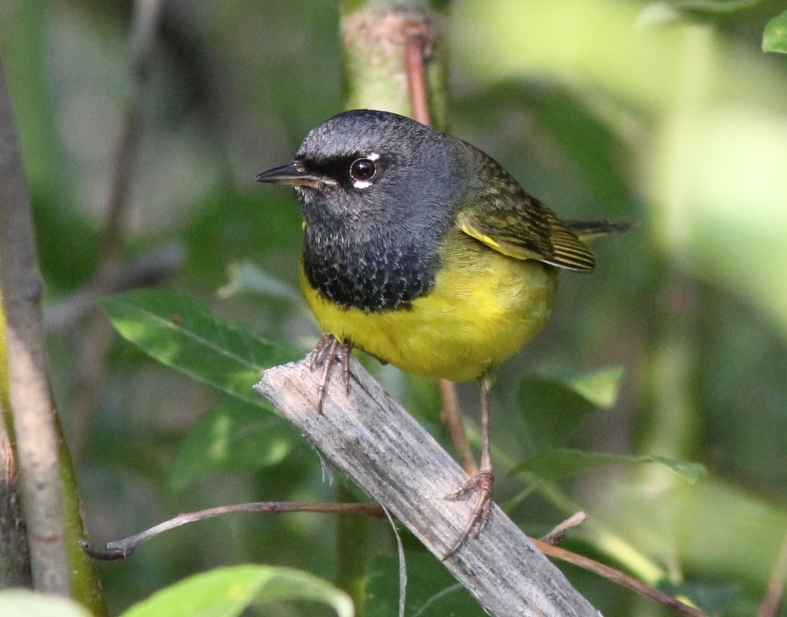
Wikipedia: Macgillivray's warbler Source: OTHER
Geothlypis_tolmiei_Hungry_Horse_MT_1%2C_crop.jpg
![]() MacGillivray's warbler (Geothlypis tolmiei) is a species of New World warbler. These birds are sluggish and heavy warblers, preferring to spend most of their time on, or near the ground, except when singing.
[more]
MacGillivray's warbler (Geothlypis tolmiei) is a species of New World warbler. These birds are sluggish and heavy warblers, preferring to spend most of their time on, or near the ground, except when singing.
[more]
Profile Wikipedia eBird Audubon AllAboutBirds Xeno-Canto

Wikipedia: Yellow-breasted chat Source: OTHER
Yellow-Breasted-Chat-Oregon.jpg
![]() The yellow-breasted chat (Icteria virens) is a large songbird found in North America, and is the only member of the family Icteriidae. It was once a member of the New World warbler family, but in 2017, the American Ornithological Society moved it to its own family. Its placement is not definitely resolved.
[more]
The yellow-breasted chat (Icteria virens) is a large songbird found in North America, and is the only member of the family Icteriidae. It was once a member of the New World warbler family, but in 2017, the American Ornithological Society moved it to its own family. Its placement is not definitely resolved.
[more]

Wikipedia: Connecticut warbler Source: OTHER
1200px-Oporornis_agilis_Youghiogheny_River_MD.jpg
![]() The Connecticut warbler (Oporornis agilis) is a small songbird of the New World warbler family.
[more]
The Connecticut warbler (Oporornis agilis) is a small songbird of the New World warbler family.
[more]
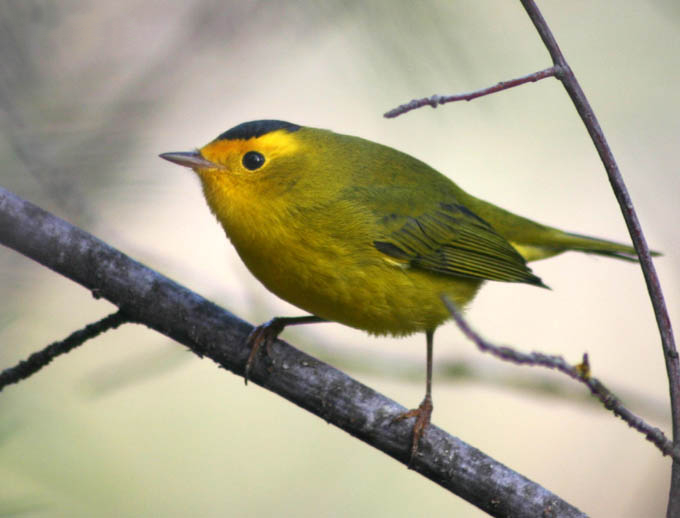
Wikipedia: Wilson's warbler Source: OTHER
Wilsonia_pusilla.jpg
![]() Wilson's warbler (Cardellina pusilla) is a small New World warbler. It is greenish above and yellow below, with rounded wings and a long, slim tail. The male has a black crown patch; depending on the subspecies, that mark is reduced or absent in the female. It breeds across Canada and south through the western United States, and winters from Mexico south through much of Central America. It is a very rare vagrant to western Europe.
[more]
Wilson's warbler (Cardellina pusilla) is a small New World warbler. It is greenish above and yellow below, with rounded wings and a long, slim tail. The male has a black crown patch; depending on the subspecies, that mark is reduced or absent in the female. It breeds across Canada and south through the western United States, and winters from Mexico south through much of Central America. It is a very rare vagrant to western Europe.
[more]

Wikipedia: Canada warbler Source: OTHER
1200px-8G7D5475-Canada.jpg
![]() The Canada warbler (Cardellina canadensis) is a small boreal songbird of the New World warbler family (Parulidae). It summers in Canada and northeastern United States and winters in northern South America.
[more]
The Canada warbler (Cardellina canadensis) is a small boreal songbird of the New World warbler family (Parulidae). It summers in Canada and northeastern United States and winters in northern South America.
[more]
Profile Wikipedia eBird Audubon AllAboutBirds Xeno-Canto

Wikipedia: Red-faced warbler Source: OTHER
1200px-Cardellina_rubrifrons.jpg
![]() The red-faced warbler (Cardellina rubrifrons) is a species of New World warbler.
[more]
The red-faced warbler (Cardellina rubrifrons) is a species of New World warbler.
[more]

Wikipedia: Worm-eating warbler Source: OTHER
Worm-eating_Warbler.jpg
![]() The worm-eating warbler (Helmitheros vermivorum) is a small New World warbler that breeds in the Eastern United States and migrates to southern Mexico, the Caribbean, and Central America for the winter.
[more]
The worm-eating warbler (Helmitheros vermivorum) is a small New World warbler that breeds in the Eastern United States and migrates to southern Mexico, the Caribbean, and Central America for the winter.
[more]
Black and white warbler, Ecotucan, Bacalar. 2023-03-30 17.30.48 Yucatan
First observed in Yucatan on 2023-03-27.
![]() The black-and-white warbler (Mniotilta varia) is a species of New World warbler, and the only member of its genus, Mniotilta.[2]
It breeds in northern and eastern North America and winters in Florida, Central America, and the West Indies down to Peru. This species is a very rare vagrant to western Europe.[2]
[more]
The black-and-white warbler (Mniotilta varia) is a species of New World warbler, and the only member of its genus, Mniotilta.[2]
It breeds in northern and eastern North America and winters in Florida, Central America, and the West Indies down to Peru. This species is a very rare vagrant to western Europe.[2]
[more]
Profile Wikipedia eBird Audubon AllAboutBirds Xeno-Canto

Wikipedia: Painted redstart Source: OTHER
1200px-Painted_Redstart.jpg
![]() The painted whitestart or painted redstart (Myioborus pictus), is a species of New World warbler.
[more]
The painted whitestart or painted redstart (Myioborus pictus), is a species of New World warbler.
[more]
Profile Wikipedia eBird Audubon AllAboutBirds Xeno-Canto
MerlinBirdID suggest a prothonotary warbler, at botanical garden, Puerto Morelos. 2023-03-27 11.50.22 Yucatan
First observed in Yucatan on 2023-03-27.
![]() The prothonotary warbler (Protonotaria citrea) is a small songbird of the New World warbler family. It is the only member of the genus Protonotaria.[2]
[more]
The prothonotary warbler (Protonotaria citrea) is a small songbird of the New World warbler family. It is the only member of the genus Protonotaria.[2]
[more]

Wikipedia: Ovenbird Source: OTHER
1200px-Ovenbird_RWD2011b.jpg
![]() The ovenbird (Seiurus aurocapilla) is a small songbird of the New World warbler family (Parulidae). This migratory bird breeds in eastern North America and winters in Central America, many Caribbean islands, Florida and northern Venezuela.[2][3]
[more]
The ovenbird (Seiurus aurocapilla) is a small songbird of the New World warbler family (Parulidae). This migratory bird breeds in eastern North America and winters in Central America, many Caribbean islands, Florida and northern Venezuela.[2][3]
[more]

Wikipedia: Black-throated blue warbler Source: OTHER
1200px-Black-throated_Blue_Warbler%2C_Parc_%C3%89coforestier_de_Johnville%2C_Quebec%2C_Canada.jpg
![]() The black-throated blue warbler (Setophaga caerulescens) is a small passerine bird of the New World warbler family. Its breeding ranges are located in the interior of deciduous and mixed coniferous forests in eastern North America. Over the cooler months, it migrates to islands in the Caribbean and Central America. It is very rarely found in western Europe, where it is considered to be a non-indigenous species. The black-throated blue warbler is sexually dimorphic; the adult male has a black face and cheeks, deep blue upperparts and white underparts, while the adult female is olive-brown above and light yellow below.
[more]
The black-throated blue warbler (Setophaga caerulescens) is a small passerine bird of the New World warbler family. Its breeding ranges are located in the interior of deciduous and mixed coniferous forests in eastern North America. Over the cooler months, it migrates to islands in the Caribbean and Central America. It is very rarely found in western Europe, where it is considered to be a non-indigenous species. The black-throated blue warbler is sexually dimorphic; the adult male has a black face and cheeks, deep blue upperparts and white underparts, while the adult female is olive-brown above and light yellow below.
[more]
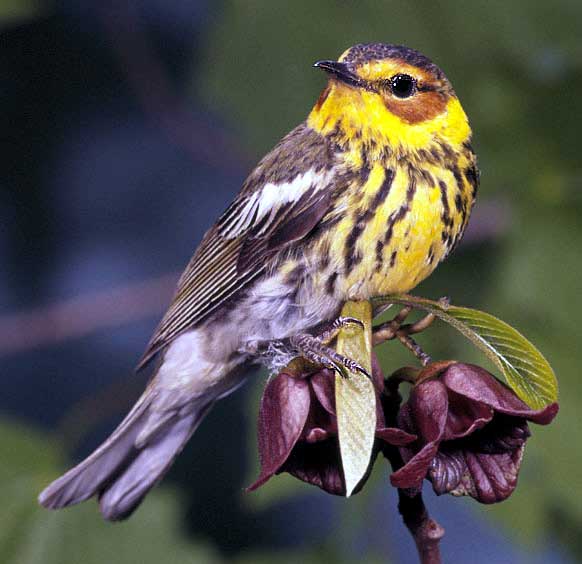
Wikipedia: Cape may warbler Source: OTHER
Dendroica_tigrina_FWS.jpg
![]() The Cape May warbler (Setophaga tigrina) is a species of New World warbler. It breeds in northern North America. Its breeding range spans all but the westernmost parts of southern Canada, the Great Lakes region, and New England. It is migratory, wintering in the West Indies. This species is a very rare vagrant to western Europe, with two records in Britain as of October 2013. The English name refers to Cape May, New Jersey, where George Ord collected the specimen later described by Alexander Wilson. This species was not recorded again in Cape May for another 100 years, although it is now known as an uncommon migrant there.[2]
[more]
The Cape May warbler (Setophaga tigrina) is a species of New World warbler. It breeds in northern North America. Its breeding range spans all but the westernmost parts of southern Canada, the Great Lakes region, and New England. It is migratory, wintering in the West Indies. This species is a very rare vagrant to western Europe, with two records in Britain as of October 2013. The English name refers to Cape May, New Jersey, where George Ord collected the specimen later described by Alexander Wilson. This species was not recorded again in Cape May for another 100 years, although it is now known as an uncommon migrant there.[2]
[more]
Palm warbler by Windham Hill Inn, Vermont. 2023-10-03 10.42.20 New England
First observed in New England on 2023-10-03.
![]() The palm warbler (Setophaga palmarum) is a small songbird of the New World warbler family.
[more]
The palm warbler (Setophaga palmarum) is a small songbird of the New World warbler family.
[more]

Wikipedia: Cerulean warbler Source: OTHER
Dendroica-cerulea-002.jpg
![]() The cerulean warbler (Setophaga cerulea) is a small songbird of the New World warbler family.
Adult males have pale cerulean blue and white upperparts with a black necklace across the breast and black streaks on the back and flanks. Females and immature birds have greyer or greenish upperparts, a pale stripe over the eye, and no streaking on the back and no neck. All of these birds have wing bars and a thin pointed bill.
They are found in deciduous forests of eastern North America during the breeding season and then migrate to forested mountain areas in South America.
The species is considered threatened with an IUCN status of near threatened, indicating it does not face any imminent threat of extinction in the wild.
[more]
The cerulean warbler (Setophaga cerulea) is a small songbird of the New World warbler family.
Adult males have pale cerulean blue and white upperparts with a black necklace across the breast and black streaks on the back and flanks. Females and immature birds have greyer or greenish upperparts, a pale stripe over the eye, and no streaking on the back and no neck. All of these birds have wing bars and a thin pointed bill.
They are found in deciduous forests of eastern North America during the breeding season and then migrate to forested mountain areas in South America.
The species is considered threatened with an IUCN status of near threatened, indicating it does not face any imminent threat of extinction in the wild.
[more]

Wikipedia: Chestnut-sided warbler Source: OTHER
1200px-Dendroica-pensylvanica-003.jpg
![]() The chestnut-sided warbler (Setophaga pensylvanica) is a New World warbler. They breed in eastern North America and in southern Canada westwards to the Canadian Prairies. They also breed in the Great Lakes region and in the eastern United States.
[more]
The chestnut-sided warbler (Setophaga pensylvanica) is a New World warbler. They breed in eastern North America and in southern Canada westwards to the Canadian Prairies. They also breed in the Great Lakes region and in the eastern United States.
[more]

Wikipedia: Blackburnian warbler Source: OTHER
1200px-Dendroica-fusca-001.jpg
![]() The Blackburnian warbler (Setophaga fusca) is a small New World warbler. They breed in eastern North America, from southern Canada, westwards to the southern Canadian Prairies, the Great Lakes region and New England, to North Carolina.
[more]
The Blackburnian warbler (Setophaga fusca) is a small New World warbler. They breed in eastern North America, from southern Canada, westwards to the southern Canadian Prairies, the Great Lakes region and New England, to North Carolina.
[more]
Yellow warbler, male of one of the mangrove subspecies, feeding off coconuts used just to sell the milk as a refreshing drink. 2023-04-21 07.08.16 Yucatan
First observed in Yucatan on 2023-04-21.
![]() The yellow warbler (Setophaga petechia) is a New World warbler species. Yellow warblers are the most widespread species in the diverse genus Setophaga. The species can be found throughout most of North America and migrates to wintering grounds from southern California to the Amazon region, Bolivia, and Peru.
[more]
The yellow warbler (Setophaga petechia) is a New World warbler species. Yellow warblers are the most widespread species in the diverse genus Setophaga. The species can be found throughout most of North America and migrates to wintering grounds from southern California to the Amazon region, Bolivia, and Peru.
[more]

Wikipedia: Blackpoll warbler Source: OTHER
1200px-Dendroica_striata_MN.jpg
![]() The blackpoll warbler (Setophaga striata) is a New World warbler. Breeding males are mostly black and white. They have a prominent black cap, white cheeks and white wing bars. The blackpoll breeds in forests of northern North America, from Alaska throughout most of Canada, to the mountains of New York and New England. They are a common migrant through much of North America. In fall, they fly south to the Greater Antilles and the northeastern coasts of South America in a non-stop long-distance migration over open water, averaging 2500 km, one of the longest distance non-stop overwater flights ever recorded for a migratory songbird. Rare vagrants to western Europe, they are one of the more frequent transatlantic passerine wanderers.
[more]
The blackpoll warbler (Setophaga striata) is a New World warbler. Breeding males are mostly black and white. They have a prominent black cap, white cheeks and white wing bars. The blackpoll breeds in forests of northern North America, from Alaska throughout most of Canada, to the mountains of New York and New England. They are a common migrant through much of North America. In fall, they fly south to the Greater Antilles and the northeastern coasts of South America in a non-stop long-distance migration over open water, averaging 2500 km, one of the longest distance non-stop overwater flights ever recorded for a migratory songbird. Rare vagrants to western Europe, they are one of the more frequent transatlantic passerine wanderers.
[more]
Profile Wikipedia eBird Audubon AllAboutBirds Xeno-Canto
Possibly a female American redstart at Maya site Becan. 2023-04-03 12.11.18 Yucatan
First observed in Cockeysville on 2022-05-02.
![]() The American redstart (Setophaga ruticilla) is a New World warbler. It is unrelated to the Old World (common) redstart.
[more]
The American redstart (Setophaga ruticilla) is a New World warbler. It is unrelated to the Old World (common) redstart.
[more]
Call:
Automatically generated from Xeno-Canto recording
♫ Source: BirdNet
20220502_085740 birdnet - American Redstart - 2022-05-02 08:57:40 - American Redstart - Cockeysville.mp3
2022-05-02 08.57.40 Cockeysville (song?)

Wikipedia: Hooded warbler Source: OTHER
Wilsonia_citrina_%28Belize%29.jpg
![]() The hooded warbler (Setophaga citrina) is a New World warbler. It breeds in eastern North America and across the eastern United States and into southernmost Canada (Ontario). It is migratory, wintering in Central America and the West Indies. Hooded warblers are very rare vagrants to western Europe.
[more]
The hooded warbler (Setophaga citrina) is a New World warbler. It breeds in eastern North America and across the eastern United States and into southernmost Canada (Ontario). It is migratory, wintering in Central America and the West Indies. Hooded warblers are very rare vagrants to western Europe.
[more]
Call:
Automatically generated from Xeno-Canto recording
♫ Source: BirdNet
20210613_064404 birdnet 1638 - No confident detection, wild guess hooded warbler or yellow backed warbler - No confident detection - Cockeysville.mp3
2021-06-13 06.44.04 Cockeysville (song?)

Wikipedia: Northern parula Source: OTHER
Northernparalua20.jpg
First observed in Cockeysville on 2022-05-01.
![]() The northern parula (Setophaga americana) is a small New World warbler. It breeds in eastern North America from southern Canada to Florida.[2]
[more]
The northern parula (Setophaga americana) is a small New World warbler. It breeds in eastern North America from southern Canada to Florida.[2]
[more]
Call:
Automatically generated from Xeno-Canto recording
♫ Source: BirdNet
20220501_090658 birdnet - Northern Parula - 2022-05-01 09:06:58 - Northern Parula - Cockeysville.mp3
2022-05-01 09.06.58 Cockeysville (song?)

Wikipedia: Magnolia warbler Source: OTHER
Dendroica_magnolia_MN.jpg
![]() The magnolia warbler (Setophaga magnolia) is a member of the wood warbler family Parulidae.
[more]
The magnolia warbler (Setophaga magnolia) is a member of the wood warbler family Parulidae.
[more]

Wikipedia: Pine warbler Source: OTHER
1200px-Dendroica_pinus.jpg
![]() The pine warbler (Setophaga pinus) is a small songbird of the New World warbler family.
[more]
The pine warbler (Setophaga pinus) is a small songbird of the New World warbler family.
[more]

Wikipedia: Bay-breasted warbler Source: OTHER
1200px-Dendroica-castanea-001.jpg
![]() The Bay-breasted Warbler (Setophaga castanea) is a small species of songbird in the New World warbler family, Parulidae. It is one of thirty-four species in the diverse genus Setophaga.[2] Like all songbirds, or passerines, the species is classified in the order Passeriformes.
[more]
The Bay-breasted Warbler (Setophaga castanea) is a small species of songbird in the New World warbler family, Parulidae. It is one of thirty-four species in the diverse genus Setophaga.[2] Like all songbirds, or passerines, the species is classified in the order Passeriformes.
[more]
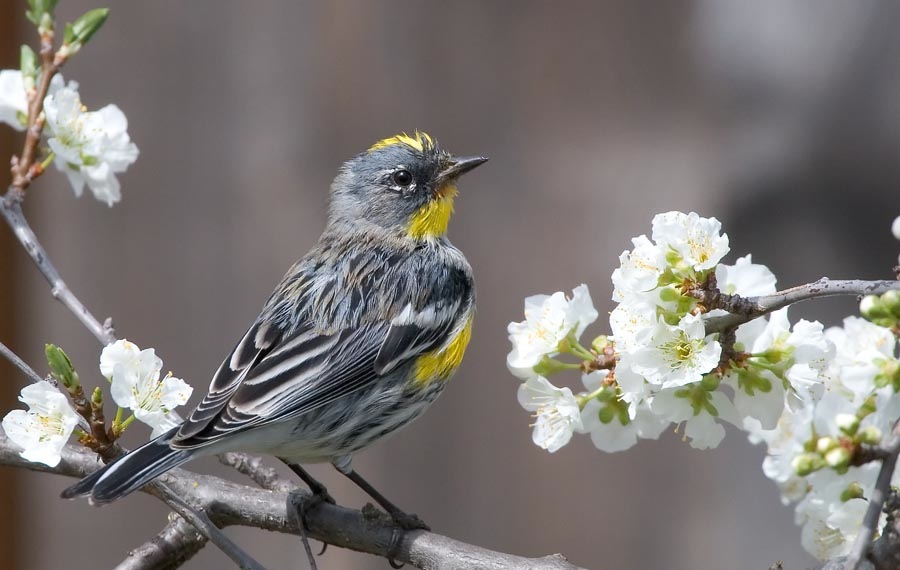
Wikipedia: Yellow-rumped warbler Source: OTHER
Audubon%27s_Warbler_Setophaga_auduboni.jpg
![]() The yellow-rumped warbler (Setophaga coronata) is a regular North American bird species that can be commonly observed all across the continent. Its extensive distribution range connects both the Pacific and Atlantic coasts of the U.S. as well as Canada and Central America, with the population concentrating in the continent's northern parts during the breeding season and migrating southwards to southern North and Central America in Winter. The species generally prefers coniferous forests or mixed coniferous-deciduous forests as its breeding habitat, while during the winter it can be found inhabiting more open areas such as shrublands that offer food resources. The diet of the yellow-rumped warbler is based primarily on insects, though the species does eat fruits such as juniper berries as well, especially in winter.
[more]
The yellow-rumped warbler (Setophaga coronata) is a regular North American bird species that can be commonly observed all across the continent. Its extensive distribution range connects both the Pacific and Atlantic coasts of the U.S. as well as Canada and Central America, with the population concentrating in the continent's northern parts during the breeding season and migrating southwards to southern North and Central America in Winter. The species generally prefers coniferous forests or mixed coniferous-deciduous forests as its breeding habitat, while during the winter it can be found inhabiting more open areas such as shrublands that offer food resources. The diet of the yellow-rumped warbler is based primarily on insects, though the species does eat fruits such as juniper berries as well, especially in winter.
[more]

Wikipedia: Hermit warbler Source: OTHER
1200px-Hermit_Warbler_%28Dendroica_occidentalis%29.jpg
![]() The hermit warbler (Setophaga occidentalis) is a small perching bird. It is a species of New World warbler.
[more]
The hermit warbler (Setophaga occidentalis) is a small perching bird. It is a species of New World warbler.
[more]
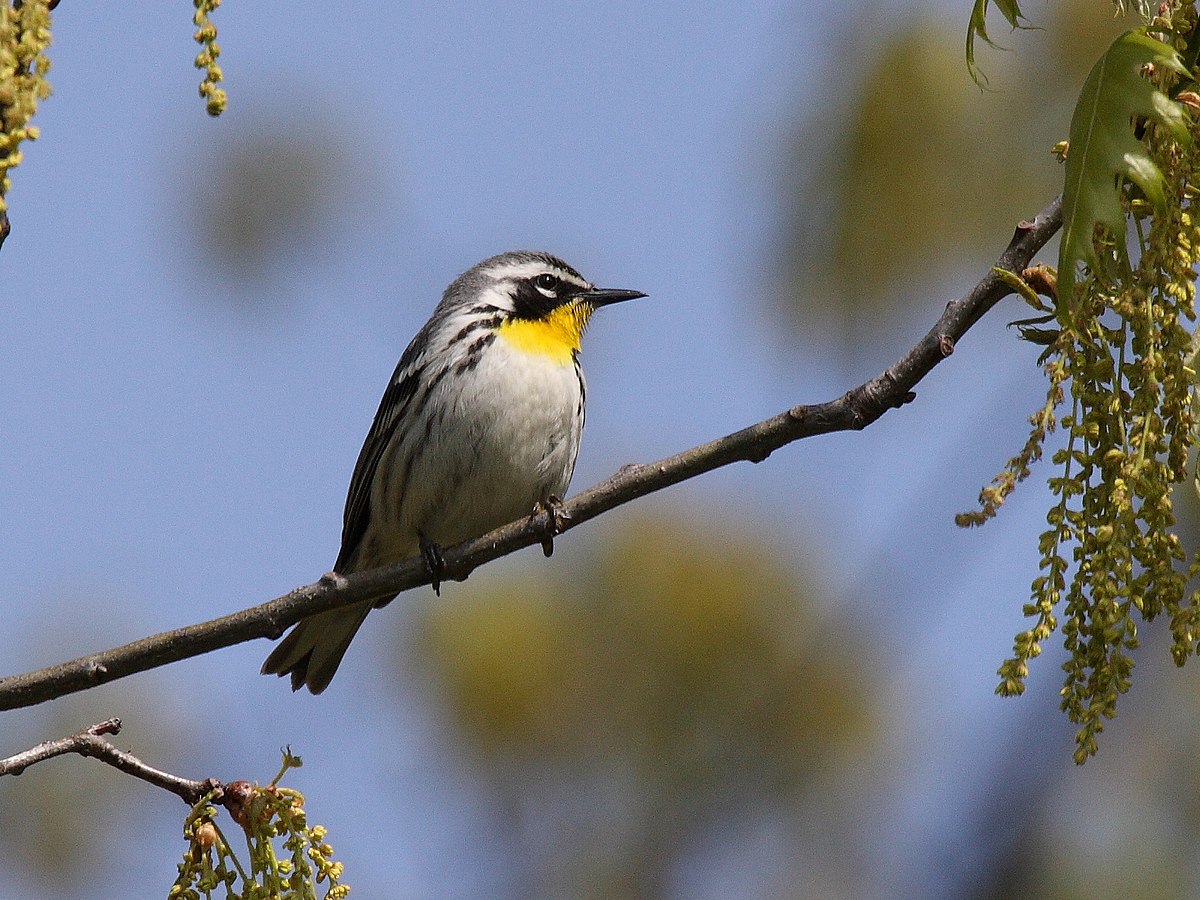
Wikipedia: Yellow-throated warbler Source: OTHER
1200px-Yellow-throated_Warbler_2.jpg
![]() The yellow-throated warbler (Setophaga dominica) is a small migratory songbird species breeding in temperate North America. It belongs to the New World warbler family (Parulidae).[2]
[more]
The yellow-throated warbler (Setophaga dominica) is a small migratory songbird species breeding in temperate North America. It belongs to the New World warbler family (Parulidae).[2]
[more]

Wikipedia: Prairie warbler Source: OTHER
1200px-Prairie_warbler_%28Setophaga_discolor_paludicola%29_male_J.jpg
![]() The prairie warbler (Setophaga discolor) is a small songbird of the New World warbler family.
[more]
The prairie warbler (Setophaga discolor) is a small songbird of the New World warbler family.
[more]

Wikipedia: Black-throated green warbler Source: OTHER
1200px-BlackthroatedGreenWarbler08.jpg
![]() The black-throated green warbler (Setophaga virens) is a small songbird of the New World warbler family.
[more]
The black-throated green warbler (Setophaga virens) is a small songbird of the New World warbler family.
[more]
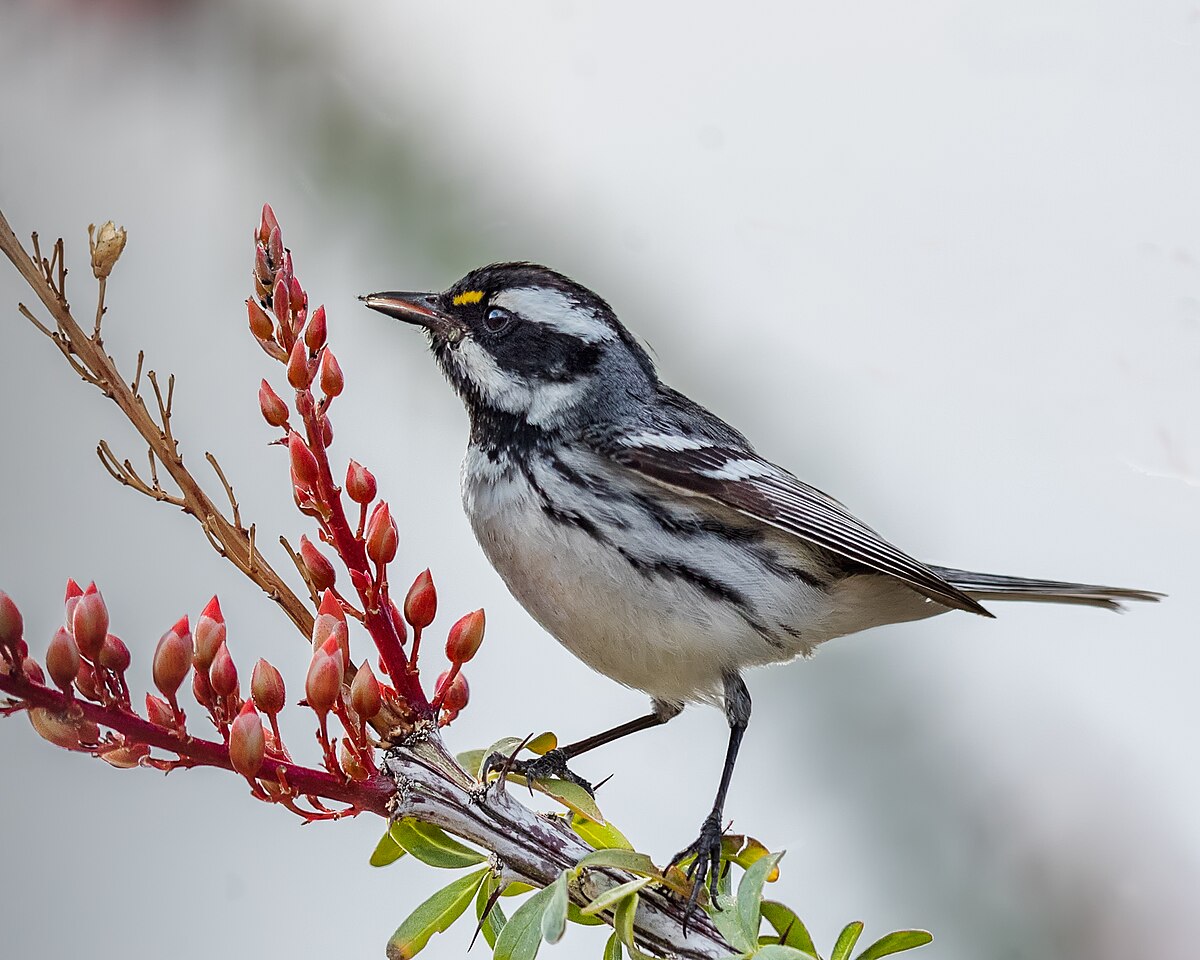
Wikipedia: Black-throated grey warbler Source: OTHER
1200px-Black-throated_Gray_Warbler%2C_Anza-Borrego_Desert_State_Park%2C_California.jpg
![]() The black-throated gray warbler or black-throated grey warbler (Setophaga nigrescens) is a passerine bird of the New World warbler family Parulidae. It is 13 cm (5.1 in) long and has gray and white plumage with black markings. The male has the bold black throat of its name, and black stripes on its head, as well as black streaks on its flanks; the female is a paler version of the male, with a white throat and less distinct black markings on the flanks and wings. It breeds in western North America from British Columbia to New Mexico, and winters in Mexico and the southwestern United States. The habitats it prefers are coniferous and mixed forests and scrubland, especially those with pinyon pines, junipers, sagebrush, and oaks. Its nest is an open cup of plant fibers lined with feathers, built a few metres from the ground in the branches of a tree or shrub. Three to five eggs are laid, and young are fed by both parents. Common in its breeding range, it does not seem to be seriously threatened by human activities, unlike many migratory warblers.
[more]
The black-throated gray warbler or black-throated grey warbler (Setophaga nigrescens) is a passerine bird of the New World warbler family Parulidae. It is 13 cm (5.1 in) long and has gray and white plumage with black markings. The male has the bold black throat of its name, and black stripes on its head, as well as black streaks on its flanks; the female is a paler version of the male, with a white throat and less distinct black markings on the flanks and wings. It breeds in western North America from British Columbia to New Mexico, and winters in Mexico and the southwestern United States. The habitats it prefers are coniferous and mixed forests and scrubland, especially those with pinyon pines, junipers, sagebrush, and oaks. Its nest is an open cup of plant fibers lined with feathers, built a few metres from the ground in the branches of a tree or shrub. Three to five eggs are laid, and young are fed by both parents. Common in its breeding range, it does not seem to be seriously threatened by human activities, unlike many migratory warblers.
[more]

Wikipedia: Townsend's warbler Source: OTHER
1200px-Dendroica_townsendi_284.jpg
![]() Townsend's warbler (Setophaga townsendi) is a small songbird of the New World warbler family.
[more]
Townsend's warbler (Setophaga townsendi) is a small songbird of the New World warbler family.
[more]

Wikipedia: Golden-cheeked warbler Source: OTHER
1200px-Dendroica_chrysoparia1.jpg
![]() The golden-cheeked warbler (Setophaga chrysoparia [formerly Dendroica chrysoparia]), also known as the gold finch of Texas, is an endangered species of bird that breeds in Central Texas, from Palo Pinto County southwestward along the eastern and southern edge of the Edwards Plateau to Kinney County. The golden-cheeked warbler is the only bird species with a breeding range confined to Texas.
[more]
The golden-cheeked warbler (Setophaga chrysoparia [formerly Dendroica chrysoparia]), also known as the gold finch of Texas, is an endangered species of bird that breeds in Central Texas, from Palo Pinto County southwestward along the eastern and southern edge of the Edwards Plateau to Kinney County. The golden-cheeked warbler is the only bird species with a breeding range confined to Texas.
[more]

Wikipedia: Grace's warbler Source: OTHER
1200px-Grace%27s_Warbler.jpg
![]() Grace's warbler (Setophaga graciae) is a small New World warbler that specializes in pine woods.
[more]
Grace's warbler (Setophaga graciae) is a small New World warbler that specializes in pine woods.
[more]

Wikipedia: Tropical parula Source: OTHER
Parula_pitiayumi_-Piraju%2C_Sao_Paulo%2C_Brazil-8.jpg
![]() The tropical parula (Setophaga pitiayumi) is a small New World warbler. It breeds from southernmost Texas and northwest Mexico (Sonora) south through Central America to northern Argentina, including Trinidad and Tobago. This widespread and common species is not considered threatened by the IUCN.[1]
[more]
The tropical parula (Setophaga pitiayumi) is a small New World warbler. It breeds from southernmost Texas and northwest Mexico (Sonora) south through Central America to northern Argentina, including Trinidad and Tobago. This widespread and common species is not considered threatened by the IUCN.[1]
[more]

Wikipedia: Kirtland's warbler Source: OTHER
Dendroica_kirtlandii_-Michigan%2C_USA_-male-8_%285%29.jpg
![]() Kirtland's warbler (Setophaga kirtlandii), which is recorded to have been known by local folk in Michigan by the common name jack pine bird,[2][3] and is also known as the jack pine warbler, is a small songbird of the New World warbler family (Parulidae), named after Jared Potter Kirtland, an Ohio doctor and amateur naturalist. Nearly extinct just 50 years ago, it is well on its way to recovery. It requires large areas, greater than 160 acres (65 hectares), of dense young jack pine for its breeding habitat. This habitat was historically created by wildfire, but today is created through the harvest of mature jack pine, and planting of jack pine seedlings.
[more]
Kirtland's warbler (Setophaga kirtlandii), which is recorded to have been known by local folk in Michigan by the common name jack pine bird,[2][3] and is also known as the jack pine warbler, is a small songbird of the New World warbler family (Parulidae), named after Jared Potter Kirtland, an Ohio doctor and amateur naturalist. Nearly extinct just 50 years ago, it is well on its way to recovery. It requires large areas, greater than 160 acres (65 hectares), of dense young jack pine for its breeding habitat. This habitat was historically created by wildfire, but today is created through the harvest of mature jack pine, and planting of jack pine seedlings.
[more]

Wikipedia: Northern waterthrush Source: OTHER
Northern_Waterthrush%2C_Parkesia_noveboracensis.jpg
![]() The northern waterthrush (Parkesia noveboracensis[2]) is one of the larger New World warblers and one of the Nearctic-Neotropical migratory songbirds.[3] It breeds in the northern part of North America in Canada and the northern United States including Alaska. This bird is migratory, wintering in Central America, the West Indies and Florida, as well as in Venezuela, Colombia, and Ecuador. It is a very rare vagrant to other South American countries and to western Europe.
[more]
The northern waterthrush (Parkesia noveboracensis[2]) is one of the larger New World warblers and one of the Nearctic-Neotropical migratory songbirds.[3] It breeds in the northern part of North America in Canada and the northern United States including Alaska. This bird is migratory, wintering in Central America, the West Indies and Florida, as well as in Venezuela, Colombia, and Ecuador. It is a very rare vagrant to other South American countries and to western Europe.
[more]

Wikipedia: Tennessee warbler Source: OTHER
1200px-Tennessee_Warbler_2.jpg
![]() The Tennessee warbler (Leiothlypis peregrina) is a New World warbler that breeds in eastern North America and winters in southern Central America, the Caribbean, and northern South America. The specific name peregrina is from Latin peregrinus "wanderer".[2]
[more]
The Tennessee warbler (Leiothlypis peregrina) is a New World warbler that breeds in eastern North America and winters in southern Central America, the Caribbean, and northern South America. The specific name peregrina is from Latin peregrinus "wanderer".[2]
[more]
MerlinBirdID suggests orange-crowned warbler, which has many different color variations. 2023-04-20 11.26.48 Yucatan
First observed in Yucatan on 2023-04-20.
![]() The orange-crowned warbler (Leiothlypis celata) is a small songbird of the New World warbler family.
[more]
The orange-crowned warbler (Leiothlypis celata) is a small songbird of the New World warbler family.
[more]

Wikipedia: Nashville warbler Source: OTHER
1200px-Vermivora_ruficapilla_Winema_National_Forest_%28cropped%29.jpg
![]() The Nashville warbler (Leiothlypis ruficapilla) is a small songbird in the New World warbler family, found in North and Central America. It breeds in parts of the northern and western United States and southern Canada, and migrates to winter in southern California and Texas, Mexico, and the north of Central America. It has a gray head and a green back, and its underparts are yellow and white.
[more]
The Nashville warbler (Leiothlypis ruficapilla) is a small songbird in the New World warbler family, found in North and Central America. It breeds in parts of the northern and western United States and southern Canada, and migrates to winter in southern California and Texas, Mexico, and the north of Central America. It has a gray head and a green back, and its underparts are yellow and white.
[more]
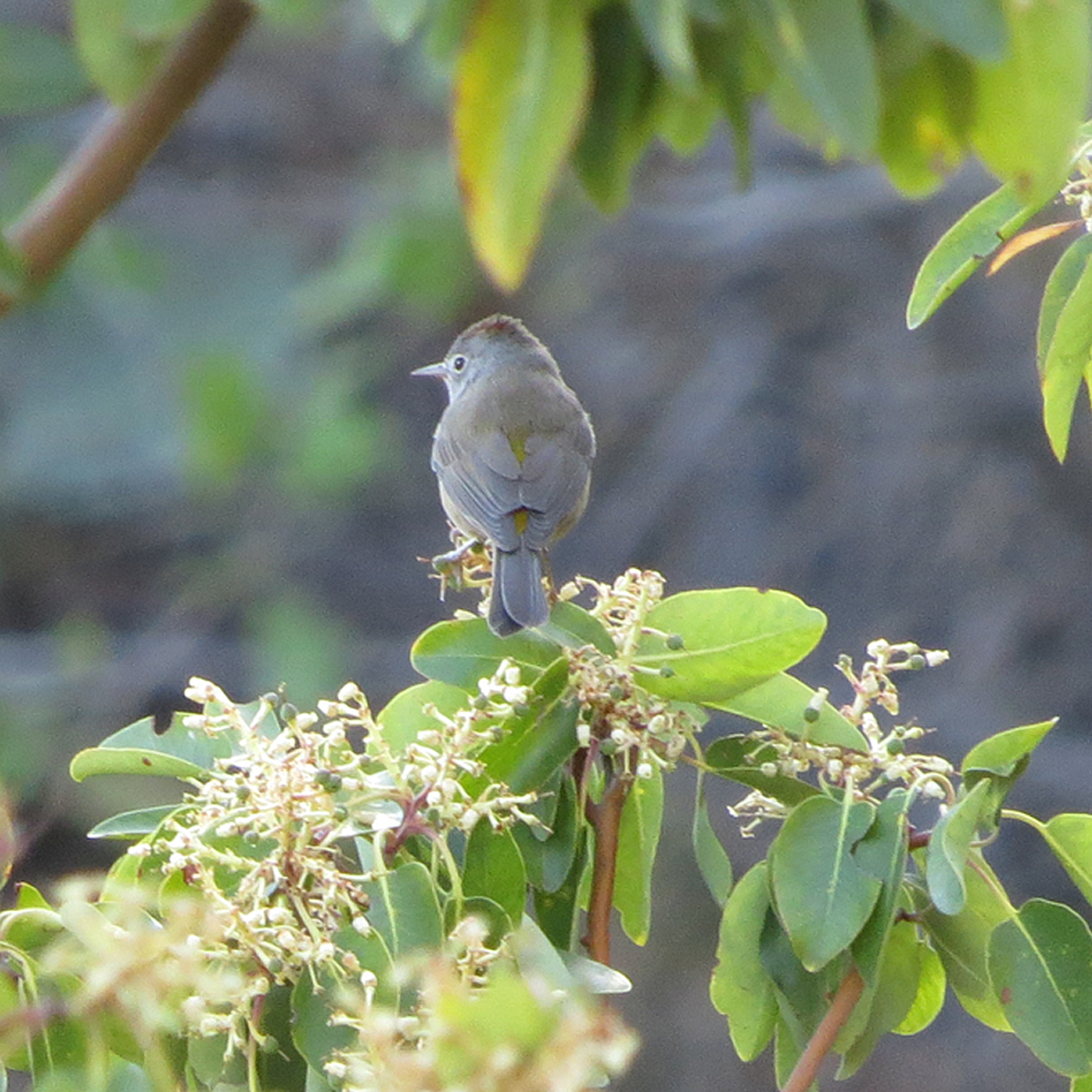
Wikipedia: Colima warbler Source: OTHER
Colima_Warbler%2C_Big_Bend_National_Park%2C_Texas_1.jpg
![]() The Colima warbler (Leiothlypis crissalis) is a New World warbler. It is mainly found in the Sierra Madre Occidental and Oriental mountains of central Mexico, though its range just barely extends into adjacent southwestern Texas in the Chisos Mountains of Big Bend National Park.
[more]
The Colima warbler (Leiothlypis crissalis) is a New World warbler. It is mainly found in the Sierra Madre Occidental and Oriental mountains of central Mexico, though its range just barely extends into adjacent southwestern Texas in the Chisos Mountains of Big Bend National Park.
[more]

Wikipedia: Lucy's warbler Source: OTHER
1200px-Lucy%27s_warbler_%28Oreothlypis_luciae%29_at_nest_%2817024784578%29.jpg
![]() Lucy's warbler (Leiothlypis luciae) is a small New World warbler found in North America. This species ranges includes southwestern United States and northwestern Mexico. It is one of only two warblers to nest in cavities.
[more]
Lucy's warbler (Leiothlypis luciae) is a small New World warbler found in North America. This species ranges includes southwestern United States and northwestern Mexico. It is one of only two warblers to nest in cavities.
[more]

Wikipedia: Virginia's warbler Source: OTHER
1200px-Female_Virgina%27s_Warbler.JPG
![]() Virginia's warbler (Leiothlypis virginiae) is a species of New World warbler.
[more]
Virginia's warbler (Leiothlypis virginiae) is a species of New World warbler.
[more]
Profile Wikipedia eBird Audubon AllAboutBirds Xeno-Canto NABU

Wikipedia: Yellow-crowned bishop Source: OTHER
Euplectes_afer_-Lake_Baringo%2C_Kenya_-male-8_CROP.jpg
This bird appears across the great seas in the following continents:
Europe, North America, Africa.
![]() The yellow-crowned bishop (Euplectes afer) is a species of passerine bird in the family Ploceidae native to Africa south of the Sahara.[2] It is highly sexually dimorphic in its breeding season, during which the male adopts a distinctive yellow and black plumage, contrasting with the female's predominantly brown coloration. Three subspecies are recognised.
[more]
The yellow-crowned bishop (Euplectes afer) is a species of passerine bird in the family Ploceidae native to Africa south of the Sahara.[2] It is highly sexually dimorphic in its breeding season, during which the male adopts a distinctive yellow and black plumage, contrasting with the female's predominantly brown coloration. Three subspecies are recognised.
[more]

Wikipedia: Orange bishop Source: OTHER
1200px-Euplectes_orix_5_Luc_Viatour.jpg
This bird appears across the great seas in the following continents:
North America, Africa.
![]() The northern red bishop or orange bishop (Euplectes franciscanus) is a small passerine bird in the family Ploceidae. It is part of the largest genus in the family with over 60 different species.[2] Its sister species is the Southern red bishop (Euplectes orix). This species is most recognizable by the bright reddish orange with contrasting black plumage displayed by the breeding male. It is most common throughout the northern African continent but has also been introduced to areas in the western hemisphere.
[more]
The northern red bishop or orange bishop (Euplectes franciscanus) is a small passerine bird in the family Ploceidae. It is part of the largest genus in the family with over 60 different species.[2] Its sister species is the Southern red bishop (Euplectes orix). This species is most recognizable by the bright reddish orange with contrasting black plumage displayed by the breeding male. It is most common throughout the northern African continent but has also been introduced to areas in the western hemisphere.
[more]
Black-capped chickadee / Schwarzkopfmeise (Poecile atricapillus)
Black-capped chickadee. 2023-10-13 14.45.40 New England
First observed in New England on 2023-10-13.
I was surprised to see that the chickadees I saw in Maryland are not the same ones as in New England: Carolina and black-capped.Wikipedia says they 'most likely diverged about 2.5 million years ago'!
Carolina chickadee (Poecile carolinensis)
Possibly two Carolina chickadees. 2022-05-05 18.19.16 Maryland
First observed in Cockeysville on 2021-06-11.
General: ![]() Parus carolinensis
[more]
Parus carolinensis
[more]
Call:
Automatically generated from Xeno-Canto recording
♫ Source: BirdNet
20220502_105412 birdnet - Carolina Chickadee - 2022-05-02 10:54:12 - Carolina Chickadee - Cockeysville.mp3
2022-05-02 10.54.12 Cockeysville (song?)
Siberian tit / Lapplandmeise (Poecile cinctus)
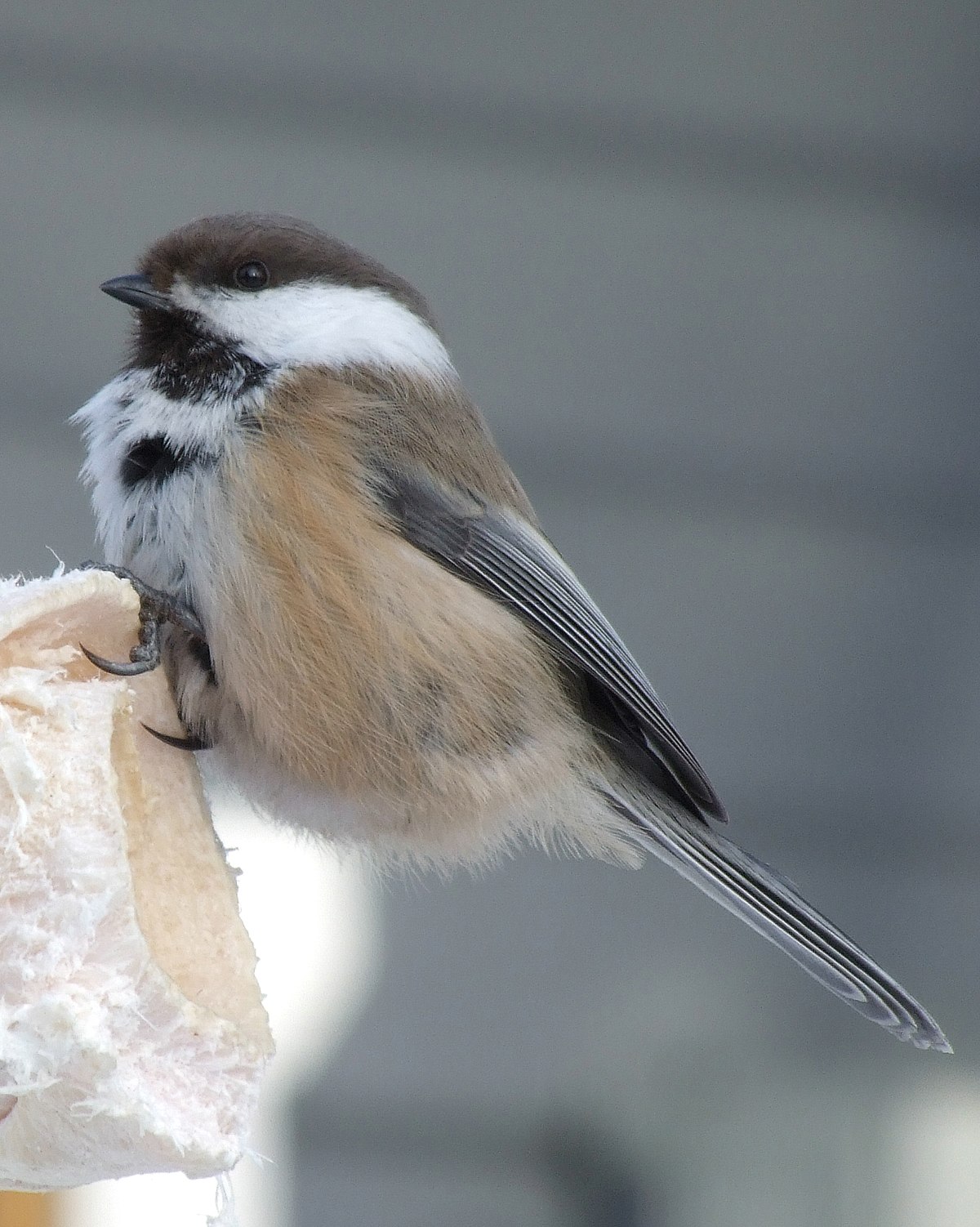
Wikipedia: Siberian tit Source: OTHER
1200px-Siberian_Tit_Parus_Cinctus_2006_03_07.JPG
This bird appears across the great seas in the following continents:
Europe, North America.
![]() The grey-headed chickadee or Siberian tit (Poecile cinctus, formerly Parus cinctus) is a passerine bird in the tit family Paridae. It is a widespread resident breeder throughout subarctic Scandinavia and the northern Palearctic, and also into North America in Alaska and the far northwest of Canada. It is a conifer specialist. It is resident, and most birds do not migrate. Curiously (with respect to its name), the bird has no grey on its head, which is black, white, and brown.
[more]
The grey-headed chickadee or Siberian tit (Poecile cinctus, formerly Parus cinctus) is a passerine bird in the tit family Paridae. It is a widespread resident breeder throughout subarctic Scandinavia and the northern Palearctic, and also into North America in Alaska and the far northwest of Canada. It is a conifer specialist. It is resident, and most birds do not migrate. Curiously (with respect to its name), the bird has no grey on its head, which is black, white, and brown.
[more]
Vocalization: ![]() Voice quite similar to Willow Tit. Other sounds: Chirping, bubbling sounds resembling Willow Tit, various other high pitched sounds. [Link]
Voice quite similar to Willow Tit. Other sounds: Chirping, bubbling sounds resembling Willow Tit, various other high pitched sounds. [Link]
Song: ![]() Song: Often vibrating or rasping notes repeated in Willow Tit-like structure, gradually falling in pitch "trrrrrr trrrrr trrrrr". [Link]
Song: Often vibrating or rasping notes repeated in Willow Tit-like structure, gradually falling in pitch "trrrrrr trrrrr trrrrr". [Link]
Calls: ![]() Call: Nasal Willow Tit-like "chee chee chee" , "ti ti chee". [Link]
Call: Nasal Willow Tit-like "chee chee chee" , "ti ti chee". [Link]
Physical details: length=13 cm,
wingspan=19-21 cm,
weight=11-14 g
Chestnut-backed chickadee (Poecile rufescens)
Profile Wikipedia eBird Audubon AllAboutBirds Xeno-Canto
Wikipedia: Chestnut-backed chickadee Source: OTHER
Parus_rufescensDU1N028CA.JPG
General: ![]() The chestnut-backed chickadee (Poecile rufescens, formerly Parus rufescens) is a small passerine bird in the tit family, Paridae.
[more]
The chestnut-backed chickadee (Poecile rufescens, formerly Parus rufescens) is a small passerine bird in the tit family, Paridae.
[more]
Mexican chickadee (Poecile sclateri)
Profile Wikipedia eBird Audubon AllAboutBirds Xeno-Canto

Wikipedia: Mexican chickadee Source: OTHER
Poecile_sclateri%2C_Rustler_Park%2C_Arizona_3.jpg
![]() The Mexican chickadee (Poecile sclateri) is a small songbird, a passerine bird in the tit family Paridae. It is still often placed in the genus Parus with most other tits, but mtDNA cytochrome b sequence data and morphology suggest that separating Poecile more adequately expresses these birds' relationships (Gill et al., 2005). The American Ornithologists' Union had been treating Poecile as distinct genus for some time already.
[more]
The Mexican chickadee (Poecile sclateri) is a small songbird, a passerine bird in the tit family Paridae. It is still often placed in the genus Parus with most other tits, but mtDNA cytochrome b sequence data and morphology suggest that separating Poecile more adequately expresses these birds' relationships (Gill et al., 2005). The American Ornithologists' Union had been treating Poecile as distinct genus for some time already.
[more]
Boreal chickadee / Hudsonmeise (Poecile hudsonicus)
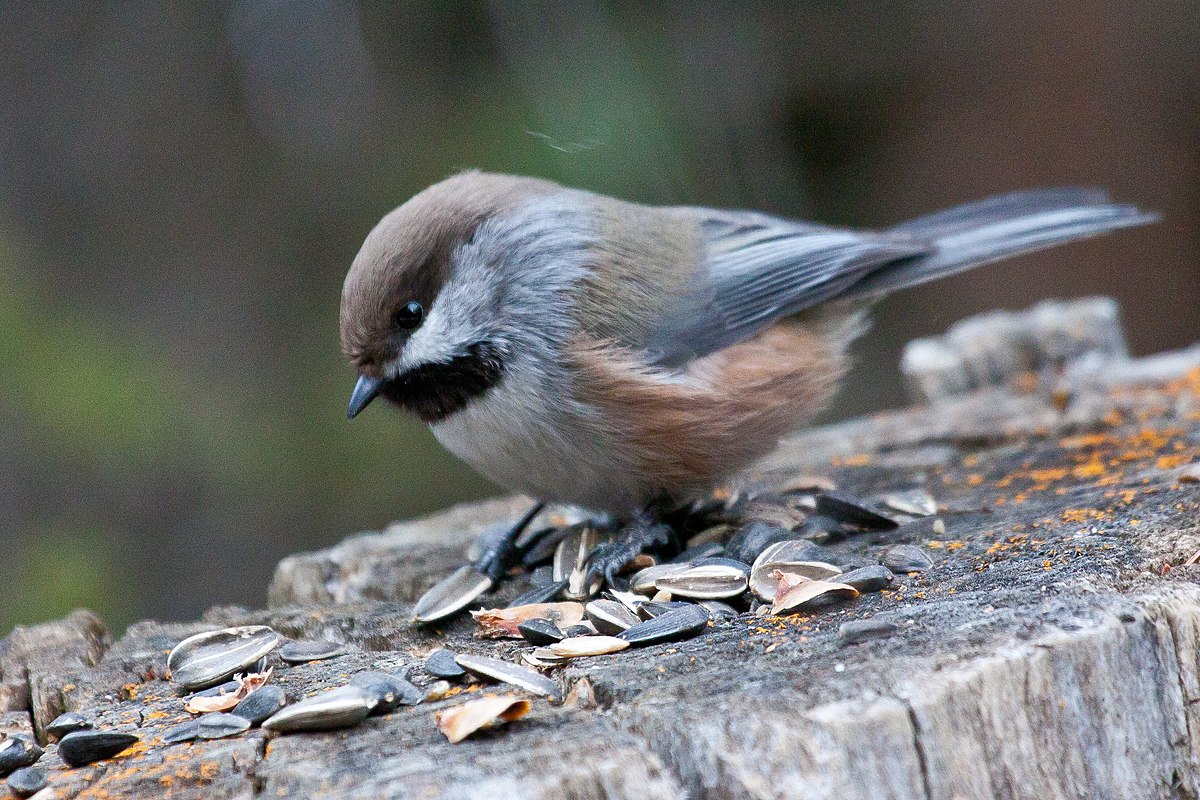
Wikipedia: Boreal chickadee Source: OTHER
1200px-Poecile_hudsonicus_7.jpg
![]() The boreal chickadee (Poecile hudsonicus) is a small passerine bird in the tit family Paridae. It is found in the boreal forests of Canada and the northern United States.
[more]
The boreal chickadee (Poecile hudsonicus) is a small passerine bird in the tit family Paridae. It is found in the boreal forests of Canada and the northern United States.
[more]
Mountain chickadee / Gambelmeise (Poecile gambeli)
Profile Wikipedia eBird Audubon AllAboutBirds Xeno-Canto

Wikipedia: Mountain chickadee Source: OTHER
1200px-Mountain_Chickadee%2C_Santa_Fe_Ski_Area_%28cropped%29.jpg
![]() The mountain chickadee (Poecile gambeli) is a small songbird, a passerine bird in the tit family Paridae.
[more]
The mountain chickadee (Poecile gambeli) is a small songbird, a passerine bird in the tit family Paridae.
[more]
Tufted titmouse / Indianermeise (Baeolophus bicolor)
Tufted titmouse. 2022-05-03 10.55.46 Maryland
First observed in Cockeysville on 2021-06-12.
![]() The tufted titmouse (Baeolophus bicolor) is a small songbird from North America, a species in the tit and chickadee family (Paridae). The black-crested titmouse, found from central and southern Texas southward,[2] was included as a subspecies, but now is considered a separate species, (Baeolophus atricristatus).[3]
[more]
The tufted titmouse (Baeolophus bicolor) is a small songbird from North America, a species in the tit and chickadee family (Paridae). The black-crested titmouse, found from central and southern Texas southward,[2] was included as a subspecies, but now is considered a separate species, (Baeolophus atricristatus).[3]
[more]
Call:
Automatically generated from Xeno-Canto recording
♫ Source: BirdNet
20220428_115651 birdnet - Tufted Titmouse - Tufted Titmouse - Cockeysville.mp3
2022-04-28 11.56.51 Cockeysville (song?)
Plain titmouse (Baeolophus inornatus)
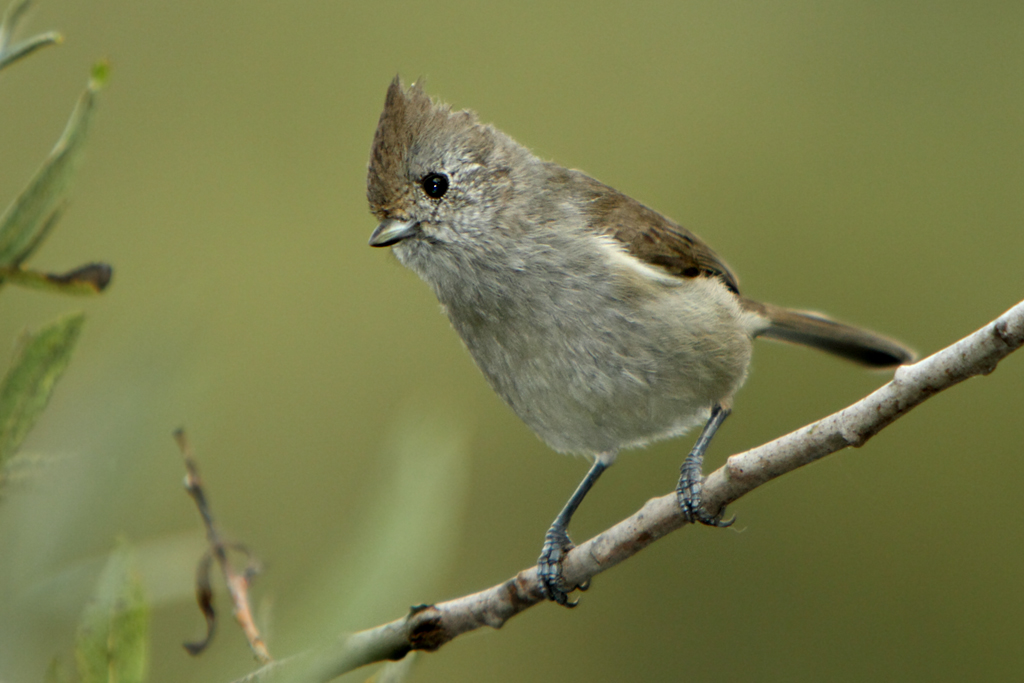
Wikipedia: Plain titmouse Source: OTHER
Baeolophus_inornatus_-San_Luis_Obispo%2C_California%2C_USA-8_%283%29.jpg
![]() The oak titmouse (Baeolophus inornatus) is a passerine bird in the tit family Paridae. The American Ornithologists' Union split the plain titmouse into the oak titmouse and the juniper titmouse in 1996, due to distinct differences in song, preferred habitat, and genetic makeup.[2]
[more]
The oak titmouse (Baeolophus inornatus) is a passerine bird in the tit family Paridae. The American Ornithologists' Union split the plain titmouse into the oak titmouse and the juniper titmouse in 1996, due to distinct differences in song, preferred habitat, and genetic makeup.[2]
[more]
Bridled titmouse / Zügelmeise (Baeolophus wollweberi)

Wikipedia: Bridled titmouse Source: OTHER
1200px-Bridled_Titmouse_%28Baeolophus_wollweberi%29_%2816875140301%29.jpg
![]() The bridled titmouse (Baeolophus wollweberi) is a small songbird, a passerine bird in the tit family Paridae.
[more]
The bridled titmouse (Baeolophus wollweberi) is a small songbird, a passerine bird in the tit family Paridae.
[more]
Black-crested titmouse / Schwarzhäubchenmeise (Baeolophus atricristatus)
Profile Wikipedia eBird Audubon AllAboutBirds Xeno-Canto

Wikipedia: Black-crested titmouse Source: OTHER
Black-crested_Titmouse.jpg
![]() The black-crested titmouse or Mexican titmouse (Baeolophus atricristatus), is a passerine bird in the tit family Paridae. Once considered a subspecies of the tufted titmouse (B. bicolor), it was recognized as a separate species[2] in 2002. It is native to southern Texas, Oklahoma, and east-central Mexico. Vagrants have been seen as far north and east as St. Louis, Missouri.
[more]
The black-crested titmouse or Mexican titmouse (Baeolophus atricristatus), is a passerine bird in the tit family Paridae. Once considered a subspecies of the tufted titmouse (B. bicolor), it was recognized as a separate species[2] in 2002. It is native to southern Texas, Oklahoma, and east-central Mexico. Vagrants have been seen as far north and east as St. Louis, Missouri.
[more]
Juniper titmouse (Baeolophus ridgwayi)

Wikipedia: Juniper titmouse Source: OTHER
Juniper_Titmouse2.jpg
![]() The juniper titmouse (Baeolophus ridgwayi) is a passerine bird in the tit family Paridae. The American Ornithologists' Union split the plain titmouse into the oak titmouse and the juniper titmouse in 1996, due to distinct differences in song, preferred habitat, and genetic makeup.[2]
[more]
The juniper titmouse (Baeolophus ridgwayi) is a passerine bird in the tit family Paridae. The American Ornithologists' Union split the plain titmouse into the oak titmouse and the juniper titmouse in 1996, due to distinct differences in song, preferred habitat, and genetic makeup.[2]
[more]
Common starling / Star (Sturnus vulgaris)
Im richtigen Licht schimmern die Federn. 2020-04-11 07.54.52 Luppmen
First observed in 🇨🇭 on 2020-04-11.
This bird appears across the great seas in the following continents:
Europe, North America (introduced), Africa.
Learned on BBC's Winterwatch: the movement of a swarm of starlings is called a murmuration! Check out this this video or even an entire half hour
In trees or in the fields by the cows.
Frequently seen here, for instance by their nests under the eaves of one of the Toblerone houses.
Introduced to North America from Europe by Eugene Schieffelin.
Eine der Vogelarten, die gleichzeitig zwei Töne singen kann!
Vocalization: ![]() Among the best of imitators. Mimics birds, animals and mechanical noises. Often makes several sounds at the same time. [Link]
Among the best of imitators. Mimics birds, animals and mechanical noises. Often makes several sounds at the same time. [Link]
Song: ![]() Song a highly varied mix of falling whistles, bill-clappering and various masterful mimicry. [Link]
Song a highly varied mix of falling whistles, bill-clappering and various masterful mimicry. [Link]
Calls: ![]() Other calls; a harsh "chaee" and a short sharp "tink". [Link]
Other calls; a harsh "chaee" and a short sharp "tink". [Link]
Physical details: length=21 cm,
wingspan=37-42 cm,
weight=60-90 g
Habitats:
Agricultural
Song:
I find their individual song amusing, with its (long) whoops and weird noises.
As a group, they're just noisy!
Song attributes:
Melody: improvised melodic, slow, Frequency: medium (1-5 KHz) Special sounds: mimicry, whoop, weird Singing season: 01-01 - 09-30 Dawn chorus start, 15 minutes before dawn.
Call:
I hear this occasionally and really enjoy it - a long rising 'whoop', as I call it', starting low at 1 1/2 KHz and rising to 6 1/2 KHz!
♫ Source: BirdNet
20210823_172609 birdnet 1968 - European Starling long whoop call - 2021-08-23 17:26:09 - European Starling - Fehraltorf.mp3
2021-08-23 17.26.09 Fehraltorf (call)
Call attributes:
Call melody: one note, slow, Frequency: 1-6 KHz, Special sounds: whoop.
Sage thrasher (Oreoscoptes montanus)
Profile Wikipedia eBird Audubon AllAboutBirds Xeno-Canto

Wikipedia: Sage thrasher Source: OTHER
1200px-Oreoscoptes_montanus_Sandy_Hook_NJ.jpg
General: ![]() The sage thrasher (Oreoscoptes montanus) is a medium-sized passerine bird from the family Mimidae, which also includes mockingbirds, tremblers, and New World catbirds. It is the only member of the genus Oreoscoptes. This seems less close to the Caribbean thrashers, but rather to the mockingbirds instead (Hunt et al. 2001, Barber et al. 2004).
[more]
The sage thrasher (Oreoscoptes montanus) is a medium-sized passerine bird from the family Mimidae, which also includes mockingbirds, tremblers, and New World catbirds. It is the only member of the genus Oreoscoptes. This seems less close to the Caribbean thrashers, but rather to the mockingbirds instead (Hunt et al. 2001, Barber et al. 2004).
[more]
Common myna (Acridotheres tristis)
First common myna seen on trip to SE Asia, in Wat Pho, Bangkok. 2024-01-19 17.00.32 Thailand
First observed in Thailand on 2024-01-19.
This bird appears across the great seas in the following continents:
North America, Africa, Asia.
![]() The common myna or Indian myna (Acridotheres tristis), sometimes spelled mynah,[2] is a member of the family Sturnidae (starlings and mynas) native to Asia. An omnivorous open woodland bird with a strong territorial instinct, the common myna has adapted extremely well to urban environments.
[more]
The common myna or Indian myna (Acridotheres tristis), sometimes spelled mynah,[2] is a member of the family Sturnidae (starlings and mynas) native to Asia. An omnivorous open woodland bird with a strong territorial instinct, the common myna has adapted extremely well to urban environments.
[more]
Call:
Automatically generated from Xeno-Canto recording
♫ XC729094 - Common Myna - Acridotheres tristis tristis. Source: XENOCANTO
XC729094 - Common Myna - Acridotheres tristis tristis.mp3
(song?)
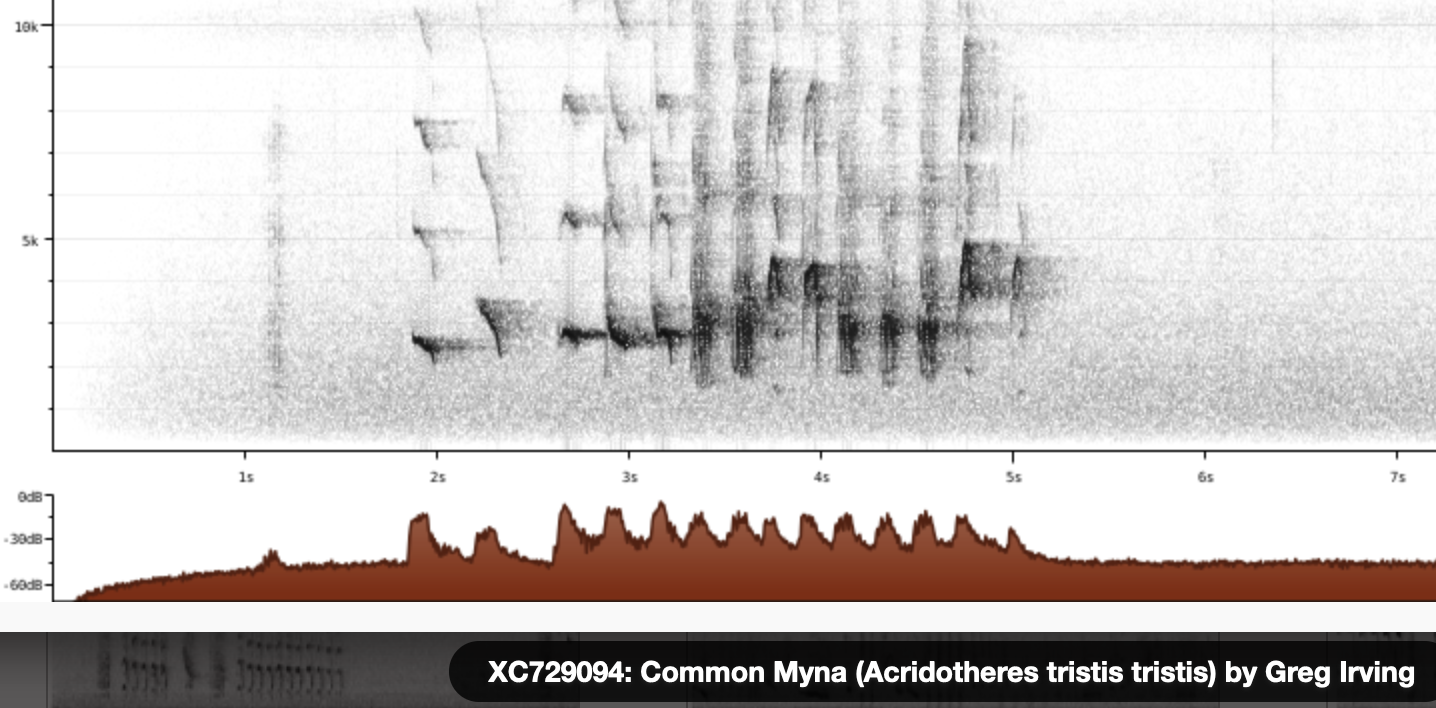
Jungle myna / Dschungelmaina (Acridotheres fuscus)

Wikipedia: Jungle myna Source: OTHER
Jungle_Myna_%28Acridotheres_fuscus%29_on_Kapok_%28Ceiba_pentandra%29_in_Kolkata_I_IMG_1340.jpg
![]() The jungle myna (Acridotheres fuscus) is a myna, a member of the starling family. It is found patchily distributed across much of the mainland of the Indian Subcontinent but absent in the arid zones of India. It is easily recognized by the tuft of feathers on its forehead that form a frontal crest, a feature also found in the closely related Javan myna and the pale-bellied myna which were treated as a subspecies in the past. The eyes are pale, yellow or blue depending on the population and the base of the orange-yellow bill is dark. It has also been introduced either intentionally or accidentally into many other parts of the world including Fiji, Taiwan, the Andaman Islands, and parts of Japan. The species has also spread out on its own to some islands in the Pacific.
[more]
The jungle myna (Acridotheres fuscus) is a myna, a member of the starling family. It is found patchily distributed across much of the mainland of the Indian Subcontinent but absent in the arid zones of India. It is easily recognized by the tuft of feathers on its forehead that form a frontal crest, a feature also found in the closely related Javan myna and the pale-bellied myna which were treated as a subspecies in the past. The eyes are pale, yellow or blue depending on the population and the base of the orange-yellow bill is dark. It has also been introduced either intentionally or accidentally into many other parts of the world including Fiji, Taiwan, the Andaman Islands, and parts of Japan. The species has also spread out on its own to some islands in the Pacific.
[more]
Polynesian starling (Aplonis tabuensis)

Wikipedia: Polynesian starling Source: OTHER
1200px-Polynesian_Starling.jpg
![]() The Polynesian starling (Aplonis tabuensis) is a species of starling of the family Sturnidae. It is found in the Samoan Islands, Fiji, Niue, Tonga, the Santa Cruz Islands and Wallis and Futuna. Its natural habitats are subtropical or tropical dry forests and tropical moist forests. Various subspecies exist throughout this wide range, some darker in coloration and some lighter. Its call is a raspy buzz or rattle. Diet is fruit and insects.[2]
[more]
The Polynesian starling (Aplonis tabuensis) is a species of starling of the family Sturnidae. It is found in the Samoan Islands, Fiji, Niue, Tonga, the Santa Cruz Islands and Wallis and Futuna. Its natural habitats are subtropical or tropical dry forests and tropical moist forests. Various subspecies exist throughout this wide range, some darker in coloration and some lighter. Its call is a raspy buzz or rattle. Diet is fruit and insects.[2]
[more]
Micronesian starling (Aplonis opaca)
Profile Wikipedia eBird Audubon AllAboutBirds Xeno-Canto

Wikipedia: Micronesian starling Source: OTHER
1200px-Aplonis_opaca.jpg
![]() The Micronesian starling (Aplonis opaca) is a species of starling in the family Sturnidae. It is found in Micronesia, the Northern Mariana Islands, and Palau. Its natural habitats are subtropical or tropical dry forest and subtropical or tropical moist lowland forest.
[more]
The Micronesian starling (Aplonis opaca) is a species of starling in the family Sturnidae. It is found in Micronesia, the Northern Mariana Islands, and Palau. Its natural habitats are subtropical or tropical dry forest and subtropical or tropical moist lowland forest.
[more]
Veery / Wilson-Drossel (Catharus fuscescens)
Profile Wikipedia eBird Audubon AllAboutBirds Xeno-Canto

Wikipedia: Veery Source: OTHER
1200px-Catharus_fuscescens_CT.jpg
![]() The veery (Catharus fuscescens) is a small North American thrush species, a member of a group of closely related and similar species in the genus Catharus, also including the gray-cheeked thrush (C. minimus), Bicknell's thrush (C. bicknelli), Swainson's thrush (C. ustulatus), and Hermit thrush (C. guttatus).[2][3] Alternate names for this species include Wilson's thrush (named so after Alexander Wilson[4]) and tawny thrush.[5] Up to six subspecies exist, which are grouped into the eastern Veery (C. fuscescens fuscescens), the western Veery or Willow Thrush (C. fuscescens salicicolus), and the Newfoundland Veery (C. fuscescens fuliginosus).[6]
[more]
The veery (Catharus fuscescens) is a small North American thrush species, a member of a group of closely related and similar species in the genus Catharus, also including the gray-cheeked thrush (C. minimus), Bicknell's thrush (C. bicknelli), Swainson's thrush (C. ustulatus), and Hermit thrush (C. guttatus).[2][3] Alternate names for this species include Wilson's thrush (named so after Alexander Wilson[4]) and tawny thrush.[5] Up to six subspecies exist, which are grouped into the eastern Veery (C. fuscescens fuscescens), the western Veery or Willow Thrush (C. fuscescens salicicolus), and the Newfoundland Veery (C. fuscescens fuliginosus).[6]
[more]
Gray-cheeked thrush / Grauwangendrossel (Catharus minimus)
Profile Wikipedia eBird Audubon AllAboutBirds Xeno-Canto

Wikipedia: Gray-cheeked thrush Source: OTHER
1200px-Graycheekedthrush36.jpg
![]() The grey-cheeked thrush (Catharus minimus) is a medium-sized thrush. This species is 15–17 cm (5.9–6.7 in) in length, and has the white-dark-white underwing pattern characteristic of Catharus thrushes. It is a member of a close-knit group of migrant species together with the veery and Bicknell's thrush;[2] it forms a cryptic species pair with the latter. The grey-cheeked thrush is all but indistinguishable from Bicknell's thrush except by its slightly larger size and different song. The two were formerly considered conspecific.[3] Of all the American spotted thrushes, the grey-cheeked has the most northern breeding range.[4]
[more]
The grey-cheeked thrush (Catharus minimus) is a medium-sized thrush. This species is 15–17 cm (5.9–6.7 in) in length, and has the white-dark-white underwing pattern characteristic of Catharus thrushes. It is a member of a close-knit group of migrant species together with the veery and Bicknell's thrush;[2] it forms a cryptic species pair with the latter. The grey-cheeked thrush is all but indistinguishable from Bicknell's thrush except by its slightly larger size and different song. The two were formerly considered conspecific.[3] Of all the American spotted thrushes, the grey-cheeked has the most northern breeding range.[4]
[more]
Swainson's thrush (Catharus ustulatus)
Profile Wikipedia eBird Audubon AllAboutBirds Xeno-Canto

Wikipedia: Swainson's thrush Source: OTHER
1200px-Catharus_ustulatus_-North_Dakota-8a.jpg
![]() Swainson's thrush (Catharus ustulatus), also called olive-backed thrush and russet-backed thrush, is a medium-sized thrush. It is a member of genus Catharus and is typical of it in terms of its subdued coloration and beautiful, ascending flute-like voice. Swainson's thrush was named after William Swainson, an English ornithologist.
[more]
Swainson's thrush (Catharus ustulatus), also called olive-backed thrush and russet-backed thrush, is a medium-sized thrush. It is a member of genus Catharus and is typical of it in terms of its subdued coloration and beautiful, ascending flute-like voice. Swainson's thrush was named after William Swainson, an English ornithologist.
[more]
Hermit thrush (Catharus guttatus)
Profile Wikipedia eBird Audubon AllAboutBirds Xeno-Canto
Hermit thrush. 2023-10-13 14.16.16 New England
First observed in New England on 2023-10-13.
![]() The hermit thrush (Catharus guttatus) is a medium-sized North American thrush. It is not very closely related to the other North American migrant species of Catharus, but rather to the Mexican russet nightingale-thrush.[2]
[more]
The hermit thrush (Catharus guttatus) is a medium-sized North American thrush. It is not very closely related to the other North American migrant species of Catharus, but rather to the Mexican russet nightingale-thrush.[2]
[more]
Bicknell's thrush / Bicknelldrossel (Catharus bicknelli)
Profile Wikipedia eBird Audubon AllAboutBirds Xeno-Canto

Wikipedia: Bicknell's thrush Source: OTHER
1200px-Bicknells_Thrush_From_The_Crossley_ID_Guide_Eastern_Birds.jpg
![]() Bicknell's thrush (Catharus bicknelli) is a medium-sized thrush, at 17.5 cm (6.9 in) and 28 g (0.99 oz). One of North America's rarest and most localized breeders, it inhabits coniferous mountain tops and disturbed habitats of the Northeast. While very similar in appearance and vocalization to the gray-cheeked thrush (Catharus minimus), the two species, with two completely different breeding ranges, differ slightly in their morphology and vocalizations. It was named after Eugene Bicknell, an American amateur ornithologist, who made the first scientific discovery of the species on Slide Mountain in the Catskills in the late 19th century.
[more]
Bicknell's thrush (Catharus bicknelli) is a medium-sized thrush, at 17.5 cm (6.9 in) and 28 g (0.99 oz). One of North America's rarest and most localized breeders, it inhabits coniferous mountain tops and disturbed habitats of the Northeast. While very similar in appearance and vocalization to the gray-cheeked thrush (Catharus minimus), the two species, with two completely different breeding ranges, differ slightly in their morphology and vocalizations. It was named after Eugene Bicknell, an American amateur ornithologist, who made the first scientific discovery of the species on Slide Mountain in the Catskills in the late 19th century.
[more]
Eye-browed thrush (Turdus obscurus)

Wikipedia: Eye-browed thrush Source: OTHER
Eyebrowed_Thrush.jpg
This bird appears across the great seas in the following continents:
North America, Asia, Australia.
vagrant
Island thrush / Südseedrossel (Turdus poliocephalus)
Profile Wikipedia eBird Audubon AllAboutBirds Xeno-Canto

Wikipedia: Island thrush Source: OTHER
Island_Thrush.jpg
This bird appears across the great seas in the following continents:
North America, Australia.
Christmas Island
American robin / Wanderdrossel (Turdus migratorius)
American Robin intensely building a nest. 2022-04-26 16.58.36 Maryland
First observed in Cockeysville on 2021-06-11.
General: ![]() The American robin (Turdus migratorius) is a migratory songbird of the true thrush genus and Turdidae, the wider thrush family. It is named after the European robin[2] because of its reddish-orange breast, though the two species are not closely related, with the European robin belonging to the Old World flycatcher family. The American robin is widely distributed throughout North America, wintering from southern Canada to central Mexico and along the Pacific Coast. It is the state bird of Connecticut, Michigan, and Wisconsin.[3]
[more]
The American robin (Turdus migratorius) is a migratory songbird of the true thrush genus and Turdidae, the wider thrush family. It is named after the European robin[2] because of its reddish-orange breast, though the two species are not closely related, with the European robin belonging to the Old World flycatcher family. The American robin is widely distributed throughout North America, wintering from southern Canada to central Mexico and along the Pacific Coast. It is the state bird of Connecticut, Michigan, and Wisconsin.[3]
[more]
Call:
Automatically generated from Xeno-Canto recording
♫ Source: BirdNet
20210611_204253 birdnet 1616 - American Robin - 2021-06-11 20:42:53 - American Robin - Cockeysville.mp3
2021-06-11 20.42.53 Cockeysville (song?)
Rufous-backed robin (Turdus rufopalliatus)
Profile Wikipedia eBird Audubon AllAboutBirds Xeno-Canto

Wikipedia: Rufous-backed robin Source: OTHER
1200px-Turdus_rufopalliatus.jpg
![]() The rufous-backed thrush (Turdus rufopalliatus) is a songbird of the thrush family. It is endemic to the Pacific slope of Mexico. It is also known as the rufous-backed robin.
[more]
The rufous-backed thrush (Turdus rufopalliatus) is a songbird of the thrush family. It is endemic to the Pacific slope of Mexico. It is also known as the rufous-backed robin.
[more]
Clay-colored robin (Turdus grayi)
Lava hike clay colored thrush? national bird. 2018-03-01 17.09.44 Costa Rica
First observed in Costa Rica on 2018-03-01.
![]() The clay-colored thrush (Turdus grayi) is a common Middle American bird of the thrush family (Turdidae). It is the national bird of Costa Rica, where it is well known as the yigüirro (Spanish: [ʝi'ɣwiro]). Other common names include clay-colored robin.[1]
[more]
The clay-colored thrush (Turdus grayi) is a common Middle American bird of the thrush family (Turdidae). It is the national bird of Costa Rica, where it is well known as the yigüirro (Spanish: [ʝi'ɣwiro]). Other common names include clay-colored robin.[1]
[more]
Townsend's solitaire (Myadestes townsendi)
Profile Wikipedia eBird Audubon AllAboutBirds Xeno-Canto
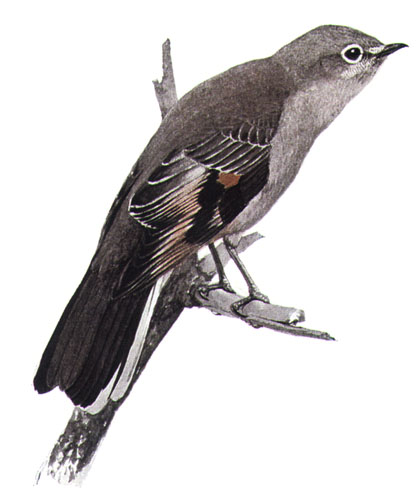
Wikipedia: Townsend's solitaire Source: OTHER
Myadestes_townsendiDF09N193CB.jpg
![]() Townsend's solitaire (Myadestes townsendi) is a medium-sized thrush, the only solitaire native to America north of Mexico.
[more]
Townsend's solitaire (Myadestes townsendi) is a medium-sized thrush, the only solitaire native to America north of Mexico.
[more]
Eastern bluebird (Sialia sialis)
Eastern bluebird. 2022-04-29 12.29.14 Maryland
First observed in Maryland on 2021-06-14.
![]() The eastern bluebird (Sialia sialis) is a small North American migratory thrush found in open woodlands, farmlands, and orchards.
[more]
The eastern bluebird (Sialia sialis) is a small North American migratory thrush found in open woodlands, farmlands, and orchards.
[more]
Western bluebird (Sialia mexicana)

Wikipedia: Western bluebird Source: OTHER
1200px-Western.male.jpg
![]() The western bluebird (Sialia mexicana) is a small North American thrush.
[more]
The western bluebird (Sialia mexicana) is a small North American thrush.
[more]
Mountain bluebird / Berghüttensänger (Sialia currucoides)
Profile Wikipedia eBird A-Z Animals Audubon AllAboutBirds Xeno-Canto

Wikipedia: Mountain bluebird Source: OTHER
Mountain_Bluebird.jpg
![]() The mountain bluebird (Sialia currucoides) is a small migratory thrush that is found in mountainous districts of western North America. It has a light underbelly and black eyes. Adult males have thin bills and are bright turquoise-blue and somewhat lighter underneath. Adult females have duller blue wings and tail, grey breast, grey crown, throat and back. In fresh fall plumage, the female's throat and breast are tinged with red-orange, brownish near the flank contrasting with white tail underparts. Their call is a thin 'few'; while their song is warbled high 'chur chur'. It is the state bird of Idaho and Nevada. It is an omnivore and it can live 6 to 10 years in the wild. It eats spiders, grasshoppers, flies and other insects, and small fruits. The mountain bluebird is a relative of the eastern and western bluebirds.
[more]
The mountain bluebird (Sialia currucoides) is a small migratory thrush that is found in mountainous districts of western North America. It has a light underbelly and black eyes. Adult males have thin bills and are bright turquoise-blue and somewhat lighter underneath. Adult females have duller blue wings and tail, grey breast, grey crown, throat and back. In fresh fall plumage, the female's throat and breast are tinged with red-orange, brownish near the flank contrasting with white tail underparts. Their call is a thin 'few'; while their song is warbled high 'chur chur'. It is the state bird of Idaho and Nevada. It is an omnivore and it can live 6 to 10 years in the wild. It eats spiders, grasshoppers, flies and other insects, and small fruits. The mountain bluebird is a relative of the eastern and western bluebirds.
[more]
Varied thrush / Halsbanddrossel (Ixoreus naevius)

Wikipedia: Varied thrush Source: OTHER
Ixoreus_naevius_1.jpg
![]() The varied thrush (Ixoreus naevius) is a member of the thrush family, Turdidae. It is the only species in the monotypic genus Ixoreus.
[more]
The varied thrush (Ixoreus naevius) is a member of the thrush family, Turdidae. It is the only species in the monotypic genus Ixoreus.
[more]
Wood thrush / Walddrossel (Hylocichla mustelina)
Wood thrush, magnificent singer. 2022-05-05 18.37.08 Maryland
First observed in Cockeysville on 2021-06-12.
![]() The wood thrush (Hylocichla mustelina) is a North American passerine bird. It is closely related to other thrushes such as the American robin and is widely distributed across North America, wintering in Central America and southern Mexico. The wood thrush is the official bird of the District of Columbia.[2]
[more]
The wood thrush (Hylocichla mustelina) is a North American passerine bird. It is closely related to other thrushes such as the American robin and is widely distributed across North America, wintering in Central America and southern Mexico. The wood thrush is the official bird of the District of Columbia.[2]
[more]
Call:
Automatically generated from Xeno-Canto recording
♫ Source: BirdNet
20220505_163615 birdnet - Wood Thrush - 2022-05-05 16:36:15 - Wood Thrush - Cockeysville.mp3
2022-05-05 16.36.15 Cockeysville (song?)
Least flycatcher / Gartentyrann (Empidonax minimus)
Profile Wikipedia eBird Audubon AllAboutBirds Xeno-Canto
Least flycatcher on second outing near Rio Lagartos. 2023-04-16 06.39.50 Yucatan
First observed in Yucatan on 2023-04-16.
![]() The least flycatcher (Empidonax minimus), (also called chebec, or chebecker, after the sound it makes), is a small insect-eating bird. It is the smallest Empidonax flycatcher in eastern North America.
[more]
The least flycatcher (Empidonax minimus), (also called chebec, or chebecker, after the sound it makes), is a small insect-eating bird. It is the smallest Empidonax flycatcher in eastern North America.
[more]
Acadian flycatcher / Buchentyrann (Empidonax virescens)
Profile Wikipedia eBird Audubon AllAboutBirds Xeno-Canto
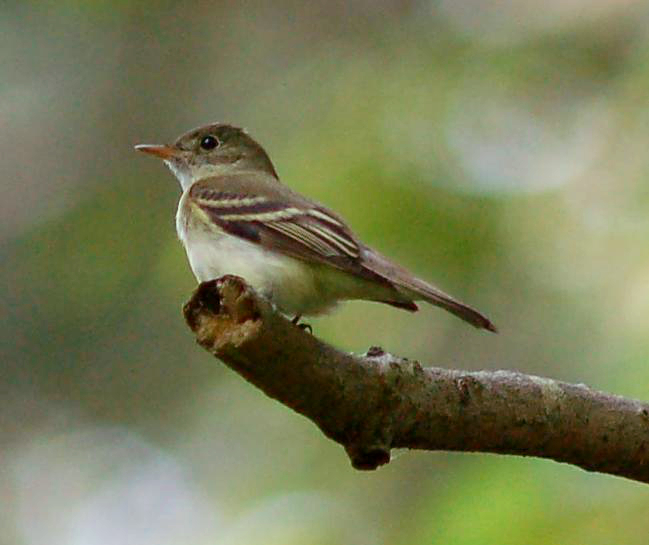
Wikipedia: Acadian flycatcher Source: OTHER
Acadian_Flycatcher.jpg
![]() The Acadian flycatcher (Empidonax virescens) is a small insect-eating bird of the tyrant flycatcher family.
[more]
The Acadian flycatcher (Empidonax virescens) is a small insect-eating bird of the tyrant flycatcher family.
[more]
Alder flycatcher (Empidonax alnorum)
Profile Wikipedia eBird Audubon AllAboutBirds Xeno-Canto

Wikipedia: Alder flycatcher Source: OTHER
1200px-Empidonax_alnorum_CT2.jpg
![]() The alder flycatcher (Empidonax alnorum) is a small insect-eating bird of the tyrant flycatcher family. The genus name Empidonax is from Ancient Greek empis, "gnat", and anax, "master". The specific alnorum is Latin and means "of the alders".[2]
[more]
The alder flycatcher (Empidonax alnorum) is a small insect-eating bird of the tyrant flycatcher family. The genus name Empidonax is from Ancient Greek empis, "gnat", and anax, "master". The specific alnorum is Latin and means "of the alders".[2]
[more]
Hammond's flycatcher (Empidonax hammondii)
Profile Wikipedia eBird Audubon AllAboutBirds Xeno-Canto

Wikipedia: Hammond's flycatcher Source: OTHER
1200px-Empidonax_hammondii.jpg
![]() Hammond's flycatcher (Empidonax hammondii) is a flycatcher in the family Tyrannidae. This small insectivorous bird inhabits the coniferous and mixed forests of western North America. The name of this bird commemorates William Alexander Hammond who was the surgeon general of the US Army. Hammond collected bird specimens for Spencer Fullerton Baird.[2]
[more]
Hammond's flycatcher (Empidonax hammondii) is a flycatcher in the family Tyrannidae. This small insectivorous bird inhabits the coniferous and mixed forests of western North America. The name of this bird commemorates William Alexander Hammond who was the surgeon general of the US Army. Hammond collected bird specimens for Spencer Fullerton Baird.[2]
[more]
Cordilleran flycatcher (Empidonax occidentalis)
Profile Wikipedia eBird Audubon AllAboutBirds Xeno-Canto
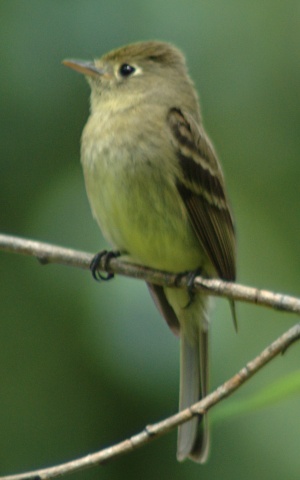
Wikipedia: Cordilleran flycatcher Source: OTHER
Empidonax_occidentalis2.jpg
![]() The Cordilleran flycatcher (Empidonax occidentalis) is a small insect-eating bird. It is a small Empidonax flycatcher, with typical length ranging from 13 to 17 cm.
[more]
The Cordilleran flycatcher (Empidonax occidentalis) is a small insect-eating bird. It is a small Empidonax flycatcher, with typical length ranging from 13 to 17 cm.
[more]
Yellow-bellied flycatcher (Empidonax flaviventris)
Profile Wikipedia eBird Audubon AllAboutBirds Xeno-Canto

Wikipedia: Yellow-bellied flycatcher Source: OTHER
1200px-Yellow-bellied_Flycatcher_-_Empidonax_flaviventris.jpg
![]() The yellow-bellied flycatcher (Empidonax flaviventris) is a small insect-eating bird of the tyrant flycatcher family.
[more]
The yellow-bellied flycatcher (Empidonax flaviventris) is a small insect-eating bird of the tyrant flycatcher family.
[more]
Pacific-slope flycatcher (Empidonax difficilis)
Profile Wikipedia eBird Audubon AllAboutBirds Xeno-Canto

Wikipedia: Pacific-slope flycatcher Source: OTHER
1200px-Empidonax_difficilis_1.jpg
![]() The Pacific-slope flycatcher (Empidonax difficilis) is a small insectivorous bird of the family Tyrannidae. It is native to coastal regions of western North America, including the Pacific Ocean and the southern Gulf of California, as far north as British Columbia and southern Alaska, but is replaced in the inland regions by the Cordilleran flycatcher. These two species were classified as a single species, commonly called the western flycatcher, by the American Ornithologists’ Union until 1989.[2] In winter, both species migrate south to Mexico, where they are virtually indistinguishable from one another.
[more]
The Pacific-slope flycatcher (Empidonax difficilis) is a small insectivorous bird of the family Tyrannidae. It is native to coastal regions of western North America, including the Pacific Ocean and the southern Gulf of California, as far north as British Columbia and southern Alaska, but is replaced in the inland regions by the Cordilleran flycatcher. These two species were classified as a single species, commonly called the western flycatcher, by the American Ornithologists’ Union until 1989.[2] In winter, both species migrate south to Mexico, where they are virtually indistinguishable from one another.
[more]
Willow flycatcher (Empidonax traillii)
Profile Wikipedia eBird A-Z Animals Audubon AllAboutBirds Xeno-Canto

Wikipedia: Willow flycatcher Source: OTHER
Southwestern_Willow_Flycatcher.jpg
![]() The willow flycatcher (Empidonax traillii) is a small insect-eating, neotropical migrant bird of the tyrant flycatcher family. There are four subspecies of the willow flycatcher currently recognized, all of which breed in North America (including three subspecies that breed in California).[2] Empidonax flycatchers are almost impossible to tell apart in the field so biologists use their songs to distinguish between them.[3] The binomial commemorates the Scottish zoologist Thomas Stewart Traill.
[more]
The willow flycatcher (Empidonax traillii) is a small insect-eating, neotropical migrant bird of the tyrant flycatcher family. There are four subspecies of the willow flycatcher currently recognized, all of which breed in North America (including three subspecies that breed in California).[2] Empidonax flycatchers are almost impossible to tell apart in the field so biologists use their songs to distinguish between them.[3] The binomial commemorates the Scottish zoologist Thomas Stewart Traill.
[more]
Gray flycatcher (Empidonax wrightii)
Profile Wikipedia eBird Audubon AllAboutBirds Xeno-Canto

Wikipedia: Gray flycatcher Source: OTHER
1200px-Empidonax_wrightii_Richard_Crossley.jpg
![]() The American gray flycatcher, or American grey flycatcher, or just gray flycatcher (Empidonax wrightii) as it is known in North America, is a small, insectivorous passerine in the tyrant flycatcher family. It is common in the arid regions of western North America, especially the Great Basin. From sagebrush steppes to pinyon-juniper woodlands and ponderosa pine forests, this flycatcher forages for insects from shrubs or low tree branches.
[more]
The American gray flycatcher, or American grey flycatcher, or just gray flycatcher (Empidonax wrightii) as it is known in North America, is a small, insectivorous passerine in the tyrant flycatcher family. It is common in the arid regions of western North America, especially the Great Basin. From sagebrush steppes to pinyon-juniper woodlands and ponderosa pine forests, this flycatcher forages for insects from shrubs or low tree branches.
[more]
Eastern kingbird / Königstyrann (Tyrannus tyrannus)
Profile Wikipedia eBird A-Z Animals Audubon AllAboutBirds Xeno-Canto
Eastern kingbird. 2022-04-29 12.54.00 Maryland
First observed in Maryland on 2021-06-14.
![]() Lanius tyrannus Linnaeus, 1758
[more]
Lanius tyrannus Linnaeus, 1758
[more]
Gray kingbird / Grauer Königstyrann (Tyrannus dominicensis)
Profile Wikipedia eBird Audubon AllAboutBirds Xeno-Canto

Wikipedia: Gray kingbird Source: OTHER
1200px-Grey_kingbird_%28Tyrannus_dominicensis_vorax%29.jpg
![]() The gray kingbird or grey kingbird, also known as pitirre, petchary, or white-breasted kingbird (Tyrannus dominicensis) is a passerine bird.
[more]
The gray kingbird or grey kingbird, also known as pitirre, petchary, or white-breasted kingbird (Tyrannus dominicensis) is a passerine bird.
[more]
Scissor-tailed flycatcher / Scherenschwanz-Königstyrann (Tyrannus forficatus)
Profile Wikipedia eBird Audubon AllAboutBirds Xeno-Canto
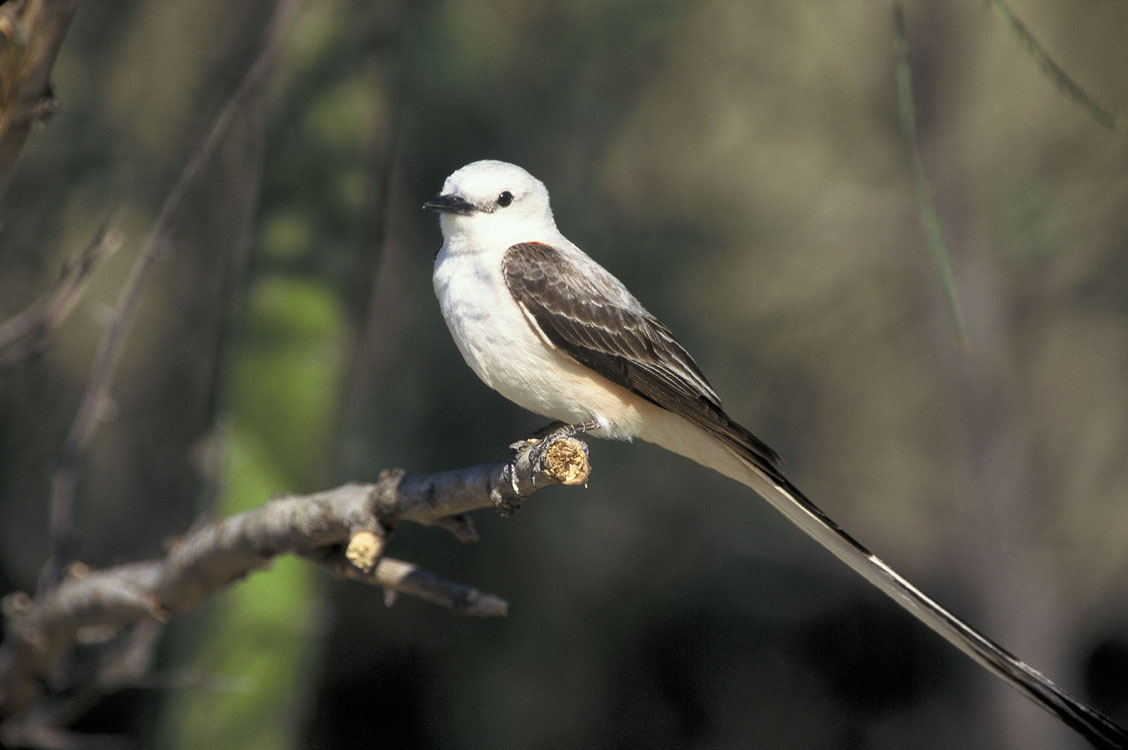
Wikipedia: Scissor-tailed flycatcher Source: OTHER
Tyrannus_forficatus_on_branch.jpg
![]() The scissor-tailed flycatcher (Tyrannus forficatus), also known as the Texas bird-of-paradise and swallow-tailed flycatcher, is a long-tailed bird of the genus Tyrannus, whose members are collectively referred to as kingbirds. The kingbirds are a group of large insectivorous (insect-eating) birds in the tyrant flycatcher (Tyrannidae) family. The scissor-tailed flycatcher is found in North and Central America.
[more]
The scissor-tailed flycatcher (Tyrannus forficatus), also known as the Texas bird-of-paradise and swallow-tailed flycatcher, is a long-tailed bird of the genus Tyrannus, whose members are collectively referred to as kingbirds. The kingbirds are a group of large insectivorous (insect-eating) birds in the tyrant flycatcher (Tyrannidae) family. The scissor-tailed flycatcher is found in North and Central America.
[more]
Tropical kingbird / Trauertyrann (Tyrannus melancholicus)
Profile Wikipedia eBird Audubon AllAboutBirds Xeno-Canto
Tropical kingbird tenative ID by MerlinBirdID, tail markings. 2018-02-16 16.21.26 Costa Rica
First observed in Costa Rica on 2018-02-16.
![]() The tropical kingbird (Tyrannus melancholicus) is a large tyrant flycatcher. This bird breeds from southern Arizona and the lower Rio Grande Valley of Texas in the United States through Central America, South America as far as south as central Argentina and eastern Peru, and on Trinidad and Tobago. Birds from the northernmost and southern breeding areas migrate to warmer parts of the range after breeding.
[more]
The tropical kingbird (Tyrannus melancholicus) is a large tyrant flycatcher. This bird breeds from southern Arizona and the lower Rio Grande Valley of Texas in the United States through Central America, South America as far as south as central Argentina and eastern Peru, and on Trinidad and Tobago. Birds from the northernmost and southern breeding areas migrate to warmer parts of the range after breeding.
[more]
Western kingbird / Arkansaskönigstyrann (Tyrannus verticalis)
Profile Wikipedia eBird Audubon AllAboutBirds Xeno-Canto
MerlinBirdID suggests western kingbird, birding tour near Rio Lagartos. 2023-04-15 08.41.04 Yucatan
First observed in Yucatan on 2023-04-15.
![]() The western kingbird (Tyrannus verticalis) is a large tyrant flycatcher found throughout western environments of North America and as far as Mexico.
[more]
The western kingbird (Tyrannus verticalis) is a large tyrant flycatcher found throughout western environments of North America and as far as Mexico.
[more]
Thick-billed kingbird (Tyrannus crassirostris)
Profile Wikipedia eBird Audubon AllAboutBirds Xeno-Canto

Wikipedia: Thick-billed kingbird Source: OTHER
1200px-Thick-billed_Kingbird_%286062989988%29.jpg
![]() The thick-billed kingbird (Tyrannus crassirostris) is a large bird in the family Tyrannidae, the tyrant flycatchers. This bird breeds from southeastern Arizona, extreme southwestern New Mexico, and northern Sonora, (the Madrean sky islands), in the United States and Mexico, through western and western-coastal Mexico, south to western Guatemala.
[more]
The thick-billed kingbird (Tyrannus crassirostris) is a large bird in the family Tyrannidae, the tyrant flycatchers. This bird breeds from southeastern Arizona, extreme southwestern New Mexico, and northern Sonora, (the Madrean sky islands), in the United States and Mexico, through western and western-coastal Mexico, south to western Guatemala.
[more]
Cassin's kingbird (Tyrannus vociferans)
Profile Wikipedia eBird Audubon AllAboutBirds Xeno-Canto
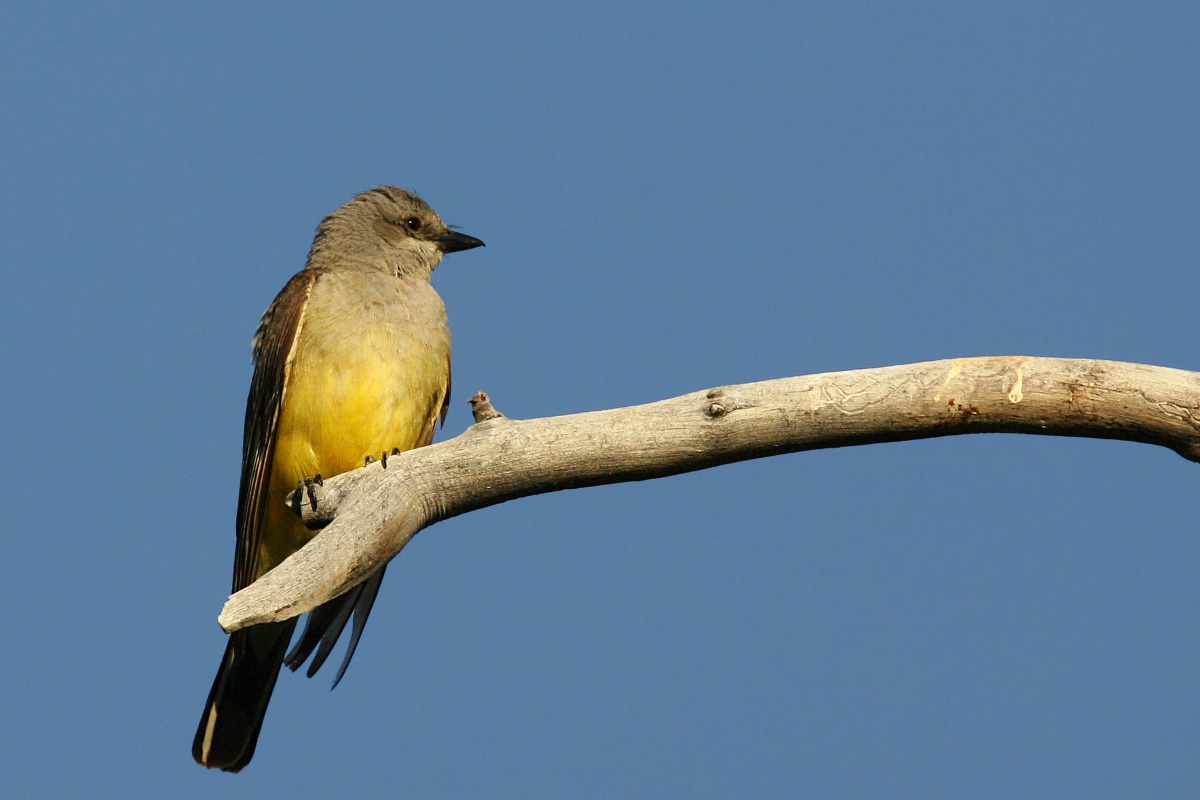
Wikipedia: Cassin's kingbird Source: OTHER
Tyrannus-Vociferans-002.jpg
![]() Cassin's kingbird (Tyrannus vociferans) is a large tyrant flycatcher native to western North America. The name of this bird commemorates the American ornithologist John Cassin.
[more]
Cassin's kingbird (Tyrannus vociferans) is a large tyrant flycatcher native to western North America. The name of this bird commemorates the American ornithologist John Cassin.
[more]
Couch's kingbird (Tyrannus couchii)
Profile Wikipedia eBird Audubon AllAboutBirds Xeno-Canto
Couch's kingbird is a city bird in Campeche. 2023-04-06 16.49.18 Yucatan
First observed in Yucatan on 2023-03-30.
![]() Couch's kingbird (Tyrannus couchii) is a passerine tyrant flycatcher of the kingbird genus. It is found from southern Texas along the Gulf Coast to the Yucatán Peninsula in Mexico, Belize and northern Guatemala. It is also found in the lower stretches of the Rio Grande Valley.[2]
[more]
Couch's kingbird (Tyrannus couchii) is a passerine tyrant flycatcher of the kingbird genus. It is found from southern Texas along the Gulf Coast to the Yucatán Peninsula in Mexico, Belize and northern Guatemala. It is also found in the lower stretches of the Rio Grande Valley.[2]
[more]
Fork-tailed flycatcher (Tyrannus savana)
Profile Wikipedia eBird Audubon AllAboutBirds Xeno-Canto

Wikipedia: Fork-tailed flycatcher Source: OTHER
1200px-Fork-tailed_flycatcher_%28Tyrannus_savana_monachus%29_female.jpg
![]() The fork-tailed flycatcher (Tyrannus savana) is a passerine bird of the tyrant flycatcher family, and is the member of a genus typically referred to as kingbirds. Named for their distinguishingly long forked tail, fork-tailed flycatchers are seen in lightly-forested or grassland areas; ranging from southern Mexico, to south past Argentina. They are most frequently observed sitting on conspicuous perches waiting for flying arthropods to fly past, they then sally out, eat their prey, and return to their perch. Northern populations near southern Mexico tend to be permanent residents, while fork-tailed flycatchers that live further south are migrants with a reputation to wander as far north as the eastern seaboard of the United States.
[more]
The fork-tailed flycatcher (Tyrannus savana) is a passerine bird of the tyrant flycatcher family, and is the member of a genus typically referred to as kingbirds. Named for their distinguishingly long forked tail, fork-tailed flycatchers are seen in lightly-forested or grassland areas; ranging from southern Mexico, to south past Argentina. They are most frequently observed sitting on conspicuous perches waiting for flying arthropods to fly past, they then sally out, eat their prey, and return to their perch. Northern populations near southern Mexico tend to be permanent residents, while fork-tailed flycatchers that live further south are migrants with a reputation to wander as far north as the eastern seaboard of the United States.
[more]
Eastern phoebe / Weißbauch-Phoebetyrann (Sayornis phoebe)

Wikipedia: Eastern phoebe Source: OTHER
1200px-Sayornis_phoebe_-Owen_Conservation_Park%2C_Madison%2C_Wisconsin%2C_USA-8.jpg
First observed in Maryland on 2022-04-28.
![]() The eastern phoebe (Sayornis phoebe) is a small passerine bird. The genus name Sayornis is constructed from the specific part of Charles Lucien Bonaparte's name for Say's phoebe, Muscicapa saya, and Ancient Greek ornis, "bird".[2] Phoebe is an alternative name for the Roman moon-goddess Diana, but it may also have been chosen to imitate the bird's call.[3]
[more]
The eastern phoebe (Sayornis phoebe) is a small passerine bird. The genus name Sayornis is constructed from the specific part of Charles Lucien Bonaparte's name for Say's phoebe, Muscicapa saya, and Ancient Greek ornis, "bird".[2] Phoebe is an alternative name for the Roman moon-goddess Diana, but it may also have been chosen to imitate the bird's call.[3]
[more]
Call:
Automatically generated from Xeno-Canto recording
♫ Source: BirdNet
20220512_115707- birdnet - Eastern Phoebe - 2022-04-28 11:33:45 - birdnet_mobile_5867288364_recording_3278.wav.mp3
2022-05-12 11.57.07 (song?)
Black phoebe / Schwarzkopf-Phoebetyrann (Sayornis nigricans)
Profile Wikipedia eBird Audubon AllAboutBirds Xeno-Canto
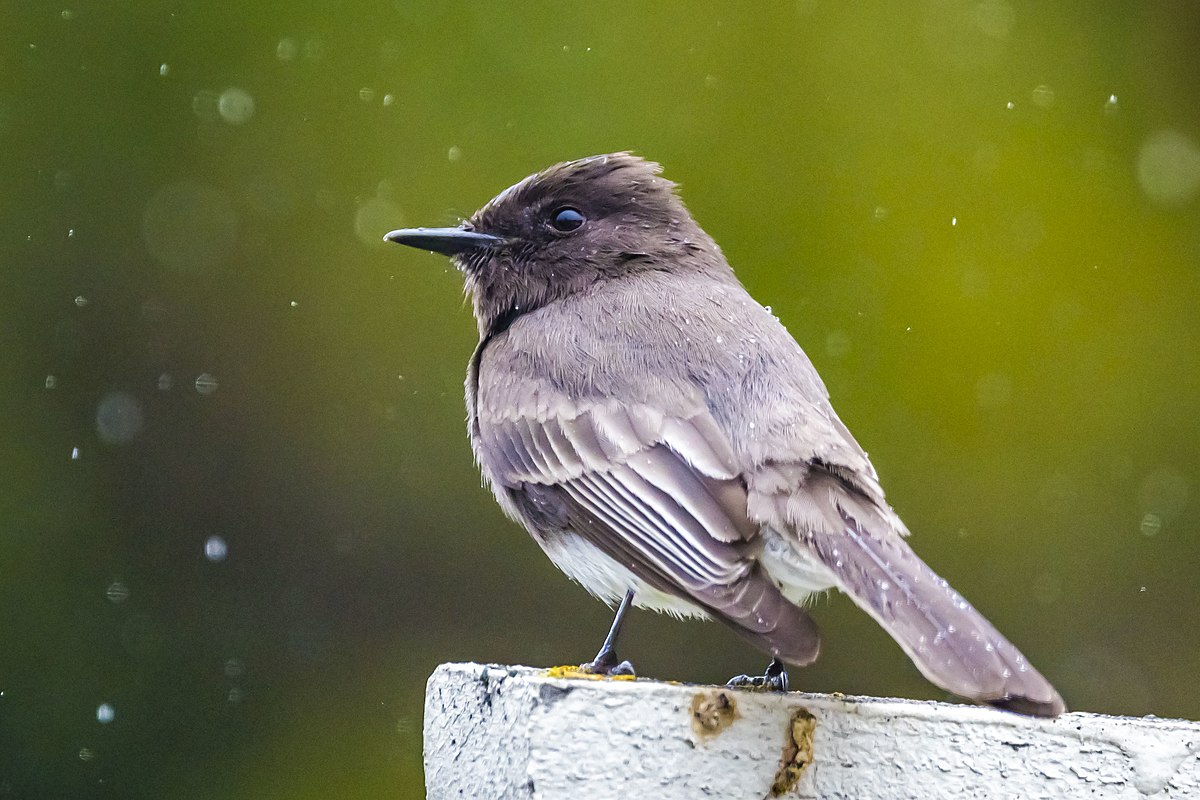
Wikipedia: Black phoebe Source: OTHER
1200px-Black_Phoebe_in_the_Rain.jpg
![]() The black phoebe (Sayornis nigricans) is a passerine bird in the tyrant-flycatcher family. It breeds from southwest Oregon and California south through Central and South America. It occurs year-round throughout most of its range and migrates less than the other birds in its genus, though its northern populations are partially migratory. Six subspecies are commonly recognized, although two are occasionally combined as a separate species, the white-winged phoebe.
[more]
The black phoebe (Sayornis nigricans) is a passerine bird in the tyrant-flycatcher family. It breeds from southwest Oregon and California south through Central and South America. It occurs year-round throughout most of its range and migrates less than the other birds in its genus, though its northern populations are partially migratory. Six subspecies are commonly recognized, although two are occasionally combined as a separate species, the white-winged phoebe.
[more]
Say's phoebe (Sayornis saya)
Profile Wikipedia eBird Audubon AllAboutBirds Xeno-Canto

Wikipedia: Say's phoebe Source: OTHER
Sayornis_saya_6.jpg
![]() Say's phoebe (Sayornis saya) is a passerine bird in the tyrant flycatcher family. A common bird in the western United States, it prefers dry, desolate areas. This bird was named for Thomas Say, the American naturalist.
[more]
Say's phoebe (Sayornis saya) is a passerine bird in the tyrant flycatcher family. A common bird in the western United States, it prefers dry, desolate areas. This bird was named for Thomas Say, the American naturalist.
[more]
Caribbean elaenia (Elaenia martinica)
Profile Wikipedia eBird Audubon AllAboutBirds Xeno-Canto

Wikipedia: Caribbean elaenia Source: OTHER
1200px-Caribbean_Elaenia.jpg
![]() The Caribbean elaenia (Elaenia martinica) is a species of bird in the family Tyrannidae found in the West Indies and parts of Central America. Its natural habitats are tropical and subtropical dry broadleaf forest, subtropical or tropical moist lowland forest, and heavily degraded former forest.
[more]
The Caribbean elaenia (Elaenia martinica) is a species of bird in the family Tyrannidae found in the West Indies and parts of Central America. Its natural habitats are tropical and subtropical dry broadleaf forest, subtropical or tropical moist lowland forest, and heavily degraded former forest.
[more]
Rose-throated becard (Pachyramphus aglaiae)
Profile Wikipedia eBird Audubon AllAboutBirds Xeno-Canto
Xx Rose throated becard. 2023-03-31 09.59.56 Yucatan
First observed in Yucatan on 2023-03-31.
![]() The rose-throated becard (Pachyramphus aglaiae) is a medium-sized member of the family Tityridae. Its genus, Pachyramphus, has traditionally been placed in Cotingidae or Tyrannidae, but evidence strongly suggest it is better placed in Tityridae.[2] This species was named in honour of Aglaé Brelay.[3]
[more]
The rose-throated becard (Pachyramphus aglaiae) is a medium-sized member of the family Tityridae. Its genus, Pachyramphus, has traditionally been placed in Cotingidae or Tyrannidae, but evidence strongly suggest it is better placed in Tityridae.[2] This species was named in honour of Aglaé Brelay.[3]
[more]
Olive-sided flycatcher / Fichtentyrann (Contopus cooperi)
Profile Wikipedia eBird Audubon AllAboutBirds Xeno-Canto

Wikipedia: Olive-sided flycatcher Source: OTHER
Olive-sided_Flycatcher.jpg
![]() The olive-sided flycatcher (Contopus cooperi) is a passerine bird. It is a medium-sized tyrant flycatcher.
[more]
The olive-sided flycatcher (Contopus cooperi) is a passerine bird. It is a medium-sized tyrant flycatcher.
[more]
Eastern wood-pewee (Contopus virens)
Profile Wikipedia eBird Audubon AllAboutBirds Xeno-Canto
Eastern wood pewee, last new bird we discovered - at the parking lot shortly before leaving, Oregon Ridge. 2021-06-19 09.34.10 Maryland
First observed in Maryland on 2021-06-19.
![]() The eastern wood pewee (Contopus virens) is a small tyrant flycatcher from North America. This bird and the western wood pewee (C. sordidulus) were formerly considered to be a single species. The two species are virtually identical in appearance, and can be distinguished most easily by their calls.
[more]
The eastern wood pewee (Contopus virens) is a small tyrant flycatcher from North America. This bird and the western wood pewee (C. sordidulus) were formerly considered to be a single species. The two species are virtually identical in appearance, and can be distinguished most easily by their calls.
[more]
Call:
Automatically generated from Xeno-Canto recording
♫ Source: BirdNet
20220501_084450 birdnet - Eastern Wood-Pewee - 2022-05-01 08:44:50 - Eastern Wood-Pewee - Cockeysville.mp3
2022-05-01 08.44.50 Cockeysville (song?)
Greater pewee (Contopus pertinax)
Profile Wikipedia eBird Audubon AllAboutBirds Xeno-Canto

Wikipedia: Greater pewee Source: OTHER
1200px-Greater_Pewee.jpg
![]() The greater pewee (Contopus pertinax) is a passerine and is in the tyrant flycatcher group. This species' range is further north than the other Mexican species. This bird was formerly known as Coues' flycatcher.
[more]
The greater pewee (Contopus pertinax) is a passerine and is in the tyrant flycatcher group. This species' range is further north than the other Mexican species. This bird was formerly known as Coues' flycatcher.
[more]
Lesser Antillean pewee (Contopus latirostris)
Profile Wikipedia eBird Audubon AllAboutBirds Xeno-Canto

Wikipedia: Lesser Antillean pewee Source: OTHER
1200px-Puerto_Rican_Pewee.JPG
![]() The Lesser Antillean pewee (Contopus latirostris) is a species of bird in the family Tyrannidae.
[more]
The Lesser Antillean pewee (Contopus latirostris) is a species of bird in the family Tyrannidae.
[more]
Western wood-pewee (Contopus sordidulus)
Profile Wikipedia eBird Audubon AllAboutBirds Xeno-Canto
Arenal western wood-pewee tentative ID by MerlinBirdID. 2018-03-01 07.50.38 Costa Rica
First observed in Costa Rica on 2018-03-01.
![]() The western wood pewee (Contopus sordidulus) is a small tyrant flycatcher. Adults are gray-olive on the upperparts[2] with light underparts, washed with olive on the breast. They have two wing bars and a dark bill with yellow at the base of the lower mandible. This bird is very similar in appearance to the eastern wood pewee; the two birds were formerly considered to be one species. The call of C. sordidulus is a loud buzzy peeer; the song consists of three rapid descending tsees ending with a descending peeer.
[more]
The western wood pewee (Contopus sordidulus) is a small tyrant flycatcher. Adults are gray-olive on the upperparts[2] with light underparts, washed with olive on the breast. They have two wing bars and a dark bill with yellow at the base of the lower mandible. This bird is very similar in appearance to the eastern wood pewee; the two birds were formerly considered to be one species. The call of C. sordidulus is a loud buzzy peeer; the song consists of three rapid descending tsees ending with a descending peeer.
[more]
Great crested flycatcher (Myiarchus crinitus)
Profile Wikipedia eBird A-Z Animals Audubon AllAboutBirds Xeno-Canto

Wikipedia: Great crested flycatcher Source: OTHER
Great_Crested_Flycatcher_RWD2.jpg
First observed in 🇨🇭 on 2021-03-18.
![]() The great crested flycatcher (Myiarchus crinitus) is a large insect-eating bird of the tyrant flycatcher family. It is the most widespread member of the genus Myiarchus in North America, and is found over most of the eastern and mid-western portions of the continent.[2] It dwells mostly in the treetops and rarely is found on the ground.[3]
[more]
The great crested flycatcher (Myiarchus crinitus) is a large insect-eating bird of the tyrant flycatcher family. It is the most widespread member of the genus Myiarchus in North America, and is found over most of the eastern and mid-western portions of the continent.[2] It dwells mostly in the treetops and rarely is found on the ground.[3]
[more]
Call:
Automatically generated from Xeno-Canto recording
♫ Source: BirdNet
20210318_165219- birdnet 9 - Great Crested Flycatcher - 2020-02-25 18:26:45 - birdnet_mobile_5867288364_recording_15.wav.mp3
2021-03-18 16.52.19 Fehraltorf (song?)
Ash-throated flycatcher (Myiarchus cinerascens)
Profile Wikipedia eBird Audubon AllAboutBirds Xeno-Canto
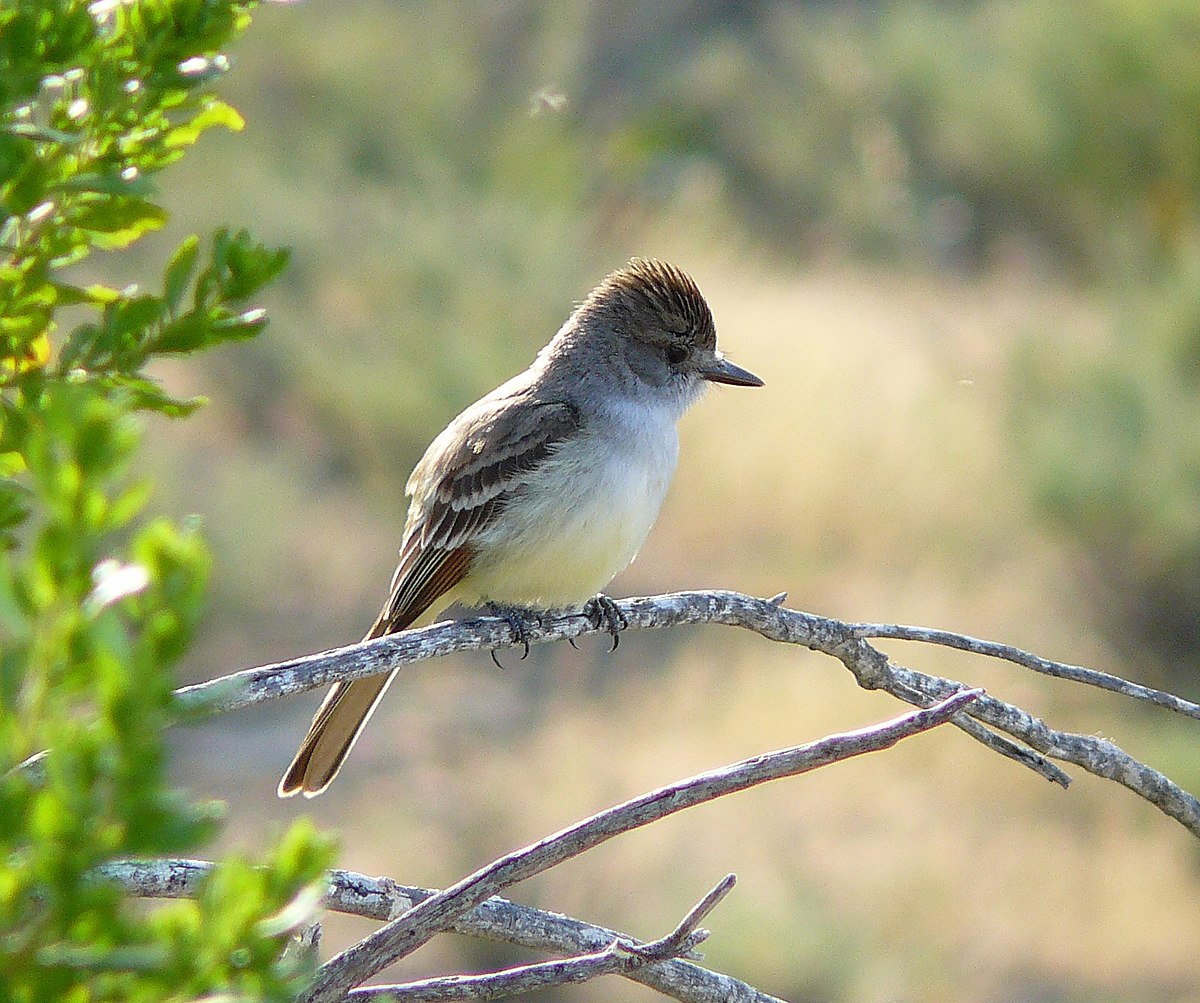
Wikipedia: Ash-throated flycatcher Source: OTHER
1200px-Myiarchus_cinerascens.jpg
![]() The ash-throated flycatcher (Myiarchus cinerascens) is a passerine bird in the tyrant flycatcher family. It breeds in desert scrub, riparian forest, brushy pastures and open woodland from the western United States to central Mexico. It is a short-distance migrant, retreating from most of the U.S. and northern and central Mexico, spending the winter from southern Mexico to Honduras. This bird is also prone to wander, with single birds often seen outside its normal breeding range as far away as the east coast of North America.
[more]
The ash-throated flycatcher (Myiarchus cinerascens) is a passerine bird in the tyrant flycatcher family. It breeds in desert scrub, riparian forest, brushy pastures and open woodland from the western United States to central Mexico. It is a short-distance migrant, retreating from most of the U.S. and northern and central Mexico, spending the winter from southern Mexico to Honduras. This bird is also prone to wander, with single birds often seen outside its normal breeding range as far away as the east coast of North America.
[more]
Brown-crested flycatcher (Myiarchus tyrannulus)
Profile Wikipedia eBird Audubon AllAboutBirds Xeno-Canto
Brown-crested flycatcher in Holbox by a morning walk. 2023-04-21 07.30.58 Yucatan
First observed in Yucatan on 2023-04-07.
![]() The brown-crested flycatcher (Myiarchus tyrannulus) is a passerine bird in the tyrant flycatcher family.
[more]
The brown-crested flycatcher (Myiarchus tyrannulus) is a passerine bird in the tyrant flycatcher family.
[more]
Nutting's flycatcher (Myiarchus nuttingi)

Wikipedia: Nutting's flycatcher Source: OTHER
Nutting%27s_Flycatcher.jpg
![]() Nutting's flycatcher (Myiarchus nuttingi) is a passerine bird in the tyrant flycatcher family. It breeds in semi-arid desert scrub and tropical deciduous forest from western Mexico to northwest Costa Rica. It is normally a year-round resident, but has been known as an occasional vagrant to southern California and Arizona–(southeastern, central, and western), in the United States. It is named for the zoologist Charles Cleveland Nutting.
[more]
Nutting's flycatcher (Myiarchus nuttingi) is a passerine bird in the tyrant flycatcher family. It breeds in semi-arid desert scrub and tropical deciduous forest from western Mexico to northwest Costa Rica. It is normally a year-round resident, but has been known as an occasional vagrant to southern California and Arizona–(southeastern, central, and western), in the United States. It is named for the zoologist Charles Cleveland Nutting.
[more]
La sagra's flycatcher (Myiarchus sagrae)

Wikipedia: La sagra's flycatcher Source: OTHER
Myiarchus_sagrae_-Ciego_de_Avila_Province%2C_Cuba-8.jpg
![]() La Sagra's flycatcher (Myiarchus sagrae) is a passerine bird in the tyrant flycatcher family.
[more]
La Sagra's flycatcher (Myiarchus sagrae) is a passerine bird in the tyrant flycatcher family.
[more]
Dusky-capped flycatcher (Myiarchus tuberculifer)
Profile Wikipedia eBird Audubon AllAboutBirds Xeno-Canto

Wikipedia: Dusky-capped flycatcher Source: OTHER
Myiarchus-tuberculifer-001.jpg
![]() The dusky-capped flycatcher (Myiarchus tuberculifer) is a passerine bird in the tyrant flycatcher family. It breeds in forest and other woodland from southern Arizona, as well as the Chisos Mountains, Texas, south to northern Argentina and on Trinidad. It is resident in most of its range, but American breeders retreat to Mexico in winter.
[more]
The dusky-capped flycatcher (Myiarchus tuberculifer) is a passerine bird in the tyrant flycatcher family. It breeds in forest and other woodland from southern Arizona, as well as the Chisos Mountains, Texas, south to northern Argentina and on Trinidad. It is resident in most of its range, but American breeders retreat to Mexico in winter.
[more]
Sulphur-bellied flycatcher (Myiodynastes luteiventris)
Profile Wikipedia eBird Audubon AllAboutBirds Xeno-Canto
Sulphur-bellied flycatcher, Ecotucan. 2023-04-01 09.30.12 Yucatan
First observed in Yucatan on 2023-04-01.
![]() The sulphur-bellied flycatcher (Myiodynastes luteiventris) is a large tyrant flycatcher. This bird breeds from southeasternmost Arizona of the United States (the Madrean sky islands region of Arizona, southwestern New Mexico, and northern Sonora, Mexico) to Costa Rica. They are short distance migrants, spending winters in the eastern Andean foothills of Colombia, Ecuador, Peru, Bolivia, and Brazil, and are passage migrants over the southern portions of Central America.
[more]
The sulphur-bellied flycatcher (Myiodynastes luteiventris) is a large tyrant flycatcher. This bird breeds from southeasternmost Arizona of the United States (the Madrean sky islands region of Arizona, southwestern New Mexico, and northern Sonora, Mexico) to Costa Rica. They are short distance migrants, spending winters in the eastern Andean foothills of Colombia, Ecuador, Peru, Bolivia, and Brazil, and are passage migrants over the southern portions of Central America.
[more]
Great kiskadee / Schwefelmaskentyrann (Pitangus sulphuratus)
Profile Wikipedia eBird A-Z Animals Audubon AllAboutBirds Xeno-Canto
Great kiskadee bird eating fruit. 2018-02-26 10.28.58 Costa Rica
First observed in Costa Rica on 2018-02-26.
![]() The great kiskadee (Pitangus sulphuratus), called bem-te-vi in Brazil, is a passerine bird in the tyrant flycatcher family Tyrannidae. It is the only member of the genus Pitangus.
[more]
The great kiskadee (Pitangus sulphuratus), called bem-te-vi in Brazil, is a passerine bird in the tyrant flycatcher family Tyrannidae. It is the only member of the genus Pitangus.
[more]
Vermilion flycatcher (Pyrocephalus rubinus)
Profile Wikipedia eBird A-Z Animals Audubon AllAboutBirds Xeno-Canto

Wikipedia: Vermilion flycatcher Source: OTHER
1200px-Vermilion_Flycatcher_by_Dan_Pancamo.jpg
![]() The vermilion flycatcher (Pyrocephalus obscurus) is a small passerine bird in the tyrant flycatcher family found throughout South America and southern North America. It is a striking exception among the generally drab Tyrannidae due to its vermilion-red coloration. The males have bright red crowns, chests, and underparts, with brownish wings and tails. Females lack the vivid red coloration and can be hard to identify—they may be confused for the Say's phoebe. The vermilion flycatcher's song is a pit pit pit pidddrrrreeedrr, which is variable and important in establishing a territory. Riparian habitats and semi-open environments are preferred. As aerial insectivores, they catch their prey while flying. Their several months-long molt begins in summer.
[more]
The vermilion flycatcher (Pyrocephalus obscurus) is a small passerine bird in the tyrant flycatcher family found throughout South America and southern North America. It is a striking exception among the generally drab Tyrannidae due to its vermilion-red coloration. The males have bright red crowns, chests, and underparts, with brownish wings and tails. Females lack the vivid red coloration and can be hard to identify—they may be confused for the Say's phoebe. The vermilion flycatcher's song is a pit pit pit pidddrrrreeedrr, which is variable and important in establishing a territory. Riparian habitats and semi-open environments are preferred. As aerial insectivores, they catch their prey while flying. Their several months-long molt begins in summer.
[more]
Northern beardless-tyrannulet (Camptostoma imberbe)
Profile Wikipedia eBird Audubon AllAboutBirds Xeno-Canto

Wikipedia: Northern beardless-tyrannulet Source: OTHER
1200px-Northern_Beardless-Tyrannulet_%2818560065092%29.jpg
![]() The northern beardless tyrannulet (Camptostoma imberbe) is a small passerine bird in the tyrant flycatcher family. It breeds from southeasternmost Arizona and Texas of the United States through Mexico and Central America to northwestern Costa Rica.
[more]
The northern beardless tyrannulet (Camptostoma imberbe) is a small passerine bird in the tyrant flycatcher family. It breeds from southeasternmost Arizona and Texas of the United States through Mexico and Central America to northwestern Costa Rica.
[more]
White-rumped shama (Copsychus malabaricus)
Profile Wikipedia eBird Audubon AllAboutBirds Xeno-Canto
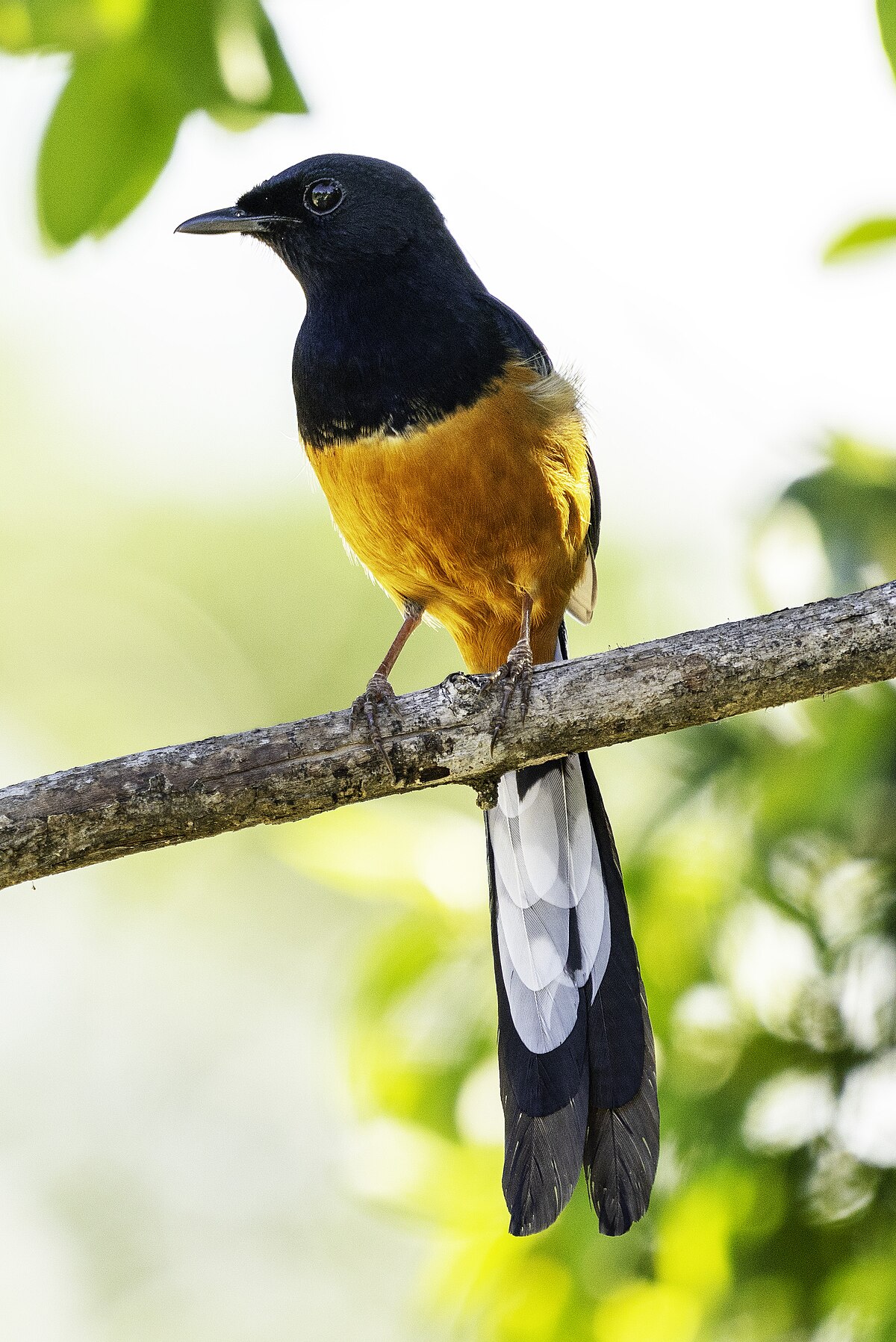
Wikipedia: White-rumped shama Source: OTHER
1200px-White-rumped-shama-yala-sri-lanka-casey-klebba.jpg
This bird appears across the great seas in the following continents:
North America, Asia.
![]() The white-rumped shama (Copsychus malabaricus) is a small passerine bird of the family Muscicapidae. Native to densely vegetated habitats in the Indian subcontinent and Southeast Asia, its popularity as a cage-bird and songster has led to it being introduced elsewhere.
[more]
The white-rumped shama (Copsychus malabaricus) is a small passerine bird of the family Muscicapidae. Native to densely vegetated habitats in the Indian subcontinent and Southeast Asia, its popularity as a cage-bird and songster has led to it being introduced elsewhere.
[more]
Northern wheatear / Steinschmätzer (Oenanthe oenanthe)
Profile Wikipedia eBird Vogelwarte BirdLife ZH ornitho.ch Audubon AllAboutBirds Xeno-Canto BirdID NABU

Male northern wheatear, photo by Andreas Trepte - Own work, CC BY-SA 2.5 Source: WIKIPEDIA
Wikimedia Steinschmaetzer_Northern_wheatear_male.jpg
First observed in 🇨🇭 on 2021-07-29.
This bird appears across the great seas in the following continents:
Europe, North America, Africa.
General: I thought after seeing these at over 2700 meters that they must be a typical mountain bird (and in the FOK Zurich materials they were in the mountain section), however Wikipedia explains that such a stony landscape is the key, whether that is high or not:
Geography: ![]() The northern wheatear is a migratory insectivorous species breeding in open stony country in Europe and east across the Palearctic with footholds in northeastern Canada and Greenland as well as in northwestern Canada and Alaska. It nests in rock crevices and rabbit burrows. All birds spend most of their winter in Africa. ... Miniature tracking devices have recently shown that the northern wheatear has one of the longest migratory flights known - 30,000 km (18,640 miles), from sub-Saharan Africa to their Arctic breeding grounds.[15] [Link]
The northern wheatear is a migratory insectivorous species breeding in open stony country in Europe and east across the Palearctic with footholds in northeastern Canada and Greenland as well as in northwestern Canada and Alaska. It nests in rock crevices and rabbit burrows. All birds spend most of their winter in Africa. ... Miniature tracking devices have recently shown that the northern wheatear has one of the longest migratory flights known - 30,000 km (18,640 miles), from sub-Saharan Africa to their Arctic breeding grounds.[15] [Link]
Strangely the residence and migration maps differ greatly by source: in Wikipedia the northern wheatear spends winter in subsaharan Africa, while the authoratitive Kosmos-Vogelführer shows some in northern Africa like Morocco. Most other sources agree with Wikipedia and Sub-Saharan Africa.
I thought the German name Steinschmätzer, presumably stone kisser (no one explains it, oddly enough) to be much more logical than the English northern wheatear. I was greatly amused to look it up and find it to be a 'folk etymology of "white" and "arse"' (Wikipedia).
Etymology: ![]() The genus name Oenanthe is derived from the Greek oenos (οίνος) "wine" and anthos (ανθός) "flower". It refers to the northern wheatear's return to Greece in the spring just as the grapevines blossom. [Link]
The genus name Oenanthe is derived from the Greek oenos (οίνος) "wine" and anthos (ανθός) "flower". It refers to the northern wheatear's return to Greece in the spring just as the grapevines blossom. [Link]
It has an evil-looking black eye stripe like the shrike. (I liked Nici Baiker's description of it in the FOK field ornithology course as 'Zorro look'.) I saw one flying on Muottas Muragl and thought the striking gray oval surrounded by dark feathers has to be typical and seems unique to the northern wheatear.
In den FOK Unterlagen werden die Zugrouten von Alaska und von nordosten Kanada gezeigt, die beide fuer Winter nach Afrika ziehen. Die aus Alaska fliegen ueber Asien unglaubliche 15000 Kilometer! Die in Kanada haben es auch nicht leicht, da sie zuerst ueber den Atlantik nach Spanien fliegen!
Vocalization: ![]() Each phrase is often introduced by the "weet" sound, then followed by hastened, creaking, rattling and warbling sounds of 1-2 seconds duration. [Link]
Each phrase is often introduced by the "weet" sound, then followed by hastened, creaking, rattling and warbling sounds of 1-2 seconds duration. [Link]
Song: ![]() Kurze, wechselvolle Strophe mit vielen unreinen Tönen. Meist von erhöhter Warte aus oder in kurzem Singflug vorgetragen.
[Link]
Kurze, wechselvolle Strophe mit vielen unreinen Tönen. Meist von erhöhter Warte aus oder in kurzem Singflug vorgetragen.
[Link]
![]() The Wheatear song consists of short phrases with marked pauses. The "check" sound is also often included in the song. [Link]
The Wheatear song consists of short phrases with marked pauses. The "check" sound is also often included in the song. [Link]
Calls: ![]() „Tschack“ auch „hiit“ (saugend)
[Link]
„Tschack“ auch „hiit“ (saugend)
[Link]
![]() Contact and alarm call a high pitched, sharp "weet", followed by a hard "check", like hitting two rocks together. The "weet" sound is much sharper than the similar sound in Whinchat and Stonechat. Wheater usually repeats the "weet" sound more frequently than the "check" sound. The "check" of Stonechat is less pure and more gritty. [Link]
Contact and alarm call a high pitched, sharp "weet", followed by a hard "check", like hitting two rocks together. The "weet" sound is much sharper than the similar sound in Whinchat and Stonechat. Wheater usually repeats the "weet" sound more frequently than the "check" sound. The "check" of Stonechat is less pure and more gritty. [Link]
Physical details: length=14-15 cm,
wingspan=26-32 cm,
weight=18-29 g
Habitats:
Mountain
Looks similar to:
Red-backed shrike.
Song:
![]() The Wheatear song consists of short phrases with marked pauses. Each phrase is often introduced by the "weet" sound, then followed by hastened, creaking, rattling and warbling sounds of 1-2 seconds duration. The "check" sound is also often included in the song. [Link]
The Wheatear song consists of short phrases with marked pauses. Each phrase is often introduced by the "weet" sound, then followed by hastened, creaking, rattling and warbling sounds of 1-2 seconds duration. The "check" sound is also often included in the song. [Link]
Song attributes:
Melody: improvised melodic, fast, Frequency: 2-6 KHz Special sounds: rasp, rattle
♫ Source: XENOCANTO
XC730221 - Northern Wheatear - Oenanthe oenanthe - song recorded in France, just 2-3 notes, then long pause.mp3
(song)

♫ Source: XENOCANTO
XC764932 - Northern Wheatear - Oenanthe oenanthe - song recorded in Sweden with lots of whoops and swoops, about 2 seconds long, then 3-4 seconds pause.mp3
(song)

♫ Source: XENOCANTO
XC319898 - Northern Wheatear - Oenanthe oenanthe - song recorded in Scotland and includes creaking or rattling mentioned at Nord U BirdID.mp3
Scotland (song)

♫ Source: XENOCANTO
XC769228 - Northern Wheatear - Oenanthe oenanthe - song recorded in the Netherlands.mp3
(song)

Call:
Automatically generated from Xeno-Canto recording
♫ Source: BirdNet
20210729_130731 birdnet 1864 - Northern Wheatear at lej muragl - Northern Wheatear - Samedan.mp3
2021-07-29 13.07.31 Lej muragl (song?)
Siberian rubythroat / Rubinkehlchen (Calliope calliope)
Siberian rubythroat, near the Mekong in Vientiane. 2024-02-18 07.33.56 Laos
First observed in Laos on 2024-02-18.
This bird appears across the great seas in the following continents:
North America, Asia.
General: ![]() The Siberian rubythroat (Calliope calliope) is a small passerine bird first described by Peter Simon Pallas in 1776. It was formerly classed as a member of the thrush family, Turdidae, but is now more generally considered to be an Old World flycatcher of the family Muscicapidae.[3] The Siberian rubythroat and similar small European species are often called chats.
[more]
The Siberian rubythroat (Calliope calliope) is a small passerine bird first described by Peter Simon Pallas in 1776. It was formerly classed as a member of the thrush family, Turdidae, but is now more generally considered to be an Old World flycatcher of the family Muscicapidae.[3] The Siberian rubythroat and similar small European species are often called chats.
[more]
Song:
Automatically generated from Xeno-Canto recording
Song attributes:
Frequency:
♫ XC843510 - Siberian Rubythroat - Calliope calliope - song, Vientiane Prefecture, Laos. Source: XENOCANTO
XC843510 - Siberian Rubythroat - Calliope calliope - song, Vientiane Prefecture, Laos.mp3
Laos (song)
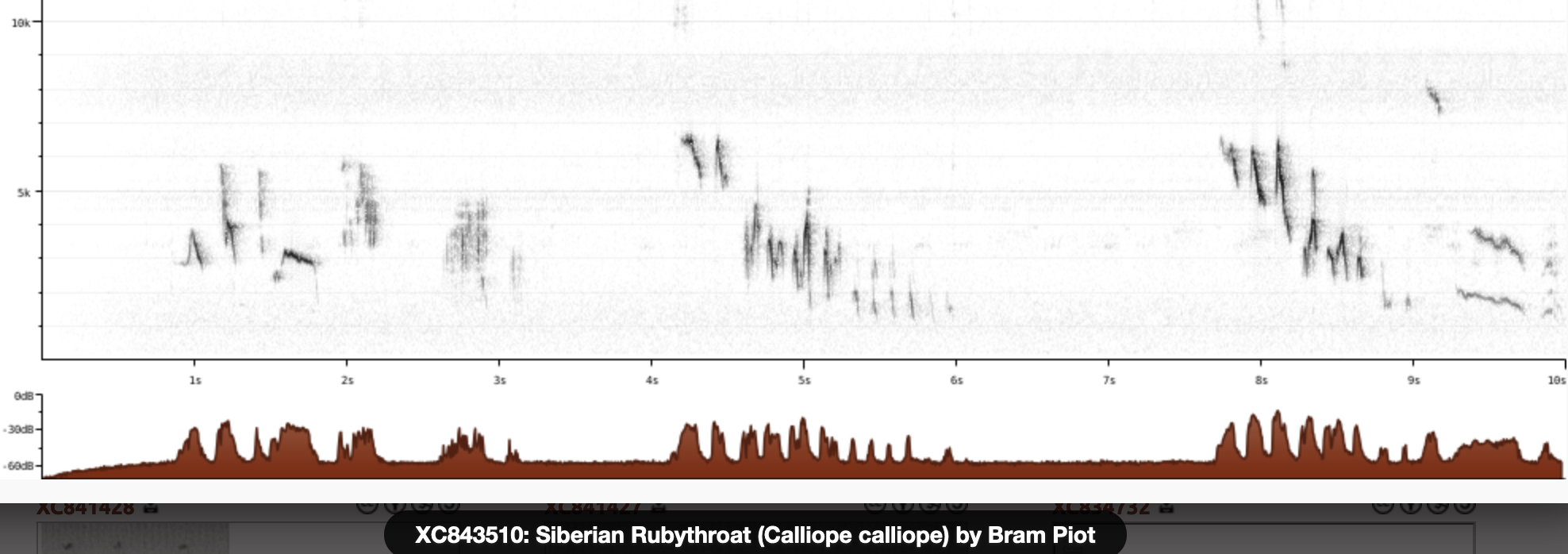
Brown-headed nuthatch / Braunkopfkleiber (Sitta pusilla)
Profile Wikipedia eBird Audubon AllAboutBirds Xeno-Canto
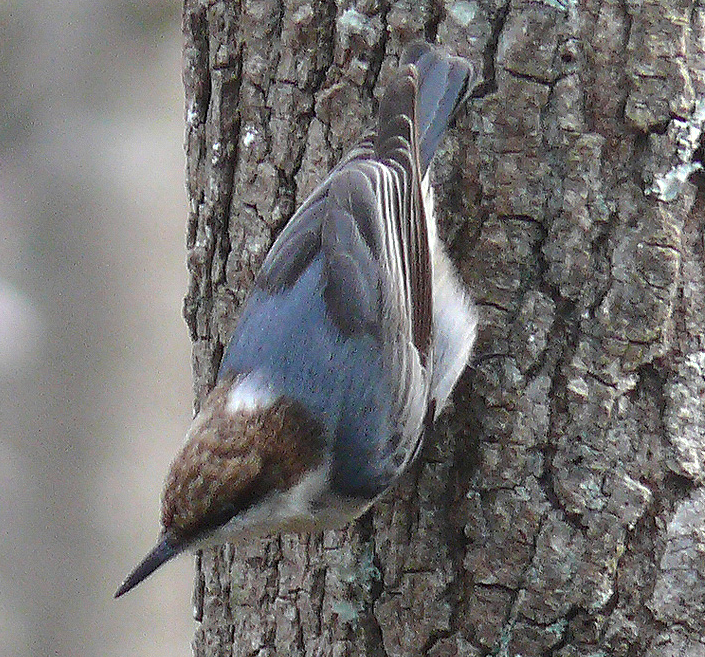
Wikipedia: Brown-headed nuthatch Source: OTHER
Brown-headed_Nuthatch-27527-4c.jpg
![]() The brown-headed nuthatch (Sitta pusilla) is a small songbird found in pine forests throughout the Southeastern United States. Genetic analyses indicated low differentiation between northern and southern populations in Florida, but the study also found lower genetic diversity among south Florida populations that may be a result of the increased habitat fragmentation that was documented. A population on the Bahamas showed moderate to high differentiation compared with Florida populations.[2] The Bahama nuthatch was and still is considered a subspecies (S. p. insularis) by several authorities including the IOC, but the IUCN and BirdLife International have reclassified it as its own separate species.[3] Two recent studies assessing vocalizations in Bahama and continental nuthatch populations found important differences.[4][5] One of the studies[4] also demonstrated that continental and Bahama populations did not respond aggressively to calls of the other population. This type of call-response study is often used to help define cryptic species.[6]
[more]
The brown-headed nuthatch (Sitta pusilla) is a small songbird found in pine forests throughout the Southeastern United States. Genetic analyses indicated low differentiation between northern and southern populations in Florida, but the study also found lower genetic diversity among south Florida populations that may be a result of the increased habitat fragmentation that was documented. A population on the Bahamas showed moderate to high differentiation compared with Florida populations.[2] The Bahama nuthatch was and still is considered a subspecies (S. p. insularis) by several authorities including the IOC, but the IUCN and BirdLife International have reclassified it as its own separate species.[3] Two recent studies assessing vocalizations in Bahama and continental nuthatch populations found important differences.[4][5] One of the studies[4] also demonstrated that continental and Bahama populations did not respond aggressively to calls of the other population. This type of call-response study is often used to help define cryptic species.[6]
[more]
White-breasted nuthatch / Carolinakleiber (Sitta carolinensis)
Profile Wikipedia eBird Audubon AllAboutBirds Xeno-Canto
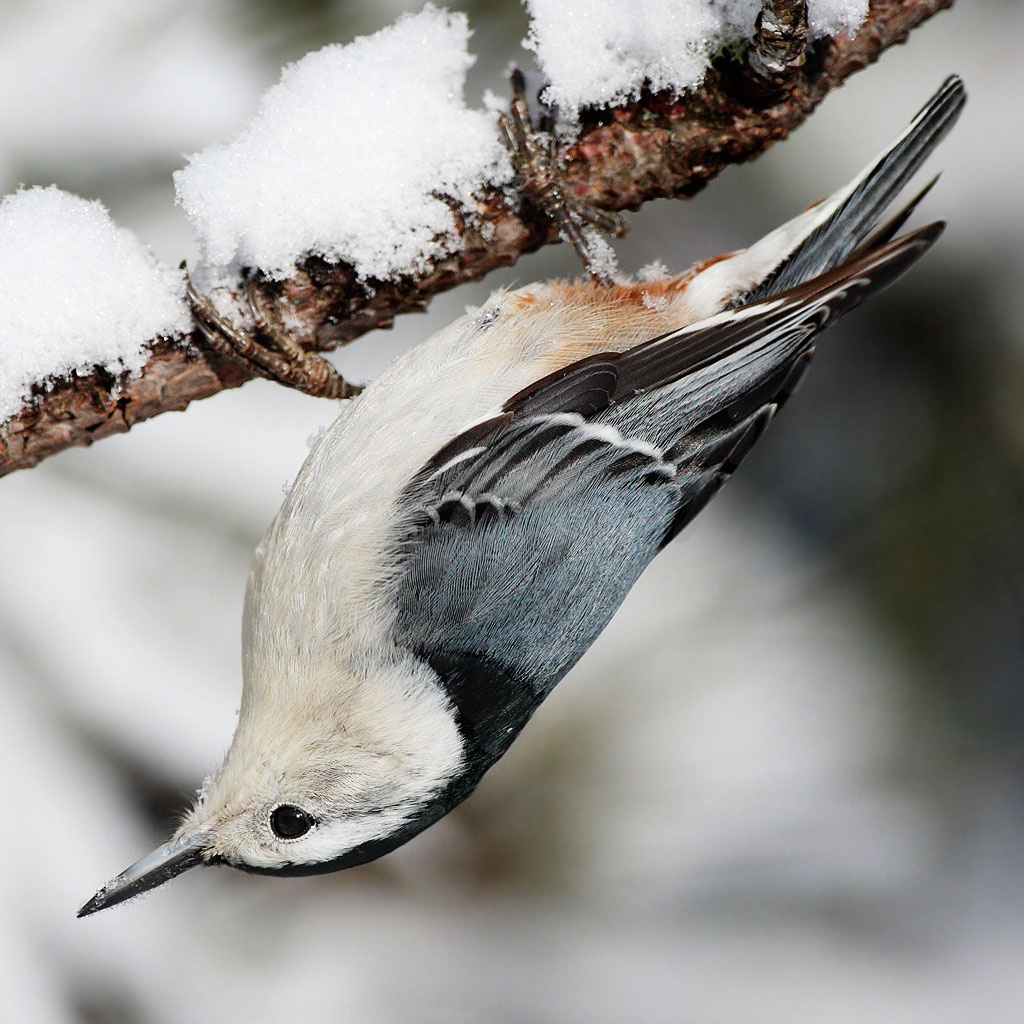
Wikipedia: White-breasted nuthatch Source: OTHER
Sitta-carolinensis-001.jpg
![]() The white-breasted nuthatch (Sitta carolinensis) is a small songbird of the nuthatch family common across much of temperate North America. It is stocky, with a large head, short tail, powerful bill, and strong feet. It has a black cap, white face, chest, and flanks, blue-gray upperparts, and a chestnut lower belly. Its nine subspecies differ mainly in the color of the body plumage.
[more]
The white-breasted nuthatch (Sitta carolinensis) is a small songbird of the nuthatch family common across much of temperate North America. It is stocky, with a large head, short tail, powerful bill, and strong feet. It has a black cap, white face, chest, and flanks, blue-gray upperparts, and a chestnut lower belly. Its nine subspecies differ mainly in the color of the body plumage.
[more]
Red-breasted nuthatch / Kanadakleiber (Sitta canadensis)
Profile Wikipedia eBird Audubon AllAboutBirds Xeno-Canto

Wikipedia: Red-breasted nuthatch Source: OTHER
1200px-Sitta_canadensis_CT2.jpg
![]() The red-breasted nuthatch (Sitta canadensis) is a small songbird. The adult has blue-grey upperparts with cinnamon underparts, a white throat and face with a black stripe through the eyes, a straight grey bill and a black crown. Its call, which has been likened to a tin trumpet, is high-pitched and nasal. It breeds in coniferous forests across Canada, Alaska and the northeastern and western United States. Though often a permanent resident, it regularly irrupts further south if its food supply fails. There are records of vagrants occurring as far south as the Gulf Coast and northern Mexico. It forages on the trunks and large branches of trees, often descending head first, sometimes catching insects in flight. It eats mainly insects and seeds, especially from conifers. It excavates its nest in dead wood, often close to the ground, smearing the entrance with pitch.
[more]
The red-breasted nuthatch (Sitta canadensis) is a small songbird. The adult has blue-grey upperparts with cinnamon underparts, a white throat and face with a black stripe through the eyes, a straight grey bill and a black crown. Its call, which has been likened to a tin trumpet, is high-pitched and nasal. It breeds in coniferous forests across Canada, Alaska and the northeastern and western United States. Though often a permanent resident, it regularly irrupts further south if its food supply fails. There are records of vagrants occurring as far south as the Gulf Coast and northern Mexico. It forages on the trunks and large branches of trees, often descending head first, sometimes catching insects in flight. It eats mainly insects and seeds, especially from conifers. It excavates its nest in dead wood, often close to the ground, smearing the entrance with pitch.
[more]
Pygmy nuthatch (Sitta pygmaea)
Profile Wikipedia eBird Audubon AllAboutBirds Xeno-Canto

Wikipedia: Pygmy nuthatch Source: OTHER
Pygmy_Nuthatch_%28Sitta_pygmaea%292_-California.jpg
![]() The pygmy nuthatch (Sitta pygmaea) is a tiny songbird, about 10 cm (4 inches) long and about 10 grams in weight.
[more]
The pygmy nuthatch (Sitta pygmaea) is a tiny songbird, about 10 cm (4 inches) long and about 10 grams in weight.
[more]
Brown thrasher / Rotspottdrossel (Toxostoma rufum)
Profile Wikipedia eBird Audubon AllAboutBirds Xeno-Canto

Wikipedia: Brown thrasher Source: OTHER
1200px-Brown_thrasher_in_CP_%2802147%29.jpg
First observed in Cockeysville on 2022-04-29.
![]() The brown thrasher (Toxostoma rufum) is a bird in the family Mimidae, which also includes the New World catbirds and mockingbirds. The brown thrasher is abundant throughout the eastern and central United States and southern and central Canada, and it is the only thrasher to live primarily east of the Rockies and central Texas. It is the state bird of Georgia.
[more]
The brown thrasher (Toxostoma rufum) is a bird in the family Mimidae, which also includes the New World catbirds and mockingbirds. The brown thrasher is abundant throughout the eastern and central United States and southern and central Canada, and it is the only thrasher to live primarily east of the Rockies and central Texas. It is the state bird of Georgia.
[more]
Call:
Automatically generated from Xeno-Canto recording
♫ Source: BirdNet
20220429_082734 birdnet - Brown Thrasher - Brown Thrasher - Cockeysville.mp3
2022-04-29 08.27.34 Cockeysville (song?)
Crissal thrasher (Toxostoma crissale)
Profile Wikipedia eBird Audubon AllAboutBirds Xeno-Canto

Wikipedia: Crissal thrasher Source: OTHER
1200px-Toxostoma_crissale.jpg
![]() The crissal thrasher (Toxostoma crissale) is a large thrasher found in the Southwestern United States (western Texas, southern New Mexico, southern Arizona, southeastern California, extreme southern Nevada, and extreme southwestern Utah) to central Mexico.
[more]
The crissal thrasher (Toxostoma crissale) is a large thrasher found in the Southwestern United States (western Texas, southern New Mexico, southern Arizona, southeastern California, extreme southern Nevada, and extreme southwestern Utah) to central Mexico.
[more]
California thrasher (Toxostoma redivivum)
Profile Wikipedia eBird Audubon AllAboutBirds Xeno-Canto

Wikipedia: California thrasher Source: OTHER
1200px-Toxostoma_redivivum_-Morro_Bay%2C_California%2C_USA-8.jpg
![]() The California thrasher (Toxostoma redivivum) is a large thrasher found primarily in chaparral habitat in California and Baja California. Similar to the crissal and Le Conte's thrashers in habit, the California thrasher is the only species of Toxostoma throughout most of its limited range. Like most thrashers, it rarely flies in the open, preferring to keep hidden in dense brush. Therefore, while it is common throughout much of its range, it is rarely seen.
[more]
The California thrasher (Toxostoma redivivum) is a large thrasher found primarily in chaparral habitat in California and Baja California. Similar to the crissal and Le Conte's thrashers in habit, the California thrasher is the only species of Toxostoma throughout most of its limited range. Like most thrashers, it rarely flies in the open, preferring to keep hidden in dense brush. Therefore, while it is common throughout much of its range, it is rarely seen.
[more]
Long-billed thrasher (Toxostoma longirostre)
Profile Wikipedia eBird Audubon AllAboutBirds Xeno-Canto

Wikipedia: Long-billed thrasher Source: OTHER
Toxostoma_longirostre_-Laguna_Atascosa_National_Wildlife_Refuge%2C_Texas%2C_USA-8.jpg
![]() The long-billed thrasher (Toxostoma longirostre) is a medium-sized resident songbird of South Texas and eastern Mexico. It bears a strong resemblance to its close relative the brown thrasher in appearance, calls, and various other behaviors; however, the two species do not overlap in range except in the winter when the brown thrasher will temporarily reside in the northern range of the long-billed.[2]
[more]
The long-billed thrasher (Toxostoma longirostre) is a medium-sized resident songbird of South Texas and eastern Mexico. It bears a strong resemblance to its close relative the brown thrasher in appearance, calls, and various other behaviors; however, the two species do not overlap in range except in the winter when the brown thrasher will temporarily reside in the northern range of the long-billed.[2]
[more]
Bendire's thrasher (Toxostoma bendirei)
Profile Wikipedia eBird Audubon AllAboutBirds Xeno-Canto

Wikipedia: Bendire's thrasher Source: OTHER
1200px-Bendires_Thrasher_%28Toxostoma_bendirei%29_%286960355495%29.jpg
![]() Bendire's thrasher (Toxostoma bendirei) is a medium-sized species of thrasher native to the southwestern United States and northwestern Mexico. It is 23–28 centimetres (9.1–11.0 in) long, with a long tail and a medium-sized bill. Coloration is grayish-brown on its upperparts with paler, faintly dark streaked underparts. The base of the lower bill is often pale, the eyes are bright yellow, and the tips of the tail are white-tipped.
[more]
Bendire's thrasher (Toxostoma bendirei) is a medium-sized species of thrasher native to the southwestern United States and northwestern Mexico. It is 23–28 centimetres (9.1–11.0 in) long, with a long tail and a medium-sized bill. Coloration is grayish-brown on its upperparts with paler, faintly dark streaked underparts. The base of the lower bill is often pale, the eyes are bright yellow, and the tips of the tail are white-tipped.
[more]
Curve-billed thrasher (Toxostoma curvirostre)

Wikipedia: Curve-billed thrasher Source: OTHER
1200px-Curve-billed_Thrasher.jpg
![]() The curve-billed thrasher (Toxostoma curvirostre) is a medium-sized mimid native to the deserts of the southwestern United States and much of Mexico. It is a non-migratory species, and throughout most of its range it is the most common desert thrasher.[2] Several subspecies have been classified since 1827, though there is no consensus on the number. Allopatric speciation is believed to have played a major role in the variations of the curve-billed. It is grey-brown overall with a slightly curved bill, and is similar in appearance to the related Bendire's thrasher. It generally resides in desert regions of the United States and Mexico, but can inhabit areas predominately populated by humans.
[more]
The curve-billed thrasher (Toxostoma curvirostre) is a medium-sized mimid native to the deserts of the southwestern United States and much of Mexico. It is a non-migratory species, and throughout most of its range it is the most common desert thrasher.[2] Several subspecies have been classified since 1827, though there is no consensus on the number. Allopatric speciation is believed to have played a major role in the variations of the curve-billed. It is grey-brown overall with a slightly curved bill, and is similar in appearance to the related Bendire's thrasher. It generally resides in desert regions of the United States and Mexico, but can inhabit areas predominately populated by humans.
[more]
Le conte's thrasher (Toxostoma lecontei)

Wikipedia: Le conte's thrasher Source: OTHER
Le_Conte%27s_Thrasher.jpg
![]() LeConte's thrasher (Toxostoma lecontei) is a pale bird found in the southwestern United States and northwestern Mexico. It prefers to live in deserts with very little vegetation, where it blends in with the sandy soils. LeConte's thrashers are nonmigratory birds that reside in the same territory annually. Although the species has been decreasing in certain areas of its range, in particular California, it still is abundant enough to not be considered for vulnerable status.
[more]
LeConte's thrasher (Toxostoma lecontei) is a pale bird found in the southwestern United States and northwestern Mexico. It prefers to live in deserts with very little vegetation, where it blends in with the sandy soils. LeConte's thrashers are nonmigratory birds that reside in the same territory annually. Although the species has been decreasing in certain areas of its range, in particular California, it still is abundant enough to not be considered for vulnerable status.
[more]
Bahama mockingbird (Mimus gundlachii)

Wikipedia: Bahama mockingbird Source: OTHER
1200px-Mimus_gundlachii_-Ciego_de_Avila_Province%2C_Cuba-8_%282%29.jpg
![]() The Bahama mockingbird (Mimus gundlachii) is a species of bird in the family Mimidae.
It is found in the Bahamas, Cuba, Jamaica and the Turks and Caicos Islands, and is a vagrant to Florida.[2] Its natural habitats are subtropical or tropical dry forest, subtropical or tropical moist lowland forest, subtropical or tropical dry shrubland, and heavily degraded former forest.
[more]
The Bahama mockingbird (Mimus gundlachii) is a species of bird in the family Mimidae.
It is found in the Bahamas, Cuba, Jamaica and the Turks and Caicos Islands, and is a vagrant to Florida.[2] Its natural habitats are subtropical or tropical dry forest, subtropical or tropical moist lowland forest, subtropical or tropical dry shrubland, and heavily degraded former forest.
[more]
Northern mockingbird / Gartenspottdrossel (Mimus polyglottos)
Northern mockingbird with its very long legs and tails, Cherrywood Court. 2021-06-17 05.53.30 Maryland
First observed in Maryland on 2021-06-17.
![]() The northern mockingbird (Mimus polyglottos) is a mockingbird commonly found in North America. This bird is mainly a permanent resident, but northern birds may move south during harsh weather. This species has rarely been observed in Europe. This species was first described by Carl Linnaeus in his 1758 10th edition of Systema Naturae as Turdus polyglottos. The northern mockingbird is known for its mimicking ability, as reflected by the meaning of its scientific name, "many-tongued thrush". The northern mockingbird has gray to brown upper feathers and a paler belly. Its tail and wings have white patches which are visible in flight.[2]
[more]
The northern mockingbird (Mimus polyglottos) is a mockingbird commonly found in North America. This bird is mainly a permanent resident, but northern birds may move south during harsh weather. This species has rarely been observed in Europe. This species was first described by Carl Linnaeus in his 1758 10th edition of Systema Naturae as Turdus polyglottos. The northern mockingbird is known for its mimicking ability, as reflected by the meaning of its scientific name, "many-tongued thrush". The northern mockingbird has gray to brown upper feathers and a paler belly. Its tail and wings have white patches which are visible in flight.[2]
[more]
Call:
Automatically generated from Xeno-Canto recording
♫ Probably northern mockingbird at Silversage Court, Hunt Valley. 2021-06-20 08.51.26 Maryland (song?)
Grey catbird / Katzendrossel (Dumetella carolinensis)
Gray catbird. 2022-04-30 09.51.08 Maryland
First observed in Cockeysville on 2021-06-11.
![]() The gray catbird (Dumetella carolinensis), also spelled grey catbird, is a medium-sized North American and Central American perching bird of the mimid family. It is the only member of the "catbird" genus Dumetella. Like the black catbird (Melanoptila glabrirostris), it is among the basal lineages of the Mimidae, probably a closer relative of the Caribbean thrasher and trembler assemblage than of the mockingbirds and Toxostoma thrashers.[2][3] In some areas it is known as the slate-colored mockingbird.[4]
[more]
The gray catbird (Dumetella carolinensis), also spelled grey catbird, is a medium-sized North American and Central American perching bird of the mimid family. It is the only member of the "catbird" genus Dumetella. Like the black catbird (Melanoptila glabrirostris), it is among the basal lineages of the Mimidae, probably a closer relative of the Caribbean thrasher and trembler assemblage than of the mockingbirds and Toxostoma thrashers.[2][3] In some areas it is known as the slate-colored mockingbird.[4]
[more]
Song:
Automatically generated from Xeno-Canto recording
Song attributes:
Frequency:
♫ Gray catbird weird song, Cherrywood Court. 2021-06-16 07.38.03 Cherrywood (song)
Call:
Automatically generated from Xeno-Canto recording
♫ Source: BirdNet
20220503_083848 birdnet - Gray Catbird - 2022-05-03 08:38:48 - Gray Catbird - Cockeysville.mp3
2022-05-03 08.38.48 Cockeysville (song?)
Pearly-eyed thrasher / Perlaugen-Spottdrossel (Margarops fuscatus)
Profile Wikipedia eBird Audubon AllAboutBirds Xeno-Canto

Wikipedia: Pearly-eyed thrasher Source: OTHER
1200px-Margarops_fuscatus_-Guana_Island%2C_British_Virgin_Islands-8.jpg
![]() The pearly-eyed thrasher (Margarops fuscatus) is a bird in the thrasher family Mimidae. It is found on many Caribbean islands, from the Bahamas in the north to the Grenadines in the south, with an isolated population on Bonaire. At least two subspecies can be distinguished genetically: Margarops fuscatus fuscatus which is found between the Greater Antilles and Antigua and Barbuda, M. f. densirostris, occurring from Montserrat and Guadeloupe southwards. Its main habitat is bushes and trees in mountain forests and coffee plantations.
[more]
The pearly-eyed thrasher (Margarops fuscatus) is a bird in the thrasher family Mimidae. It is found on many Caribbean islands, from the Bahamas in the north to the Grenadines in the south, with an isolated population on Bonaire. At least two subspecies can be distinguished genetically: Margarops fuscatus fuscatus which is found between the Greater Antilles and Antigua and Barbuda, M. f. densirostris, occurring from Montserrat and Guadeloupe southwards. Its main habitat is bushes and trees in mountain forests and coffee plantations.
[more]
Profile Wikipedia eBird A-Z Animals Audubon AllAboutBirds Xeno-Canto
House wren. 2022-05-05 08.41.48 Maryland
First observed in Cherrywood on 2021-06-17.
![]() The house wren (Troglodytes aedon) is a very small songbird of the wren family, Troglodytidae. It occurs from Canada to southernmost South America, and is thus the most widely distributed native bird in the Americas.[2] It occurs in most suburban areas in its range and it is the single most common wren. Its taxonomy is highly complex and some subspecies groups are often considered separate species.
[more]
The house wren (Troglodytes aedon) is a very small songbird of the wren family, Troglodytidae. It occurs from Canada to southernmost South America, and is thus the most widely distributed native bird in the Americas.[2] It occurs in most suburban areas in its range and it is the single most common wren. Its taxonomy is highly complex and some subspecies groups are often considered separate species.
[more]
Call:
Automatically generated from Xeno-Canto recording
♫ Source: BirdNet
20220503_103153 birdnet - House Wren - 2022-05-03 10:31:53 - House Wren - Cockeysville.mp3
2022-05-03 10.31.53 Cockeysville (song?)
Profile Wikipedia eBird Audubon AllAboutBirds Xeno-Canto

Wikipedia: Winter wren Source: OTHER
1200px-Winter_wren_in_Prospect_Park_%2832249%29.jpg
![]() Olbiorchilus hiemalis
Olbiorchilus hiemalis
Nannus hiemalis
[more]

Wikipedia: Pacific wren Source: OTHER
Pacific_Wren_-_Vancouver_Is._%286842161146%29.jpg
![]() Nannus pacificus
[more]
Nannus pacificus
[more]
Profile Wikipedia eBird A-Z Animals Audubon AllAboutBirds Xeno-Canto

Wikipedia: Cactus wren Source: OTHER
1200px-Campylorhynchus_brunneicapillus_-Tucson%2C_Arizona%2C_USA-8.jpg
![]() The cactus wren (Campylorhynchus brunneicapillus) is a species of wren endemic to the deserts of the southwestern United States and northern and central Mexico. It is the state bird of Arizona, and the largest wren in the United States. Its plumage is brown, with black and white spots as markings. It has a distinctive white eyebrow that sweeps to the nape of the neck. The chest is white, whereas the underparts are cinnamon-buff colored. Both sexes appear similar. The tail, as well as flight feathers, are barred in black and white. Their song is a loud raspy chirrup; akin in the description of some ornithologists to the sound of a car engine that will not start. It is well-adapted to its native desert environment, and the birds can meet their water needs from their diet which consists chiefly of insects, but also of some plant matter. The cactus wren is a poor flier and generally forages for food on the ground. Ornithologists generally recognize seven subspecies, with the exact taxonomy under dispute.
[more]
The cactus wren (Campylorhynchus brunneicapillus) is a species of wren endemic to the deserts of the southwestern United States and northern and central Mexico. It is the state bird of Arizona, and the largest wren in the United States. Its plumage is brown, with black and white spots as markings. It has a distinctive white eyebrow that sweeps to the nape of the neck. The chest is white, whereas the underparts are cinnamon-buff colored. Both sexes appear similar. The tail, as well as flight feathers, are barred in black and white. Their song is a loud raspy chirrup; akin in the description of some ornithologists to the sound of a car engine that will not start. It is well-adapted to its native desert environment, and the birds can meet their water needs from their diet which consists chiefly of insects, but also of some plant matter. The cactus wren is a poor flier and generally forages for food on the ground. Ornithologists generally recognize seven subspecies, with the exact taxonomy under dispute.
[more]
Profile Wikipedia eBird Audubon AllAboutBirds Xeno-Canto
Carolina wren, Cromwell Valley Park. 2021-06-18 10.15.06 Maryland
First observed in Cockeysville on 2021-06-13.
![]() The Carolina wren (Thryothorus ludovicianus) is a common species of wren that is a resident in the eastern half of the United States of America, the extreme south of Ontario, Canada, and the extreme northeast of Mexico. Severe winters restrict the northern limits of their range while favorable weather conditions lead to a northward extension of their breeding range. Their preferred habitat is in dense cover in forest, farm edges and suburban areas. This wren is the state bird of South Carolina.
[more]
The Carolina wren (Thryothorus ludovicianus) is a common species of wren that is a resident in the eastern half of the United States of America, the extreme south of Ontario, Canada, and the extreme northeast of Mexico. Severe winters restrict the northern limits of their range while favorable weather conditions lead to a northward extension of their breeding range. Their preferred habitat is in dense cover in forest, farm edges and suburban areas. This wren is the state bird of South Carolina.
[more]
Call:
Automatically generated from Xeno-Canto recording
♫ Carolina wren sings Figaro. ![]() Source: Zoom H6 2022-04-29 08.33.28 Maryland (song?)
Source: Zoom H6 2022-04-29 08.33.28 Maryland (song?)
Profile Wikipedia eBird Audubon AllAboutBirds Xeno-Canto
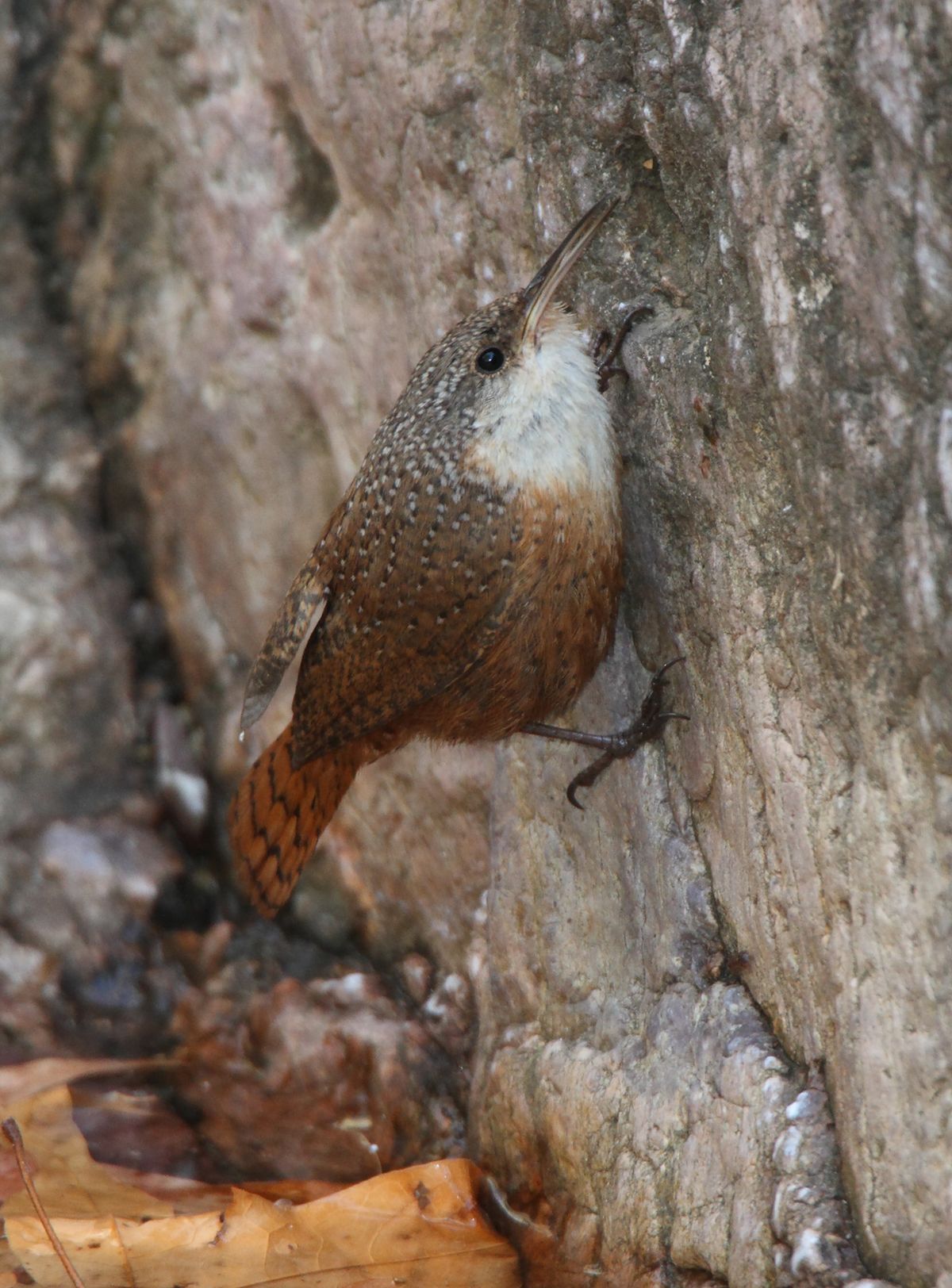
Wikipedia: Canyon wren Source: OTHER
1200px-Canyon_Wren.jpg
![]() The canyon wren (Catherpes mexicanus) is a small North American songbird of the wren family Troglodytidae. It is resident throughout its range and is generally found in arid, rocky cliffs, outcrops, and canyons. It is a small bird that is hard to see on its rocky habitat; however, it can be heard throughout the canyons by its distinctive, loud song. It is currently in a monotypic taxon and is the only species in the genus Catherpes.
[more]
The canyon wren (Catherpes mexicanus) is a small North American songbird of the wren family Troglodytidae. It is resident throughout its range and is generally found in arid, rocky cliffs, outcrops, and canyons. It is a small bird that is hard to see on its rocky habitat; however, it can be heard throughout the canyons by its distinctive, loud song. It is currently in a monotypic taxon and is the only species in the genus Catherpes.
[more]
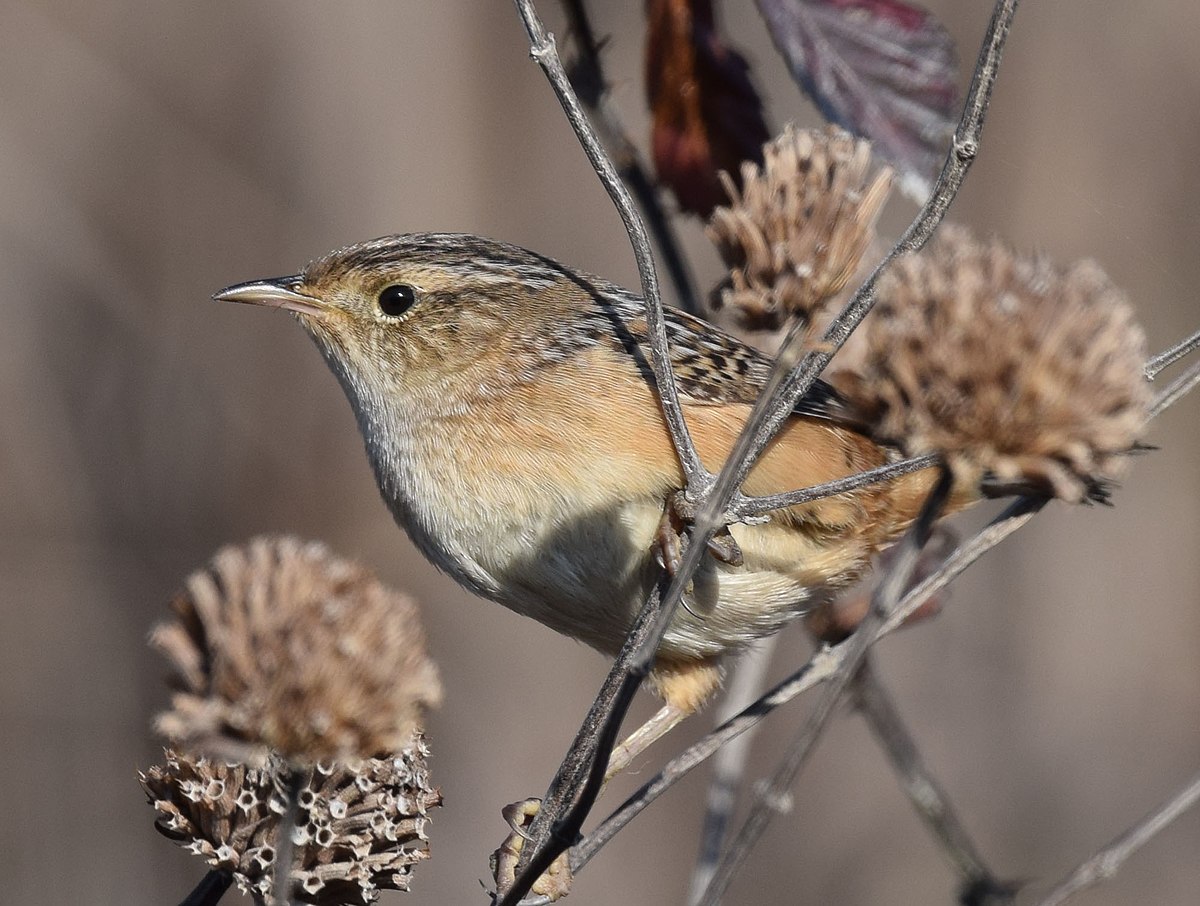
Wikipedia: Sedge wren Source: OTHER
1200px-Sedge_Wren_%2831204304001%29.jpg
![]() The sedge wren (Cistothorus stellaris) is a small and secretive passerine bird in the family Troglodytidae. It is widely distributed in North America. It is often found in wet grasslands and meadows where it nests in the tall grasses and sedges and feeds on insects. The sedge wren was formerly considered as conspecific with the non-migratory grass wren of central and South America.
[more]
The sedge wren (Cistothorus stellaris) is a small and secretive passerine bird in the family Troglodytidae. It is widely distributed in North America. It is often found in wet grasslands and meadows where it nests in the tall grasses and sedges and feeds on insects. The sedge wren was formerly considered as conspecific with the non-migratory grass wren of central and South America.
[more]
Profile Wikipedia eBird Audubon AllAboutBirds Xeno-Canto NABU
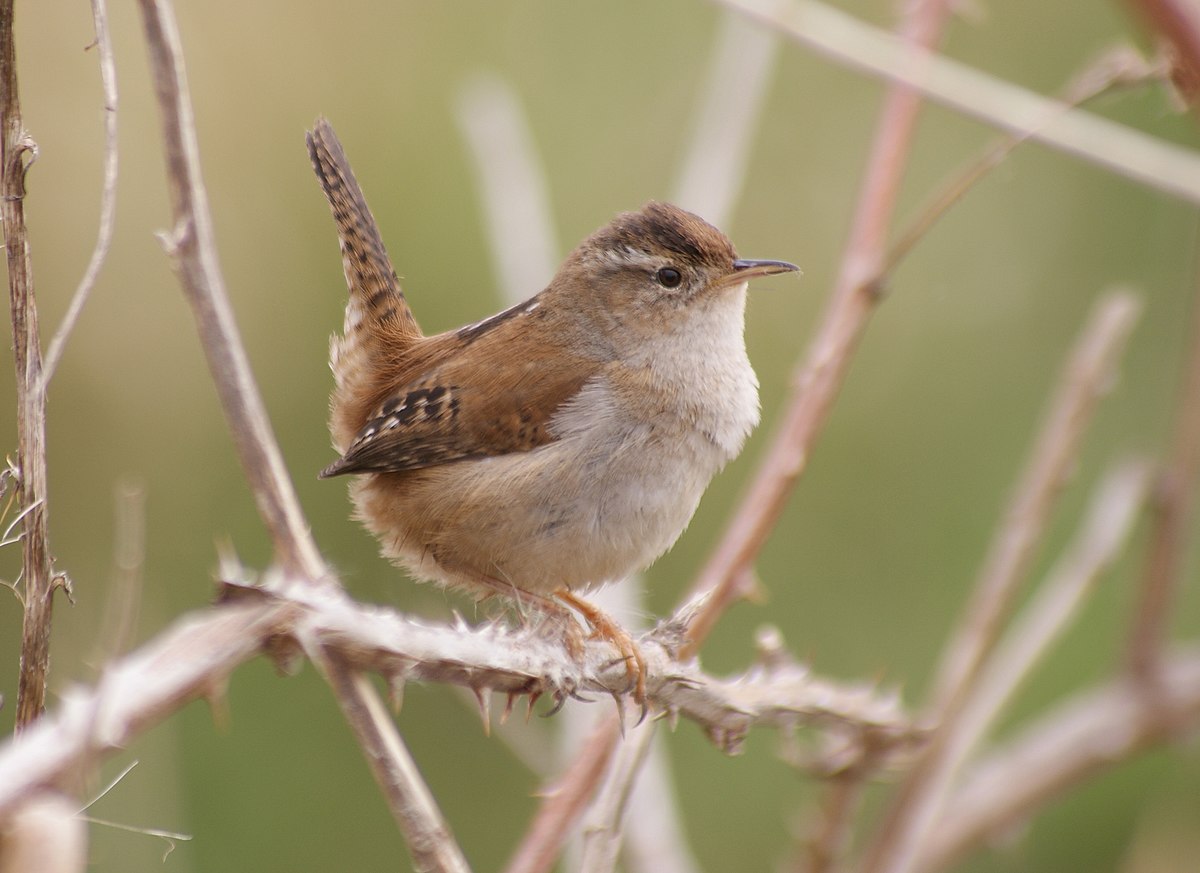
Wikipedia: Marsh wren Source: OTHER
1200px-Cistothorus_palustris_-Reifel_Island%2C_Vancouver-8.jpg
This bird appears across the great seas in the following continents:
Europe, North America.
![]() The marsh wren (Cistothorus palustris) is a small North American songbird of the wren family. It is sometimes called the long-billed marsh wren to distinguish it from the sedge wren, also known as the short-billed marsh wren.
[more]
The marsh wren (Cistothorus palustris) is a small North American songbird of the wren family. It is sometimes called the long-billed marsh wren to distinguish it from the sedge wren, also known as the short-billed marsh wren.
[more]
Profile Wikipedia eBird Audubon AllAboutBirds Xeno-Canto

Wikipedia: Bewick's wren Source: OTHER
1200px-Bewicks_Wren.jpg
![]() The Bewick's wren (Thryomanes bewickii) is a wren native to North America. At about 14 cm (5.5 in) long, it is grey-brown above, white below, with a long white eyebrow. While similar in appearance to the Carolina wren, it has a long tail that is tipped in white. The song is loud and melodious, much like the song of other wrens. It lives in thickets, brush piles and hedgerows, open woodlands and scrubby areas, often near streams. It eats insects and spiders, which it gleans from vegetation or finds on the ground.[2]
[more]
The Bewick's wren (Thryomanes bewickii) is a wren native to North America. At about 14 cm (5.5 in) long, it is grey-brown above, white below, with a long white eyebrow. While similar in appearance to the Carolina wren, it has a long tail that is tipped in white. The song is loud and melodious, much like the song of other wrens. It lives in thickets, brush piles and hedgerows, open woodlands and scrubby areas, often near streams. It eats insects and spiders, which it gleans from vegetation or finds on the ground.[2]
[more]
Profile Wikipedia eBird Audubon AllAboutBirds Xeno-Canto

Wikipedia: Rock wren Source: OTHER
1200px-Rock_Wren.jpg
![]() The rock wren (Salpinctes obsoletus) is a small songbird of the wren family native to South America and western North America. It is the only species in the genus Salpinctes.
[more]
The rock wren (Salpinctes obsoletus) is a small songbird of the wren family native to South America and western North America. It is the only species in the genus Salpinctes.
[more]
Profile Wikipedia eBird Audubon AllAboutBirds Xeno-Canto

Wikipedia: Brown creeper Source: OTHER
Certhia-americana-001.jpg
![]() The brown creeper (Certhia americana), also known as the American treecreeper, is a small songbird, the only North American member of the treecreeper family Certhiidae.
[more]
The brown creeper (Certhia americana), also known as the American treecreeper, is a small songbird, the only North American member of the treecreeper family Certhiidae.
[more]
Profile Wikipedia eBird Audubon AllAboutBirds Xeno-Canto
Blue-gray gnatcatcher. 2023-04-16 09.34.24 Yucatan
First observed in Maryland on 2022-04-29.
![]() The blue-gray gnatcatcher or blue-grey gnatcatcher (Polioptila caerulea) is a very small songbird native to North America.
[more]
The blue-gray gnatcatcher or blue-grey gnatcatcher (Polioptila caerulea) is a very small songbird native to North America.
[more]
Call:
Automatically generated from Xeno-Canto recording
♫ Source: BirdNet
20220429_112508 birdnet - Blue-gray Gnatcatcher - 2022-04-29 11:25:08 - Blue-gray Gnatcatcher - Baltimore.mp3
2022-04-29 11.25.08 Maryland (song?)
Profile Wikipedia eBird Audubon AllAboutBirds Xeno-Canto

Wikipedia: Black-capped gnatcatcher Source: OTHER
1200px-Black-capped_Gnatcatcher_%28Polioptila_nigriceps%29_%2816688757420%29.jpg
![]() The black-capped gnatcatcher (Polioptila nigriceps) is a small songbird in the family Polioptilidae. It is found in Mexico and the United States.[2]
[more]
The black-capped gnatcatcher (Polioptila nigriceps) is a small songbird in the family Polioptilidae. It is found in Mexico and the United States.[2]
[more]
Profile Wikipedia eBird Audubon AllAboutBirds Xeno-Canto
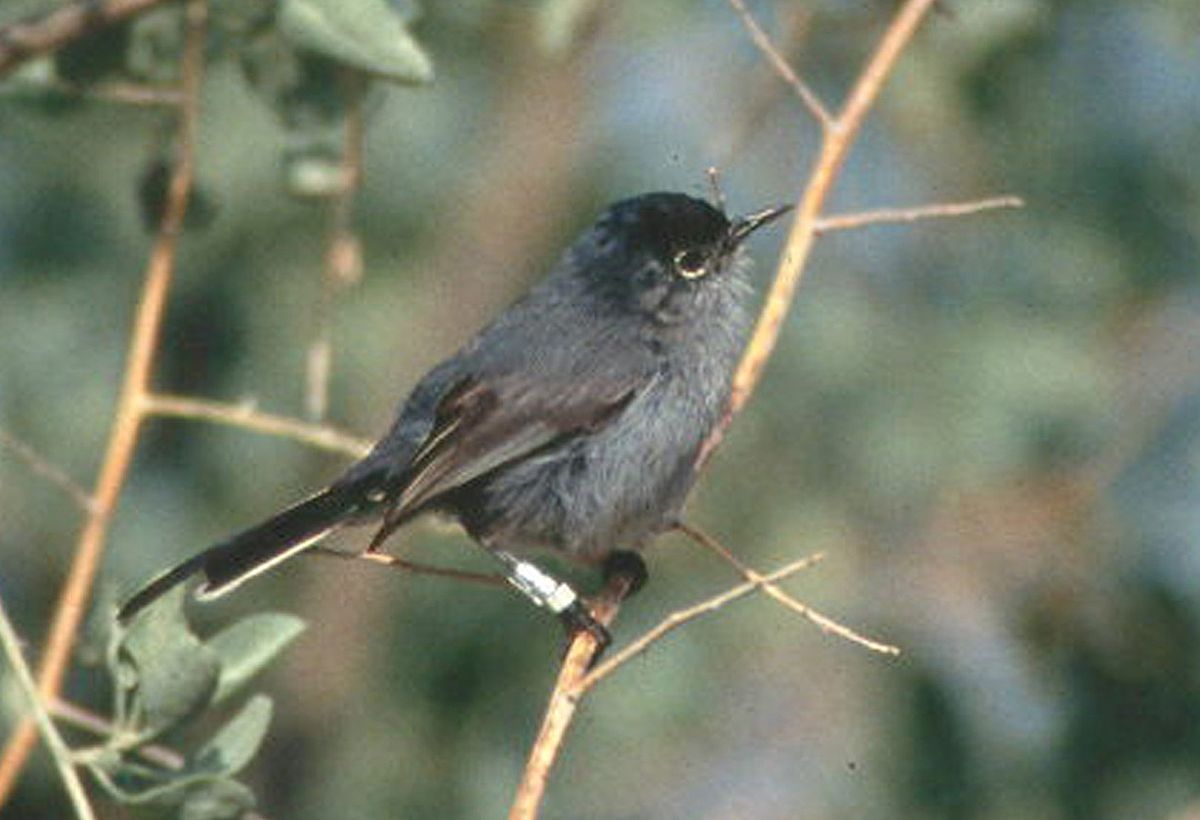
Wikipedia: California gnatcatcher Source: OTHER
1200px-California_Gnatcatcher.jpg
![]() The California gnatcatcher (Polioptila californica) is a small 10.8 cm (4.3 in) long insectivorous bird which frequents dense coastal sage scrub growth. This species was recently split from the similar black-tailed gnatcatcher of the Sonoran and Chihuahuan deserts. This bird is often solitary, but joins with other birds in winter flocks.
[more]
The California gnatcatcher (Polioptila californica) is a small 10.8 cm (4.3 in) long insectivorous bird which frequents dense coastal sage scrub growth. This species was recently split from the similar black-tailed gnatcatcher of the Sonoran and Chihuahuan deserts. This bird is often solitary, but joins with other birds in winter flocks.
[more]
Profile Wikipedia eBird Audubon AllAboutBirds Xeno-Canto

Wikipedia: Black-tailed gnatcatcher Source: OTHER
1200px-Black-tailed_Gnatcatcher_%28Polioptila_melanura%29_%2816875128691%29.jpg
![]() The black-tailed gnatcatcher (Polioptila melanura) is a small, insectivorous bird which ranges throughout the Sonoran and Chihuahuan Deserts of the southwestern United States and northern Mexico. It is nonmigratory and found in arid desert areas year-round.
[more]
The black-tailed gnatcatcher (Polioptila melanura) is a small, insectivorous bird which ranges throughout the Sonoran and Chihuahuan Deserts of the southwestern United States and northern Mexico. It is nonmigratory and found in arid desert areas year-round.
[more]
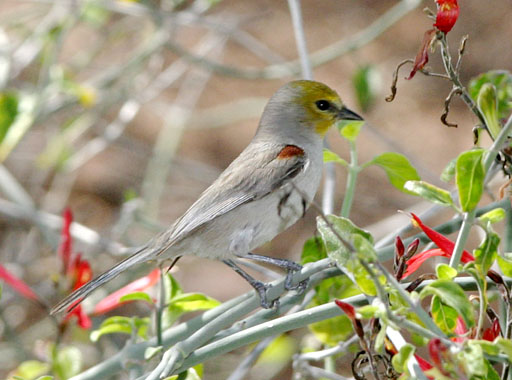
Wikipedia: Verdin Source: OTHER
Auriparus_flavicepsPCCA20050310-5817B.jpg
![]() The verdin (Auriparus flaviceps) is a species of penduline tit. It is the only species in the genus Auriparus and the only representative of the old world family Remizidae to be found in North America.[2]
[more]
The verdin (Auriparus flaviceps) is a species of penduline tit. It is the only species in the genus Auriparus and the only representative of the old world family Remizidae to be found in North America.[2]
[more]
Bohemian waxwing / Seidenschwanz (Bombycilla garrulus)

Wikipedia: Bohemian waxwing Source: OTHER
1200px-Bombycilla_garrulusII.jpg
This bird appears across the great seas in the following continents:
Europe, North America.
Seasonal Behavior: ![]() Seltener Durchzügler, seltener Wintergast [Link]
Seltener Durchzügler, seltener Wintergast [Link]
Song: ![]() Song more or less a variation on the contact call. [Link]
Song more or less a variation on the contact call. [Link]
Calls: ![]() Contact call weak, but distinct and typically alert one to the presence of a flock. A thin, high pitched, ringing "tzrrrrrrr". [Link]
Contact call weak, but distinct and typically alert one to the presence of a flock. A thin, high pitched, ringing "tzrrrrrrr". [Link]
Physical details: length=18 cm,
wingspan=32-35 cm,
weight=50-75 g
Habitats:
Settlement
Song:
![]() Lots of trills. [Link]
Lots of trills. [Link]
Song attributes:
Melody: simple rhythmic, fast, Frequency: 5-7 KHz
Call:
Automatically generated from Xeno-Canto recording
♫ XC763124 - Bohemian Waxwing - Bombycilla garrulus - call recorded in Sweden. Source: XENOCANTO
XC763124 - Bohemian Waxwing - Bombycilla garrulus - call recorded in Sweden.mp3
(call)

Call attributes:
Frequency: ,
Cedar waxwing (Bombycilla cedrorum)
Profile Wikipedia eBird A-Z Animals Audubon AllAboutBirds Xeno-Canto

Wikipedia: Cedar waxwing Source: OTHER
Cedar_Waxwing_-_Bombycilla_cedrorum%2C_George_Washington%27s_Birthplace_National_Monument%2C_Colonial_Beach%2C_Virginia_%2839997434862%29.jpg
General: ![]() The cedar waxwing (Bombycilla cedrorum) is a member of the family Bombycillidae or waxwing family of passerine birds. It is a medium-sized, mostly brown, gray, and yellow. This bird is named for its wax-like wing tips. It is a native of North and Central America, breeding in open wooded areas in southern Canada and wintering in the southern half of the United States, Central America, and the far northwest of South America. Its diet includes cedar cones, fruit, and insects.[2] The cedar waxwing is not endangered.
[more]
The cedar waxwing (Bombycilla cedrorum) is a member of the family Bombycillidae or waxwing family of passerine birds. It is a medium-sized, mostly brown, gray, and yellow. This bird is named for its wax-like wing tips. It is a native of North and Central America, breeding in open wooded areas in southern Canada and wintering in the southern half of the United States, Central America, and the far northwest of South America. Its diet includes cedar cones, fruit, and insects.[2] The cedar waxwing is not endangered.
[more]
Phainopepla (Phainopepla nitens)
Profile Wikipedia eBird Audubon AllAboutBirds Xeno-Canto

Wikipedia: Phainopepla Source: OTHER
Phainopepla_nitens_M_2.jpg
![]() The phainopepla or northern phainopepla[2] (Phainopepla nitens) is the most northerly representative of the mainly tropical Central American family Ptiliogonatidae, the silky flycatchers. Its name is from the Greek phain pepla meaning "shining robe" in reference to the male's plumage.
[more]
The phainopepla or northern phainopepla[2] (Phainopepla nitens) is the most northerly representative of the mainly tropical Central American family Ptiliogonatidae, the silky flycatchers. Its name is from the Greek phain pepla meaning "shining robe" in reference to the male's plumage.
[more]
American dipper / Grauwasseramsel (Cinclus mexicanus)
Profile Wikipedia eBird Audubon AllAboutBirds Xeno-Canto
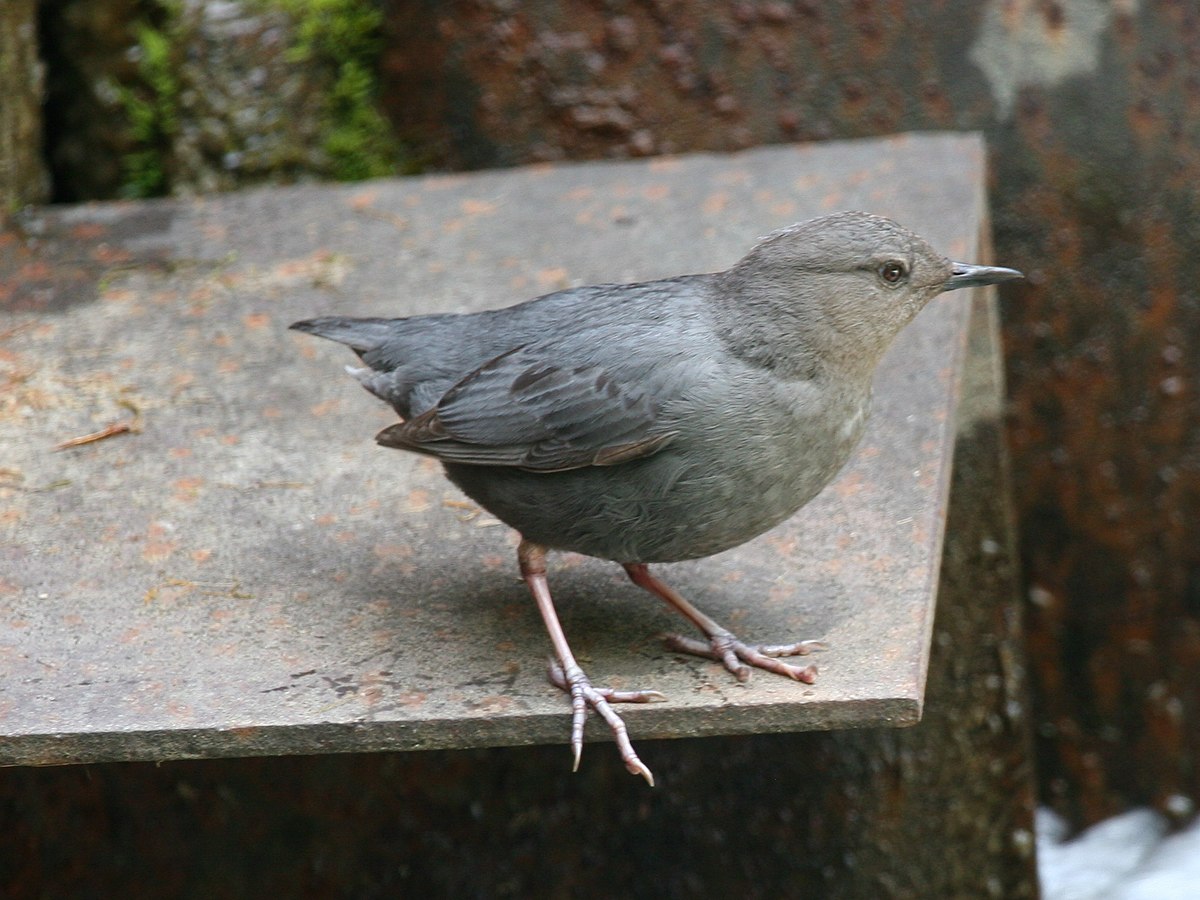
Wikipedia: American dipper Source: OTHER
1200px-American_Dipper.jpg
![]() The American dipper (Cinclus mexicanus), also known as a water ouzel, is a stocky dark grey bird with a head sometimes tinged with brown, and white feathers on the eyelids that cause the eyes to flash white as the bird blinks. It is 16.5 cm (6.5 in) long, has a wingspan of 23 cm,[2] and weighs on average 46 g (1.6 oz). It has long legs, and bobs its whole body up and down during pauses as it feeds on the bottom of fast-moving, rocky streams. It inhabits the mountainous regions of Central America and western North America from Panama to Alaska.
[more]
The American dipper (Cinclus mexicanus), also known as a water ouzel, is a stocky dark grey bird with a head sometimes tinged with brown, and white feathers on the eyelids that cause the eyes to flash white as the bird blinks. It is 16.5 cm (6.5 in) long, has a wingspan of 23 cm,[2] and weighs on average 46 g (1.6 oz). It has long legs, and bobs its whole body up and down during pauses as it feeds on the bottom of fast-moving, rocky streams. It inhabits the mountainous regions of Central America and western North America from Panama to Alaska.
[more]
Profile Wikipedia eBird Audubon AllAboutBirds Xeno-Canto
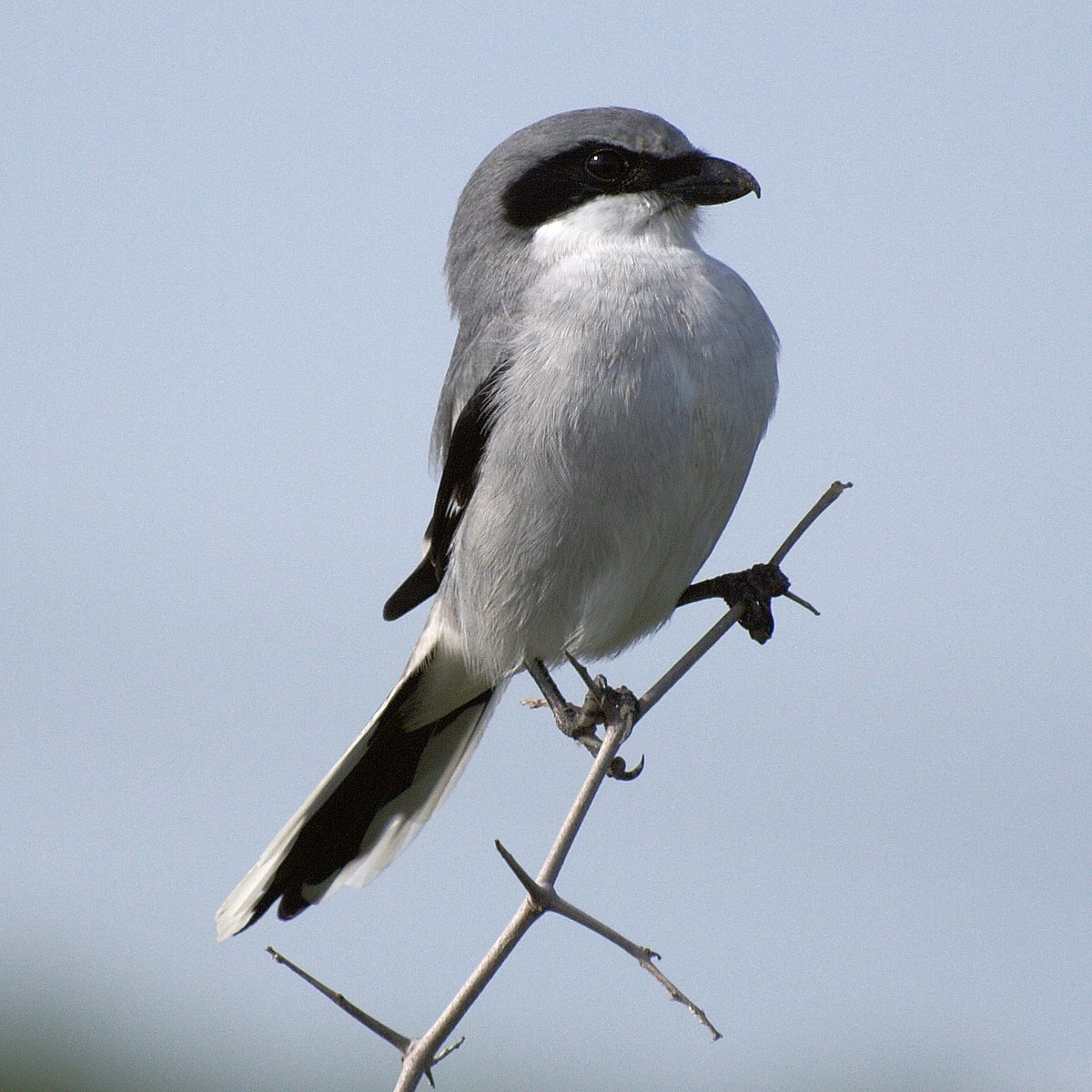
Wikipedia: Loggerhead shrike Source: OTHER
1200px-Lanius_ludovicianus_-Texas_-USA-8-4c.jpg
![]() The loggerhead shrike (Lanius ludovicianus) is a passerine bird in the family Laniidae. It is one of two members of the shrike family endemic to North America; the related northern shrike (L. borealis) occurs north of its range. It is nicknamed the butcherbird after its carnivorous tendencies, as it consumes prey such as amphibians, insects, lizards, small mammals and small birds, and some prey end up displayed and stored at a site, for example in a tree.[2] Due to its small size and weak talons, this predatory bird relies on impaling its prey upon thorns or barbed wire for facilitated consumption.[3] The numbers of loggerhead shrike have significantly decreased in recent years, especially in Midwestern, New England and Mid-Atlantic areas.[4]
[more]
The loggerhead shrike (Lanius ludovicianus) is a passerine bird in the family Laniidae. It is one of two members of the shrike family endemic to North America; the related northern shrike (L. borealis) occurs north of its range. It is nicknamed the butcherbird after its carnivorous tendencies, as it consumes prey such as amphibians, insects, lizards, small mammals and small birds, and some prey end up displayed and stored at a site, for example in a tree.[2] Due to its small size and weak talons, this predatory bird relies on impaling its prey upon thorns or barbed wire for facilitated consumption.[3] The numbers of loggerhead shrike have significantly decreased in recent years, especially in Midwestern, New England and Mid-Atlantic areas.[4]
[more]
Profile Wikipedia eBird A-Z Animals Audubon AllAboutBirds Xeno-Canto
Blue Jay. 2022-05-08 09.48.40 Maryland
First observed in Maryland on 2021-06-14.
![]() The blue jay (Cyanocitta cristata) is a passerine bird in the family Corvidae, native to eastern North America. It lives in most of the eastern and central United States; eastern populations may be migratory. Resident populations are also found in Newfoundland, Canada; breeding populations are found across southern Canada. It breeds in both deciduous and coniferous forests, and is common in residential areas. It is predominantly blue, with a white chest and underparts, and a blue crest; it has a black, U-shaped collar around its neck and a black border behind the crest. Males and females are similar in size and plumage, and plumage does not vary throughout the year. Four subspecies have been recognized.
[more]
The blue jay (Cyanocitta cristata) is a passerine bird in the family Corvidae, native to eastern North America. It lives in most of the eastern and central United States; eastern populations may be migratory. Resident populations are also found in Newfoundland, Canada; breeding populations are found across southern Canada. It breeds in both deciduous and coniferous forests, and is common in residential areas. It is predominantly blue, with a white chest and underparts, and a blue crest; it has a black, U-shaped collar around its neck and a black border behind the crest. Males and females are similar in size and plumage, and plumage does not vary throughout the year. Four subspecies have been recognized.
[more]
Call:
Automatically generated from Xeno-Canto recording
♫ Source: BirdNet
20220502_161140 birdnet - Blue Jay - 2022-05-02 16:11:40 - Blue Jay - Cockeysville.mp3
2022-05-02 16.11.40 Cockeysville (song?)
Profile Wikipedia eBird Audubon AllAboutBirds Xeno-Canto
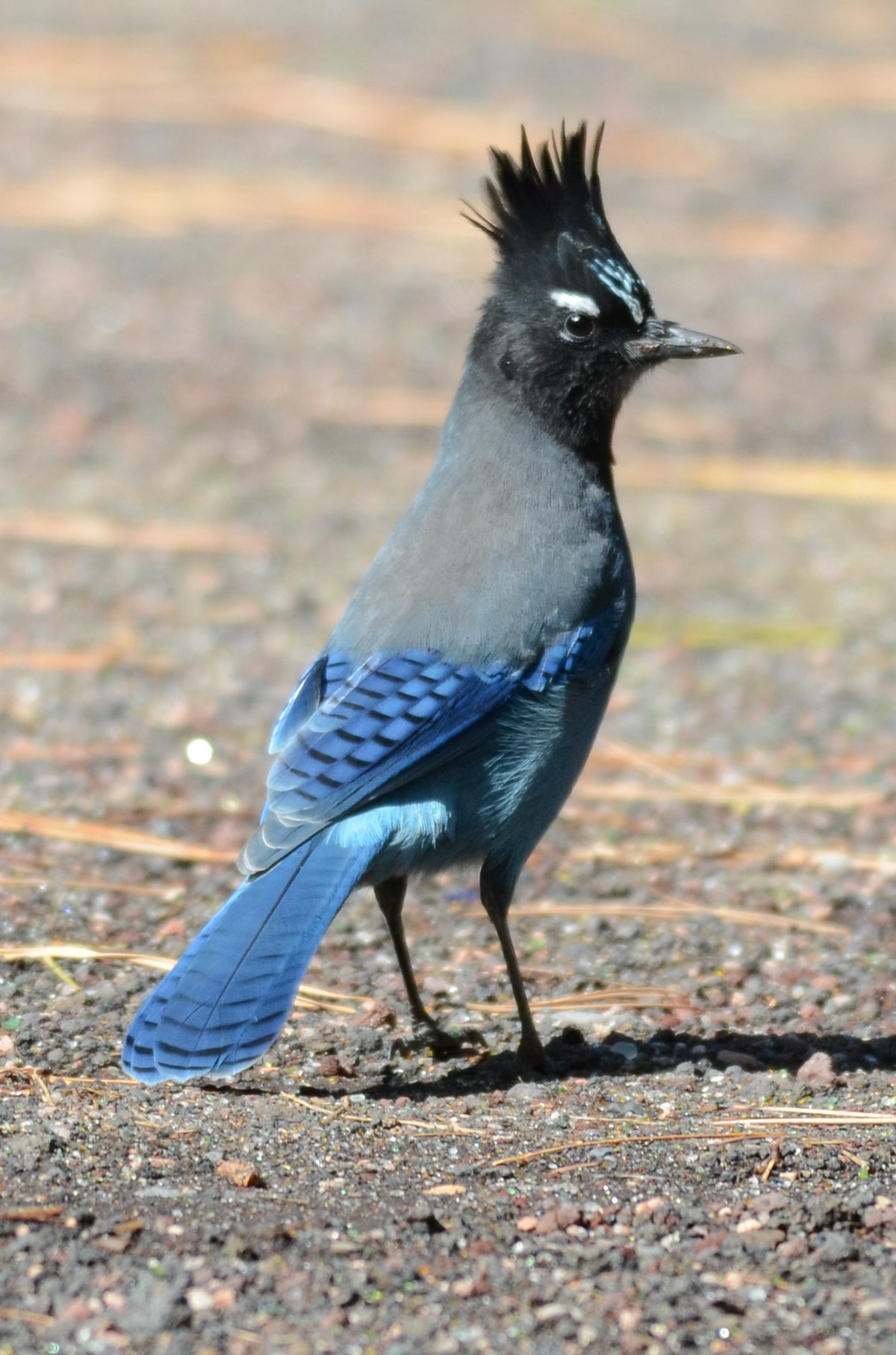
Wikipedia: Steller's jay Source: OTHER
1200px-Steller%27s_Jay_flagstaff_arizona.jpg
![]() Steller's jay (Cyanocitta stelleri) is a bird native to western North America, closely related to the blue jay found in the rest of the continent, but with a black head and upper body. It is also known as the long-crested jay, mountain jay, and pine jay. It is the only crested jay west of the Rocky Mountains. It is also sometimes colloquially called a "blue jay" in the Pacific Northwest, but is distinct from the blue jay (C. cristata) of eastern North America. The species inhabits pine-oak and coniferous forests.
[more]
Steller's jay (Cyanocitta stelleri) is a bird native to western North America, closely related to the blue jay found in the rest of the continent, but with a black head and upper body. It is also known as the long-crested jay, mountain jay, and pine jay. It is the only crested jay west of the Rocky Mountains. It is also sometimes colloquially called a "blue jay" in the Pacific Northwest, but is distinct from the blue jay (C. cristata) of eastern North America. The species inhabits pine-oak and coniferous forests.
[more]
Kolkrabe am Aabach, Wetzikon. 2021-03-10 09.49.56 Wetzikon
First observed in 🇨🇭 on 2021-03-10.
This bird appears across the great seas in the following continents:
Europe, North America, Africa.
The raven is often mentioned in word puzzles as the largest songbird.
Good to know: Other: A flock of ravens may be called an unkindness [Literary names of groups and flocks]
Etymology: ![]() Kolk, die erste Silbe seines seit dem 16. Jahrhundert bezeugten deutschen Namens, ist vermutlich lautmalerischen Ursprungs, ahmt also den Ruf des Vogels nach. [Link]
Kolk, die erste Silbe seines seit dem 16. Jahrhundert bezeugten deutschen Namens, ist vermutlich lautmalerischen Ursprungs, ahmt also den Ruf des Vogels nach. [Link]
Appearance and identification: ![]() It is one of the two largest corvids, alongside the thick-billed raven, and is possibly the heaviest passerine bird [Link]
It is one of the two largest corvids, alongside the thick-billed raven, and is possibly the heaviest passerine bird [Link]
![]() Ravens are larger, the size of a Red-tailed Hawk [in Switzerland a red kite, similar 'length' but only 2/3 of the huge kite wingspan]. Ravens often travel in pairs, while crows are seen in larger groups. Also, watch the bird’s tail as it flies overhead. The crow’s tail feathers are basically the same length, so when the bird spreads its tail, it opens like a fan. Ravens, however, have longer middle feathers in their tails, so their tail appears wedge-shaped when open.
Listen closely to the birds’ calls. Crows give a cawing sound. But ravens produce a lower croaking sound.
[How to Tell a Raven From a Crow]
Ravens are larger, the size of a Red-tailed Hawk [in Switzerland a red kite, similar 'length' but only 2/3 of the huge kite wingspan]. Ravens often travel in pairs, while crows are seen in larger groups. Also, watch the bird’s tail as it flies overhead. The crow’s tail feathers are basically the same length, so when the bird spreads its tail, it opens like a fan. Ravens, however, have longer middle feathers in their tails, so their tail appears wedge-shaped when open.
Listen closely to the birds’ calls. Crows give a cawing sound. But ravens produce a lower croaking sound.
[How to Tell a Raven From a Crow]
Vocalization: ![]() Quite varied repertoire. Most heard sound a short, coarse, but resonant "korrk. Other sounds may be surprisingly resonant and pure, like a ringing "clong" etc. Shows even more variation when courting. [Link]
Quite varied repertoire. Most heard sound a short, coarse, but resonant "korrk. Other sounds may be surprisingly resonant and pure, like a ringing "clong" etc. Shows even more variation when courting. [Link]
Physical details: length=64 cm,
wingspan=120-150 cm,
weight=800-1560 g
Habitats:
Mountain
Call:
Graak!
Call attributes:
Call melody: non-musical, slow, Frequency: low (1-3 KHz), Special sounds: cawing.
Profile Wikipedia eBird Audubon AllAboutBirds Xeno-Canto
Fish crows says MerlinBirdID. 2023-09-24 10.04.16 Florida
First observed in Florida on 2023-09-24.
General: ![]() The fish crow (Corvus ossifragus) is a species of crow associated with wetland habitats in the eastern and southeastern United States.
[more]
The fish crow (Corvus ossifragus) is a species of crow associated with wetland habitats in the eastern and southeastern United States.
[more]
Profile Wikipedia eBird Audubon AllAboutBirds Xeno-Canto
American crow. 2022-05-05 19.32.30 Maryland
First observed in Cockeysville on 2021-06-12.
![]() The American crow (Corvus brachyrhynchos) is a large passerine bird species of the family Corvidae. It is a common bird found throughout much of North America.
American crows are the New World counterpart to the carrion crow and the hooded crow. Although the American crow and the hooded crow are very similar in size, structure and behavior, their calls are different. The American crow, nevertheless, occupies the same role that the hooded crow does in Eurasia.
[more]
The American crow (Corvus brachyrhynchos) is a large passerine bird species of the family Corvidae. It is a common bird found throughout much of North America.
American crows are the New World counterpart to the carrion crow and the hooded crow. Although the American crow and the hooded crow are very similar in size, structure and behavior, their calls are different. The American crow, nevertheless, occupies the same role that the hooded crow does in Eurasia.
[more]
Call:
Automatically generated from Xeno-Canto recording
♫ Source: BirdNet
20210612_131735 birdnet 1621 - American Crow - 2021-06-12 13:17:35 - American Crow - Cockeysville.mp3
2021-06-12 13.17.35 Cockeysville (song?)
Profile Wikipedia eBird Audubon AllAboutBirds Xeno-Canto

Wikipedia: Tamaulipas crow Source: OTHER
Imparatus.jpg
![]() The Tamaulipas crow (Corvus imparatus) is a crow found in northeastern Mexico and some of southern Texas.
[more]
The Tamaulipas crow (Corvus imparatus) is a crow found in northeastern Mexico and some of southern Texas.
[more]
Profile Wikipedia eBird Audubon AllAboutBirds Xeno-Canto

Wikipedia: Mariana crow Source: OTHER
Mariana_Crow_Corvus_kubaryi.jpg
![]() The Mariana crow (Corvus kubaryi) (Chamorro name: aga) is a species of the crow family from the South Pacific. It is a glossy black bird about 15 inches (38 cm) long and known only from the islands of Guam and Rota.
[more]
The Mariana crow (Corvus kubaryi) (Chamorro name: aga) is a species of the crow family from the South Pacific. It is a glossy black bird about 15 inches (38 cm) long and known only from the islands of Guam and Rota.
[more]

Wikipedia: Black-billed magpie Source: OTHER
1200px-Black-billed_magpie_-_Alberta_June_16%2C_2013.JPG
![]() The black-billed magpie (Pica hudsonia), also known as the American magpie, is a bird in the corvidae family that inhabits the western half of North America, from Colorado, to southern coastal Alaska, to Central Oregon, to northern California, northern Nevada, northern Arizona, northern New Mexico, central Kansas, and Nebraska. In Canada it is found in far Western Ontario, Manitoba, Saskatchewan, Alberta, British Columbia, and Yukon. It is black and white, with black areas on the wings and tail showing iridescent hints of blue or blue-green. It is one of only four North American songbirds whose tail makes up half or more of the total body length (the others being the yellow-billed magpie, the scissor-tailed flycatcher, and the fork-tailed flycatcher).
[more]
The black-billed magpie (Pica hudsonia), also known as the American magpie, is a bird in the corvidae family that inhabits the western half of North America, from Colorado, to southern coastal Alaska, to Central Oregon, to northern California, northern Nevada, northern Arizona, northern New Mexico, central Kansas, and Nebraska. In Canada it is found in far Western Ontario, Manitoba, Saskatchewan, Alberta, British Columbia, and Yukon. It is black and white, with black areas on the wings and tail showing iridescent hints of blue or blue-green. It is one of only four North American songbirds whose tail makes up half or more of the total body length (the others being the yellow-billed magpie, the scissor-tailed flycatcher, and the fork-tailed flycatcher).
[more]
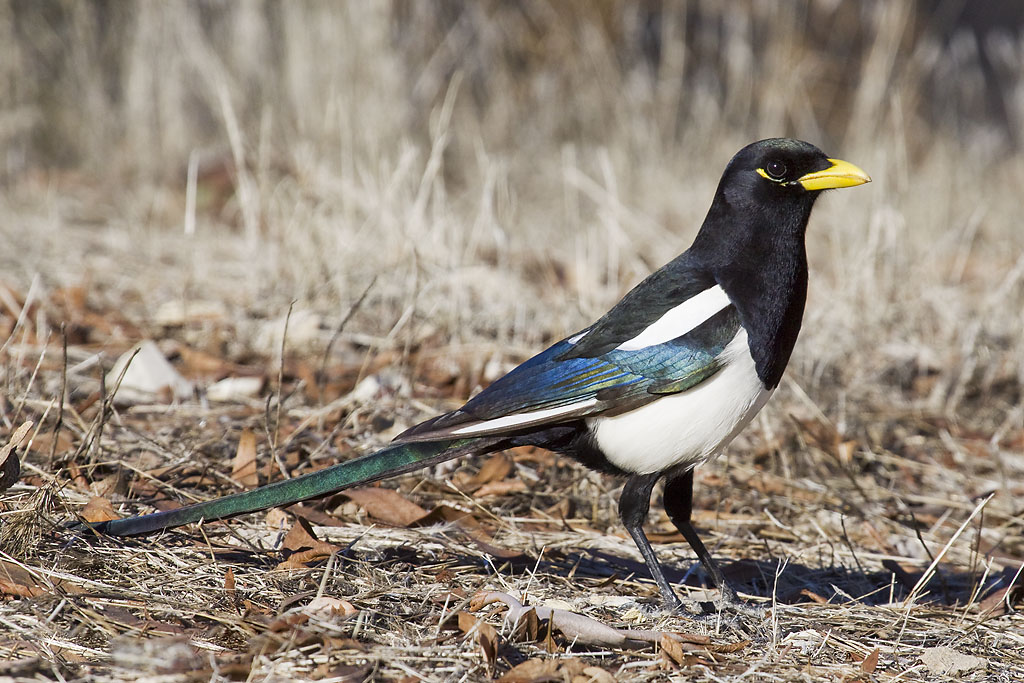
Wikipedia: Yellow-billed magpie Source: OTHER
Pica_nuttalli_Lake_San_Antonio.jpg
![]() The yellow-billed magpie (Pica nutalli) is a large bird in the crow family that is restricted to the U.S. state of California. It inhabits the Central Valley and the adjacent chaparral foothills and mountains. Apart from its having a yellow bill and a yellow streak around the eye, it is virtually identical to the black-billed magpie (Pica hudsonia) found in much of the rest of North America.
The scientific name commemorates the English naturalist Thomas Nuttall.
[more]
The yellow-billed magpie (Pica nutalli) is a large bird in the crow family that is restricted to the U.S. state of California. It inhabits the Central Valley and the adjacent chaparral foothills and mountains. Apart from its having a yellow bill and a yellow streak around the eye, it is virtually identical to the black-billed magpie (Pica hudsonia) found in much of the rest of North America.
The scientific name commemorates the English naturalist Thomas Nuttall.
[more]

Wikipedia: Scrub jay Source: OTHER
WesternScrubJay2.jpg
![]() The passerine birds of the genus Aphelocoma[A] include the scrub jays and their relatives. They are New World jays found in Mexico, western Central America and the western United States, with an outlying population in Florida. This genus belongs to the group of New World (or "blue") jays–possibly a distinct subfamily–which is not closely related to other jays, magpies or treepies.[1] They live in open pine-oak forests, chaparral, and mixed evergreen forests.
[more]
The passerine birds of the genus Aphelocoma[A] include the scrub jays and their relatives. They are New World jays found in Mexico, western Central America and the western United States, with an outlying population in Florida. This genus belongs to the group of New World (or "blue") jays–possibly a distinct subfamily–which is not closely related to other jays, magpies or treepies.[1] They live in open pine-oak forests, chaparral, and mixed evergreen forests.
[more]
Profile Wikipedia eBird Audubon AllAboutBirds Xeno-Canto

Wikipedia: Mexican jay Source: OTHER
Mexican_Jay_Aphelocoma_wollweberi_3.jpg
![]() The Mexican jay (Aphelocoma wollweberi) [2] formerly known as the gray-breasted jay, is a New World jay native to the Sierra Madre Oriental, Sierra Madre Occidental, and Central Plateau of Mexico and parts of the southwestern United States. In May 2011, the American Ornithologists' Union voted to split the Mexican jay into two species, one retaining the common name Mexican jay and one called the Transvolcanic jay. The Mexican jay is a medium-sized jay with blue upper parts and pale gray underparts. It resembles the Woodhouse's scrub-jay, but has an unstreaked throat and breast. It feeds largely on acorns and pine nuts, but includes many other plant and animal foods in its diet. It has a cooperative breeding system where the parents are assisted by other birds to raise their young. This is a common species with a wide range and the International Union for Conservation of Nature has rated its conservation status as being of "least concern".
[more]
The Mexican jay (Aphelocoma wollweberi) [2] formerly known as the gray-breasted jay, is a New World jay native to the Sierra Madre Oriental, Sierra Madre Occidental, and Central Plateau of Mexico and parts of the southwestern United States. In May 2011, the American Ornithologists' Union voted to split the Mexican jay into two species, one retaining the common name Mexican jay and one called the Transvolcanic jay. The Mexican jay is a medium-sized jay with blue upper parts and pale gray underparts. It resembles the Woodhouse's scrub-jay, but has an unstreaked throat and breast. It feeds largely on acorns and pine nuts, but includes many other plant and animal foods in its diet. It has a cooperative breeding system where the parents are assisted by other birds to raise their young. This is a common species with a wide range and the International Union for Conservation of Nature has rated its conservation status as being of "least concern".
[more]

Wikipedia: Santa cruz jay Source: OTHER
Island_Scrub_Jay_Aphelocoma_insularis.jpg
![]() The island scrub jay (Aphelocoma insularis) also island jay or Santa Cruz jay is a bird in the genus, Aphelocoma, which is endemic to Santa Cruz Island off the coast of Southern California. Of the over 500 breeding bird species in the continental U.S. and Canada, it is the only insular endemic landbird species.[2] The island scrub jay (ISSJ) is closely related to the California scrub jay – the coastal population found on the adjacent mainland – but differs in being larger, more brightly colored, and having a markedly stouter bill. They will bury, or cache, the acorns in the fall and may eat them months later. They also eat insects, spiders, snakes, lizards, mice and other birds' eggs and nestlings.
[more]
The island scrub jay (Aphelocoma insularis) also island jay or Santa Cruz jay is a bird in the genus, Aphelocoma, which is endemic to Santa Cruz Island off the coast of Southern California. Of the over 500 breeding bird species in the continental U.S. and Canada, it is the only insular endemic landbird species.[2] The island scrub jay (ISSJ) is closely related to the California scrub jay – the coastal population found on the adjacent mainland – but differs in being larger, more brightly colored, and having a markedly stouter bill. They will bury, or cache, the acorns in the fall and may eat them months later. They also eat insects, spiders, snakes, lizards, mice and other birds' eggs and nestlings.
[more]
Profile Wikipedia eBird Audubon AllAboutBirds Xeno-Canto

Wikipedia: Canada jay Source: OTHER
1200px-Perisoreus_canadensis_mercier2.jpg
![]() The Canada jay (Perisoreus canadensis), also known as the gray jay, grey jay, camp robber, or whisky jack, is a passerine bird of the family Corvidae. It is found in boreal forests of North America north to the tree line, and in the Rocky Mountains subalpine zone south to New Mexico and Arizona. A fairly large songbird, the Canada jay has pale grey underparts, darker grey upperparts, and a grey-white head with a darker grey nape. It is one of three members of the genus Perisoreus, a genus more closely related to the magpie genus Cyanopica than to other birds known as jays. The Canada jay itself has nine recognized subspecies.
[more]
The Canada jay (Perisoreus canadensis), also known as the gray jay, grey jay, camp robber, or whisky jack, is a passerine bird of the family Corvidae. It is found in boreal forests of North America north to the tree line, and in the Rocky Mountains subalpine zone south to New Mexico and Arizona. A fairly large songbird, the Canada jay has pale grey underparts, darker grey upperparts, and a grey-white head with a darker grey nape. It is one of three members of the genus Perisoreus, a genus more closely related to the magpie genus Cyanopica than to other birds known as jays. The Canada jay itself has nine recognized subspecies.
[more]

Wikipedia: Pinyon jay Source: OTHER
Gymnorhinus_cyanocephalus1.jpg
![]() The pinyon jay (Gymnorhinus cyanocephalus) is a jay between the North American blue jay and the Eurasian jay in size. The voice is described as a rhythmic krawk-kraw-krawk repeated two or three times. It is the only member of the genus Gymnorhinus. Its overall proportions are very nutcracker-like and indeed this can be seen as convergent evolution as both birds fill similar ecological niches. The pinyon jay is a bluish-grey coloured bird with deeper head colouring and whitish throat with black bill, legs and feet.
[more]
The pinyon jay (Gymnorhinus cyanocephalus) is a jay between the North American blue jay and the Eurasian jay in size. The voice is described as a rhythmic krawk-kraw-krawk repeated two or three times. It is the only member of the genus Gymnorhinus. Its overall proportions are very nutcracker-like and indeed this can be seen as convergent evolution as both birds fill similar ecological niches. The pinyon jay is a bluish-grey coloured bird with deeper head colouring and whitish throat with black bill, legs and feet.
[more]

Wikipedia: Green jay Source: OTHER
Cyanocorax_luxuosus_calling.jpg
![]() The green jay (Cyanocorax luxuosus) is a species of the New World jays, and is found in Central America. Adults are about 27 cm (11 in) long and variable in colour across their range; they usually have blue and black heads, green wings and mantle, bluish-green tails, black bills, yellow or brown eye rings, and dark legs. The basic diet consists of arthropods, vertebrates, seeds, and fruit. The nest is usually built in a thorny bush; the female incubates the clutch of three to five eggs. This is a common species of jay with a wide range and the International Union for Conservation of Nature has rated its conservation status as being of "least concern".
[more]
The green jay (Cyanocorax luxuosus) is a species of the New World jays, and is found in Central America. Adults are about 27 cm (11 in) long and variable in colour across their range; they usually have blue and black heads, green wings and mantle, bluish-green tails, black bills, yellow or brown eye rings, and dark legs. The basic diet consists of arthropods, vertebrates, seeds, and fruit. The nest is usually built in a thorny bush; the female incubates the clutch of three to five eggs. This is a common species of jay with a wide range and the International Union for Conservation of Nature has rated its conservation status as being of "least concern".
[more]
Profile Wikipedia eBird Audubon AllAboutBirds Xeno-Canto
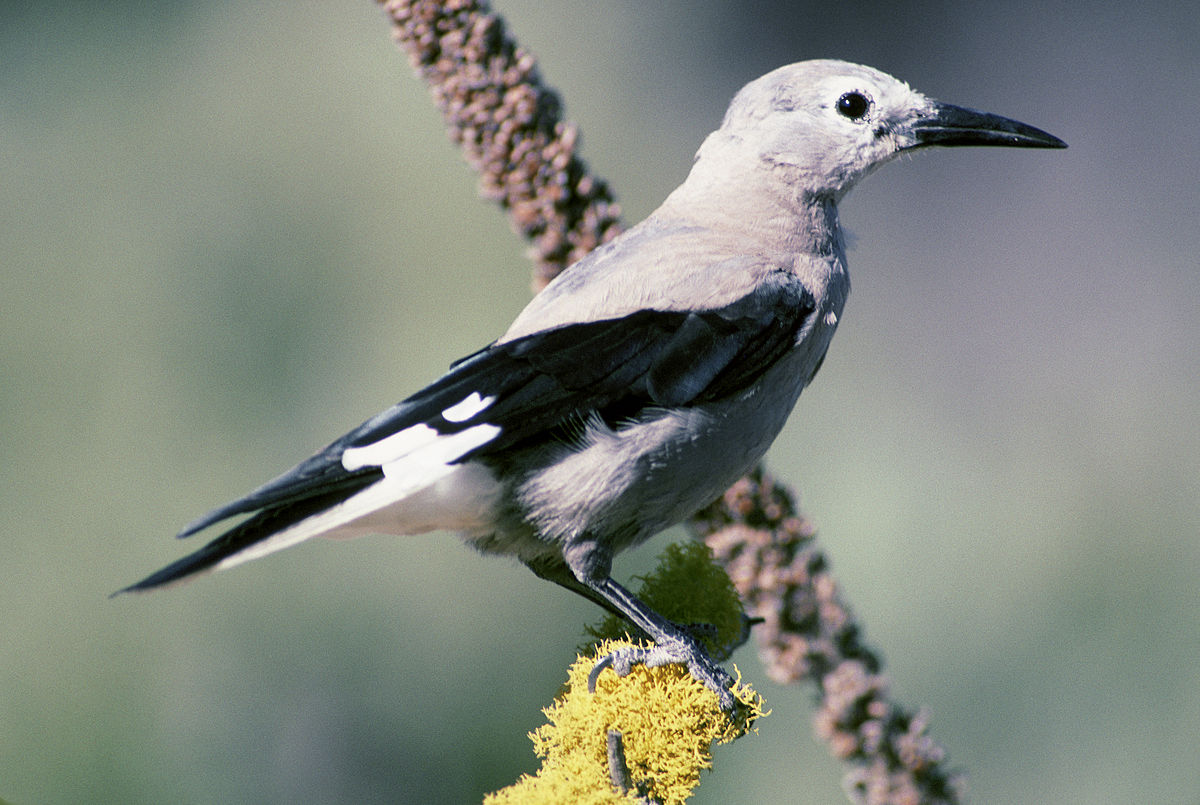
Wikipedia: Clark's nutcracker Source: OTHER
1200px-Nucifraga_columbiana1.jpg
![]() Clark's nutcracker (Nucifraga columbiana), sometimes referred to as Clark's crow or woodpecker crow, is a passerine bird in the family Corvidae, native to the mountains of western North America. The nutcracker is an omnivore but subsists mainly on pine nuts, burying seeds in the ground in the summer and then retrieving them in the winter by memory.
[more]
Clark's nutcracker (Nucifraga columbiana), sometimes referred to as Clark's crow or woodpecker crow, is a passerine bird in the family Corvidae, native to the mountains of western North America. The nutcracker is an omnivore but subsists mainly on pine nuts, burying seeds in the ground in the summer and then retrieving them in the winter by memory.
[more]
Profile Wikipedia eBird Audubon AllAboutBirds Xeno-Canto

Wikipedia: Yellow-throated vireo Source: OTHER
1200px-Vireo-flavifrons-001.jpg
![]() The yellow-throated vireo (Vireo flavifrons) is a small American songbird.
[more]
The yellow-throated vireo (Vireo flavifrons) is a small American songbird.
[more]
Profile Wikipedia eBird Audubon AllAboutBirds Xeno-Canto

Wikipedia: Warbling vireo Source: OTHER
WarblingVireo08.jpg
![]() The warbling vireo (Vireo gilvus) is a small North American songbird.
[more]
The warbling vireo (Vireo gilvus) is a small North American songbird.
[more]
Profile Wikipedia eBird Audubon AllAboutBirds Xeno-Canto

Wikipedia: Red-eyed vireo Source: OTHER
1200px-Vireo_olivaceus_-Madison_-Wisconsin_-USA-8.jpg
First observed in Cockeysville on 2021-06-13.
![]() The red-eyed vireo (Vireo olivaceus) is a small American songbird. It is somewhat warbler-like but not closely related to the New World warblers (Parulidae). Common across its vast range, this species is not considered threatened by the IUCN.
[more]
The red-eyed vireo (Vireo olivaceus) is a small American songbird. It is somewhat warbler-like but not closely related to the New World warblers (Parulidae). Common across its vast range, this species is not considered threatened by the IUCN.
[more]
Song:
Automatically generated from Xeno-Canto recording
Song attributes:
Frequency:
♫ Source: BirdNet
20210615_182200 birdnet 1658 - Red-eyed Vireo, two-part song - Red-eyed Vireo - Cockeysville.mp3
2021-06-15 18.22.00 Cockeysville (song)
Call:
Automatically generated from Xeno-Canto recording
♫ Supposedly red eyed vireo at ncr trail, did not see. 2021-06-15 12.23.30 Maryland (song?)

Wikipedia: Philadelphia vireo Source: OTHER
Vireo_philadelphicus.jpg
![]() The Philadelphia vireo (Vireo philadelphicus) is a small North American songbird in the vireo family (Vireonidae). "Vireo" is a Latin word referring to a green migratory bird, perhaps the female golden oriole, possibly the European greenfinch. The specific philadelphicus is for the city of Philadelphia.[2][3]
[more]
The Philadelphia vireo (Vireo philadelphicus) is a small North American songbird in the vireo family (Vireonidae). "Vireo" is a Latin word referring to a green migratory bird, perhaps the female golden oriole, possibly the European greenfinch. The specific philadelphicus is for the city of Philadelphia.[2][3]
[more]
Profile Wikipedia eBird Audubon AllAboutBirds Xeno-Canto
White-eyed vireo. 2022-05-01 09.22.26 Maryland
First observed in Cockeysville on 2022-05-01.
![]() The white-eyed vireo (Vireo griseus) is a small songbird. It breeds in the southeastern United States from New Jersey west to northern Missouri and south to Texas and Florida, and also in eastern Mexico, northern Central America, Cuba and the Bahamas.
[more]
The white-eyed vireo (Vireo griseus) is a small songbird. It breeds in the southeastern United States from New Jersey west to northern Missouri and south to Texas and Florida, and also in eastern Mexico, northern Central America, Cuba and the Bahamas.
[more]
Call:
Automatically generated from Xeno-Canto recording
♫ Source: BirdNet
20220501_092806 birdnet - White-eyed Vireo - 2022-05-01 09:28:06 - White-eyed Vireo - Cockeysville.mp3
2022-05-01 09.28.06 Cockeysville (song?)
Profile Wikipedia eBird Audubon AllAboutBirds Xeno-Canto

Wikipedia: Black-whiskered vireo Source: OTHER
Black-whiskered_Vireo.jpg
![]() The black-whiskered vireo (Vireo altiloquus) is a small passerine bird, which breeds in southern Florida, USA, and the West Indies as far south as the offshore islands of Venezuela. It is a partial migrant, with northern birds wintering from the Greater Antilles to northern South America. This species has occurred as a rare vagrant to Costa Rica.
[more]
The black-whiskered vireo (Vireo altiloquus) is a small passerine bird, which breeds in southern Florida, USA, and the West Indies as far south as the offshore islands of Venezuela. It is a partial migrant, with northern birds wintering from the Greater Antilles to northern South America. This species has occurred as a rare vagrant to Costa Rica.
[more]

Wikipedia: Bell's vireo Source: OTHER
1200px-Bell%27s_Vireo.jpg
![]() Bell's vireo (Vireo bellii)[2] is a songbird that migrates between a breeding range in North America and a winter range in the Neotropics. It is dull olive-gray above and whitish below. It has a faint white eye ring and faint wing bars.
[more]
Bell's vireo (Vireo bellii)[2] is a songbird that migrates between a breeding range in North America and a winter range in the Neotropics. It is dull olive-gray above and whitish below. It has a faint white eye ring and faint wing bars.
[more]

Wikipedia: Cassin's vireo Source: OTHER
1200px-Cassin%27s_Vireo_%28Vireo_cassinii%29.jpg
![]() Cassin's vireo (Vireo cassinii) is a small North American songbird, ranging from southern British Columbia in Canada through the western coastal states of the United States. This bird migrates, spending the winter from southern Arizona (the Sonoran Desert) to southern Mexico.
[more]
Cassin's vireo (Vireo cassinii) is a small North American songbird, ranging from southern British Columbia in Canada through the western coastal states of the United States. This bird migrates, spending the winter from southern Arizona (the Sonoran Desert) to southern Mexico.
[more]
Profile Wikipedia eBird Audubon AllAboutBirds Xeno-Canto
MerlinBirdID says yellow-green vireo, one of the many yellow birds, Ecotucan, Bacalar. 2023-03-31 07.37.58 Yucatan
First observed in Yucatan on 2023-03-31.
![]() The yellow-green vireo (Vireo flavoviridis) is a small American passerine bird. It is migratory breeding from Mexico to Panama and wintering in the northern and eastern Andes and the western Amazon Basin.
[more]
The yellow-green vireo (Vireo flavoviridis) is a small American passerine bird. It is migratory breeding from Mexico to Panama and wintering in the northern and eastern Andes and the western Amazon Basin.
[more]
Profile Wikipedia eBird Audubon AllAboutBirds Xeno-Canto

Wikipedia: Plumbeous vireo Source: OTHER
Vireo_plumbeus2_crop.jpg
![]() The plumbeous vireo (Vireo plumbeus) is a small North American songbird, ranging from far southeastern Montana and western South Dakota south to the Pacific coast of Mexico, including the extreme southern regions of Baja California Sur. It is migratory, moving to the southern part of its range in winter, and its habitat generally encompasses open pine forests.
[more]
The plumbeous vireo (Vireo plumbeus) is a small North American songbird, ranging from far southeastern Montana and western South Dakota south to the Pacific coast of Mexico, including the extreme southern regions of Baja California Sur. It is migratory, moving to the southern part of its range in winter, and its habitat generally encompasses open pine forests.
[more]
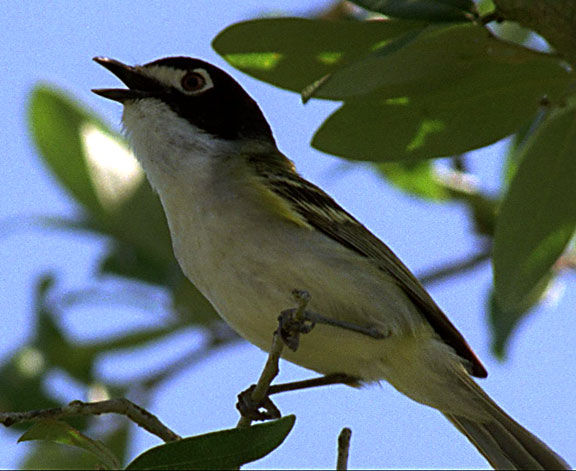
Wikipedia: Black-capped vireo Source: OTHER
Black-capped-Vireo.jpg
![]() The black-capped vireo (Vireo atricapilla) is a small bird native to the United States and Mexico. It was listed as an endangered species in the United States in 1987. Successful conservation efforts on the U.S. Army's Fort Hood and Fort Sill led to delisting the black-capped vireo in 2018.[2] The IUCN lists the species as vulnerable.
[more]
The black-capped vireo (Vireo atricapilla) is a small bird native to the United States and Mexico. It was listed as an endangered species in the United States in 1987. Successful conservation efforts on the U.S. Army's Fort Hood and Fort Sill led to delisting the black-capped vireo in 2018.[2] The IUCN lists the species as vulnerable.
[more]
Profile Wikipedia eBird Audubon AllAboutBirds Xeno-Canto

Wikipedia: Gray vireo Source: OTHER
Vireo_vicinior1.jpg
![]() The gray vireo (Vireo vicinior) is a small North American passerine bird. It breeds from the southwestern United States and northern Baja California to western Texas. It is a migrant, wintering in northwestern Mexico, in western Sonora state, and the southern Baja Peninsula in Baja California Sur; it remains all year only in Big Bend National Park in southwest Texas. It is usually found at altitudes between 400 and 2,500 metres (1,300 and 8,200 ft) in its Mexican breeding grounds. This vireo frequents dry brush, especially juniper, on the slopes of the southwestern mountains.[2]
[more]
The gray vireo (Vireo vicinior) is a small North American passerine bird. It breeds from the southwestern United States and northern Baja California to western Texas. It is a migrant, wintering in northwestern Mexico, in western Sonora state, and the southern Baja Peninsula in Baja California Sur; it remains all year only in Big Bend National Park in southwest Texas. It is usually found at altitudes between 400 and 2,500 metres (1,300 and 8,200 ft) in its Mexican breeding grounds. This vireo frequents dry brush, especially juniper, on the slopes of the southwestern mountains.[2]
[more]
Profile Wikipedia eBird Audubon AllAboutBirds Xeno-Canto

Wikipedia: Hutton's vireo Source: OTHER
1200px-Vireo_huttoni.jpg
![]() Hutton's vireo (Vireo huttoni) is a small songbird. It is approximately 5 inches (12–13 cm) in length, dull olive-gray above and below. It has a faint white eye ring and faint white wing bars. It closely resembles a ruby-crowned kinglet, but has a thicker bill and is slightly larger in size. Its most common song is a repeated chu-wee, or a chew, but will have other variations. Its call is a mewing chatter.
[more]
Hutton's vireo (Vireo huttoni) is a small songbird. It is approximately 5 inches (12–13 cm) in length, dull olive-gray above and below. It has a faint white eye ring and faint white wing bars. It closely resembles a ruby-crowned kinglet, but has a thicker bill and is slightly larger in size. Its most common song is a repeated chu-wee, or a chew, but will have other variations. Its call is a mewing chatter.
[more]
Profile Wikipedia eBird Audubon AllAboutBirds Xeno-Canto
Black drongo, Phnom Krom. 2024-03-03 06.28.04 Cambodia
First observed in Laos on 2024-02-25.
This bird appears across the great seas in the following continents:
North America, Asia.
![]() The black drongo (Dicrurus macrocercus) is a small Asian passerine bird of the drongo family Dicruridae. It is a common resident breeder in much of tropical southern Asia from southwest Iran through India, Bangladesh and Sri Lanka east to southern China and Indonesia and accidental visitor of Japan. It is an all black bird with a distinctive forked tail and measures 28 cm (11 in) in length. It feeds on insects, and is common in open agricultural areas and light forest throughout its range, perching conspicuously on a bare perch or along power or telephone lines. The species is known for its aggressive behaviour towards much larger birds, such as crows, never hesitating to dive-bomb any bird of prey that invades its territory. This behaviour earns it the informal name of king crow. Smaller birds often nest in the well-guarded vicinity of a nesting black drongo. Previously grouped along with the African fork-tailed drongo (Dicrurus adsimilis), the Asian forms are now treated as a separate species with several distinct populations.
[more]
The black drongo (Dicrurus macrocercus) is a small Asian passerine bird of the drongo family Dicruridae. It is a common resident breeder in much of tropical southern Asia from southwest Iran through India, Bangladesh and Sri Lanka east to southern China and Indonesia and accidental visitor of Japan. It is an all black bird with a distinctive forked tail and measures 28 cm (11 in) in length. It feeds on insects, and is common in open agricultural areas and light forest throughout its range, perching conspicuously on a bare perch or along power or telephone lines. The species is known for its aggressive behaviour towards much larger birds, such as crows, never hesitating to dive-bomb any bird of prey that invades its territory. This behaviour earns it the informal name of king crow. Smaller birds often nest in the well-guarded vicinity of a nesting black drongo. Previously grouped along with the African fork-tailed drongo (Dicrurus adsimilis), the Asian forms are now treated as a separate species with several distinct populations.
[more]
Song:
Automatically generated from Xeno-Canto recording
Song attributes:
Frequency:
♫ XC814830 - Black Drongo - Dicrurus macrocercus cathoecus - song, Hong Kong, China. Source: XENOCANTO
XC814830 - Black Drongo - Dicrurus macrocercus cathoecus - song, Hong Kong, China.mp3
(song)

Profile Wikipedia eBird Audubon AllAboutBirds Xeno-Canto
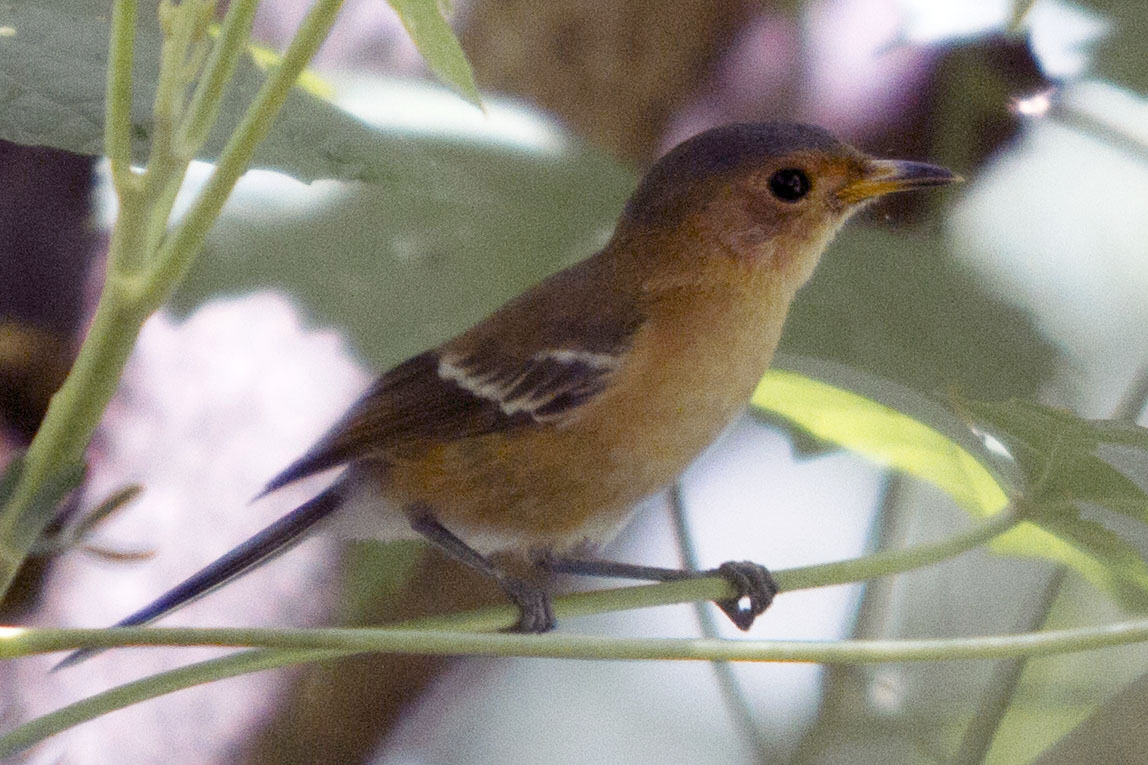
Wikipedia: Tinian monarch Source: OTHER
Tinian_Monarch_Monarcha_takatsukasae_photographed_on_Tinian_Island_in_2012_by_Devon_Pike.jpg
![]() The Tinian monarch (Monarcha takatsukasae) is a species of bird in the family Monarchidae.
It is endemic to the Northern Mariana Islands.
[more]
The Tinian monarch (Monarcha takatsukasae) is a species of bird in the family Monarchidae.
It is endemic to the Northern Mariana Islands.
[more]
Summer tanager (Piranga rubra)
Profile Wikipedia eBird A-Z Animals Audubon AllAboutBirds Xeno-Canto
Arenal feeder summer tanager tenatative ID. 2018-02-27 12.58.26 Costa Rica
First observed in Costa Rica on 2018-02-27.
![]() The summer tanager (Piranga rubra) is a medium-sized American songbird. Formerly placed in the tanager family (Thraupidae), it and other members of its genus are now classified in the cardinal family (Cardinalidae).[2] The species's plumage and vocalizations are similar to other members of the cardinal family.
[more]
The summer tanager (Piranga rubra) is a medium-sized American songbird. Formerly placed in the tanager family (Thraupidae), it and other members of its genus are now classified in the cardinal family (Cardinalidae).[2] The species's plumage and vocalizations are similar to other members of the cardinal family.
[more]
Western tanager / Kieferntangare (Piranga ludoviciana)
Profile Wikipedia eBird A-Z Animals Audubon AllAboutBirds Xeno-Canto

Wikipedia: Western tanager Source: OTHER
Western_Tanager_%28male%29.jpg
![]() The western tanager (Piranga ludoviciana), is a medium-sized American songbird. Formerly placed in the tanager family (Thraupidae), other members of its genus and it are classified in the cardinal family (Cardinalidae). The species's plumage and vocalizations are similar to other members of the cardinal family.
[more]
The western tanager (Piranga ludoviciana), is a medium-sized American songbird. Formerly placed in the tanager family (Thraupidae), other members of its genus and it are classified in the cardinal family (Cardinalidae). The species's plumage and vocalizations are similar to other members of the cardinal family.
[more]
Scarlet tanager (Piranga olivacea)
Profile Wikipedia eBird Audubon AllAboutBirds Xeno-Canto
Scarlet tanager. 2022-05-07 17.51.00 Maryland
First observed in Maryland on 2022-05-07.
![]() The scarlet tanager (Piranga olivacea) is a medium-sized American songbird. Until recently, it was placed in the tanager family (Thraupidae), but it and other members of its genus are now classified as belonging to the cardinal family (Cardinalidae).[2] The species' plumage and vocalizations are similar to other members of the cardinal family, although the Piranga species lacks the thick conical bill (well suited to seed and insect eating) that many cardinals possess. The species resides in thick deciduous woodlands and suburbs.
[more]
The scarlet tanager (Piranga olivacea) is a medium-sized American songbird. Until recently, it was placed in the tanager family (Thraupidae), but it and other members of its genus are now classified as belonging to the cardinal family (Cardinalidae).[2] The species' plumage and vocalizations are similar to other members of the cardinal family, although the Piranga species lacks the thick conical bill (well suited to seed and insect eating) that many cardinals possess. The species resides in thick deciduous woodlands and suburbs.
[more]
Hepatic tanager (Piranga flava)
Profile Wikipedia eBird Audubon AllAboutBirds Xeno-Canto

Wikipedia: Hepatic tanager Source: OTHER
Piranga_hepatica.jpg
![]() The hepatic tanager (Piranga flava) is a medium-sized American songbird. Formerly placed in the tanager family (Thraupidae), it and other members of the genus Piranga are now classified in the cardinal family (Cardinalidae).[2] The species's plumage and vocalizations are similar to other members of the cardinal family.
[more]
The hepatic tanager (Piranga flava) is a medium-sized American songbird. Formerly placed in the tanager family (Thraupidae), it and other members of the genus Piranga are now classified in the cardinal family (Cardinalidae).[2] The species's plumage and vocalizations are similar to other members of the cardinal family.
[more]
Flame-colored tanager (Piranga bidentata)
Profile Wikipedia eBird Audubon AllAboutBirds Xeno-Canto

Wikipedia: Flame-colored tanager Source: OTHER
1200px-Flame-colored_Tanager_2.jpg
![]() The flame-colored tanager (Piranga bidentata), formerly known as the stripe-backed tanager, is a medium-sized American songbird. Formerly placed in the tanager family Thraupidae, other members of its genus and it are now classified in the cardinal family Cardinalidae.[2][3] The species's plumage and vocalizations are similar to other members of the cardinal family.
[more]
The flame-colored tanager (Piranga bidentata), formerly known as the stripe-backed tanager, is a medium-sized American songbird. Formerly placed in the tanager family Thraupidae, other members of its genus and it are now classified in the cardinal family Cardinalidae.[2][3] The species's plumage and vocalizations are similar to other members of the cardinal family.
[more]
Western spindalis (Spindalis zena)
Profile Wikipedia eBird Audubon AllAboutBirds Xeno-Canto

Wikipedia: Western spindalis Source: OTHER
1200px-Western_spindalis_%28Spindalis_zena_pretrei%29_male.JPG
![]() The western spindalis (Spindalis zena) is a songbird species. It was formerly considered conspecific with the other three species of spindalis, with the common name stripe-headed tanager.
[more]
The western spindalis (Spindalis zena) is a songbird species. It was formerly considered conspecific with the other three species of spindalis, with the common name stripe-headed tanager.
[more]
Lesser antillean bullfinch (Loxigilla noctis)

Wikipedia: Lesser antillean bullfinch Source: OTHER
1200px-Loxigilla_noctis_a2.jpg
![]() The lesser Antillean bullfinch (Loxigilla noctis) is a species of bird in the family Thraupidae.
It is found in Saint Barth, Saint Martin, Anguilla, Antigua and Barbuda, Dominica, Grenada, Guadeloupe, Martinique, Montserrat, Netherlands Antilles, Saint Kitts and Nevis, Saint Lucia, Saint Vincent and the Grenadines, the British Virgin Islands, and the U.S. Virgin Islands.
[more]
The lesser Antillean bullfinch (Loxigilla noctis) is a species of bird in the family Thraupidae.
It is found in Saint Barth, Saint Martin, Anguilla, Antigua and Barbuda, Dominica, Grenada, Guadeloupe, Martinique, Montserrat, Netherlands Antilles, Saint Kitts and Nevis, Saint Lucia, Saint Vincent and the Grenadines, the British Virgin Islands, and the U.S. Virgin Islands.
[more]
Morelet's seedeater (Sporophila morelleti)
Profile Wikipedia eBird Audubon AllAboutBirds Xeno-Canto

Wikipedia: Morelet's seedeater Source: OTHER
Sporophila_torqueola.jpg
![]() Morelet's seedeater (Sporophila morelleti) is a passerine bird in the typical seedeater genus Sporophila.
[more]
Morelet's seedeater (Sporophila morelleti) is a passerine bird in the typical seedeater genus Sporophila.
[more]
Saffron finch (Sicalis flaveola)
Profile Wikipedia eBird Audubon AllAboutBirds Xeno-Canto

Wikipedia: Saffron finch Source: OTHER
1200px-Saffron_finch_%28Sicalis_flaveola%29_male.JPG
![]() The saffron finch (Sicalis flaveola) is a tanager from South America that is common in open and semi-open areas in lowlands outside the Amazon Basin. They have a wide distribution in Colombia, northern Venezuela (where it is called "canario de tejado" or "roof canary"), western Ecuador, western Peru, eastern and southern Brazil (where it is called "canário-da-terra" or "native canary"), Bolivia, Paraguay, Uruguay, northern Argentina, and Trinidad and Tobago. It has also been introduced to Hawaii, Puerto Rico and elsewhere. Although commonly regarded as a canary, it is not related to the Atlantic canary. Formerly, it was placed in the Emberizidae but it is close to the seedeaters.
[more]
The saffron finch (Sicalis flaveola) is a tanager from South America that is common in open and semi-open areas in lowlands outside the Amazon Basin. They have a wide distribution in Colombia, northern Venezuela (where it is called "canario de tejado" or "roof canary"), western Ecuador, western Peru, eastern and southern Brazil (where it is called "canário-da-terra" or "native canary"), Bolivia, Paraguay, Uruguay, northern Argentina, and Trinidad and Tobago. It has also been introduced to Hawaii, Puerto Rico and elsewhere. Although commonly regarded as a canary, it is not related to the Atlantic canary. Formerly, it was placed in the Emberizidae but it is close to the seedeaters.
[more]
Profile Wikipedia eBird Audubon AllAboutBirds Xeno-Canto
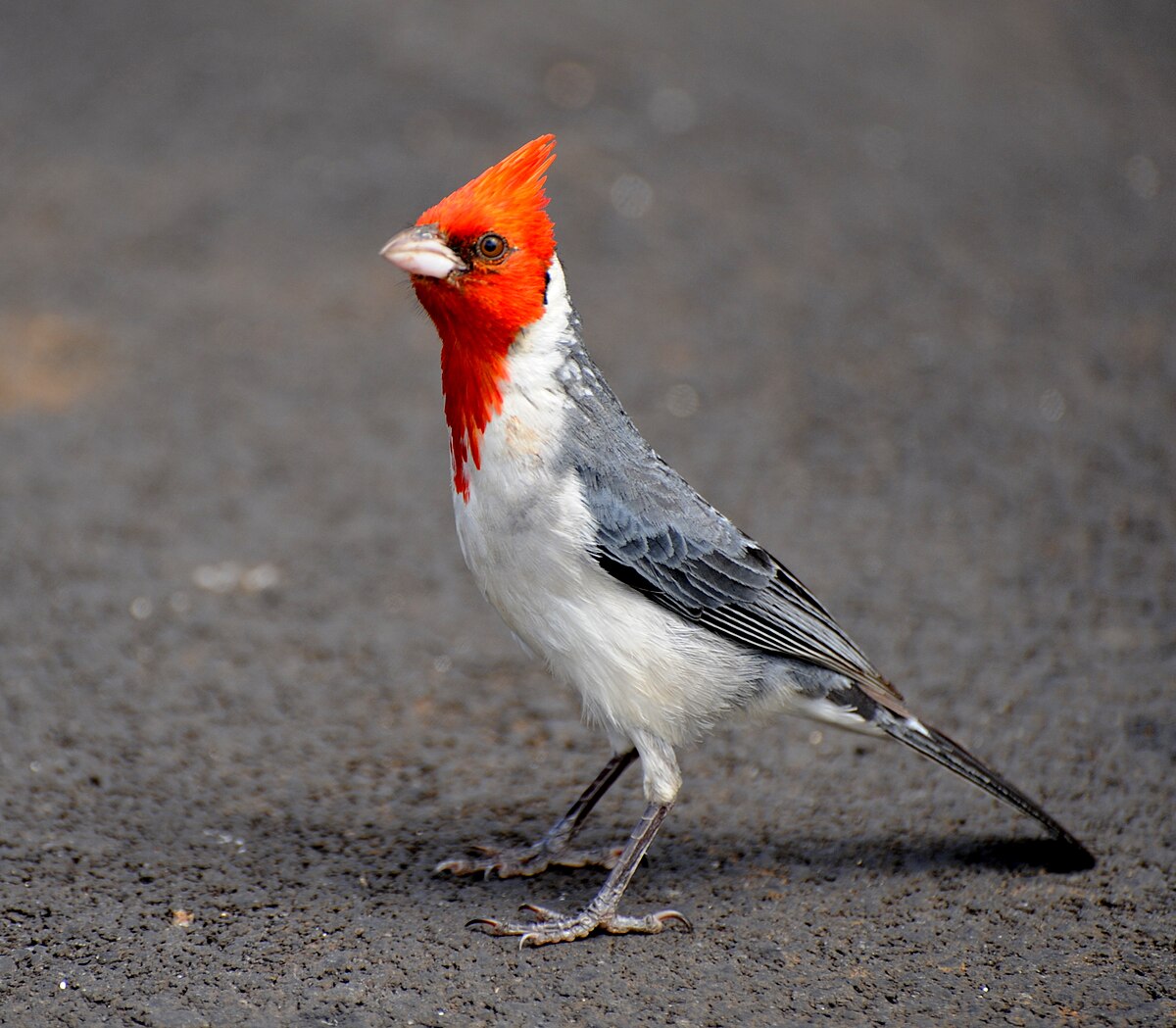
Wikipedia: Red-crested cardinal Source: OTHER
1200px-Paroaria_coronata_-Koke%27e_State_Park%2C_Hawaii%2C_USA-8.jpg
![]() The red-crested cardinal (Paroaria coronata) is a songbird, the species belonging to the family of tanagers (Thraupidae). Notwithstanding its similar name, this bird is not closely related to the true cardinal family (Cardinalidae). It is sometimes known as the Brazilian cardinal.
[more]
The red-crested cardinal (Paroaria coronata) is a songbird, the species belonging to the family of tanagers (Thraupidae). Notwithstanding its similar name, this bird is not closely related to the true cardinal family (Cardinalidae). It is sometimes known as the Brazilian cardinal.
[more]
Profile Wikipedia eBird Audubon AllAboutBirds Xeno-Canto

Wikipedia: Yellow-billed cardinal Source: OTHER
1200px-Yellow-billed_cardinal_%28Paroaria_capitata%29.JPG
![]() The yellow-billed cardinal (Paroaria capitata) is a bird species in the tanager family (Thraupidae). It is not very closely related to the cardinals proper (Cardinalidae).
[more]
The yellow-billed cardinal (Paroaria capitata) is a bird species in the tanager family (Thraupidae). It is not very closely related to the cardinals proper (Cardinalidae).
[more]
Eastern towhee / Rötelgrundammer (Pipilo erythrophthalmus)
Profile Wikipedia eBird Audubon AllAboutBirds Xeno-Canto
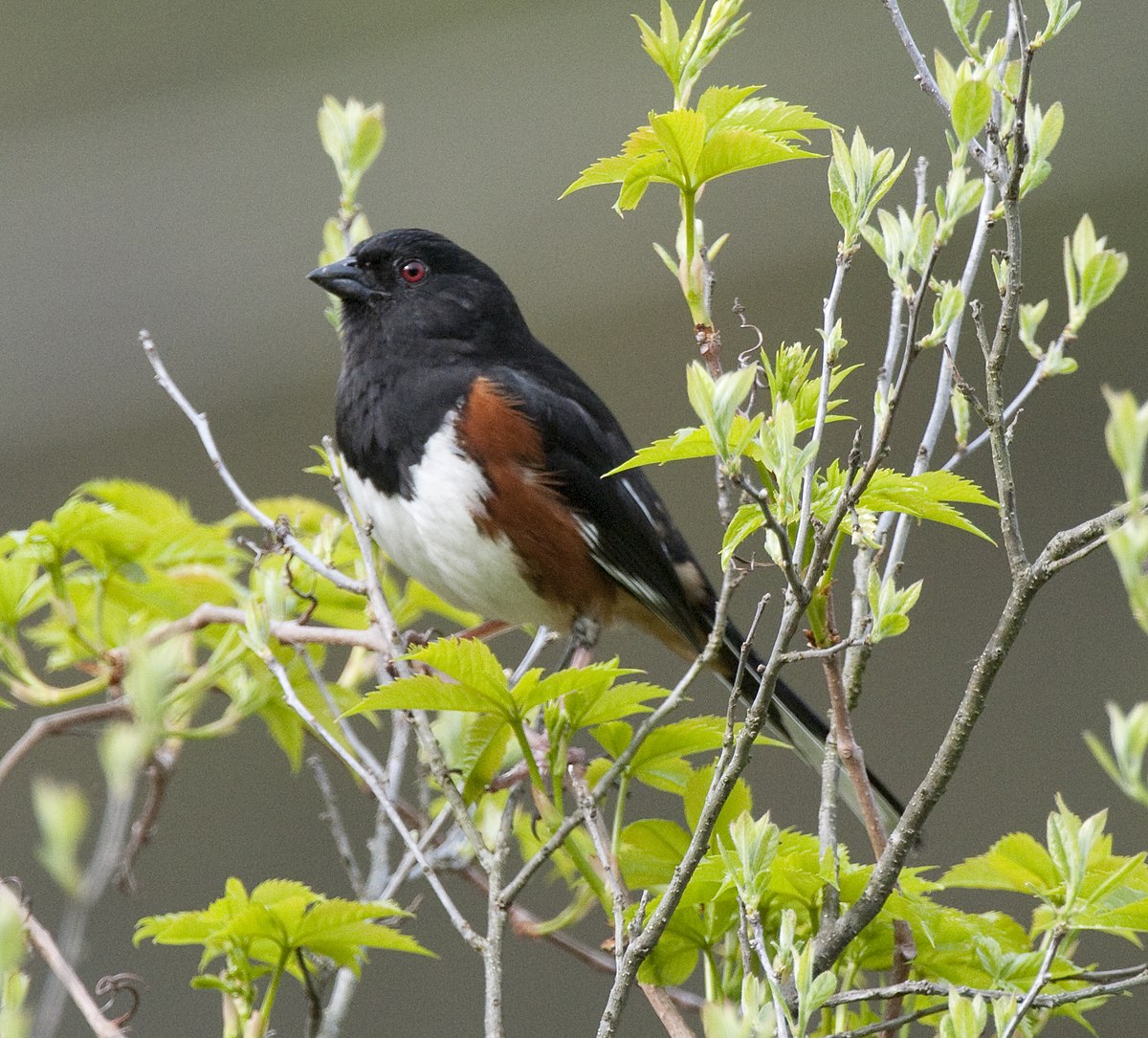
Wikipedia: Eastern towhee Source: OTHER
1200px-Pipilo_erythrophthalmus_-Quabbin_Reservoir%2C_Massachusetts%2C_USA_-male-8.jpg
![]() The eastern towhee (Pipilo erythrophthalmus) is a large New World sparrow. The taxonomy of the towhees has been under debate in recent decades, and formerly this bird and the spotted towhee were considered a single species, the rufous-sided towhee.
[more]
The eastern towhee (Pipilo erythrophthalmus) is a large New World sparrow. The taxonomy of the towhees has been under debate in recent decades, and formerly this bird and the spotted towhee were considered a single species, the rufous-sided towhee.
[more]
Green-tailed towhee (Pipilo chlorurus)
Profile Wikipedia eBird Audubon AllAboutBirds Xeno-Canto

Wikipedia: Green-tailed towhee Source: OTHER
Green-tailed_Towhee.jpg
![]() The green-tailed towhee (Pipilo chlorurus) is the smallest towhee, but is still one of the larger members of the American sparrow family Passerellidae.
[more]
The green-tailed towhee (Pipilo chlorurus) is the smallest towhee, but is still one of the larger members of the American sparrow family Passerellidae.
[more]
Spotted towhee (Pipilo maculatus)
Profile Wikipedia eBird Audubon AllAboutBirds Xeno-Canto
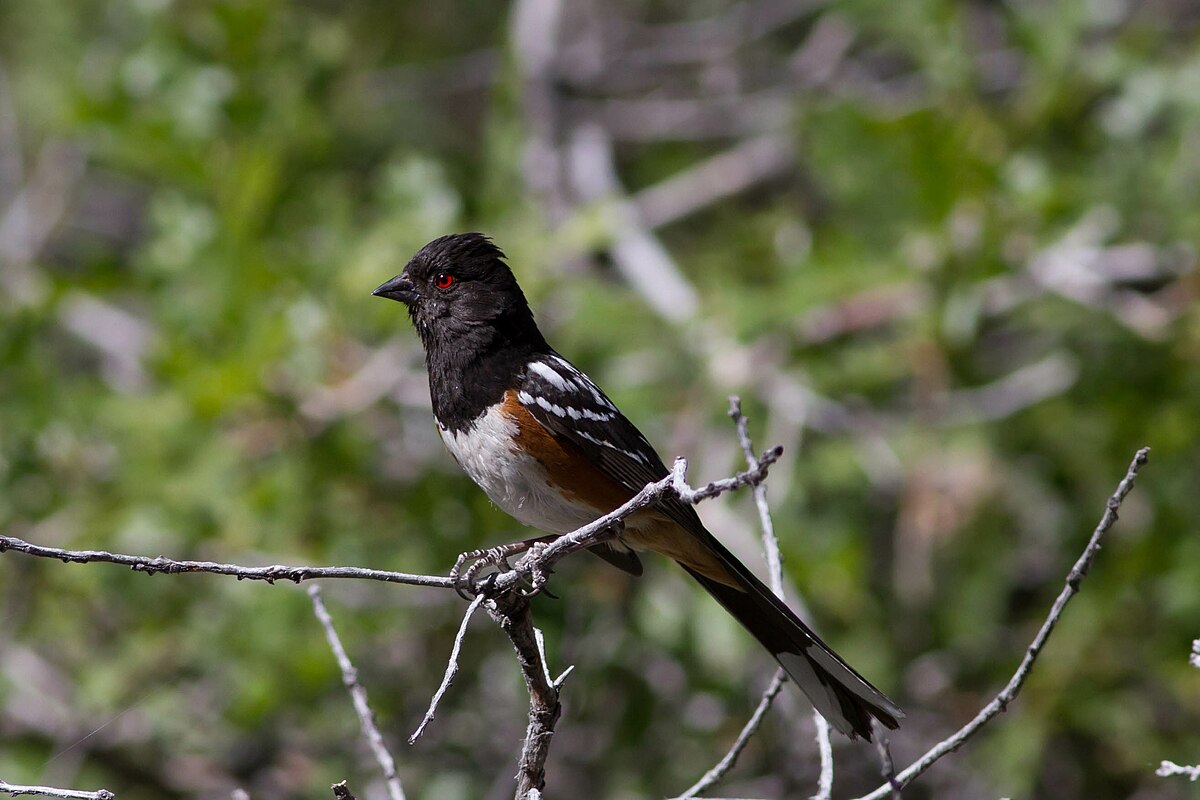
Wikipedia: Spotted towhee Source: OTHER
1200px-Pipilo_maculatus_2.jpg
![]() The spotted towhee (Pipilo maculatus) is a large New World sparrow. The taxonomy of the towhees has been debated in recent decades, and until 1995 this bird and the eastern towhee were considered a single species, the rufous-sided towhee. Literature before 1995 referred to the spotted towhee as a rufous-sided towhee that resides in the western United States.[2] An archaic name for the spotted towhee is the Oregon towhee (Pipilo maculatus oregonus). The call may be harsher and more varied than for the eastern towhee.
[more]
The spotted towhee (Pipilo maculatus) is a large New World sparrow. The taxonomy of the towhees has been debated in recent decades, and until 1995 this bird and the eastern towhee were considered a single species, the rufous-sided towhee. Literature before 1995 referred to the spotted towhee as a rufous-sided towhee that resides in the western United States.[2] An archaic name for the spotted towhee is the Oregon towhee (Pipilo maculatus oregonus). The call may be harsher and more varied than for the eastern towhee.
[more]
Brewer's sparrow (Spizella breweri)
Profile Wikipedia eBird Audubon AllAboutBirds Xeno-Canto
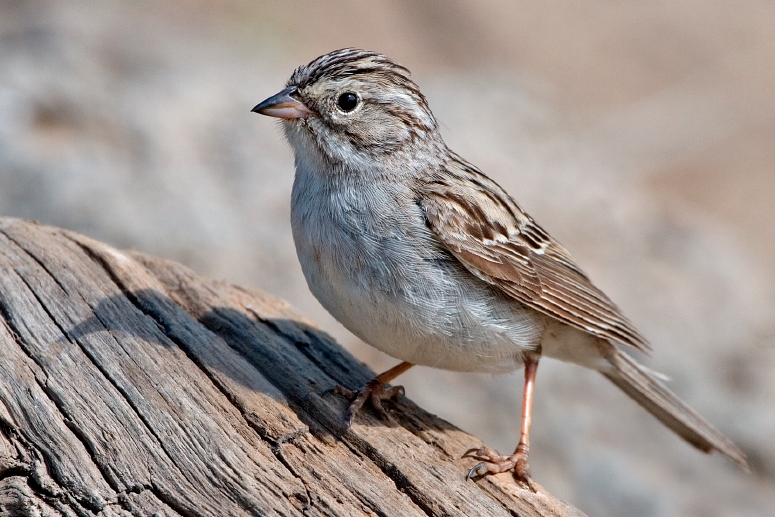
Wikipedia: Brewer's sparrow Source: OTHER
Spizella_breweri.jpg
![]() Brewer's sparrow (Spizella breweri) is a small, slim species of American sparrow in the family Passerellidae. This bird was named after the ornithologist Thomas Mayo Brewer.[2]
[more]
Brewer's sparrow (Spizella breweri) is a small, slim species of American sparrow in the family Passerellidae. This bird was named after the ornithologist Thomas Mayo Brewer.[2]
[more]
Field sparrow (Spizella pusilla)
Profile Wikipedia eBird Audubon AllAboutBirds Xeno-Canto
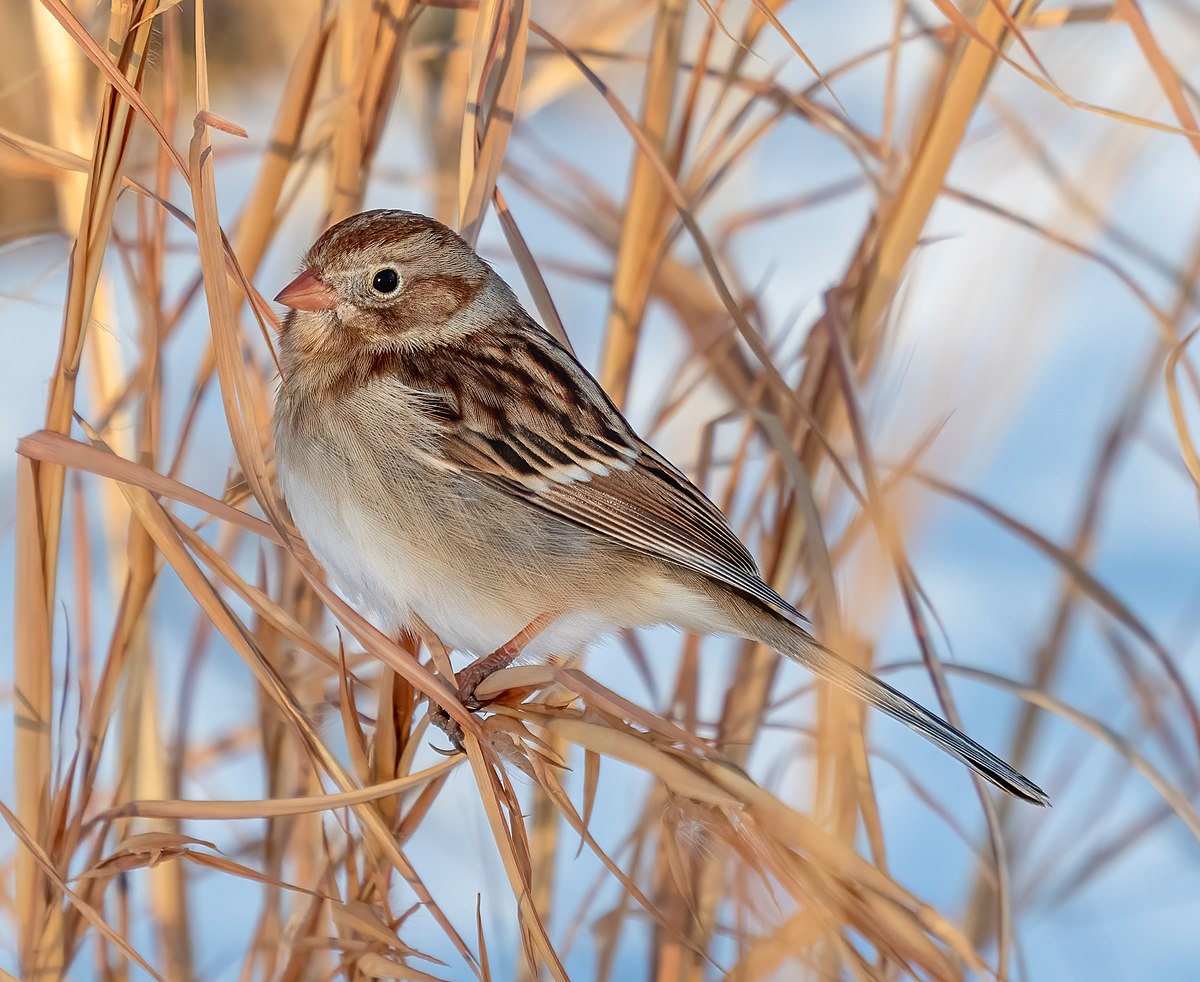
Wikipedia: Field sparrow Source: OTHER
1200px-Field_sparrow_in_CP_%2841484%29_%28cropped%29.jpg
![]() The field sparrow (Spizella pusilla) is a small New World sparrow in the family Passerellidae. It is about 140 mm (6 in) long and weighs about 12.5 g (0.4 oz). The head is grey with a rust-coloured crown, white eye-ring and pink bill. The upper parts are brown streaked with black and buff, the breast is buff, the belly is white and the tail is forked. There are two different colour morphs, one being greyer and the other more rufous.
[more]
The field sparrow (Spizella pusilla) is a small New World sparrow in the family Passerellidae. It is about 140 mm (6 in) long and weighs about 12.5 g (0.4 oz). The head is grey with a rust-coloured crown, white eye-ring and pink bill. The upper parts are brown streaked with black and buff, the breast is buff, the belly is white and the tail is forked. There are two different colour morphs, one being greyer and the other more rufous.
[more]
Chipping sparrow / Schwirrammer (Spizella passerina)
Profile Wikipedia eBird A-Z Animals Audubon AllAboutBirds Xeno-Canto
Chipping sparrow. 2022-05-05 18.58.00 Maryland
First observed in Cockeysville on 2021-06-12.
![]() The chipping sparrow (Spizella passerina) is a species of New World sparrow, a passerine bird in the family Passerellidae. It is widespread, fairly tame, and common across most of its North American range.
[more]
The chipping sparrow (Spizella passerina) is a species of New World sparrow, a passerine bird in the family Passerellidae. It is widespread, fairly tame, and common across most of its North American range.
[more]
Call:
Automatically generated from Xeno-Canto recording
♫ Source: BirdNet
20210612_051438 birdnet 1620 - Chipping Sparrow, sounds like chaff. - Chipping Sparrow - Cockeysville.mp3
2021-06-12 05.14.38 Cockeysville (song?)
Black-chinned sparrow (Spizella atrogularis)

Wikipedia: Black-chinned sparrow Source: OTHER
1200px-Black-chinned_Sparrow_%28Spizella_atrogularis%29_%2816690054929%29.jpg
![]() The black-chinned sparrow (Spizella atrogularis) is a small bird in the genus Spizella, in the New World sparrow family Passerellidae. It is found in the southwestern United States and throughout much of Mexico north of the Isthmus of Tehuantepec; most populations in the US migrate south after breeding while those in Mexico are resident. It is a slim, long-tailed bird, primarily gray with a reddish-brown back streaked with black, brown wings and tail, a pink beak, and brownish legs and feet. In the breeding season, the male shows black on his throat, chin, and the front of his face. Females, youngsters and nonbreeding males show little or no black in these areas. An unobtrusive bird, it spends much of its time foraging slowly along the ground, either alone or in small groups, sometimes mixing with other Spizella species. It is an omnivore, feeding primarily on seeds during the winter and insects during the summer. It builds a cup-shaped nest of grasses, rootlets, or plant fibers, into which the female lays 2–5 pale blue eggs. The female does most or all of the egg incubation, but both parents feed the hatched nestlings.
[more]
The black-chinned sparrow (Spizella atrogularis) is a small bird in the genus Spizella, in the New World sparrow family Passerellidae. It is found in the southwestern United States and throughout much of Mexico north of the Isthmus of Tehuantepec; most populations in the US migrate south after breeding while those in Mexico are resident. It is a slim, long-tailed bird, primarily gray with a reddish-brown back streaked with black, brown wings and tail, a pink beak, and brownish legs and feet. In the breeding season, the male shows black on his throat, chin, and the front of his face. Females, youngsters and nonbreeding males show little or no black in these areas. An unobtrusive bird, it spends much of its time foraging slowly along the ground, either alone or in small groups, sometimes mixing with other Spizella species. It is an omnivore, feeding primarily on seeds during the winter and insects during the summer. It builds a cup-shaped nest of grasses, rootlets, or plant fibers, into which the female lays 2–5 pale blue eggs. The female does most or all of the egg incubation, but both parents feed the hatched nestlings.
[more]
Clay-colored sparrow (Spizella pallida)
Profile Wikipedia eBird Audubon AllAboutBirds Xeno-Canto
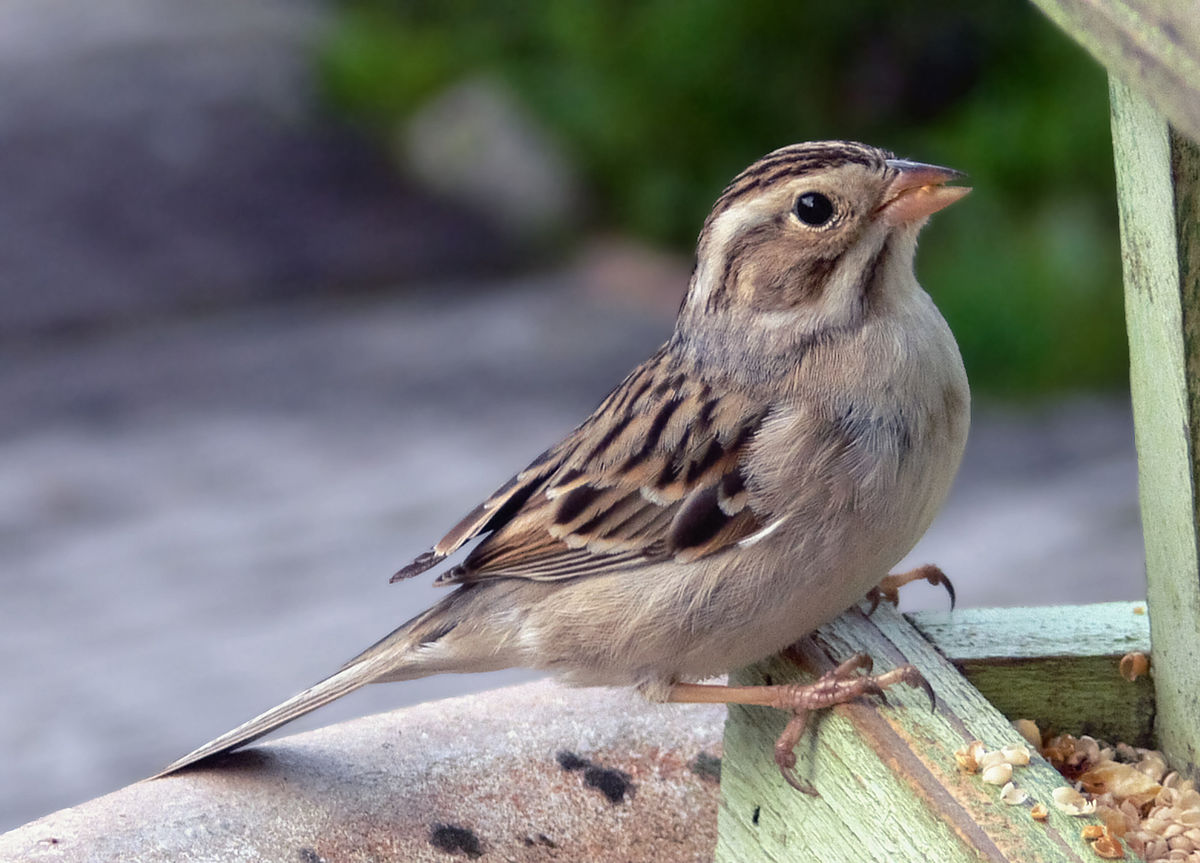
Wikipedia: Clay-colored sparrow Source: OTHER
1200px-Spizella_pallida4_edit.jpg
![]() The clay-colored sparrow or clay-coloured sparrow[2] (Spizella pallida) is a small New World sparrow of North America.
[more]
The clay-colored sparrow or clay-coloured sparrow[2] (Spizella pallida) is a small New World sparrow of North America.
[more]
Dark-eyed junco (Junco hyemalis)
Profile Wikipedia eBird A-Z Animals Audubon AllAboutBirds Xeno-Canto NABU

Wikipedia: Dark-eyed junco Source: OTHER
1200px-Junco_hyemalis_hyemalis_CT2.jpg
This bird appears across the great seas in the following continents:
Europe, North America.
![]() The dark-eyed junco (Junco hyemalis) is a species of junco, a group of small, grayish New World sparrows. This bird is common across much of temperate North America and in summer ranges far into the Arctic. It is a very variable species, much like the related fox sparrow (Passerella iliaca), and its systematics are still not completely untangled.
[more]
The dark-eyed junco (Junco hyemalis) is a species of junco, a group of small, grayish New World sparrows. This bird is common across much of temperate North America and in summer ranges far into the Arctic. It is a very variable species, much like the related fox sparrow (Passerella iliaca), and its systematics are still not completely untangled.
[more]
Yellow-eyed junco / Rotrückenammer (Junco phaeonotus)
Profile Wikipedia eBird Audubon AllAboutBirds Xeno-Canto

Wikipedia: Yellow-eyed junco Source: OTHER
1200px-Junco_phaeonotus_MtLemmon.jpg
![]() The yellow-eyed junco (Junco phaeonotus) is a species of junco, a group of small New World sparrows.
[more]
The yellow-eyed junco (Junco phaeonotus) is a species of junco, a group of small New World sparrows.
[more]
Harris's sparrow / Harris-Ammer (Zonotrichia querula)
Profile Wikipedia eBird Audubon AllAboutBirds Xeno-Canto

Wikipedia: Harris's sparrow Source: OTHER
Harris%27s_Sparrow_%2814u0779_std%29_%28cropped%29.jpg
![]() Harris's sparrow (Zonotrichia querula) is a large sparrow. Their breeding habitat is the north part of central Canada (primarily the Northwest Territories and Nunavut, ranging slightly into northern Manitoba and Saskatchewan), making it Canada's only endemic breeding bird. In the winter they migrate to the Great Plains states of the United States, from southern South Dakota to central Texas. The common name of this species commemorates the American amateur ornithologist Edward Harris (1799–1863).
[more]
Harris's sparrow (Zonotrichia querula) is a large sparrow. Their breeding habitat is the north part of central Canada (primarily the Northwest Territories and Nunavut, ranging slightly into northern Manitoba and Saskatchewan), making it Canada's only endemic breeding bird. In the winter they migrate to the Great Plains states of the United States, from southern South Dakota to central Texas. The common name of this species commemorates the American amateur ornithologist Edward Harris (1799–1863).
[more]
White-crowned sparrow / Dachsammer (Zonotrichia leucophrys)
Profile Wikipedia eBird A-Z Animals Audubon AllAboutBirds Xeno-Canto

Wikipedia: White-crowned sparrow Source: OTHER
1200px-White-crowned-Sparrow.jpg
![]() The white-crowned sparrow (Zonotrichia leucophrys) is a species of passerine bird native to North America. A medium-sized member of the New World sparrow family, this species is marked by a grey face and black and white streaking on the upper head. It breeds in brushy areas in the taiga and tundra of the northernmost parts of the continent and in the Rocky Mountains and Pacific coast. While southerly populations in the Rocky Mountains and coast are largely resident, the breeding populations of the northerly part of its range are migratory and can be found as wintering or passage visitors through most of North America south to central Mexico.
[more]
The white-crowned sparrow (Zonotrichia leucophrys) is a species of passerine bird native to North America. A medium-sized member of the New World sparrow family, this species is marked by a grey face and black and white streaking on the upper head. It breeds in brushy areas in the taiga and tundra of the northernmost parts of the continent and in the Rocky Mountains and Pacific coast. While southerly populations in the Rocky Mountains and coast are largely resident, the breeding populations of the northerly part of its range are migratory and can be found as wintering or passage visitors through most of North America south to central Mexico.
[more]
Golden-crowned sparrow / Kronenammer (Zonotrichia atricapilla)
Profile Wikipedia eBird Audubon AllAboutBirds Xeno-Canto
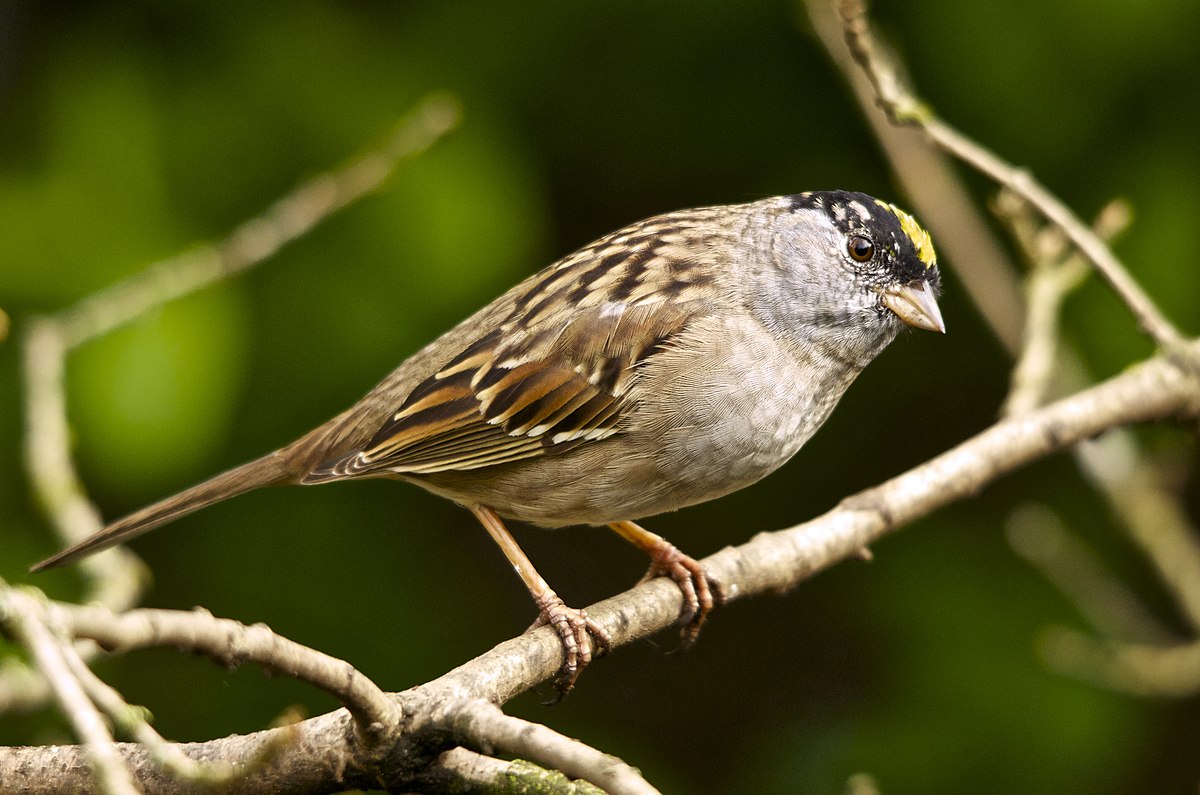
Wikipedia: Golden-crowned sparrow Source: OTHER
1200px-Zonotrichia_atricapilla_-British_Columbia%2C_Canada-8.jpg
![]() The golden-crowned sparrow (Zonotrichia atricapilla) is a large New World sparrow found in the western part of North America.
[more]
The golden-crowned sparrow (Zonotrichia atricapilla) is a large New World sparrow found in the western part of North America.
[more]
White-throated sparrow (Zonotrichia albicollis)
Profile Wikipedia eBird Audubon AllAboutBirds Xeno-Canto
White throated sparrow. 2022-04-28 18.48.42 Maryland
First observed in Cockeysville on 2022-04-28.
![]() The white-throated sparrow (Zonotrichia albicollis) is a passerine bird of the New World sparrow family Passerellidae.
[more]
The white-throated sparrow (Zonotrichia albicollis) is a passerine bird of the New World sparrow family Passerellidae.
[more]
Call:
Automatically generated from Xeno-Canto recording
♫ Source: BirdNet
20220430_094851 birdnet - White-throated Sparrow - 2022-04-30 09:48:51 - White-throated Sparrow - Cockeysville.mp3
2022-04-30 09.48.51 Cockeysville (song?)
Fox sparrow (Passerella iliaca)
Profile Wikipedia eBird Audubon AllAboutBirds Xeno-Canto
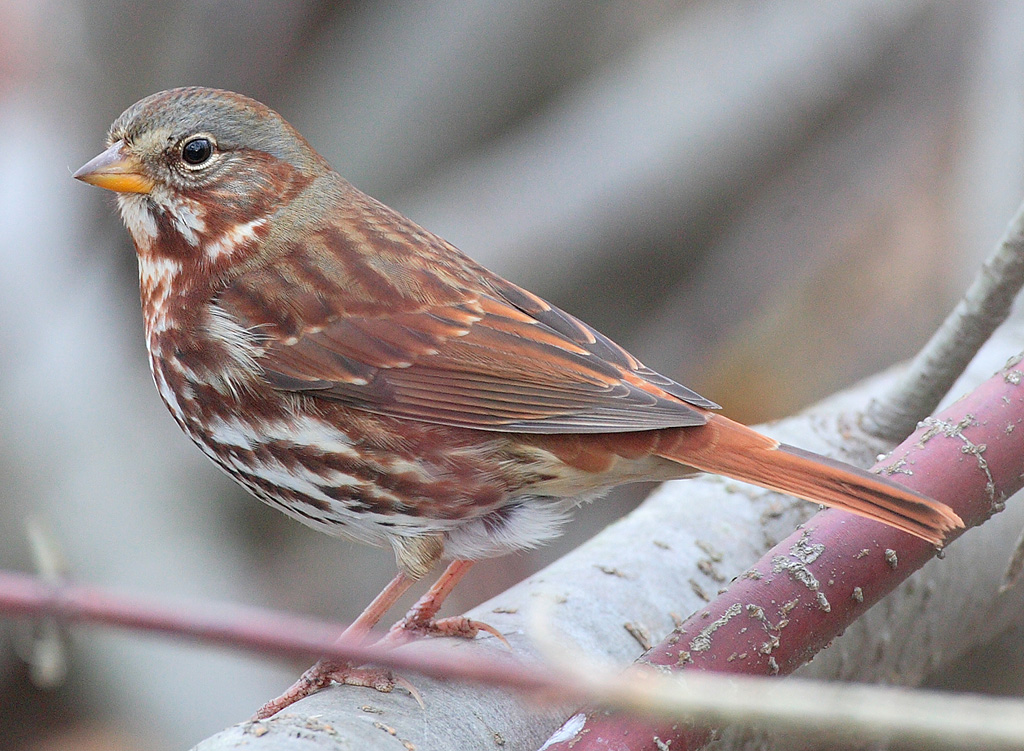
Wikipedia: Fox sparrow Source: OTHER
Passerella_iliaca-001.jpg
![]() The fox sparrow (Passerella iliaca) is a large New World sparrow. It is the only member of the genus Passerella, although some authors split the species into four (see below).
[more]
The fox sparrow (Passerella iliaca) is a large New World sparrow. It is the only member of the genus Passerella, although some authors split the species into four (see below).
[more]
Song sparrow / Singammer (Melospiza melodia)
Here's a song sparrows Mark and I saw in Cromwell Valley Park. 2021-06-18 10.10.52
First observed in Cockeysville on 2021-06-13.
I had distinct memories of reading about the song sparrow in the two major books I read about bird biology in general (U. Cornell) and about birdsong by Marler and Slabbekoorn. Once I realized I heard them every morning at my mother's house and thoroughly enjoyed them - in Europe no sparrow really sings in any serious manner - I had to go back to read about all the research into song sparrows in those two books.
Song: ![]() Nature's Music: the Science of Birdsong Peter Marler and Hans Slabbekoorn, 2004. In this study it was found that young song sparrows recognize both a typical sound type, a trill, and the temporal pattern of the song, whereas swamp sparrows only listen for the trill, having no complex song. [page 82: acoustic cues for species-selective song learning]
Nature's Music: the Science of Birdsong Peter Marler and Hans Slabbekoorn, 2004. In this study it was found that young song sparrows recognize both a typical sound type, a trill, and the temporal pattern of the song, whereas swamp sparrows only listen for the trill, having no complex song. [page 82: acoustic cues for species-selective song learning]
![]() Ibid. The authors describe the singing with amusing terms, puff-sing-wave used to drive off a territorial intruder, and the aggressive 'zhee' call used throughout the year to threaten other species or other song sparrows. [page 165]
Ibid. The authors describe the singing with amusing terms, puff-sing-wave used to drive off a territorial intruder, and the aggressive 'zhee' call used throughout the year to threaten other species or other song sparrows. [page 165]
![]() Ibid. It was seen (by Hiebert et al in 1989) that song sparrows with a larger repertoire acquired a territory more quickly and survived longer. [page 48]
Ibid. It was seen (by Hiebert et al in 1989) that song sparrows with a larger repertoire acquired a territory more quickly and survived longer. [page 48]
![]() Ibid. It was seen that song sparrows matched the song repertoire of a neighbor to show that they were recognized. The authors (Beecher et al 1996) said that though not very aggressive, echoing the song of a neighbor's repertoire is more aggressive than singing a completely different song. [page 50]
Ibid. It was seen that song sparrows matched the song repertoire of a neighbor to show that they were recognized. The authors (Beecher et al 1996) said that though not very aggressive, echoing the song of a neighbor's repertoire is more aggressive than singing a completely different song. [page 50]
![]() Ibid. Another theory is that knowing all the songs of a neighbor means that it is sufficient to just responds those songs. If a bird has had to move to a more distant area or knows fewer songs himself, he may need to fight more often to prove the same point. [page 51-52]
Ibid. Another theory is that knowing all the songs of a neighbor means that it is sufficient to just responds those songs. If a bird has had to move to a more distant area or knows fewer songs himself, he may need to fight more often to prove the same point. [page 51-52]
![]() Ibid. Young birds are said to learn songs from either one adult male after hatching, therefore in the area his parents did their breeding, or after migration the following spring, in which case it learns other songs from a male there. Dialects happen because birds tend to breed and therefore to sing in the same local area where they learned their songs. [page 115-116]
Ibid. Young birds are said to learn songs from either one adult male after hatching, therefore in the area his parents did their breeding, or after migration the following spring, in which case it learns other songs from a male there. Dialects happen because birds tend to breed and therefore to sing in the same local area where they learned their songs. [page 115-116]
![]() The Cornell Lab of Ornithology Handbook of Bird Biology Edited by Irby J. Lovette and John W. Fitzpatrick, 2016. One study shows that birds under stress during song learning in early development produce poor quality songs with fewer copied notes. Females prefer songs learned with accuracy, so these poor stress-out kids are out of luck. [page 324]
The Cornell Lab of Ornithology Handbook of Bird Biology Edited by Irby J. Lovette and John W. Fitzpatrick, 2016. One study shows that birds under stress during song learning in early development produce poor quality songs with fewer copied notes. Females prefer songs learned with accuracy, so these poor stress-out kids are out of luck. [page 324]
![]() Ibid. Beecher 2008 notes that song sparrows always learn an entire song and don't link two different songs; and that they tend to learn songs sung by many different males in their new neighbohood, making the song more useful to them. [page 375]
Ibid. Beecher 2008 notes that song sparrows always learn an entire song and don't link two different songs; and that they tend to learn songs sung by many different males in their new neighbohood, making the song more useful to them. [page 375]
![]() Ibid. Stoddard et all 1991 noted that though each song sparrow has a repertoire of 10 songs, the set of neighbors will have about 50 all in all, but each can recognize the individuals. As I understood from the discussion before that, the point is that each can recognize the other's voice if they both sing the same song [page 384]
Ibid. Stoddard et all 1991 noted that though each song sparrow has a repertoire of 10 songs, the set of neighbors will have about 50 all in all, but each can recognize the individuals. As I understood from the discussion before that, the point is that each can recognize the other's voice if they both sing the same song [page 384]
![]() Ibid. Here it's mentioned that birds with more songs in their repertoire live longer - whether song sparrows in North America or great tits, which live right by our home. [page 396]
Ibid. Here it's mentioned that birds with more songs in their repertoire live longer - whether song sparrows in North America or great tits, which live right by our home. [page 396]
![]() Ibid. Some birds like white-crowned sparrows are "open ended learners", and could learn song sparrow songs but prefer those of their own species. These open ended learners continue to learn songs well into adulthood or even throughout their lives. [page 371]
Ibid. Some birds like white-crowned sparrows are "open ended learners", and could learn song sparrow songs but prefer those of their own species. These open ended learners continue to learn songs well into adulthood or even throughout their lives. [page 371]
Song:
Automatically generated from Xeno-Canto recording
Song attributes:
Frequency:
♫ Catbird plus song sparrow, 18 Cherrywood Court. 2021-06-16 20.27.47 Cherrywood (song)
Call:
Automatically generated from Xeno-Canto recording
♫ Song sparrow, Cherrywood Court. ![]() Source: Zoom H6 2022-04-29 08.29.46 Cherrywood (song?)
Source: Zoom H6 2022-04-29 08.29.46 Cherrywood (song?)
Swamp sparrow (Melospiza georgiana)
Profile Wikipedia eBird Audubon AllAboutBirds Xeno-Canto

Wikipedia: Swamp sparrow Source: OTHER
1200px-Melospiza_georgiana_MN1.jpg
General: ![]() The swamp sparrow (Melospiza georgiana) is a medium-sized New World sparrow related to the song sparrow.
[more]
The swamp sparrow (Melospiza georgiana) is a medium-sized New World sparrow related to the song sparrow.
[more]
Lincoln's sparrow / Lincoln-Ammer (Melospiza lincolnii)
Profile Wikipedia eBird Audubon AllAboutBirds Xeno-Canto

Wikipedia: Lincoln's sparrow Source: OTHER
1200px-Lincoln%27s_Sparrow_at_bird_feeder.jpg
![]() Lincoln's sparrow (Melospiza lincolnii) is a small sparrow native to North America. It is a less common passerine bird that often stays hidden under thick ground cover, but can be distinguished by its sweet, wrenlike song. Lincoln's sparrow is one of three species in the genus Melospiza which also includes the song sparrow (M. melodia) and the swamp sparrow (M. georgiana). It lives in well-covered brushy habitats, often near water. This bird is poorly documented because of its secretive nature and breeding habits solely in boreal regions.[2]
[more]
Lincoln's sparrow (Melospiza lincolnii) is a small sparrow native to North America. It is a less common passerine bird that often stays hidden under thick ground cover, but can be distinguished by its sweet, wrenlike song. Lincoln's sparrow is one of three species in the genus Melospiza which also includes the song sparrow (M. melodia) and the swamp sparrow (M. georgiana). It lives in well-covered brushy habitats, often near water. This bird is poorly documented because of its secretive nature and breeding habits solely in boreal regions.[2]
[more]
Grasshopper sparrow / Heuschreckenammer (Ammodramus savannarum)
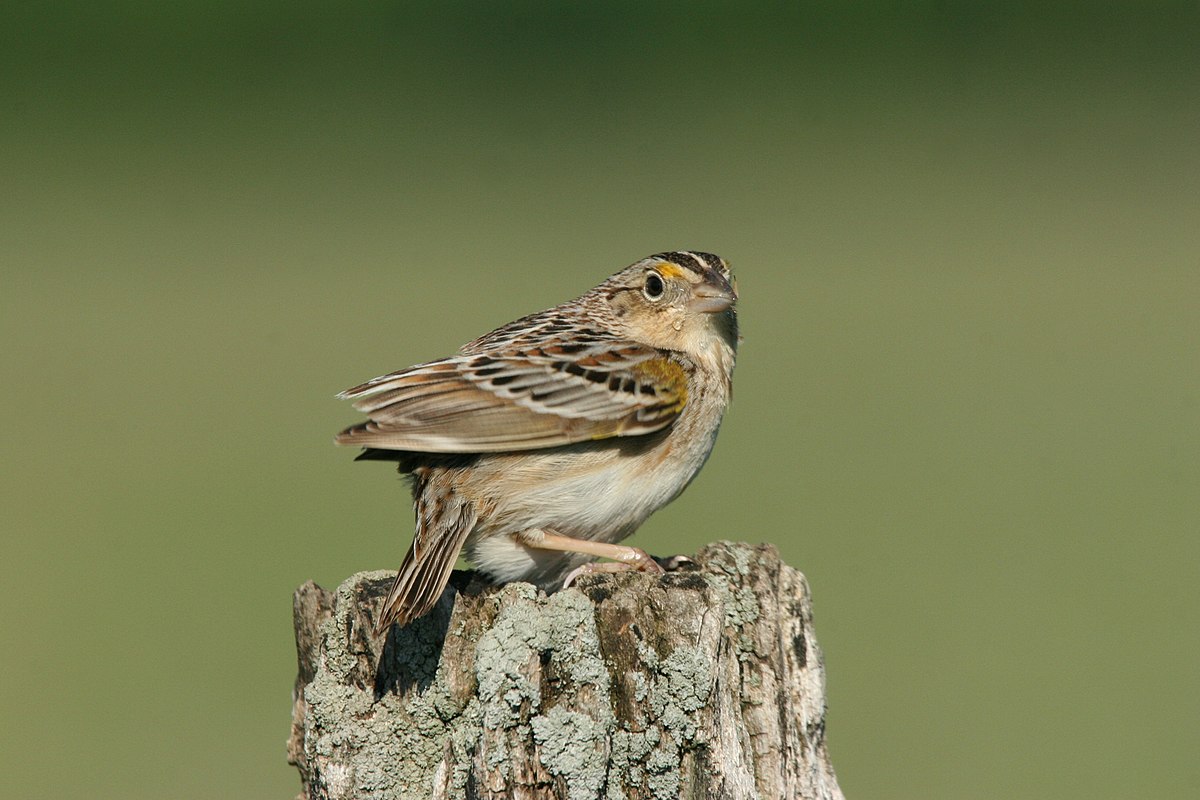
Wikipedia: Grasshopper sparrow Source: OTHER
1200px-Grasshopper_Sparrow.jpg
![]() The grasshopper sparrow (Ammodramus savannarum) is a small New World sparrow. The genus Ammodramus contains nine species that inhabit grasslands and prairies.
[more]
The grasshopper sparrow (Ammodramus savannarum) is a small New World sparrow. The genus Ammodramus contains nine species that inhabit grasslands and prairies.
[more]
Olive sparrow (Arremonops rufivirgatus)
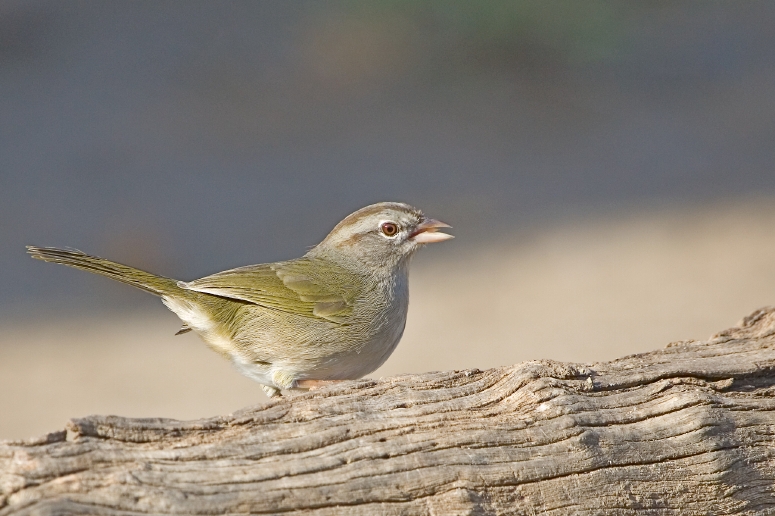
Wikipedia: Olive sparrow Source: OTHER
Arremonops_rufivirgatus.jpg
![]() The olive sparrow (Arremonops rufivirgatus) is a species of American sparrow in the family Passerellidae. (Other names include green finch and Texas sparrow.) Its range includes Belize, Costa Rica, Guatemala, Honduras, Mexico, Nicaragua and southern Texas (including the counties of Val Verde, Atascosa, and Nueces).
[more]
The olive sparrow (Arremonops rufivirgatus) is a species of American sparrow in the family Passerellidae. (Other names include green finch and Texas sparrow.) Its range includes Belize, Costa Rica, Guatemala, Honduras, Mexico, Nicaragua and southern Texas (including the counties of Val Verde, Atascosa, and Nueces).
[more]
California towhee (Melozone crissalis)

Wikipedia: California towhee Source: OTHER
1200px-Melozone_crissalis_103257560.jpg
![]() The California towhee (Melozone crissalis) is a bird of the family Passerellidae, native to the coastal regions of western Oregon and California in the United States and Baja California Sur in Mexico.
[more]
The California towhee (Melozone crissalis) is a bird of the family Passerellidae, native to the coastal regions of western Oregon and California in the United States and Baja California Sur in Mexico.
[more]
Abert's towhee (Melozone aberti)

Wikipedia: Abert's towhee Source: OTHER
Pipilo_aberti.jpg
![]() Abert's towhee (Melozone aberti) is a bird of the family Passerellidae, native to a small range in southwestern North America, generally the lower Colorado River and Gila River watersheds, nearly endemic to Arizona, but also present in small parts of California, Nevada, Utah, New Mexico, and Sonora in Mexico. The name of this bird commemorates the American ornithologist James William Abert (1820–1897).
[more]
Abert's towhee (Melozone aberti) is a bird of the family Passerellidae, native to a small range in southwestern North America, generally the lower Colorado River and Gila River watersheds, nearly endemic to Arizona, but also present in small parts of California, Nevada, Utah, New Mexico, and Sonora in Mexico. The name of this bird commemorates the American ornithologist James William Abert (1820–1897).
[more]
Lark sparrow (Chondestes grammacus)
Profile Wikipedia eBird Audubon AllAboutBirds Xeno-Canto

Wikipedia: Lark sparrow Source: OTHER
LarkSparrow.jpg
![]() The lark sparrow (Chondestes grammacus) is a fairly large New World sparrow. It is the only member of the genus Chondestes.
[more]
The lark sparrow (Chondestes grammacus) is a fairly large New World sparrow. It is the only member of the genus Chondestes.
[more]
Savannah sparrow (Passerculus sandwichensis)

Wikipedia: Savannah sparrow Source: OTHER
1200px-Passerculus_sandwichensis_crop.jpg
![]() The Savannah sparrow (Passerculus sandwichensis) is a small New World sparrow. It was the only member of the genus Passerculus and is typically the only widely accepted member. Comparison of mtDNA NADH dehydrogenase subunit 2 and 3 sequences indicates that the Ipswich sparrow, formerly usually considered a valid species (as Passerculus princeps), is a well-marked subspecies of the Savannah sparrow, whereas the southwestern large-billed sparrow should be recognized as a distinct species (Passerculus rostratus).[2]
[more]
The Savannah sparrow (Passerculus sandwichensis) is a small New World sparrow. It was the only member of the genus Passerculus and is typically the only widely accepted member. Comparison of mtDNA NADH dehydrogenase subunit 2 and 3 sequences indicates that the Ipswich sparrow, formerly usually considered a valid species (as Passerculus princeps), is a well-marked subspecies of the Savannah sparrow, whereas the southwestern large-billed sparrow should be recognized as a distinct species (Passerculus rostratus).[2]
[more]
Rufous-crowned sparrow (Aimophila ruficeps)

Wikipedia: Rufous-crowned sparrow Source: OTHER
1200px-Rufous-crowned_Sparrow.jpg
![]() The rufous-crowned sparrow (Aimophila ruficeps) is a small American sparrow. This passerine is primarily found across the Southwestern United States and much of the interior of Mexico, south to the transverse mountain range, and to the Pacific coast to the southwest of the transverse range. Its distribution is patchy, with populations often being isolated from each other. Twelve subspecies are generally recognized, though up to eighteen have been suggested. This bird has a brown back with darker streaks and gray underparts. The crown is rufous, and the face and supercilium are gray with a brown or rufous streak extending from each eye and a thick black malar streak.
[more]
The rufous-crowned sparrow (Aimophila ruficeps) is a small American sparrow. This passerine is primarily found across the Southwestern United States and much of the interior of Mexico, south to the transverse mountain range, and to the Pacific coast to the southwest of the transverse range. Its distribution is patchy, with populations often being isolated from each other. Twelve subspecies are generally recognized, though up to eighteen have been suggested. This bird has a brown back with darker streaks and gray underparts. The crown is rufous, and the face and supercilium are gray with a brown or rufous streak extending from each eye and a thick black malar streak.
[more]
Lark bunting (Calamospiza melanocorys)
Profile Wikipedia eBird Audubon AllAboutBirds Xeno-Canto

Wikipedia: Lark bunting Source: OTHER
1200px-Calamospiza_melanocorys_by_Nick_Varvel.jpg
![]() The lark bunting (Calamospiza melanocorys) is a medium-sized American sparrow native to central and western North America. It is also the state bird of Colorado.
[more]
The lark bunting (Calamospiza melanocorys) is a medium-sized American sparrow native to central and western North America. It is also the state bird of Colorado.
[more]
Five-striped sparrow (Amphispiza quinquestriata)

Wikipedia: Five-striped sparrow Source: OTHER
1200px-Amphispiza_quinquestriata.jpg
![]() The five-striped sparrow (Amphispiza quinquestriata) is a medium-sized sparrow.
[more]
The five-striped sparrow (Amphispiza quinquestriata) is a medium-sized sparrow.
[more]
Black-throated sparrow (Amphispiza bilineata)
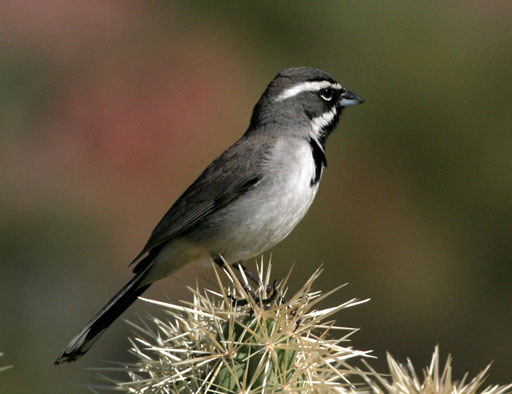
Wikipedia: Black-throated sparrow Source: OTHER
Amphispiza_bilineataPCCA20050311-5951B.jpg
![]() The black-throated sparrow (Amphispiza bilineata) is a small New World sparrow primarily found in the southwestern United States and Mexico. It is sometimes referred to as the desert sparrow, due to its preferred habitat of arid desert hillsides and scrub. This name usually refers to the desert sparrow of Africa and Asia.
[more]
The black-throated sparrow (Amphispiza bilineata) is a small New World sparrow primarily found in the southwestern United States and Mexico. It is sometimes referred to as the desert sparrow, due to its preferred habitat of arid desert hillsides and scrub. This name usually refers to the desert sparrow of Africa and Asia.
[more]
Vesper sparrow (Pooecetes gramineus)
Profile Wikipedia eBird Audubon AllAboutBirds Xeno-Canto

Wikipedia: Vesper sparrow Source: OTHER
1200px-Pooecetes_gramineus_-USA-8.jpg
![]() The vesper sparrow (Pooecetes gramineus) is a medium-sized New World sparrow. It is the only member of the genus Pooecetes.
[more]
The vesper sparrow (Pooecetes gramineus) is a medium-sized New World sparrow. It is the only member of the genus Pooecetes.
[more]
Nelson's sparrow (Ammospiza nelsoni)
Profile Wikipedia eBird Audubon AllAboutBirds Xeno-Canto
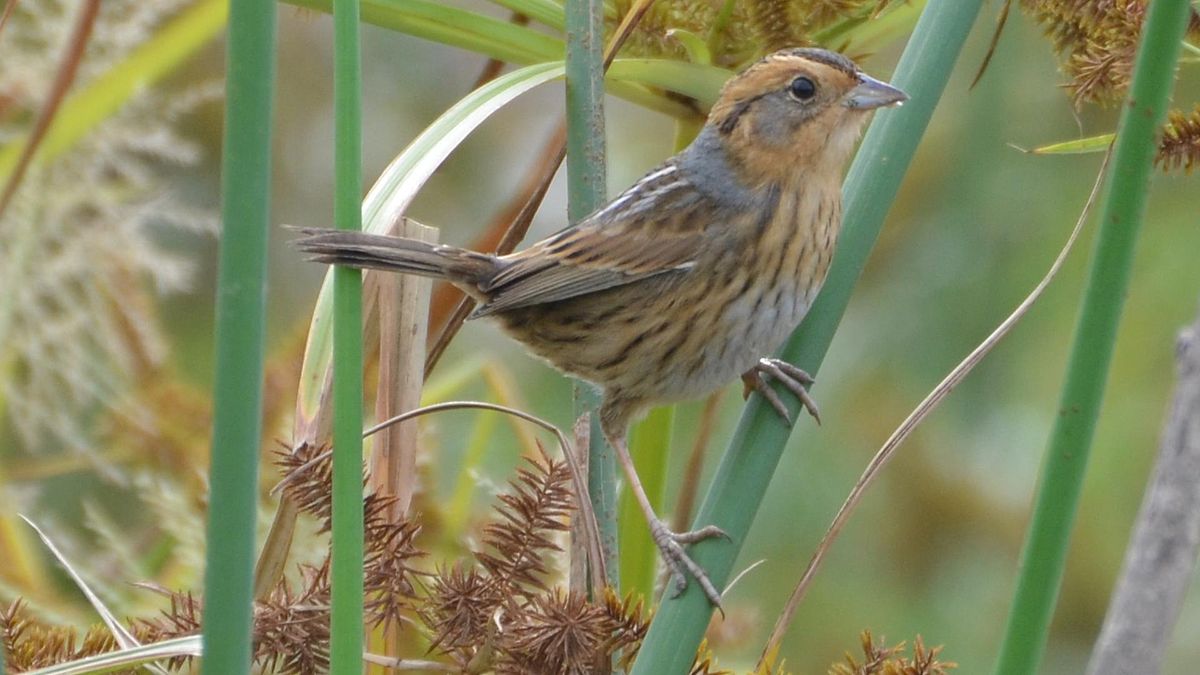
Wikipedia: Nelson's sparrow Source: OTHER
1200px-Ammodramus_nelsoni_-Riverlands_Migratory_Bird_Sanctuary%2C_Missouri%2C_USA-8_%281%29.jpg
![]() Nelson's sparrow (Ammospiza nelsoni) is a small New World sparrow. This bird was named after Edward William Nelson, an American naturalist. Formerly, this bird and the saltmarsh sparrow were considered to be a single species, the sharp-tailed sparrow; because of this it was briefly known as Nelson's sharp-tailed sparrow.
[more]
Nelson's sparrow (Ammospiza nelsoni) is a small New World sparrow. This bird was named after Edward William Nelson, an American naturalist. Formerly, this bird and the saltmarsh sparrow were considered to be a single species, the sharp-tailed sparrow; because of this it was briefly known as Nelson's sharp-tailed sparrow.
[more]
Saltmarsh sparrow (Ammospiza caudacta)
Profile Wikipedia eBird Audubon AllAboutBirds Xeno-Canto

Wikipedia: Saltmarsh sparrow Source: OTHER
Saltmarsh_sharp_tailed_sparrow.jpg
![]() The saltmarsh sparrow (Ammospiza caudacuta) is a small New World sparrow found in salt marshes along the Atlantic coast of the United States. At one time, this bird and the Nelson's sparrow were thought to be a single species, the sharp-tailed sparrow. Because of this, the species was briefly known as the "saltmarsh sharp-tailed sparrow."
[more]
The saltmarsh sparrow (Ammospiza caudacuta) is a small New World sparrow found in salt marshes along the Atlantic coast of the United States. At one time, this bird and the Nelson's sparrow were thought to be a single species, the sharp-tailed sparrow. Because of this, the species was briefly known as the "saltmarsh sharp-tailed sparrow."
[more]
Leconte's sparrow (Ammospiza leconteii)

Wikipedia: Leconte's sparrow Source: OTHER
1200px-LESP-Erickson.jpg
![]() LeConte's sparrow (Ammospiza leconteii) is one of the smallest New World sparrow species in North America.[2]
[more]
LeConte's sparrow (Ammospiza leconteii) is one of the smallest New World sparrow species in North America.[2]
[more]
Seaside sparrow (Ammospiza maritima)

Wikipedia: Seaside sparrow Source: OTHER
CSSS1.jpg
![]() The seaside sparrow (Ammospiza maritima) is a small American sparrow.
[more]
The seaside sparrow (Ammospiza maritima) is a small American sparrow.
[more]
Henslow's sparrow (Centronyx henslowii)

Wikipedia: Henslow's sparrow Source: OTHER
1200px-Henslows_Sparrow_%28Ammodramus_henslowii%29_%285752598436%29.jpg
![]() Henslow's sparrow (Centronyx henslowii) is a passerine bird in the family Passerellidae. It was named by John James Audubon in honor of John Stevens Henslow. It was originally classified in the genus Emberiza and called Henslow's bunting.[2]
[more]
Henslow's sparrow (Centronyx henslowii) is a passerine bird in the family Passerellidae. It was named by John James Audubon in honor of John Stevens Henslow. It was originally classified in the genus Emberiza and called Henslow's bunting.[2]
[more]
Baird's sparrow (Centronyx bairdii)

Wikipedia: Baird's sparrow Source: OTHER
1200px-Baird%27s_Sparrow_%2825865756586%29_%28cropped%29.jpg
![]() Baird's sparrow (Centronyx bairdii) is a species of North American birds in the family Passerellidae of order Passeriformes. It is a migratory bird native to the United States, Canada, and Mexico.
[more]
Baird's sparrow (Centronyx bairdii) is a species of North American birds in the family Passerellidae of order Passeriformes. It is a migratory bird native to the United States, Canada, and Mexico.
[more]
American tree sparrow / Baumammer (Spizelloides arborea)
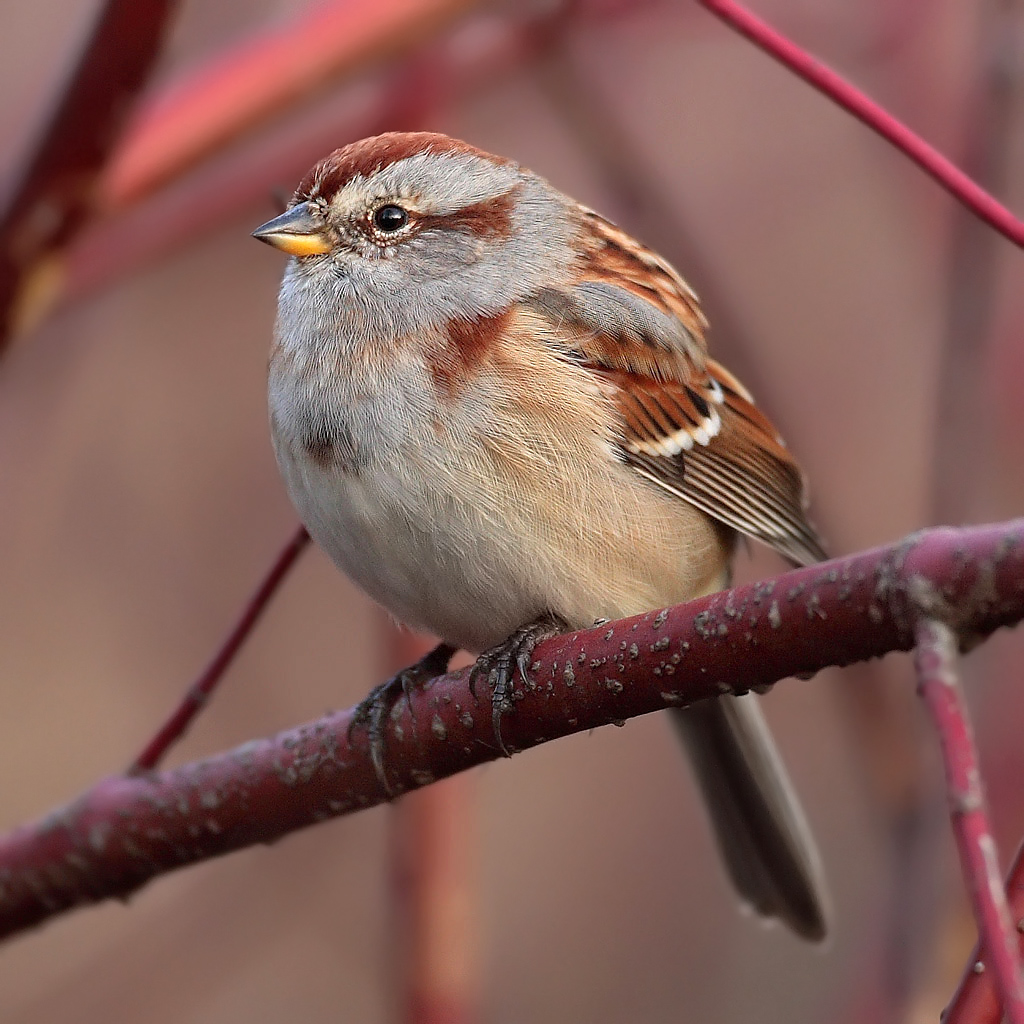
Wikipedia: American tree sparrow Source: OTHER
Spizella-arborea-002_edit2.jpg
![]() The American tree sparrow (Spizelloides arborea), also known as the winter sparrow,[2] is a medium-sized New World sparrow.
[more]
The American tree sparrow (Spizelloides arborea), also known as the winter sparrow,[2] is a medium-sized New World sparrow.
[more]
Profile Wikipedia eBird Audubon AllAboutBirds Xeno-Canto
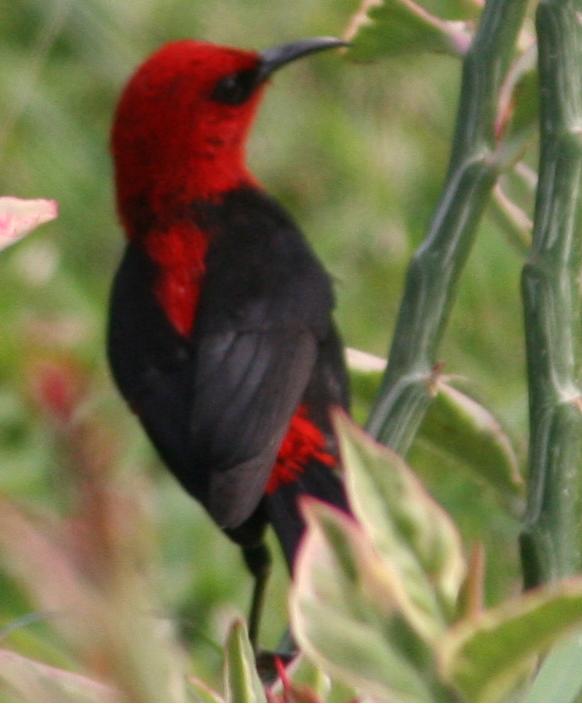
Wikipedia: Cardinal myzomela Source: OTHER
Myzomela_cardinalis_1.jpg
![]() The cardinal myzomela (Myzomela cardinalis) is a species of bird in the honeyeater family Meliphagidae. It is named for the scarlet color of the male. It is found in American Samoa, New Caledonia, Samoa, Solomon Islands, and Vanuatu, as well as some islands in Micronesia such as Yap. Its natural habitats are subtropical or tropical moist lowland forest and subtropical or tropical mangrove forest.[1] It frequents areas with flowers, such as gardens. This is a small, active bird, measuring about 13 cm (5.1 in) from bill to tail.[2] Males are red and black in coloration, females are grayish-olive, sometimes with a red cap or red head. Its long, curved bill is especially adapted for reaching into flowers for nectar.[3] Cardinal myzomela populations have vanished from the island of Guam since the invasion of the brown tree snake.[4]
[more]
The cardinal myzomela (Myzomela cardinalis) is a species of bird in the honeyeater family Meliphagidae. It is named for the scarlet color of the male. It is found in American Samoa, New Caledonia, Samoa, Solomon Islands, and Vanuatu, as well as some islands in Micronesia such as Yap. Its natural habitats are subtropical or tropical moist lowland forest and subtropical or tropical mangrove forest.[1] It frequents areas with flowers, such as gardens. This is a small, active bird, measuring about 13 cm (5.1 in) from bill to tail.[2] Males are red and black in coloration, females are grayish-olive, sometimes with a red cap or red head. Its long, curved bill is especially adapted for reaching into flowers for nectar.[3] Cardinal myzomela populations have vanished from the island of Guam since the invasion of the brown tree snake.[4]
[more]
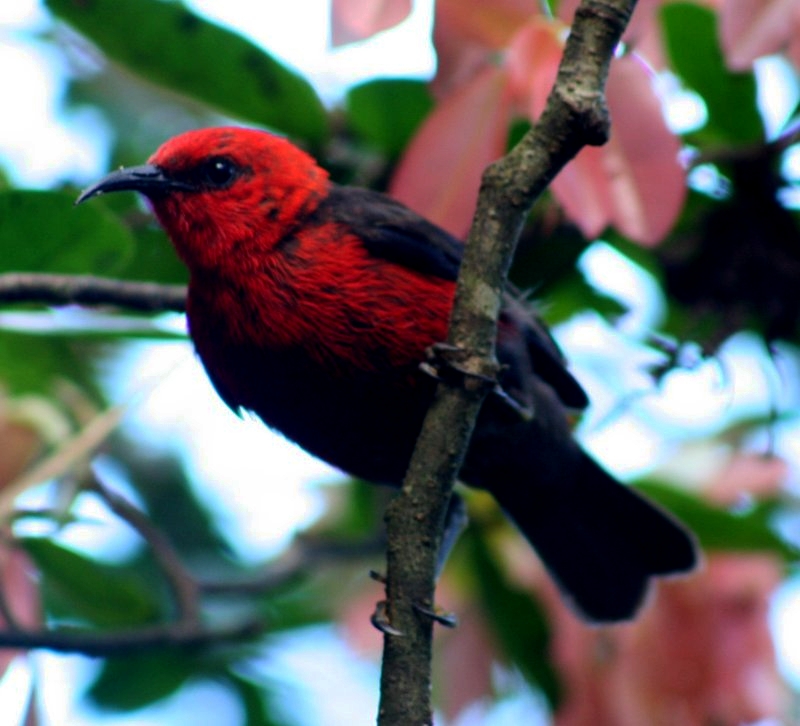
Wikipedia: Micronesian myzomela Source: OTHER
Micronesian_Honey_Eater.jpg
![]() The Micronesian myzomela (Myzomela rubratra) is a species of bird in the honeyeater family Meliphagidae. The species forms a superspecies with a number of related and similar looking island and mainland myzomelas across the Pacific and Australasia. It in turn is composed of seven insular subspecies.
[more]
The Micronesian myzomela (Myzomela rubratra) is a species of bird in the honeyeater family Meliphagidae. The species forms a superspecies with a number of related and similar looking island and mainland myzomelas across the Pacific and Australasia. It in turn is composed of seven insular subspecies.
[more]
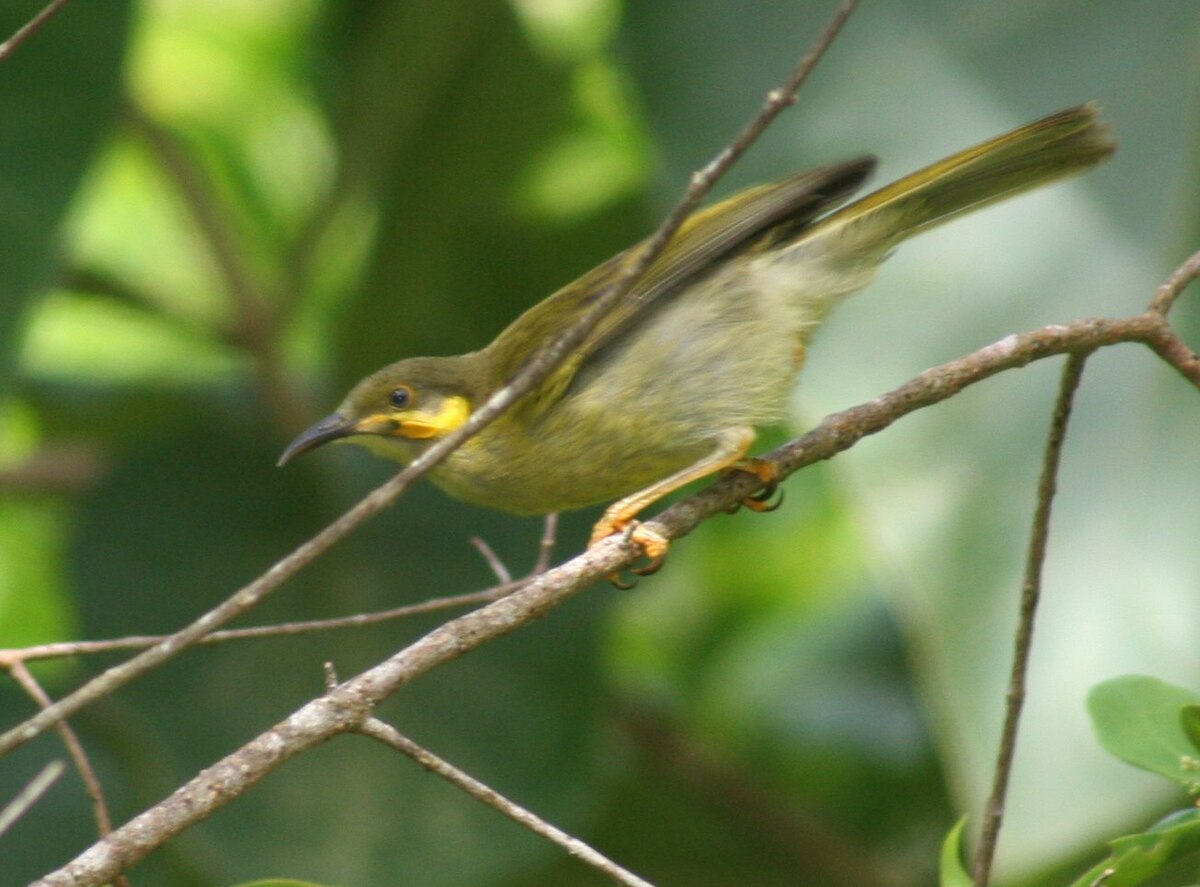
Wikipedia: Wattled honeyeater Source: OTHER
1200px-Wattled_Honeyeater_%28Foulehaio_carunculata%29.jpg
![]() The wattled honeyeaters make up a genus (Foulehaio) of birds in the family Meliphagidae.
[more]
The wattled honeyeaters make up a genus (Foulehaio) of birds in the family Meliphagidae.
[more]
Near Badi Auslikon at the Pfäffikersee. I thought I had only seen black-headed gulls, but on reviewing my photos,
I noticed the yellow bill. Other typical characteristics: it's bigger than the
black-headed gull next to it, it doesn't have the Charlie Brown half-ring around the eye,
it has less gray and only a few shorter black tail feathers. 2021-02-05 11.34.30 Pfäffikersee
First observed in 🇨🇭 on 2021-03-07.
This bird appears across the great seas in the following continents:
Europe, North America, Africa.
Not so common in Switzerland (most common would be the black-headed gull as far as I can see
Appearance and identification: Nabu: NABU ueber das Aussehen der Sturmmoewe:
'Sturmmöwen sind etwas größer als Lachmöwen, jedoch deutlich kleiner als Silbermöwen. Sie sind überwiegend weiß mit grauem Rücken und grauen Flügeln. Die Flügelenden sind schwarz mit weißer Spitze. Der Kopf ist rundlich, die dunklen Augen dünn rot umrandet. Der schlanke Schnabel und die Beine sind grünlichgelb, ein Schnabelfleck fehlt.' [Portraet]
Vocalization: ![]() Various mewing sounds. Similar in form to Herring Gull, but much higher pitched. [Link]
Various mewing sounds. Similar in form to Herring Gull, but much higher pitched. [Link]
Physical details: length=40-42 cm,
wingspan=100-115 cm,
weight=300-480 g
not sexually dimporphic.
Identifying characteristics:
general:
head = white (Gray in winter and when young), beak = yellow (greenish yellow), legs = yellow (duller in winter), , , ,
Adult:
wings = gray, , ,
Youth:
wings = white (with brown streaks), ,
Winter:
tail = black (and white striped),
Prachtkleid:
tail = white
Habitats:
River and lake
Profile Wikipedia eBird Vogelwarte BirdLife ZH ornitho.ch Audubon AllAboutBirds Xeno-Canto NABU
Lesser black-backed gull - yellow legs, yellow break with red under tip, black back but white shoulders. 2023-09-27 12.40.12 Florida
This bird appears across the great seas in the following continents:
Europe, North America, Africa.
General: ![]() The lesser black-backed gull (Larus fuscus) is a large gull that breeds on the Atlantic coasts of Europe. It is migratory, wintering from the British Isles south to West Africa. It is a regular winter visitor to the east coast of North America, probably from the breeding population in Iceland.
[more]
The lesser black-backed gull (Larus fuscus) is a large gull that breeds on the Atlantic coasts of Europe. It is migratory, wintering from the British Isles south to West Africa. It is a regular winter visitor to the east coast of North America, probably from the breeding population in Iceland.
[more]
Habitats:
River and lake
Profile Wikipedia eBird Audubon AllAboutBirds Xeno-Canto

Wikipedia: Slaty-backed gull Source: OTHER
Ooseguro-kamome.jpg
This bird appears across the great seas in the following continents:
North America, Australia.
vagrant
Herring gulls at Squam Lake, New Hampshire. 2023-10-06 12.47.32 New England
This bird appears across the great seas in the following continents:
Europe, North America, South America.
Deutschland: Brut-, Jahres-, Zugvogel, Wintergast
Vocalization: ![]() Quite vocal. A long and strong "ay-kay-kay-kay-kay" with fading strength commonly heard. A deep "ga-ga-ga" heard from anxious birds. [Link]
Quite vocal. A long and strong "ay-kay-kay-kay-kay" with fading strength commonly heard. A deep "ga-ga-ga" heard from anxious birds. [Link]
Calls: ![]() All calls much deeper pitched than Common Gull. Difficult to distinguish from Lesser Black-backed Gull, but tone is less nasal. [Link]
All calls much deeper pitched than Common Gull. Difficult to distinguish from Lesser Black-backed Gull, but tone is less nasal. [Link]
Physical details: length=55-64 cm,
wingspan=123-148 cm,
weight=750-1440 g
Habitats:
River and lake
Profile Wikipedia eBird Vogelwarte BirdLife ZH ornitho.ch Audubon AllAboutBirds Xeno-Canto NABU
Great black-backed gull (Mantelmöwe), Islay near Bridgend. 2023-08-11 09.31.48 Islay
First observed in Islay on 2023-08-11.
This bird appears across the great seas in the following continents:
Europe, North America.
Deutschland: Brut-, Jahres-, Zugvogel, Wintergast RL R
Habitats:
River and lake

Wikipedia: Ring-billed gull Source: OTHER
1200px-Ring-billed_gull_in_Red_Hook_%2842799%29.jpg
General: ![]() The ring-billed gull (Larus delawarensis) is a medium-sized gull. The genus name is from Latin Larus which appears to have referred to a gull or other large seabird. The specific delawarensis refers to the Delaware River.[2]
[more]
The ring-billed gull (Larus delawarensis) is a medium-sized gull. The genus name is from Latin Larus which appears to have referred to a gull or other large seabird. The specific delawarensis refers to the Delaware River.[2]
[more]
Profile Wikipedia eBird Audubon AllAboutBirds Xeno-Canto BirdID NABU
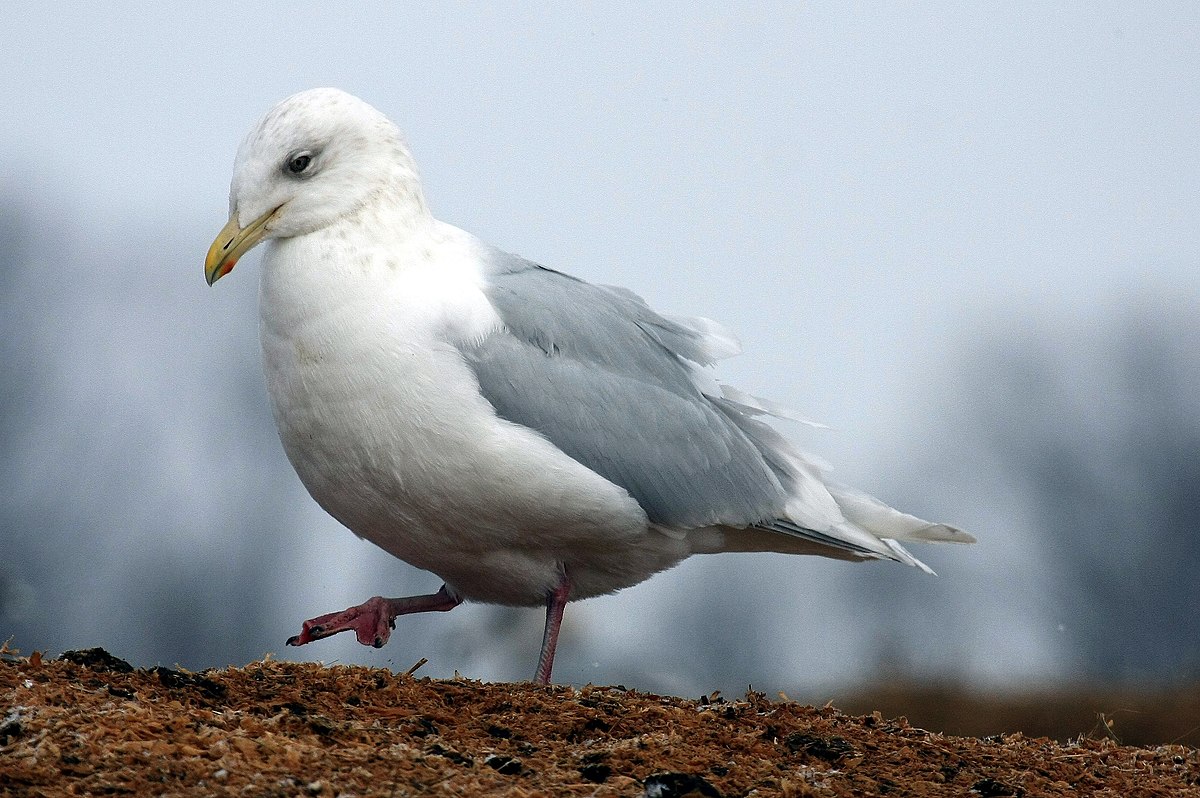
Wikipedia: Iceland gull Source: OTHER
1200px-Larus_glaucoides_IthacaNY.jpg
This bird appears across the great seas in the following continents:
Europe, North America.
![]() The Iceland gull (Larus glaucoides) is a medium-sized gull that breeds in the Arctic regions of Canada and Greenland, but not in Iceland (as its name suggests), where it is only seen during winter. The genus name is from Latin larus, which appears to have referred to a gull or other large seabird. The specific name glaucoides denotes its resemblance to Larus glaucus, a synonym of Larus hyperboreus, the glaucous gull; -oides is Ancient Greek and means "resembling".[2]
[more]
The Iceland gull (Larus glaucoides) is a medium-sized gull that breeds in the Arctic regions of Canada and Greenland, but not in Iceland (as its name suggests), where it is only seen during winter. The genus name is from Latin larus, which appears to have referred to a gull or other large seabird. The specific name glaucoides denotes its resemblance to Larus glaucus, a synonym of Larus hyperboreus, the glaucous gull; -oides is Ancient Greek and means "resembling".[2]
[more]
Vocalization: ![]() Like Herring Gull, but tone sharper. [Link]
Like Herring Gull, but tone sharper. [Link]
Physical details: length=52-60 cm,
wingspan=140-150 cm,
weight=460-1039 g
Profile Wikipedia eBird Audubon AllAboutBirds Xeno-Canto BirdID NABU
MerlinBirdID says glaucous gull and American black duck females. 2023-10-12 13.39.32 New England
First observed in New England on 2023-10-12.
This bird appears across the great seas in the following continents:
Europe, North America.
General: ![]() The glaucous gull (Larus hyperboreus) is a large gull, the second-largest gull in the world. It breeds in Arctic regions of the Northern Hemisphere and winters south to shores of the Holarctic. The genus name is from Latin larus, which appears to have referred to a gull or other large seabird. The specific name hyperboreus is Latin for "northern" from the Ancient Greek Huperboreoi people from the far north [2] "Glaucous" is from Latin glaucus and denotes the grey colour of the gull.[3]
[more]
The glaucous gull (Larus hyperboreus) is a large gull, the second-largest gull in the world. It breeds in Arctic regions of the Northern Hemisphere and winters south to shores of the Holarctic. The genus name is from Latin larus, which appears to have referred to a gull or other large seabird. The specific name hyperboreus is Latin for "northern" from the Ancient Greek Huperboreoi people from the far north [2] "Glaucous" is from Latin glaucus and denotes the grey colour of the gull.[3]
[more]
Vocalization: ![]() Like Herring Gull. [Link]
Like Herring Gull. [Link]
Physical details: length=62-68 cm,
wingspan=150-165 cm,
weight=964-2215 g
Profile Wikipedia eBird Audubon AllAboutBirds Xeno-Canto

Wikipedia: Western gull Source: OTHER
1200px-Larus_occidentalis_%28Western_Gull%29%2C_Point_Lobos%2C_CA%2C_US_-_May_2013.jpg
General: ![]() The western gull (Larus occidentalis) is a large white-headed gull that lives on the west coast of North America. It was previously considered conspecific with the yellow-footed gull (Larus livens) of the Gulf of California. The western gull ranges from British Columbia, Canada to Baja California, Mexico.[2]
[more]
The western gull (Larus occidentalis) is a large white-headed gull that lives on the west coast of North America. It was previously considered conspecific with the yellow-footed gull (Larus livens) of the Gulf of California. The western gull ranges from British Columbia, Canada to Baja California, Mexico.[2]
[more]
Profile Wikipedia eBird Audubon AllAboutBirds Xeno-Canto
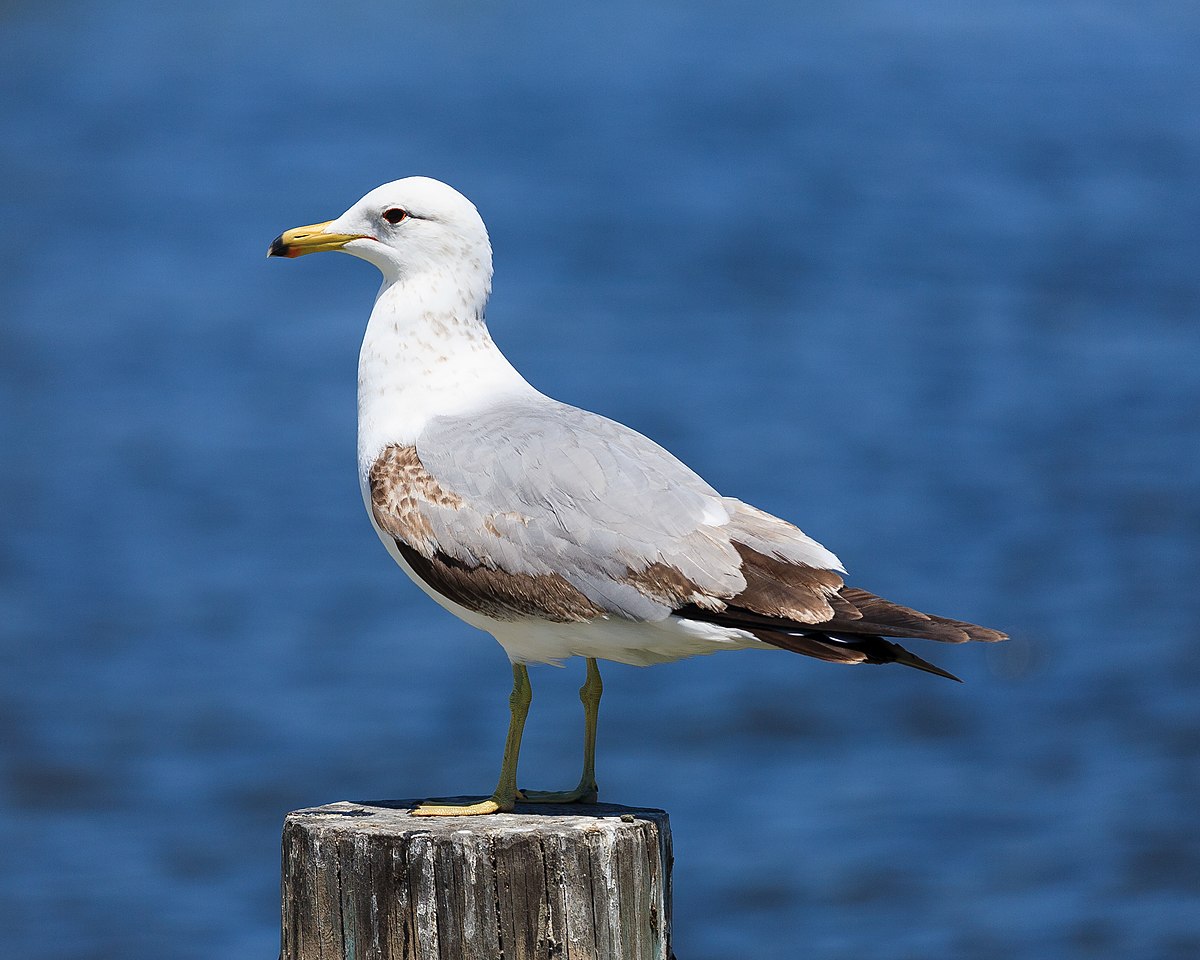
Wikipedia: California gull Source: OTHER
1200px-Larus_californicus_Palo_Alto_May_2011_009.jpg
![]() The California gull (Larus californicus) is a medium-sized gull, smaller on average than the herring gull but larger on average than the ring-billed gull, though it may overlap in size greatly with both.
[more]
The California gull (Larus californicus) is a medium-sized gull, smaller on average than the herring gull but larger on average than the ring-billed gull, though it may overlap in size greatly with both.
[more]
Profile Wikipedia eBird Audubon AllAboutBirds Xeno-Canto

Wikipedia: Glaucous-winged gull Source: OTHER
1200px-Glaucous-winged_gull.jpg
![]() The glaucous-winged gull (Larus glaucescens) is a large, white-headed gull. The genus name is from Latin Larus which appears to have referred to a gull or other large seabird. The specific glaucescens is New Latin for "glaucous" from the Ancient Greek, glaukos, denoting the grey color of its wings.[2]
[more]
The glaucous-winged gull (Larus glaucescens) is a large, white-headed gull. The genus name is from Latin Larus which appears to have referred to a gull or other large seabird. The specific glaucescens is New Latin for "glaucous" from the Ancient Greek, glaukos, denoting the grey color of its wings.[2]
[more]
Profile Wikipedia eBird Audubon AllAboutBirds Xeno-Canto
Moewe am greifensee. 2021-02-08 15.43.06 Um Naturzentrum Silberweide am Greifensee
First observed in 🇨🇭 on 2021-02-08.
![]() The yellow-footed gull (Larus livens) is a large gull, closely related to the western gull and thought to be a subspecies until the 1960s. It is endemic to the Gulf of California.
[more]
The yellow-footed gull (Larus livens) is a large gull, closely related to the western gull and thought to be a subspecies until the 1960s. It is endemic to the Gulf of California.
[more]
On a canal feeding into the Pfäffikersee Paradoxically, they don't have to have a black head. 2020-10-30 16.51.58 Pfäffikersee
First observed in 🇨🇭 on 2020-05-20.
This bird appears across the great seas in the following continents:
Europe, North America, Africa, Asia.
Common waterbird at Pfäffikersee, that doesn't necessarily have the eponymous black head.
not sexually dimporphic.
No breeding plumage
Identifying characteristics:
Summer:
head = black, , , , , tail = black
Winter:
head = white (With Charlie Brown-style half circle behind the eye), , , ,
general:
beak = red, legs = red, wings = gray,
Habitats:
River and lake
Call:
Automatically generated from Xeno-Canto recording
♫ Source: BirdNet
20210427_165123 birdnet 1485 - Black-headed Gull racket at Chlisee - No confident detection - Wetzikon.mp3
2021-04-27 16.51.23 Wetzikon (song?)
Black-legged kittiwake / Dreizehenmöwe (Rissa tridactyla)
Profile Wikipedia eBird Vogelwarte BirdLife ZH ornitho.ch Audubon AllAboutBirds Xeno-Canto BirdID NABU

Wikipedia: Black-legged kittiwake Source: OTHER
1200px-Rissa_tridactyla_%28Vard%C3%B8%2C_2012%29.jpg
This bird appears across the great seas in the following continents:
Europe, North America, Africa.
General: ![]() The black-legged kittiwake (Rissa tridactyla) is a seabird species in the gull family Laridae.
[more]
The black-legged kittiwake (Rissa tridactyla) is a seabird species in the gull family Laridae.
[more]
Vocalization: ![]() Highly vocal at breeding ground. A mewing "kitti-wake", with the pitch rising on the second drawn out syllable, and then falling. Generally silent elsewhere, except when squabbling over food. [Link]
Highly vocal at breeding ground. A mewing "kitti-wake", with the pitch rising on the second drawn out syllable, and then falling. Generally silent elsewhere, except when squabbling over food. [Link]
Physical details: length=38-40 cm,
wingspan=95-105 cm,
weight=310-500 g
Red-legged kittiwake / Klippenmöwe (Rissa brevirostris)
Profile Wikipedia eBird Audubon AllAboutBirds Xeno-Canto
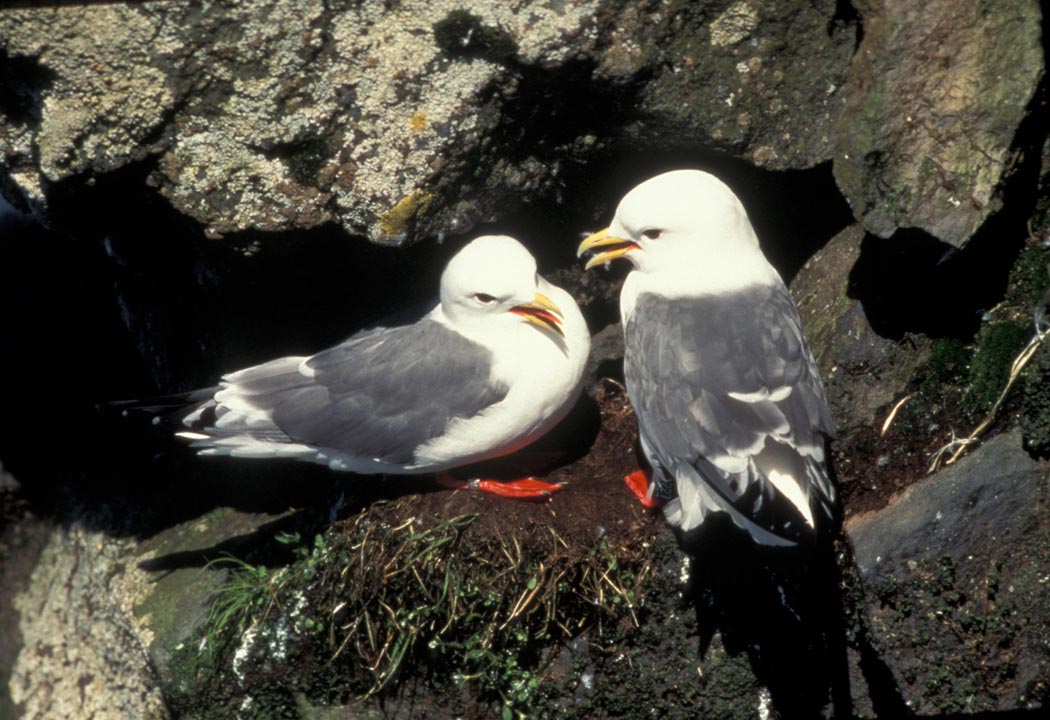
Wikipedia: Red-legged kittiwake Source: OTHER
Rissa_brevirostris5.jpg
General: ![]() The red-legged kittiwake (Rissa brevirostris) is a seabird species in the gull family Laridae. It breeds in the Pribilof Islands, Bogoslof Island and Buldir Island in the Bering Sea off the coast of Alaska, and the Commander Islands, Russia and spends the winter at sea, sometimes coming in land to feed off bird tables in Great Ayton.
[more]
The red-legged kittiwake (Rissa brevirostris) is a seabird species in the gull family Laridae. It breeds in the Pribilof Islands, Bogoslof Island and Buldir Island in the Bering Sea off the coast of Alaska, and the Commander Islands, Russia and spends the winter at sea, sometimes coming in land to feed off bird tables in Great Ayton.
[more]
Ivory gull / Elfenbeinmöwe (Pagophila eburnea)
Profile Wikipedia eBird Audubon AllAboutBirds Xeno-Canto

Wikipedia: Ivory gull Source: OTHER
Ivory_Gull_Portrait.jpg
![]() The ivory gull (Pagophila eburnea) is a small gull, the only species in the genus Pagophila. It breeds in the high Arctic and has a circumpolar distribution through Greenland, northernmost North America, and Eurasia.
[more]
The ivory gull (Pagophila eburnea) is a small gull, the only species in the genus Pagophila. It breeds in the high Arctic and has a circumpolar distribution through Greenland, northernmost North America, and Eurasia.
[more]
Gull-billed tern / Lachseeschwalbe (Gelochelidon nilotica)
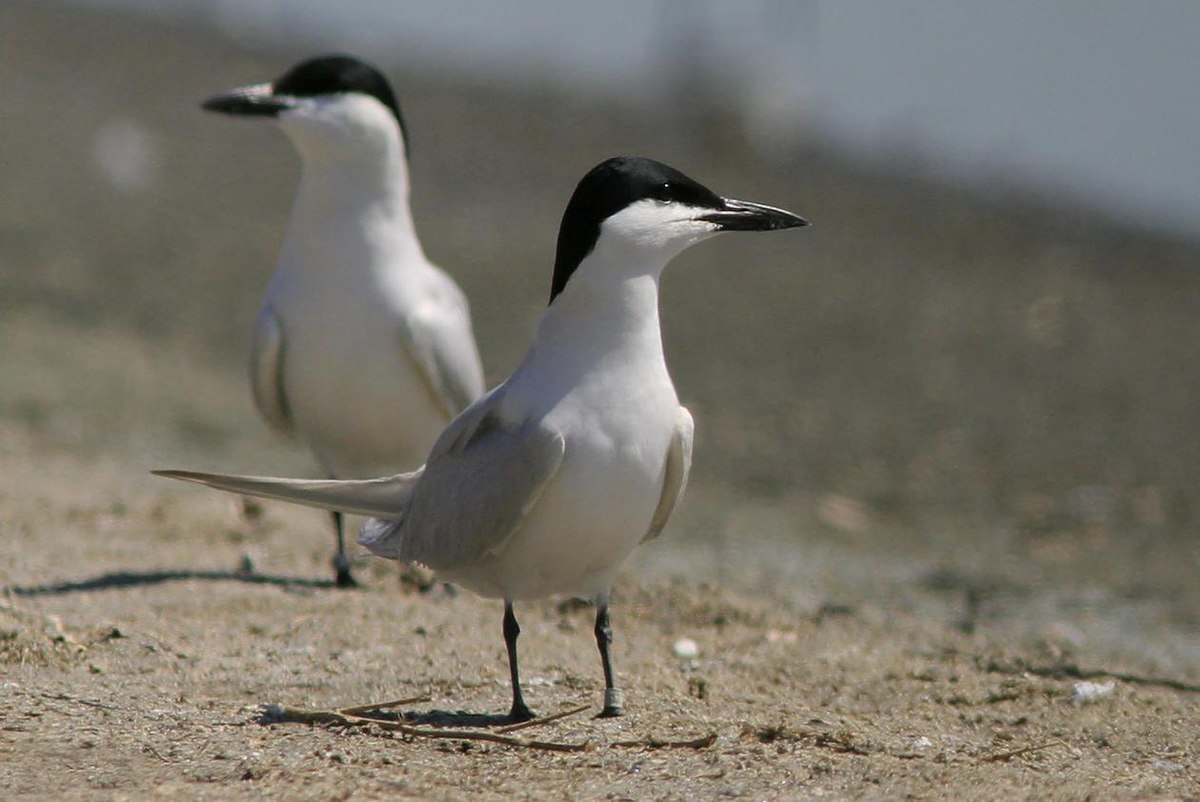
Wikipedia: Gull-billed tern Source: OTHER
1200px-Gelochelidon_nilotica_vanrossemi.jpg
This bird appears across the great seas in the following continents:
Europe, North America, South America, Africa, Asia.
![]() The gull-billed tern (Gelochelidon nilotica), formerly Sterna nilotica,[2] is a tern in the family Laridae. The genus name is from Ancient Greek gelao, "to laugh", and khelidon, "swallow". The specific niloticus is from Latin and means of the Nile.[3] The Australian gull-billed tern was previously considered a subspecies.
[more]
The gull-billed tern (Gelochelidon nilotica), formerly Sterna nilotica,[2] is a tern in the family Laridae. The genus name is from Ancient Greek gelao, "to laugh", and khelidon, "swallow". The specific niloticus is from Latin and means of the Nile.[3] The Australian gull-billed tern was previously considered a subspecies.
[more]
Sabine's gull / Schwalbenmöwe (Xema sabini)

Wikipedia: Sabine's gull Source: OTHER
Xema_sabini_-Iceland_-swimming-8_%281%29.jpg
This bird appears across the great seas in the following continents:
Europe, North America, South America, Africa.
![]() Sabine's gull (/ˈseɪbɪn/ SAY-bin; Xema sabini), also known as the fork-tailed gull or xeme, is a small gull. Its generic placement is disputed; some authors treat it as the sole species in the genus Xema as Xema sabini,[2] while others retain it in the genus Larus as Larus sabini.[3][4]
[more]
Sabine's gull (/ˈseɪbɪn/ SAY-bin; Xema sabini), also known as the fork-tailed gull or xeme, is a small gull. Its generic placement is disputed; some authors treat it as the sole species in the genus Xema as Xema sabini,[2] while others retain it in the genus Larus as Larus sabini.[3][4]
[more]
Black tern / Trauerseeschwalbe (Chlidonias niger)
Profile Wikipedia eBird Vogelwarte BirdLife ZH ornitho.ch Audubon AllAboutBirds Xeno-Canto BirdID NABU

Wikipedia: Black tern Source: OTHER
1200px-%C4%8Cor%C3%ADk_%C4%8Dierny_%28Chlidonias_niger%29_a_%284644831482%29.jpg
This bird appears across the great seas in the following continents:
Europe, North America, South America, Africa.
![]() The black tern (Chlidonias niger) is a small tern generally found in or near inland water in Europe, Western Asia and North America. As its name suggests, it has predominantly dark plumage. In some lights it can appear blue in the breeding season, hence the old English name "blue darr".[2] The genus name is from Ancient Greek khelidonios, "swallow-like", from khelidon, "swallow": another old English name for the black tern is "carr (i.e. lake) swallow".[3] The species name is from Latin niger "shining black".[4]
[more]
The black tern (Chlidonias niger) is a small tern generally found in or near inland water in Europe, Western Asia and North America. As its name suggests, it has predominantly dark plumage. In some lights it can appear blue in the breeding season, hence the old English name "blue darr".[2] The genus name is from Ancient Greek khelidonios, "swallow-like", from khelidon, "swallow": another old English name for the black tern is "carr (i.e. lake) swallow".[3] The species name is from Latin niger "shining black".[4]
[more]
Vocalization: ![]() Moderately vocal. [Link]
Moderately vocal. [Link]
Calls: ![]() Flight call a more or less clear "kleck, or a disyllabic "klee-ake" with accented first syllable. Sometimes slightly rolling "klirr-eke", but never as much as in White-winged Tern. Also a slightly harsher "kreek", but not as raspy as in Whiskered Tern. [Link]
Flight call a more or less clear "kleck, or a disyllabic "klee-ake" with accented first syllable. Sometimes slightly rolling "klirr-eke", but never as much as in White-winged Tern. Also a slightly harsher "kreek", but not as raspy as in Whiskered Tern. [Link]
Physical details: length=22-24 cm,
wingspan=64-68 cm,
weight=60-86 g
Habitats:
River and lake
Brown noddy / Noddi (Anous stolidus)

Wikipedia: Brown noddy Source: OTHER
1200px-Common_Noddy_1_-_Michaelmas.jpg
This bird appears across the great seas in the following continents:
North America, South America, Africa, Asia.
General: ![]() The brown noddy or common noddy (Anous stolidus) is a seabird in the family Laridae. The largest of the noddies, it can be told from the closely related black noddy by its larger size and plumage, which is dark brown rather than black. The brown noddy is a tropical seabird with a worldwide distribution, ranging from Hawaii to the Tuamotu Archipelago and Australia in the Pacific Ocean, from the Red Sea to the Seychelles and Australia in the Indian Ocean and in the Caribbean to Tristan da Cunha in the Atlantic Ocean. The brown noddy is colonial, usually nesting on elevated situations on cliffs or in short trees or shrubs. It only occasionally nests on the ground. A single egg is laid by the female of a pair each breeding season. In India the brown noddy is protected in the PM Sayeed Marine Birds Conservation Reserve.[2]
[more]
The brown noddy or common noddy (Anous stolidus) is a seabird in the family Laridae. The largest of the noddies, it can be told from the closely related black noddy by its larger size and plumage, which is dark brown rather than black. The brown noddy is a tropical seabird with a worldwide distribution, ranging from Hawaii to the Tuamotu Archipelago and Australia in the Pacific Ocean, from the Red Sea to the Seychelles and Australia in the Indian Ocean and in the Caribbean to Tristan da Cunha in the Atlantic Ocean. The brown noddy is colonial, usually nesting on elevated situations on cliffs or in short trees or shrubs. It only occasionally nests on the ground. A single egg is laid by the female of a pair each breeding season. In India the brown noddy is protected in the PM Sayeed Marine Birds Conservation Reserve.[2]
[more]
Black noddy / Weißkappennoddi (Anous minutus)
Profile Wikipedia eBird Audubon AllAboutBirds Xeno-Canto

Wikipedia: Black noddy Source: OTHER
1200px-Anous_minutus_by_Gregg_Yan_02.jpg
This bird appears across the great seas in the following continents:
North America, South America, Africa, Australia.
![]() The black noddy or white-capped noddy (Anous minutus) is a seabird from the family Laridae. It is a medium-sized species of tern with black plumage and a white cap. It closely resembles the lesser noddy (Anous tenuirostris) with which it was at one time considered conspecific. The black noddy has slightly darker plumage and dark rather than pale lores.
[more]
The black noddy or white-capped noddy (Anous minutus) is a seabird from the family Laridae. It is a medium-sized species of tern with black plumage and a white cap. It closely resembles the lesser noddy (Anous tenuirostris) with which it was at one time considered conspecific. The black noddy has slightly darker plumage and dark rather than pale lores.
[more]
Blue noddy (Anous ceruleus)

Wikipedia: Blue noddy Source: OTHER
1200px-Blue-grey_Noddy.jpg
This bird appears across the great seas in the following continents:
North America, Australia.
![]() The blue noddy or hinaokū or manuohina[2] (Anous cerulea) is a seabird in the family Laridae. It is also known as the blue-grey noddy.
[more]
The blue noddy or hinaokū or manuohina[2] (Anous cerulea) is a seabird in the family Laridae. It is also known as the blue-grey noddy.
[more]
Common white-tern / Feenseeschwalbe (alternate) (Gygis alba)
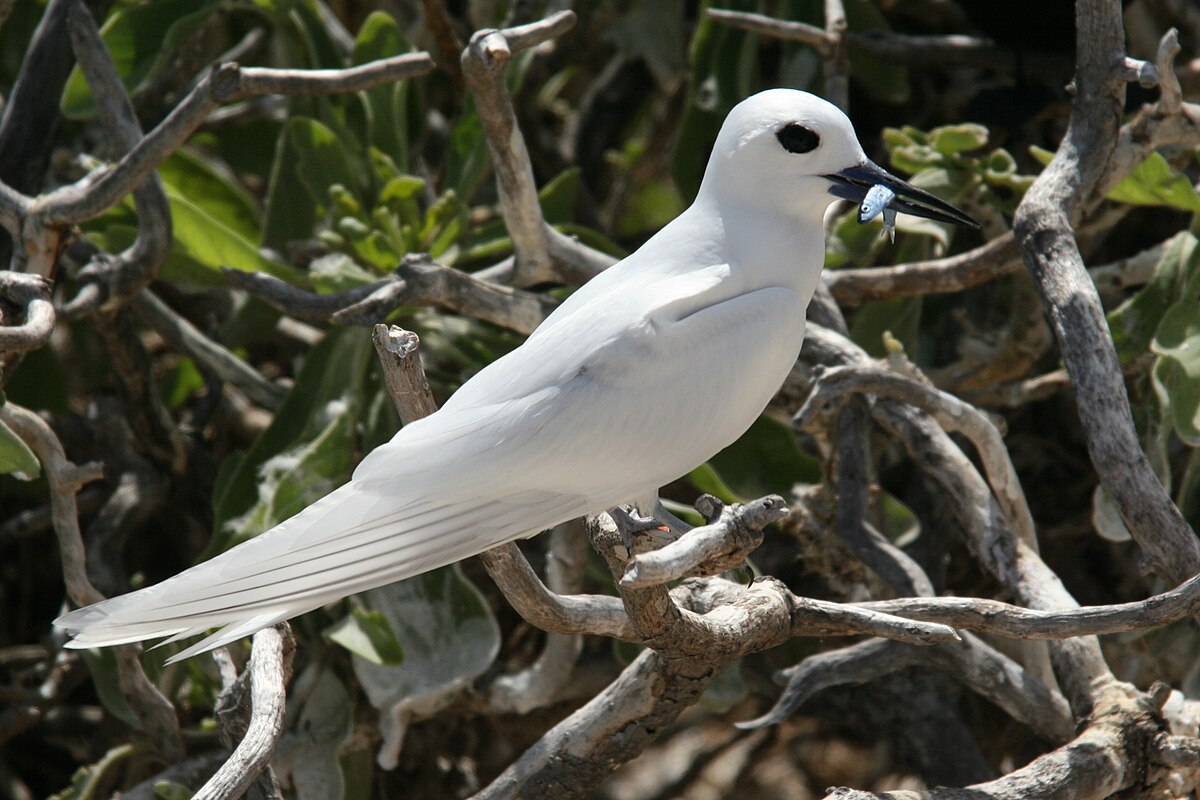
Wikipedia: Common white-tern Source: OTHER
1200px-White_tern_with_fish.jpg
This bird appears across the great seas in the following continents:
North America, Africa.
![]() The white tern (Gygis alba) is a small seabird found across the tropical oceans of the world. It is sometimes known as the fairy tern although this name is potentially confusing as it is also the common name of Sternula nereis. Other names for the species include angel tern and white noddy in English, and manu-o-Kū in Hawaiian.
[more]
The white tern (Gygis alba) is a small seabird found across the tropical oceans of the world. It is sometimes known as the fairy tern although this name is potentially confusing as it is also the common name of Sternula nereis. Other names for the species include angel tern and white noddy in English, and manu-o-Kū in Hawaiian.
[more]
Ross's gull / Rosenmöwe (Rhodostethia rosea)
Profile Wikipedia eBird Audubon AllAboutBirds Xeno-Canto
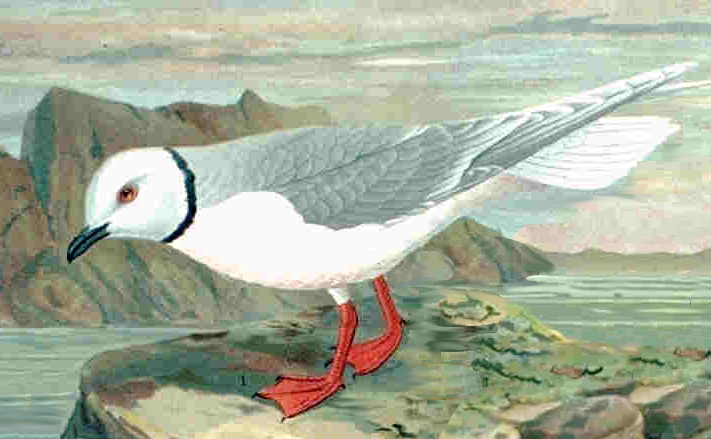
Wikipedia: Ross's gull Source: OTHER
Rhodostethia_rosea.jpg
![]() Ross's gull (Rhodostethia rosea) is a small gull, the only species in its genus, although it has been suggested it should be moved to the genus Hydrocoloeus, which otherwise only includes the little gull.
This bird is named after the British explorer James Clark Ross. Its breeding grounds were first discovered in 1905 by Sergei Aleksandrovich Buturlin near village of Pokhodsk in North-Eastern Yakutia, while visiting the area as a [2] judge. The genus name Rhodostethia is from Ancient Greek rhodon, "rose", and stethos, "breast". The specific rosea is Latin for "rose-coloured".[3]
[more]
Ross's gull (Rhodostethia rosea) is a small gull, the only species in its genus, although it has been suggested it should be moved to the genus Hydrocoloeus, which otherwise only includes the little gull.
This bird is named after the British explorer James Clark Ross. Its breeding grounds were first discovered in 1905 by Sergei Aleksandrovich Buturlin near village of Pokhodsk in North-Eastern Yakutia, while visiting the area as a [2] judge. The genus name Rhodostethia is from Ancient Greek rhodon, "rose", and stethos, "breast". The specific rosea is Latin for "rose-coloured".[3]
[more]
Franklin's gull / Präriemöwe (Leucophaeus pipixcan)

Wikipedia: Franklin's gull Source: OTHER
Franklin%27s_Gull%2C_Calgary.jpg
This bird appears across the great seas in the following continents:
North America, South America, Africa.
![]() Franklin's gull (Leucophaeus pipixcan) is a small (length 12.6–14.2 in, 32–36 cm) gull.[2] The genus name Leucophaeus is from Ancient Greek leukos, "white", and phaios, "dusky". The specific pipixcan is a Nahuatl name for a type of gull.[3][4]
[more]
Franklin's gull (Leucophaeus pipixcan) is a small (length 12.6–14.2 in, 32–36 cm) gull.[2] The genus name Leucophaeus is from Ancient Greek leukos, "white", and phaios, "dusky". The specific pipixcan is a Nahuatl name for a type of gull.[3][4]
[more]
Laughing gull / Aztekenmöwe (Leucophaeus atricilla)
Our gang - laughing gull, double-crested cormorants, brown pelicans - at Las Coloradas, Rio Lagartos. 2023-04-15 09.11.04 Yucatan
First observed in Yucatan on 2023-03-26.
This bird appears across the great seas in the following continents:
North America, South America, Australia.
vagrant
Caspian tern / Raubseeschwalbe (Hydroprogne caspia)

Wikipedia: Caspian tern Source: OTHER
1200px-Sterna-caspia-010.jpg
This bird appears across the great seas in the following continents:
Europe, North America, South America, Africa, Asia.
General: ![]() The Caspian tern (Hydroprogne caspia)[2] is a species of tern, with a subcosmopolitan but scattered distribution. Despite its extensive range, it is monotypic of its genus, and has no accepted subspecies.[3] The genus name is from Ancient Greek hudros, "water", and Latin progne, "swallow". The specific caspia is from Latin and, like the English name, refers to the Caspian Sea.[4]
[more]
The Caspian tern (Hydroprogne caspia)[2] is a species of tern, with a subcosmopolitan but scattered distribution. Despite its extensive range, it is monotypic of its genus, and has no accepted subspecies.[3] The genus name is from Ancient Greek hudros, "water", and Latin progne, "swallow". The specific caspia is from Latin and, like the English name, refers to the Caspian Sea.[4]
[more]
Calls: ![]() Easily recognized by its very harsh calls. Sometimes likened to the sound of a plate of steel being dragged across a concrete floor. Similar in harshness to Grey Heron, but more drawn, with an accented middle; "Kraaeeet", or with a double syllable start "ka-ha-kraaaeet". Immature birds begs with a penetrating, sharp whistle. [Link]
Easily recognized by its very harsh calls. Sometimes likened to the sound of a plate of steel being dragged across a concrete floor. Similar in harshness to Grey Heron, but more drawn, with an accented middle; "Kraaeeet", or with a double syllable start "ka-ha-kraaaeet". Immature birds begs with a penetrating, sharp whistle. [Link]
Physical details: length=47-54 cm,
wingspan=130-145 cm,
weight=500-750 g
Habitats:
River and lake
Sooty tern / Rußseeschwalbe (Onychoprion fuscatus)

Wikipedia: Sooty tern Source: OTHER
1200px-Sterna_fuscata.JPG
This bird appears across the great seas in the following continents:
North America, South America, Africa.
General: ![]() The sooty tern (Onychoprion fuscatus) is a seabird in the family Laridae. It is a bird of the tropical oceans which sleeps on the wing, returning to land only to breed on islands throughout the equatorial zone.
[more]
The sooty tern (Onychoprion fuscatus) is a seabird in the family Laridae. It is a bird of the tropical oceans which sleeps on the wing, returning to land only to breed on islands throughout the equatorial zone.
[more]
Bridled tern / Zügelseeschwalbe (Onychoprion anaethetus)
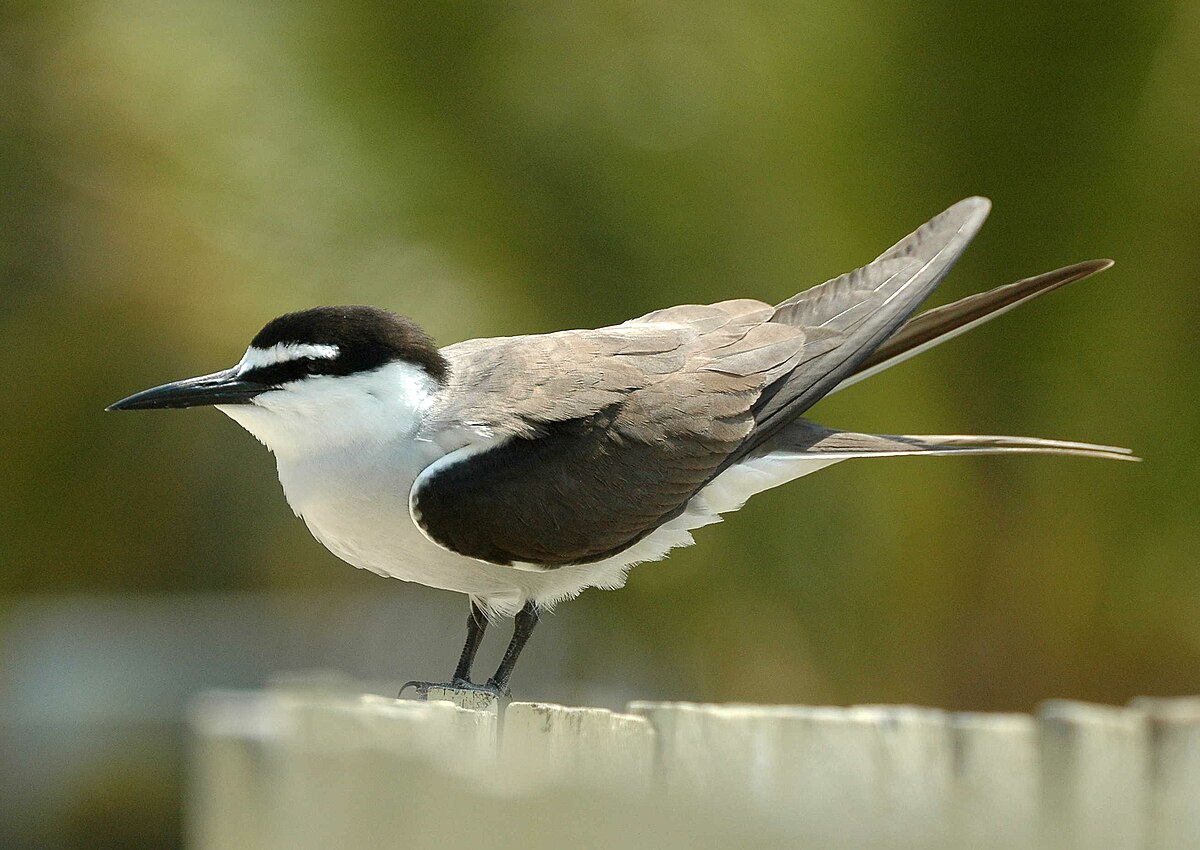
Wikipedia: Bridled tern Source: OTHER
1200px-Bridled_Tern_LEI_Nov06.JPG
This bird appears across the great seas in the following continents:
North America, South America, Africa, Asia.
![]() The bridled tern (Onychoprion anaethetus)[2] is a seabird of the family Laridae. It is a bird of the tropical oceans. The scientific name is from Ancient Greek. The genus comes from onux meaning "claw" or "nail", and prion, meaning "saw". The specific anaethetus means "senseless, stupid".[3]
[more]
The bridled tern (Onychoprion anaethetus)[2] is a seabird of the family Laridae. It is a bird of the tropical oceans. The scientific name is from Ancient Greek. The genus comes from onux meaning "claw" or "nail", and prion, meaning "saw". The specific anaethetus means "senseless, stupid".[3]
[more]
Aleutian tern (Onychoprion aleuticus)

Wikipedia: Aleutian tern Source: OTHER
Aleutian_Tern.jpg
This bird appears across the great seas in the following continents:
North America, Asia, Australia.
vagrant
Grey-backed tern (Onychoprion lunatus)

Wikipedia: Grey-backed tern Source: OTHER
1200px-GRAT_nest.JPG
This bird appears across the great seas in the following continents:
North America, Australia.
vagrant
Least tern / Amerikanische Zwergseeschwalbe (Sternula antillarum)

Wikipedia: Least tern Source: OTHER
1200px-Least_Tern_%28Sternula_antillarum%29_RWD1.jpg
General: ![]() The least tern (Sternula antillarum) is a species of tern that breeds in North America and locally in northern South America. It is closely related to, and was formerly often considered conspecific with, the little tern of the Old World. Other close relatives include the yellow-billed tern and Peruvian tern, both from South America.
[more]
The least tern (Sternula antillarum) is a species of tern that breeds in North America and locally in northern South America. It is closely related to, and was formerly often considered conspecific with, the little tern of the Old World. Other close relatives include the yellow-billed tern and Peruvian tern, both from South America.
[more]
Sandwich tern / Brandseeschwalbe (Thalasseus sandvicensis)
Sandwich tern in flight with distinct yellow tipped bill. 2023-09-27 12.28.34 Florida
First observed in Costa Rica on 2018-03-11.
This bird appears across the great seas in the following continents:
Europe, North America, South America, Africa.
![]() The Sandwich tern (Thalasseus sandvicensis)[2] is a tern in the family Laridae. It is very closely related to the lesser crested tern (T. bengalensis), Chinese crested tern (T. bernsteini), Cabot's tern (T. acuflavidus), and elegant tern (T. elegans) and has been known to interbreed with the lesser crested. It breeds in the Palearctic from Europe to the Caspian Sea wintering to South Africa, India and Sri Lanka.
[more]
The Sandwich tern (Thalasseus sandvicensis)[2] is a tern in the family Laridae. It is very closely related to the lesser crested tern (T. bengalensis), Chinese crested tern (T. bernsteini), Cabot's tern (T. acuflavidus), and elegant tern (T. elegans) and has been known to interbreed with the lesser crested. It breeds in the Palearctic from Europe to the Caspian Sea wintering to South Africa, India and Sri Lanka.
[more]
Calls: ![]() Contact call a sharp and grating "keeree-eek". Often compared to the pressing of amalgam into a tooth. [Link]
Contact call a sharp and grating "keeree-eek". Often compared to the pressing of amalgam into a tooth. [Link]
Physical details: length=36-41 cm,
wingspan=95-105 cm,
weight=215-275 g
Habitats:
River and lake
Royal tern (alternate) (Thalasseus maxima)
Hail, hail, the gang's all here at Madeira Beach - orange-beaked royal tern, black and yellow-beaked sandwich terns, a willet and two sanderlings. 2023-09-27 12.37.26 Florida
First observed in Yucatan on 2023-04-15.
Royal tern (Thalasseus maximus)

Wikipedia: Royal tern Source: OTHER
1200px-Royal_Tern.jpg
This bird appears across the great seas in the following continents:
Europe, North America, South America, Africa.
General: ![]() The royal tern (Thalasseus maximus) is a tern in the family Laridae.
[more]
The royal tern (Thalasseus maximus) is a tern in the family Laridae.
[more]
Little gull / Zwergmöwe (Hydrocoloeus minutus)

Wikipedia: Little gull Source: OTHER
1200px-%C4%8Cajka_mal%C3%A1_%28Larus_minutus%29_a_%284834254958%29.jpg
First observed in 🇨🇭 on 2022-12-03.
This bird appears across the great seas in the following continents:
Europe, North America, Africa.
Deutschland: ausnahmsweise Brutvogel, Zugvogel RL R
Calls: ![]() Repertoire of short, tern-like, hard calls, uttered individually, or in series. E.g. "kep" or "krrk". Also a diagnostic, gull-like, sharp and bouncing "ka-tee,ka-tee,ka-tee", with second syllable rising in pitch. [Link]
Repertoire of short, tern-like, hard calls, uttered individually, or in series. E.g. "kep" or "krrk". Also a diagnostic, gull-like, sharp and bouncing "ka-tee,ka-tee,ka-tee", with second syllable rising in pitch. [Link]
Physical details: length=25-27 cm,
wingspan=75-80 cm,
weight=85-150 g
Habitats:
River and lake
Lesser sand-plover (Charadrius mongolus)

Wikipedia: Lesser sand-plover Source: OTHER
1200px-Charadrius_mongolus_-_Laem_Phak_Bia.jpg
This bird appears across the great seas in the following continents:
North America, Africa, Asia.
General: ![]() The lesser sand plover (Charadrius mongolus) is a small wader in the plover family of birds. The spelling is commonly given as lesser sand-plover, but the official British Ornithologists' Union spelling is "lesser sand plover". The genus name Charadrius is a Late Latin word for a yellowish bird mentioned in the fourth-century Vulgate. It derives from Ancient Greek kharadrios a bird found in ravines and river valleys (kharadra, "ravine"). The specific mongolus is Latin and refers to Mongolia which at the time of naming referred to a larger area than the present country.[2]
[more]
The lesser sand plover (Charadrius mongolus) is a small wader in the plover family of birds. The spelling is commonly given as lesser sand-plover, but the official British Ornithologists' Union spelling is "lesser sand plover". The genus name Charadrius is a Late Latin word for a yellowish bird mentioned in the fourth-century Vulgate. It derives from Ancient Greek kharadrios a bird found in ravines and river valleys (kharadra, "ravine"). The specific mongolus is Latin and refers to Mongolia which at the time of naming referred to a larger area than the present country.[2]
[more]
Common ringed plover / Sandregenpfeifer (Charadrius hiaticula)
Profile Wikipedia eBird Vogelwarte BirdLife ZH ornitho.ch Audubon AllAboutBirds Xeno-Canto BirdID NABU
Sandregenpfeifer im Profil, Neeracherried. 2022-09-04 07.25.18 Neeracherried
First observed in 🇨🇭 on 2022-09-04.
This bird appears across the great seas in the following continents:
Europe, North America, Africa.
![]() The common ringed plover or ringed plover (Charadrius hiaticula) is a small plover that breeds in Arctic Eurasia. The genus name Charadrius is a Late Latin word for a yellowish bird mentioned in the fourth-century Vulgate. It derives from Ancient Greek kharadrios a bird found in ravines and river valleys (kharadra, "ravine"). The specific hiaticula is Latin and has a similar meaning to the Greek term, coming from hiatus, "cleft" and -cola, "dweller" (colere, "to dwell").[2]
[more]
The common ringed plover or ringed plover (Charadrius hiaticula) is a small plover that breeds in Arctic Eurasia. The genus name Charadrius is a Late Latin word for a yellowish bird mentioned in the fourth-century Vulgate. It derives from Ancient Greek kharadrios a bird found in ravines and river valleys (kharadra, "ravine"). The specific hiaticula is Latin and has a similar meaning to the Greek term, coming from hiatus, "cleft" and -cola, "dweller" (colere, "to dwell").[2]
[more]
Vocalization: ![]() Usually heard before seen. [Link]
Usually heard before seen. [Link]
Song: ![]() Song a cyclic repetition of the contact call. Sometimes with a shortened phrases and a more creaking timbre. [Link]
Song a cyclic repetition of the contact call. Sometimes with a shortened phrases and a more creaking timbre. [Link]
Calls: ![]() Contact call a short, soft "koo-eep", with the emphasised second part higher and rising in pitch. [Link]
Contact call a short, soft "koo-eep", with the emphasised second part higher and rising in pitch. [Link]
Physical details: length=18-20 cm,
wingspan=48-57 cm,
weight=55-73 g
Habitats:
Wetland
Kentish plover / Seeregenpfeifer (Charadrius alexandrinus)
Profile Wikipedia eBird Vogelwarte BirdLife ZH ornitho.ch Audubon AllAboutBirds Xeno-Canto BirdID NABU
Der kleinste Watvoegel bei Ses Salines, Mallorcal, ein Seeregenpfeifer. 2022-04-08 17.00.16 Mallorca
First observed in Mallorca on 2022-04-08.
This bird appears across the great seas in the following continents:
Europe, North America, Africa, Asia, Australia.
vagrant
Song: ![]() Contact calls more frequently heard than song, with two distinct calls. A short and soft ascending whistle resembling chiff-chaff is often heard from the ground, and a hard and rolling "prrrrt" if flushed (or just a short "tip"). Song a hard and rolling sequence resembling Dunlin song, but less nasal and more pulsating. [Link]
Contact calls more frequently heard than song, with two distinct calls. A short and soft ascending whistle resembling chiff-chaff is often heard from the ground, and a hard and rolling "prrrrt" if flushed (or just a short "tip"). Song a hard and rolling sequence resembling Dunlin song, but less nasal and more pulsating. [Link]
Physical details: length=15-17 cm,
wingspan=42-45 cm,
weight=39-56 g
Habitats:
Wetland
Semipalmated plover / Amerika-Sandregenpfeifer (Charadrius semipalmatus)
Profile Wikipedia eBird Audubon AllAboutBirds Xeno-Canto NABU

Wikipedia: Semipalmated plover Source: OTHER
Semipalmated_Plover.jpg
This bird appears across the great seas in the following continents:
Europe, North America, South America, Australia.
vagrant
Piping plover (Charadrius melodus)
Profile Wikipedia eBird Audubon AllAboutBirds Xeno-Canto

Wikipedia: Piping plover Source: OTHER
1200px-Charadrius-melodus-004_edit.jpg
General: ![]() The piping plover (Charadrius melodus) is a small sand-colored, sparrow-sized shorebird that nests and feeds along coastal sand and gravel beaches in North America. The adult has yellow-orange-red legs, a black band across the forehead from eye to eye, and a black stripe running along the breast line. This chest band is usually thicker in males during the breeding season, and it is the only reliable way to tell the sexes apart. The bird is difficult to see when it is standing still, as it blends well with open, sandy beach habitats. It typically runs in short spurts and stops.
[more]
The piping plover (Charadrius melodus) is a small sand-colored, sparrow-sized shorebird that nests and feeds along coastal sand and gravel beaches in North America. The adult has yellow-orange-red legs, a black band across the forehead from eye to eye, and a black stripe running along the breast line. This chest band is usually thicker in males during the breeding season, and it is the only reliable way to tell the sexes apart. The bird is difficult to see when it is standing still, as it blends well with open, sandy beach habitats. It typically runs in short spurts and stops.
[more]
Snowy plover (Charadrius nivosus)
Profile Wikipedia eBird Audubon AllAboutBirds Xeno-Canto

Wikipedia: Snowy plover Source: OTHER
1200px-Snowy_Plover_srgb.jpg
![]() The snowy plover (Charadrius nivosus) is a small wader in the plover bird family, typically about 5-7" in length.[2] It breeds in Ecuador, Peru, Chile, the southern and western United States and the Caribbean. Long considered to be a subspecies of the Kentish plover, it is now known to be a distinct species.
[more]
The snowy plover (Charadrius nivosus) is a small wader in the plover bird family, typically about 5-7" in length.[2] It breeds in Ecuador, Peru, Chile, the southern and western United States and the Caribbean. Long considered to be a subspecies of the Kentish plover, it is now known to be a distinct species.
[more]
Killdeer / Keilschwanz-Regenpfeifer (Charadrius vociferus)

Wikipedia: Killdeer Source: OTHER
Killdeer.jpg
![]() The killdeer (Charadrius vociferus) is a large plover found in the Americas. It was described and given its current scientific name in 1758 by Carl Linnaeus in the 10th edition of his Systema Naturae. There are three subspecies. The killdeer's common name comes from its often-heard call. Its upperparts are mostly brown with rufous fringes, the head has patches of white and black, and there are two black breast bands. The belly and the rest of the breast are white. The nominate (or originally described) subspecies breeds from southeastern Alaska and southern Canada to Mexico. It is seen year-round in the southern half of its breeding range; the subspecies C. v. ternominatus is probably resident in the West Indies and C. v. peruvianus inhabits Peru and areas of the surrounding countries throughout the year. North American breeders winter from their resident range south to Central America, the West Indies, and the northernmost portions of South America.
[more]
The killdeer (Charadrius vociferus) is a large plover found in the Americas. It was described and given its current scientific name in 1758 by Carl Linnaeus in the 10th edition of his Systema Naturae. There are three subspecies. The killdeer's common name comes from its often-heard call. Its upperparts are mostly brown with rufous fringes, the head has patches of white and black, and there are two black breast bands. The belly and the rest of the breast are white. The nominate (or originally described) subspecies breeds from southeastern Alaska and southern Canada to Mexico. It is seen year-round in the southern half of its breeding range; the subspecies C. v. ternominatus is probably resident in the West Indies and C. v. peruvianus inhabits Peru and areas of the surrounding countries throughout the year. North American breeders winter from their resident range south to Central America, the West Indies, and the northernmost portions of South America.
[more]
Wilson's plover (Charadrius wilsonia)
Profile Wikipedia eBird Audubon AllAboutBirds Xeno-Canto

Wikipedia: Wilson's plover Source: OTHER
1200px-Wilson%27s_Plover_male_RWD2.jpg
![]() Wilson's plover (Charadrius wilsonia) is a small bird of the family Charadriidae.
[more]
Wilson's plover (Charadrius wilsonia) is a small bird of the family Charadriidae.
[more]
Mountain plover / Bergregenpfeifer (Charadrius montanus)
Profile Wikipedia eBird Audubon AllAboutBirds Xeno-Canto

Wikipedia: Mountain plover Source: OTHER
Mountain_Plover%2C_Charadrius_montanus.jpg
![]() The mountain plover (Charadrius montanus) is a medium-sized ground bird in the plover family (Charadriidae). It is misnamed, as it lives on level land. Unlike most plovers, it is usually not found near bodies of water or even on wet soil; it prefers dry habitat with short grass (usually due to grazing) and bare ground.
[more]
The mountain plover (Charadrius montanus) is a medium-sized ground bird in the plover family (Charadriidae). It is misnamed, as it lives on level land. Unlike most plovers, it is usually not found near bodies of water or even on wet soil; it prefers dry habitat with short grass (usually due to grazing) and bare ground.
[more]
American golden-plover (Pluvialis dominica)
Profile Wikipedia eBird Audubon AllAboutBirds Xeno-Canto
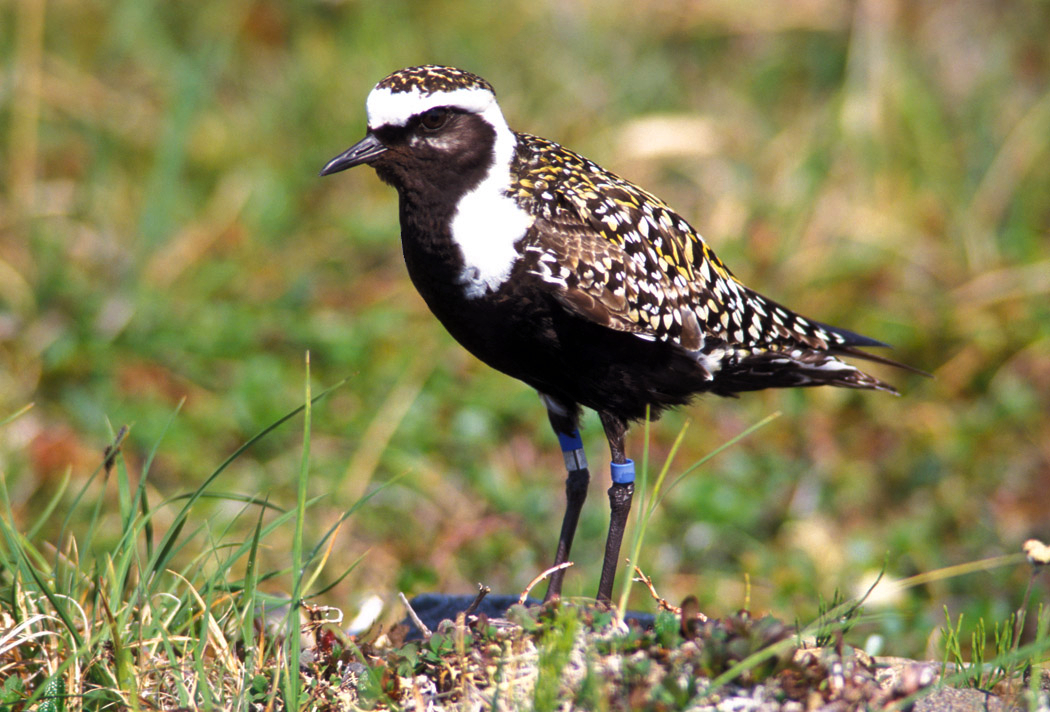
Wikipedia: American golden-plover Source: OTHER
Pluvialis_dominica1.jpg
This bird appears across the great seas in the following continents:
North America, South America, Africa.
![]() The American golden plover (Pluvialis dominica), or American golden-plover is a medium-sized plover. The genus name is Latin and means relating to rain, from pluvia, "rain". It was believed that golden plovers flocked when rain was imminent. The species name dominica refers to Santo Domingo, now Hispaniola, in the West Indies.[2]
[more]
The American golden plover (Pluvialis dominica), or American golden-plover is a medium-sized plover. The genus name is Latin and means relating to rain, from pluvia, "rain". It was believed that golden plovers flocked when rain was imminent. The species name dominica refers to Santo Domingo, now Hispaniola, in the West Indies.[2]
[more]
Black-bellied plover / Kiebitzregenpfeifer (Pluvialis squatarola)
Black-bellied plover eggs. 2016-09-25 16.51.00 Botswana
First observed in Botswana on 2016-09-25.
This bird appears across the great seas in the following continents:
Europe, North America, South America, Africa, Asia.
![]() The grey plover or black-bellied plover (Pluvialis squatarola) is a medium-sized plover breeding in Arctic regions. It is a long-distance migrant, with a nearly worldwide coastal distribution when not breeding.[2] The genus name is Latin and means relating to rain, from pluvia, "rain". It was believed that golden plovers flocked when rain was imminent. The species name squatarola is a Latinised version of Sgatarola, a Venetian name for some kind of plover.[3]
[more]
The grey plover or black-bellied plover (Pluvialis squatarola) is a medium-sized plover breeding in Arctic regions. It is a long-distance migrant, with a nearly worldwide coastal distribution when not breeding.[2] The genus name is Latin and means relating to rain, from pluvia, "rain". It was believed that golden plovers flocked when rain was imminent. The species name squatarola is a Latinised version of Sgatarola, a Venetian name for some kind of plover.[3]
[more]
Calls: ![]() Contact call diagnostic. A plaintive, drawn and trisyllabic (but continuous) "kleeooowee". Pitch falls on second syllable and rises on last. [Link]
Contact call diagnostic. A plaintive, drawn and trisyllabic (but continuous) "kleeooowee". Pitch falls on second syllable and rises on last. [Link]
Physical details: length=27-30 cm,
wingspan=71-83 cm,
weight=190-280 g
Habitats:
Wetland
Pacific golden plover / Sibirischer Goldregenpfeifer (Pluvialis fulva)

Wikipedia: Pacific golden plover Source: OTHER
Pluvialis_fulva_-Bering_Land_Bridge_National_Preserve%2C_Alaska%2C_USA-8.jpg
This bird appears across the great seas in the following continents:
North America, Africa, Asia.
General: ![]() The Pacific golden plover (Pluvialis fulva), or Pacific golden-plover is a medium-sized plover. The genus name is Latin and means relating to rain, from pluvia, "rain". It was believed that golden plovers flocked when rain was imminent. The species name fulva is Latin and refers to a tawny colour.[2]
[more]
The Pacific golden plover (Pluvialis fulva), or Pacific golden-plover is a medium-sized plover. The genus name is Latin and means relating to rain, from pluvia, "rain". It was believed that golden plovers flocked when rain was imminent. The species name fulva is Latin and refers to a tawny colour.[2]
[more]
Curlew sandpiper / Sichelstrandläufer (Calidris ferruginea)
Profile Wikipedia eBird Vogelwarte BirdLife ZH ornitho.ch Audubon AllAboutBirds Xeno-Canto BirdID NABU

Wikipedia: Curlew sandpiper Source: OTHER
1200px-Calidris_ferruginea%2C_winter_adult%2C_Pak_Thale.jpg
This bird appears across the great seas in the following continents:
Europe, North America, South America, Africa, Asia.
Etymology: ![]() Nicolas Baiker sagt, Hauptmerkmale innerhalb der Strandlaeufer sind der Augenstreif und der Schnabel der relativ lang ist und immer lezten Drittel immer krummer, darum Sichelstrandlaeufer. [Link]
Nicolas Baiker sagt, Hauptmerkmale innerhalb der Strandlaeufer sind der Augenstreif und der Schnabel der relativ lang ist und immer lezten Drittel immer krummer, darum Sichelstrandlaeufer. [Link]
Calls: ![]() Flight call a soft, ringing and rolling "krrrrrt, with variations. Lacks the hoarse, nasal quality of similar call by Dunlin. [Link]
Flight call a soft, ringing and rolling "krrrrrt, with variations. Lacks the hoarse, nasal quality of similar call by Dunlin. [Link]
Physical details: length=18-19 cm,
wingspan=42-46 cm,
weight=50-65 g
Habitats:
Wetland
Ruff / Kampfläufer (Calidris pugnax)

Wikipedia: Ruff Source: OTHER
1200px-Philomachus_pugnax_-Diergaarde_Blijdorp-8c.jpg
This bird appears across the great seas in the following continents:
Europe, North America, South America, Africa, Asia.
Etymology: Nabu: Der Name leitet sich vom Balzverhalten der Männchen ab: In Balzarenen tragen sie „Turniere“ aus, um die Weibchen zu beeindrucken, dabei herrscht eine komplizierte Rollenverteilung. [Link]
Vocalization: ![]() Generally silent. Short, muted, nasal, mono or disyllabic grunts sometimes heard. [Link]
Generally silent. Short, muted, nasal, mono or disyllabic grunts sometimes heard. [Link]
Physical details: length=26-30 cm,
wingspan=54-58 cm,
weight=75-230 g
Habitats:
Wetland
White-rumped sandpiper / Weißbürzelstrandläufer (Calidris fuscicollis)
Profile Wikipedia eBird Audubon AllAboutBirds Xeno-Canto

Wikipedia: White-rumped sandpiper Source: OTHER
1200px-Calidris_fuscicollis_PLAYERO_RABADILLA_BLANCA.jpg
This bird appears across the great seas in the following continents:
North America, South America, Africa.
General: ![]() The white-rumped sandpiper (Calidris fuscicollis) is a small shorebird that breeds in the northern tundra of Canada and Alaska. This bird can be difficult to distinguish from other similar tiny shorebirds; these are known collectively as "peeps" or "stints".
[more]
The white-rumped sandpiper (Calidris fuscicollis) is a small shorebird that breeds in the northern tundra of Canada and Alaska. This bird can be difficult to distinguish from other similar tiny shorebirds; these are known collectively as "peeps" or "stints".
[more]
Red knot / Knutt (Calidris canutus)
Profile Wikipedia eBird Vogelwarte BirdLife ZH ornitho.ch Audubon AllAboutBirds Xeno-Canto BirdID NABU
Red knots, according to MerlinBirdID - underway to somewhere better at Las Coloradas. 2023-04-15 09.34.08 Yucatan
First observed in Yucatan on 2023-04-15.
This bird appears across the great seas in the following continents:
Europe, North America, South America, Africa, Asia.
![]() The red knot (Calidris canutus) (just knot in English-speaking Europe) is a medium-sized shorebird which breeds in tundra and the Arctic Cordillera in the far north of Canada, Europe, and Russia. It is a large member of the Calidris sandpipers, second only to the great knot.[2] Six subspecies are recognised.
[more]
The red knot (Calidris canutus) (just knot in English-speaking Europe) is a medium-sized shorebird which breeds in tundra and the Arctic Cordillera in the far north of Canada, Europe, and Russia. It is a large member of the Calidris sandpipers, second only to the great knot.[2] Six subspecies are recognised.
[more]
Song: ![]() Song an undulating, nasal mewing "poooor-mee", or "po-hor-mee". [Link]
Song an undulating, nasal mewing "poooor-mee", or "po-hor-mee". [Link]
Calls: ![]() Most commonly heard migratory call, a short "kut" or "knot". Sometimes given in stuttering series. [Link]
Most commonly heard migratory call, a short "kut" or "knot". Sometimes given in stuttering series. [Link]
Physical details: length=23-25 cm,
wingspan=57-61 cm,
weight=110-160 g
Habitats:
Wetland
Long-toed stint / Langzehenstrandläufer (Calidris subminuta)
Profile Wikipedia eBird Audubon AllAboutBirds Xeno-Canto

Wikipedia: Long-toed stint Source: OTHER
1200px-Calidris_subminuta_-_Pak_Thale.jpg
This bird appears across the great seas in the following continents:
North America, Africa, Asia.
General: ![]() The long-toed stint, Calidris subminuta, is a small wader. The genus name is from Ancient Greek kalidris or skalidris, a term used by Aristotle for some grey-coloured waterside birds. The specific subminuta is from Latin sub, "near to" and minuta, "small" from its similarity to the little stint, Calidris minuta.[2]
[more]
The long-toed stint, Calidris subminuta, is a small wader. The genus name is from Ancient Greek kalidris or skalidris, a term used by Aristotle for some grey-coloured waterside birds. The specific subminuta is from Latin sub, "near to" and minuta, "small" from its similarity to the little stint, Calidris minuta.[2]
[more]
Baird's sandpiper / Bairdstrandläufer (Calidris bairdii)
Profile Wikipedia eBird Audubon AllAboutBirds Xeno-Canto

Wikipedia: Baird's sandpiper Source: OTHER
Calidris_bairdii_-Gullbringusysla%2C_Iceland-8.jpg
This bird appears across the great seas in the following continents:
North America, South America, Africa.
![]() Baird's sandpiper (Calidris bairdii) is a small shorebird. It is among those calidrids which were formerly included in the genus Erolia, which was subsumed into the genus Calidris in 1973.[2] The genus name is from Ancient Greek kalidris or skalidris, a term used by Aristotle for some grey-coloured waterside birds. The English name and specific bairdii commemorate Spencer Fullerton Baird, 19th-century naturalist and assistant secretary of the Smithsonian Institution.[3]
[more]
Baird's sandpiper (Calidris bairdii) is a small shorebird. It is among those calidrids which were formerly included in the genus Erolia, which was subsumed into the genus Calidris in 1973.[2] The genus name is from Ancient Greek kalidris or skalidris, a term used by Aristotle for some grey-coloured waterside birds. The English name and specific bairdii commemorate Spencer Fullerton Baird, 19th-century naturalist and assistant secretary of the Smithsonian Institution.[3]
[more]
Buff-breasted sandpiper / Grasläufer (Calidris subruficollis)

Wikipedia: Buff-breasted sandpiper Source: OTHER
1200px-Tryngites_subruficollis_-USA-8.jpg
This bird appears across the great seas in the following continents:
North America, South America, Africa.
![]() The buff-breasted sandpiper (Calidris subruficollis) is a small shorebird. The species name subruficollis is from Latin subrufus, "reddish" (from sub, "somewhat", and rufus, "rufous") and collis, "-necked/-throated" (from collum, "neck").[2] It is a calidrid sandpiper.
[more]
The buff-breasted sandpiper (Calidris subruficollis) is a small shorebird. The species name subruficollis is from Latin subrufus, "reddish" (from sub, "somewhat", and rufus, "rufous") and collis, "-necked/-throated" (from collum, "neck").[2] It is a calidrid sandpiper.
[more]
Sanderling / Sanderling (Calidris alba)
Profile Wikipedia eBird Vogelwarte BirdLife ZH ornitho.ch Audubon AllAboutBirds Xeno-Canto BirdID NABU
Sanderling. 2023-09-27 12.12.20 Florida
First observed in Yucatan on 2023-03-27.
This bird appears across the great seas in the following continents:
Europe, North America, South America, Africa, Asia.
![]() The sanderling (Calidris alba) is a small wading bird. The name derives from Old English sand-yrðling, "sand-ploughman".[2] The genus name is from Ancient Greek kalidris or skalidris, a term used by Aristotle for some grey-coloured waterside birds. The specific alba is Latin for "white".[3]
[more]
The sanderling (Calidris alba) is a small wading bird. The name derives from Old English sand-yrðling, "sand-ploughman".[2] The genus name is from Ancient Greek kalidris or skalidris, a term used by Aristotle for some grey-coloured waterside birds. The specific alba is Latin for "white".[3]
[more]
Calls: ![]() Call not very diagnostic; a short and soft "pleet" or "keek". [Link]
Call not very diagnostic; a short and soft "pleet" or "keek". [Link]
Physical details: length=20-21 cm,
wingspan=40-45 cm,
weight=44-70 g
Habitats:
Wetland
Dunlin / Alpenstrandläufer (Calidris alpina)
Profile Wikipedia eBird Vogelwarte BirdLife ZH ornitho.ch Audubon AllAboutBirds Xeno-Canto BirdID NABU
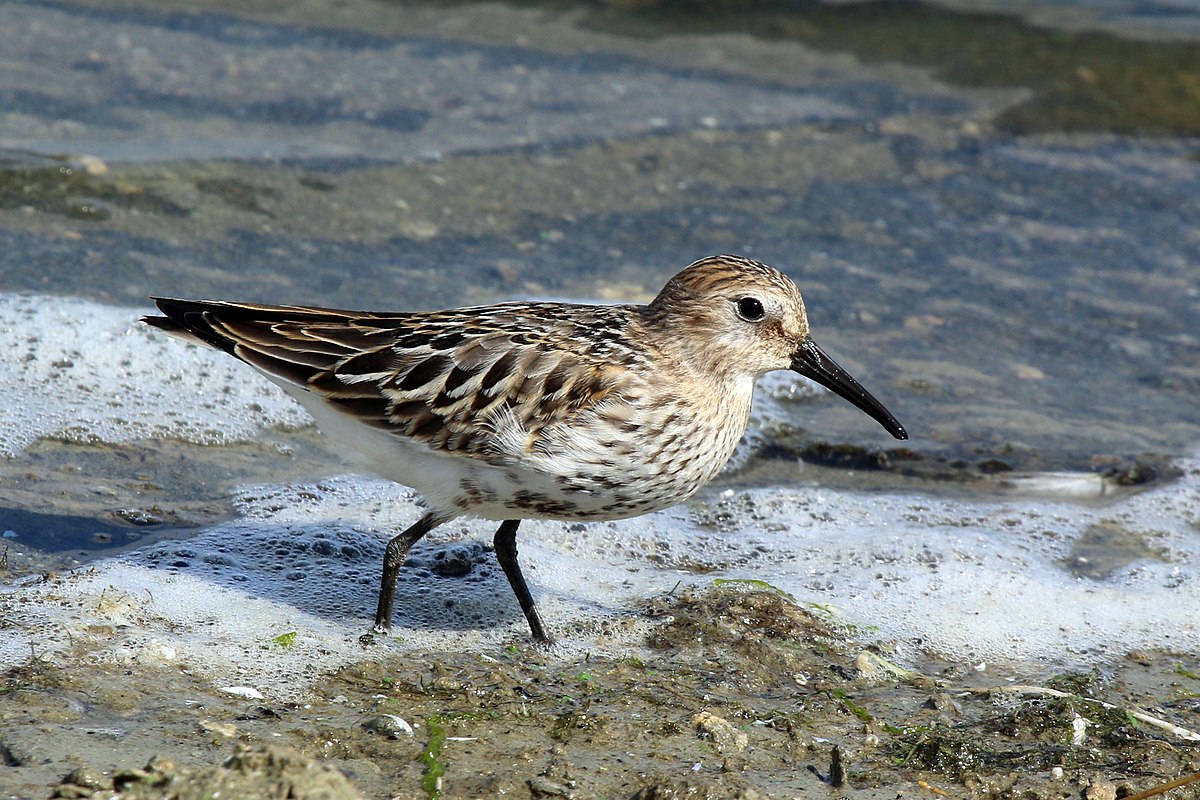
Wikipedia: Dunlin Source: OTHER
1200px-Dunlin_%28Calidris_alpina%29_juvenile.jpg
This bird appears across the great seas in the following continents:
Europe, North America, South America, Africa.
General: ![]() The dunlin (Calidris alpina) is a small wader, sometimes separated with the other "stints" in Erolia. The English name is a dialect form of "dunling", first recorded in 1531–2. It derives from dun, "dull brown", with the suffix -ling, meaning a person or thing with the given quality.[2] The genus name is from Ancient Greek kalidris or skalidris, a term used by Aristotle for some grey-coloured waterside birds. The specific alpina is from Latin and means "of high mountains", in this case referring to the Alps.[3]
[more]
The dunlin (Calidris alpina) is a small wader, sometimes separated with the other "stints" in Erolia. The English name is a dialect form of "dunling", first recorded in 1531–2. It derives from dun, "dull brown", with the suffix -ling, meaning a person or thing with the given quality.[2] The genus name is from Ancient Greek kalidris or skalidris, a term used by Aristotle for some grey-coloured waterside birds. The specific alpina is from Latin and means "of high mountains", in this case referring to the Alps.[3]
[more]
Song: ![]() Song: A drawn out, nasal "tweeet", and ringing variations on the contact call in decrescendo. Low chattering heard from feeding birds. [Link]
Song: A drawn out, nasal "tweeet", and ringing variations on the contact call in decrescendo. Low chattering heard from feeding birds. [Link]
Calls: ![]() Contact call a diagnostic, very nasal "trrreeet" . Given throughout the year and in many situations, including when being flushed. [Link]
Contact call a diagnostic, very nasal "trrreeet" . Given throughout the year and in many situations, including when being flushed. [Link]
Physical details: length=16-20 cm,
wingspan=38-43 cm,
weight=35-60 g
Habitats:
Wetland
Rufous-necked stint / Rotkehlstrandläufer (Calidris ruficollis)
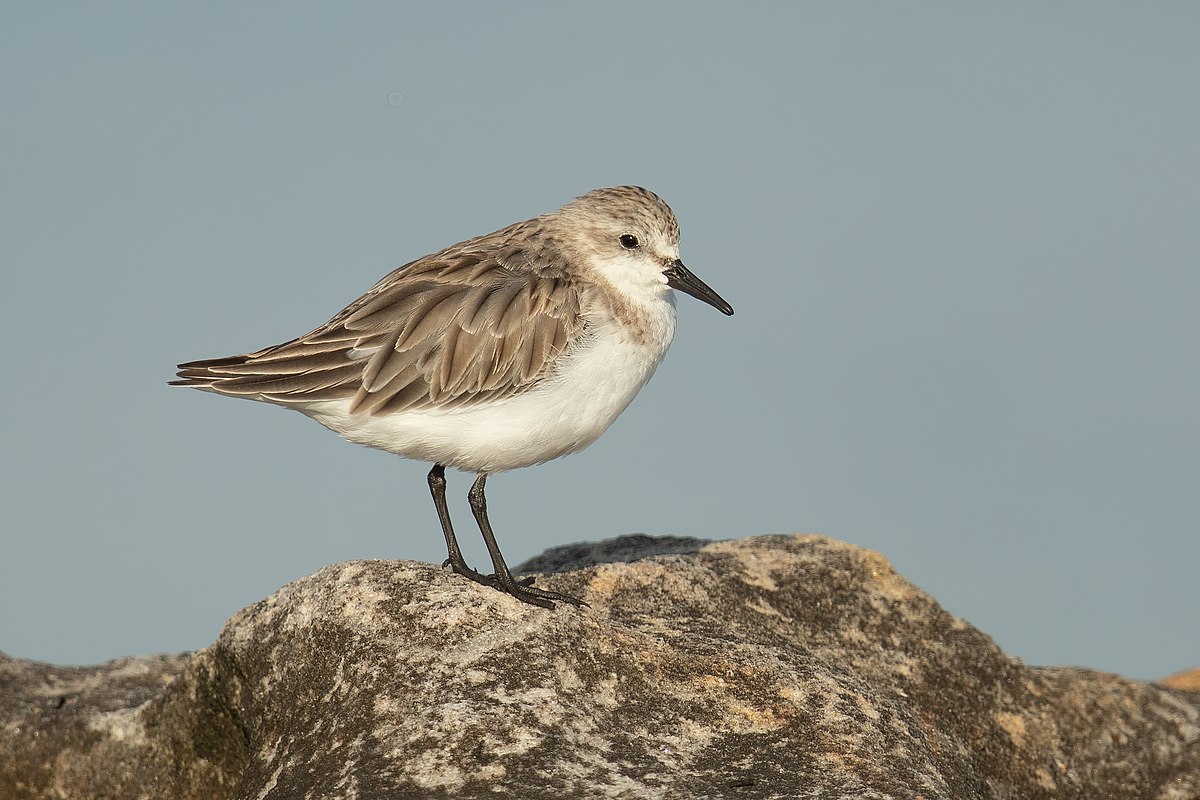
Wikipedia: Rufous-necked stint Source: OTHER
1200px-Red-necked_Stint_-_Boat_Harbour.jpg
This bird appears across the great seas in the following continents:
North America, Africa, Asia.
General: ![]() The red-necked stint (Calidris ruficollis) is a small migratory wader. The genus name is from Ancient Greek kalidris or skalidris, a term used by Aristotle for some grey-coloured waterside birds. The specific ruficollis is from Latin rufus, "red" and collum, "neck".[2]
[more]
The red-necked stint (Calidris ruficollis) is a small migratory wader. The genus name is from Ancient Greek kalidris or skalidris, a term used by Aristotle for some grey-coloured waterside birds. The specific ruficollis is from Latin rufus, "red" and collum, "neck".[2]
[more]
Pectoral sandpiper / Graubrust-Strandläufer (Calidris melanotos)
Profile Wikipedia eBird Audubon AllAboutBirds Xeno-Canto

Wikipedia: Pectoral sandpiper Source: OTHER
1200px-Pectoral_Sandpiper3.jpg
This bird appears across the great seas in the following continents:
North America, South America, Africa.
![]() The pectoral sandpiper (Calidris melanotos) is a small, migratory wader that breeds in North America and Asia, wintering in South America and Oceania. It eats small invertebrates. Its nest, a hole scraped in the ground and with a thick lining, is deep enough to protect its four eggs from the cool breezes of its breeding grounds. The pectoral sandpiper is 21 cm (8.3 in) long, with a wingspan of 46 cm (18 in).
[more]
The pectoral sandpiper (Calidris melanotos) is a small, migratory wader that breeds in North America and Asia, wintering in South America and Oceania. It eats small invertebrates. Its nest, a hole scraped in the ground and with a thick lining, is deep enough to protect its four eggs from the cool breezes of its breeding grounds. The pectoral sandpiper is 21 cm (8.3 in) long, with a wingspan of 46 cm (18 in).
[more]
Sharp-tailed sandpiper (Calidris acuminata)

Wikipedia: Sharp-tailed sandpiper Source: OTHER
1200px-Calidris_acuminata_-_Hexham_Swamp.jpg
This bird appears across the great seas in the following continents:
North America, Asia, Australia.
![]() The sharp-tailed sandpiper (Calidris acuminata) (but see below) is a small wader.
[more]
The sharp-tailed sandpiper (Calidris acuminata) (but see below) is a small wader.
[more]
Stilt sandpiper (Calidris himantopus)

Wikipedia: Stilt sandpiper Source: OTHER
Calidris_himantopus.jpg
This bird appears across the great seas in the following continents:
North America, South America, Australia.
vagrant
Purple sandpiper / Meerstrandläufer (Calidris maritima)
Profile Wikipedia eBird Audubon AllAboutBirds Xeno-Canto BirdID NABU
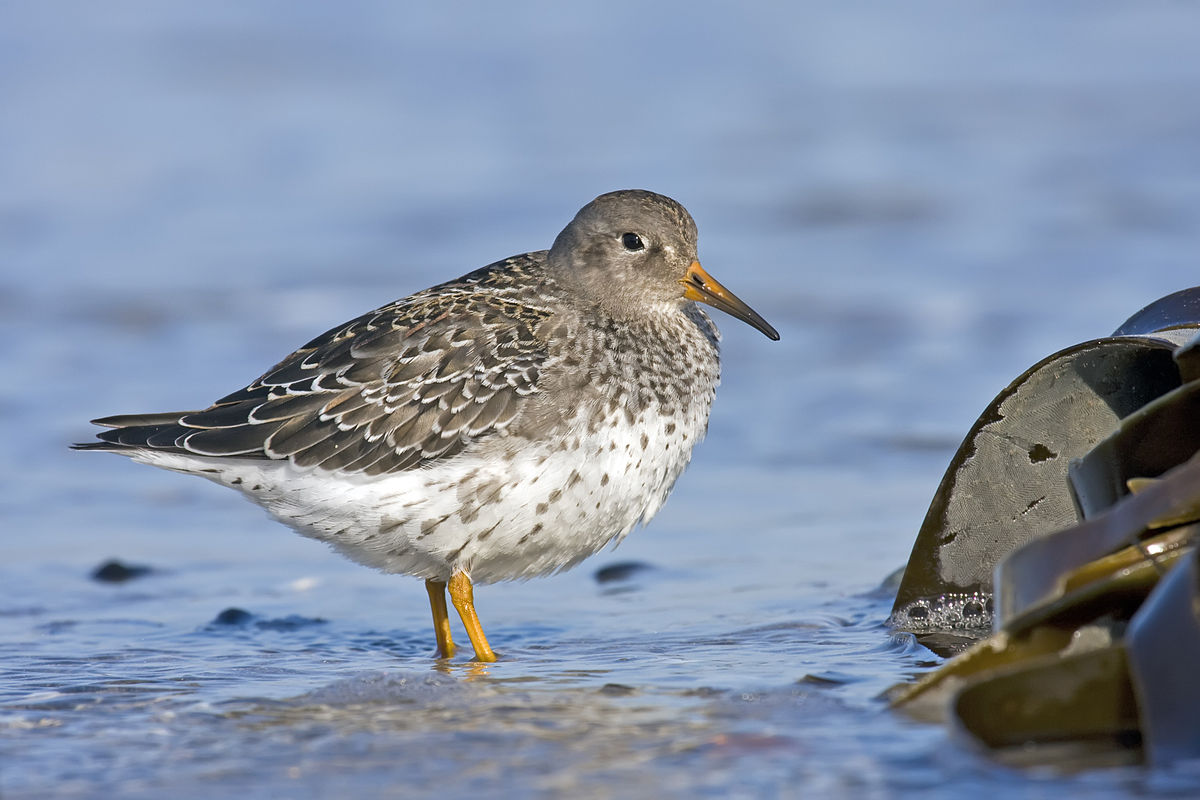
Wikipedia: Purple sandpiper Source: OTHER
1200px-Calidris_maritima.jpg
This bird appears across the great seas in the following continents:
Europe, North America.
Deutschland: Zugvogel, Wintergast
Song: ![]() Song quite varied with series of short, nasal, vibrating sounds, interspersed with drawn out, slower calls. [Link]
Song quite varied with series of short, nasal, vibrating sounds, interspersed with drawn out, slower calls. [Link]
Calls: ![]() Contact call a hoarse and hard "weet". Sometimes in chattering series. [Link]
Contact call a hoarse and hard "weet". Sometimes in chattering series. [Link]
Physical details: length=20-22 cm,
wingspan=42-46 cm,
weight=52-80 g
Western sandpiper / Bergstrandläufer (Calidris mauri)
Profile Wikipedia eBird Audubon AllAboutBirds Xeno-Canto

Wikipedia: Western sandpiper Source: OTHER
Western_Sandpiper.jpg
General: ![]() The western sandpiper (Calidris mauri) is a small shorebird. The genus name is from Ancient Greek kalidris or skalidris, a term used by Aristotle for some grey-coloured waterside birds. The specific mauri commemorates Italian botanist Ernesto Mauri (1791–1836).[2]
[more]
The western sandpiper (Calidris mauri) is a small shorebird. The genus name is from Ancient Greek kalidris or skalidris, a term used by Aristotle for some grey-coloured waterside birds. The specific mauri commemorates Italian botanist Ernesto Mauri (1791–1836).[2]
[more]
Semipalmated sandpiper / Sandstrandläufer (Calidris pusilla)
Dark-rimmed wings of these beautiful birds, probably semipalmated sandpiper, show up in flight. 2023-04-20 16.29.32 Yucatan
First observed in Yucatan on 2023-04-20.
![]() The semipalmated sandpiper (Calidris pusilla) is a very small shorebird. The genus name is from Ancient Greek kalidris or skalidris, a term used by Aristotle for some grey-coloured waterside birds. The specific pusilla is Latin for "very small".[2]
[more]
The semipalmated sandpiper (Calidris pusilla) is a very small shorebird. The genus name is from Ancient Greek kalidris or skalidris, a term used by Aristotle for some grey-coloured waterside birds. The specific pusilla is Latin for "very small".[2]
[more]
Least sandpiper / Wiesenstrandläufer (Calidris minutilla)
Profile Wikipedia eBird Audubon AllAboutBirds Xeno-Canto
Least sandpiper has wandered off the sea into the city in Campeche. 2023-04-06 16.53.02 Yucatan
First observed in Yucatan on 2023-04-06.
![]() The least sandpiper (Calidris minutilla) is the smallest shorebird. The genus name is from Ancient Greek kalidris or skalidris, a term used by Aristotle for some grey-colored waterside birds. The specific minutilla is Medieval Latin for "very small".[2]
[more]
The least sandpiper (Calidris minutilla) is the smallest shorebird. The genus name is from Ancient Greek kalidris or skalidris, a term used by Aristotle for some grey-colored waterside birds. The specific minutilla is Medieval Latin for "very small".[2]
[more]
Rock sandpiper / Beringstrandläufer (Calidris ptilocnemis)
Profile Wikipedia eBird Audubon AllAboutBirds Xeno-Canto

Wikipedia: Rock sandpiper Source: OTHER
1200px-Calidris_ptilocnemis1.jpg
![]() The rock sandpiper (Calidris or Erolia ptilocnemis) is a small shorebird.
[more]
The rock sandpiper (Calidris or Erolia ptilocnemis) is a small shorebird.
[more]
Whimbrel / Regenbrachvogel (Numenius phaeopus)
Regenbrachvogel oder Grosser Brachvogel - dunkle Schwanzfedern ein moegliches Zeichen. 2022-06-23 16.53.34 La Sauge
First observed in Canary Islands on 2022-03-19.
This bird appears across the great seas in the following continents:
Europe, North America, South America, Africa, Asia.
![]() Der Regenbrachvogel (Numenius phaeopus) ist mit einer Spannweite um die 80 cm viel kleiner als der Große Brachvogel, auch der Schnabel ist kürzer und der Oberkopf ist hell und dunkel gestreift. Der Ruf dieser Vogelart ähnelt einem hellen Trillern.
[more]
Der Regenbrachvogel (Numenius phaeopus) ist mit einer Spannweite um die 80 cm viel kleiner als der Große Brachvogel, auch der Schnabel ist kürzer und der Oberkopf ist hell und dunkel gestreift. Der Ruf dieser Vogelart ähnelt einem hellen Trillern.
[more]
Song: ![]() Song starts similar to Curlew with long wailing notes "kluuueee", which then accelerates to a continuous, vibrating single note. Lacks the cyclic phrase ending of Curlew. [Link]
Song starts similar to Curlew with long wailing notes "kluuueee", which then accelerates to a continuous, vibrating single note. Lacks the cyclic phrase ending of Curlew. [Link]
Physical details: length=40-42 cm,
wingspan=76-89 cm,
weight=300-660 g
Habitats:
Wetland
Long-billed curlew (Numenius americanus)
Profile Wikipedia eBird Audubon AllAboutBirds Xeno-Canto

Wikipedia: Long-billed curlew Source: OTHER
1200px-Long-billed_curlew_at_Drakes_Beach%2C_Point_Reyes.jpg
General: ![]() The long-billed curlew (Numenius americanus) is a large North American shorebird of the family Scolopacidae. This species was also called "sicklebird"[2] and the "candlestick bird". The species breeds in central and western North America, migrating southward and coastward for the winter.
[more]
The long-billed curlew (Numenius americanus) is a large North American shorebird of the family Scolopacidae. This species was also called "sicklebird"[2] and the "candlestick bird". The species breeds in central and western North America, migrating southward and coastward for the winter.
[more]
Eskimo curlew (Numenius borealis)
Profile Wikipedia eBird Audubon AllAboutBirds Xeno-Canto

Wikipedia: Eskimo curlew Source: OTHER
1200px-Numenius_borealis_ULaval_1.jpg
![]() The Eskimo curlew (Numenius borealis), also known as northern curlew, was a species of curlew in the family Scolopacidae. It was one of the most numerous shorebirds in the tundra of western Arctic Canada and Alaska. Approximately two million birds were then killed per year in the late 1800s. As there has not been a reliable sighting since 1987 or a confirmed sighting since 1963, the Eskimo curlew is considered Critically Endangered or possibly extinct. The bird was about 30 cm (12 in) long and fed mostly on insects and berries.
[more]
The Eskimo curlew (Numenius borealis), also known as northern curlew, was a species of curlew in the family Scolopacidae. It was one of the most numerous shorebirds in the tundra of western Arctic Canada and Alaska. Approximately two million birds were then killed per year in the late 1800s. As there has not been a reliable sighting since 1987 or a confirmed sighting since 1963, the Eskimo curlew is considered Critically Endangered or possibly extinct. The bird was about 30 cm (12 in) long and fed mostly on insects and berries.
[more]
Bristle-thighed curlew / Borstenbrachvogel (Numenius tahitiensis)
Profile Wikipedia eBird Audubon AllAboutBirds Xeno-Canto

Wikipedia: Bristle-thighed curlew Source: OTHER
Bristle-thighed_Curlew.jpg
![]() The bristle-thighed curlew (Numenius tahitiensis) is a medium-sized shorebird that breeds in Alaska and winters on tropical Pacific islands. It has a long, decurved bill and bristled feathers at the base of the legs. Its length is about 40–44 cm and wingspan about 84 cm (females averaging bigger than males). The size and shape are the same as the whimbrel's, and the plumage is similar, spotted brown on their upper body with a light belly and rust-colored or buffy tail. The bigger buff spots on the upper body, unmarked light belly and barely marked flanks, tail color, and pale buffy-orange rump distinguish it from the whimbrel.
[more]
The bristle-thighed curlew (Numenius tahitiensis) is a medium-sized shorebird that breeds in Alaska and winters on tropical Pacific islands. It has a long, decurved bill and bristled feathers at the base of the legs. Its length is about 40–44 cm and wingspan about 84 cm (females averaging bigger than males). The size and shape are the same as the whimbrel's, and the plumage is similar, spotted brown on their upper body with a light belly and rust-colored or buffy tail. The bigger buff spots on the upper body, unmarked light belly and barely marked flanks, tail color, and pale buffy-orange rump distinguish it from the whimbrel.
[more]
Ruddy turnstone / Steinwälzer (Arenaria interpres)
Ruddy turnstone near Las Coloradas. 2023-04-15 10.06.32 Yucatan
First observed in Canary Islands on 2022-03-19.
This bird appears across the great seas in the following continents:
Europe, North America, South America, Africa, Asia.
![]() The ruddy turnstone (Arenaria interpres) is a small wading bird, one of two species of turnstone in the genus Arenaria. The scientific name is from Latin. The genus name arenaria derives from arenarius, "inhabiting sand, from arena, "sand". The specific interpres means "messenger"; when visiting Gotland in 1741, Linnaeus thought that the Swedish word Tolk "interpreter" applied to this species, but in the local dialect the word means "legs" and is used for the redshank.[2]
[more]
The ruddy turnstone (Arenaria interpres) is a small wading bird, one of two species of turnstone in the genus Arenaria. The scientific name is from Latin. The genus name arenaria derives from arenarius, "inhabiting sand, from arena, "sand". The specific interpres means "messenger"; when visiting Gotland in 1741, Linnaeus thought that the Swedish word Tolk "interpreter" applied to this species, but in the local dialect the word means "legs" and is used for the redshank.[2]
[more]
Song: ![]() Alarm call/song more "wader-like", a staccato "kuvi-kuvi-vit-vit-vitua". [Link]
Alarm call/song more "wader-like", a staccato "kuvi-kuvi-vit-vit-vitua". [Link]
Calls: ![]() Characteristic call: An explosive, hard, resonant and short "koi" or "kott" with a peculiar timbre, usually given in rapid or accelerating series. [Link]
Characteristic call: An explosive, hard, resonant and short "koi" or "kott" with a peculiar timbre, usually given in rapid or accelerating series. [Link]
Physical details: length=22-24 cm,
wingspan=50-57 cm,
weight=85-150 g
Habitats:
Wetland
Black turnstone / Schwarzkopf-Steinwälzer (Arenaria melanocephala)

Wikipedia: Black turnstone Source: OTHER
Black_Turnstone%2C_breeding_plumage_%282112366200%29.jpg
General: ![]() The black turnstone (Arenaria melanocephala) is a species of small wading bird. It is one of two species of turnstone in the genus Arenaria the ruddy turnstone (A. interpres) being the other. It is now classified in the sandpiper family, Scolopacidae, but was formerly sometimes placed in the plover family, Charadriidae. It is native to the west coast of North America and breeds only in Alaska.
[more]
The black turnstone (Arenaria melanocephala) is a species of small wading bird. It is one of two species of turnstone in the genus Arenaria the ruddy turnstone (A. interpres) being the other. It is now classified in the sandpiper family, Scolopacidae, but was formerly sometimes placed in the plover family, Charadriidae. It is native to the west coast of North America and breeds only in Alaska.
[more]
American woodcock (Scolopax minor)
Profile Wikipedia eBird Audubon AllAboutBirds Xeno-Canto
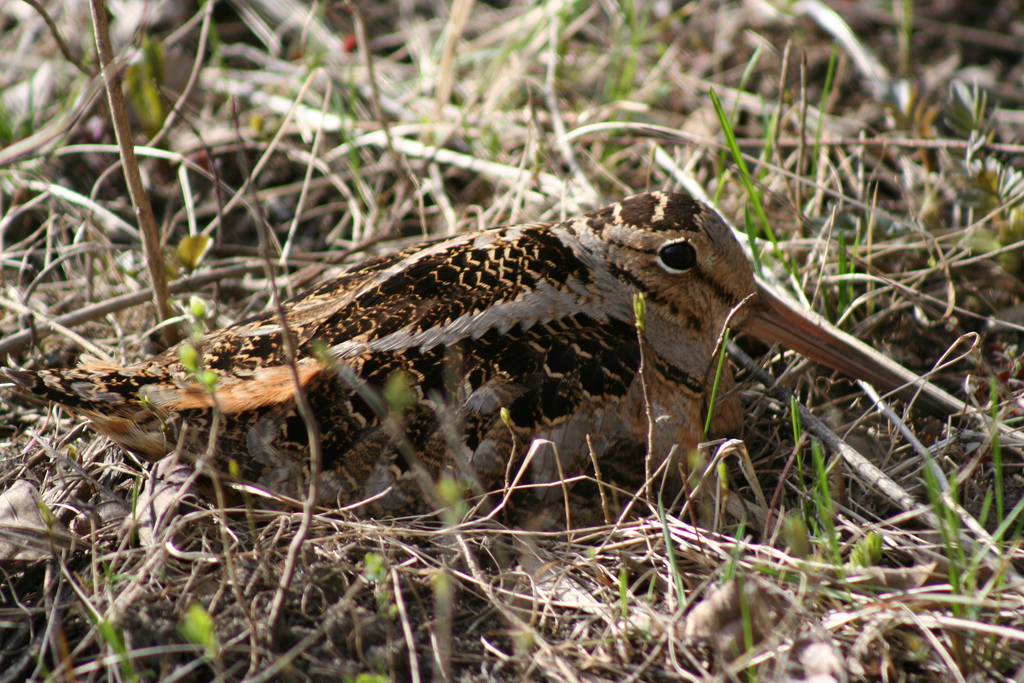
Wikipedia: American woodcock Source: OTHER
American_Woodcock_Scolopax_minor.jpg
![]() The American woodcock (Scolopax minor), sometimes colloquially referred to as the timberdoodle, the bogsucker, the hokumpoke, and the Labrador twister,[2] is a small shorebird species found primarily in the eastern half of North America. Woodcocks spend most of their time on the ground in brushy, young-forest habitats, where the birds' brown, black, and gray plumage provides excellent camouflage.
[more]
The American woodcock (Scolopax minor), sometimes colloquially referred to as the timberdoodle, the bogsucker, the hokumpoke, and the Labrador twister,[2] is a small shorebird species found primarily in the eastern half of North America. Woodcocks spend most of their time on the ground in brushy, young-forest habitats, where the birds' brown, black, and gray plumage provides excellent camouflage.
[more]
Swinhoe's snipe / Waldbekassine (Gallinago megala)
Profile Wikipedia eBird Audubon AllAboutBirds Xeno-Canto

Wikipedia: Swinhoe's snipe Source: OTHER
Gallinago_megala.jpg
This bird appears across the great seas in the following continents:
North America, Asia, Australia.
![]() Swinhoe's snipe, Gallinago megala, also known as forest snipe or Chinese snipe, is a medium-sized (length 27–29 cm, wingspan 38–44 cm, weight 120 gm), long-billed, migratory wader.
[more]
Swinhoe's snipe, Gallinago megala, also known as forest snipe or Chinese snipe, is a medium-sized (length 27–29 cm, wingspan 38–44 cm, weight 120 gm), long-billed, migratory wader.
[more]
Common snipe / Bekassine (Gallinago gallinago)
Rechts nach Links - drei Bekassinen, Kiebitz, Krickenten. 2021-10-24 10.34.58 Neeracherried
First observed in 🇨🇭 on 2021-10-24.
This bird appears across the great seas in the following continents:
Europe, North America, Africa, Asia.
Deutschland: Brut-, Zugvogel, Wintergast RL 1
Vocalization: ![]() Quite vocal, especially at breeding ground. [Link]
Quite vocal, especially at breeding ground. [Link]
Song: ![]() Song an unmistakable bleating, drumming sound produced by vibrating tail feathers in sky-dives. [Link]
Song an unmistakable bleating, drumming sound produced by vibrating tail feathers in sky-dives. [Link]
Calls: ![]() Almost always give diagnostic hoarse and nasal "kaaat" call when flushed. Another territorial call is a rhythmic, mechanical and sharp "tika-tika-tka", or "ika-ka-ka". [Link]
Almost always give diagnostic hoarse and nasal "kaaat" call when flushed. Another territorial call is a rhythmic, mechanical and sharp "tika-tika-tka", or "ika-ka-ka". [Link]
Physical details: length=25-27 cm,
wingspan=44-47 cm,
weight=80-140 g
Habitats:
Wetland
Wilson's snipe / Wilsonbekassine (Gallinago delicata)
Profile Wikipedia eBird Audubon AllAboutBirds Xeno-Canto

Wikipedia: Wilson's snipe Source: OTHER
1200px-Gallinago-delicata-002-cropped.jpg
General: ![]() Wilson's snipe (Gallinago delicata) is a small, stocky shorebird.[2] The genus name gallinago is New Latin for a woodcock or snipe from Latin gallina, "hen" and the suffix -ago, "resembling". The specific delicata is Latin for "dainty".[3]
[more]
Wilson's snipe (Gallinago delicata) is a small, stocky shorebird.[2] The genus name gallinago is New Latin for a woodcock or snipe from Latin gallina, "hen" and the suffix -ago, "resembling". The specific delicata is Latin for "dainty".[3]
[more]
Long-billed dowitcher / Großer Schlammläufer (Limnodromus scolopaceus)
Profile Wikipedia eBird Audubon AllAboutBirds Xeno-Canto

Wikipedia: Long-billed dowitcher Source: OTHER
1200px-Limnodromus_scolopaceus_Mike_Baird_crop.jpg
This bird appears across the great seas in the following continents:
North America, South America, Australia.
vagrant
Shortbilled dowitcher / Kleiner Schlammläufer (Limnodromus griseus)
You can see why it's called Las Colarados here - I believe Erik said short-billed dowitchers. 2023-04-15 09.33.38 Yucatan
First observed in Yucatan on 2023-04-15.
This bird appears across the great seas in the following continents:
North America, South America, Australia.
vagrant
Bar-tailed godwit / Pfuhlschnepfe (Limosa lapponica)
Profile Wikipedia eBird Vogelwarte BirdLife ZH ornitho.ch Audubon AllAboutBirds Xeno-Canto NABU

Wikipedia: Bar-tailed godwit Source: OTHER
1200px-Bar-tailed_Godwit.jpg
This bird appears across the great seas in the following continents:
Europe, North America, Africa, Asia.
Seasonal Behavior: Other: Eine junge Pfuhlschnepfe scheint einen Non-Stop-Rekord für Zugvögel aufgestellt zu haben. Der Vogel sei über 13.500 Kilometer von Alaska in den australischen Bundesstaat Tasmanien geflogen, das berichteten mehrere Medien übereinstimmend. [Link]
Habitats:
Wetland
Hudsonian godwit / Hudsonschnepfe (Limosa haemastica)
Profile Wikipedia eBird Audubon AllAboutBirds Xeno-Canto

Wikipedia: Hudsonian godwit Source: OTHER
1200px-Limosa_haemastica_-_Kogarah_Bay.jpg
This bird appears across the great seas in the following continents:
North America, South America, Africa.
General: ![]() The Hudsonian godwit (Limosa haemastica) is a large shorebird in the sandpiper family, Scolopacidae. The genus name Limosa is from Latin and means "muddy", from limus, "mud". The specific haemastica is from Ancient Greek and means "bloody". An 18th century name for this bird was red-breasted godwit.[2] The English term "godwit" was first recorded in about 1416–7 and is believed to imitate the bird's call.[3]
[more]
The Hudsonian godwit (Limosa haemastica) is a large shorebird in the sandpiper family, Scolopacidae. The genus name Limosa is from Latin and means "muddy", from limus, "mud". The specific haemastica is from Ancient Greek and means "bloody". An 18th century name for this bird was red-breasted godwit.[2] The English term "godwit" was first recorded in about 1416–7 and is believed to imitate the bird's call.[3]
[more]
Black-tailed godwit / Uferschnepfe (Limosa limosa)
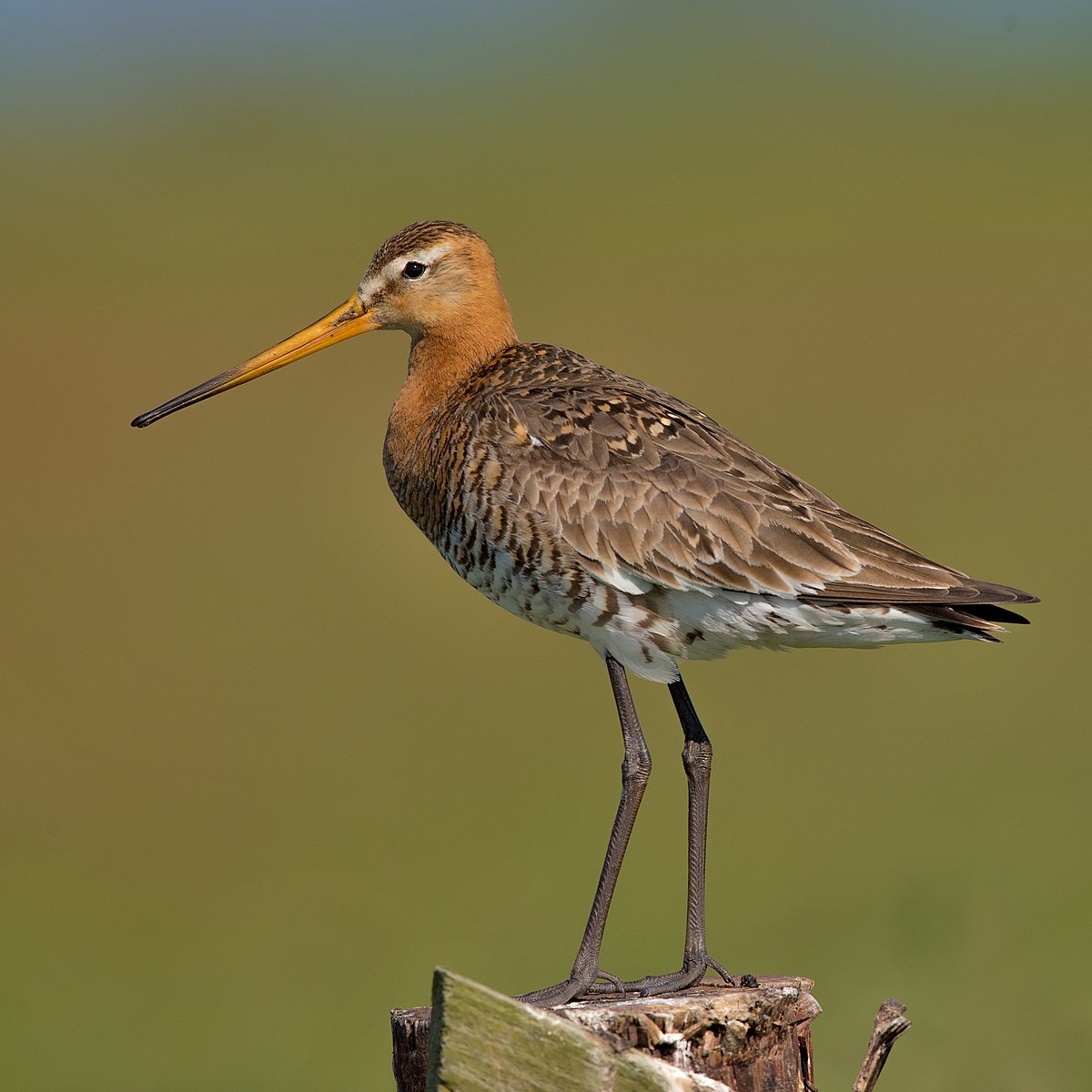
Wikipedia: Black-tailed godwit Source: OTHER
1200px-Black-tailed_Godwit_Uferschnepfe.jpg
This bird appears across the great seas in the following continents:
Europe, North America, Africa, Asia.
![]() The black-tailed godwit (Limosa limosa) is a large, long-legged, long-billed shorebird first described by Carl Linnaeus in 1758. It is a member of the godwit genus, Limosa. There are three subspecies, all with orange head, neck and chest in breeding plumage and dull grey-brown winter coloration, and distinctive black and white wingbar at all times.
[more]
The black-tailed godwit (Limosa limosa) is a large, long-legged, long-billed shorebird first described by Carl Linnaeus in 1758. It is a member of the godwit genus, Limosa. There are three subspecies, all with orange head, neck and chest in breeding plumage and dull grey-brown winter coloration, and distinctive black and white wingbar at all times.
[more]
Habitats:
Wetland
Marbled godwit / Amerikanische Pfuhlschnepfe (Limosa fedoa)
Profile Wikipedia eBird Audubon AllAboutBirds Xeno-Canto
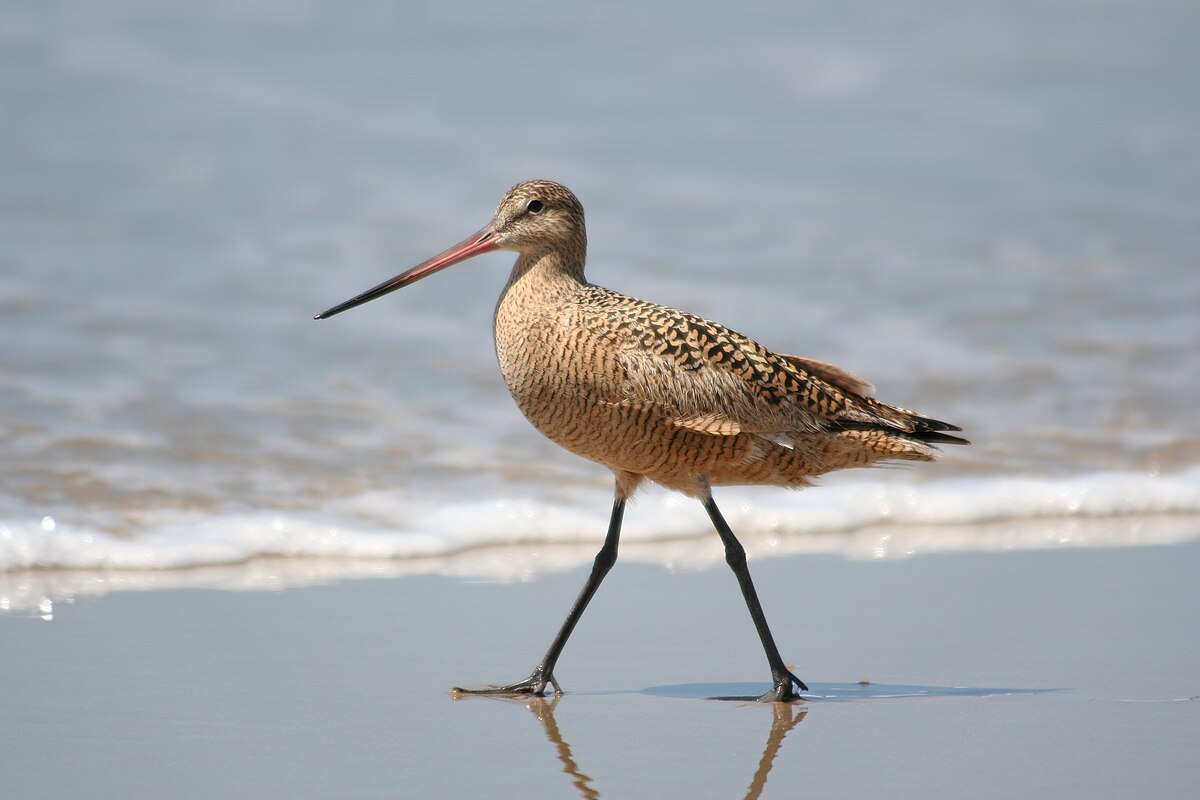
Wikipedia: Marbled godwit Source: OTHER
1200px-MarbledGodwit.jpg
![]() The marbled godwit (Limosa fedoa) is a large shorebird. On average, it is the largest of the 4 species of godwit.
[more]
The marbled godwit (Limosa fedoa) is a large shorebird. On average, it is the largest of the 4 species of godwit.
[more]
Lesser yellowlegs / Kleiner Gelbschenkel (Tringa flavipes)
Profile Wikipedia eBird Audubon AllAboutBirds Xeno-Canto

Wikipedia: Lesser yellowlegs Source: OTHER
1200px-Lesser_Yellowlegs.jpg
This bird appears across the great seas in the following continents:
North America, South America, Africa.
![]() The lesser yellowlegs (Tringa flavipes) is a medium-sized shorebird. The genus name Tringa is the New Latin name given to the green sandpiper by Aldrovandus in 1599 based on Ancient Greek trungas, a thrush-sized, white-rumped, tail-bobbing wading bird mentioned by Aristotle. The specific flavipes is from Latin flavus, "yellow", and pes, "foot".[2]
[more]
The lesser yellowlegs (Tringa flavipes) is a medium-sized shorebird. The genus name Tringa is the New Latin name given to the green sandpiper by Aldrovandus in 1599 based on Ancient Greek trungas, a thrush-sized, white-rumped, tail-bobbing wading bird mentioned by Aristotle. The specific flavipes is from Latin flavus, "yellow", and pes, "foot".[2]
[more]
Wood sandpiper / Bruchwasserläufer (Tringa glareola)
Profile Wikipedia eBird Vogelwarte BirdLife ZH ornitho.ch Audubon AllAboutBirds Xeno-Canto BirdID NABU

Wikipedia: Wood sandpiper Source: OTHER
1200px-Wood_Sandpiper_Safari_Park.jpg
First observed in 🇨🇭 on 2021-08-19.
This bird appears across the great seas in the following continents:
Europe, North America, Africa, Asia.
![]() The wood sandpiper (Tringa glareola) is a small wader. This Eurasian species is the smallest of the shanks, which are mid-sized long-legged waders of the family Scolopacidae. The genus name Tringa is the New Latin name given to the green sandpiper by Aldrovandus in 1599 based on Ancient Greek trungas, a thrush-sized, white-rumped, tail-bobbing wading bird mentioned by Aristotle. The specific glareola is from Latin glarea, " gravel".[2]
[more]
The wood sandpiper (Tringa glareola) is a small wader. This Eurasian species is the smallest of the shanks, which are mid-sized long-legged waders of the family Scolopacidae. The genus name Tringa is the New Latin name given to the green sandpiper by Aldrovandus in 1599 based on Ancient Greek trungas, a thrush-sized, white-rumped, tail-bobbing wading bird mentioned by Aristotle. The specific glareola is from Latin glarea, " gravel".[2]
[more]
Vocalization: ![]() Totally different from Green Sandpiper. [Link]
Totally different from Green Sandpiper. [Link]
Calls: ![]() Flight call a soft, but explosive "whiff whiff" , sometimes with only one syllable. Display call similar to redshank but with only two accented beats; a fast melodious "dee-loo", repeated in cycles. [Link]
Flight call a soft, but explosive "whiff whiff" , sometimes with only one syllable. Display call similar to redshank but with only two accented beats; a fast melodious "dee-loo", repeated in cycles. [Link]
Physical details: length=19-21 cm,
wingspan=56-57 cm,
weight=50-80 g
Habitats:
Wetland
Call:
Automatically generated from Xeno-Canto recording
♫ Source: BirdNet
20210819_082604 birdnet 1940 - Wood Sandpiper, saw a bird flying, check reports in Ornitho - Wood Sandpiper - Uznach.mp3
2021-08-19 08.26.04 Uznach (song?)
Common greenshank / Grünschenkel (Tringa nebularia)
Profile Wikipedia eBird Vogelwarte BirdLife ZH ornitho.ch Audubon AllAboutBirds Xeno-Canto BirdID NABU
MerlinBirdID says common greenshank, probably non-breeding adult. 2022-04-12 14.52.08 Mallorca
First observed in Mallorca on 2022-04-12.
This bird appears across the great seas in the following continents:
Europe, North America, Africa, Asia.
General: ![]() The common greenshank (Tringa nebularia) is a wader in the large family Scolopacidae, the typical waders. The genus name Tringa is the New Latin name given to the green sandpiper by Aldrovandus in 1599 based on Ancient Greek trungas, a thrush-sized, white-rumped, tail-bobbing wading bird mentioned by Aristotle. The specific nebularia is from Latin nebula "mist". Like the Norwegian Skoddefoll, this refers to the greenshank's damp marshy habitat.[2]
[more]
The common greenshank (Tringa nebularia) is a wader in the large family Scolopacidae, the typical waders. The genus name Tringa is the New Latin name given to the green sandpiper by Aldrovandus in 1599 based on Ancient Greek trungas, a thrush-sized, white-rumped, tail-bobbing wading bird mentioned by Aristotle. The specific nebularia is from Latin nebula "mist". Like the Norwegian Skoddefoll, this refers to the greenshank's damp marshy habitat.[2]
[more]
Vocalization: ![]() Most heard is a characteristic, trisyllabic "tew-tew-tew" (sometimes two or four syllables). Can resemble redshank, but pitch more stable, and not falling notably. Each syllable is clearly separated and equally emphasized. [Link]
Most heard is a characteristic, trisyllabic "tew-tew-tew" (sometimes two or four syllables). Can resemble redshank, but pitch more stable, and not falling notably. Each syllable is clearly separated and equally emphasized. [Link]
Song: ![]() Song a clear disyllabic "cloo-eeee", repeated in cycles but each phrase clearly separated. At close range a short creaky sound is audible (between each phrase). Redshank may sing in a slightly similar way, but in continuous, linked phrases. [Link]
Song a clear disyllabic "cloo-eeee", repeated in cycles but each phrase clearly separated. At close range a short creaky sound is audible (between each phrase). Redshank may sing in a slightly similar way, but in continuous, linked phrases. [Link]
Physical details: length=30-33 cm,
wingspan=68-70 cm,
weight=130-270 g
Habitats:
Wetland
Grey-tailed tattler / Grauschwanzwasserläufer (Tringa brevipes)

Wikipedia: Grey-tailed tattler Source: OTHER
Tringa_brevipes2.jpg
This bird appears across the great seas in the following continents:
North America, Asia, Australia.
General: ![]() The grey-tailed tattler or Polynesian tattler,[2] Tringa brevipes (formerly Heteroscelus brevipes[3][4]) is a small, foraging shorebird in the genus Tringa. The English name for the tattlers refers to their noisy call.[5] The genus name Tringa is the New Latin name given to the green sandpiper by Aldrovandus in 1599 based on Ancient Greek trungas, a thrush-sized, white-rumped, tail-bobbing wading bird mentioned by Aristotle. The specific brevipes is from Latin brevis, "short", and pes, "foot".[6]
[more]
The grey-tailed tattler or Polynesian tattler,[2] Tringa brevipes (formerly Heteroscelus brevipes[3][4]) is a small, foraging shorebird in the genus Tringa. The English name for the tattlers refers to their noisy call.[5] The genus name Tringa is the New Latin name given to the green sandpiper by Aldrovandus in 1599 based on Ancient Greek trungas, a thrush-sized, white-rumped, tail-bobbing wading bird mentioned by Aristotle. The specific brevipes is from Latin brevis, "short", and pes, "foot".[6]
[more]
Wandering tattler / Wanderwasserläufer (Tringa incana)

Wikipedia: Wandering tattler Source: OTHER
1200px-Wandering_Tattler.jpg
This bird appears across the great seas in the following continents:
North America, South America, Australia.
![]() The wandering tattler (Tringa incana) (formerly Heteroscelus incanus: Pereira & Baker, 2005; Banks et al., 2006), is a medium-sized wading bird. It is similar in appearance to the closely related gray-tailed tattler, T. brevipes. The tattlers are unique among the species of Tringa for having unpatterned, greyish wings and backs, and a scaly breast pattern extending more or less onto the belly in breeding plumage, in which both also have a rather prominent supercilium.
[more]
The wandering tattler (Tringa incana) (formerly Heteroscelus incanus: Pereira & Baker, 2005; Banks et al., 2006), is a medium-sized wading bird. It is similar in appearance to the closely related gray-tailed tattler, T. brevipes. The tattlers are unique among the species of Tringa for having unpatterned, greyish wings and backs, and a scaly breast pattern extending more or less onto the belly in breeding plumage, in which both also have a rather prominent supercilium.
[more]
Solitary sandpiper / Einsamer Wasserläufer (Tringa solitaria)
Profile Wikipedia eBird Audubon AllAboutBirds Xeno-Canto

Wikipedia: Solitary sandpiper Source: OTHER
Solitarysandpiper.jpg
![]() The solitary sandpiper (Tringa solitaria) is a small shorebird. The genus name Tringa is the New Latin name given to the green sandpiper by Aldrovandus in 1599 based on Ancient Greek trungas, a thrush-sized, white-rumped, tail-bobbing wading bird mentioned by Aristotle. The specific solitaria is Latin for "solitary" from solus, "alone".[2]
[more]
The solitary sandpiper (Tringa solitaria) is a small shorebird. The genus name Tringa is the New Latin name given to the green sandpiper by Aldrovandus in 1599 based on Ancient Greek trungas, a thrush-sized, white-rumped, tail-bobbing wading bird mentioned by Aristotle. The specific solitaria is Latin for "solitary" from solus, "alone".[2]
[more]
Willet / Schlammtreter (Tringa semipalmata)
MerlinBirdID says willet, near St Petersburg. 2023-09-27 12.03.34 Florida
First observed in Yucatan on 2023-04-15.
![]() The willet (Tringa semipalmata), formerly in the monotypic genus Catoptrophorus as Catoptrophorus semipalmatus,[2][3] is a large shorebird in the family Scolopacidae. It is a relatively large and robust sandpiper, and is the largest of the species called "shanks" in the genus Tringa. Its closest relative is the lesser yellowlegs, a much smaller bird with a very different appearance apart from the fine, clear, and dense pattern of the neck, which both species show in breeding plumage. It breeds in North America and the West Indies and winters in southern North America, Central America, the West Indies and South America.
[more]
The willet (Tringa semipalmata), formerly in the monotypic genus Catoptrophorus as Catoptrophorus semipalmatus,[2][3] is a large shorebird in the family Scolopacidae. It is a relatively large and robust sandpiper, and is the largest of the species called "shanks" in the genus Tringa. Its closest relative is the lesser yellowlegs, a much smaller bird with a very different appearance apart from the fine, clear, and dense pattern of the neck, which both species show in breeding plumage. It breeds in North America and the West Indies and winters in southern North America, Central America, the West Indies and South America.
[more]
Greater yellowlegs (Tringa melanoleuca)
Profile Wikipedia eBird Audubon AllAboutBirds Xeno-Canto
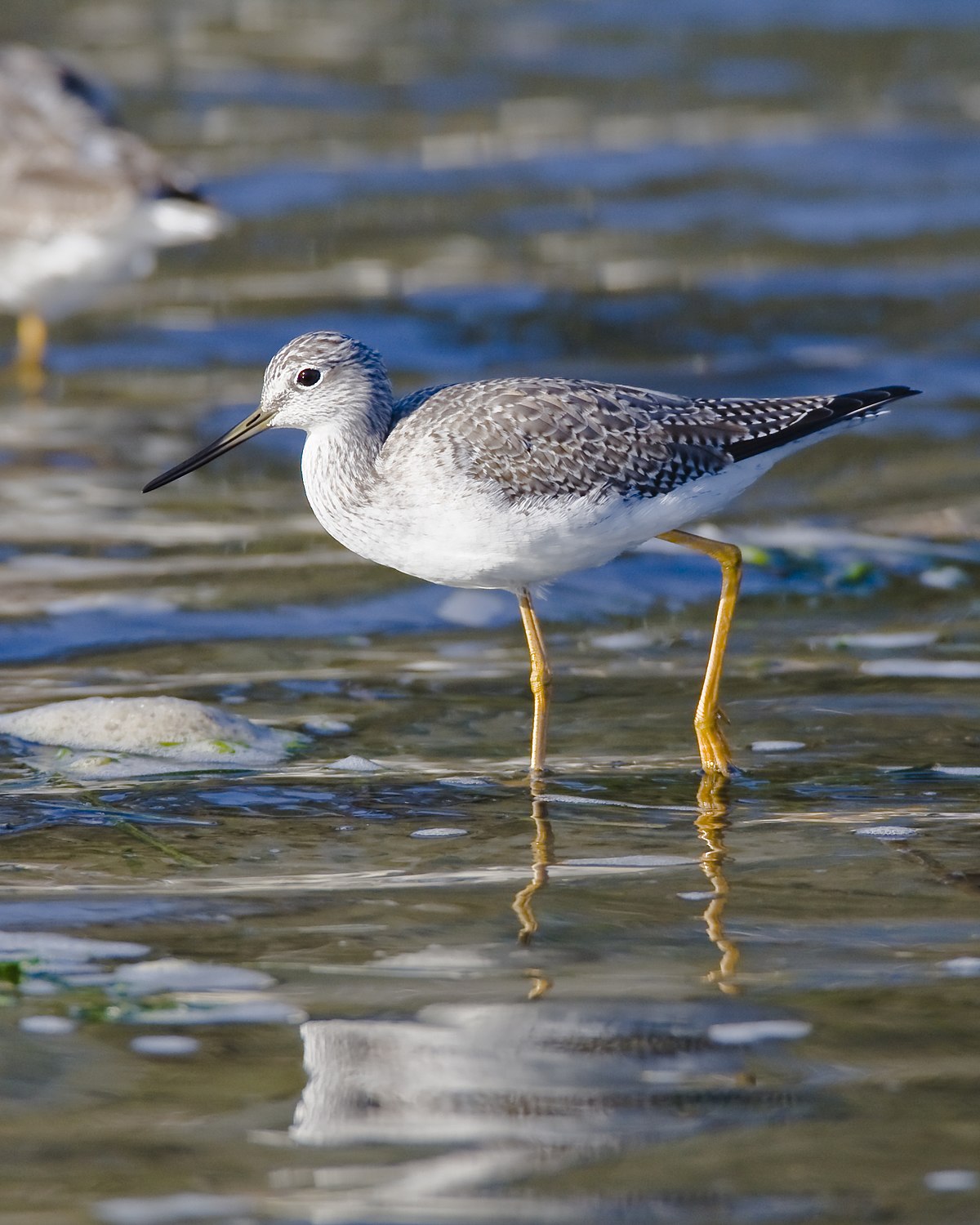
Wikipedia: Greater yellowlegs Source: OTHER
1200px-Greater_Yellowlegs2.jpg
![]() Totanus melanoleucus
[more]
Totanus melanoleucus
[more]
Terek sandpiper / Terekwasserläufer (Xenus cinereus)
Profile Wikipedia eBird Audubon AllAboutBirds Xeno-Canto NABU

Wikipedia: Terek sandpiper Source: OTHER
Xenus_cinereus_%28Alnus%29.jpg
This bird appears across the great seas in the following continents:
Europe, North America, Africa, Asia.
![]() The Terek sandpiper (Xenus cinereus) is a small migratory Palearctic wader species and is the only member of the genus Xenus. It is named after the Terek River which flows into the west of the Caspian Sea, as it was first observed around this area.[2] The genus name Xenus is from Ancient Greek xenos stranger, and cinereus is Latin for "ash-grey" from cinis, cineris, "ashes".[3]
[more]
The Terek sandpiper (Xenus cinereus) is a small migratory Palearctic wader species and is the only member of the genus Xenus. It is named after the Terek River which flows into the west of the Caspian Sea, as it was first observed around this area.[2] The genus name Xenus is from Ancient Greek xenos stranger, and cinereus is Latin for "ash-grey" from cinis, cineris, "ashes".[3]
[more]
Common sandpiper / Flussuferläufer (Actitis hypoleucos)
MerlinBirdID meint Flussuferläufer. 2022-09-04 07.49.06 Neeracherried
First observed in 🇨🇭 on 2022-09-04.
This bird appears across the great seas in the following continents:
Europe, North America, Africa, Asia.
![]() The common sandpiper (Actitis hypoleucos) is a small Palearctic wader. This bird and its American sister species, the spotted sandpiper (A. macularia), make up the genus Actitis. They are parapatric and replace each other geographically; stray birds of either species may settle down with breeders of the other and hybridize. Hybridization has also been reported between the common sandpiper and the green sandpiper, a basal species of the closely related shank genus Tringa.
[more]
The common sandpiper (Actitis hypoleucos) is a small Palearctic wader. This bird and its American sister species, the spotted sandpiper (A. macularia), make up the genus Actitis. They are parapatric and replace each other geographically; stray birds of either species may settle down with breeders of the other and hybridize. Hybridization has also been reported between the common sandpiper and the green sandpiper, a basal species of the closely related shank genus Tringa.
[more]
Calls: ![]() Very vocal with characteristic repertoire of very high-pitched calls. Often heard is a disyllabic call, drawn out and slightly rising in pitch in the second part. This is often repeated in a series of rising tones in a cyclic manner, with approx 5 tones in each cycle. [Link]
Very vocal with characteristic repertoire of very high-pitched calls. Often heard is a disyllabic call, drawn out and slightly rising in pitch in the second part. This is often repeated in a series of rising tones in a cyclic manner, with approx 5 tones in each cycle. [Link]
Physical details: length=19-21 cm,
wingspan=38-41 cm,
weight=40-60 g
Habitats:
Wetland
Spotted sandpiper / Drosseluferläufer (Actitis macularius)
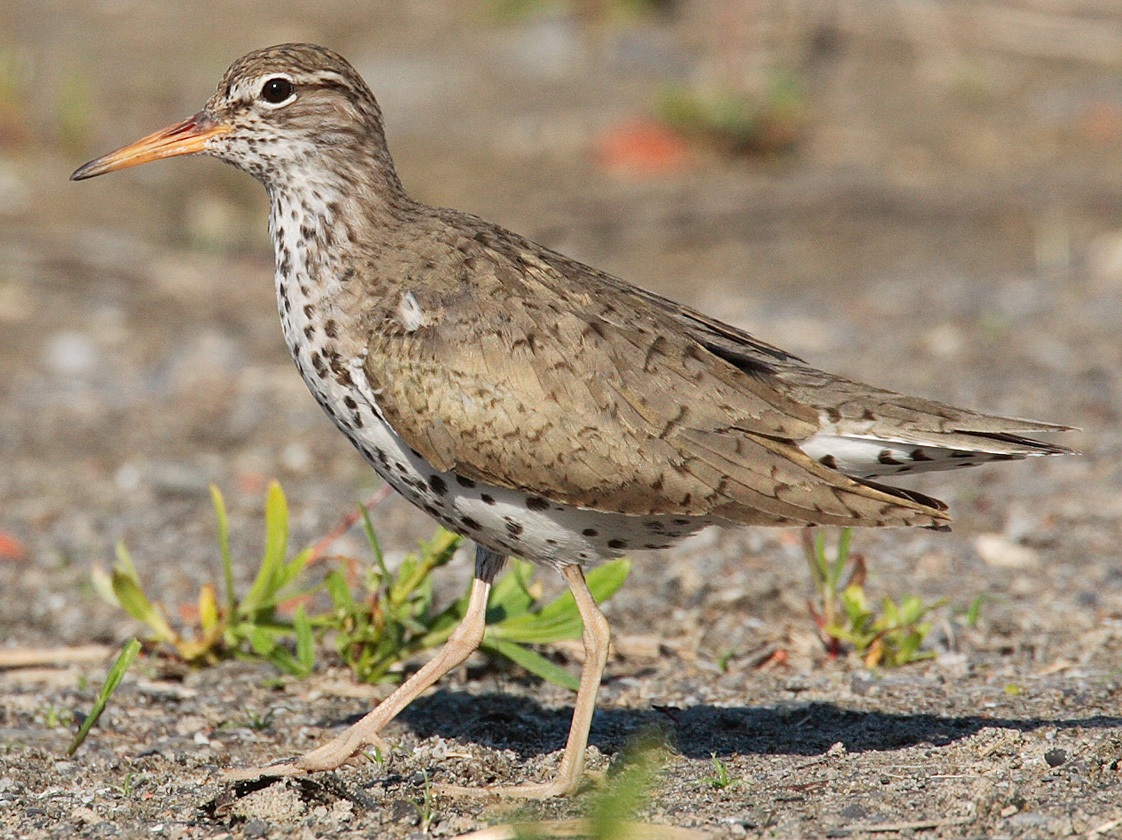
Wikipedia: Spotted sandpiper Source: OTHER
Actitis-macularia-005.jpg
General: ![]() The spotted sandpiper (Actitis macularius) is a small shorebird. The genus name Actitis is from Ancient Greek aktites, "coast-dweller", derived from akte, "coast", and macularius is Latin from macula, "spot".[2]
[more]
The spotted sandpiper (Actitis macularius) is a small shorebird. The genus name Actitis is from Ancient Greek aktites, "coast-dweller", derived from akte, "coast", and macularius is Latin from macula, "spot".[2]
[more]
Red phalarope / Thorshühnchen (Phalaropus fulicarius)

Wikipedia: Red phalarope Source: OTHER
1200px-Phalaropus_fulicarius_10.jpg
This bird appears across the great seas in the following continents:
Europe, North America, South America, Africa.
![]() The red phalarope or grey phalarope (Phalaropus fulicarius) is a small wader. This phalarope breeds in the Arctic regions of North America and Eurasia. It is migratory, and, unusually for a wader, migrating mainly on oceanic routes and wintering at sea on tropical oceans.
[more]
The red phalarope or grey phalarope (Phalaropus fulicarius) is a small wader. This phalarope breeds in the Arctic regions of North America and Eurasia. It is migratory, and, unusually for a wader, migrating mainly on oceanic routes and wintering at sea on tropical oceans.
[more]
Calls: ![]() Flight-call a short and sharp, Coot-like "kit". Cleaner and higher pitched than Red-necked Phalarope. Display sound a rolling cooing, at stable pitch. Other calls: a hissing like the squeezing of a rubber duck, rising quickly in pitch and ending abruptly. [Link]
Flight-call a short and sharp, Coot-like "kit". Cleaner and higher pitched than Red-necked Phalarope. Display sound a rolling cooing, at stable pitch. Other calls: a hissing like the squeezing of a rubber duck, rising quickly in pitch and ending abruptly. [Link]
Physical details: length=20-22 cm,
wingspan=40-44 cm,
weight=40-75 g
Wilson's phalarope / Wilson-Wassertreter (Phalaropus tricolor)
Profile Wikipedia eBird Audubon AllAboutBirds Xeno-Canto
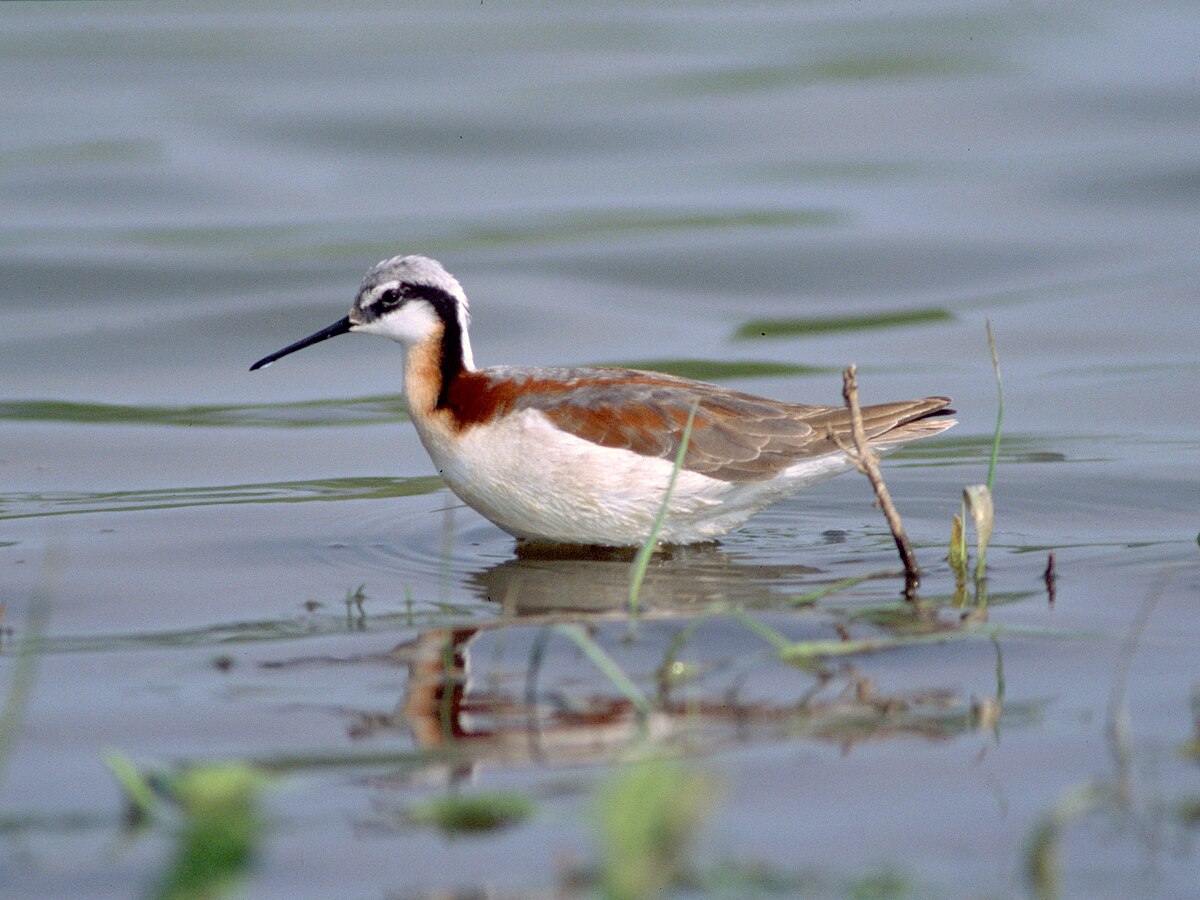
Wikipedia: Wilson's phalarope Source: OTHER
1200px-Phalaropus_tricolor_-_breeding_female.jpg
This bird appears across the great seas in the following continents:
North America, South America, Africa.
General: ![]() Wilson's phalarope (Phalaropus tricolor) is a small wader. This bird, the largest of the phalaropes, breeds in the prairies of North America in western Canada and the western United States. It is migratory, wintering in inland salt lakes near the Andes in Argentina.[2] They are passage migrants through Central America around March/April and again during September/October.[3] The species is a rare vagrant to western Europe.
[more]
Wilson's phalarope (Phalaropus tricolor) is a small wader. This bird, the largest of the phalaropes, breeds in the prairies of North America in western Canada and the western United States. It is migratory, wintering in inland salt lakes near the Andes in Argentina.[2] They are passage migrants through Central America around March/April and again during September/October.[3] The species is a rare vagrant to western Europe.
[more]
Red-necked phalarope / Odinshühnchen (Phalaropus lobatus)
Profile Wikipedia eBird Audubon AllAboutBirds Xeno-Canto NABU
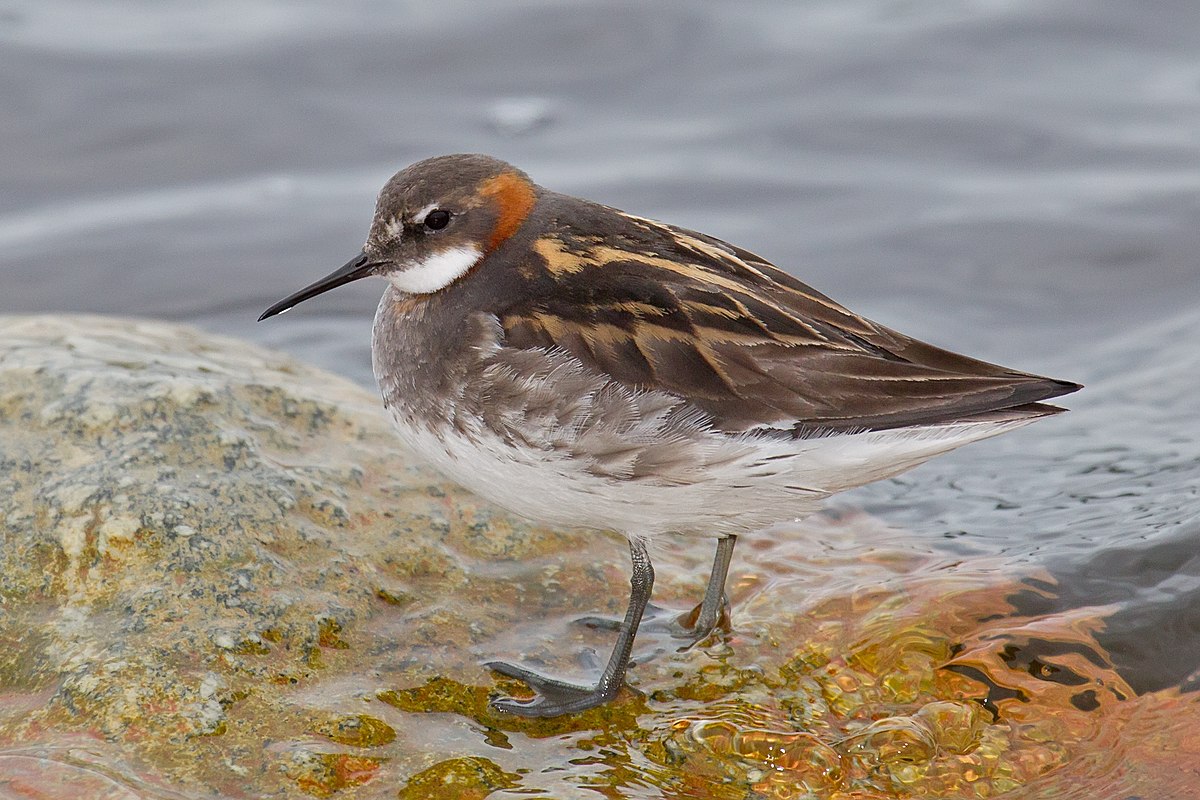
Wikipedia: Red-necked phalarope Source: OTHER
1200px-Red-necked_Phalarope.jpg
This bird appears across the great seas in the following continents:
Europe, North America, South America, Africa, Asia.
![]() The red-necked phalarope (Phalaropus lobatus), also known as the northern phalarope and hyperborean phalarope,[2] is a small wader. This phalarope breeds in the Arctic regions of North America and Eurasia. It is migratory, and, unusually for a wader, winters at sea on tropical oceans.
[more]
The red-necked phalarope (Phalaropus lobatus), also known as the northern phalarope and hyperborean phalarope,[2] is a small wader. This phalarope breeds in the Arctic regions of North America and Eurasia. It is migratory, and, unusually for a wader, winters at sea on tropical oceans.
[more]
Upland sandpiper / Prärieläufer (Bartramia longicauda)
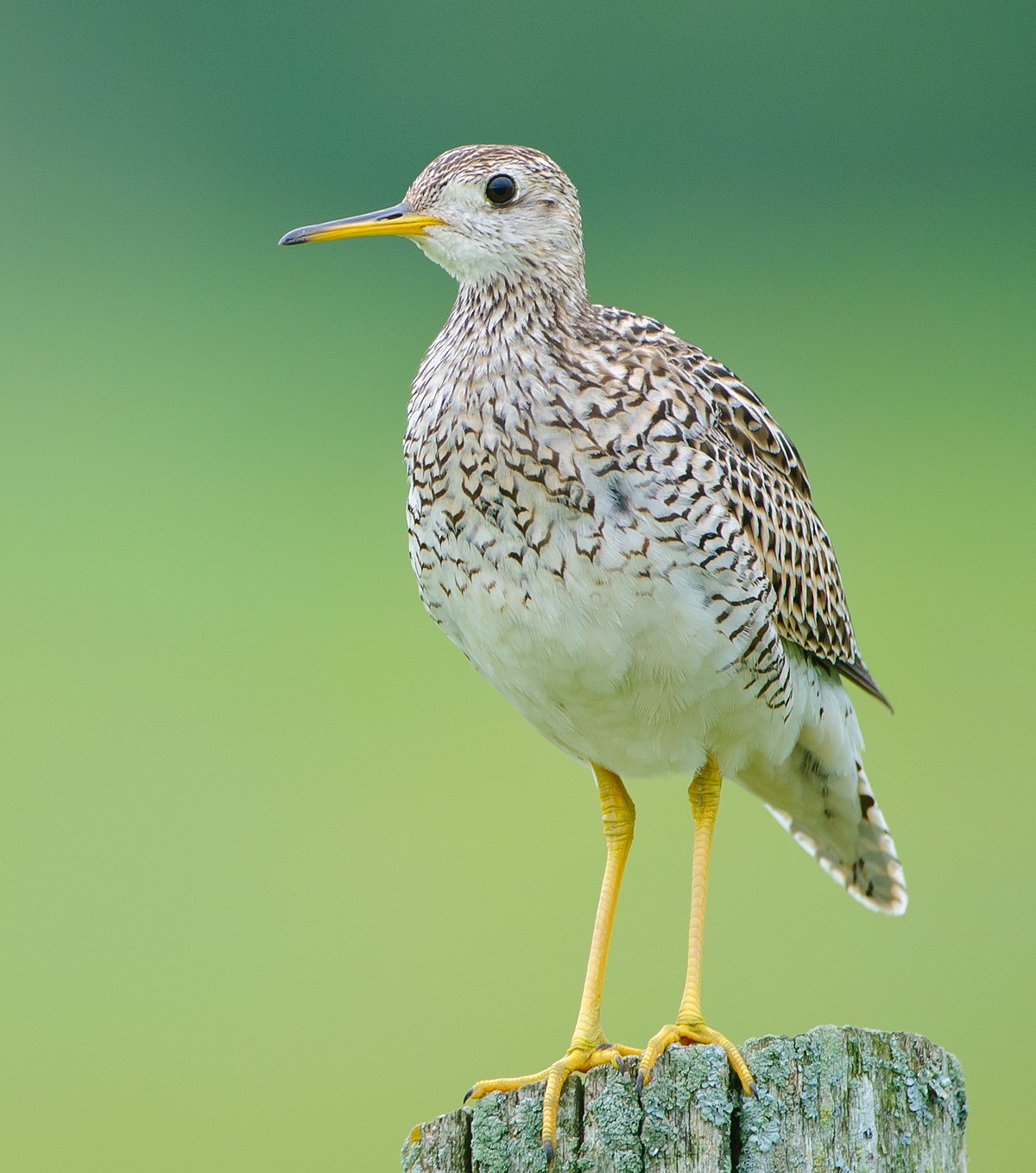
Wikipedia: Upland sandpiper Source: OTHER
1200px-UplandSandpiperOntarioCropped.jpg
This bird appears across the great seas in the following continents:
North America, South America, Australia.
vagrant
Common tern / Flussseeschwalbe (Sterna hirundo)
Profile Wikipedia eBird Vogelwarte BirdLife ZH ornitho.ch bird-song.ch Audubon AllAboutBirds Xeno-Canto BirdID NABU
First observed in 🇨🇭 on 2020-04-27.
This bird appears across the great seas in the following continents:
Europe, North America, South America, Africa, Asia.
Seasonal Behavior: ![]() Die Flussseeschwalbe (Sterna hirundo) ist eine Vogelart aus der Familie der Seeschwalben (Sternidae).
Sie ist in Mitteleuropa ein verbreiteter, aber nicht sehr häufiger Brut- und Sommervogel.
Während der Zugzeiten können im mitteleuropäischen Raum außerdem viele Durchzügler beobachtet werden. [Link]
Die Flussseeschwalbe (Sterna hirundo) ist eine Vogelart aus der Familie der Seeschwalben (Sternidae).
Sie ist in Mitteleuropa ein verbreiteter, aber nicht sehr häufiger Brut- und Sommervogel.
Während der Zugzeiten können im mitteleuropäischen Raum außerdem viele Durchzügler beobachtet werden. [Link]
Vocalization: ![]() Similar to Arctic Tern but deeper. [Link]
Similar to Arctic Tern but deeper. [Link]
Calls: ![]() Lacks latter's high pitched "tip-tip-tip" call, and the drawn out "kree-aaahh" call falls more distinctly in pitch. [Link]
Lacks latter's high pitched "tip-tip-tip" call, and the drawn out "kree-aaahh" call falls more distinctly in pitch. [Link]
Physical details: length=31-35 cm,
wingspan=77-98 cm,
weight=110-150 g
Habitats:
River and lake
Call:
Automatically generated from Xeno-Canto recording
♫ Source: BirdNet
20200427_140813 birdnet 430 - Common tern.mp3
2020-04-27 14.08.13 Luppmen (song?)
Roseate tern / Rosenseeschwalbe (Sterna dougallii)
Profile Wikipedia eBird Audubon AllAboutBirds Xeno-Canto BirdID NABU

Wikipedia: Roseate tern Source: OTHER
1200px-Roseate_terns_Palometas.jpg
This bird appears across the great seas in the following continents:
Europe, North America, Africa, Asia.
General: ![]() The roseate tern (Sterna dougallii) is a tern in the family Laridae. The genus name Sterna is derived from Old English "stearn", "tern",[2] and the specific dougallii refers to Scottish physician and collector Dr Peter McDougall (1777–1814).[3] "Roseate" refers to the bird's pink breast in breeding plumage.[4]
[more]
The roseate tern (Sterna dougallii) is a tern in the family Laridae. The genus name Sterna is derived from Old English "stearn", "tern",[2] and the specific dougallii refers to Scottish physician and collector Dr Peter McDougall (1777–1814).[3] "Roseate" refers to the bird's pink breast in breeding plumage.[4]
[more]
Calls: ![]() Extremely harsh calls. Like mix of Caspian and Arctic Tern. Very hard and raspy "kreeeet", harder and higher pitched than Caspian Tern, but equally harsh. Other calls include more Arctic/Common tern-like short "kek", and similar. [Link]
Extremely harsh calls. Like mix of Caspian and Arctic Tern. Very hard and raspy "kreeeet", harder and higher pitched than Caspian Tern, but equally harsh. Other calls include more Arctic/Common tern-like short "kek", and similar. [Link]
Physical details: length=33-38 cm,
wingspan=72-80 cm,
weight=92-133 g
Arctic tern / Kü̈stenseeschwalbe (Sterna paradisaea)
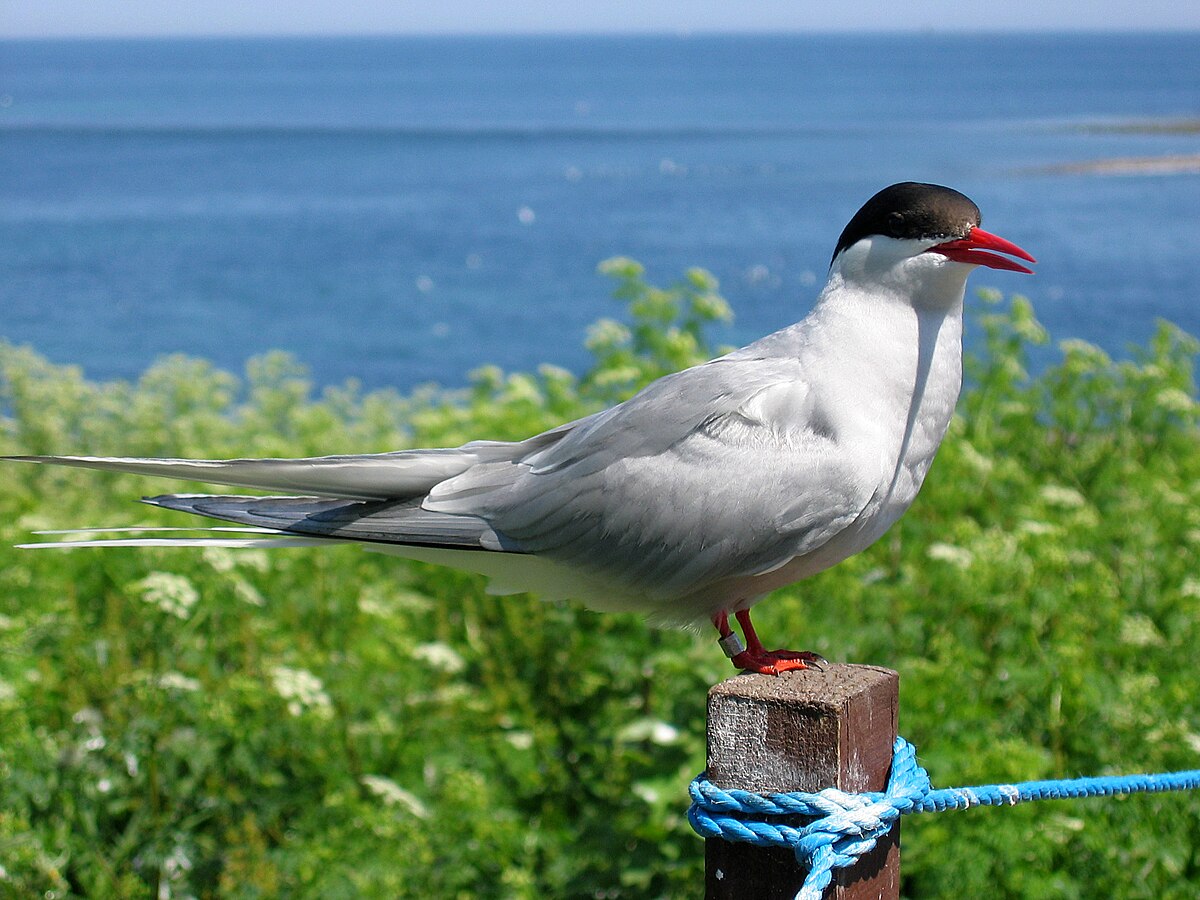
Wikipedia: Arctic tern Source: OTHER
1200px-2009_07_02_-_Arctic_tern_on_Farne_Islands_-_The_blue_rope_demarcates_the_visitors%27_path.JPG
This bird appears across the great seas in the following continents:
Europe, North America, South America, Africa.
General: ![]() The Arctic tern (Sterna paradisaea) is a tern in the family Laridae. This bird has a circumpolar breeding distribution covering the Arctic and sub-Arctic regions of Europe, Asia, and North America (as far south as Brittany and Massachusetts). The species is strongly migratory, seeing two summers each year as it migrates along a convoluted route from its northern breeding grounds to the Antarctic coast for the southern summer and back again about six months later. Recent studies have shown average annual roundtrip lengths of about 70,900 km (44,100 mi) for birds nesting in Iceland and Greenland[3] and about 90,000 km (56,000 mi) for birds nesting in the Netherlands.[4] These are by far the longest migrations known in the animal kingdom. The Arctic tern flies as well as glides through the air. It nests once every one to three years (depending on its mating cycle); once it has finished nesting it takes to the sky for another long southern migration.
[more]
The Arctic tern (Sterna paradisaea) is a tern in the family Laridae. This bird has a circumpolar breeding distribution covering the Arctic and sub-Arctic regions of Europe, Asia, and North America (as far south as Brittany and Massachusetts). The species is strongly migratory, seeing two summers each year as it migrates along a convoluted route from its northern breeding grounds to the Antarctic coast for the southern summer and back again about six months later. Recent studies have shown average annual roundtrip lengths of about 70,900 km (44,100 mi) for birds nesting in Iceland and Greenland[3] and about 90,000 km (56,000 mi) for birds nesting in the Netherlands.[4] These are by far the longest migrations known in the animal kingdom. The Arctic tern flies as well as glides through the air. It nests once every one to three years (depending on its mating cycle); once it has finished nesting it takes to the sky for another long southern migration.
[more]
Vocalization: ![]() Similar to Common Tern but higher pitched. [Link]
Similar to Common Tern but higher pitched. [Link]
Calls: ![]() Typical call a series of high pitched "tip-tip-tip", and longer, ringing, high-pitched "kriiiiii" calls. The drawn out "kree-aaahh" call falls less distinctly in pitch than Common Tern. [Link]
Typical call a series of high pitched "tip-tip-tip", and longer, ringing, high-pitched "kriiiiii" calls. The drawn out "kree-aaahh" call falls less distinctly in pitch than Common Tern. [Link]
Physical details: length=33-35 cm,
wingspan=75-85 cm,
weight=95-120 g
Forster's tern (Sterna forsteri)
Profile Wikipedia eBird Audubon AllAboutBirds Xeno-Canto

Wikipedia: Forster's tern Source: OTHER
1200px-Forster%27s_Tern.jpg
General: ![]() Forster's tern (Sterna forsteri) is a tern in the family Laridae. The genus name Sterna is derived from Old English "stearn", "tern",[2] and forsteri commemorates the naturalist Johann Reinhold Forster.[3]
[more]
Forster's tern (Sterna forsteri) is a tern in the family Laridae. The genus name Sterna is derived from Old English "stearn", "tern",[2] and forsteri commemorates the naturalist Johann Reinhold Forster.[3]
[more]
Common murre / Trottellumme (Uria aalge)

Wikipedia: Common murre Source: OTHER
1200px-Guillemots_on_Bear_Island_Svalbard_Arctic_%2819659642914%29.jpg
This bird appears across the great seas in the following continents:
Europe, North America, Africa.
Deutschland: Brut-, Jahres-, Zugvogel, Wintergast RL R
Vocalization: ![]() Very coarse and deep voice. [Link]
Very coarse and deep voice. [Link]
Calls: ![]() Typically rising in pitch, then ending on a prolonged stable note with a laughing quality. Sometimes only the coarse beginning uttered like "ga-ga-ga". [Link]
Typically rising in pitch, then ending on a prolonged stable note with a laughing quality. Sometimes only the coarse beginning uttered like "ga-ga-ga". [Link]
Physical details: length=38-41 cm,
wingspan=64-70 cm,
weight=490-863 g
Thick-billed guillemot / Dickschnabellumme (Uria lomvia)

Wikipedia: Thick-billed guillemot Source: OTHER
Uria_lomvia1.jpg
This bird appears across the great seas in the following continents:
Europe, North America.
General: ![]() The thick-billed murre or Brünnich's guillemot (Uria lomvia) is a bird in the auk family (Alcidae). This bird is named after the Danish zoologist Morten Thrane Brünnich. The very deeply black North Pacific subspecies Uria lomvia arra is also called Pallas' murre after its describer. The genus name is from Ancient Greek ouria, a waterbird mentioned by Athenaeus. The species term lomvia is a Swedish word for an auk or diver.[2] The English "guillemot" is from French guillemot probably derived from Guillaume, "William".[3] "Murre" is of uncertain origins, but may imitate the call of the common guillemot.[4]
[more]
The thick-billed murre or Brünnich's guillemot (Uria lomvia) is a bird in the auk family (Alcidae). This bird is named after the Danish zoologist Morten Thrane Brünnich. The very deeply black North Pacific subspecies Uria lomvia arra is also called Pallas' murre after its describer. The genus name is from Ancient Greek ouria, a waterbird mentioned by Athenaeus. The species term lomvia is a Swedish word for an auk or diver.[2] The English "guillemot" is from French guillemot probably derived from Guillaume, "William".[3] "Murre" is of uncertain origins, but may imitate the call of the common guillemot.[4]
[more]
Least auklet (Aethia pusilla)

Wikipedia: Least auklet Source: OTHER
Leastauklet6.jpg
![]() The least auklet (Aethia pusilla) is a seabird and the smallest species of auk. It is the most abundant seabird in North America, and one of the most abundant in the world, with a population of around nine million birds. They breed on the islands of Alaska and Siberia, and spend the winter close to the edge of the ice sheet[clarification needed]. Their largest colonies are on the Aleutian Islands, St. Lawrence Island and Little Diomede Island.
[more]
The least auklet (Aethia pusilla) is a seabird and the smallest species of auk. It is the most abundant seabird in North America, and one of the most abundant in the world, with a population of around nine million birds. They breed on the islands of Alaska and Siberia, and spend the winter close to the edge of the ice sheet[clarification needed]. Their largest colonies are on the Aleutian Islands, St. Lawrence Island and Little Diomede Island.
[more]
Crested auklet (Aethia cristatella)

Wikipedia: Crested auklet Source: OTHER
1200px-Aethia_cristatella.jpg
![]() The crested auklet (Aethia cristatella) is a small seabird of the family Alcidae, distributed throughout the northern Pacific and the Bering Sea. The species feeds by diving in deep waters, eating krill and a variety of small marine animals. It nests in dense colonies of up to 1 million individuals in the Bering Sea and the Sea of Okhotsk. It often breeds in mixed-species colonies with the least auklet, a smaller congener.
[more]
The crested auklet (Aethia cristatella) is a small seabird of the family Alcidae, distributed throughout the northern Pacific and the Bering Sea. The species feeds by diving in deep waters, eating krill and a variety of small marine animals. It nests in dense colonies of up to 1 million individuals in the Bering Sea and the Sea of Okhotsk. It often breeds in mixed-species colonies with the least auklet, a smaller congener.
[more]
Whiskered auklet / Bartalk (Aethia pygmaea)

Wikipedia: Whiskered auklet Source: OTHER
Whiskered_Auklet.jpg
![]() The whiskered auklet (Aethia pygmaea) is a small seabird of the auk family. It has a more restricted range than other members of its genus, Aethia, living only around the Aleutian Islands and on some islands off Siberia (like Commander Islands), and breeding on these islands. It is one of the smallest alcids, only the closely related least auklet being smaller. Its name is derived from the long white feathers on its face that are part of its breeding plumage.
[more]
The whiskered auklet (Aethia pygmaea) is a small seabird of the auk family. It has a more restricted range than other members of its genus, Aethia, living only around the Aleutian Islands and on some islands off Siberia (like Commander Islands), and breeding on these islands. It is one of the smallest alcids, only the closely related least auklet being smaller. Its name is derived from the long white feathers on its face that are part of its breeding plumage.
[more]
Parakeet auklet / Rotschnabelalk (Aethia psittacula)
Profile Wikipedia eBird Audubon AllAboutBirds Xeno-Canto

Wikipedia: Parakeet auklet Source: OTHER
1200px-Parakeetauklets2.jpg
![]() The parakeet auklet (Aethia psittacula) is a small seabird of the North Pacific. Parakeet Auklets used to be placed on its own in the genus Cyclorrhynchus (Kaup, 1829) but recent morphological and genetic evidence suggest it should be placed in the genus Aethia, making them closely related to crested auklets and least auklets. It is associated with the boreal waters of Alaska, Kamchatka and Siberia. It breeds on the cliffs, slopes and boulder fields of offshore islands, generally moving south during the winter.
[more]
The parakeet auklet (Aethia psittacula) is a small seabird of the North Pacific. Parakeet Auklets used to be placed on its own in the genus Cyclorrhynchus (Kaup, 1829) but recent morphological and genetic evidence suggest it should be placed in the genus Aethia, making them closely related to crested auklets and least auklets. It is associated with the boreal waters of Alaska, Kamchatka and Siberia. It breeds on the cliffs, slopes and boulder fields of offshore islands, generally moving south during the winter.
[more]
Razorbill / Tordalk (Alca torda)
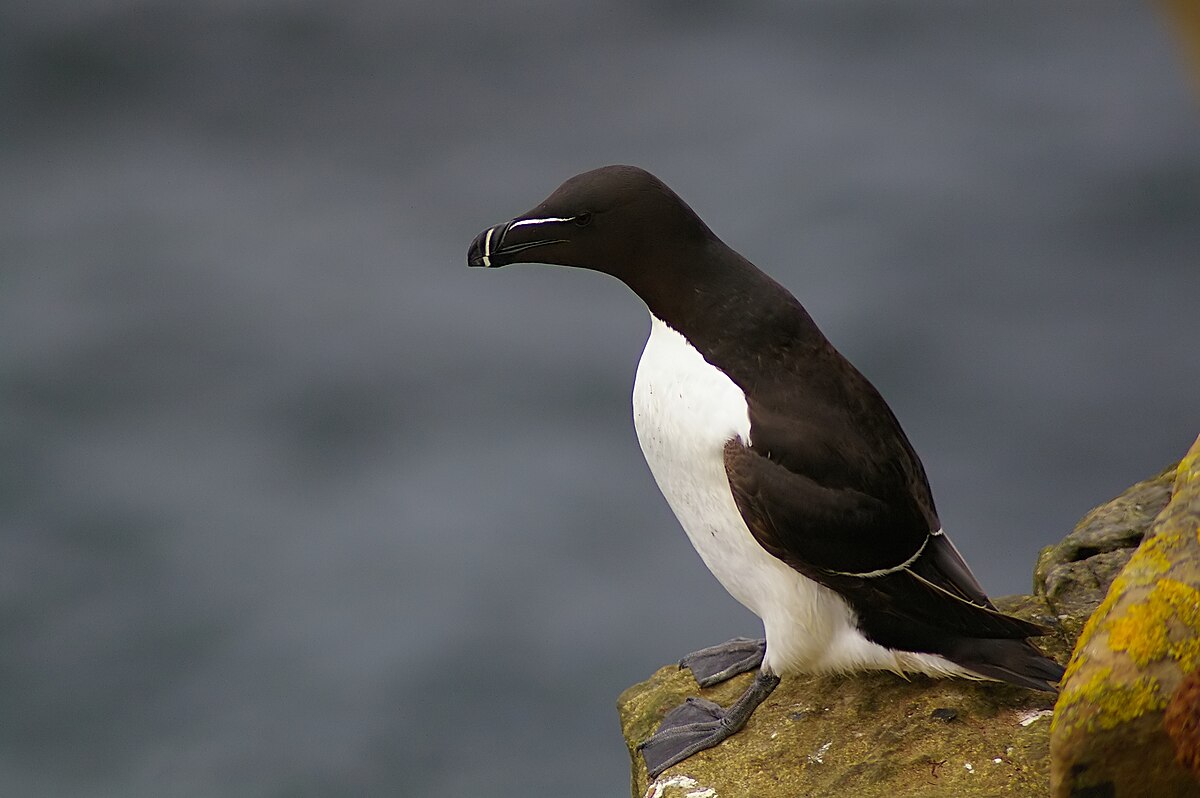
Wikipedia: Razorbill Source: OTHER
1200px-Alca_torda_Caithness%2C_Scotland.jpg
This bird appears across the great seas in the following continents:
Europe, North America, Africa.
Deutschland: Brut-, Jahresvogel, Wintergast RL R
Vocalization: ![]() Very coarse and deep voice. Grunting or snore-like, with little phrasing. Mostly heard at breeding ground, but also sometimes at sea. [Link]
Very coarse and deep voice. Grunting or snore-like, with little phrasing. Mostly heard at breeding ground, but also sometimes at sea. [Link]
Physical details: length=37-39 cm,
wingspan=63-68 cm,
weight=524-890 g
Dovekie / Krabbentaucher (Alle alle)

Wikipedia: Dovekie Source: OTHER
1200px-Little_Auk_%28js%29_24.jpg
This bird appears across the great seas in the following continents:
Europe, North America.
Deutschland: Zugvogel, Wintergast
Vocalization: ![]() Voice higher pitched than other auks (except Black Guillemot). Trilling, rolling and chattering laughter "kreeee he he he he", or shorter, softer utterances; "ke ke" or "hup hup". [Link]
Voice higher pitched than other auks (except Black Guillemot). Trilling, rolling and chattering laughter "kreeee he he he he", or shorter, softer utterances; "ke ke" or "hup hup". [Link]
Physical details: length=17-19 cm,
wingspan=40-48 cm,
weight=140-190 g
Marbled murrelet (Brachyramphus marmoratus)
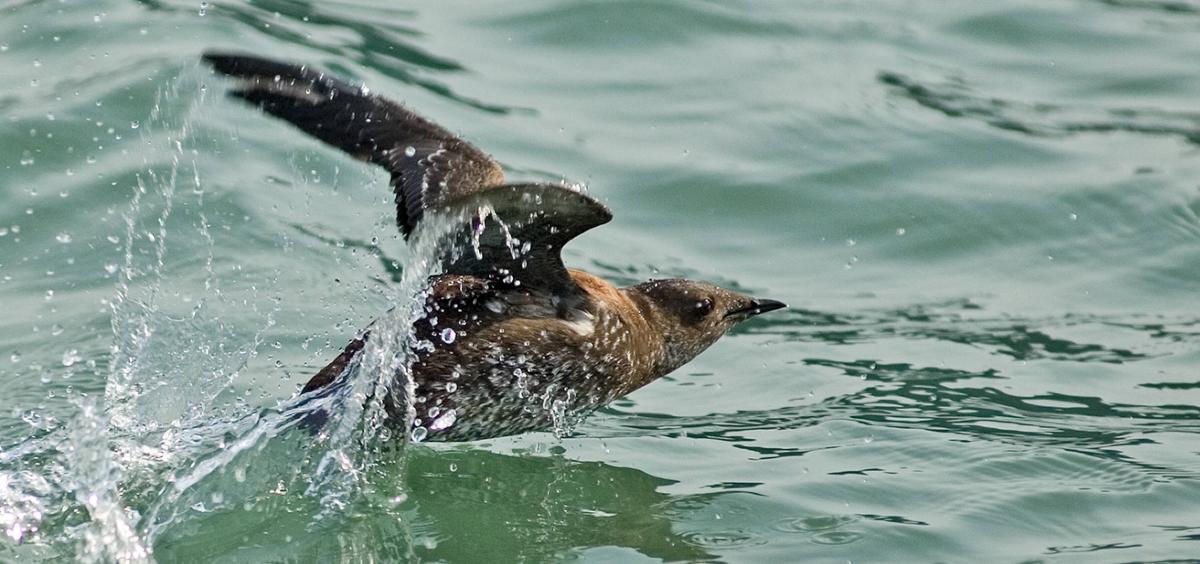
Wikipedia: Marbled murrelet Source: OTHER
Marbled_murrelet.jpg
General: ![]() The marbled murrelet (Brachyramphus marmoratus) is a small seabird from the North Pacific. It is a member of the auk family. It nests in old-growth forests or on the ground at higher latitudes where trees cannot grow. Its habit of nesting in trees was suspected but not documented until a tree-climber found a chick in 1974, making it one of the last North American bird species to have its nest described. The marbled murrelet has declined in number since humans began logging its nest trees in the latter half of the 19th century. The decline of the marbled murrelet and its association with old-growth forests, at least in the southern part of its range, have made it a flagship species in the forest preservation movement. In Canada (north of 50° North Latitude) and Alaska, the declines are not so obvious because populations are much larger and the survey techniques have not had sufficient power to detect changes.
[more]
The marbled murrelet (Brachyramphus marmoratus) is a small seabird from the North Pacific. It is a member of the auk family. It nests in old-growth forests or on the ground at higher latitudes where trees cannot grow. Its habit of nesting in trees was suspected but not documented until a tree-climber found a chick in 1974, making it one of the last North American bird species to have its nest described. The marbled murrelet has declined in number since humans began logging its nest trees in the latter half of the 19th century. The decline of the marbled murrelet and its association with old-growth forests, at least in the southern part of its range, have made it a flagship species in the forest preservation movement. In Canada (north of 50° North Latitude) and Alaska, the declines are not so obvious because populations are much larger and the survey techniques have not had sufficient power to detect changes.
[more]
Black guillemot / Gryllteiste (Cepphus grylle)
Profile Wikipedia eBird Audubon AllAboutBirds Xeno-Canto BirdID NABU

Wikipedia: Black guillemot Source: OTHER
Tystie1.jpg
This bird appears across the great seas in the following continents:
Europe, North America.
Deutschland: seltener Wintergast
Calls: ![]() Call surprisingly high pitched. Quite pure, drawn out, plaintive whistling notes in same pitch range as Hazel Grouse. [Link]
Call surprisingly high pitched. Quite pure, drawn out, plaintive whistling notes in same pitch range as Hazel Grouse. [Link]
Physical details: length=30-32 cm,
wingspan=52-58 cm,
weight=340-500 g
Pigeon guillemot / Taubenteiste (Cepphus columba)
Profile Wikipedia eBird Audubon AllAboutBirds Xeno-Canto NABU

Wikipedia: Pigeon guillemot Source: OTHER
1200px-Pigeon_guillemot.jpg
This bird appears across the great seas in the following continents:
Europe, North America.
General: ![]() The pigeon guillemot (Cepphus columba) (/ˈɡɪlɪmɒt/) is a species of bird in the auk family, Alcidae. One of three species in the genus Cepphus, it is most closely related to the spectacled guillemot. There are five subspecies of the pigeon guillemot; all subspecies, when in breeding plumage, are dark brown with a black iridescent sheen and a distinctive wing patch broken by a brown-black wedge. Its non-breeding plumage has mottled grey and black upperparts and white underparts. The long bill is black, as are the claws. The legs, feet, and inside of the mouth are red. It closely resembles the black guillemot, which is slightly smaller and lacks the dark wing wedge present in the pigeon guillemot. Combined, the two form a superspecies.
[more]
The pigeon guillemot (Cepphus columba) (/ˈɡɪlɪmɒt/) is a species of bird in the auk family, Alcidae. One of three species in the genus Cepphus, it is most closely related to the spectacled guillemot. There are five subspecies of the pigeon guillemot; all subspecies, when in breeding plumage, are dark brown with a black iridescent sheen and a distinctive wing patch broken by a brown-black wedge. Its non-breeding plumage has mottled grey and black upperparts and white underparts. The long bill is black, as are the claws. The legs, feet, and inside of the mouth are red. It closely resembles the black guillemot, which is slightly smaller and lacks the dark wing wedge present in the pigeon guillemot. Combined, the two form a superspecies.
[more]
Atlantic puffin (Fratercula arctica)
Profile Wikipedia eBird Audubon AllAboutBirds Xeno-Canto BirdID NABU

Wikipedia: Atlantic puffin Source: OTHER
1200px-Puffin_%28Fratercula_arctica%29.jpg
This bird appears across the great seas in the following continents:
Europe, North America, Africa.
![]() The Atlantic puffin (Fratercula arctica), also known as the common puffin, is a species of seabird in the auk family. It is the only puffin native to the Atlantic Ocean; two related species, the tufted puffin and the horned puffin, are found in the northeastern Pacific. The Atlantic puffin breeds in Québec, Iceland, Norway, Greenland, Newfoundland and Labrador, Nova Scotia and the Faroe Islands, and as far south as Maine in the west and France in the east. The Atlantic Puffin is most commonly found on the Westman Islands, Iceland. Although it has a large population and a wide range, the species has declined rapidly, at least in parts of its range, resulting in it being rated as vulnerable by the IUCN. On land, it has the typical upright stance of an auk. At sea, it swims on the surface and feeds mainly on small fish, which it catches by diving under water, using its wings for propulsion.
[more]
The Atlantic puffin (Fratercula arctica), also known as the common puffin, is a species of seabird in the auk family. It is the only puffin native to the Atlantic Ocean; two related species, the tufted puffin and the horned puffin, are found in the northeastern Pacific. The Atlantic puffin breeds in Québec, Iceland, Norway, Greenland, Newfoundland and Labrador, Nova Scotia and the Faroe Islands, and as far south as Maine in the west and France in the east. The Atlantic Puffin is most commonly found on the Westman Islands, Iceland. Although it has a large population and a wide range, the species has declined rapidly, at least in parts of its range, resulting in it being rated as vulnerable by the IUCN. On land, it has the typical upright stance of an auk. At sea, it swims on the surface and feeds mainly on small fish, which it catches by diving under water, using its wings for propulsion.
[more]
Vocalization: ![]() Deep, but not so coarse as Razorbill. Smoother and more gliding changes in pitch, like a "slow-motion" laugh or distant chainsaw; "aaaahrrr, aahr, ahr arh". [Link]
Deep, but not so coarse as Razorbill. Smoother and more gliding changes in pitch, like a "slow-motion" laugh or distant chainsaw; "aaaahrrr, aahr, ahr arh". [Link]
Physical details: length=26-29 cm,
wingspan=47-63 cm,
weight=320-480 g
Tufted puffin (Fratercula cirrhata)

Wikipedia: Tufted puffin Source: OTHER
Tufted_Puffin_Alaska_%28cropped%29.jpg
General: ![]() The tufted puffin (Fratercula cirrhata), also known as crested puffin, is a relatively abundant medium-sized pelagic seabird in the auk family (Alcidae) found throughout the North Pacific Ocean.
It is one of three species of puffin that make up the genus Fratercula and is easily recognizable by its thick red bill and yellow tufts.
[more]
The tufted puffin (Fratercula cirrhata), also known as crested puffin, is a relatively abundant medium-sized pelagic seabird in the auk family (Alcidae) found throughout the North Pacific Ocean.
It is one of three species of puffin that make up the genus Fratercula and is easily recognizable by its thick red bill and yellow tufts.
[more]
Horned puffin / Hornlund (Fratercula corniculata)
Profile Wikipedia eBird Audubon AllAboutBirds Xeno-Canto

Wikipedia: Horned puffin Source: OTHER
Fratercula_corniculataUSFWSSL0002774.jpg
![]() The horned puffin (Fratercula corniculata) is an auk found in the North Pacific Ocean, including the coasts of Alaska, Siberia and British Columbia. It is a pelagic seabird that feeds primarily by diving for fish. It nests in colonies, often with other auks.
[more]
The horned puffin (Fratercula corniculata) is an auk found in the North Pacific Ocean, including the coasts of Alaska, Siberia and British Columbia. It is a pelagic seabird that feeds primarily by diving for fish. It nests in colonies, often with other auks.
[more]
Cassin's auklet / Aleutenalk (Ptychoramphus aleuticus)
Profile Wikipedia eBird Audubon AllAboutBirds Xeno-Canto

Wikipedia: Cassin's auklet Source: OTHER
1200px-Cassins_Auklet.jpg
![]() Cassin's auklet (Ptychoramphus aleuticus) is a small, chunky seabird that ranges widely in the North Pacific. It nests in small burrows and because of its presence on well studied islands in British Columbia and off California it is one of the better known auks. It is named for the American ornithologist John Cassin.
[more]
Cassin's auklet (Ptychoramphus aleuticus) is a small, chunky seabird that ranges widely in the North Pacific. It nests in small burrows and because of its presence on well studied islands in British Columbia and off California it is one of the better known auks. It is named for the American ornithologist John Cassin.
[more]
Craveri's murrelet / Craverialk (Synthliboramphus craveri)
Profile Wikipedia eBird Audubon AllAboutBirds Xeno-Canto

Wikipedia: Craveri's murrelet Source: OTHER
1200px-Alcidae_-_Synthliboramphus_craveri.JPG
![]() Craveri's murrelet (Synthliboramphus craveri) is a small seabird which breeds on offshore islands in both the Pacific Ocean and the Gulf of California off the Baja peninsula of Mexico. It also wanders fairly regularly as far as central California in the US, primarily during post-breeding dispersal. It is threatened by predators introduced to its breeding colonies, by oil spills, and by tanker traffic. Increasing tourism development and commercial fishing fleets also further threaten the species. With an estimated population of 6,000-10,000 breeding pairs, its population is listed as vulnerable.
[more]
Craveri's murrelet (Synthliboramphus craveri) is a small seabird which breeds on offshore islands in both the Pacific Ocean and the Gulf of California off the Baja peninsula of Mexico. It also wanders fairly regularly as far as central California in the US, primarily during post-breeding dispersal. It is threatened by predators introduced to its breeding colonies, by oil spills, and by tanker traffic. Increasing tourism development and commercial fishing fleets also further threaten the species. With an estimated population of 6,000-10,000 breeding pairs, its population is listed as vulnerable.
[more]
Ancient murrelet / Silberalk (Synthliboramphus antiquus)
Profile Wikipedia eBird Audubon AllAboutBirds Xeno-Canto

Wikipedia: Ancient murrelet Source: OTHER
1200px-Ancient_Murrelet_-_Semiahmoo_Spit.jpg
![]() The ancient murrelet (Synthliboramphus antiquus) is a bird in the auk family. The genus name Synthliboramphus is from Ancient Greek sunthlibo, "to compress", and rhamphos, "bill", and antiquus is Latin for ancient.[2] The English term "murrelet" is a diminutive of "murre", a word of uncertain origins, but which may imitate the call of the common guillemot.[3][4] Ancient murrelets are called "ancient" because they have grey on the back like a shawl, as worn by the elderly.[5]
[more]
The ancient murrelet (Synthliboramphus antiquus) is a bird in the auk family. The genus name Synthliboramphus is from Ancient Greek sunthlibo, "to compress", and rhamphos, "bill", and antiquus is Latin for ancient.[2] The English term "murrelet" is a diminutive of "murre", a word of uncertain origins, but which may imitate the call of the common guillemot.[3][4] Ancient murrelets are called "ancient" because they have grey on the back like a shawl, as worn by the elderly.[5]
[more]
Scripps's murrelet (Synthliboramphus scrippsi)
Profile Wikipedia eBird Audubon AllAboutBirds Xeno-Canto
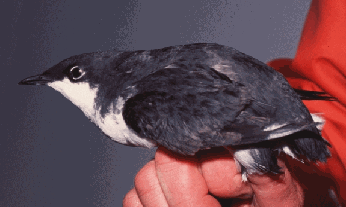
Wikipedia: Scripps's murrelet Source: OTHER
Xantus_adult.gif
![]() Scripps's murrelet (Synthliboramphus scrippsi) is a small seabird found in the California Current system in the Pacific Ocean. This auk breeds on islands off California and Mexico. It is threatened by predators introduced to its breeding colonies and by oil spills.[1]
[more]
Scripps's murrelet (Synthliboramphus scrippsi) is a small seabird found in the California Current system in the Pacific Ocean. This auk breeds on islands off California and Mexico. It is threatened by predators introduced to its breeding colonies and by oil spills.[1]
[more]
Rhinoceros auklet / Nashornalk (Cerorhinca monocerata)
Profile Wikipedia eBird Audubon AllAboutBirds Xeno-Canto
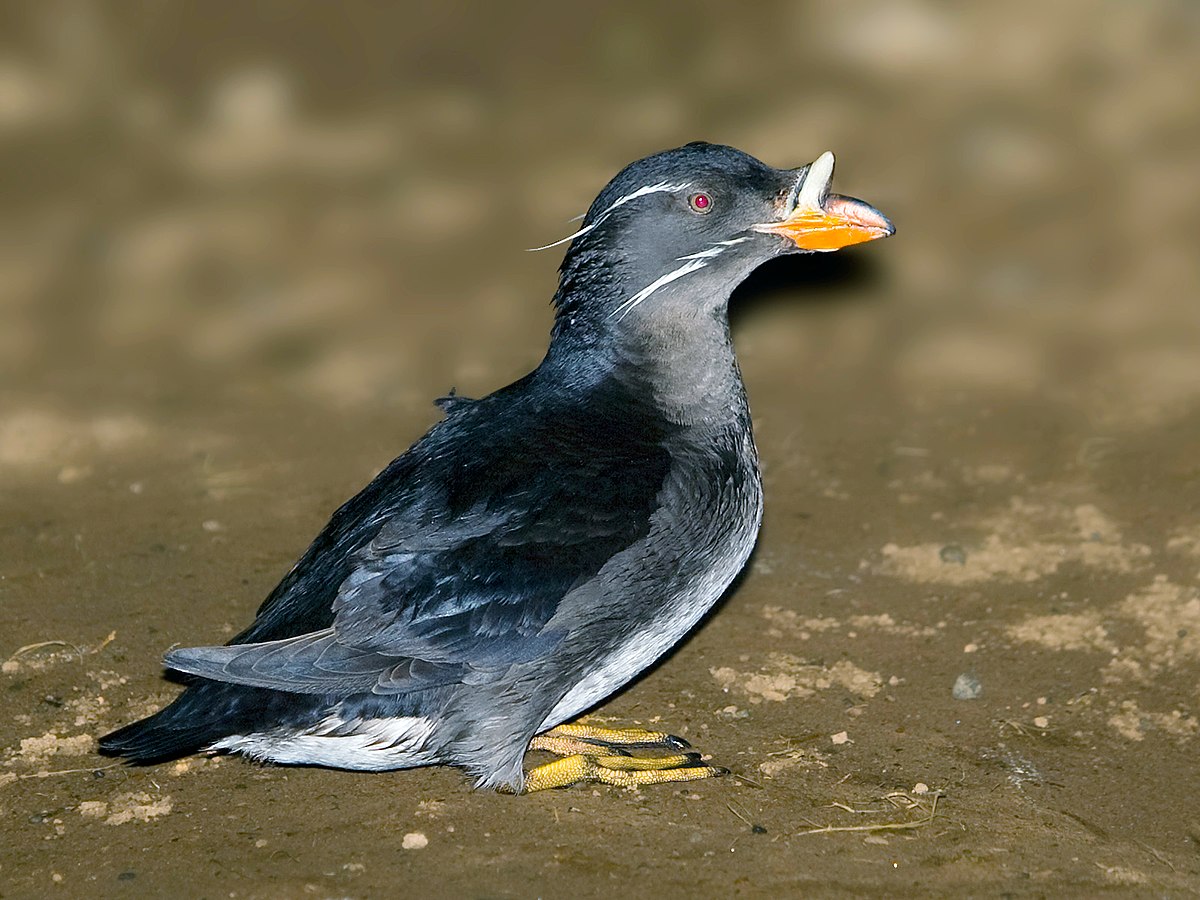
Wikipedia: Rhinoceros auklet Source: OTHER
1200px-Wiki-utou2.jpg
![]() The rhinoceros auklet (Cerorhinca monocerata) is a seabird and a close relative of the puffins. It is the only extant species of the genus Cerorhinca. Given its close relationship with the puffins, the common name rhinoceros puffin has been proposed for the species.[2]
[more]
The rhinoceros auklet (Cerorhinca monocerata) is a seabird and a close relative of the puffins. It is the only extant species of the genus Cerorhinca. Given its close relationship with the puffins, the common name rhinoceros puffin has been proposed for the species.[2]
[more]
American oystercatcher / Braunmantel-Austernfischer (Haematopus palliatus)
Profile Wikipedia eBird Audubon AllAboutBirds Xeno-Canto

Wikipedia: American oystercatcher Source: OTHER
1200px-American_oystercatchers_at_Fort_Tilden_%2860747%29.jpg
![]() The American oystercatcher (Haematopus palliatus), occasionally called the American pied oystercatcher, is a member of family Haematopodidae. Originally called the "sea pie", it was renamed in 1731 when naturalist Mark Catesby observed the bird eating oysters.[2] The current population of American oystercatchers is estimated to be 43,000.[2] There are estimated to be 1,500 breeding pairs along the Atlantic and Gulf Coasts of the US.[3] The bird is marked by its black and white body and a long, thick orange beak.
[more]
The American oystercatcher (Haematopus palliatus), occasionally called the American pied oystercatcher, is a member of family Haematopodidae. Originally called the "sea pie", it was renamed in 1731 when naturalist Mark Catesby observed the bird eating oysters.[2] The current population of American oystercatchers is estimated to be 43,000.[2] There are estimated to be 1,500 breeding pairs along the Atlantic and Gulf Coasts of the US.[3] The bird is marked by its black and white body and a long, thick orange beak.
[more]
Black oystercatcher / Klippen-Austernfischer (Haematopus bachmani)
Profile Wikipedia eBird Audubon AllAboutBirds Xeno-Canto
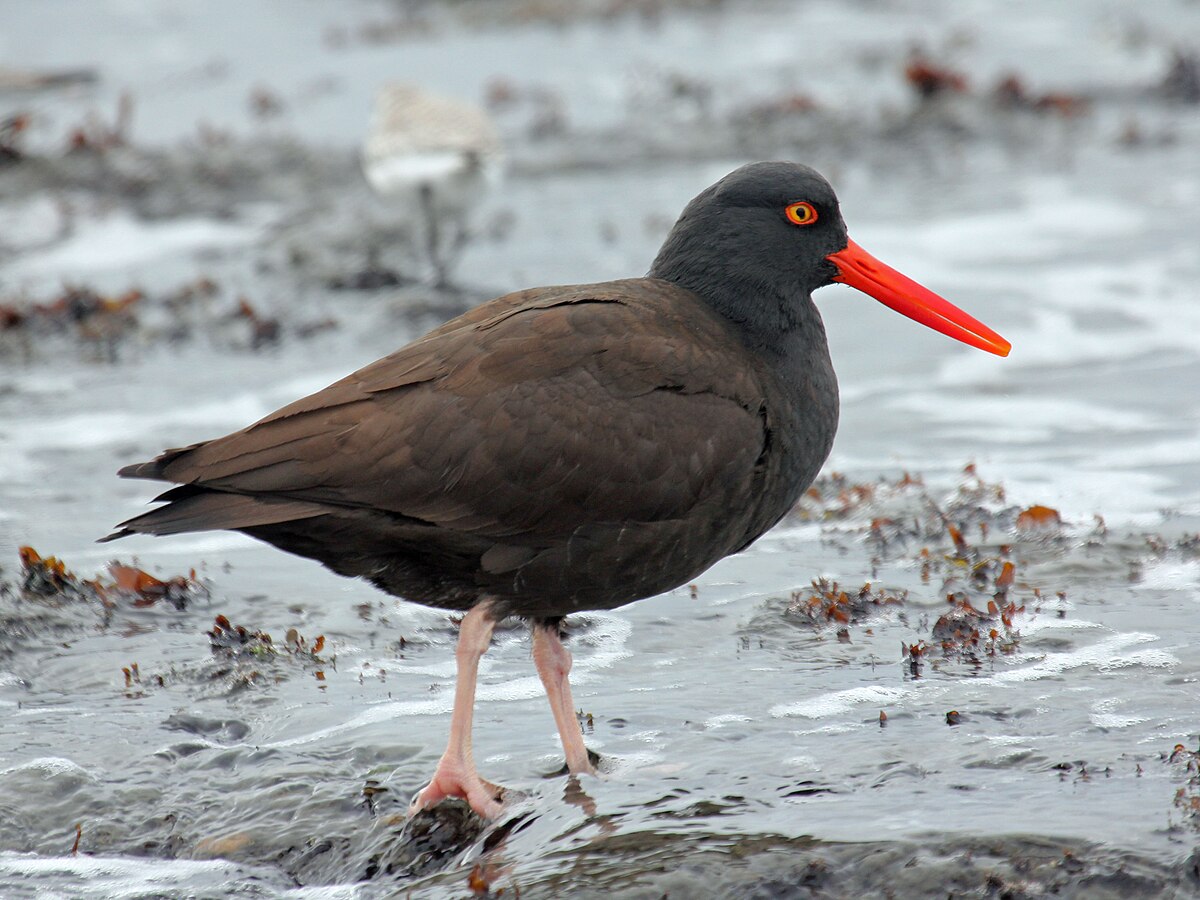
Wikipedia: Black oystercatcher Source: OTHER
1200px-Black_Oystercatcher_HMB_RWD4.jpg
![]() The black oystercatcher (Haematopus bachmani) is a conspicuous black bird found on the shoreline of western North America. It ranges from the Aleutian Islands of Alaska to the coast of the Baja California peninsula.
[more]
The black oystercatcher (Haematopus bachmani) is a conspicuous black bird found on the shoreline of western North America. It ranges from the Aleutian Islands of Alaska to the coast of the Baja California peninsula.
[more]
South polar skua / Südpolarskua (Stercorarius maccormicki)

Wikipedia: South polar skua Source: OTHER
1200px-South_polar_skua.jpg
This bird appears across the great seas in the following continents:
North America, Africa.
![]() The south polar skua (Stercorarius maccormicki) is a large seabird in the skua family, Stercorariidae. An older name for the bird is MacCormick's skua, after explorer and naval surgeon Robert McCormick, who first collected the type specimen. This species and the other large Southern Hemisphere skuas, such as the great skua, are sometimes placed in a separate genus Catharacta.
[more]
The south polar skua (Stercorarius maccormicki) is a large seabird in the skua family, Stercorariidae. An older name for the bird is MacCormick's skua, after explorer and naval surgeon Robert McCormick, who first collected the type specimen. This species and the other large Southern Hemisphere skuas, such as the great skua, are sometimes placed in a separate genus Catharacta.
[more]
Pomarine jaeger / Spatelraubmöwe (Stercorarius pomarinus)
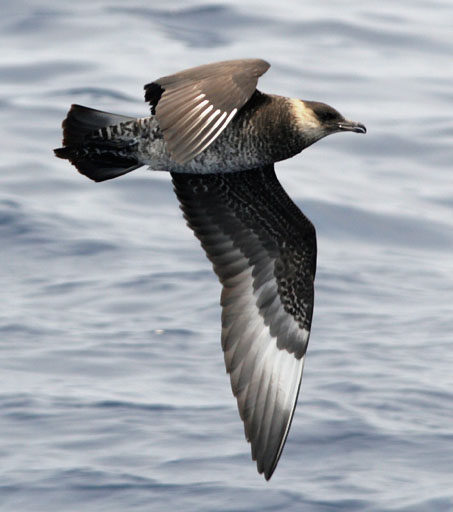
Wikipedia: Pomarine jaeger Source: OTHER
Stercorarius_pomarinusPCCA20070623-3985B.jpg
This bird appears across the great seas in the following continents:
Europe, North America, South America, Africa, Asia.
![]() The pomarine jaeger (Stercorarius pomarinus), pomarine skua, or pomatorhine skua,[2] is a seabird in the skua family Stercorariidae. It is a migrant, wintering at sea in the tropical oceans.
[more]
The pomarine jaeger (Stercorarius pomarinus), pomarine skua, or pomatorhine skua,[2] is a seabird in the skua family Stercorariidae. It is a migrant, wintering at sea in the tropical oceans.
[more]
Calls: ![]() Short "kea" or "ke", and various mewing calls, usually deeper pitched than Arctic Skua. Also a characteristic, laughing and vibrating "kayayayayaya", heard mostly on breeding ground. [Link]
Short "kea" or "ke", and various mewing calls, usually deeper pitched than Arctic Skua. Also a characteristic, laughing and vibrating "kayayayayaya", heard mostly on breeding ground. [Link]
Physical details: length=46-51 cm,
wingspan=125-138 cm,
weight=600-900 g
Long-tailed jaeger / Falkenraubmöwe (Stercorarius longicaudus)

Wikipedia: Long-tailed jaeger Source: OTHER
1200px-Long-tailed_Skua_%28js%29_26.jpg
This bird appears across the great seas in the following continents:
Europe, North America, Africa, Asia.
General: ![]() The long-tailed skua or long-tailed jaeger (Stercorarius longicaudus) is a seabird in the skua family Stercorariidae.
[more]
The long-tailed skua or long-tailed jaeger (Stercorarius longicaudus) is a seabird in the skua family Stercorariidae.
[more]
Parasitic jaeger / Schmarotzerraubmöwe (Stercorarius parasiticus)
Our guide raises his arm, which results in the Arctic Skua keeping a safe distance. 2015-06-10 15.13.04 Iceland
First observed in Iceland on 2015-06-10.
This bird appears across the great seas in the following continents:
Europe, North America, South America, Africa, Asia.
![]() The parasitic jaeger (Stercorarius parasiticus), also known as the Arctic skua, Arctic jaeger or parasitic skua, is a seabird in the skua family Stercorariidae. The word "jaeger" is derived from the German word Jäger, meaning "hunter".[2] The English "skua" comes from the Faroese name skúgvur [ˈskɪkvʊər] for the great skua, with the island of Skúvoy known for its colony of that bird. The general Faroese term for skuas is kjógvi [ˈtʃɛkvə].[3] The genus name Stercorarius is Latin and means "of dung"; the food disgorged by other birds when pursued by skuas was once thought to be excrement. The specific parasiticus is from Latin and means "parasitic".[4]
[more]
The parasitic jaeger (Stercorarius parasiticus), also known as the Arctic skua, Arctic jaeger or parasitic skua, is a seabird in the skua family Stercorariidae. The word "jaeger" is derived from the German word Jäger, meaning "hunter".[2] The English "skua" comes from the Faroese name skúgvur [ˈskɪkvʊər] for the great skua, with the island of Skúvoy known for its colony of that bird. The general Faroese term for skuas is kjógvi [ˈtʃɛkvə].[3] The genus name Stercorarius is Latin and means "of dung"; the food disgorged by other birds when pursued by skuas was once thought to be excrement. The specific parasiticus is from Latin and means "parasitic".[4]
[more]
Vocalization: ![]() Mostly heard at breeding ground. [Link]
Mostly heard at breeding ground. [Link]
Calls: ![]() Most characteristic call is a mewing, kittiwake-like "aeeeee-ah". First syllable drawn-out and rising in pitch, and followed by a deeper conclusive second syllable "ah". Lacks the introductory double accent of Kittiwakes ("kitti-wake"). [Link]
Most characteristic call is a mewing, kittiwake-like "aeeeee-ah". First syllable drawn-out and rising in pitch, and followed by a deeper conclusive second syllable "ah". Lacks the introductory double accent of Kittiwakes ("kitti-wake"). [Link]
Physical details: length=41-46 cm,
wingspan=110-125 cm,
weight=330-570 g
American avocet / Amerikanischer Säbelschnäbler (Recurvirostra americana)
Profile Wikipedia eBird Audubon AllAboutBirds Xeno-Canto

Wikipedia: American avocet Source: OTHER
1200px-American_Avocet1.jpg
General: ![]() The American avocet (Recurvirostra americana) is a large wader in the avocet and stilt family, Recurvirostridae. It spends much of its time foraging in shallow water or on mud flats, often sweeping its bill from side to side in water as it seeks its crustacean and insect prey.[2]
[more]
The American avocet (Recurvirostra americana) is a large wader in the avocet and stilt family, Recurvirostridae. It spends much of its time foraging in shallow water or on mud flats, often sweeping its bill from side to side in water as it seeks its crustacean and insect prey.[2]
[more]
Black-necked stilt / Amerikanischer Stelzenläufer (Himantopus mexicanus)
Profile Wikipedia eBird Audubon AllAboutBirds Xeno-Canto
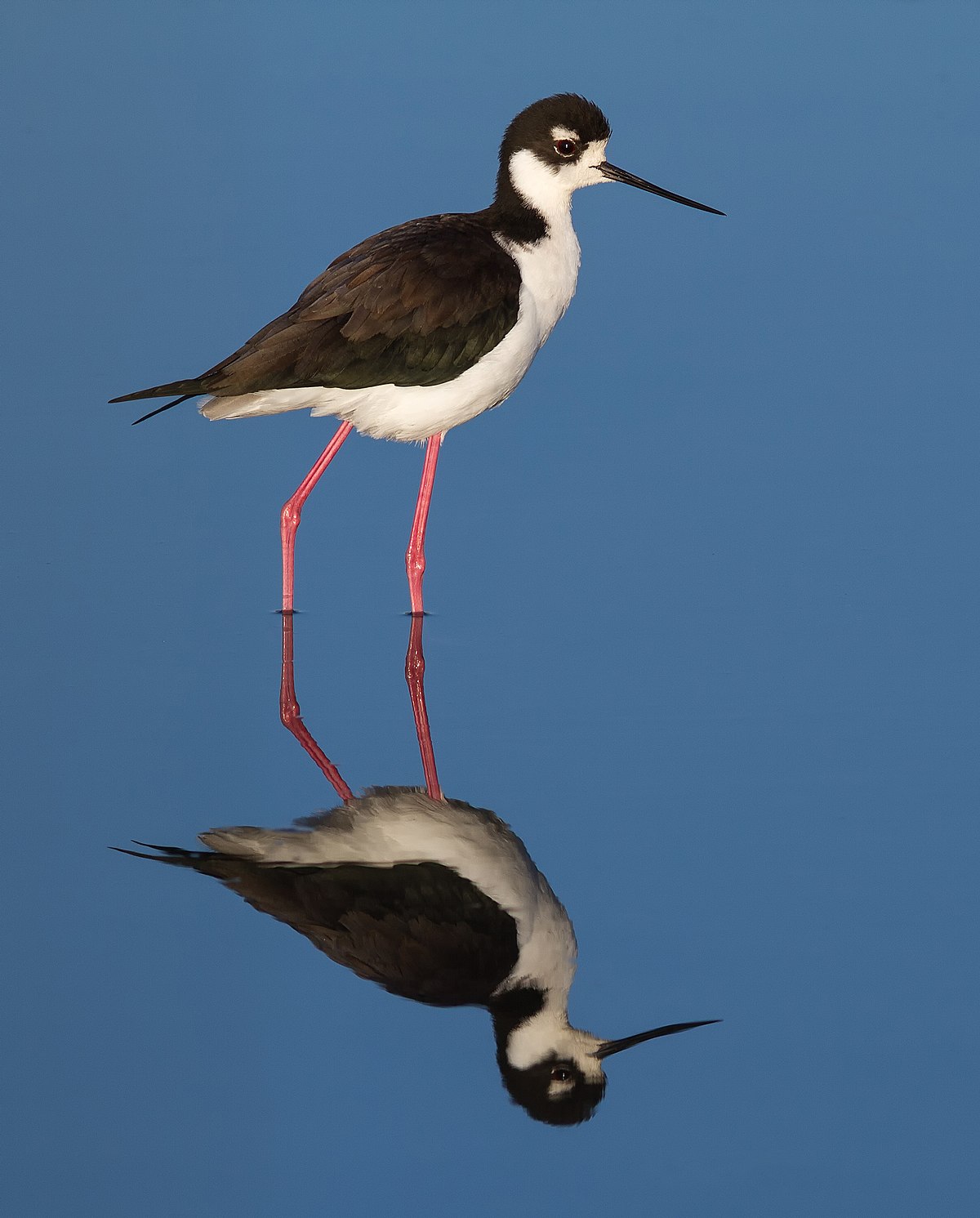
Wikipedia: Black-necked stilt Source: OTHER
1200px-Black-necked_Stilt_%28Himantopus_mexicanus%29%2C_Corte_Madera.jpg
![]() The black-necked stilt (Himantopus mexicanus) is a locally abundant shorebird of American wetlands and coastlines. It is found from the coastal areas of California through much of the interior western United States and along the Gulf of Mexico as far east as Florida, then south through Central America and the Caribbean to Ecuador and the Galápagos Islands. The northernmost populations, particularly those from inland, are migratory, wintering from the extreme south of the United States to southern Mexico, rarely as far south as Costa Rica; on the Baja California peninsula it is only found regularly in winter.[2]
[more]
The black-necked stilt (Himantopus mexicanus) is a locally abundant shorebird of American wetlands and coastlines. It is found from the coastal areas of California through much of the interior western United States and along the Gulf of Mexico as far east as Florida, then south through Central America and the Caribbean to Ecuador and the Galápagos Islands. The northernmost populations, particularly those from inland, are migratory, wintering from the extreme south of the United States to southern Mexico, rarely as far south as Costa Rica; on the Baja California peninsula it is only found regularly in winter.[2]
[more]
American coot (Fulica americana)
Profile Wikipedia eBird Audubon AllAboutBirds Xeno-Canto
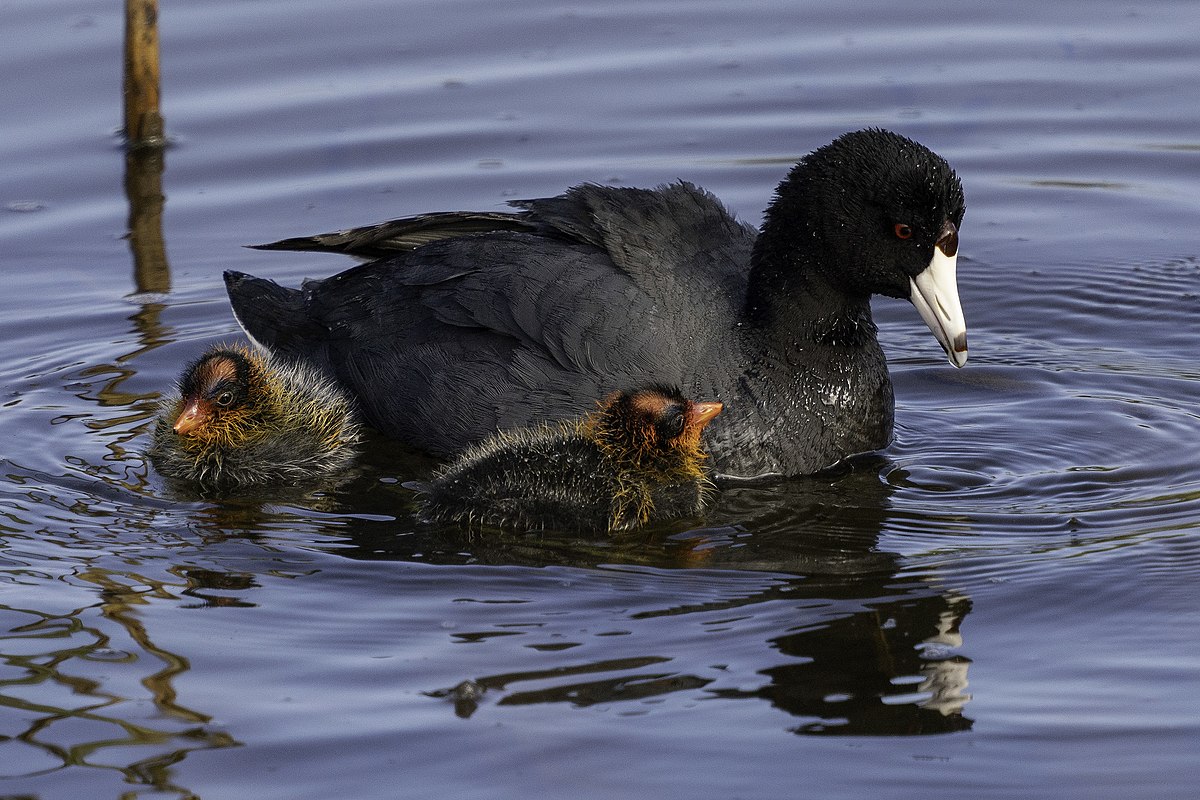
Wikipedia: American coot Source: OTHER
1200px-American-coot-casey-klebba.jpg
![]() The American coot (Fulica americana), also known as a mud hen or pouldeau, is a bird of the family Rallidae. Though commonly mistaken for ducks, American coots are only distantly related to ducks, belonging to a separate order. Unlike the webbed feet of ducks, coots have broad, lobed scales on their lower legs and toes that fold back with each step in order to facilitate walking on dry land.[2] Coots live near water, typically inhabiting wetlands and open water bodies in North America. Groups of coots are called covers[3] or rafts.[citation needed] The oldest known coot lived to be 22 years old.[2]
[more]
The American coot (Fulica americana), also known as a mud hen or pouldeau, is a bird of the family Rallidae. Though commonly mistaken for ducks, American coots are only distantly related to ducks, belonging to a separate order. Unlike the webbed feet of ducks, coots have broad, lobed scales on their lower legs and toes that fold back with each step in order to facilitate walking on dry land.[2] Coots live near water, typically inhabiting wetlands and open water bodies in North America. Groups of coots are called covers[3] or rafts.[citation needed] The oldest known coot lived to be 22 years old.[2]
[more]
Clapper rail (Rallus crepitans)
Profile Wikipedia eBird Audubon AllAboutBirds Xeno-Canto
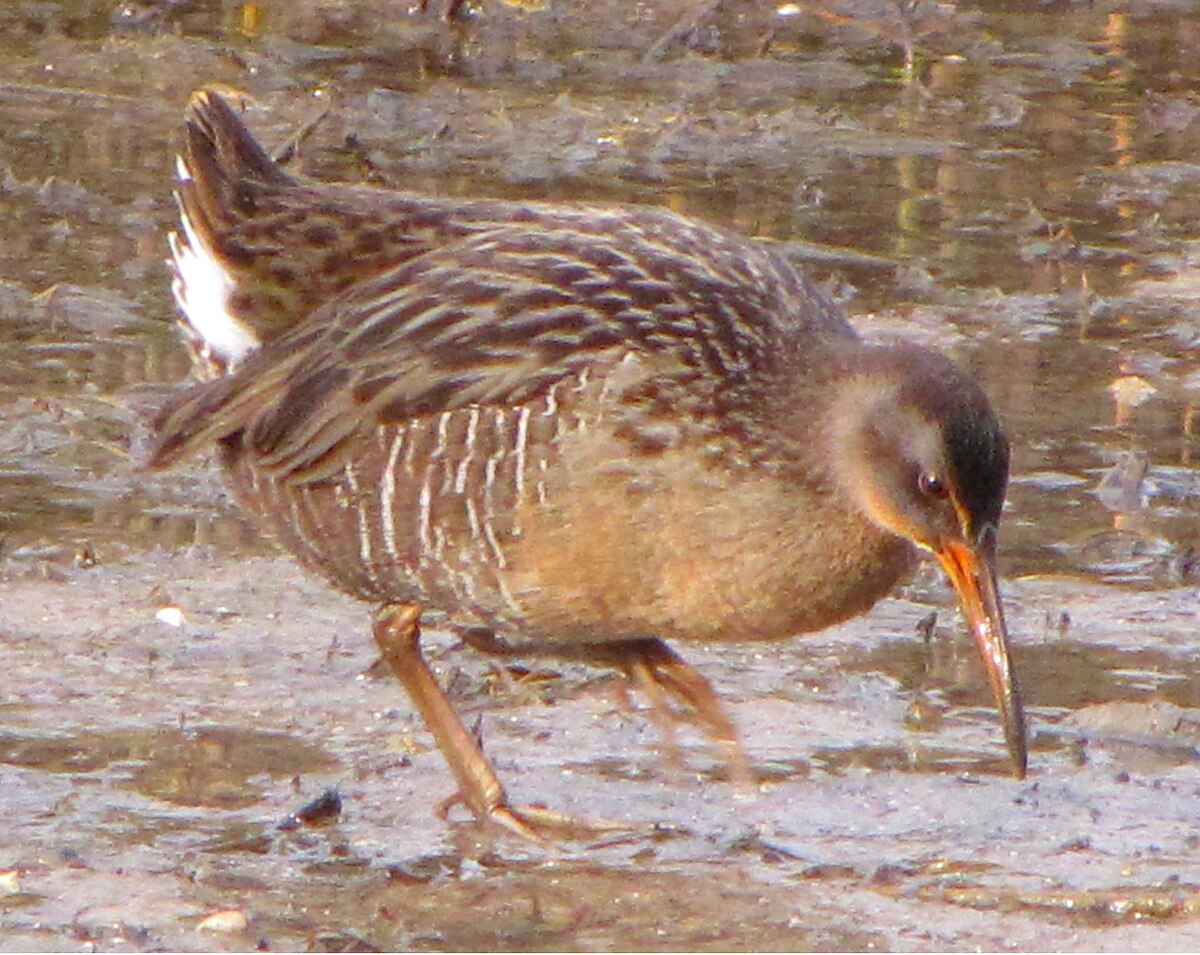
Wikipedia: Clapper rail Source: OTHER
1200px-Rallus_crepitans.jpg
![]() The clapper rail (Rallus crepitans) is a member of the rail family, Rallidae. The taxonomy for this species is confusing and still being determined. The Ridgway's rail (formerly the California clapper rail) and the mangrove rail have been recently split. Furthermore, some taxonomists consider that the King rail and Aztec rail should be considered within this group, as those birds look similar and the birds are known to interbreed where they share territories.
[more]
The clapper rail (Rallus crepitans) is a member of the rail family, Rallidae. The taxonomy for this species is confusing and still being determined. The Ridgway's rail (formerly the California clapper rail) and the mangrove rail have been recently split. Furthermore, some taxonomists consider that the King rail and Aztec rail should be considered within this group, as those birds look similar and the birds are known to interbreed where they share territories.
[more]
Virginia rail (Rallus limicola)
Profile Wikipedia eBird Audubon AllAboutBirds Xeno-Canto

Wikipedia: Virginia rail Source: OTHER
1200px-Rallus_limicola_-Cloisters_Park%2C_Morro_Bay%2C_California%2C_USA-8_%281%29.jpg
![]() The Virginia rail (Rallus limicola) is a small waterbird, of the family Rallidae.
These birds remain fairly common despite continuing loss of habitat, but are secretive by nature and more often heard than seen.[2] They are also considered a game species in some provinces and states, though rarely hunted.[3] The Ecuadorian rail is often considered a subspecies, but some taxonomic authorities consider it distinct.
[more]
The Virginia rail (Rallus limicola) is a small waterbird, of the family Rallidae.
These birds remain fairly common despite continuing loss of habitat, but are secretive by nature and more often heard than seen.[2] They are also considered a game species in some provinces and states, though rarely hunted.[3] The Ecuadorian rail is often considered a subspecies, but some taxonomic authorities consider it distinct.
[more]
King rail (Rallus elegans)
Profile Wikipedia eBird Audubon AllAboutBirds Xeno-Canto
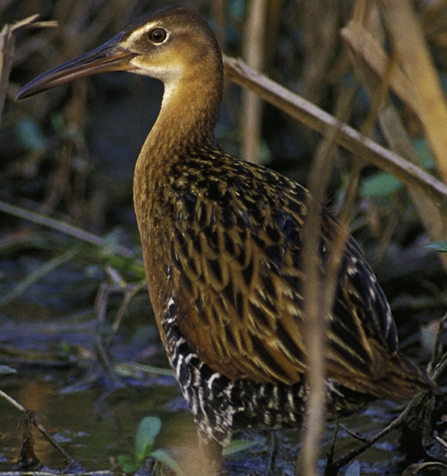
Wikipedia: King rail Source: OTHER
KingRail23.jpg
![]() The king rail (Rallus elegans) is a waterbird, the largest North American rail.
[more]
The king rail (Rallus elegans) is a waterbird, the largest North American rail.
[more]
Ridgway's rail (Rallus obsoletus)
Profile Wikipedia eBird Audubon AllAboutBirds Xeno-Canto

Wikipedia: Ridgway's rail Source: OTHER
1200px-Ridgway%27s_Rail_%2824515510911%29.jpg
![]() Ridgway's rail (Rallus obsoletus) is a near-threatened species of bird. It is found principally in California's San Francisco Bay to southern Baja California. A member of the rail family, Rallidae, it is a chicken-sized bird that rarely flies.
[more]
Ridgway's rail (Rallus obsoletus) is a near-threatened species of bird. It is found principally in California's San Francisco Bay to southern Baja California. A member of the rail family, Rallidae, it is a chicken-sized bird that rarely flies.
[more]
Common moorhen / Teichhuhn (Gallinula chloropus)
Teichhuhn bei Rapperswil 2021-02-12 12.54.22 Rapperswil
First observed in 🇨🇭 on 2021-02-12.
This bird appears across the great seas in the following continents:
Europe, North America, Africa, Asia.
Seen at the Pfäffikersee walking across the path from one set of reeds to another.
An apprentice at the nature center gave us the identification, presuming it was a juvenile
because of the lack of color. I'd have said its legs were shorter, but the moorhen definitely
has the main trait we saw, that it holds its short tail in the air.
Habitat: ![]() Common Moorhens prefer to nest in the thicket on the edge of ponds, lakes or rivers and mostly only give themselves away through their guttural calls. They are easier to observe in winter because then they leave their well-vegetated habitat and are seen in meadows, parks and on open waters. [Link]
Common Moorhens prefer to nest in the thicket on the edge of ponds, lakes or rivers and mostly only give themselves away through their guttural calls. They are easier to observe in winter because then they leave their well-vegetated habitat and are seen in meadows, parks and on open waters. [Link]
Song: ![]() Most typical is the territorial call (song); a sharp, loud and resonant "krrrr-ook" or "krrrk". [Link]
Most typical is the territorial call (song); a sharp, loud and resonant "krrrr-ook" or "krrrk". [Link]
Calls: ![]() Rich repertoire of loud calls and softer sounds. Other calls; a sharp, three or four-syllable "kekeke", and a soft "wep" sometimes drawn-out in a more mewing version. [Link]
Rich repertoire of loud calls and softer sounds. Other calls; a sharp, three or four-syllable "kekeke", and a soft "wep" sometimes drawn-out in a more mewing version. [Link]
Physical details: length=32-35 cm,
wingspan=50-55 cm,
weight=240-420 g
Habitats:
Wetland
Common gallinule (Gallinula galeata)
Profile Wikipedia eBird Audubon AllAboutBirds Xeno-Canto
Common gallinule, juvenile, Florida. 2023-09-23 20.46.10 Florida
First observed in Florida on 2023-09-23.
General: ![]() The common gallinule (Gallinula galeata) is a bird in the family Rallidae. It was split from the common moorhen by the American Ornithologists' Union in July 2011.[3] It lives around well-vegetated marshes, ponds, canals, and other wetlands in the Americas. The species is not found in the polar regions or many tropical rainforests. Elsewhere, the common gallinule is likely the most commonly seen rail species in much of North America, except for the American coot in some regions.
[more]
The common gallinule (Gallinula galeata) is a bird in the family Rallidae. It was split from the common moorhen by the American Ornithologists' Union in July 2011.[3] It lives around well-vegetated marshes, ponds, canals, and other wetlands in the Americas. The species is not found in the polar regions or many tropical rainforests. Elsewhere, the common gallinule is likely the most commonly seen rail species in much of North America, except for the American coot in some regions.
[more]
Buff-banded rail (Gallirallus philippensis)

Wikipedia: Buff-banded rail Source: OTHER
1200px-Buff-banded_Rail_1_-_Newington.jpg
This bird appears across the great seas in the following continents:
North America, Asia, Australia.
![]() The buff-banded rail (Hypotaenidia philippensis) is a distinctively coloured, highly dispersive, medium-sized rail of the rail family, Rallidae. This species comprises several subspecies found throughout much of Australasia and the south-west Pacific region, including the Philippines (where it is known as tikling), New Guinea, Australia, New Zealand (where it is known as the banded rail or moho-pererū in Māori),[2] and numerous smaller islands, covering a range of latitudes from the tropics to the Subantarctic.
[more]
The buff-banded rail (Hypotaenidia philippensis) is a distinctively coloured, highly dispersive, medium-sized rail of the rail family, Rallidae. This species comprises several subspecies found throughout much of Australasia and the south-west Pacific region, including the Philippines (where it is known as tikling), New Guinea, Australia, New Zealand (where it is known as the banded rail or moho-pererū in Māori),[2] and numerous smaller islands, covering a range of latitudes from the tropics to the Subantarctic.
[more]
Guam rail (Gallirallus owstoni)

Wikipedia: Guam rail Source: OTHER
1200px-GuamRail02.jpg
![]() The Guam rail (Hypotaenidia owstoni) is a species of flightless bird, endemic to the United States territory of Guam, where it is known locally as the Ko'ko' bird.[2] The Guam rail disappeared from southern Guam in the early 1970s and was extirpated from the entire island by the late 1980s. This species is now being bred in captivity by the Division of Aquatic and Wildlife Resources on Guam and at some mainland U.S. zoos. Since 1995, more than 100 rails have been introduced on the island of Rota in the Commonwealth of the Northern Mariana Islands in an attempt to establish a wild breeding colony. Although at least one chick resulted from these efforts, feral cat predation and accidental deaths have been extremely high. In 2010, 16 birds were released onto Cocos Island, with 12 more being introduced in 2012. [1] In 2019, the species became only the second bird after the California condor to be reclassified by the IUCN from extinct in the wild to critically endangered. [1][3]
[more]
The Guam rail (Hypotaenidia owstoni) is a species of flightless bird, endemic to the United States territory of Guam, where it is known locally as the Ko'ko' bird.[2] The Guam rail disappeared from southern Guam in the early 1970s and was extirpated from the entire island by the late 1980s. This species is now being bred in captivity by the Division of Aquatic and Wildlife Resources on Guam and at some mainland U.S. zoos. Since 1995, more than 100 rails have been introduced on the island of Rota in the Commonwealth of the Northern Mariana Islands in an attempt to establish a wild breeding colony. Although at least one chick resulted from these efforts, feral cat predation and accidental deaths have been extremely high. In 2010, 16 birds were released onto Cocos Island, with 12 more being introduced in 2012. [1] In 2019, the species became only the second bird after the California condor to be reclassified by the IUCN from extinct in the wild to critically endangered. [1][3]
[more]
Black rail (Laterallus jamaicensis)
Profile Wikipedia eBird Audubon AllAboutBirds Xeno-Canto

Wikipedia: Black rail Source: OTHER
1200px-Laterallus_jamaicensis_-_Black_Rail%3B_Arari%2C_Maranh%C3%A3o%2C_Brazil.jpg
![]() The black rail (Laterallus jamaicensis) is a mouse-sized member of the bird family Rallidae.
[more]
The black rail (Laterallus jamaicensis) is a mouse-sized member of the bird family Rallidae.
[more]
Grey-headed swamphen / Graukopf-Purpurhuhn (Porphyrio poliocephalus)

Wikipedia: Grey-headed swamphen Source: OTHER
1200px-Grey-headed_swamphen_%28Porphyrio_poliocephalus%29_male.jpg
This bird appears across the great seas in the following continents:
North America, Asia.
![]() The grey-headed swamphen (Porphyrio poliocephalus) is a species of swamphen occurring from the Middle East and the Indian subcontinent to southern China and northern Thailand. It used to be considered a subspecies of the purple swamphen, but was elevated to full species status in 2015; today the purple swamphen is considered a superspecies and each of its six subspecies groups are designated full species.[1]
[more]
The grey-headed swamphen (Porphyrio poliocephalus) is a species of swamphen occurring from the Middle East and the Indian subcontinent to southern China and northern Thailand. It used to be considered a subspecies of the purple swamphen, but was elevated to full species status in 2015; today the purple swamphen is considered a superspecies and each of its six subspecies groups are designated full species.[1]
[more]
Black-backed swamphen (Porphyrio indicus)

Wikipedia: Black-backed swamphen Source: OTHER
1200px-Purple_Swamphen_%28Porphyrio_porphyrio%29%2C_Saigon_Zoo.jpg
![]() The black-backed swamphen (Porphyrio indicus) is a species of swamphen occurring from southeast Asia to Sulawesi and Borneo. It used to be considered a subspecies of the purple swamphen, which it resembles, but has a large shield, black upperparts, and the side of the head is blackish.
[more]
The black-backed swamphen (Porphyrio indicus) is a species of swamphen occurring from southeast Asia to Sulawesi and Borneo. It used to be considered a subspecies of the purple swamphen, which it resembles, but has a large shield, black upperparts, and the side of the head is blackish.
[more]
Yellow rail (Coturnicops noveboracensis)
Profile Wikipedia eBird Audubon AllAboutBirds Xeno-Canto
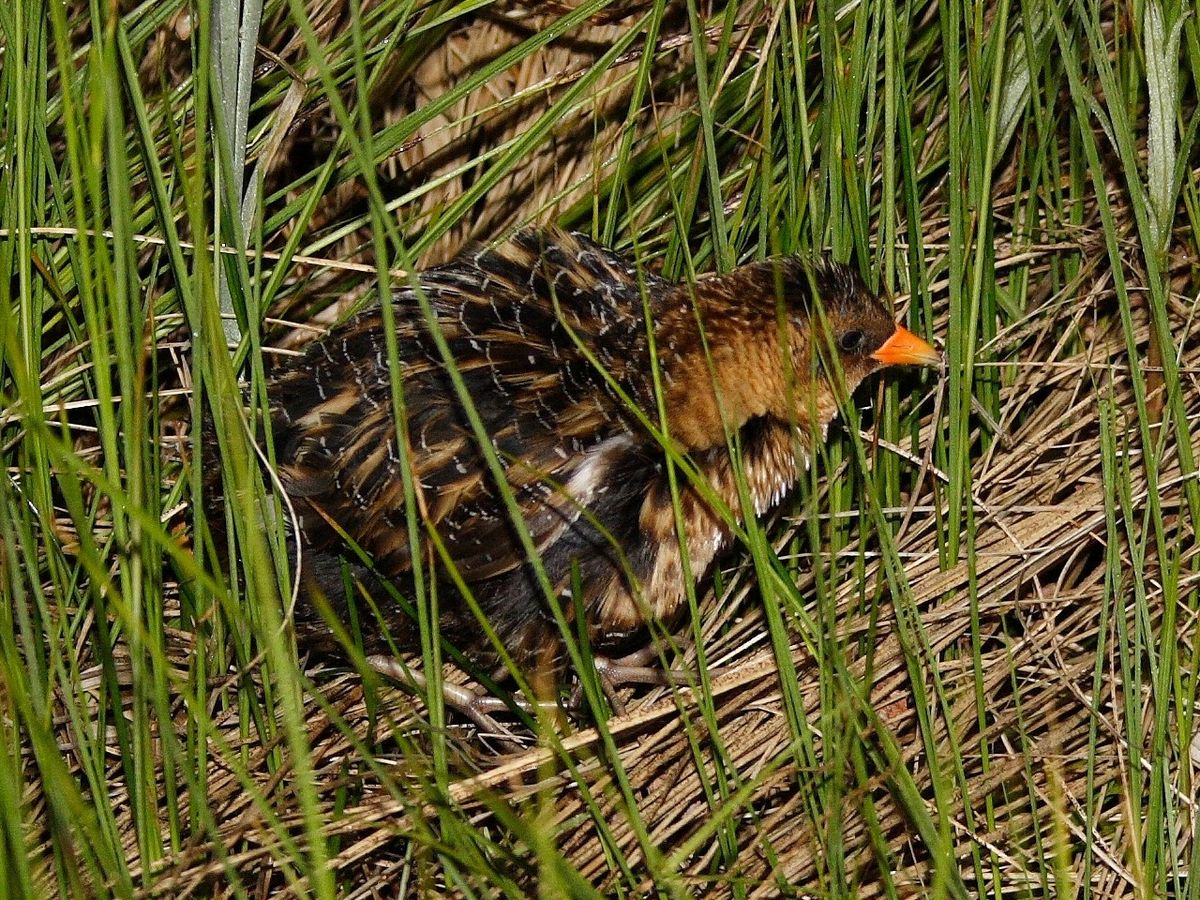
Wikipedia: Yellow rail Source: OTHER
1200px-Yellow_Rail.jpg
![]() The yellow rail (Coturnicops noveboracensis) is a small secretive marsh bird, of the family Rallidae.
[more]
The yellow rail (Coturnicops noveboracensis) is a small secretive marsh bird, of the family Rallidae.
[more]
Whooping crane / Schreikranich (Grus americana)
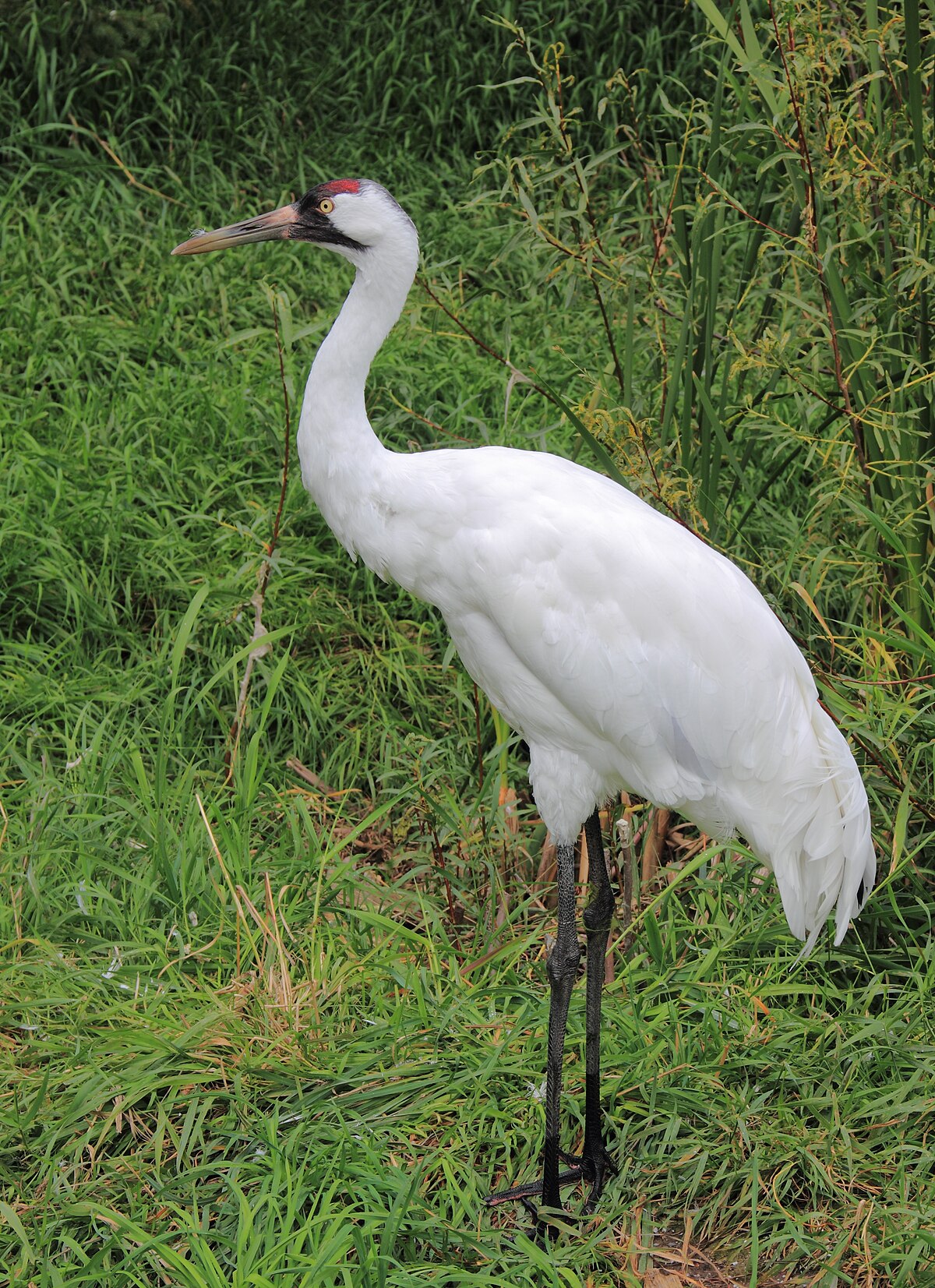
Wikipedia: Whooping crane Source: OTHER
1200px-Grus_americana_Sasata.jpg
![]() Named for its whooping sound, the whooping crane (Grus americana), is the tallest North American bird. It is an endangered crane species. Along with the sandhill crane (Antigone canadensis), it is one of only two crane species native to North America. The whooping crane's lifespan is estimated to be 22 to 24 years in the wild. After being pushed to the brink of extinction by unregulated hunting and loss of habitat to just 21 wild and two captive whooping cranes by 1941, conservation efforts have led to a limited recovery.[2] The total number of cranes in the surviving migratory population, plus three reintroduced flocks and in captivity, now exceeds 800 birds.
[more]
Named for its whooping sound, the whooping crane (Grus americana), is the tallest North American bird. It is an endangered crane species. Along with the sandhill crane (Antigone canadensis), it is one of only two crane species native to North America. The whooping crane's lifespan is estimated to be 22 to 24 years in the wild. After being pushed to the brink of extinction by unregulated hunting and loss of habitat to just 21 wild and two captive whooping cranes by 1941, conservation efforts have led to a limited recovery.[2] The total number of cranes in the surviving migratory population, plus three reintroduced flocks and in captivity, now exceeds 800 birds.
[more]
Sandhill crane (Antigone canadensis)
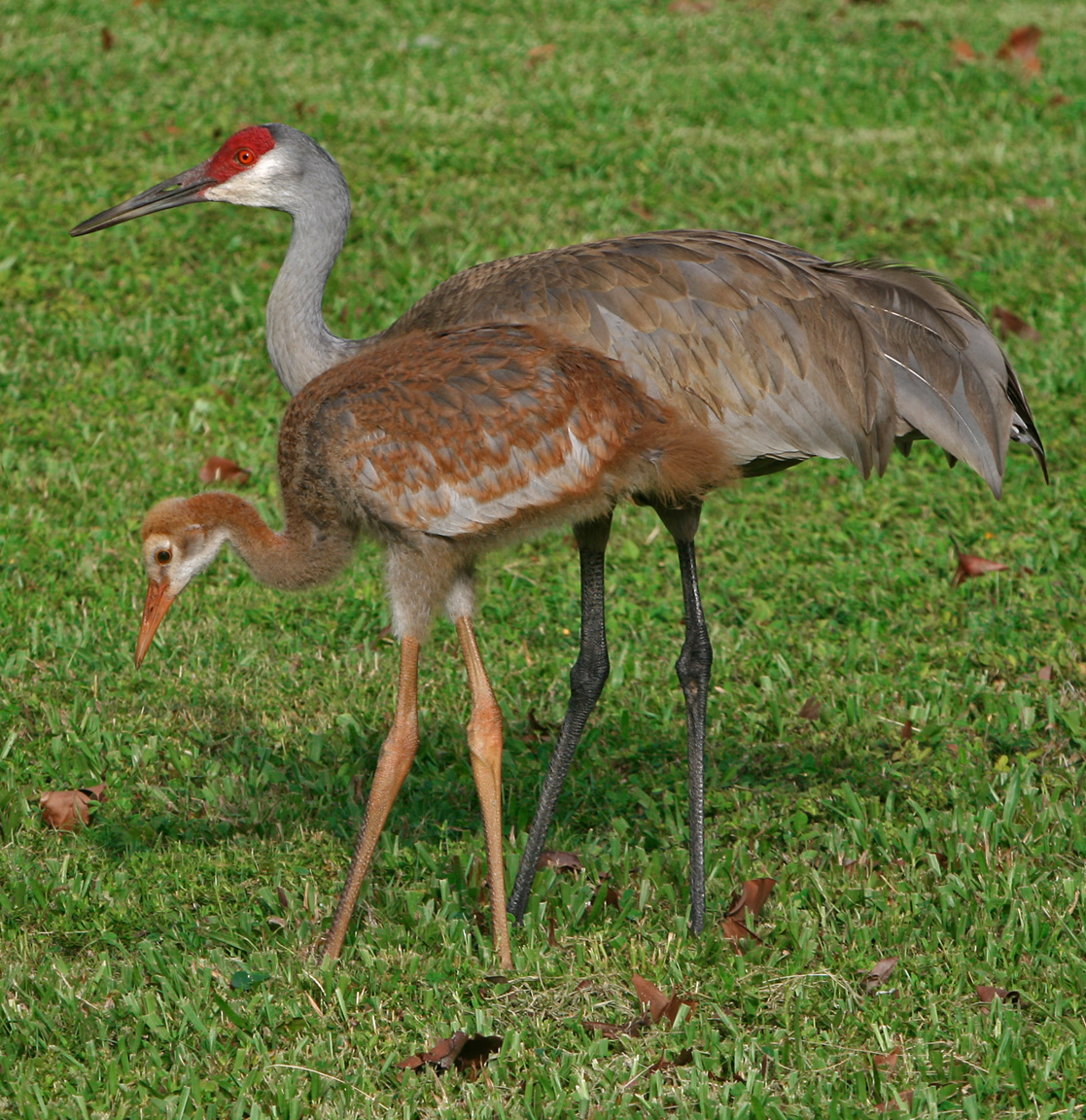
Wikipedia: Sandhill crane Source: OTHER
Grus_canadensis.jpg
![]() The sandhill crane (Antigone canadensis) is a species of large crane of North America and extreme northeastern Siberia. The common name of this bird refers to habitat like that at the Platte River, on the edge of Nebraska's Sandhills on the American Plains. This is the most important stopover area for the nominotypical subspecies, the lesser sandhill crane (Antigone canadensis canadensis), with up to 450,000 of these birds migrating through annually[citation needed].
[more]
The sandhill crane (Antigone canadensis) is a species of large crane of North America and extreme northeastern Siberia. The common name of this bird refers to habitat like that at the Platte River, on the edge of Nebraska's Sandhills on the American Plains. This is the most important stopover area for the nominotypical subspecies, the lesser sandhill crane (Antigone canadensis canadensis), with up to 450,000 of these birds migrating through annually[citation needed].
[more]
Limpkin / Rallenkranich (Aramus guarauna)

Wikipedia: Limpkin Source: OTHER
1200px-Limpkin%2C_Florida_05.jpg
![]() The limpkin (Aramus guarauna), also called carrao, courlan, and crying bird, is a large wading bird related to rails and cranes, and the only extant species in the genus Aramus and the family Aramidae. It is found mostly in wetlands in warm parts of the Americas, from Florida to northern Argentina. It feeds on molluscs, with the diet dominated by apple snails of the genus Pomacea. Its name derives from its seeming limp when it walks.[2]
[more]
The limpkin (Aramus guarauna), also called carrao, courlan, and crying bird, is a large wading bird related to rails and cranes, and the only extant species in the genus Aramus and the family Aramidae. It is found mostly in wetlands in warm parts of the Americas, from Florida to northern Argentina. It feeds on molluscs, with the diet dominated by apple snails of the genus Pomacea. Its name derives from its seeming limp when it walks.[2]
[more]
Maeusebussard. 2020-04-17 08.14.46 Wald Fehraltorf
First observed in 🇨🇭 on 2020-04-17.
This bird appears across the great seas in the following continents:
Europe, North America, Africa, Asia.
![]() The common buzzard (Buteo buteo) is a medium-to-large bird of prey which has a large range. A member of the genus Buteo, it is a member of the family Accipitridae. The species lives in most of Europe and extends its breeding range across much of the Palearctic as far as the northwestern China (Tien Shan), far western Siberia and northwestern Mongolia.[1][2] Over much of its range, it is a year-round resident. However, buzzards from the colder parts of the Northern Hemisphere as well as those that breed in the eastern part of their range typically migrate south for the northern winter, many journeying as far as South Africa.[3] The common buzzard is an opportunistic predator that can take a wide variety of prey, but it feeds mostly on small mammals, especially rodents such as voles. It typically hunts from a perch.[4] Like most accipitrid birds of prey, it builds a nest, typically in trees in this species, and is a devoted parent to a relatively small brood of young.[2] The common buzzard appears to be the most common diurnal raptor in Europe, as estimates of its total global population run well into the millions.[2][5]
[more]
The common buzzard (Buteo buteo) is a medium-to-large bird of prey which has a large range. A member of the genus Buteo, it is a member of the family Accipitridae. The species lives in most of Europe and extends its breeding range across much of the Palearctic as far as the northwestern China (Tien Shan), far western Siberia and northwestern Mongolia.[1][2] Over much of its range, it is a year-round resident. However, buzzards from the colder parts of the Northern Hemisphere as well as those that breed in the eastern part of their range typically migrate south for the northern winter, many journeying as far as South Africa.[3] The common buzzard is an opportunistic predator that can take a wide variety of prey, but it feeds mostly on small mammals, especially rodents such as voles. It typically hunts from a perch.[4] Like most accipitrid birds of prey, it builds a nest, typically in trees in this species, and is a devoted parent to a relatively small brood of young.[2] The common buzzard appears to be the most common diurnal raptor in Europe, as estimates of its total global population run well into the millions.[2][5]
[more]
Vocalization: ![]() Quite vocal. [Link]
Quite vocal. [Link]
Calls: ![]() Most typical call a wailing, mewing "peeoooo". Quite similar to Rough-legged Buzzard, but the pitch falls more rapidly and is then sustained for the last part of the call. [Link]
Most typical call a wailing, mewing "peeoooo". Quite similar to Rough-legged Buzzard, but the pitch falls more rapidly and is then sustained for the last part of the call. [Link]
Physical details: length=51-57 cm,
wingspan=113-128 cm,
weight=550-1300 g
Habitats:
Agricultural
Call:
Automatically generated from Xeno-Canto recording
♫ Source: BirdNet
20210421_090653 birdnet 1464 - Common Buzzard - 2021-04-21 09:06:53 - Common Buzzard - Fehraltorf.mp3
2021-04-21 09.06.53 Fehraltorf (song?)
Wikipedia: Rough-legged hawk Source: OTHER
Buteo_lagopus_29283.JPG
This bird appears across the great seas in the following continents:
Europe, North America.
Deutschland: ausnahmsweise Brutvogel, Wintergast
Profile Wikipedia eBird Audubon AllAboutBirds Xeno-Canto

Wikipedia: Short-tailed hawk Source: OTHER
Buteo_brachyurus_-Manduri%2C_Sao_Paulo%2C_Brazil_-flying-8.jpg
General: ![]() The short-tailed hawk (Buteo brachyurus) is an American bird of prey in the family Accipitridae, which also includes the eagles and Old World vultures. As a member of the genus Buteo, it is not a true hawk and thus also referred to as a "buteo" or (outside North America) "buzzard". The white-throated hawk (B. albigula) is a close relative and was formerly included in the species B. brachyurus.
[more]
The short-tailed hawk (Buteo brachyurus) is an American bird of prey in the family Accipitridae, which also includes the eagles and Old World vultures. As a member of the genus Buteo, it is not a true hawk and thus also referred to as a "buteo" or (outside North America) "buzzard". The white-throated hawk (B. albigula) is a close relative and was formerly included in the species B. brachyurus.
[more]
Wikipedia: Broad-winged hawk Source: OTHER
Julie_Waters_broad_winged_hawk.JPG
![]() The broad-winged hawk (Buteo platypterus) is a medium-sized hawk of the genus Buteo. During the summer, some subspecies are distributed over eastern North America, as far west as British Columbia and Texas; they then migrate south to winter in the Neotropics from Mexico south to southern Brazil.[2] Other subspecies are all-year residents on Caribbean islands.[3] As in most raptors, females are slightly larger than males. Broad-winged hawks' wings are relatively short and broad with a tapered, somewhat pointed appearance. The two types of coloration are a dark morph with fewer white areas and a light morph that is more pale overall. Although the broad-winged hawk's numbers are relatively stable, populations are declining in some parts of its breeding range because of forest fragmentation.
[more]
The broad-winged hawk (Buteo platypterus) is a medium-sized hawk of the genus Buteo. During the summer, some subspecies are distributed over eastern North America, as far west as British Columbia and Texas; they then migrate south to winter in the Neotropics from Mexico south to southern Brazil.[2] Other subspecies are all-year residents on Caribbean islands.[3] As in most raptors, females are slightly larger than males. Broad-winged hawks' wings are relatively short and broad with a tapered, somewhat pointed appearance. The two types of coloration are a dark morph with fewer white areas and a light morph that is more pale overall. Although the broad-winged hawk's numbers are relatively stable, populations are declining in some parts of its breeding range because of forest fragmentation.
[more]
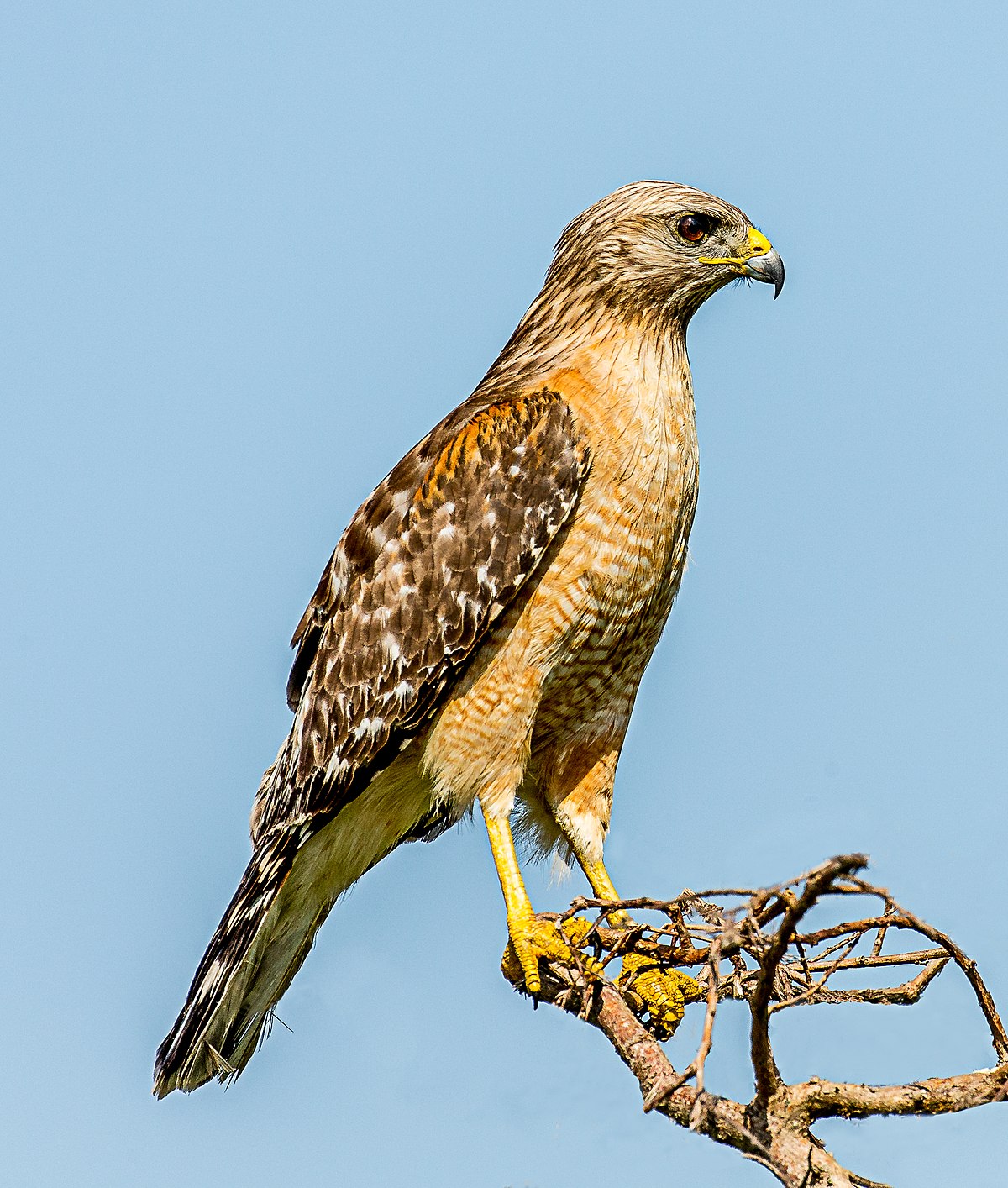
Wikipedia: Red-shouldered hawk Source: OTHER
1200px-Red-shouldered_Hawk_%28Buteo_lineatus%29_-_Blue_Cypress_Lake%2C_Florida.jpg
![]() The red-shouldered hawk (Buteo lineatus) is a medium-sized hawk. Its breeding range spans eastern North America and along the coast of California and northern to northeastern-central Mexico. It is a permanent resident throughout most of its range, though northern birds do migrate, mostly to central Mexico. The main conservation threat to the widespread species is deforestation.
[more]
The red-shouldered hawk (Buteo lineatus) is a medium-sized hawk. Its breeding range spans eastern North America and along the coast of California and northern to northeastern-central Mexico. It is a permanent resident throughout most of its range, though northern birds do migrate, mostly to central Mexico. The main conservation threat to the widespread species is deforestation.
[more]
Red-tailed hawk at Cromwell. 2022-04-29 12.30.10 Maryland
First observed in Maryland on 2022-04-29.
![]() The red-tailed hawk (Buteo jamaicensis) is a bird of prey that breeds throughout most of North America, from the interior of Alaska and northern Canada to as far south as Panama and the West Indies. It is one of the most common members within the genus of Buteo in North America or worldwide.[2] The red-tailed hawk is one of three species colloquially known in the United States as the "chickenhawk", though it rarely preys on standard-sized chickens.[3] The bird is sometimes also referred to as the red-tail for short, when the meaning is clear in context. Red-tailed hawks can acclimate to all the biomes within their range, occurring on the edges of non-ideal habitats such as dense forests and sandy deserts.[4] The red-tailed hawk occupies a wide range of habitats and altitudes including deserts, grasslands, coniferous and deciduous forests, agricultural fields and urban areas. Its latitudinal limits fall around the tree line in the Arctic and the species is absent from the high Arctic. It is legally protected in Canada, Mexico, and the United States by the Migratory Bird Treaty Act.
[more]
The red-tailed hawk (Buteo jamaicensis) is a bird of prey that breeds throughout most of North America, from the interior of Alaska and northern Canada to as far south as Panama and the West Indies. It is one of the most common members within the genus of Buteo in North America or worldwide.[2] The red-tailed hawk is one of three species colloquially known in the United States as the "chickenhawk", though it rarely preys on standard-sized chickens.[3] The bird is sometimes also referred to as the red-tail for short, when the meaning is clear in context. Red-tailed hawks can acclimate to all the biomes within their range, occurring on the edges of non-ideal habitats such as dense forests and sandy deserts.[4] The red-tailed hawk occupies a wide range of habitats and altitudes including deserts, grasslands, coniferous and deciduous forests, agricultural fields and urban areas. Its latitudinal limits fall around the tree line in the Arctic and the species is absent from the high Arctic. It is legally protected in Canada, Mexico, and the United States by the Migratory Bird Treaty Act.
[more]

Wikipedia: Swainson's hawk Source: OTHER
1200px-Swainson%27s_Hawk_%28Buteo_swainsoni%29_RWD.jpg
![]() Swainson's hawk (Buteo swainsoni) is a large birds species in the Accipitriformes order. This species was named after William Swainson, a British naturalist. It is colloquially known as the grasshopper hawk or locust hawk, as it is very fond of Acrididae (locusts and grasshoppers) and will voraciously eat these insects whenever they are available.
[more]
Swainson's hawk (Buteo swainsoni) is a large birds species in the Accipitriformes order. This species was named after William Swainson, a British naturalist. It is colloquially known as the grasshopper hawk or locust hawk, as it is very fond of Acrididae (locusts and grasshoppers) and will voraciously eat these insects whenever they are available.
[more]
Profile Wikipedia eBird Audubon AllAboutBirds Xeno-Canto

Wikipedia: Zone-tailed hawk Source: OTHER
1200px-229_-_ZONE-TAILED_HAWK_%284-11-2015%29_blue_haven_road%2C_patagonia%2C_santa_cruz_co%2C_az_-02_%2816906279787%29.jpg
![]() The zone-tailed hawk (Buteo albonotatus) is a medium-sized hawk of warm, dry parts of the Americas. It is somewhat similar in plumage and flight style to a common scavenger, the turkey vulture, and may benefit from being able to blend into groups of vultures. It feeds on small terrestrial tetrapods of all kinds.
[more]
The zone-tailed hawk (Buteo albonotatus) is a medium-sized hawk of warm, dry parts of the Americas. It is somewhat similar in plumage and flight style to a common scavenger, the turkey vulture, and may benefit from being able to blend into groups of vultures. It feeds on small terrestrial tetrapods of all kinds.
[more]
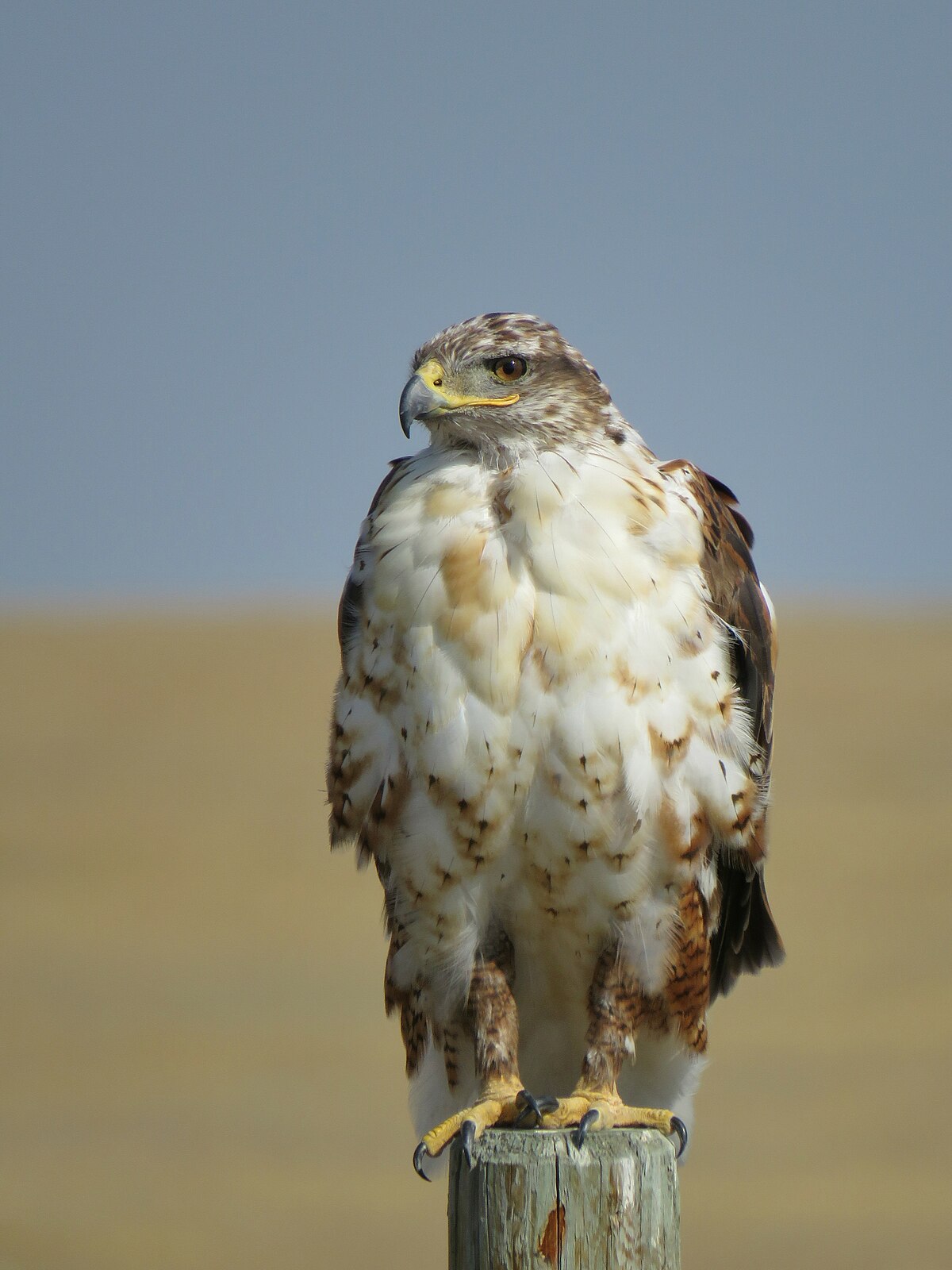
Wikipedia: Ferruginous hawk Source: OTHER
1200px-Ferruginous_Hawk_Alberta.jpg
![]() The ferruginous hawk (ferruginous = from Latin ferrum – iron, ferrugin-, iron rust, iron-rust color – reddish-brown), Buteo regalis (Latin, royal hawk), is a large bird of prey and belongs to the broad-winged buteo hawks. An old colloquial name is ferrugineous rough-leg,[2] due to its similarity to the closely related rough-legged hawk (B. lagopus).
[more]
The ferruginous hawk (ferruginous = from Latin ferrum – iron, ferrugin-, iron rust, iron-rust color – reddish-brown), Buteo regalis (Latin, royal hawk), is a large bird of prey and belongs to the broad-winged buteo hawks. An old colloquial name is ferrugineous rough-leg,[2] due to its similarity to the closely related rough-legged hawk (B. lagopus).
[more]
Profile Wikipedia eBird Audubon AllAboutBirds Xeno-Canto

Wikipedia: Gray hawk Source: OTHER
Buteo_plagiatus_Belize.jpg
![]() The gray hawk (Buteo plagiatus) or Mexican goshawk[2] is a smallish raptor found in open country and forest edges. It is sometimes placed in the genus Asturina as Asturina plagiata. The species was split by the American Ornithological Society (AOU) from the gray-lined hawk. The gray hawk is found from Costa Rica north into the southwestern United States.
[more]
The gray hawk (Buteo plagiatus) or Mexican goshawk[2] is a smallish raptor found in open country and forest edges. It is sometimes placed in the genus Asturina as Asturina plagiata. The species was split by the American Ornithological Society (AOU) from the gray-lined hawk. The gray hawk is found from Costa Rica north into the southwestern United States.
[more]
Young goshawk in Fehraltorf. A young hawk has these thrush-style streaks on its breast.
When grown, these become bars. 2021-01-17 10.19.26 Luppmen
First observed in 🇨🇭 on 2021-01-17.
This bird appears across the great seas in the following continents:
Europe, North America, Africa.
A young northern goshawk appeared in a tree on the Bahnhofstrasse in Fehraltorf
one snowy January day in 2021.
Appearance and identification: ![]() A medium-large raptor in the family Accipitridae, which also includes other extant diurnal raptors, such as eagles, buzzards and harriers. As a species in the genus Accipiter, the goshawk is often considered a "true hawk".[3] The scientific name is Latin; Accipiter is "hawk", from accipere, "to grasp", and gentilis is "noble" or "gentle" because in the Middle Ages only the nobility were permitted to fly goshawks for falconry. [Link]
A medium-large raptor in the family Accipitridae, which also includes other extant diurnal raptors, such as eagles, buzzards and harriers. As a species in the genus Accipiter, the goshawk is often considered a "true hawk".[3] The scientific name is Latin; Accipiter is "hawk", from accipere, "to grasp", and gentilis is "noble" or "gentle" because in the Middle Ages only the nobility were permitted to fly goshawks for falconry. [Link]
Vocalization: ![]() Series of short "ke-ke-ke-ke-ke". [Link]
Series of short "ke-ke-ke-ke-ke". [Link]
Calls: ![]() More resonant, both sharper and deeper pitched than similar call of Sparrowhawk, and much slower. Also a wailing "peeeaaaaw". [Link]
More resonant, both sharper and deeper pitched than similar call of Sparrowhawk, and much slower. Also a wailing "peeeaaaaw". [Link]
Physical details: length=48-62 cm,
wingspan=135-165 cm,
weight=600-2000 g
Habitats:
Agricultural
Coopers hawk. 2022-05-07 14.20.04 Maryland
First observed in Maryland on 2022-05-07.
General: ![]() Cooper's hawk (Accipiter cooperii) is a medium-sized hawk native to the North American continent and found from southern Canada to Mexico.[2] This species is a member of the genus Accipiter, sometimes referred to as true hawks, which are famously agile, relatively small hawks common to wooded habitats around the world and also the most diverse of all diurnal raptor genera.[2] As in many birds of prey, the male is smaller than the female.[3] The birds found east of the Mississippi River tend to be larger on average than the birds found to the west.[4] It is easily confused with the smaller but similar Sharp-shinned hawk.
[more]
Cooper's hawk (Accipiter cooperii) is a medium-sized hawk native to the North American continent and found from southern Canada to Mexico.[2] This species is a member of the genus Accipiter, sometimes referred to as true hawks, which are famously agile, relatively small hawks common to wooded habitats around the world and also the most diverse of all diurnal raptor genera.[2] As in many birds of prey, the male is smaller than the female.[3] The birds found east of the Mississippi River tend to be larger on average than the birds found to the west.[4] It is easily confused with the smaller but similar Sharp-shinned hawk.
[more]
Profile Wikipedia eBird A-Z Animals Audubon AllAboutBirds Xeno-Canto

Wikipedia: Sharp-shinned hawk Source: OTHER
1200px-Accipiter_striatus%2C_Canet_Road%2C_San_Luis_Obispo_1.jpg
![]() A. s. chionogaster
A. s. chionogaster
A. s. erythronemius
A. s. fringilloides
A. s. madrensis
A. s. perobscurus
A. s. striatus
A. s. suttoni
A. s. velox
A. s. venator
A. s. ventralis
[more]
Steinadler. 2022-05-22 12.58.16 Leuk and surroundings
First observed in 🇨🇭 on 2022-05-21.
This bird appears across the great seas in the following continents:
Europe, North America, Africa.
Deutschland: Brut-, Jahresvogel RL 2
Vocalization: ![]() Not very vocal. A short, clear, yelping "kew". Sometimes in series in mellow tempo. [Link]
Not very vocal. A short, clear, yelping "kew". Sometimes in series in mellow tempo. [Link]
Calls: ![]() Also mewing, Buzzard-like calls. [Link]
Also mewing, Buzzard-like calls. [Link]
Physical details: length=75-88 cm,
wingspan=204-220 cm,
weight=2840-6665 g
Habitats:
Agricultural
Profile Wikipedia eBird A-Z Animals Audubon AllAboutBirds Xeno-Canto
Bald eagle. 2023-10-13 13.35.52 New England
First observed in New England on 2023-10-13.
General: ![]() The bald eagle (Haliaeetus leucocephalus) is a bird of prey found in North America. A sea eagle, it has two known subspecies and forms a species pair with the white-tailed eagle (Haliaeetus albicilla). Its range includes most of Canada and Alaska, all of the contiguous United States, and northern Mexico. It is found near large bodies of open water with an abundant food supply and old-growth trees for nesting.
[more]
The bald eagle (Haliaeetus leucocephalus) is a bird of prey found in North America. A sea eagle, it has two known subspecies and forms a species pair with the white-tailed eagle (Haliaeetus albicilla). Its range includes most of Canada and Alaska, all of the contiguous United States, and northern Mexico. It is found near large bodies of open water with an abundant food supply and old-growth trees for nesting.
[more]
Profile Wikipedia eBird Audubon AllAboutBirds Xeno-Canto

Wikipedia: Snail kite Source: OTHER
1200px-Schneckenweih-Snail-Kite.JPG
![]() The snail kite (Rostrhamus sociabilis) is a bird of prey within the family Accipitridae, which also includes the eagles, hawks, and Old World vultures. Its relative, the slender-billed kite, is now again placed in Helicolestes, making the genus Rostrhamus monotypic. Usually, it is placed in the milvine kites, but the validity of that group is under investigation.
[more]
The snail kite (Rostrhamus sociabilis) is a bird of prey within the family Accipitridae, which also includes the eagles, hawks, and Old World vultures. Its relative, the slender-billed kite, is now again placed in Helicolestes, making the genus Rostrhamus monotypic. Usually, it is placed in the milvine kites, but the validity of that group is under investigation.
[more]
Profile Wikipedia eBird Audubon AllAboutBirds Xeno-Canto

Wikipedia: Swallow-tailed kite Source: OTHER
1200px-Swallow-tailed_Kite_%2834163638494%29.jpg
![]() The swallow-tailed kite (Elanoides forficatus) is a pernine raptor which breeds from the southeastern United States to eastern Peru and northern Argentina. It is the only species in the genus Elanoides. Most North and Central American breeders winter in South America where the species is resident year round.
[more]
The swallow-tailed kite (Elanoides forficatus) is a pernine raptor which breeds from the southeastern United States to eastern Peru and northern Argentina. It is the only species in the genus Elanoides. Most North and Central American breeders winter in South America where the species is resident year round.
[more]
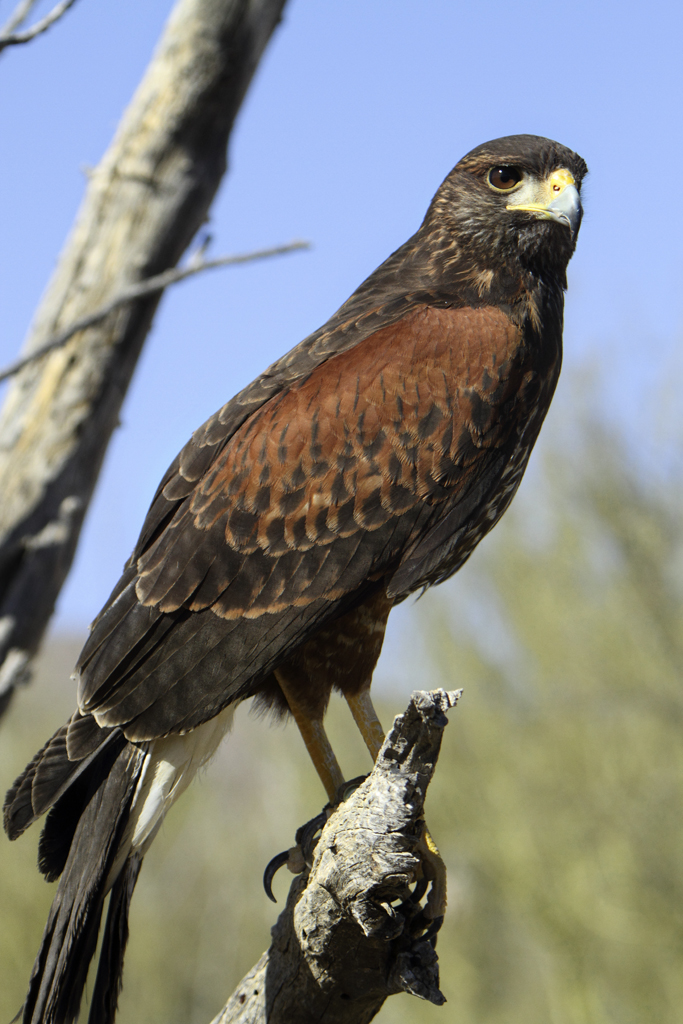
Wikipedia: Harris's hawk Source: OTHER
Harris%27s_Hawk_%28Parabuteo_unicinctus%29_3_of_4_in_set.jpg
![]() Harris's hawk (Parabuteo unicinctus), formerly known as the bay-winged hawk or dusky hawk, and known in Latin America as peuco, is a medium-large bird of prey that breeds from the southwestern United States south to Chile, central Argentina, and Brazil. Birds are sometimes reported at large in Western Europe, especially Britain, but it is a popular species in falconry and these records almost certainly all refer to escapes from captivity.
[more]
Harris's hawk (Parabuteo unicinctus), formerly known as the bay-winged hawk or dusky hawk, and known in Latin America as peuco, is a medium-large bird of prey that breeds from the southwestern United States south to Chile, central Argentina, and Brazil. Birds are sometimes reported at large in Western Europe, especially Britain, but it is a popular species in falconry and these records almost certainly all refer to escapes from captivity.
[more]
MerlinBirdID suggests common black hawk, flamingo tour near Rio Lagartos. 2023-04-15 08.40.26 Yucatan
First observed in Yucatan on 2023-04-15.
![]() The common black hawk (Buteogallus anthracinus) is a bird of prey in the family Accipitridae, which also includes the eagles, hawks, and Old World vultures. It formerly included the Cuban black-hawk (Buteogallus gundlachii) as a subspecies. The mangrove black hawk, traditionally considered a distinct species, is now generally considered a subspecies, B. a. subtilis, of the common black-hawk.[3]
[more]
The common black hawk (Buteogallus anthracinus) is a bird of prey in the family Accipitridae, which also includes the eagles, hawks, and Old World vultures. It formerly included the Cuban black-hawk (Buteogallus gundlachii) as a subspecies. The mangrove black hawk, traditionally considered a distinct species, is now generally considered a subspecies, B. a. subtilis, of the common black-hawk.[3]
[more]
Profile Wikipedia eBird Audubon AllAboutBirds Xeno-Canto

Wikipedia: White-tailed kite Source: OTHER
1200px-Elanus_leucurus_3.jpg
![]() The white-tailed kite (Elanus leucurus) is a small raptor found in western North America and parts of South America.
[more]
The white-tailed kite (Elanus leucurus) is a small raptor found in western North America and parts of South America.
[more]
Profile Wikipedia eBird Audubon AllAboutBirds Xeno-Canto

Wikipedia: Hook-billed kite Source: OTHER
1200px-Chondrohierax_uncinatus_76608753.jpg
![]() The hook-billed kite (Chondrohierax uncinatus), is a bird of prey in the family Accipitridae, which also includes many other diurnal raptors such as kites, eagles, and harriers. It occurs in the Americas, including the Rio Grande Valley of Texas in the United States, Mexico, the Caribbean, Central America, and tropical South America.
[more]
The hook-billed kite (Chondrohierax uncinatus), is a bird of prey in the family Accipitridae, which also includes many other diurnal raptors such as kites, eagles, and harriers. It occurs in the Americas, including the Rio Grande Valley of Texas in the United States, Mexico, the Caribbean, Central America, and tropical South America.
[more]
Profile Wikipedia eBird A-Z Animals Audubon AllAboutBirds Xeno-Canto

Wikipedia: Mississippi kite Source: OTHER
Mississippi_Kite.jpg
![]() The Mississippi kite (Ictinia mississippiensis) is a small bird of prey in the family Accipitridae. Mississippi kites have narrow, pointed wings and are graceful in flight, often appearing to float in the air. It is not uncommon to see several circling in the same area.
[more]
The Mississippi kite (Ictinia mississippiensis) is a small bird of prey in the family Accipitridae. Mississippi kites have narrow, pointed wings and are graceful in flight, often appearing to float in the air. It is not uncommon to see several circling in the same area.
[more]
Turkey vulture / Truthahngeier (Cathartes aura)
Turkey vulture. 2022-04-29 11.39.28 Maryland
First observed in Costa Rica on 2018-02-28.
![]() The turkey vulture (Cathartes aura), also known in some North American regions as the turkey buzzard (or just buzzard), and in some areas of the Caribbean as the John crow or carrion crow,[2] is the most widespread of the New World vultures.[3] One of three species in the genus Cathartes of the family Cathartidae, the turkey vulture ranges from southern Canada to the southernmost tip of South America. It inhabits a variety of open and semi-open areas, including subtropical forests, shrublands, pastures, and deserts.[1]
[more]
The turkey vulture (Cathartes aura), also known in some North American regions as the turkey buzzard (or just buzzard), and in some areas of the Caribbean as the John crow or carrion crow,[2] is the most widespread of the New World vultures.[3] One of three species in the genus Cathartes of the family Cathartidae, the turkey vulture ranges from southern Canada to the southernmost tip of South America. It inhabits a variety of open and semi-open areas, including subtropical forests, shrublands, pastures, and deserts.[1]
[more]
Black vulture / Rabengeier (Coragyps atratus)
Black vulture at cenote xxx. 2023-04-14 13.13.52 Yucatan
First observed in Yucatan on 2023-04-14.
![]() The black vulture (Coragyps atratus), also known as the American black vulture, is a bird in the New World vulture family whose range extends from the northeastern United States to Peru, Central Chile and Uruguay in South America. Although a common and widespread species, it has a somewhat more restricted distribution than its compatriot, the turkey vulture, which breeds well into Canada and south to Tierra del Fuego. It is the only extant member of the genus Coragyps, which is in the family Cathartidae. Despite the similar name and appearance, this species is unrelated to the Eurasian black vulture, an Old World vulture in the family Accipitridae (which includes eagles, hawks, kites, and harriers). It inhabits relatively open areas which provide scattered forests or shrublands. With a wingspan of 1.5 m (4.9 ft), the black vulture is a large bird though relatively small for a vulture. It has black plumage, a featherless, grayish-black head and neck, and a short, hooked beak.
[more]
The black vulture (Coragyps atratus), also known as the American black vulture, is a bird in the New World vulture family whose range extends from the northeastern United States to Peru, Central Chile and Uruguay in South America. Although a common and widespread species, it has a somewhat more restricted distribution than its compatriot, the turkey vulture, which breeds well into Canada and south to Tierra del Fuego. It is the only extant member of the genus Coragyps, which is in the family Cathartidae. Despite the similar name and appearance, this species is unrelated to the Eurasian black vulture, an Old World vulture in the family Accipitridae (which includes eagles, hawks, kites, and harriers). It inhabits relatively open areas which provide scattered forests or shrublands. With a wingspan of 1.5 m (4.9 ft), the black vulture is a large bird though relatively small for a vulture. It has black plumage, a featherless, grayish-black head and neck, and a short, hooked beak.
[more]
Osprey / Fischadler (Pandion haliaetus)
Osprey in flight. 2023-09-27 12.22.08 Florida
First observed in Yucatan on 2023-04-21.
This bird appears across the great seas in the following continents:
Europe, North America, South America, Africa, Asia.
![]() Falco haliaetus Linnaeus, 1758
[more]
Falco haliaetus Linnaeus, 1758
[more]
Calls: ![]() Calls with sequences of short, soft and clear whistling notes. Often in series with rising pitch, then ending with a few lower pitched notes. [Link]
Calls with sequences of short, soft and clear whistling notes. Often in series with rising pitch, then ending with a few lower pitched notes. [Link]
Physical details: length=55-58 cm,
wingspan=145-170 cm,
weight=1120-2050 g
Habitats:
Agricultural
Call:
Automatically generated from Xeno-Canto recording
♫ 2023-10-12 15 55 surprising sound of an osprey. 2023-10-12 15.55.00 New England (song?)
Profile Wikipedia eBird Audubon AllAboutBirds Xeno-Canto

Wikipedia: Wood stork Source: OTHER
1200px-Wood_stork_%28Mycteria_americana%29_and_Yacare_caiman.jpg
General: ![]() The wood stork (Mycteria americana) is a large American wading bird in the family Ciconiidae (storks). It was formerly called the "wood ibis", though it is not an ibis. It is found in subtropical and tropical habitats in the Americas, including the Caribbean. In South America, it is resident, but in North America, it may disperse as far as Florida. Originally described by Carl Linnaeus in 1758, this stork likely evolved in tropical regions. The head and neck are bare of feathers, and dark grey in colour.[2] The plumage is mostly white, with the exception of the tail and some of the wing feathers, which are black with a greenish-purplish sheen. The juvenile differs from the adult, with the former having a feathered head and a yellow bill, compared to the black adult bill. There is little sexual dimorphism.
[more]
The wood stork (Mycteria americana) is a large American wading bird in the family Ciconiidae (storks). It was formerly called the "wood ibis", though it is not an ibis. It is found in subtropical and tropical habitats in the Americas, including the Caribbean. In South America, it is resident, but in North America, it may disperse as far as Florida. Originally described by Carl Linnaeus in 1758, this stork likely evolved in tropical regions. The head and neck are bare of feathers, and dark grey in colour.[2] The plumage is mostly white, with the exception of the tail and some of the wing feathers, which are black with a greenish-purplish sheen. The juvenile differs from the adult, with the former having a feathered head and a yellow bill, compared to the black adult bill. There is little sexual dimorphism.
[more]
Profile Wikipedia eBird Audubon AllAboutBirds Xeno-Canto

Wikipedia: Chestnut-bellied sandgrouse Source: OTHER
1200px-Sandgrouse_-_Male.jpg
This bird appears across the great seas in the following continents:
North America, Africa.
![]() The chestnut-bellied sandgrouse or common sandgrouse[citation needed] (Pterocles exustus) is a species of sandgrouse. It is a sedentary and nomadic species that ranges from northern and central Africa and further east towards western and southern Asia. There are six recognised subspecies.[2]
[more]
The chestnut-bellied sandgrouse or common sandgrouse[citation needed] (Pterocles exustus) is a species of sandgrouse. It is a sedentary and nomadic species that ranges from northern and central Africa and further east towards western and southern Asia. There are six recognised subspecies.[2]
[more]
Rock doves aka common pigeons on the move. 2023-06-19 07.39.10 Bolle di Magadino
First observed in 🇨🇭 on 2023-06-19.
This bird appears across the great seas in the following continents:
Europe, North America, South America, Africa, Asia.
![]() The rock dove, rock pigeon, or common pigeon (/ˈpɪdʒ.ən/ also /ˈpɪdʒ.ɪn/; Columba livia) is a member of the bird family Columbidae (doves and pigeons).[3]:624 In common usage, this bird is often simply referred to as the "pigeon".
[more]
The rock dove, rock pigeon, or common pigeon (/ˈpɪdʒ.ən/ also /ˈpɪdʒ.ɪn/; Columba livia) is a member of the bird family Columbidae (doves and pigeons).[3]:624 In common usage, this bird is often simply referred to as the "pigeon".
[more]
Vocalization: ![]() Not loud. [Link]
Not loud. [Link]
Song: ![]() Song a two-syllable, but continuous cooing. First a rolling ascending "orrrrrr" immediately followed by a short descending "oohh". Wings produce a quite audible whistling sound. [Link]
Song a two-syllable, but continuous cooing. First a rolling ascending "orrrrrr" immediately followed by a short descending "oohh". Wings produce a quite audible whistling sound. [Link]
Physical details: length=31-34 cm,
wingspan=63-70 cm,
weight=230-370 g
Habitats:
Settlement
Didn't recognize this collared dove ...so I annotated it with the characteristics I should have recognized 2021-02-01 13.14.42 Luppmen
First observed in 🇨🇭 on 2020-05-21.
This bird appears across the great seas in the following continents:
Europe, North America (introduced), Africa, Asia (introduced).
General: ![]() The Eurasian collared dove (Streptopelia decaocto) is a dove species native to Europe and Asia; it was introduced to Japan, North America and islands in the Caribbean. Because of its vast global range and increasing population trend, it has been listed as Least Concern on the IUCN Red List since 2014.[1]
[more]
The Eurasian collared dove (Streptopelia decaocto) is a dove species native to Europe and Asia; it was introduced to Japan, North America and islands in the Caribbean. Because of its vast global range and increasing population trend, it has been listed as Least Concern on the IUCN Red List since 2014.[1]
[more]
Song: ![]() Gu-guh-gu, klingt wie „ Gross-mue-ti“ Dazu auch „chräi“ oder „chwii“
[Link]
Gu-guh-gu, klingt wie „ Gross-mue-ti“ Dazu auch „chräi“ oder „chwii“
[Link]
![]() Song a characteristic, rhythmic cooing, consisting of three syllables with emphasis on the second. The third lower pitched than the rest. Can be rendered as "su-do-ku" (or "deca-oc-to", latin name derived from song). [Link]
Song a characteristic, rhythmic cooing, consisting of three syllables with emphasis on the second. The third lower pitched than the rest. Can be rendered as "su-do-ku" (or "deca-oc-to", latin name derived from song). [Link]
Calls: ![]() Excitement-call a nasal "wrrraa". [Link]
Excitement-call a nasal "wrrraa". [Link]
Physical details: length=31-33 cm,
wingspan=47-55 cm,
weight=170-240 g
Habitats:
Settlement
Call:
Automatically generated from Xeno-Canto recording
♫ Türkentaube. 2020-05-21 07.45.50 Luppmen (song?)
Likely a spotted dove - the eye looks very strange here. 2024-02-16 09.35.16 Laos
First observed in Thailand on 2024-01-22.
This bird appears across the great seas in the following continents:
North America, Asia, Australia.
introduced
Call:
Automatically generated from Xeno-Canto recording
♫ XC884362 - Spotted Dove - Spilopelia chinensis. Source: XENOCANTO
XC884362 - Spotted Dove - Spilopelia chinensis.mp3
(song?)


Wikipedia: African collared-dove Source: OTHER
Streptopelia_roseogrisea.jpg
This bird appears across the great seas in the following continents:
Europe, North America, Africa.
General: ![]() The African collared dove (Streptopelia roseogrisea) is a small dove found in the Sahel, northern parts of the Horn of Africa and southwestern Arabia. Although it lives in arid lands, it is found around water sources.
[more]
The African collared dove (Streptopelia roseogrisea) is a small dove found in the Sahel, northern parts of the Horn of Africa and southwestern Arabia. Although it lives in arid lands, it is found around water sources.
[more]
Profile Wikipedia eBird Audubon AllAboutBirds Xeno-Canto

Wikipedia: Philippine collared-dove Source: OTHER
1200px-Streptopelia_bitorquata_-Saipan-8.jpg
![]() The Philippine collared dove (Streptopelia dusumieri) is a species of bird in the family Columbidae. It was formerly considered a subspecies of the Sunda collared dove (S. bitorquata).[2]
[more]
The Philippine collared dove (Streptopelia dusumieri) is a species of bird in the family Columbidae. It was formerly considered a subspecies of the Sunda collared dove (S. bitorquata).[2]
[more]
Profile Wikipedia eBird Audubon AllAboutBirds Xeno-Canto
White-winged dove - note the blue ring around the red eye. 2023-04-21 16.19.40 Yucatan
First observed in Yucatan on 2023-04-07.
![]() The white-winged dove (Zenaida asiatica) is a dove whose native range extends from the Southwestern United States through Mexico, Central America, and the Caribbean. They are large for doves, and can be distinguished from similar doves by the distinctive white edge on their wings. They have a blue eyering, and red eyes. The plumage is brownish-gray to gray. Juveniles are duller in color, and have brown eyes. The call is likened to English phrase "who cooks for you". There are three subspecies. It was first described by George Edwards in 1743, and given its binomial name by Linnaeus in 1756. It was moved into the genus Zenaida in 1838.
[more]
The white-winged dove (Zenaida asiatica) is a dove whose native range extends from the Southwestern United States through Mexico, Central America, and the Caribbean. They are large for doves, and can be distinguished from similar doves by the distinctive white edge on their wings. They have a blue eyering, and red eyes. The plumage is brownish-gray to gray. Juveniles are duller in color, and have brown eyes. The call is likened to English phrase "who cooks for you". There are three subspecies. It was first described by George Edwards in 1743, and given its binomial name by Linnaeus in 1756. It was moved into the genus Zenaida in 1838.
[more]
Profile Wikipedia eBird A-Z Animals Audubon AllAboutBirds Xeno-Canto
Mourning dove. 2022-05-08 09.50.44 Maryland
First observed in Cockeysville on 2021-06-15.
![]() The mourning dove (Zenaida macroura) is a member of the dove family, Columbidae. The bird is also known as the American mourning dove, the rain dove, and colloquially as the turtle dove, and was once known as the Carolina pigeon and Carolina turtledove.[2] It is one of the most abundant and widespread of all North American birds. It is also a leading gamebird, with more than 20 million birds (up to 70 million in some years) shot annually in the U.S., both for sport and for meat. Its ability to sustain its population under such pressure is due to its prolific breeding; in warm areas, one pair may raise up to six broods of two young each in a single year. The wings make an unusual whistling sound upon take-off and landing, a form of sonation. The bird is a strong flier, capable of speeds up to 88 km/h (55 mph).[3] It is the national bird of the British Virgin Islands.
[more]
The mourning dove (Zenaida macroura) is a member of the dove family, Columbidae. The bird is also known as the American mourning dove, the rain dove, and colloquially as the turtle dove, and was once known as the Carolina pigeon and Carolina turtledove.[2] It is one of the most abundant and widespread of all North American birds. It is also a leading gamebird, with more than 20 million birds (up to 70 million in some years) shot annually in the U.S., both for sport and for meat. Its ability to sustain its population under such pressure is due to its prolific breeding; in warm areas, one pair may raise up to six broods of two young each in a single year. The wings make an unusual whistling sound upon take-off and landing, a form of sonation. The bird is a strong flier, capable of speeds up to 88 km/h (55 mph).[3] It is the national bird of the British Virgin Islands.
[more]
Call:
Automatically generated from Xeno-Canto recording
♫ Source: BirdNet
20210615_185824 birdnet 1663 - Mourning Dove, at the trail - Mourning Dove - Cockeysville.mp3
2021-06-15 18.58.24 Cockeysville (song?)

Wikipedia: Common ground-dove Source: OTHER
Columbina_passerina_-near_Salton_Sea%2C_California%2C_USA-8.jpg
![]() The common ground dove (Columbina passerina) is a small bird that inhabits the southern United States, parts of Central America, the Caribbean and northern South America. It is considered to be the smallest dove that inhabits the United States. As its name suggests, the bird spends the majority of its time on the ground walking but still has the ability to fly.
[more]
The common ground dove (Columbina passerina) is a small bird that inhabits the southern United States, parts of Central America, the Caribbean and northern South America. It is considered to be the smallest dove that inhabits the United States. As its name suggests, the bird spends the majority of its time on the ground walking but still has the ability to fly.
[more]
La tarde ruddy ground dove tentative ID. 2018-03-11 09.38.10 Costa Rica
First observed in Costa Rica on 2018-03-11.
![]() The ruddy ground dove (Columbina talpacoti) is a small New World tropical dove. It is a resident breeder from Mexico south to Peru, Brazil and Paraguay, and northern Argentina, and on Trinidad and Tobago. Individual birds can sometimes be seen in the southwestern USA, from southern Texas to southernmost California, primarily during winter.
[more]
The ruddy ground dove (Columbina talpacoti) is a small New World tropical dove. It is a resident breeder from Mexico south to Peru, Brazil and Paraguay, and northern Argentina, and on Trinidad and Tobago. Individual birds can sometimes be seen in the southwestern USA, from southern Texas to southernmost California, primarily during winter.
[more]

Wikipedia: Inca dove Source: OTHER
IncaDove.jpg
![]() The Inca dove or Mexican dove (Columbina inca) is a small New World dove. The species was first described by French surgeon and naturalist René Lesson in 1847. It reaches a length of 16.5–23 cm (6.5–9.1 in) and weighs 30–58 g (1.1–2.0 oz).[2] The Inca dove has an average wingspan of 28.5 cm and a max wingspan of 32 cm.[3] It is a slender species, with a gray-brown body covered in feathers that resemble a scaled pattern. The tail is long and square and edged with white feathers that may flare out in flight. The underwings are reddish, like other ground doves, and upon takeoff, the wings produce a distinctive, quiet rattling noise.
[more]
The Inca dove or Mexican dove (Columbina inca) is a small New World dove. The species was first described by French surgeon and naturalist René Lesson in 1847. It reaches a length of 16.5–23 cm (6.5–9.1 in) and weighs 30–58 g (1.1–2.0 oz).[2] The Inca dove has an average wingspan of 28.5 cm and a max wingspan of 32 cm.[3] It is a slender species, with a gray-brown body covered in feathers that resemble a scaled pattern. The tail is long and square and edged with white feathers that may flare out in flight. The underwings are reddish, like other ground doves, and upon takeoff, the wings produce a distinctive, quiet rattling noise.
[more]
Profile Wikipedia eBird Audubon AllAboutBirds Xeno-Canto

Wikipedia: Pacific imperial-pigeon Source: OTHER
1200px-Pacificimperialpigeon.jpg
![]() The Pacific imperial pigeon (Ducula pacifica) is a widespread species of pigeon in the family Columbidae. It is found in American Samoa, the Cook Islands, the smaller islands of eastern Fiji, Kiribati, Niue, the smaller satellite islands of Papua New Guinea, Samoa, Solomon Islands, Tokelau, Tonga, Tuvalu, Vanuatu, and Wallis and Futuna Islands.
[more]
The Pacific imperial pigeon (Ducula pacifica) is a widespread species of pigeon in the family Columbidae. It is found in American Samoa, the Cook Islands, the smaller islands of eastern Fiji, Kiribati, Niue, the smaller satellite islands of Papua New Guinea, Samoa, Solomon Islands, Tokelau, Tonga, Tuvalu, Vanuatu, and Wallis and Futuna Islands.
[more]
Profile Wikipedia eBird Audubon AllAboutBirds Xeno-Canto

Wikipedia: Diamond dove Source: OTHER
Diamond_Dove_6265-1.jpg
This bird appears across the great seas in the following continents:
North America, Australia.
![]() The diamond dove (Geopelia cuneata) is a resident bird in Australia. The dove predominantly exists in areas near water but which are lightly arid or semi-arid in nature, being Central, West and Northern Australia. They are one of Australia's smallest pigeons along with the peaceful dove. They have been spotted occasionally in Southern Australia in parks and gardens when the centre of Australia is very dry.
[more]
The diamond dove (Geopelia cuneata) is a resident bird in Australia. The dove predominantly exists in areas near water but which are lightly arid or semi-arid in nature, being Central, West and Northern Australia. They are one of Australia's smallest pigeons along with the peaceful dove. They have been spotted occasionally in Southern Australia in parks and gardens when the centre of Australia is very dry.
[more]
Zebra dove on temple grounds, Chiang Mai. 2024-01-22 13.44.56 Thailand
First observed in Thailand on 2024-01-19.
This bird appears across the great seas in the following continents:
North America, Asia.
![]() The zebra dove (Geopelia striata), also known as the barred ground dove, or barred dove, is a species of bird of the dove family, Columbidae, native to Southeast Asia. They are small birds with a long tail, predominantly brownish-grey in colour with black-and-white barring. The species is known for its pleasant, soft, staccato cooing calls.
[more]
The zebra dove (Geopelia striata), also known as the barred ground dove, or barred dove, is a species of bird of the dove family, Columbidae, native to Southeast Asia. They are small birds with a long tail, predominantly brownish-grey in colour with black-and-white barring. The species is known for its pleasant, soft, staccato cooing calls.
[more]
Call:
Automatically generated from Xeno-Canto recording
♫ XC844626 - Zebra Dove - Geopelia striata. Source: XENOCANTO
XC844626 - Zebra Dove - Geopelia striata.mp3
(song?)

Profile Wikipedia eBird Audubon AllAboutBirds Xeno-Canto
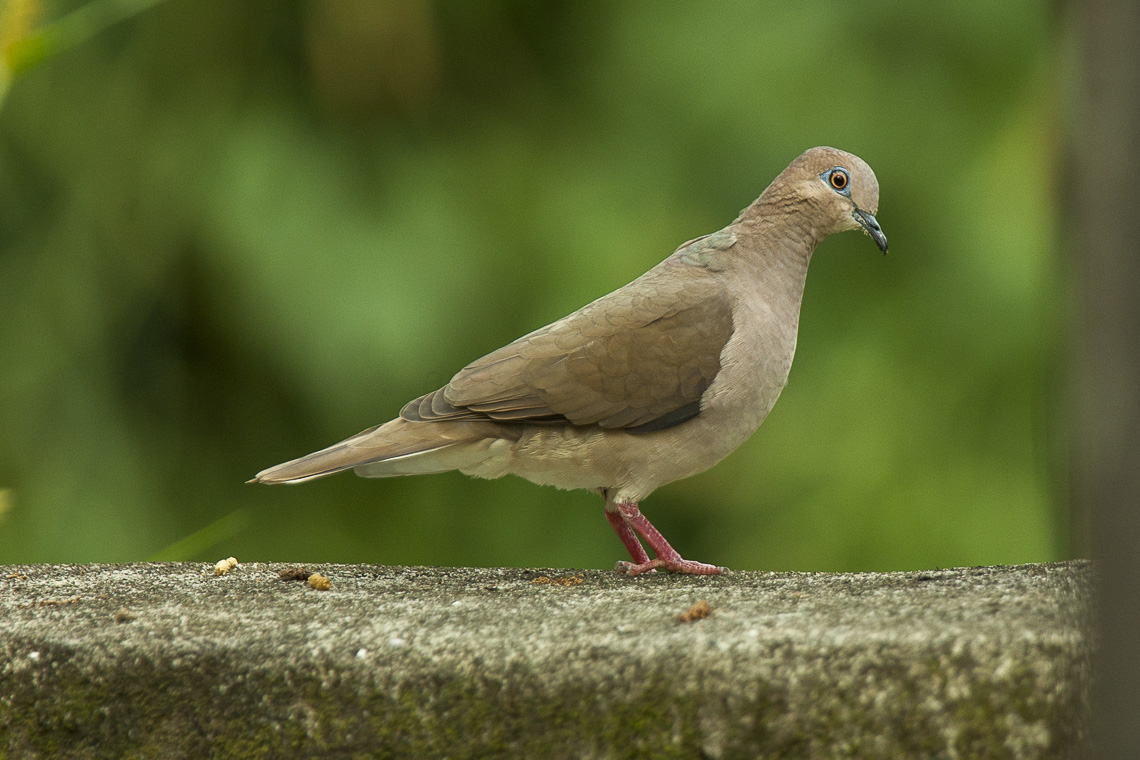
Wikipedia: White-tipped dove Source: OTHER
White-tipped_Dove_-_Panama_H8O8470.jpg
![]() The white-tipped dove (Leptotila verreauxi) is a large New World tropical dove. Its scientific name commemorates the French naturalists Jules and Edouard Verreaux.
[more]
The white-tipped dove (Leptotila verreauxi) is a large New World tropical dove. Its scientific name commemorates the French naturalists Jules and Edouard Verreaux.
[more]
Profile Wikipedia eBird Audubon AllAboutBirds Xeno-Canto

Wikipedia: Mariana fruit-dove Source: OTHER
1200px-Mariana_Fruit_Dove_RWD5.jpg
![]() The Mariana fruit dove (Ptilinopus roseicapilla), also known as mwee’mwe in the Carolinian language, totot on Guam or Paluman totut in Northern Marianas Islands, is a small, up to 24 cm long, green fruit dove native and endemic to Guam and the Northern Marianas Islands in the Pacific. It has a red forehead; greyish head, back and breast; and yellow belly patch and undertail coverts.
[more]
The Mariana fruit dove (Ptilinopus roseicapilla), also known as mwee’mwe in the Carolinian language, totot on Guam or Paluman totut in Northern Marianas Islands, is a small, up to 24 cm long, green fruit dove native and endemic to Guam and the Northern Marianas Islands in the Pacific. It has a red forehead; greyish head, back and breast; and yellow belly patch and undertail coverts.
[more]
Profile Wikipedia eBird Audubon AllAboutBirds Xeno-Canto

Wikipedia: Crimson-crowned fruit-dove Source: OTHER
1200px-PtilopusClementinaeKeulemans.jpg
![]() The crimson-crowned fruit dove (Ptilinopus porphyraceus) is a species of bird in the family Columbidae. It is found in American Samoa, Fiji, Marshall Islands, Niue, Samoa, Tonga, and Wallis and Futuna Islands. Its natural habitats are subtropical or tropical moist lowland forest and subtropical or tropical mangrove forest.
[more]
The crimson-crowned fruit dove (Ptilinopus porphyraceus) is a species of bird in the family Columbidae. It is found in American Samoa, Fiji, Marshall Islands, Niue, Samoa, Tonga, and Wallis and Futuna Islands. Its natural habitats are subtropical or tropical moist lowland forest and subtropical or tropical mangrove forest.
[more]
Profile Wikipedia eBird Audubon AllAboutBirds Xeno-Canto
Wikipedia: Many-colored fruit-dove Source: OTHER
Manycoloured_fruitdove_male_bobbys.JPG
![]() The many-colored fruit dove (Ptilinopus perousii) also known as Manuma in the Samoan language [2][3] is a species of bird in the family Columbidae. It occurs on islands in the south-west Pacific Ocean where it is found in Fiji, the Samoan Islands, and Tonga. Its natural habitat is subtropical or tropical moist lowland forests. Today, most often the birds are found in Fiji and Tonga.[4] It usually feeds high in the canopy on fruit and berries, especially banyan fig. The nest is a small platform of twigs where one or two white eggs is laid.
[more]
The many-colored fruit dove (Ptilinopus perousii) also known as Manuma in the Samoan language [2][3] is a species of bird in the family Columbidae. It occurs on islands in the south-west Pacific Ocean where it is found in Fiji, the Samoan Islands, and Tonga. Its natural habitat is subtropical or tropical moist lowland forests. Today, most often the birds are found in Fiji and Tonga.[4] It usually feeds high in the canopy on fruit and berries, especially banyan fig. The nest is a small platform of twigs where one or two white eggs is laid.
[more]

Wikipedia: White-crowned pigeon Source: OTHER
1200px-White-crowned_Pigeon_%28Patagioenas_leucocephala%29.jpg
![]() The white-crowned pigeon (Patagioenas leucocephala) is a fruit and seed-eating species of bird in the dove and pigeon family Columbidae. It is found primarily in the Caribbean.
[more]
The white-crowned pigeon (Patagioenas leucocephala) is a fruit and seed-eating species of bird in the dove and pigeon family Columbidae. It is found primarily in the Caribbean.
[more]
MerlinBirdID says red-billed pigeon but I'm not convinced, reference pictures are not so light-colored. 2023-04-04 07.18.48 Yucatan
First observed in Yucatan on 2023-04-04.
![]() The red-billed pigeon (Patagioenas flavirostris)[2] is a relatively large, girth-y pigeon which breeds from southern Texas, United States, and northwestern Mexico south to Costa Rica. It belongs to a clade of Patagioenas which generally lack iridescent display plumage, except some vestiges in the pale-vented pigeon.
[more]
The red-billed pigeon (Patagioenas flavirostris)[2] is a relatively large, girth-y pigeon which breeds from southern Texas, United States, and northwestern Mexico south to Costa Rica. It belongs to a clade of Patagioenas which generally lack iridescent display plumage, except some vestiges in the pale-vented pigeon.
[more]

Wikipedia: Band-tailed pigeon Source: OTHER
1200px-Patagioenas_fasciata_-San_Luis_Obispo%2C_California%2C_USA-8_%281%29.jpg
![]() Columba fasciata (Say, 1823)
Columba fasciata (Say, 1823)
Northern band-tailed pigeon (Patagioenas fasciata)
Southern band-tailed pigeon (Patagioenas albilinea)
[more]

Wikipedia: Plain pigeon Source: OTHER
Patagioenas_inornata_wetmorei.jpg
![]() The plain pigeon (Patagioenas inornata) is a species of bird in the family Columbidae. It is found in Cuba, Hispaniola (Dominican Republic and Haiti), Jamaica, and Puerto Rico. Its natural habitats are forest, woodland, coastal desert, mangrove and swampy areas. It is threatened by habitat loss.
[more]
The plain pigeon (Patagioenas inornata) is a species of bird in the family Columbidae. It is found in Cuba, Hispaniola (Dominican Republic and Haiti), Jamaica, and Puerto Rico. Its natural habitats are forest, woodland, coastal desert, mangrove and swampy areas. It is threatened by habitat loss.
[more]
Profile Wikipedia eBird Audubon AllAboutBirds Xeno-Canto
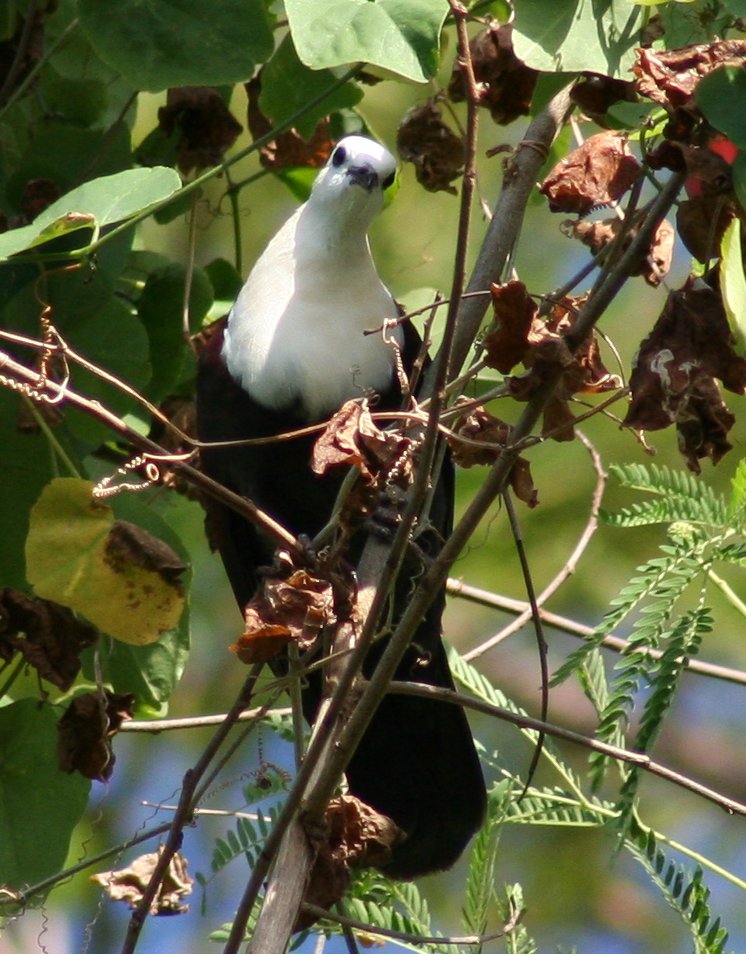
Wikipedia: White-throated ground-dove Source: OTHER
White-Throated_Ground-Dove_wild.jpg
![]() The white-throated ground dove (Pampusana xanthonura) is a species of ground dove in the genus Gallicolumba. It is classified as near-threatened.
[more]
The white-throated ground dove (Pampusana xanthonura) is a species of ground dove in the genus Gallicolumba. It is classified as near-threatened.
[more]
Profile Wikipedia eBird Audubon AllAboutBirds Xeno-Canto

Wikipedia: Shy ground-dove Source: OTHER
1200px-CaloenasStairiWolf.jpg
![]() The Tongan ground dove (Pampusana stairi), also known as the shy ground dove or friendly ground dove, is a species of bird in the family Columbidae.
It is found in American Samoa, Fiji, Samoa, Tonga and Wallis and Futuna Islands.
Its natural habitat is subtropical or tropical moist lowland forests.
It is threatened by habitat loss.
[more]
The Tongan ground dove (Pampusana stairi), also known as the shy ground dove or friendly ground dove, is a species of bird in the family Columbidae.
It is found in American Samoa, Fiji, Samoa, Tonga and Wallis and Futuna Islands.
Its natural habitat is subtropical or tropical moist lowland forests.
It is threatened by habitat loss.
[more]

Wikipedia: Collared kingfisher Source: OTHER
1200px-Todiramphus_chloris_2_-_Laem_Phak_Bia.jpg
This bird appears across the great seas in the following continents:
North America, Africa, Asia, Australia.
![]() The collared kingfisher (Todiramphus chloris) is a medium-sized kingfisher belonging to the subfamily Halcyoninae, the tree kingfishers. It is also known as the white-collared kingfisher or mangrove kingfisher. It has a wide range extending from the Red Sea across southern Asia to Polynesia. A number of subspecies and subspecies groups have been split from this species including the Pacific kingfisher, the islet kingfisher, the Torresian kingfisher, the Mariana kingfisher, and the Melanesian kingfisher.
[more]
The collared kingfisher (Todiramphus chloris) is a medium-sized kingfisher belonging to the subfamily Halcyoninae, the tree kingfishers. It is also known as the white-collared kingfisher or mangrove kingfisher. It has a wide range extending from the Red Sea across southern Asia to Polynesia. A number of subspecies and subspecies groups have been split from this species including the Pacific kingfisher, the islet kingfisher, the Torresian kingfisher, the Mariana kingfisher, and the Melanesian kingfisher.
[more]

Wikipedia: Mariana kingfisher Source: OTHER
Todiramphus_chloris_-flying_-lizard_in_beak-8.jpg
![]() The Mariana kingfisher (Todiramphus albicilla) is a species of bird in the family Alcedinidae. It is endemic to the Northern Mariana Islands. Its natural habitats are subtropical or tropical moist lowland forests and plantations. It was formerly considered a subspecies of the collared kingfisher.
[more]
The Mariana kingfisher (Todiramphus albicilla) is a species of bird in the family Alcedinidae. It is endemic to the Northern Mariana Islands. Its natural habitats are subtropical or tropical moist lowland forests and plantations. It was formerly considered a subspecies of the collared kingfisher.
[more]

Wikipedia: Pacific kingfisher Source: OTHER
Collaredkingfishermale_fiji.jpg
![]() The Pacific kingfisher (Todiramphus sacer) is a medium-sized kingfisher belonging to the subfamily Halcyoninae, the tree kingfishers. It has a wide range throughout the South Pacific islands. It was previously considered a subspecies of the collared kingfisher.
[more]
The Pacific kingfisher (Todiramphus sacer) is a medium-sized kingfisher belonging to the subfamily Halcyoninae, the tree kingfishers. It has a wide range throughout the South Pacific islands. It was previously considered a subspecies of the collared kingfisher.
[more]

Wikipedia: Green kingfisher Source: OTHER
1200px-Green_kingfisher_%28Chloroceryle_americana_americana%29_male.jpg
![]() The green kingfisher (Chloroceryle americana) is a resident breeding bird which occurs from southern Texas in the United States south through Central and South America to central Argentina.
[more]
The green kingfisher (Chloroceryle americana) is a resident breeding bird which occurs from southern Texas in the United States south through Central and South America to central Argentina.
[more]

Wikipedia: Belted kingfisher Source: OTHER
1200px-Belted_Kingfisher.jpg
![]() The belted kingfisher (Megaceryle alcyon) is a large, conspicuous water kingfisher. It is depicted on the 1986 series Canadian $5 note. All kingfishers were formerly placed in one family, Alcedinidae, but recent research suggests that this should be divided into three subfamilies.
[more]
The belted kingfisher (Megaceryle alcyon) is a large, conspicuous water kingfisher. It is depicted on the 1986 series Canadian $5 note. All kingfishers were formerly placed in one family, Alcedinidae, but recent research suggests that this should be divided into three subfamilies.
[more]

Wikipedia: Ringed kingfisher Source: OTHER
1200px-MARTIM-PESCADOR-GRANDE_%28Megaceryle_torquata%29.jpg
![]() The ringed kingfisher (Megaceryle torquata) is a large, conspicuous and noisy kingfisher bird commonly found along the lower Rio Grande valley in southeasternmost Texas in the United States through Central America to Tierra del Fuego in South America.[4]
[more]
The ringed kingfisher (Megaceryle torquata) is a large, conspicuous and noisy kingfisher bird commonly found along the lower Rio Grande valley in southeasternmost Texas in the United States through Central America to Tierra del Fuego in South America.[4]
[more]
Profile Wikipedia eBird Vogelwarte BirdLife ZH ornitho.ch bird-song.ch Audubon AllAboutBirds Xeno-Canto BirdID NABU
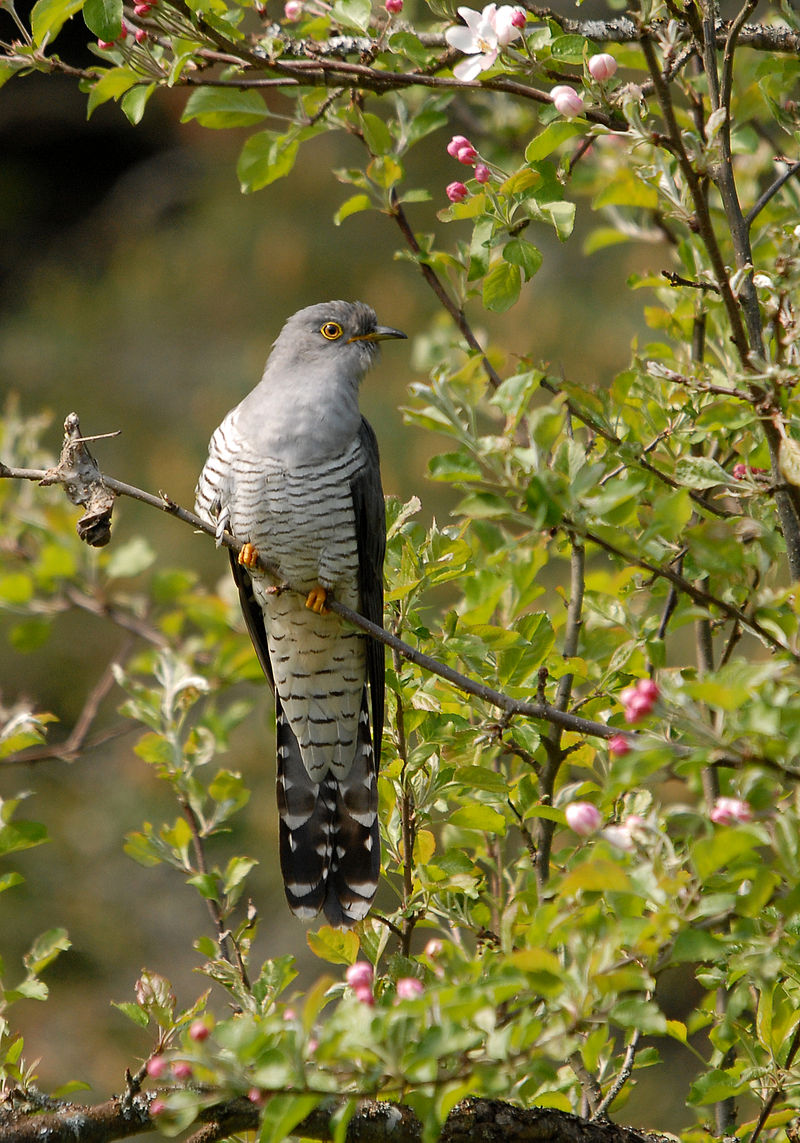
Wikipedia Kuckuck, Cuculus canorus. Von Locaguapa - Eigenes Werk, CC BY-SA 3.0, Link Source: WIKIPEDIA
Wikipedia Kuckuck, Cuculus canorus.jpg
First observed in 🇨🇭 on 2021-05-04.
This bird appears across the great seas in the following continents:
Europe, North America, Africa.
Geography: ![]() A common migratory bird across most of Europe and Asia, it regularly strays to the western Alaskan islands in late spring and early summer. [Link]
A common migratory bird across most of Europe and Asia, it regularly strays to the western Alaskan islands in late spring and early summer. [Link]
Song: ![]() Männchen: Unverwechselbarer Ruf. Weibchen: im Frühling eine kichernde Rufreihe,
[Link]
Männchen: Unverwechselbarer Ruf. Weibchen: im Frühling eine kichernde Rufreihe,
[Link]
![]() Song: the well known disyllabic "cuck-coo" with emphasis on first note, and the second note a third lower than the first one. Also a harsh "tchaa tchaa", and a bubbly trill, reminiscent of Little Grebe, uttered by the female. [Link]
Song: the well known disyllabic "cuck-coo" with emphasis on first note, and the second note a third lower than the first one. Also a harsh "tchaa tchaa", and a bubbly trill, reminiscent of Little Grebe, uttered by the female. [Link]
Calls: ![]() wie „kwickkwickkwick“, 6-8 dicht gereihte, fast metallisch klingende Laute, von unten her angeschlagen. Jungkuckucke betteln durchdringend „ssrieb“
[Link]
wie „kwickkwickkwick“, 6-8 dicht gereihte, fast metallisch klingende Laute, von unten her angeschlagen. Jungkuckucke betteln durchdringend „ssrieb“
[Link]
Physical details: length=32-34 cm,
wingspan=55-60 cm,
weight=95-140 g
Habitats:
Forest
Song:
Two-noter
Song attributes:
Melody: simple rhythmic, slow, Frequency: 0-1 KHz
Call:
Automatically generated from Xeno-Canto recording
♫ XC801215 - Common Cuckoo - Cuculus canorus. Source: XENOCANTO
XC801215 - Common Cuckoo - Cuculus canorus.mp3
(song?)
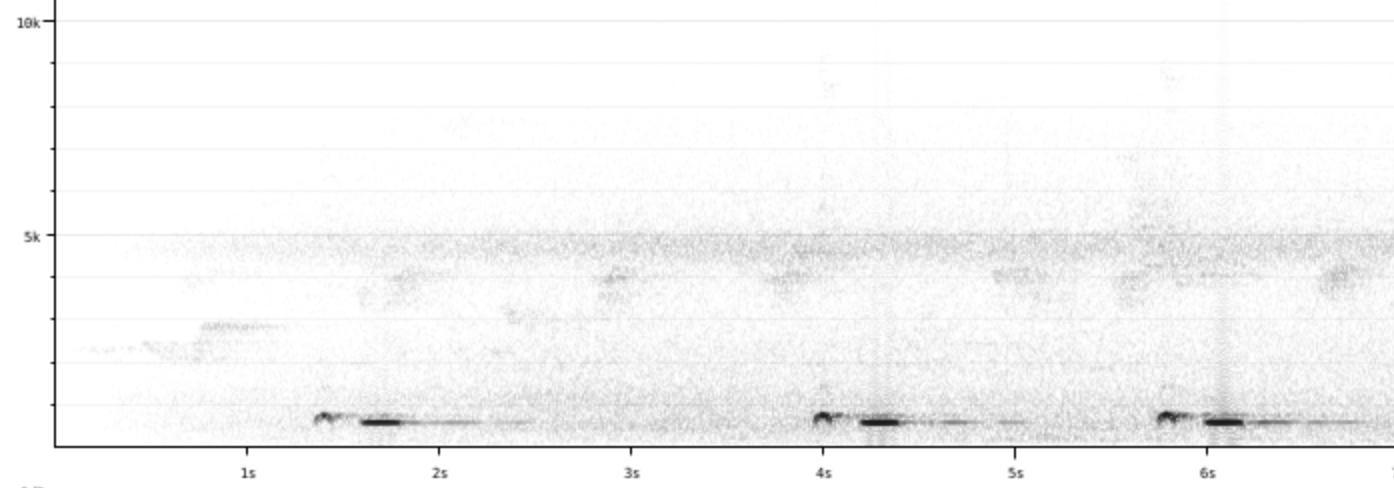
Profile Wikipedia eBird Audubon AllAboutBirds Xeno-Canto
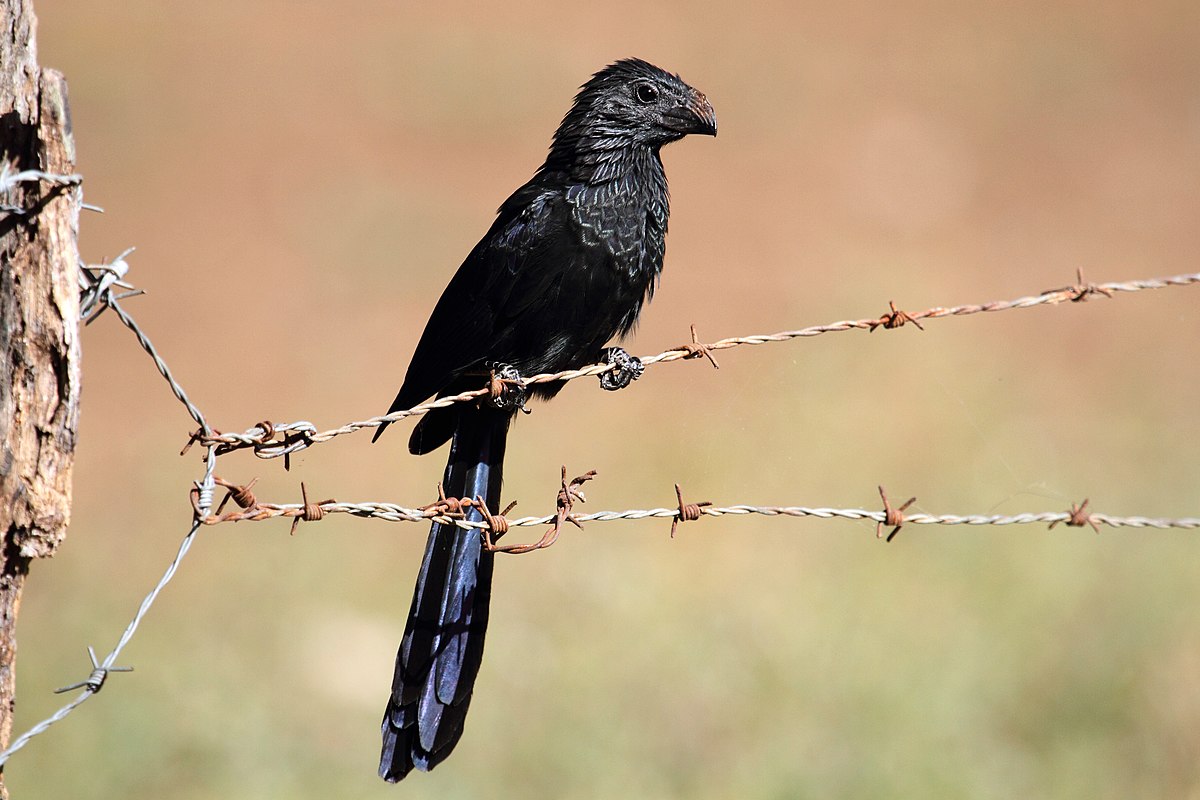
Wikipedia: Groove-billed ani Source: OTHER
1200px-Crotophaga_sulcirostris_CR_bis.JPG
General: ![]() The groove-billed ani (Crotophaga sulcirostris) is a tropical bird in the cuckoo family with a long tail and a large, curved beak. It is a resident species throughout most of its range, from southern Texas, central Mexico and The Bahamas, through Central America, to northern Colombia and Venezuela, and coastal Ecuador and Peru. It only retreats from the northern limits of its range in Texas and northern Mexico during winter.
[more]
The groove-billed ani (Crotophaga sulcirostris) is a tropical bird in the cuckoo family with a long tail and a large, curved beak. It is a resident species throughout most of its range, from southern Texas, central Mexico and The Bahamas, through Central America, to northern Colombia and Venezuela, and coastal Ecuador and Peru. It only retreats from the northern limits of its range in Texas and northern Mexico during winter.
[more]
Profile Wikipedia eBird Audubon AllAboutBirds Xeno-Canto
Smooth-billed ani. 2023-04-16 06.25.20 Yucatan
First observed in Yucatan on 2023-04-16.
![]() The smooth-billed ani (Crotophaga ani) is a large near passerine bird in the cuckoo family. It is a resident breeding species from southern Florida, the Caribbean, parts of Central America, south to western Ecuador, Brazil, northern Argentina and southern Chile.[2] It was introduced to Galápagos around the 1960s and is potentially impacting native and endemic species across the archipelago.[3]
[more]
The smooth-billed ani (Crotophaga ani) is a large near passerine bird in the cuckoo family. It is a resident breeding species from southern Florida, the Caribbean, parts of Central America, south to western Ecuador, Brazil, northern Argentina and southern Chile.[2] It was introduced to Galápagos around the 1960s and is potentially impacting native and endemic species across the archipelago.[3]
[more]
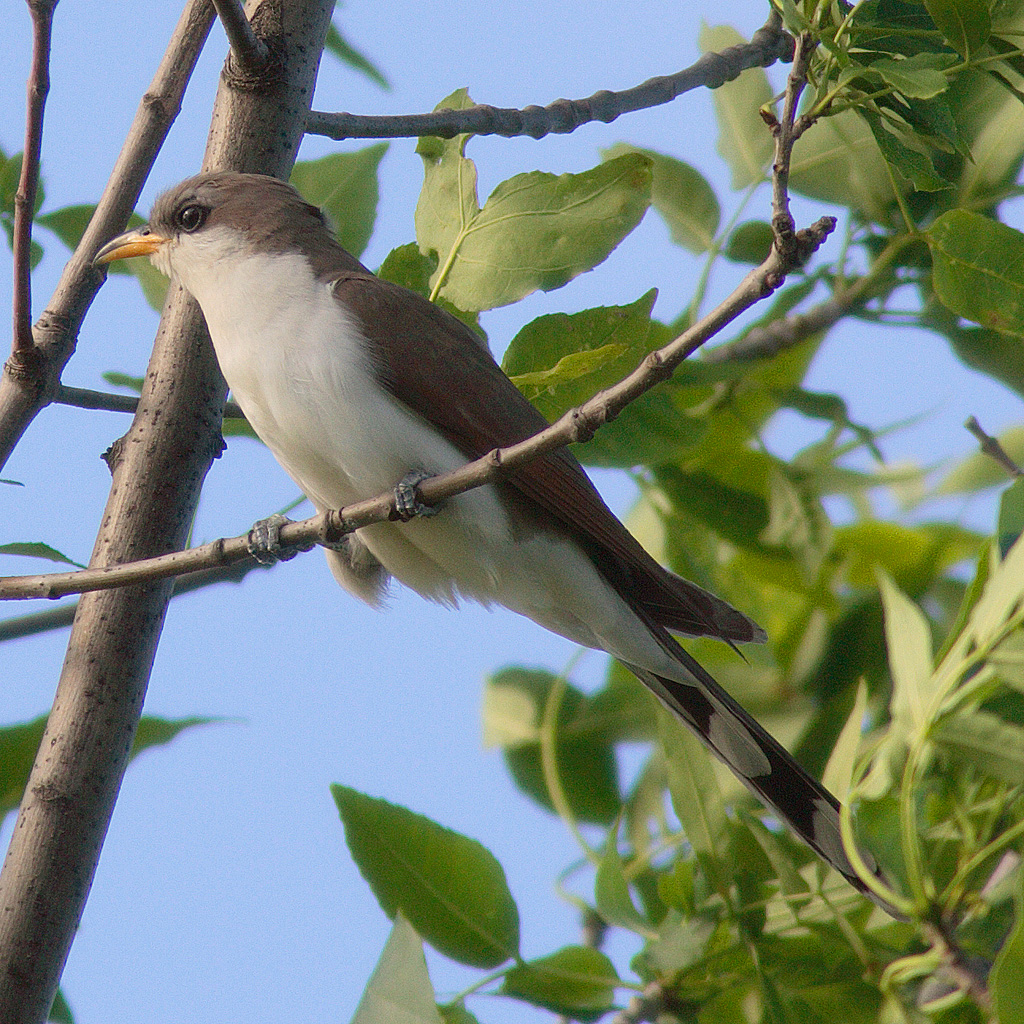
Wikipedia: Yellow-billed cuckoo Source: OTHER
Coccyzus-americanus-001.jpg
![]() The yellow-billed cuckoo (Coccyzus americanus) is a cuckoo. Common folk-names for this bird in the southern United States are rain crow and storm crow. These likely refer to the bird's habit of calling on hot days, often presaging rain or thunderstorms.
[more]
The yellow-billed cuckoo (Coccyzus americanus) is a cuckoo. Common folk-names for this bird in the southern United States are rain crow and storm crow. These likely refer to the bird's habit of calling on hot days, often presaging rain or thunderstorms.
[more]
Profile Wikipedia eBird Audubon AllAboutBirds Xeno-Canto

Wikipedia: Mangrove cuckoo Source: OTHER
1200px-Mangrove_Cuckoo.jpg
![]() The mangrove cuckoo (Coccyzus minor) is a species of cuckoo that is native to the Neotropics.
[more]
The mangrove cuckoo (Coccyzus minor) is a species of cuckoo that is native to the Neotropics.
[more]
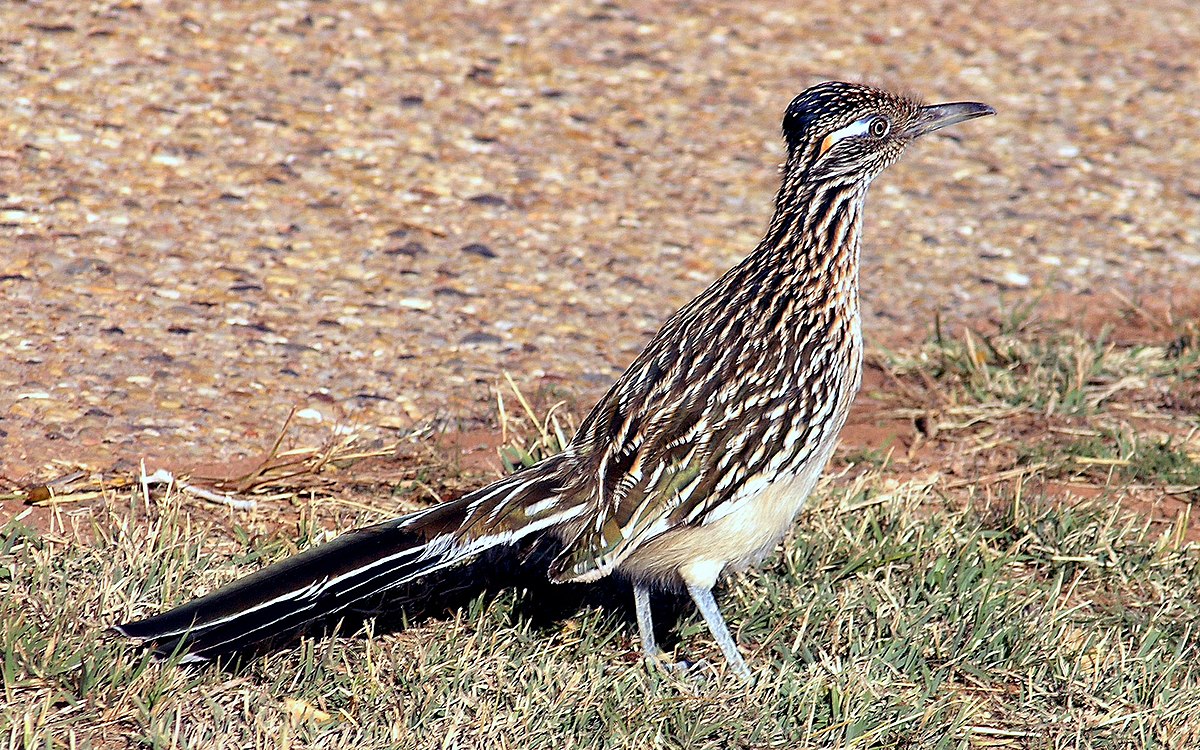
Wikipedia: Greater roadrunner Source: OTHER
1200px-Geococcyx_californianus.jpg
![]() The greater roadrunner (Geococcyx californianus) is a long-legged bird in the cuckoo family, Cuculidae, from the Aridoamerica region in the Southwestern United States and Mexico. The scientific name means "Californian earth-cuckoo". Along with the lesser roadrunner, it is one of two species in the genus Geococcyx. This roadrunner is also known as the chaparral cock, ground cuckoo, and snake killer.[3]
[more]
The greater roadrunner (Geococcyx californianus) is a long-legged bird in the cuckoo family, Cuculidae, from the Aridoamerica region in the Southwestern United States and Mexico. The scientific name means "Californian earth-cuckoo". Along with the lesser roadrunner, it is one of two species in the genus Geococcyx. This roadrunner is also known as the chaparral cock, ground cuckoo, and snake killer.[3]
[more]

Wikipedia: Peregrine falcon Source: OTHER
Falco_peregrinus_good_-_Christopher_Watson.jpg
This bird appears across the great seas in the following continents:
Europe, North America, South America, Africa, Asia.
![]() The peregrine falcon (Falco peregrinus), also known as the peregrine,[2] and historically as the duck hawk in North America,[3] is a widespread bird of prey (raptor) in the family Falconidae. A large, crow-sized falcon, it has a blue-grey back, barred white underparts, and a black head. The peregrine is renowned for its speed, reaching over 320 km/h (200 mph) during its characteristic hunting stoop (high-speed dive),[4] making it the fastest bird in the world, as well as the fastest member of the animal kingdom.[5][6][7] According to a National Geographic TV program, the highest measured speed of a peregrine falcon is 389 km/h (242 mph).[8][9] As is typical for bird-eating raptors, peregrine falcons are sexually dimorphic, with females being considerably larger than males.[10][11]
[more]
The peregrine falcon (Falco peregrinus), also known as the peregrine,[2] and historically as the duck hawk in North America,[3] is a widespread bird of prey (raptor) in the family Falconidae. A large, crow-sized falcon, it has a blue-grey back, barred white underparts, and a black head. The peregrine is renowned for its speed, reaching over 320 km/h (200 mph) during its characteristic hunting stoop (high-speed dive),[4] making it the fastest bird in the world, as well as the fastest member of the animal kingdom.[5][6][7] According to a National Geographic TV program, the highest measured speed of a peregrine falcon is 389 km/h (242 mph).[8][9] As is typical for bird-eating raptors, peregrine falcons are sexually dimorphic, with females being considerably larger than males.[10][11]
[more]
Vocalization: ![]() A harsh, drawn out "kiaaaa" with emphasised endings repeated in series. Much slower than Merlin, but higher pitched than Gyrfalcon. [Link]
A harsh, drawn out "kiaaaa" with emphasised endings repeated in series. Much slower than Merlin, but higher pitched than Gyrfalcon. [Link]
Calls: ![]() Also shorter, coarse warning-calls. [Link]
Also shorter, coarse warning-calls. [Link]
Physical details: length=36-48 cm,
wingspan=95-110 cm,
weight=582-1300 g
Habitats:
Agricultural

Merlin SoundID bird list. Source: OTHER
Merlin SoundID bird list.jpg
This bird appears across the great seas in the following continents:
Europe, North America, South America, Africa.
Deutschland: Zugvogel, Wintergast
Vocalization: ![]() Series of harsh "kwik-wik wik". Coarseness similar to Peregrine, but pace much quicker. [Link]
Series of harsh "kwik-wik wik". Coarseness similar to Peregrine, but pace much quicker. [Link]
Calls: ![]() Female call harsher than male. Lacking the clearer tones and attack of Kestrel. [Link]
Female call harsher than male. Lacking the clearer tones and attack of Kestrel. [Link]
Physical details: length=25-30 cm,
wingspan=50-62 cm,
weight=125-300 g
Habitats:
Agricultural
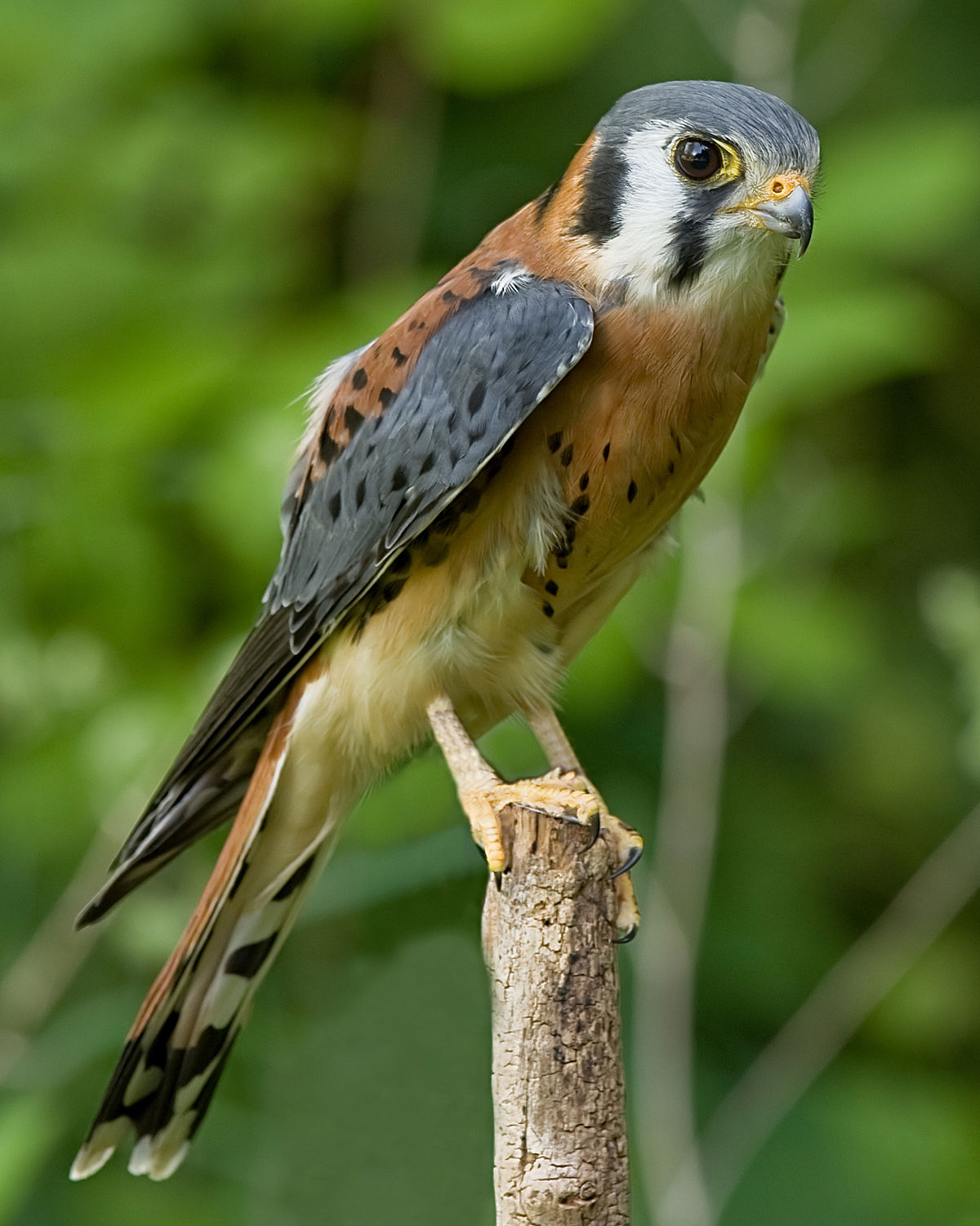
Wikipedia: American kestrel Source: OTHER
1200px-AmericanKestrel02.jpg
General: ![]() The American kestrel (Falco sparverius), also called the sparrow hawk, is the smallest and most common falcon in North America. It has a roughly two-to-one range in size over subspecies and sex, varying in size from about the weight of a blue jay to a mourning dove. It also ranges to South America and is a well-established species that has evolved into 17 subspecies adapted to different environments and habitats throughout the Americas. It exhibits sexual dimorphism in size (females being moderately larger) and plumage, although both sexes have a rufous back with noticeable barring. Its plumage is colorful and attractive, and juveniles are similar in plumage to adults.
[more]
The American kestrel (Falco sparverius), also called the sparrow hawk, is the smallest and most common falcon in North America. It has a roughly two-to-one range in size over subspecies and sex, varying in size from about the weight of a blue jay to a mourning dove. It also ranges to South America and is a well-established species that has evolved into 17 subspecies adapted to different environments and habitats throughout the Americas. It exhibits sexual dimorphism in size (females being moderately larger) and plumage, although both sexes have a rufous back with noticeable barring. Its plumage is colorful and attractive, and juveniles are similar in plumage to adults.
[more]
Profile Wikipedia eBird Audubon AllAboutBirds Xeno-Canto BirdID NABU
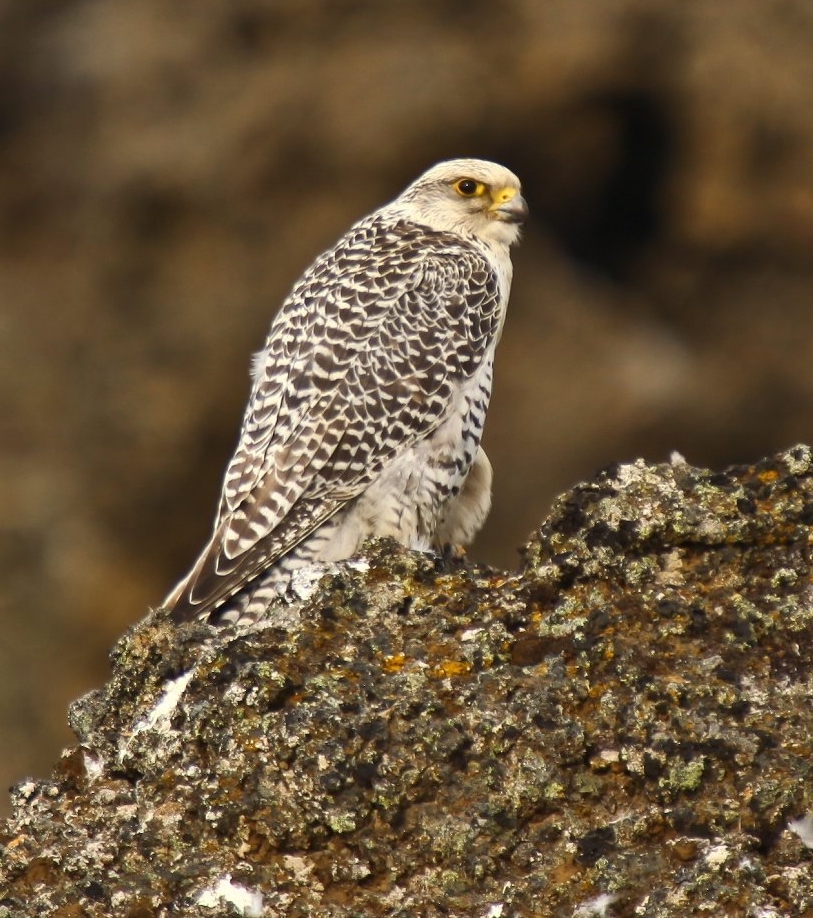
Wikipedia: Gyrfalcon Source: OTHER
Falco_rusticolus_white_cropped.jpg
This bird appears across the great seas in the following continents:
Europe, North America.
![]() The gyrfalcon (/ˈdʒɜːrfɔːlkən/ or /ˈdʒɜːrfælkən/) (Falco rusticolus), the largest of the falcon species, is a bird of prey. The abbreviation gyr is also used.[2] It breeds on Arctic coasts and tundra, and the islands of northern North America and the Eurosiberian region. It is mainly a resident there also, but some gyrfalcons disperse more widely after the breeding season, or in winter. Individual vagrancy can take birds for long distances. Its plumage varies with location, with birds being coloured from all-white to dark brown. These colour variations are called morphs. Like other falcons, it shows sexual dimorphism, with the female much larger than the male. For centuries, the gyrfalcon has been valued as a hunting bird. Typical prey includes the ptarmigan and waterfowl, which it may take in flight; it also takes fish and mammals.
[more]
The gyrfalcon (/ˈdʒɜːrfɔːlkən/ or /ˈdʒɜːrfælkən/) (Falco rusticolus), the largest of the falcon species, is a bird of prey. The abbreviation gyr is also used.[2] It breeds on Arctic coasts and tundra, and the islands of northern North America and the Eurosiberian region. It is mainly a resident there also, but some gyrfalcons disperse more widely after the breeding season, or in winter. Individual vagrancy can take birds for long distances. Its plumage varies with location, with birds being coloured from all-white to dark brown. These colour variations are called morphs. Like other falcons, it shows sexual dimorphism, with the female much larger than the male. For centuries, the gyrfalcon has been valued as a hunting bird. Typical prey includes the ptarmigan and waterfowl, which it may take in flight; it also takes fish and mammals.
[more]
Vocalization: ![]() A coarse, drawn out, Peregrine-like "kaaawt", with emphasis on ending, is repeated in series. Much slower paced than in small falcons, and deeper and with different attack than in Peregrine. [Link]
A coarse, drawn out, Peregrine-like "kaaawt", with emphasis on ending, is repeated in series. Much slower paced than in small falcons, and deeper and with different attack than in Peregrine. [Link]
Calls: ![]() Also shorter, coarse warning-calls. [Link]
Also shorter, coarse warning-calls. [Link]
Physical details: length=50-60 cm,
wingspan=130-160 cm,
weight=805-2100 g
Profile Wikipedia eBird Audubon AllAboutBirds Xeno-Canto

Wikipedia: Aplomado falcon Source: OTHER
Aplomado_Falcon_portrait.jpg
General: ![]() The aplomado falcon (Falco femoralis) is a medium-sized falcon of the Americas. The species' largest contiguous range is in South America, but not in the deep interior Amazon Basin. It was long known as Falco fusco-coerulescens or Falco fuscocaerulescens, but these names are now believed to refer to the bat falcon (F. rufigularis).[2] Its resemblance in shape to the hobbies accounts for its old name orange-chested hobby. Aplomado is an unusual Spanish word for "lead-colored", referring to the blue-grey areas of the plumage – an approximate English translation would be "plumbeous falcon". Spanish names for the species include halcón aplomado and halcón fajado (roughly "banded falcon" in reference to the characteristic pattern); in Brazil it is known as falcão-de-coleira.
[more]
The aplomado falcon (Falco femoralis) is a medium-sized falcon of the Americas. The species' largest contiguous range is in South America, but not in the deep interior Amazon Basin. It was long known as Falco fusco-coerulescens or Falco fuscocaerulescens, but these names are now believed to refer to the bat falcon (F. rufigularis).[2] Its resemblance in shape to the hobbies accounts for its old name orange-chested hobby. Aplomado is an unusual Spanish word for "lead-colored", referring to the blue-grey areas of the plumage – an approximate English translation would be "plumbeous falcon". Spanish names for the species include halcón aplomado and halcón fajado (roughly "banded falcon" in reference to the characteristic pattern); in Brazil it is known as falcão-de-coleira.
[more]
Profile Wikipedia eBird Audubon AllAboutBirds Xeno-Canto
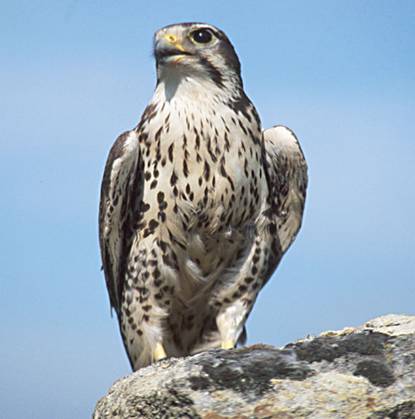
Wikipedia: Prairie falcon Source: OTHER
USGS_Prairie_Falcon.jpg
![]() The prairie falcon (Falco mexicanus) is a medium-large sized falcon of western North America. It is about the size of a peregrine falcon or a crow, with an average length of 40 cm (16 in), wingspan of approximately 1 meter (40 in), and average weight of 720 g (1.6 lb). As in all falcons, females are noticeably bigger than males. Though a separate species from the peregrine, the prairie falcon is basically an arid environment adaptation of the early peregrine falcon lineage, able to subsist on less food than the peregrine,[2] and generally lighter in weight than a peregrine of similar wing span. Having evolved in a harsh desert environment with low prey density, the prairie falcon has developed into an aggressive and opportunistic hunter of a wide range of both mammal and bird prey.[3] It will regularly take prey from the size of sparrows to approximately its own weight, and occasionally much larger. It is the only larger falcon native only to North America. It is resident from southern Canada, through western United States, and into northern Mexico. The prairie falcon is popular as a falconry bird, where with proper training it is regarded as being as effective as the more well known peregrine falcon.
[more]
The prairie falcon (Falco mexicanus) is a medium-large sized falcon of western North America. It is about the size of a peregrine falcon or a crow, with an average length of 40 cm (16 in), wingspan of approximately 1 meter (40 in), and average weight of 720 g (1.6 lb). As in all falcons, females are noticeably bigger than males. Though a separate species from the peregrine, the prairie falcon is basically an arid environment adaptation of the early peregrine falcon lineage, able to subsist on less food than the peregrine,[2] and generally lighter in weight than a peregrine of similar wing span. Having evolved in a harsh desert environment with low prey density, the prairie falcon has developed into an aggressive and opportunistic hunter of a wide range of both mammal and bird prey.[3] It will regularly take prey from the size of sparrows to approximately its own weight, and occasionally much larger. It is the only larger falcon native only to North America. It is resident from southern Canada, through western United States, and into northern Mexico. The prairie falcon is popular as a falconry bird, where with proper training it is regarded as being as effective as the more well known peregrine falcon.
[more]

Wikipedia: Crested caracara Source: OTHER
1200px-Schopfkarakara.jpg
![]() The crested caracara (Caracara plancus), is a bird of prey in the family Falconidae. As presently defined, the crested caracara is found in South America, the southern United States, including Florida, where it has been seen on the East coast as far as extreme eastern Seminole County, Florida (Lake Harney), where it is now considered a resident but listed as threatened. There have been reports of the crested caracara as far north as San Francisco, California.[2] and, in 2012, near Crescent City, California.[3] Some are believed to possibly be living in Nova Scotia, with numerous sightings throughout the 2010s.[4] In July 2016 a northern caracara was reported and photographed by numerous people in the upper peninsula of Michigan, just outside of Munising.[5][6][7] In June 2017, a northern caracara was sighted far north in St. George, New Brunswick, Canada.[8] A specimen was photographed in Woodstock, Vermont in March 2020.[citation needed] The species has recently become more common in central and north Texas and is generally common in south Texas and south of the US border.[citation needed] It can also be found (nesting) in the Southern Caribbean (e.g. Aruba, Curaçao and Bonaire)[citation needed], Mexico, and Central America. It was formerly placed in the genus Polyborus.
[more]
The crested caracara (Caracara plancus), is a bird of prey in the family Falconidae. As presently defined, the crested caracara is found in South America, the southern United States, including Florida, where it has been seen on the East coast as far as extreme eastern Seminole County, Florida (Lake Harney), where it is now considered a resident but listed as threatened. There have been reports of the crested caracara as far north as San Francisco, California.[2] and, in 2012, near Crescent City, California.[3] Some are believed to possibly be living in Nova Scotia, with numerous sightings throughout the 2010s.[4] In July 2016 a northern caracara was reported and photographed by numerous people in the upper peninsula of Michigan, just outside of Munising.[5][6][7] In June 2017, a northern caracara was sighted far north in St. George, New Brunswick, Canada.[8] A specimen was photographed in Woodstock, Vermont in March 2020.[citation needed] The species has recently become more common in central and north Texas and is generally common in south Texas and south of the US border.[citation needed] It can also be found (nesting) in the Southern Caribbean (e.g. Aruba, Curaçao and Bonaire)[citation needed], Mexico, and Central America. It was formerly placed in the genus Polyborus.
[more]
Our first caribbean flamingos at Las Colorados - closeup. 2023-04-15 09.33.10 Yucatan
First observed in Yucatan on 2023-04-15.
![]() The American flamingo (Phoenicopterus ruber) is a large species of flamingo closely related to the greater flamingo and Chilean flamingo native to the Neotropics. It was formerly considered conspecific with the greater flamingo, but that treatment is now widely viewed (e.g. by the American and British Ornithologists' Unions) as incorrect due to a lack of evidence. It is also known as the Caribbean flamingo, although it is also present in the Galápagos Islands. It is the only flamingo that naturally inhabits North America.
[more]
The American flamingo (Phoenicopterus ruber) is a large species of flamingo closely related to the greater flamingo and Chilean flamingo native to the Neotropics. It was formerly considered conspecific with the greater flamingo, but that treatment is now widely viewed (e.g. by the American and British Ornithologists' Unions) as incorrect due to a lack of evidence. It is also known as the Caribbean flamingo, although it is also present in the Galápagos Islands. It is the only flamingo that naturally inhabits North America.
[more]
Profile Wikipedia eBird A-Z Animals Audubon AllAboutBirds Xeno-Canto
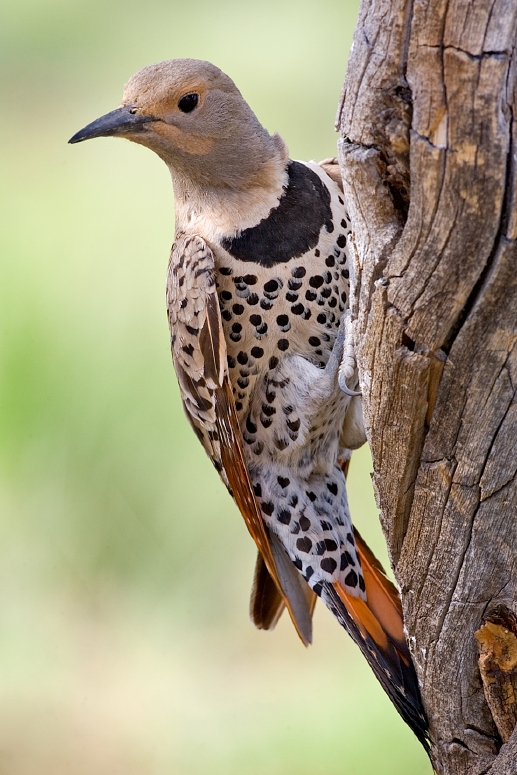
Wikipedia: Northern flicker Source: OTHER
Northern_Flicker.jpg
First observed in Maryland on 2022-04-29.
![]() The northern flicker (Colaptes auratus) or common flicker is a medium-sized bird of the woodpecker family. It is native to most of North America, parts of Central America, Cuba, and the Cayman Islands, and is one of the few woodpecker species that migrate. Over 100 common names for the northern flicker are known, including yellowhammer (not to be confused with the Eurasian yellowhammer), clape, gaffer woodpecker, harry-wicket[citation needed], heigh-ho, wake-up, walk-up, wick-up, yarrup, and gawker bird. Many of these names derive from attempts to imitate some of its calls.
[more]
The northern flicker (Colaptes auratus) or common flicker is a medium-sized bird of the woodpecker family. It is native to most of North America, parts of Central America, Cuba, and the Cayman Islands, and is one of the few woodpecker species that migrate. Over 100 common names for the northern flicker are known, including yellowhammer (not to be confused with the Eurasian yellowhammer), clape, gaffer woodpecker, harry-wicket[citation needed], heigh-ho, wake-up, walk-up, wick-up, yarrup, and gawker bird. Many of these names derive from attempts to imitate some of its calls.
[more]
Call:
Automatically generated from Xeno-Canto recording
♫ Source: BirdNet
20220429_122229 birdnet - Northern Flicker - Northern Flicker - Baltimore.mp3
2022-04-29 12.22.29 Maryland (song?)
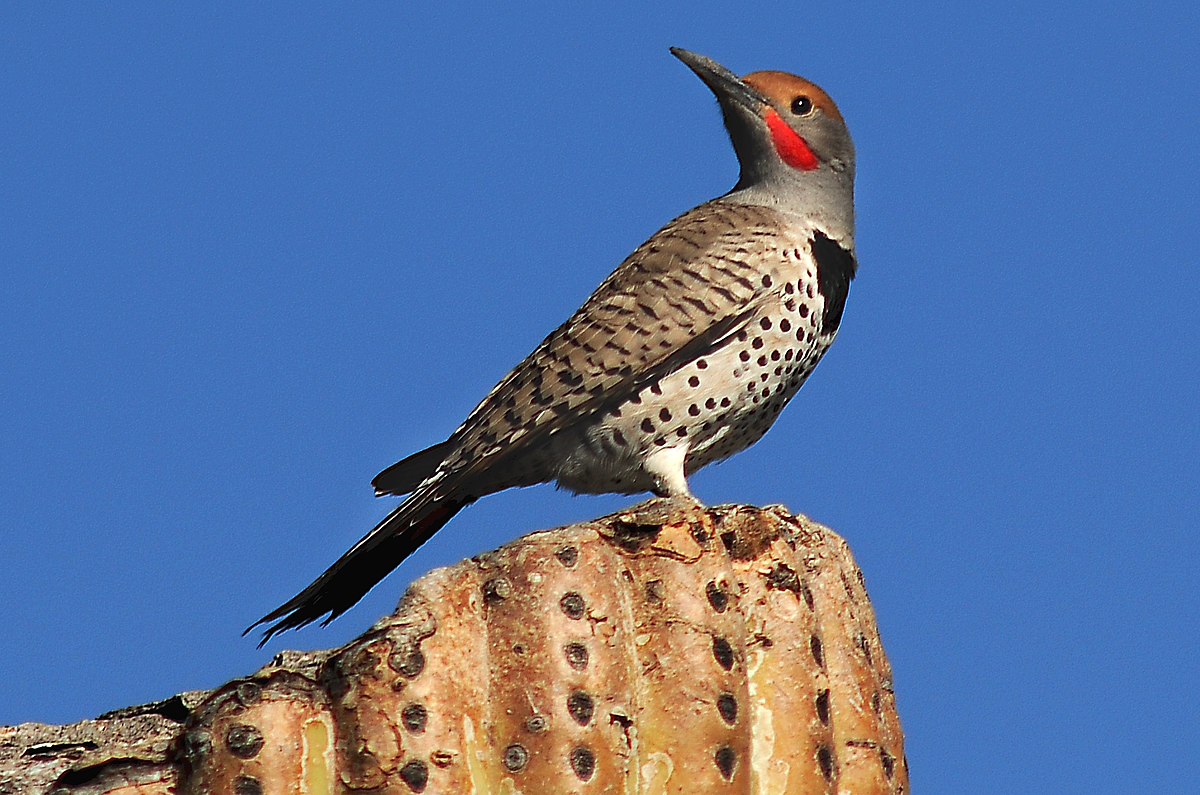
Wikipedia: Gilded flicker Source: OTHER
1200px-Gilded_Flicker_%28Colaptes_chrysoides%29_on_top_of_cactus.jpg
![]() The gilded flicker (Colaptes chrysoides) is a large-sized woodpecker (mean length of 29 cm (11 in)) of the Sonoran, Yuma, and eastern Colorado Desert regions of the southwestern United States and northwestern Mexico, including all of Baja California, except the extreme northwestern region. Golden-yellow underwings distinguish the gilded flicker from the northern flicker found within the same region, which has red underwings.
[more]
The gilded flicker (Colaptes chrysoides) is a large-sized woodpecker (mean length of 29 cm (11 in)) of the Sonoran, Yuma, and eastern Colorado Desert regions of the southwestern United States and northwestern Mexico, including all of Baja California, except the extreme northwestern region. Golden-yellow underwings distinguish the gilded flicker from the northern flicker found within the same region, which has red underwings.
[more]
Profile Wikipedia eBird Audubon AllAboutBirds Xeno-Canto

Wikipedia: American three-toed woodpecker Source: OTHER
American_Three-toed_Woodpecker_-_Picoides_dorsalis_%28Male%29.jpg
![]() The American three-toed woodpecker (Picoides dorsalis) is a medium-sized woodpecker (family Picidae), which is native to North America.
[more]
The American three-toed woodpecker (Picoides dorsalis) is a medium-sized woodpecker (family Picidae), which is native to North America.
[more]
Profile Wikipedia eBird Audubon AllAboutBirds Xeno-Canto

Wikipedia: Black-backed woodpecker Source: OTHER
1200px-Picoides_arcticus_-Brunswick%2C_Vermont%2C_USA_-male-8.jpg
![]() The black-backed woodpecker (Picoides arcticus), also known as the Arctic three-toed woodpecker is a medium-sized woodpecker (23 cm (9.1 in) long) inhabiting the forests of North America.
[more]
The black-backed woodpecker (Picoides arcticus), also known as the Arctic three-toed woodpecker is a medium-sized woodpecker (23 cm (9.1 in) long) inhabiting the forests of North America.
[more]
Profile Wikipedia eBird A-Z Animals Audubon AllAboutBirds Xeno-Canto
Pileated woodpecker. 2023-10-13 16.06.56 New England
First observed in Cockeysville on 2022-05-05.
![]() The pileated woodpecker (Dryocopus pileatus) is a large, mostly black woodpecker native to North America. An insectivore, it inhabits deciduous forests in eastern North America, the Great Lakes, the boreal forests of Canada, and parts of the Pacific Coast. It is the second largest woodpecker species in the U.S., behind the critically endangered or possibly extinct ivory-billed woodpecker.[2]
[more]
The pileated woodpecker (Dryocopus pileatus) is a large, mostly black woodpecker native to North America. An insectivore, it inhabits deciduous forests in eastern North America, the Great Lakes, the boreal forests of Canada, and parts of the Pacific Coast. It is the second largest woodpecker species in the U.S., behind the critically endangered or possibly extinct ivory-billed woodpecker.[2]
[more]
Call:
Automatically generated from Xeno-Canto recording
♫ Source: BirdNet
20220505_081633 birdnet - Pileated Woodpecker - 2022-05-05 08:16:33 - Pileated Woodpecker - Cockeysville.mp3
2022-05-05 08.16.33 Cockeysville (song?)
Profile Wikipedia eBird Audubon AllAboutBirds Xeno-Canto

Wikipedia: Yellow-bellied sapsucker Source: OTHER
1200px-Yellow-bellied_sapsucker_in_CP_%2840484%29.jpg
![]() The yellow-bellied sapsucker (Sphyrapicus varius) is a medium-sized woodpecker that breeds in Canada and the northeastern United States.
[more]
The yellow-bellied sapsucker (Sphyrapicus varius) is a medium-sized woodpecker that breeds in Canada and the northeastern United States.
[more]
Profile Wikipedia eBird Audubon AllAboutBirds Xeno-Canto

Wikipedia: Williamson's sapsucker Source: OTHER
Williamson%27s_Sapsucker_-_Sisters_-_Oregon_S4E1518_%2819038668100%29.jpg
![]() Williamson's sapsucker or Black-breasted sapsucker (Sphyrapicus thyroideus) is a medium-sized woodpecker belonging to the genus Sphyrapicus (sapsuckers).
[more]
Williamson's sapsucker or Black-breasted sapsucker (Sphyrapicus thyroideus) is a medium-sized woodpecker belonging to the genus Sphyrapicus (sapsuckers).
[more]
Profile Wikipedia eBird Audubon AllAboutBirds Xeno-Canto

Wikipedia: Red-breasted sapsucker Source: OTHER
1200px-Sphyrapicus_ruber_2.jpg
![]() The red-breasted sapsucker (Sphyrapicus ruber) is a medium-sized woodpecker of the forests of the west coast of North America.
[more]
The red-breasted sapsucker (Sphyrapicus ruber) is a medium-sized woodpecker of the forests of the west coast of North America.
[more]
Profile Wikipedia eBird Audubon AllAboutBirds Xeno-Canto
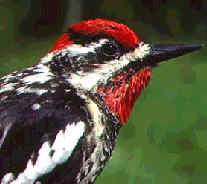
Wikipedia: Red-naped sapsucker Source: OTHER
RedNapedSapsucker23.jpg
![]() The red-naped sapsucker (Sphyrapicus nuchalis) is a medium-sized North American woodpecker. Long thought to be a subspecies of the yellow-bellied sapsucker, it is now known to be a distinct species.
[more]
The red-naped sapsucker (Sphyrapicus nuchalis) is a medium-sized North American woodpecker. Long thought to be a subspecies of the yellow-bellied sapsucker, it is now known to be a distinct species.
[more]
Profile Wikipedia eBird Audubon AllAboutBirds Xeno-Canto
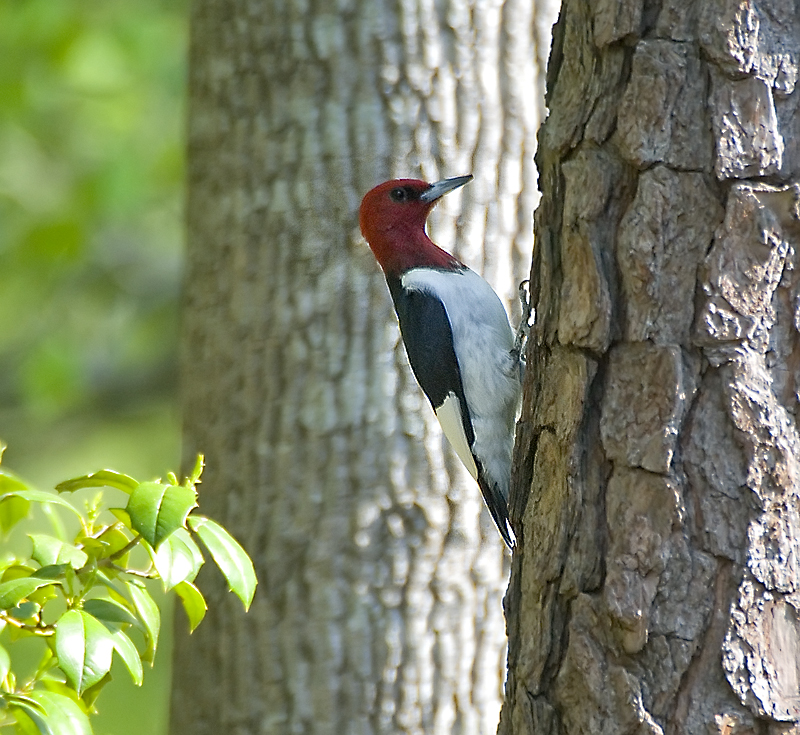
Wikipedia: Red-headed woodpecker Source: OTHER
Melanerpes_erythrocephalus_-tree_trunk-USA.jpg
![]() The red-headed woodpecker (Melanerpes erythrocephalus) is a small or medium-sized woodpecker from temperate North America. Their breeding habitat is open country across southern Canada and the eastern-central United States. It is rated as least concern on the International Union for Conservation of Nature (IUCN)'s Red List of Endangered species, having been downlisted from near threatened in 2018.[2]
[more]
The red-headed woodpecker (Melanerpes erythrocephalus) is a small or medium-sized woodpecker from temperate North America. Their breeding habitat is open country across southern Canada and the eastern-central United States. It is rated as least concern on the International Union for Conservation of Nature (IUCN)'s Red List of Endangered species, having been downlisted from near threatened in 2018.[2]
[more]
Profile Wikipedia eBird A-Z Animals Audubon AllAboutBirds Xeno-Canto
Red bellied woodpecker. 2022-04-29 11.51.34 Maryland
First observed in Maryland on 2021-06-18.
![]() The red-bellied woodpecker (Melanerpes carolinus) is a medium-sized woodpecker of the family Picidae. It breeds mainly in the eastern United States, ranging as far south as Florida and as far north as Canada. Its common name is somewhat misleading, as the most prominent red part of its plumage is on the head; the red-headed woodpecker, however, is another species that is a rather close relative but looks quite different.
[more]
The red-bellied woodpecker (Melanerpes carolinus) is a medium-sized woodpecker of the family Picidae. It breeds mainly in the eastern United States, ranging as far south as Florida and as far north as Canada. Its common name is somewhat misleading, as the most prominent red part of its plumage is on the head; the red-headed woodpecker, however, is another species that is a rather close relative but looks quite different.
[more]
Call:
Automatically generated from Xeno-Canto recording
♫ Source: BirdNet
20220429_102809 birdnet - Red-bellied Woodpecker - Red-bellied Woodpecker - Towson.mp3
2022-04-29 10.28.09 Maryland (song?)
Profile Wikipedia eBird Audubon AllAboutBirds Xeno-Canto

Wikipedia: Gila woodpecker Source: OTHER
1200px-Gila_Woodpecker.jpeg
![]() The Gila woodpecker (Melanerpes uropygialis) is a medium-sized woodpecker of the desert regions of the southwestern United States and western Mexico. In the U.S., they range through southeastern California, southern Nevada, Arizona, and New Mexico.
[more]
The Gila woodpecker (Melanerpes uropygialis) is a medium-sized woodpecker of the desert regions of the southwestern United States and western Mexico. In the U.S., they range through southeastern California, southern Nevada, Arizona, and New Mexico.
[more]
Profile Wikipedia eBird Audubon AllAboutBirds Xeno-Canto

Wikipedia: Golden-fronted woodpecker Source: OTHER
Melanerpes_aurifrons2.jpg
![]() The golden-fronted woodpecker (Melanerpes aurifrons) is a North American woodpecker. Its preferred habitat is mesquite, riparian woodlands, and tropical rainforest. It is distributed from Texas and Oklahoma in the United States through Mexico, Belize, Guatemala, El Salvador, Honduras and northern Nicaragua.[2] Cooke listed this species as an abundant resident of the lower Rio Grande Valley, Texas, in 1884.
[more]
The golden-fronted woodpecker (Melanerpes aurifrons) is a North American woodpecker. Its preferred habitat is mesquite, riparian woodlands, and tropical rainforest. It is distributed from Texas and Oklahoma in the United States through Mexico, Belize, Guatemala, El Salvador, Honduras and northern Nicaragua.[2] Cooke listed this species as an abundant resident of the lower Rio Grande Valley, Texas, in 1884.
[more]
Profile Wikipedia eBird Audubon AllAboutBirds Xeno-Canto

Wikipedia: Lewis's woodpecker Source: OTHER
Lewis%27s_Woodpecker.jpg
![]() Lewis's woodpecker (Melanerpes lewis) is a large North American species of woodpecker which ornithologist Alexander Wilson named after Meriwether Lewis, one of the explorers who surveyed the areas bought by the United States of America as part of the Louisiana Purchase and discovered this species of bird.
[more]
Lewis's woodpecker (Melanerpes lewis) is a large North American species of woodpecker which ornithologist Alexander Wilson named after Meriwether Lewis, one of the explorers who surveyed the areas bought by the United States of America as part of the Louisiana Purchase and discovered this species of bird.
[more]
Profile Wikipedia eBird Audubon AllAboutBirds Xeno-Canto
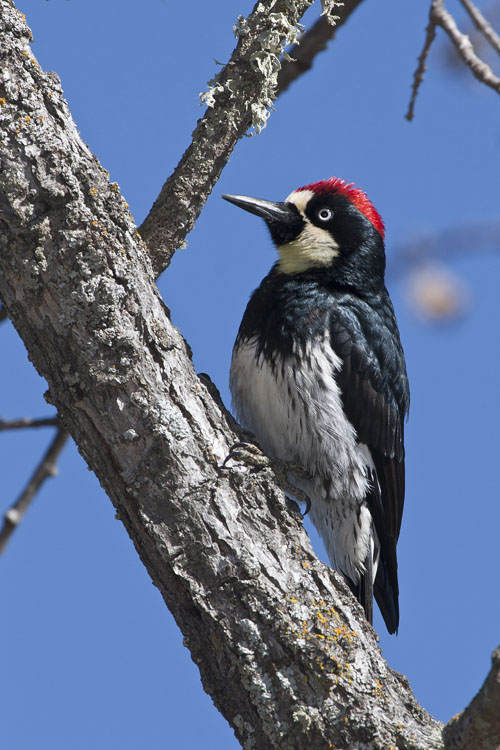
Wikipedia: Acorn woodpecker Source: OTHER
Melanerpes_formicivorus_-San_Luis_Obispo%2C_California%2C_USA_-male-8.jpg
![]() The acorn woodpecker (Melanerpes formicivorus) is a medium-sized woodpecker, 21 cm (8.3 in) long, with an average weight of 85 g (3.0 oz).
[more]
The acorn woodpecker (Melanerpes formicivorus) is a medium-sized woodpecker, 21 cm (8.3 in) long, with an average weight of 85 g (3.0 oz).
[more]
Profile Wikipedia eBird A-Z Animals Audubon AllAboutBirds Xeno-Canto
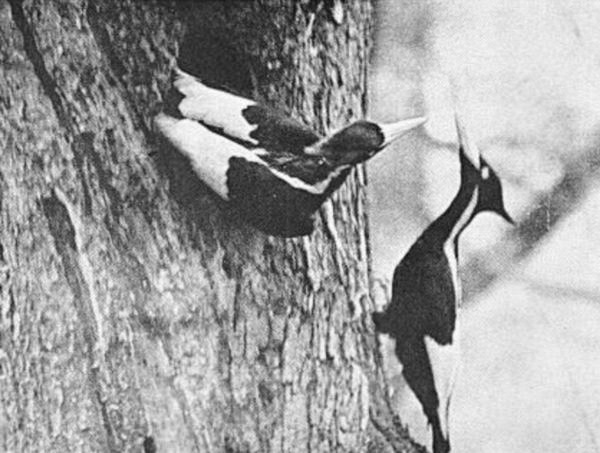
Wikipedia: Ivory-billed woodpecker Source: OTHER
Ivory-bill_pair.jpg
![]() The ivory-billed woodpecker (Campephilus principalis) is a woodpecker native to the bottomland hardwood forests and temperate coniferous forests of the Southern United States and Cuba. Habitat destruction and hunting have reduced populations so thoroughly that the species is listed as Critically Endangered on the IUCN Red List,[1][2] and as "definitely or probably extinct" by the American Birding Association.[3] The last universally accepted sighting of an American ivory-billed woodpecker occurred in Louisiana in 1944, and the last universally accepted sighting of a Cuban ivory-billed woodpecker occurred in 1987; sporadic reports of sightings and other evidence of the birds' persistence have continued since then. In the 21st century, reported sightings and analyses of audio and visual recordings have been published in peer-reviewed scientific journals as evidence that the species persists in Arkansas, Louisiana, and Florida. Various land purchases and habitat restoration efforts have been initiated in areas where sightings and other evidence have suggested a relatively high probability the species exists, to protect any surviving individuals.
[more]
The ivory-billed woodpecker (Campephilus principalis) is a woodpecker native to the bottomland hardwood forests and temperate coniferous forests of the Southern United States and Cuba. Habitat destruction and hunting have reduced populations so thoroughly that the species is listed as Critically Endangered on the IUCN Red List,[1][2] and as "definitely or probably extinct" by the American Birding Association.[3] The last universally accepted sighting of an American ivory-billed woodpecker occurred in Louisiana in 1944, and the last universally accepted sighting of a Cuban ivory-billed woodpecker occurred in 1987; sporadic reports of sightings and other evidence of the birds' persistence have continued since then. In the 21st century, reported sightings and analyses of audio and visual recordings have been published in peer-reviewed scientific journals as evidence that the species persists in Arkansas, Louisiana, and Florida. Various land purchases and habitat restoration efforts have been initiated in areas where sightings and other evidence have suggested a relatively high probability the species exists, to protect any surviving individuals.
[more]
Downy woodpecker. 2022-05-05 09.37.50 Maryland
First observed in Maryland on 2021-06-14.
![]() The downy woodpecker (Dryobates pubescens) is a species of woodpecker, the smallest in North America.
[more]
The downy woodpecker (Dryobates pubescens) is a species of woodpecker, the smallest in North America.
[more]
Hairy woodpecker. 2023-10-12 15.33.18 New England
First observed in New England on 2023-10-12.

Wikipedia: Nuttall's woodpecker Source: OTHER
1200px-Picoides_nuttallii_-Olive_View%2C_Sylmar%2C_California%2C_USA_-male-8.jpg
![]() Nuttall's woodpecker (Dryobates nuttallii) is a species of woodpecker named after naturalist Thomas Nuttall in 1843. They are found in oak woodlands of California and are similar to the ladder-backed woodpecker in both genetics and appearance.[2][page needed]
[more]
Nuttall's woodpecker (Dryobates nuttallii) is a species of woodpecker named after naturalist Thomas Nuttall in 1843. They are found in oak woodlands of California and are similar to the ladder-backed woodpecker in both genetics and appearance.[2][page needed]
[more]

Wikipedia: Ladder-backed woodpecker Source: OTHER
Ladder-back_Woodpecker_on_Cactus.jpg
![]() The ladder-backed woodpecker (Dryobates scalaris) is a North American woodpecker. Some taxonomic authorities, including the American Ornithological Society, continue to place this species in the genus Picoides.
[more]
The ladder-backed woodpecker (Dryobates scalaris) is a North American woodpecker. Some taxonomic authorities, including the American Ornithological Society, continue to place this species in the genus Picoides.
[more]
Profile Wikipedia eBird Audubon AllAboutBirds Xeno-Canto
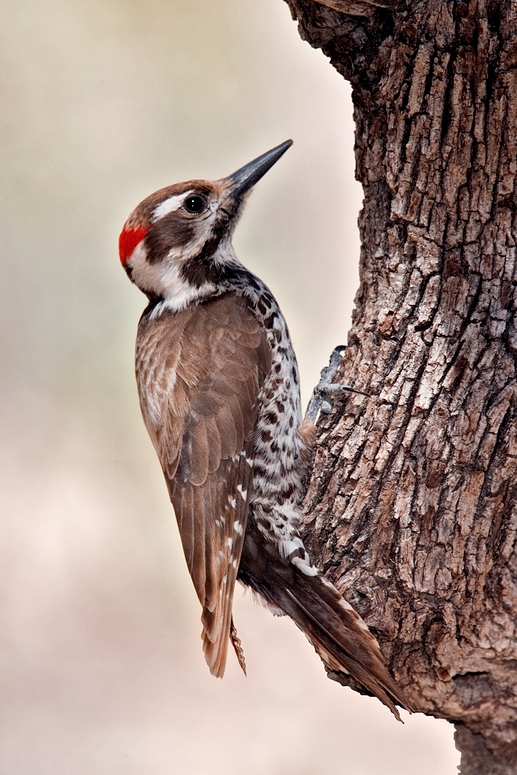
Wikipedia: Arizona woodpecker Source: OTHER
Arizona_Woodpecker.jpg
![]() The Arizona woodpecker (Leuconotopicus arizonae) is a woodpecker native to southern Arizona and New Mexico and the Sierra Madre Occidental of western Mexico. The species northernmost range in southeastern Arizona, extreme southwestern New Mexico, and northern Sonora is the region of the Madrean Sky Islands, a region of higher Sonoran Desert mountain ranges.
[more]
The Arizona woodpecker (Leuconotopicus arizonae) is a woodpecker native to southern Arizona and New Mexico and the Sierra Madre Occidental of western Mexico. The species northernmost range in southeastern Arizona, extreme southwestern New Mexico, and northern Sonora is the region of the Madrean Sky Islands, a region of higher Sonoran Desert mountain ranges.
[more]

Wikipedia: Rose-ringed parakeet Source: OTHER
1200px-Rose-ringed_parakeet_%28Psittacula_krameri_borealis%29_male_Jaipur_2.jpg
This bird appears across the great seas in the following continents:
Europe, North America, Africa.
![]() The rose-ringed parakeet (Psittacula krameri), also known as the ring-necked parakeet, is a medium-sized parrot in the genus Psittacula, of the family Psittacidae. It has disjunct native ranges in Africa and the Indian Subcontinent, and is now introduced into many other parts of the world where feral populations have established themselves and are bred for the exotic pet trade.
[more]
The rose-ringed parakeet (Psittacula krameri), also known as the ring-necked parakeet, is a medium-sized parrot in the genus Psittacula, of the family Psittacidae. It has disjunct native ranges in Africa and the Indian Subcontinent, and is now introduced into many other parts of the world where feral populations have established themselves and are bred for the exotic pet trade.
[more]

Wikipedia: Yellow-headed parrot Source: OTHER
Amazona_oratrix_belizensis.jpg
This bird appears across the great seas in the following continents:
Europe, North America.
Deutschland: etabliertes Neozoon, Brut-, Jahresvogel

Wikipedia: Hispaniolan parrot Source: OTHER
Amazona_ventralis_-two_captive-8a.jpg
General: ![]() The Hispaniolan amazon or Hispaniolan parrot (Amazona ventralis), colloquially known as cuca, is a species of Amazon parrot in the family Psittacidae. It is endemic to Hispaniola (Haiti and the Dominican Republic), and has been introduced to Puerto Rico.
The main features that differentiate it from other amazons are the white forehead, pale beak, white eye-ring, blue ear patch, and red belly.
[more]
The Hispaniolan amazon or Hispaniolan parrot (Amazona ventralis), colloquially known as cuca, is a species of Amazon parrot in the family Psittacidae. It is endemic to Hispaniola (Haiti and the Dominican Republic), and has been introduced to Puerto Rico.
The main features that differentiate it from other amazons are the white forehead, pale beak, white eye-ring, blue ear patch, and red belly.
[more]
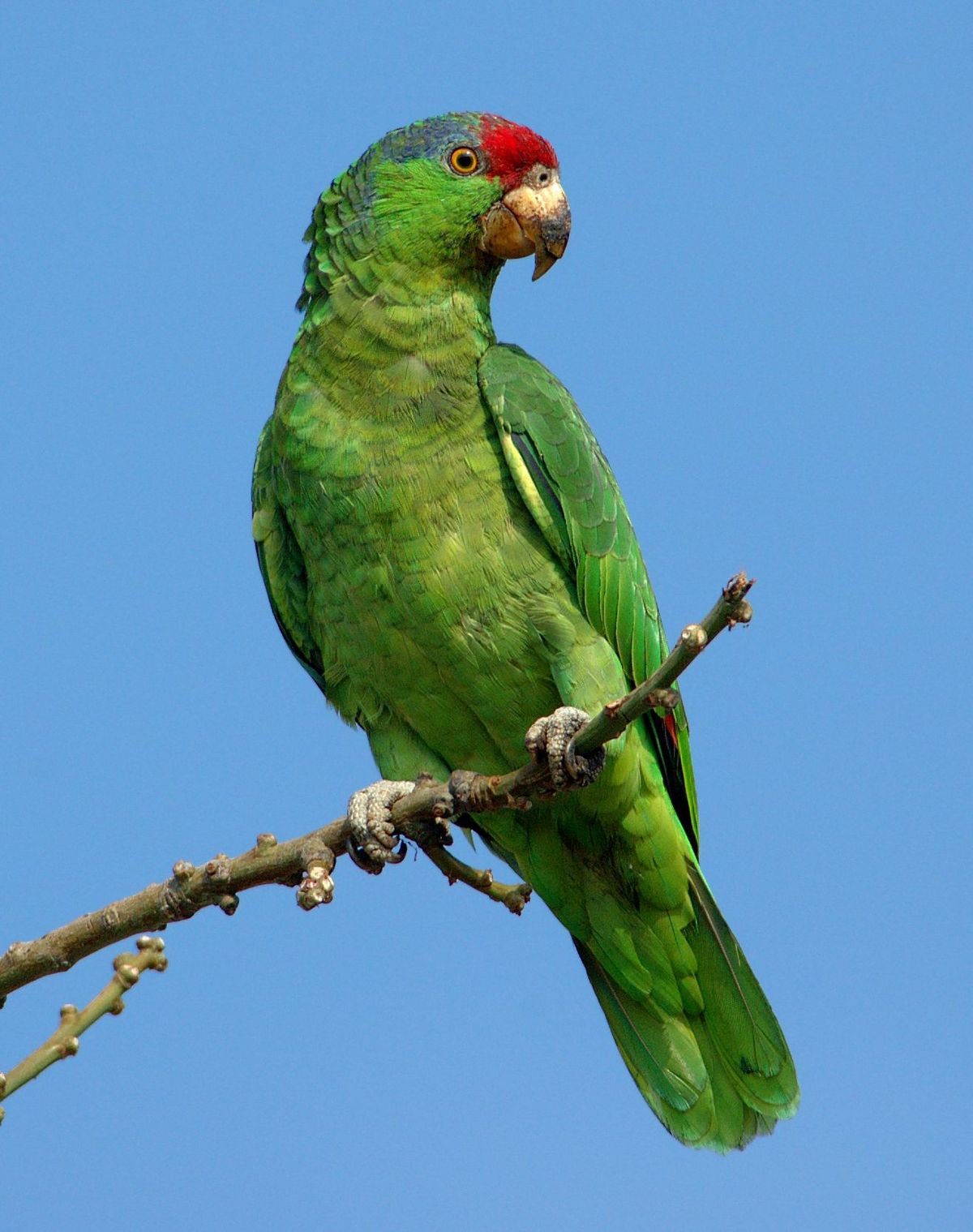
Wikipedia: Red-crowned parrot Source: OTHER
1200px-Red_Crowned_Amazon.jpg
![]() The red-crowned amazon (Amazona viridigenalis), also known as the red-crowned parrot, green-cheeked amazon or Mexican red-headed parrot, is an endangered amazon parrot native to northeastern Mexico and possibly southern Texas in the United States.[2][3][4] A 1994 study estimated wild populations of between 2,000 and 4,300 mature individuals; the IUCN Red List considers it a globally endangered species with a decreasing population.[1] The main threats to the native bird's survival are the illegal export of trapped birds from Mexico to the United States for the pet trade and the destruction of their natural habitat, the lowland forests of northeastern Mexico.[5]
[more]
The red-crowned amazon (Amazona viridigenalis), also known as the red-crowned parrot, green-cheeked amazon or Mexican red-headed parrot, is an endangered amazon parrot native to northeastern Mexico and possibly southern Texas in the United States.[2][3][4] A 1994 study estimated wild populations of between 2,000 and 4,300 mature individuals; the IUCN Red List considers it a globally endangered species with a decreasing population.[1] The main threats to the native bird's survival are the illegal export of trapped birds from Mexico to the United States for the pet trade and the destruction of their natural habitat, the lowland forests of northeastern Mexico.[5]
[more]

Wikipedia: Orange-winged parrot Source: OTHER
Amazona_amazonica_%281%29.jpg
![]() The orange-winged amazon (Amazona amazonica), also known locally as orange-winged parrot and loro guaro, is a large amazon parrot. It is a resident breeding bird in tropical South America, from Colombia, Trinidad and Tobago south to Peru, Bolivia and central Brazil. Its habitat is forest and semi-open country. Although common, it is persecuted as an agricultural pest and by capture for the pet trade (over 66,000 captured from 1981 to 1985). It is also hunted as a food source. Introduced breeding populations have been reported in Puerto Rico[2] and Tenerife in the Canary Islands.[3]
[more]
The orange-winged amazon (Amazona amazonica), also known locally as orange-winged parrot and loro guaro, is a large amazon parrot. It is a resident breeding bird in tropical South America, from Colombia, Trinidad and Tobago south to Peru, Bolivia and central Brazil. Its habitat is forest and semi-open country. Although common, it is persecuted as an agricultural pest and by capture for the pet trade (over 66,000 captured from 1981 to 1985). It is also hunted as a food source. Introduced breeding populations have been reported in Puerto Rico[2] and Tenerife in the Canary Islands.[3]
[more]

Wikipedia: Nanday parakeet Source: OTHER
1200px-2011-4_parrot_in_Strasbourg.jpg
![]() The nanday parakeet (Aratinga nenday), also known as the black-hooded parakeet or nanday conure, is a medium-small, mostly green, Neotropical parrot native to continental South America.
[more]
The nanday parakeet (Aratinga nenday), also known as the black-hooded parakeet or nanday conure, is a medium-small, mostly green, Neotropical parrot native to continental South America.
[more]

Wikipedia: Peach-faced lovebird Source: OTHER
1200px-Rosy-faced_lovebird_%28Agapornis_roseicollis_roseicollis%29.jpg
This bird appears across the great seas in the following continents:
North America, Africa.
![]() The rosy-faced lovebird (Agapornis roseicollis), also known as the rosy-collared or peach-faced lovebird, is a species of lovebird native to arid regions in southwestern Africa such as the Namib Desert. A loud and constant chirper, these birds are very social animals and often congregate in small groups in the wild. They eat throughout the day and take frequent baths. Coloration can vary widely among populations. Plumage is identical in males and females. Lovebirds are renowned for their sleep position in which they sit side-by-side and turn their faces in towards each other. Also, females are well noted to tear raw materials into long strips, "twisty-tie" them onto their backs, and fly substantial distances back to make a nest. They are common in the pet industry.
[more]
The rosy-faced lovebird (Agapornis roseicollis), also known as the rosy-collared or peach-faced lovebird, is a species of lovebird native to arid regions in southwestern Africa such as the Namib Desert. A loud and constant chirper, these birds are very social animals and often congregate in small groups in the wild. They eat throughout the day and take frequent baths. Coloration can vary widely among populations. Plumage is identical in males and females. Lovebirds are renowned for their sleep position in which they sit side-by-side and turn their faces in towards each other. Also, females are well noted to tear raw materials into long strips, "twisty-tie" them onto their backs, and fly substantial distances back to make a nest. They are common in the pet industry.
[more]

Wikipedia: Yellow-chevroned parakeet Source: OTHER
1200px-Yellow-chevroned_parakeet_1_BH_Zoo.jpg
![]() The yellow-chevroned parakeet (Brotogeris chiriri) is native to tropical South America south of the Amazon River basin from central Brazil to southern Bolivia, Paraguay, and northern Argentina. Caged birds have been released in some areas, and the birds have established self-sustaining populations in the Miami, Florida, and Los Angeles and San Francisco, California. This bird seems to be doing better in its North American feral population than the closely related white-winged parakeet. The species is also established in the downtown area of Rio de Janeiro, Brazil, where it was introduced. The native population in South America continues to do well.
[more]
The yellow-chevroned parakeet (Brotogeris chiriri) is native to tropical South America south of the Amazon River basin from central Brazil to southern Bolivia, Paraguay, and northern Argentina. Caged birds have been released in some areas, and the birds have established self-sustaining populations in the Miami, Florida, and Los Angeles and San Francisco, California. This bird seems to be doing better in its North American feral population than the closely related white-winged parakeet. The species is also established in the downtown area of Rio de Janeiro, Brazil, where it was introduced. The native population in South America continues to do well.
[more]

Wikipedia: Monk parakeet Source: OTHER
1200px-Monk_Parakeet_%28Myiopsitta_monachus%29_%2828420470712%29.jpg
This bird appears across the great seas in the following continents:
Europe, North America, Africa.
![]() The monk parakeet (Myiopsitta monachus), also known as the Quaker parrot, is a species of true parrot in the family Psittacidae. It is a small, bright-green parrot with a greyish breast and greenish-yellow abdomen. Its average lifespan is 20–30 years. It originates from the temperate to subtropical areas of Argentina and the surrounding countries in South America. Self-sustaining feral populations occur in many places, mainly in North America and Europe.
[more]
The monk parakeet (Myiopsitta monachus), also known as the Quaker parrot, is a species of true parrot in the family Psittacidae. It is a small, bright-green parrot with a greyish breast and greenish-yellow abdomen. Its average lifespan is 20–30 years. It originates from the temperate to subtropical areas of Argentina and the surrounding countries in South America. Self-sustaining feral populations occur in many places, mainly in North America and Europe.
[more]

Wikipedia: Orange-fronted parakeet Source: OTHER
1200px-Aratinga_canicularis_-Costa_Rica-8-2c.JPG
![]() The orange-fronted parakeet or orange-fronted conure (Eupsittula canicularis), also known as the half-moon conure, is a medium-sized parrot that is resident from western Mexico to Costa Rica.
[more]
The orange-fronted parakeet or orange-fronted conure (Eupsittula canicularis), also known as the half-moon conure, is a medium-sized parrot that is resident from western Mexico to Costa Rica.
[more]

Wikipedia: Brown-throated parakeet Source: OTHER
1200px-Aratinga_pertinax_-national_park_-Aruba-8.jpg
![]() The brown-throated parakeet (Eupsittula pertinax), also known as the St. Thomas conure or the brown-throated conure, in aviculture, is a species of parrot in the family Psittacidae.
[more]
The brown-throated parakeet (Eupsittula pertinax), also known as the St. Thomas conure or the brown-throated conure, in aviculture, is a species of parrot in the family Psittacidae.
[more]

Wikipedia: Mitred parakeet Source: OTHER
Mitred_Parakeet_Florida.jpg
![]() The mitred parakeet (Psittacara mitratus), also known as the mitred conure in aviculture, is a species of green and red parrot in the family Psittacidae. It is native to the forests and woodlands in the Andes from north-central Peru, south through Bolivia, to north-western Argentina,[2] with introduced populations in California, Florida and Hawaii.[3] It may constitute a cryptic species complex.[2]
[more]
The mitred parakeet (Psittacara mitratus), also known as the mitred conure in aviculture, is a species of green and red parrot in the family Psittacidae. It is native to the forests and woodlands in the Andes from north-central Peru, south through Bolivia, to north-western Argentina,[2] with introduced populations in California, Florida and Hawaii.[3] It may constitute a cryptic species complex.[2]
[more]

Wikipedia: Red-masked parakeet Source: OTHER
1200px-Red-masked_Parakeet-Aratinga_erythrogenys_in_a_tree.jpg
![]() The red-masked parakeet (Psittacara erythrogenys)[2] is a medium-sized parrot from Ecuador and Peru. It is popular as a pet and are better known in aviculture as the cherry-headed conure[3] or the red-headed conure.[4] They are also considered the best talkers of all the conures.[5]
[more]
The red-masked parakeet (Psittacara erythrogenys)[2] is a medium-sized parrot from Ecuador and Peru. It is popular as a pet and are better known in aviculture as the cherry-headed conure[3] or the red-headed conure.[4] They are also considered the best talkers of all the conures.[5]
[more]

Wikipedia: Green parakeet Source: OTHER
Green_Parakeet_-in_tree_-South_Texas-8.jpg
![]() The green parakeet (Psittacara holochlorus) is a medium-sized parrot occurring in North and Central America, from the southernmost tip of Texas south to northern Nicaragua.
[more]
The green parakeet (Psittacara holochlorus) is a medium-sized parrot occurring in North and Central America, from the southernmost tip of Texas south to northern Nicaragua.
[more]

Wikipedia: Sulfur-crested cockatoo Source: OTHER
Cacatua_galerita_Tas_2.jpg
This bird appears across the great seas in the following continents:
North America, Australia.
![]() The sulphur-crested cockatoo (Cacatua galerita) is a relatively large white cockatoo found in wooded habitats in Australia, New Guinea, and some of the islands of Indonesia. They can be locally very numerous, leading to them sometimes being considered pests. A highly intelligent bird,[2] they are well known in aviculture, although they can be demanding pets.
[more]
The sulphur-crested cockatoo (Cacatua galerita) is a relatively large white cockatoo found in wooded habitats in Australia, New Guinea, and some of the islands of Indonesia. They can be locally very numerous, leading to them sometimes being considered pests. A highly intelligent bird,[2] they are well known in aviculture, although they can be demanding pets.
[more]
Profile Wikipedia eBird Audubon AllAboutBirds Xeno-Canto

Wikipedia: White cockatoo Source: OTHER
1200px-Cacatua_alba_-Pairi_Daiza%2C_Hainaut%2C_Belgium-8a.jpg
![]() The white cockatoo (Cacatua alba), also known as the umbrella cockatoo, is a medium-sized all-white cockatoo endemic to tropical rainforest on islands of Indonesia. When surprised, it extends a large and striking head crest, which has a semicircular shape (similar to an umbrella, hence the alternative name). The wings and tail have a pale yellow or lemon color which is exposed when they fly. It is similar to other species of white cockatoo such as yellow-crested cockatoo, sulphur-crested cockatoo, and salmon-crested cockatoo, all of which have yellow, orange or pink crest feathers instead of white.
[more]
The white cockatoo (Cacatua alba), also known as the umbrella cockatoo, is a medium-sized all-white cockatoo endemic to tropical rainforest on islands of Indonesia. When surprised, it extends a large and striking head crest, which has a semicircular shape (similar to an umbrella, hence the alternative name). The wings and tail have a pale yellow or lemon color which is exposed when they fly. It is similar to other species of white cockatoo such as yellow-crested cockatoo, sulphur-crested cockatoo, and salmon-crested cockatoo, all of which have yellow, orange or pink crest feathers instead of white.
[more]

Wikipedia: Tanimbar cockatoo Source: OTHER
Cacatua_goffiniana_-in_tree-6.jpg
![]() The Tanimbar corella (Cacatua goffiniana) also known as Goffin's cockatoo or the blushing cockatoo, is a species of cockatoo endemic to forests of Yamdena, Larat and Selaru, all islands in the Tanimbar Islands archipelago in Indonesia.[3][4][5] It has been introduced to the Kai Islands, Indonesia,[5] Puerto Rico and Singapore.[1] This species was only formally described in 2004,[2] after it was discovered that the previous formal descriptions pertained to individuals of a different cockatoo species, the Ducorps' or Solomons cockatoo (Cacatua ducorpsii).[6] Tanimbar corellas are the smallest of the white cockatoos. It is classified as Near Threatened due to deforestation and bird trade. It breeds well in captivity and there is a large avicultural population.
[more]
The Tanimbar corella (Cacatua goffiniana) also known as Goffin's cockatoo or the blushing cockatoo, is a species of cockatoo endemic to forests of Yamdena, Larat and Selaru, all islands in the Tanimbar Islands archipelago in Indonesia.[3][4][5] It has been introduced to the Kai Islands, Indonesia,[5] Puerto Rico and Singapore.[1] This species was only formally described in 2004,[2] after it was discovered that the previous formal descriptions pertained to individuals of a different cockatoo species, the Ducorps' or Solomons cockatoo (Cacatua ducorpsii).[6] Tanimbar corellas are the smallest of the white cockatoos. It is classified as Near Threatened due to deforestation and bird trade. It breeds well in captivity and there is a large avicultural population.
[more]
Profile Wikipedia eBird Audubon AllAboutBirds Xeno-Canto

Wikipedia: Blue-crowned lorikeet Source: OTHER
Vini_australis_-two_on_a_perch-8a-4c.jpg
![]() The blue-crowned lorikeet (Vini australis), also known as the blue-crowned lory, blue-crested lory, Solomon lory or Samoan lory, is a parrot found throughout the Lau Islands (Fiji), Tonga, Samoa, Niue and adjacent islands, including: ʻAlofi, Fotuhaʻa, Fulago, Futuna, Haʻafeva, Niuafoʻou, Moce, Niue, Ofu, Olosega, Samoa, Savaiʻi, Tafahi, Taʻu, Tofua, Tonga, Tungua, ʻUiha, ʻUpolu, Varoa, Vavaʻu, and Voleva. It is a 19 cm green lorikeet with a red throat, blue crown, and belly patch shading from red at the top to purple at the bottom.
[more]
The blue-crowned lorikeet (Vini australis), also known as the blue-crowned lory, blue-crested lory, Solomon lory or Samoan lory, is a parrot found throughout the Lau Islands (Fiji), Tonga, Samoa, Niue and adjacent islands, including: ʻAlofi, Fotuhaʻa, Fulago, Futuna, Haʻafeva, Niuafoʻou, Moce, Niue, Ofu, Olosega, Samoa, Savaiʻi, Tafahi, Taʻu, Tofua, Tonga, Tungua, ʻUiha, ʻUpolu, Varoa, Vavaʻu, and Voleva. It is a 19 cm green lorikeet with a red throat, blue crown, and belly patch shading from red at the top to purple at the bottom.
[more]

Wikipedia: Red-throated loon Source: OTHER
1200px-Gavia_Stellata_%C3%96lfus%C3%A1_20090606.jpg
This bird appears across the great seas in the following continents:
Europe, North America.
Deutschland: Zugvogel, Wintergast
Habitats:
River and lake
Great northern loon, Squam Lake, New Hampshire. 2023-10-06 12.26.58 New England
First observed in New England on 2023-10-06.
This bird appears across the great seas in the following continents:
Europe, North America.
Deutschland: seltener Wintergast
Song: ![]() Song: Like a slow Black-throated Diver. Pitch slowly rising with a register break, progressing into a cyclic, two to four syllable, motif. [Link]
Song: Like a slow Black-throated Diver. Pitch slowly rising with a register break, progressing into a cyclic, two to four syllable, motif. [Link]
Calls: ![]() Also various vibrating eerie descending calls. Often used as sound effect in horror movies. [Link]
Also various vibrating eerie descending calls. Often used as sound effect in horror movies. [Link]
Physical details: length=69-91 cm,
wingspan=69-91 cm,
weight=3600-4480 g

Wikipedia: Black-throated loon Source: OTHER
Black-throated_Diver%2C_Oulu%2C_Finland_02_%2815195370798%29.jpg
This bird appears across the great seas in the following continents:
Europe, North America.
Deutschland: Zugvogel, Wintergast
Habitats:
River and lake
Profile Wikipedia eBird Audubon AllAboutBirds Xeno-Canto NABU
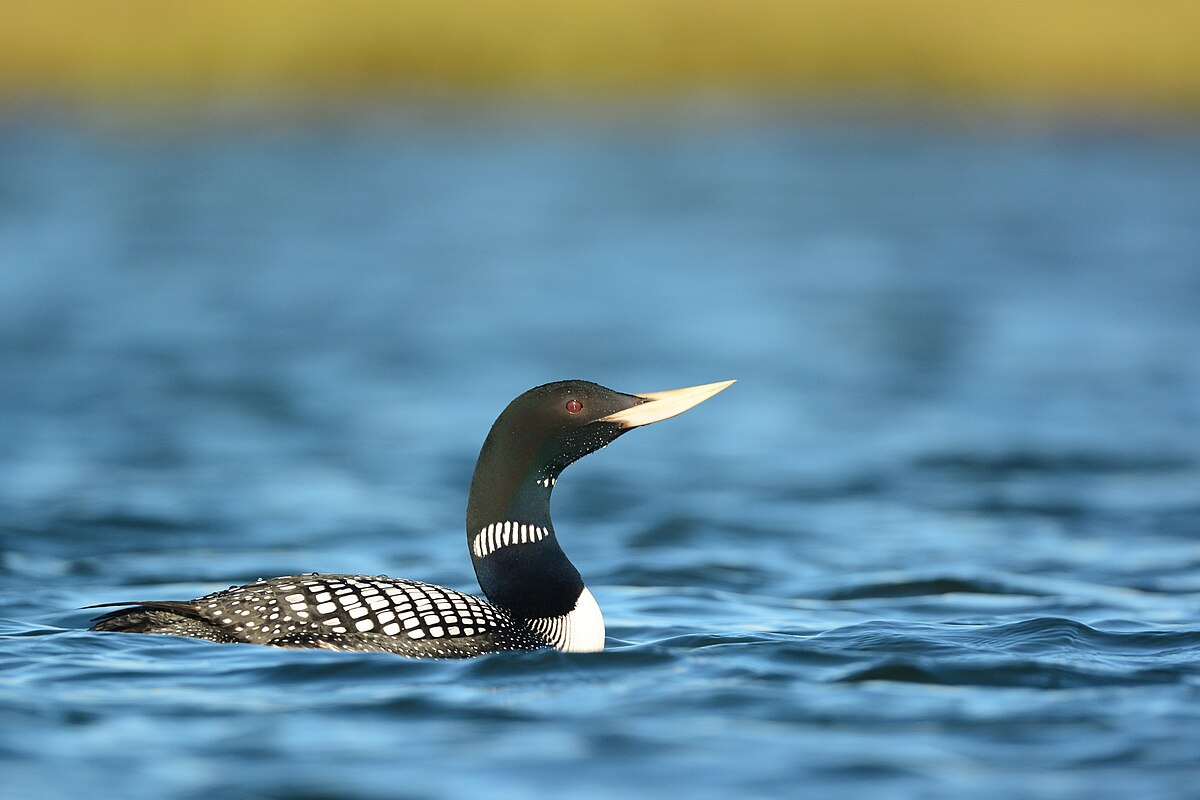
Wikipedia: Yellow-billed loon Source: OTHER
1200px-Yellow-billed_Loon_Chipp_South_8-12-13_Ryan_Askren.jpg
This bird appears across the great seas in the following continents:
Europe, North America.
General: ![]() The yellow-billed loon (Gavia adamsii), also known as the white-billed diver, is the largest member of the loon or diver family. Breeding adults have a black head, white underparts and chequered black-and-white mantle. Non-breeding plumage is drabber with the chin and foreneck white. The main distinguishing feature from great northern loon is the longer straw-yellow bill which, because the culmen is straight, appears slightly uptilted.
[more]
The yellow-billed loon (Gavia adamsii), also known as the white-billed diver, is the largest member of the loon or diver family. Breeding adults have a black head, white underparts and chequered black-and-white mantle. Non-breeding plumage is drabber with the chin and foreneck white. The main distinguishing feature from great northern loon is the longer straw-yellow bill which, because the culmen is straight, appears slightly uptilted.
[more]
Profile Wikipedia eBird Audubon AllAboutBirds Xeno-Canto

Wikipedia: Pacific loon Source: OTHER
PacificLoon24.jpg
![]() The Pacific loon or Pacific diver (Gavia pacifica), is a medium-sized member of the loon, or diver, family.
[more]
The Pacific loon or Pacific diver (Gavia pacifica), is a medium-sized member of the loon, or diver, family.
[more]
Profile Wikipedia eBird A-Z Animals Audubon AllAboutBirds Xeno-Canto
Pied-billed grebe, Bacalar. 2023-03-31 13.17.14 Yucatan
First observed in Yucatan on 2023-03-31.
This bird appears across the great seas in the following continents:
North America, South America, Africa.
![]() The pied-billed grebe (Podilymbus podiceps) is a species of the grebe family of water birds. Since the Atitlán grebe (Podilymbus gigas) has become extinct, it is the sole extant member of the genus Podilymbus.[2] The pied-billed grebe is primarily found in ponds throughout the Americas.[3] Other names of this grebe include American dabchick, rail, dabchick, Carolina grebe, devil-diver, dive-dapper, dipper, hell-diver, pied-billed dabchick, pied-bill, thick-billed grebe, and water witch.[4][5]
[more]
The pied-billed grebe (Podilymbus podiceps) is a species of the grebe family of water birds. Since the Atitlán grebe (Podilymbus gigas) has become extinct, it is the sole extant member of the genus Podilymbus.[2] The pied-billed grebe is primarily found in ponds throughout the Americas.[3] Other names of this grebe include American dabchick, rail, dabchick, Carolina grebe, devil-diver, dive-dapper, dipper, hell-diver, pied-billed dabchick, pied-bill, thick-billed grebe, and water witch.[4][5]
[more]
Evtl Schwarzhalstaucher. 2021-03-07 11.13.08
First observed in 🇨🇭 on 2021-03-07.
This bird appears across the great seas in the following continents:
Europe, North America, Africa.
![]() The black-necked grebe or eared grebe (Podiceps nigricollis) is a member of the grebe family of water birds. It was described in 1831 by Christian Ludwig Brehm. There are currently three accepted subspecies, including the nominate subspecies. Its breeding plumage features a distinctive ochre-coloured plumage which extends behind its eye and over its ear coverts. The rest of the upper parts, including the head, neck, and breast, are coloured black to blackish brown. The flanks are tawny rufous to maroon-chestnut, and the abdomen is white. When in its non-breeding plumage, this bird has greyish-black upper parts, including the top of the head and a vertical stripe on the back of the neck. The flanks are also greyish-black. The rest of the body is a white or whitish colour. The juvenile has more brown in its darker areas. The subspecies californicus can be distinguished from the nominate by the former's usually longer bill. The other subspecies, P. n. gurneyi, can be differentiated by its greyer head and upper parts and by its smaller size. P. n. gurneyi can also be told apart by its lack of a non-breeding plumage. This species is present in parts of Africa, Eurasia, and the Americas.
[more]
The black-necked grebe or eared grebe (Podiceps nigricollis) is a member of the grebe family of water birds. It was described in 1831 by Christian Ludwig Brehm. There are currently three accepted subspecies, including the nominate subspecies. Its breeding plumage features a distinctive ochre-coloured plumage which extends behind its eye and over its ear coverts. The rest of the upper parts, including the head, neck, and breast, are coloured black to blackish brown. The flanks are tawny rufous to maroon-chestnut, and the abdomen is white. When in its non-breeding plumage, this bird has greyish-black upper parts, including the top of the head and a vertical stripe on the back of the neck. The flanks are also greyish-black. The rest of the body is a white or whitish colour. The juvenile has more brown in its darker areas. The subspecies californicus can be distinguished from the nominate by the former's usually longer bill. The other subspecies, P. n. gurneyi, can be differentiated by its greyer head and upper parts and by its smaller size. P. n. gurneyi can also be told apart by its lack of a non-breeding plumage. This species is present in parts of Africa, Eurasia, and the Americas.
[more]
Habitats:
River and lake
Horned grebe, Myvatn, Iceland. 2015-06-05 11.22.28 Iceland
First observed in Iceland on 2015-06-05.
This bird appears across the great seas in the following continents:
Europe, North America.
Deutschland: Brut-, Zugvogel, Wintergast RL 1
Vocalization: ![]() Varied. Vibrating, wailing, dry and cackling sequences. A mewing, falling and far-reaching "kiaa" and various rattling sounds. [Link]
Varied. Vibrating, wailing, dry and cackling sequences. A mewing, falling and far-reaching "kiaa" and various rattling sounds. [Link]
Physical details: length=31-38 cm,
wingspan=46-55 cm,
weight=364-449 g
Habitats:
River and lake
Profile Wikipedia eBird Vogelwarte BirdLife ZH ornitho.ch Audubon AllAboutBirds Xeno-Canto NABU

Wikipedia: Red-necked grebe Source: OTHER
1200px-Podicepsgrisegena.jpg
This bird appears across the great seas in the following continents:
Europe, North America.
Deutschland: Brut-, Zugvogel
Habitats:
River and lake

Wikipedia: Western grebe Source: OTHER
1200px-Western_Grebe_swimming.jpg
General: ![]() The western grebe[2] (Aechmophorus occidentalis[3]) is a species in the grebe family of water birds. Folk names include "dabchick", "swan grebe" and "swan-necked grebe".
[more]
The western grebe[2] (Aechmophorus occidentalis[3]) is a species in the grebe family of water birds. Folk names include "dabchick", "swan grebe" and "swan-necked grebe".
[more]

Wikipedia: Clark's grebe Source: OTHER
Clark%27s_grebe2.jpg
![]() Clark's grebe (Aechmophorus clarkii) is a North American waterbird species in the grebe family.[2] Until the 1980s, it was thought to be a pale morph of the western grebe, which it resembles in size, range, and behavior. Intermediates between the two species are known.
[more]
Clark's grebe (Aechmophorus clarkii) is a North American waterbird species in the grebe family.[2] Until the 1980s, it was thought to be a pale morph of the western grebe, which it resembles in size, range, and behavior. Intermediates between the two species are known.
[more]
Profile Wikipedia eBird Audubon AllAboutBirds Xeno-Canto

Wikipedia: Least grebe Source: OTHER
Least_grebe.jpg
![]() The least grebe (Tachybaptus dominicus), an aquatic bird, is the smallest member of the grebe family. It occurs in the New World from the southwestern United States and Mexico to Argentina, and also on Trinidad and Tobago, the Bahamas and the Greater Antilles.
[more]
The least grebe (Tachybaptus dominicus), an aquatic bird, is the smallest member of the grebe family. It occurs in the New World from the southwestern United States and Mexico to Argentina, and also on Trinidad and Tobago, the Bahamas and the Greater Antilles.
[more]
Profile Wikipedia eBird Audubon AllAboutBirds Xeno-Canto BirdID NABU
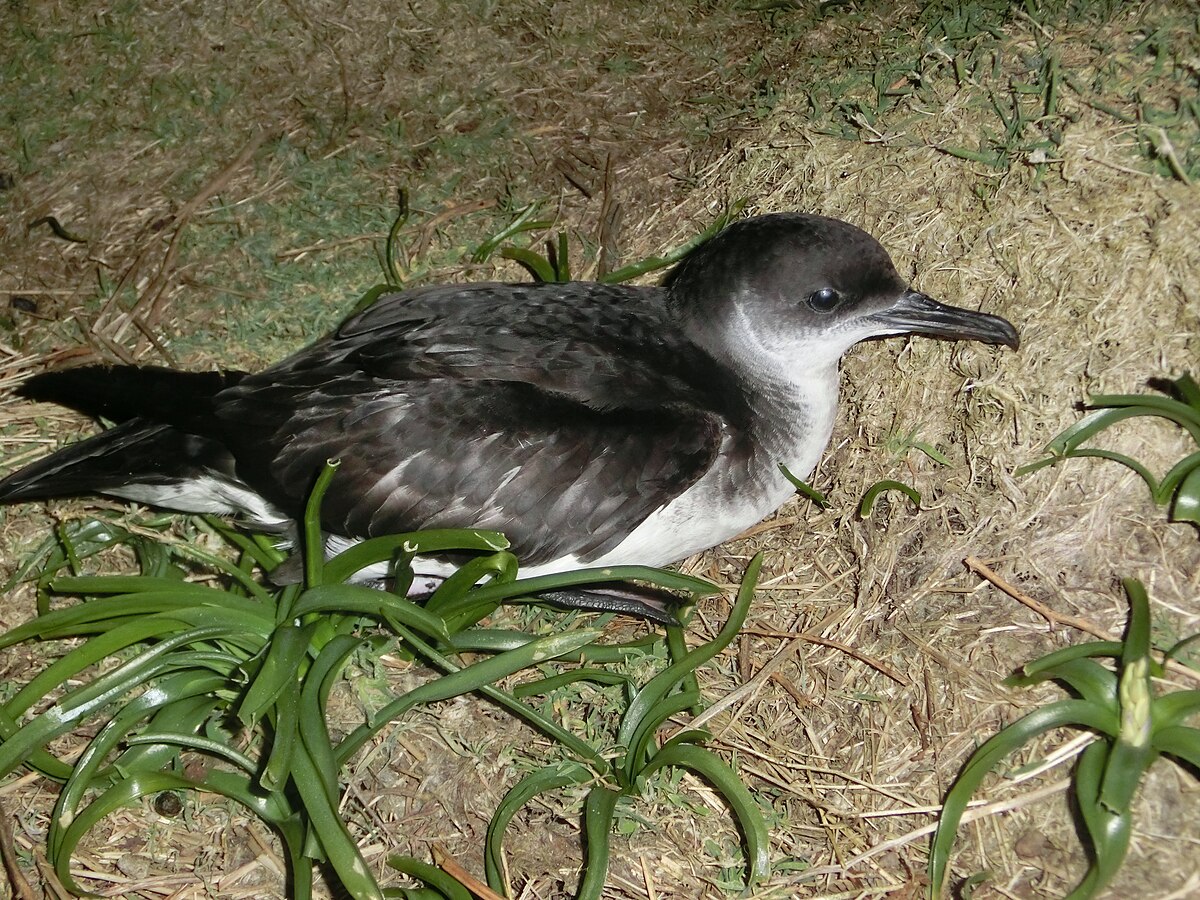
Wikipedia: Manx shearwater Source: OTHER
1200px-Manx_Shearwater.JPG
This bird appears across the great seas in the following continents:
Europe, North America, Africa.
![]() The Manx shearwater (Puffinus puffinus) is a medium-sized shearwater in the seabird family Procellariidae. The scientific name of this species records a name shift: Manx shearwaters were called Manks puffins in the 17th century. Puffin is an Anglo-Norman word (Middle English pophyn) for the cured carcasses of nestling shearwaters. The Atlantic puffin acquired the name much later, possibly because of its similar nesting habits.
[more]
The Manx shearwater (Puffinus puffinus) is a medium-sized shearwater in the seabird family Procellariidae. The scientific name of this species records a name shift: Manx shearwaters were called Manks puffins in the 17th century. Puffin is an Anglo-Norman word (Middle English pophyn) for the cured carcasses of nestling shearwaters. The Atlantic puffin acquired the name much later, possibly because of its similar nesting habits.
[more]
Vocalization: ![]() Vocal at breeding ground. [Link]
Vocal at breeding ground. [Link]
Calls: ![]() The call is sharp and wailing, and consist of two parts. A drawn, "inhalation", is immediately followed by a trisyllabic "ka-ya-ya". [Link]
The call is sharp and wailing, and consist of two parts. A drawn, "inhalation", is immediately followed by a trisyllabic "ka-ya-ya". [Link]
Physical details: length=31-36 cm,
wingspan=76-88 cm,
weight=375-459 g

Wikipedia: Tropical shearwater Source: OTHER
P%C3%A9trel_de_Barau_.jpg
This bird appears across the great seas in the following continents:
North America, Africa.
General: ![]() The tropical shearwater (Puffinus bailloni) is a seabird in the family Procellariidae formerly considered conspecific with Audubon's shearwater (Puffinus lherminieri).[2]
[more]
The tropical shearwater (Puffinus bailloni) is a seabird in the family Procellariidae formerly considered conspecific with Audubon's shearwater (Puffinus lherminieri).[2]
[more]
Profile Wikipedia eBird Audubon AllAboutBirds Xeno-Canto

Wikipedia: Little shearwater Source: OTHER
PuffinusElegansKeulemans.jpg
This bird appears across the great seas in the following continents:
North America, Australia.
![]() The little shearwater (Puffinus assimilis) is a small shearwater in the petrel family Procellariidae. Despite the generic name, it is unrelated to the puffins, which are auks, the only similarity being that they are both burrow-nesting seabirds.
[more]
The little shearwater (Puffinus assimilis) is a small shearwater in the petrel family Procellariidae. Despite the generic name, it is unrelated to the puffins, which are auks, the only similarity being that they are both burrow-nesting seabirds.
[more]

Wikipedia: Newell's shearwater Source: OTHER
NEWELL%27S_SHEARWATER_%284-27-2018%29_holo-holo_boat%2C_coast_and_lehua_island%2C_out_of_port_allen%2C_kauai_co%2C_hawaii_-_%282%29_%2841352713635%29.jpg
This bird appears across the great seas in the following continents:
North America, Australia.
vagrant
Profile Wikipedia eBird Audubon AllAboutBirds Xeno-Canto

Wikipedia: Audubon's shearwater Source: OTHER
1200px-Audobon%27s_Shearwater.jpg
General: ![]() Audubon's shearwater (Puffinus lherminieri) is a common tropical seabird in the petrel family. Sometimes known as the dusky-backed shearwater,[2] the specific epithet honours the French naturalist Félix Louis L'Herminier.
[more]
Audubon's shearwater (Puffinus lherminieri) is a common tropical seabird in the petrel family. Sometimes known as the dusky-backed shearwater,[2] the specific epithet honours the French naturalist Félix Louis L'Herminier.
[more]
Profile Wikipedia eBird Audubon AllAboutBirds Xeno-Canto

Wikipedia: Townsend's shearwater Source: OTHER
1200px-Puffinus_auricularis_map.svg.png
![]() Townsend's shearwater (Puffinus auricularis) is a rare seabird of the tropics from the family Procellariidae.
[more]
Townsend's shearwater (Puffinus auricularis) is a rare seabird of the tropics from the family Procellariidae.
[more]

Wikipedia: Christmas shearwater Source: OTHER
1200px-Puffinus_nav_flying.JPG
![]() The Christmas shearwater (Puffinus nativitatis) is a medium-sized shearwater of the tropical Central Pacific. It is a poorly known species due to its remote nesting habits, and it has not been extensively studied at sea either.[2]
[more]
The Christmas shearwater (Puffinus nativitatis) is a medium-sized shearwater of the tropical Central Pacific. It is a poorly known species due to its remote nesting habits, and it has not been extensively studied at sea either.[2]
[more]
Profile Wikipedia eBird Audubon AllAboutBirds Xeno-Canto

Wikipedia: Black-vented shearwater Source: OTHER
1200px-BlackVentedShearwater.JPG
![]() The black-vented shearwater (Puffinus opisthomelas) is a species of seabird. The bird is 30–38 cm in size, with a 76–89 cm wingspan. Formerly considered a subspecies of the Manx shearwater, its actual relationships are unresolved.[2]
[more]
The black-vented shearwater (Puffinus opisthomelas) is a species of seabird. The bird is 30–38 cm in size, with a 76–89 cm wingspan. Formerly considered a subspecies of the Manx shearwater, its actual relationships are unresolved.[2]
[more]

Wikipedia: Northern fulmar Source: OTHER
Fulmarus_glacialis_Cornwall_UK.jpg
This bird appears across the great seas in the following continents:
Europe, North America.
Deutschland: Brut-, Jahres-, Zugvogel, Wintergast RL R
Vocalization: ![]() Mostly heard on breeding ground. [Link]
Mostly heard on breeding ground. [Link]
Calls: ![]() Coarse, harsh, staccato calls when courting or quarrelling. [Link]
Coarse, harsh, staccato calls when courting or quarrelling. [Link]
Physical details: length=45-50 cm,
wingspan=102-112 cm,
weight=610-1000 g

Wikipedia: Gould's petrel Source: OTHER
1200px-Pterodroma_leucoptera_-_Southport_-_Christopher_Watson.jpg
This bird appears across the great seas in the following continents:
North America, Australia.
General: ![]() Gould's petrel (Pterodroma leucoptera) is a species of seabird in the family Procellariidae. The common name commemorates the English ornithologist and bird artist John Gould (1804-1881).[2]
[more]
Gould's petrel (Pterodroma leucoptera) is a species of seabird in the family Procellariidae. The common name commemorates the English ornithologist and bird artist John Gould (1804-1881).[2]
[more]
Profile Wikipedia eBird Audubon AllAboutBirds Xeno-Canto

Wikipedia: Collared petrel Source: OTHER
OestrelataTorquata.jpg
This bird appears across the great seas in the following continents:
North America, Australia.
vagrant
Profile Wikipedia eBird Audubon AllAboutBirds Xeno-Canto

Wikipedia: Juan Fernandez petrel Source: OTHER
PterodromaExterna.jpg
This bird appears across the great seas in the following continents:
North America, Australia.
vagrant
Profile Wikipedia eBird Audubon AllAboutBirds Xeno-Canto
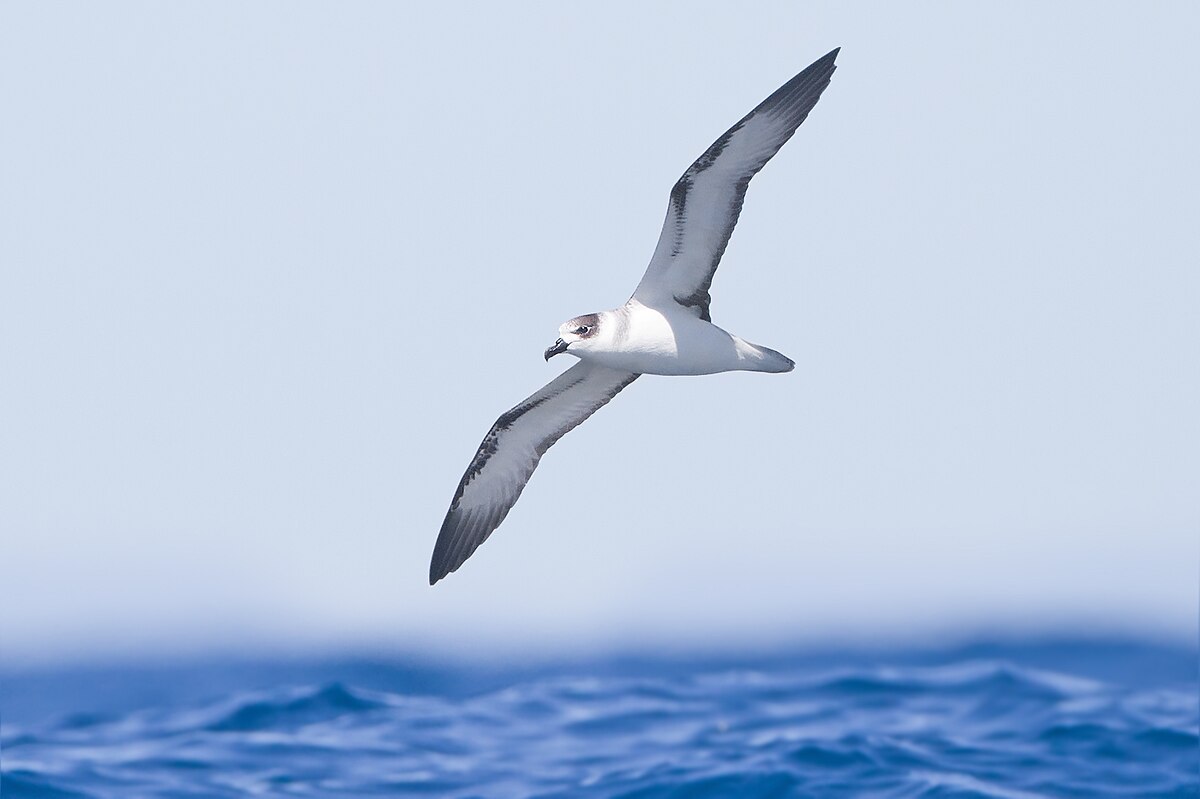
Wikipedia: White-necked petrel Source: OTHER
1200px-Pterodroma_cervicalis_-_SE_Tasmania.jpg
This bird appears across the great seas in the following continents:
North America, Australia.
General: ![]() The white-necked petrel (Pterodroma cervicalis), also known as the white-naped petrel, is a species of seabird in the family Procellariidae. During the non-breeding season it occurs throughout a large part of the Pacific, but it is only known to breed on Macauley Island in New Zealand's Kermadec Islands and the Australian territory of Norfolk Island and Phillip Island. It formerly bred on Raoul Island, but has now been extirpated from this locality. Reports of breeding on Merelava, Vanuatu, are more likely to be the very similar Vanuatu petrel, P. occulta, which some consider to be a subspecies of the white-necked petrel. The IUCN rating as vulnerable is for the "combined" species.
[more]
The white-necked petrel (Pterodroma cervicalis), also known as the white-naped petrel, is a species of seabird in the family Procellariidae. During the non-breeding season it occurs throughout a large part of the Pacific, but it is only known to breed on Macauley Island in New Zealand's Kermadec Islands and the Australian territory of Norfolk Island and Phillip Island. It formerly bred on Raoul Island, but has now been extirpated from this locality. Reports of breeding on Merelava, Vanuatu, are more likely to be the very similar Vanuatu petrel, P. occulta, which some consider to be a subspecies of the white-necked petrel. The IUCN rating as vulnerable is for the "combined" species.
[more]
Profile Wikipedia eBird Audubon AllAboutBirds Xeno-Canto

Wikipedia: Mottled petrel Source: OTHER
Pterodroma_inexpectata.jpg
This bird appears across the great seas in the following continents:
North America, Australia.
![]() The mottled petrel (Pterodroma inexpectata) or kōrure is a species of seabird and a member of the gadfly petrels. It usually attains 33 to 35 cm (13–14 in) in length with a 74 to 82 cm (29–32 in) wingspan.
[more]
The mottled petrel (Pterodroma inexpectata) or kōrure is a species of seabird and a member of the gadfly petrels. It usually attains 33 to 35 cm (13–14 in) in length with a 74 to 82 cm (29–32 in) wingspan.
[more]
Profile Wikipedia eBird Audubon AllAboutBirds Xeno-Canto

Wikipedia: Black-winged petrel Source: OTHER
1200px-BWP_3_-_Christopher_Watson.jpg
This bird appears across the great seas in the following continents:
North America, Australia.
![]() The black-winged petrel (Pterodroma nigripennis) is a species of seabird in the family Procellariidae. It breeds on a number of oceanic islands in the tropical and subtropical East Pacific Ocean and spends the rest of the year at sea.
[more]
The black-winged petrel (Pterodroma nigripennis) is a species of seabird in the family Procellariidae. It breeds on a number of oceanic islands in the tropical and subtropical East Pacific Ocean and spends the rest of the year at sea.
[more]
Profile Wikipedia eBird Audubon AllAboutBirds Xeno-Canto

Wikipedia: Trindade petrel Source: OTHER
Pterodroma_arminjoniana_1.jpeg
This bird appears across the great seas in the following continents:
North America, Australia.
vagrant

Wikipedia: Cook's petrel Source: OTHER
Cookspetrel2.jpg
This bird appears across the great seas in the following continents:
North America, Australia.
General: ![]() Cook's petrel (Pterodroma cookii) or the blue-footed petrel,[2] is a Procellariform seabird. It is a member of the gadfly petrels and part of the subgroup known as Cookilaria petrels, which includes the very similar Stejneger's petrel.
[more]
Cook's petrel (Pterodroma cookii) or the blue-footed petrel,[2] is a Procellariform seabird. It is a member of the gadfly petrels and part of the subgroup known as Cookilaria petrels, which includes the very similar Stejneger's petrel.
[more]
Profile Wikipedia eBird Audubon AllAboutBirds Xeno-Canto NABU

Wikipedia: Fea's petrel Source: OTHER
1200px-Feas_Petrel_From_The_Crossley_ID_Guide_Eastern_Birds.jpg
This bird appears across the great seas in the following continents:
Europe, North America, Africa.
![]() The Fea's petrel (Pterodroma feae), is a small seabird in the gadfly petrel genus, Pterodroma. It was previously considered to be a subspecies of the soft-plumaged petrel (P. mollis), but they are actually not closely related at all. However, P. feae is very closely related to Zino's petrel and Desertas petrel, two other species recently split from P. mollis. The gadfly petrels are named for their speedy weaving flight, as if evading horseflies. The flight action is also reflected in the genus name Pterodroma, from Ancient Greek pteron, "wing" and dromos, " runner".[2] This species is named after the Italian zoologist Leonardo Fea (1852-1903).[3]
[more]
The Fea's petrel (Pterodroma feae), is a small seabird in the gadfly petrel genus, Pterodroma. It was previously considered to be a subspecies of the soft-plumaged petrel (P. mollis), but they are actually not closely related at all. However, P. feae is very closely related to Zino's petrel and Desertas petrel, two other species recently split from P. mollis. The gadfly petrels are named for their speedy weaving flight, as if evading horseflies. The flight action is also reflected in the genus name Pterodroma, from Ancient Greek pteron, "wing" and dromos, " runner".[2] This species is named after the Italian zoologist Leonardo Fea (1852-1903).[3]
[more]
Profile Wikipedia eBird Audubon AllAboutBirds Xeno-Canto

Wikipedia: Murphy's petrel Source: OTHER
1200px-Murphy%27s_petrel%2C_Ducie_island2.jpg
![]() Murphy's petrel (Pterodroma ultima) is a species of seabird and a member of the gadfly petrels. The bird is 15 inches in length, with a 35-inch wingspan and weigh about 13 ounces.[2] It was described by Robert Cushman Murphy in 1949, which is the source of the species' common name.
[more]
Murphy's petrel (Pterodroma ultima) is a species of seabird and a member of the gadfly petrels. The bird is 15 inches in length, with a 35-inch wingspan and weigh about 13 ounces.[2] It was described by Robert Cushman Murphy in 1949, which is the source of the species' common name.
[more]
Profile Wikipedia eBird Audubon AllAboutBirds Xeno-Canto

Wikipedia: Bermuda petrel Source: OTHER
Bermuda_Petrel_From_The_Crossley_ID_Guide_Eastern_Birds%2C_crop.jpg
![]() The Bermuda petrel (Pterodroma cahow) is a gadfly petrel. Commonly known in Bermuda as the cahow, a name derived from its eerie cries, this nocturnal ground-nesting seabird is the national bird of Bermuda and can be found pictured on Bermudian currency. It is the second rarest seabird on the planet and a symbol of hope for nature conservation. They are known for their medium-sized body and long wings. The Bermuda petrel has a greyish-black crown and collar, dark grey upper-wings and tail, white upper-tail coverts and white under-wings edged with black, and the underparts are completely white.
[more]
The Bermuda petrel (Pterodroma cahow) is a gadfly petrel. Commonly known in Bermuda as the cahow, a name derived from its eerie cries, this nocturnal ground-nesting seabird is the national bird of Bermuda and can be found pictured on Bermudian currency. It is the second rarest seabird on the planet and a symbol of hope for nature conservation. They are known for their medium-sized body and long wings. The Bermuda petrel has a greyish-black crown and collar, dark grey upper-wings and tail, white upper-tail coverts and white under-wings edged with black, and the underparts are completely white.
[more]
Profile Wikipedia eBird Audubon AllAboutBirds Xeno-Canto

Wikipedia: Hawaiian petrel Source: OTHER
Hawaiian_Petrel_Pterodroma_sandwichensis_on_lawn.jpg
![]() The Hawaiian petrel or ʻuaʻu (Pterodroma sandwichensis) is a large, dark grey-brown and white petrel that is endemic to Hawaiʻi.
[more]
The Hawaiian petrel or ʻuaʻu (Pterodroma sandwichensis) is a large, dark grey-brown and white petrel that is endemic to Hawaiʻi.
[more]
Profile Wikipedia eBird Audubon AllAboutBirds Xeno-Canto

Wikipedia: Black-capped petrel Source: OTHER
Pterodroma_hasitataPCCA20070623-3608B.jpg
![]() The black-capped petrel (Pterodroma hasitata), also known as the diablotín, is a small seabird native to the West Indies in the gadfly petrel genus, Pterodroma. It is a long-winged petrel with a grey-brown back and wings, with a white nape and rump. Underparts are mainly white apart from a black cap (that in some individuals extends to cover the eye) and some dark underwing markings. It picks food items such as squid from the ocean surface.
[more]
The black-capped petrel (Pterodroma hasitata), also known as the diablotín, is a small seabird native to the West Indies in the gadfly petrel genus, Pterodroma. It is a long-winged petrel with a grey-brown back and wings, with a white nape and rump. Underparts are mainly white apart from a black cap (that in some individuals extends to cover the eye) and some dark underwing markings. It picks food items such as squid from the ocean surface.
[more]
Profile Wikipedia eBird Audubon AllAboutBirds Xeno-Canto
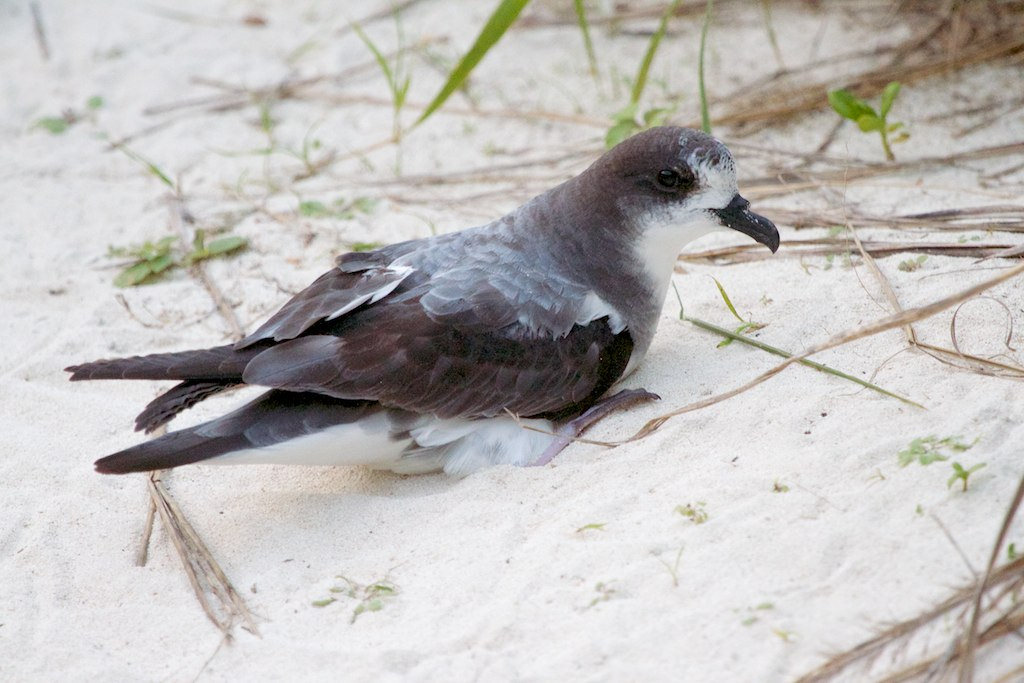
Wikipedia: Bonin petrel Source: OTHER
Pterodroma_hypoleuca_-Midway_Atoll%2C_USA-8.jpg
![]() The Bonin petrel or nunulu[2] (Pterodroma hypoleuca) is a seabird in the family Procellariidae. It is a small gadfly petrel. The species is native to the North Pacific Ocean. Its secretive habits, remote breeding colonies and limited range have resulted in few studies and many aspects of the species' biology are poorly known.
[more]
The Bonin petrel or nunulu[2] (Pterodroma hypoleuca) is a seabird in the family Procellariidae. It is a small gadfly petrel. The species is native to the North Pacific Ocean. Its secretive habits, remote breeding colonies and limited range have resulted in few studies and many aspects of the species' biology are poorly known.
[more]
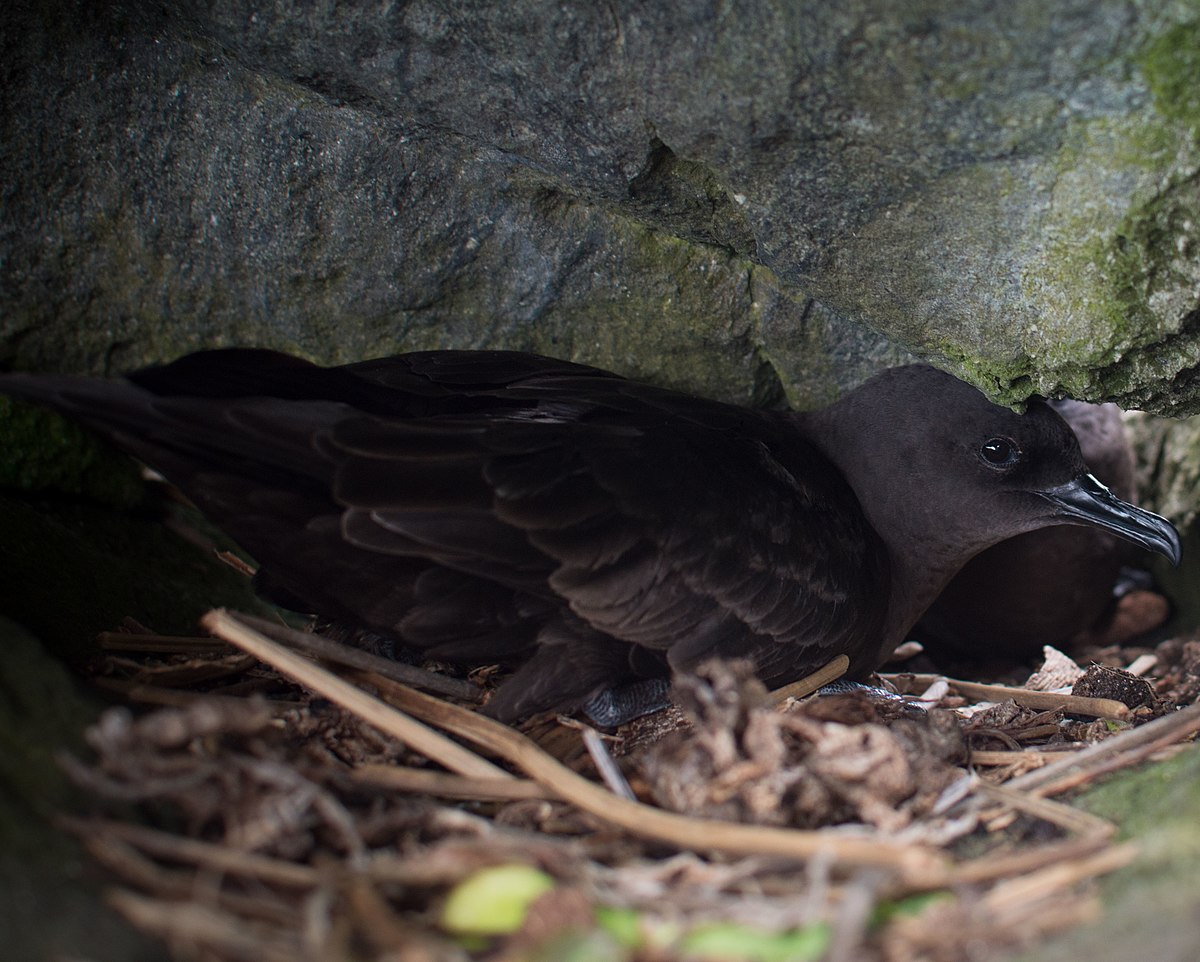
Wikipedia: Bulwer's petrel Source: OTHER
1200px-P%C3%A9trel_de_Bulwer.jpg
This bird appears across the great seas in the following continents:
Europe, North America, Africa, Australia.
![]() Bulwer's petrel (Bulweria bulwerii) is a small petrel in the family Procellariidae, and found in the genus Bulweria (Bonaparte, 1843). This bird is named after the English naturalist James Bulwer.
[more]
Bulwer's petrel (Bulweria bulwerii) is a small petrel in the family Procellariidae, and found in the genus Bulweria (Bonaparte, 1843). This bird is named after the English naturalist James Bulwer.
[more]
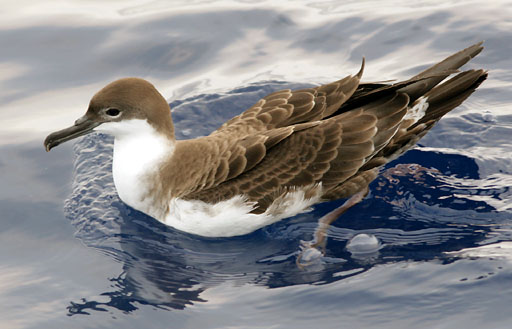
Wikipedia: Great shearwater Source: OTHER
Puffinus_gravisPCCA20070623-3641B.jpg
This bird appears across the great seas in the following continents:
Europe, North America, Africa.
![]() The great shearwater (Ardenna gravis) is a large shearwater in the seabird family Procellariidae. Ardenna was first used to refer to a seabird by Italian naturalist Ulisse Aldrovandi in 1603, and gravis is Latin for "heavy".[3]
[more]
The great shearwater (Ardenna gravis) is a large shearwater in the seabird family Procellariidae. Ardenna was first used to refer to a seabird by Italian naturalist Ulisse Aldrovandi in 1603, and gravis is Latin for "heavy".[3]
[more]
Calls: ![]() Calls at breeding ground a deep, soft, moaning "oooh-aahh" ("surprised or shocked old lady"). Tone fairly clear, and pitch rising and falling. [Link]
Calls at breeding ground a deep, soft, moaning "oooh-aahh" ("surprised or shocked old lady"). Tone fairly clear, and pitch rising and falling. [Link]
Physical details: length=43-51 cm,
wingspan=100-118 cm,
weight=715-950 g
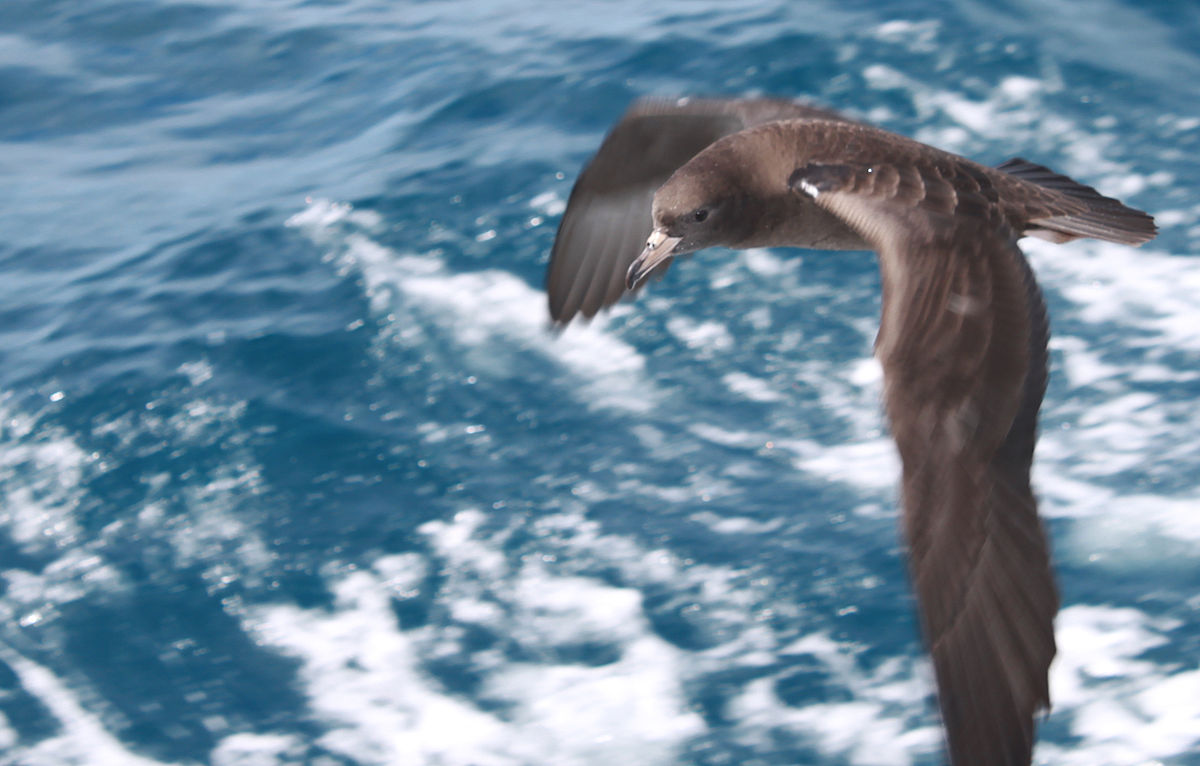
Wikipedia: Flesh-footed shearwater Source: OTHER
1200px-Puffinus_carneipes_-New_Zealand_-flying-8b.jpg
This bird appears across the great seas in the following continents:
North America, Africa.
General: ![]() The flesh-footed shearwater (Ardenna carneipes; formerly Puffinus carneipes) is a medium-sized shearwater. Its plumage is black. It has pale pinkish feet, and a pale bill with a distinct black tip. Together with the equally light-billed pink-footed shearwater, it forms the Hemipuffinus group, a superspecies which may or may not have an Atlantic relative in the great shearwater.[2][3] These large shearwaters are among those that have been separated into the genus Ardenna.[4] Recent genetic analysis indicates evidence of strong divergence between Pacific colonies relative to those in South and Western Australia, thought to be explained by philopatry and differences in foraging strategies during the breeding season.[5]
[more]
The flesh-footed shearwater (Ardenna carneipes; formerly Puffinus carneipes) is a medium-sized shearwater. Its plumage is black. It has pale pinkish feet, and a pale bill with a distinct black tip. Together with the equally light-billed pink-footed shearwater, it forms the Hemipuffinus group, a superspecies which may or may not have an Atlantic relative in the great shearwater.[2][3] These large shearwaters are among those that have been separated into the genus Ardenna.[4] Recent genetic analysis indicates evidence of strong divergence between Pacific colonies relative to those in South and Western Australia, thought to be explained by philopatry and differences in foraging strategies during the breeding season.[5]
[more]

Wikipedia: Pink-footed shearwater Source: OTHER
Shearwater_pink-footed_ventral_fall_monterey_calif_2a.jpg
This bird appears across the great seas in the following continents:
North America, South America, Australia.
vagrant

Wikipedia: Short-tailed shearwater Source: OTHER
1200px-Puffinus_tenuirostris_-_SE_Tasmania.jpg
This bird appears across the great seas in the following continents:
North America, South America, Australia.
General: ![]() The short-tailed shearwater or slender-billed shearwater (Ardenna tenuirostris; formerly Puffinus tenuirostris), also called yolla or moonbird, and commonly known as the muttonbird in Australia, is the most abundant seabird species in Australian waters, and is one of the few Australian native birds in which the chicks are commercially harvested. It is a migratory species that breeds mainly on small islands in Bass Strait and Tasmania and migrates to the Northern Hemisphere for the boreal summer.
[more]
The short-tailed shearwater or slender-billed shearwater (Ardenna tenuirostris; formerly Puffinus tenuirostris), also called yolla or moonbird, and commonly known as the muttonbird in Australia, is the most abundant seabird species in Australian waters, and is one of the few Australian native birds in which the chicks are commercially harvested. It is a migratory species that breeds mainly on small islands in Bass Strait and Tasmania and migrates to the Northern Hemisphere for the boreal summer.
[more]

Wikipedia: Buller's shearwater Source: OTHER
Bullershearwater.jpg
This bird appears across the great seas in the following continents:
North America, Australia.
![]() Buller's shearwater (Ardenna bulleri) is a Pacific species of seabird in the family Procellariidae; it is also known as the grey-backed shearwater or New Zealand shearwater. A member of the black-billed wedge-tailed Thyellodroma group, among the larger shearwaters of the genus Ardenna, it forms a superspecies with the wedge-tailed shearwater (A. pacificus).[2]
[more]
Buller's shearwater (Ardenna bulleri) is a Pacific species of seabird in the family Procellariidae; it is also known as the grey-backed shearwater or New Zealand shearwater. A member of the black-billed wedge-tailed Thyellodroma group, among the larger shearwaters of the genus Ardenna, it forms a superspecies with the wedge-tailed shearwater (A. pacificus).[2]
[more]
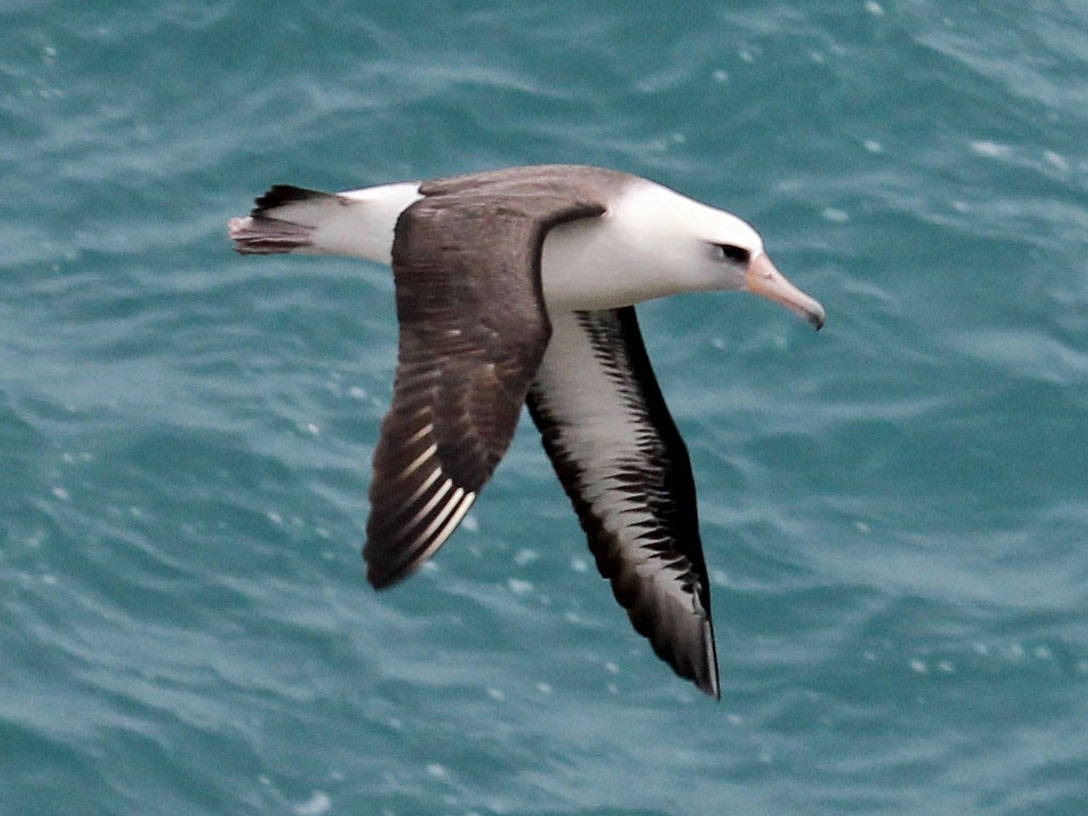
Wikipedia: Laysan albatross Source: OTHER
Laysan_Albatross_RWD2.jpg
This bird appears across the great seas in the following continents:
North America, Africa.
![]() The Laysan albatross (Phoebastria immutabilis) is a large seabird that ranges across the North Pacific. The Northwestern Hawaiian Islands are home to 99.7% of the population. This small (for its family) gull-like albatross is the second-most common seabird in the Hawaiian Islands, with an estimated population of 2.5 million birds, and is currently expanding (or possibly re-expanding) its range to new islands. The Laysan albatross was first described as Diomedea immutabilis by Lionel Walter Rothschild, in 1893, on the basis of a specimen from Laysan Island.[3]
[more]
The Laysan albatross (Phoebastria immutabilis) is a large seabird that ranges across the North Pacific. The Northwestern Hawaiian Islands are home to 99.7% of the population. This small (for its family) gull-like albatross is the second-most common seabird in the Hawaiian Islands, with an estimated population of 2.5 million birds, and is currently expanding (or possibly re-expanding) its range to new islands. The Laysan albatross was first described as Diomedea immutabilis by Lionel Walter Rothschild, in 1893, on the basis of a specimen from Laysan Island.[3]
[more]
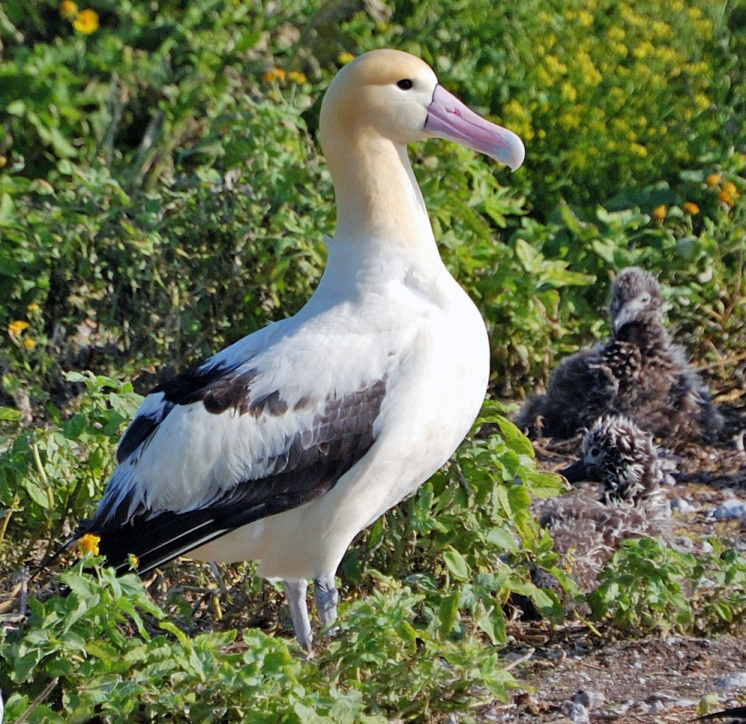
Wikipedia: Short-tailed albatross Source: OTHER
Short_tailed_Albatross1.jpg
![]() The short-tailed albatross or Steller's albatross (Phoebastria albatrus) is a large rare seabird from the North Pacific. Although related to the other North Pacific albatrosses, it also exhibits behavioural and morphological links to the albatrosses of the Southern Ocean. It was described by the German naturalist Peter Simon Pallas from skins collected by Georg Wilhelm Steller (after whom its other common name is derived). Once common, it was brought to the edge of extinction by the trade in feathers, but with protection efforts underway since the 1950's, the species is in the process of recovering with an increasing population trend. Its breeding range, however, remains small.[4]
[more]
The short-tailed albatross or Steller's albatross (Phoebastria albatrus) is a large rare seabird from the North Pacific. Although related to the other North Pacific albatrosses, it also exhibits behavioural and morphological links to the albatrosses of the Southern Ocean. It was described by the German naturalist Peter Simon Pallas from skins collected by Georg Wilhelm Steller (after whom its other common name is derived). Once common, it was brought to the edge of extinction by the trade in feathers, but with protection efforts underway since the 1950's, the species is in the process of recovering with an increasing population trend. Its breeding range, however, remains small.[4]
[more]
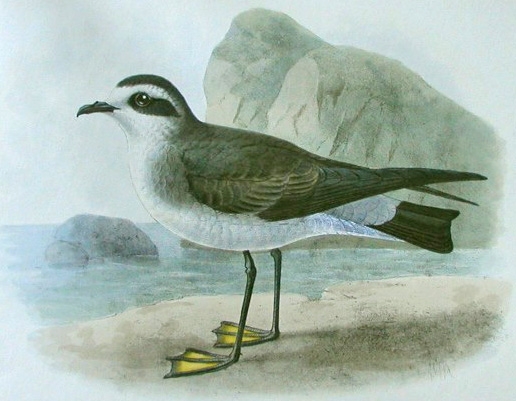
Wikipedia: White-faced storm-petrel Source: OTHER
Godmanstormlg.jpg
This bird appears across the great seas in the following continents:
Europe, North America, South America, Africa.
![]() The white-faced storm petrel (Pelagodroma marina), also known as white-faced petrel is a small seabird of the austral storm petrel family Oceanitidae. It is the only member of the monotypic genus Pelagodroma.
[more]
The white-faced storm petrel (Pelagodroma marina), also known as white-faced petrel is a small seabird of the austral storm petrel family Oceanitidae. It is the only member of the monotypic genus Pelagodroma.
[more]
Profile Wikipedia eBird Audubon AllAboutBirds Xeno-Canto

Wikipedia: Matsudaira's storm-petrel Source: OTHER
012016-IMG_5713_Matsudaira%27s_Storm-Petrel_%28Oceanodroma_matsudairae%29_%288005427860%29.jpg
This bird appears across the great seas in the following continents:
North America, Africa.
![]() Matsudaira's storm petrel (Oceanodroma matsudairae) is a species of seabird in the family Hydrobatidae.
[more]
Matsudaira's storm petrel (Oceanodroma matsudairae) is a species of seabird in the family Hydrobatidae.
[more]

Wikipedia: Band-rumped storm-petrel Source: OTHER
1200px-Band_rumped_storm_petrel_Andre_Raine_KESRP_%2821789178016%29.jpg
This bird appears across the great seas in the following continents:
Europe, North America, South America, Africa, Australia.
vagrant

Wikipedia: Tristram's storm-petrel Source: OTHER
1200px-Tristram%27s_storm_petrel_on_Nihoa_Island_%2826642384862%29.jpg
This bird appears across the great seas in the following continents:
North America, Australia.
vagrant
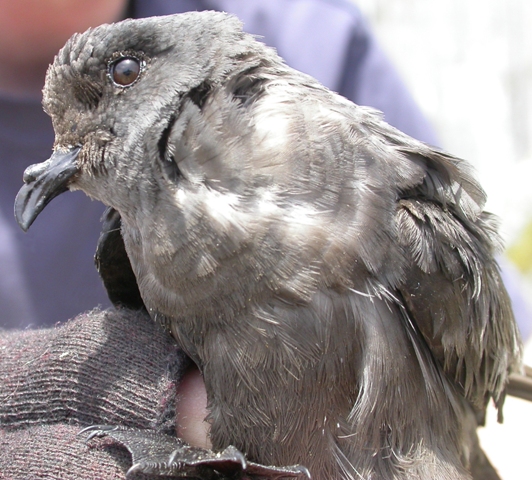
Wikipedia: Ashy storm-petrel Source: OTHER
Ashystormpetrel.jpeg
General: ![]() The ashy storm petrel (Oceanodroma homochroa) is a small, scarce seabird of the storm petrel family Hydrobatidae. It breeds colonially on islands off the coasts of California and Mexico, and is one of six species of storm petrel that live and feed in the rich California Current system.
[more]
The ashy storm petrel (Oceanodroma homochroa) is a small, scarce seabird of the storm petrel family Hydrobatidae. It breeds colonially on islands off the coasts of California and Mexico, and is one of six species of storm petrel that live and feed in the rich California Current system.
[more]
Wikipedia: Black storm-petrel Source: OTHER
BlackStormPetrels.JPG
![]() The black storm petrel (Oceanodroma melania) is a small seabird of the storm petrel family Hydrobatidae. It is 23 cm in length, with a wingspan of 46–51 cm.
[more]
The black storm petrel (Oceanodroma melania) is a small seabird of the storm petrel family Hydrobatidae. It is 23 cm in length, with a wingspan of 46–51 cm.
[more]

Wikipedia: Wilson's storm-petrel Source: OTHER
1200px-Oceanites_oceanicus_-_SE_Tasmania.jpg
This bird appears across the great seas in the following continents:
Europe, North America, South America, Africa, Asia.
![]() Wilson's storm petrel (Oceanites oceanicus), also known as Wilson's petrel, is a small seabird of the austral storm petrel family Oceanitidae. It is one of the most abundant bird species in the world and has a circumpolar distribution mainly in the seas of the southern hemisphere but extending northwards during the summer of the northern hemisphere. The world population has been estimated to be more than 50 million pairs.[2] The name commemorates the Scottish-American ornithologist Alexander Wilson. The genus name Oceanites refers to the mythical Oceanids, the three thousand daughters of Tethys. The species name is from Latin oceanus, "ocean".[3]
[more]
Wilson's storm petrel (Oceanites oceanicus), also known as Wilson's petrel, is a small seabird of the austral storm petrel family Oceanitidae. It is one of the most abundant bird species in the world and has a circumpolar distribution mainly in the seas of the southern hemisphere but extending northwards during the summer of the northern hemisphere. The world population has been estimated to be more than 50 million pairs.[2] The name commemorates the Scottish-American ornithologist Alexander Wilson. The genus name Oceanites refers to the mythical Oceanids, the three thousand daughters of Tethys. The species name is from Latin oceanus, "ocean".[3]
[more]

Wikipedia: Great horned owl Source: OTHER
1200px-Bubo_virginianus_06.jpg
![]() About 12, see text
[more]
About 12, see text
[more]

Wikipedia: Snowy owl Source: OTHER
1200px-Snowy_Owl_%28240866707%29.jpeg
This bird appears across the great seas in the following continents:
Europe, North America.
![]() The snowy owl (Bubo scandiacus), also known as the polar owl, the white owl and the Arctic owl,[3] is a large, white owl of the true owl family.[4] Snowy owls are native to the Arctic regions of both North America and the Palearctic, breeding mostly on the tundra.[2] It has a number of unique adaptations to its habitat and lifestyle, which are quite distinct from other extant owls.[5] One of the largest species of owl, it is the only owl with largely white plumage.[4] Males tend to be a purer white overall while females tend to more have more extensive flecks of dark brown.[6] Juvenile male snowy owls have dark markings that may appear similar to females until maturity, at which point they typically turn whiter. The composition of brown markings about the wing, although not foolproof, is the most reliable technique to age and sex individual snowy owls.[7]
[more]
The snowy owl (Bubo scandiacus), also known as the polar owl, the white owl and the Arctic owl,[3] is a large, white owl of the true owl family.[4] Snowy owls are native to the Arctic regions of both North America and the Palearctic, breeding mostly on the tundra.[2] It has a number of unique adaptations to its habitat and lifestyle, which are quite distinct from other extant owls.[5] One of the largest species of owl, it is the only owl with largely white plumage.[4] Males tend to be a purer white overall while females tend to more have more extensive flecks of dark brown.[6] Juvenile male snowy owls have dark markings that may appear similar to females until maturity, at which point they typically turn whiter. The composition of brown markings about the wing, although not foolproof, is the most reliable technique to age and sex individual snowy owls.[7]
[more]
Song: ![]() Song consists of single utterances or series of "aooo", recalling Great Black-backed Gull, and is far carrying. [Link]
Song consists of single utterances or series of "aooo", recalling Great Black-backed Gull, and is far carrying. [Link]
Calls: ![]() Male warning call a deep and harsh "groat grat grat", with accented endings of each syllable. Female warning call higher pitched. Also various other high pitched calls. [Link]
Male warning call a deep and harsh "groat grat grat", with accented endings of each syllable. Female warning call higher pitched. Also various other high pitched calls. [Link]
Physical details: length=53-66 cm,
wingspan=142-166 cm,
weight=1200-2900 g

Wikipedia: Northern barred owl Source: OTHER
1200px-Strix-varia-005.jpg
First observed in New England on 2023-10-04.
This bird appears across the great seas in the following continents:
Europe, North America.
General: ![]() Syrnium varium
[more]
Syrnium varium
[more]
Call:
We heard this in New England after sunset, and swore it sounded like monkeys. Merlin's SoundID told it was a barred owl, and when I looked up 'barred owl monkey' in the internet, I found that monkey call is a common description, for instance here.
Call attributes:
Call melody: one note, slow, Frequency: 0-1 KHz,

Wikipedia: Great grey owl Source: OTHER
Strix_nebulosaRB.jpg
This bird appears across the great seas in the following continents:
Europe, North America.
![]() The great grey owl or great gray owl (Strix nebulosa) is a very large owl, documented as the world's largest species of owl by length. It is distributed across the Northern Hemisphere, and it is the only species in the genus Strix found in both Eastern and Western Hemispheres. In some areas it is also called Phantom of the North, cinereous owl, spectral owl, Lapland owl, spruce owl, bearded owl, and sooty owl.[2]
[more]
The great grey owl or great gray owl (Strix nebulosa) is a very large owl, documented as the world's largest species of owl by length. It is distributed across the Northern Hemisphere, and it is the only species in the genus Strix found in both Eastern and Western Hemispheres. In some areas it is also called Phantom of the North, cinereous owl, spectral owl, Lapland owl, spruce owl, bearded owl, and sooty owl.[2]
[more]
Song: ![]() Song: Cyclic, repetitive, very deep calls rising and falling in volume. Accented start and end of each "hooh". [Link]
Song: Cyclic, repetitive, very deep calls rising and falling in volume. Accented start and end of each "hooh". [Link]
Calls: ![]() As the call fades away in volume, the speed accelerates. Sometimes disyllabic "ho-ho,ho-ho,ho-ho,ho-ho". [Link]
As the call fades away in volume, the speed accelerates. Sometimes disyllabic "ho-ho,ho-ho,ho-ho,ho-ho". [Link]
Physical details: length=65-70 cm,
wingspan=134-158 cm,
weight=500-1500 g

Wikipedia: Spotted owl Source: OTHER
1200px-Northern_Spotted_Owl.USFWS.jpg
General: ![]() The spotted owl (Strix occidentalis) is a species of true owl. It is a resident species of old-growth forests in western North America, where it nests in tree hollows, old bird of prey nests, or rock crevices. Nests can be between 12 and 60 metres (39 and 197 ft) high and usually contain two eggs (though some contain as many as four). It is a nocturnal owl which feeds on small mammals and birds. Three subspecies are recognized, ranging in distribution from British Columbia to Mexico. The spotted owl is under pressure from habitat destruction throughout its range, and is currently classified as a near-threatened species.[2][3]
[more]
The spotted owl (Strix occidentalis) is a species of true owl. It is a resident species of old-growth forests in western North America, where it nests in tree hollows, old bird of prey nests, or rock crevices. Nests can be between 12 and 60 metres (39 and 197 ft) high and usually contain two eggs (though some contain as many as four). It is a nocturnal owl which feeds on small mammals and birds. Three subspecies are recognized, ranging in distribution from British Columbia to Mexico. The spotted owl is under pressure from habitat destruction throughout its range, and is currently classified as a near-threatened species.[2][3]
[more]

Wikipedia: Boreal owl Source: OTHER
Aegolius-funereus-001.jpg
This bird appears across the great seas in the following continents:
Europe, North America.
Deutschland: Brut-, Jahresvogel
Habitats:
Forest
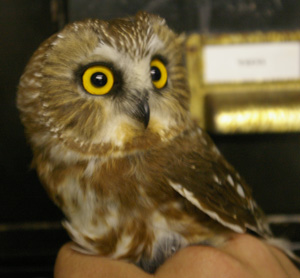
Wikipedia: Northern saw-whet owl Source: OTHER
Northern_Saw-Whet_Owl.jpg
General: ![]() The northern saw-whet owl (Aegolius acadicus) is a small owl native to North America. Saw-whet owls are one of the smallest owl species in North America. They can be found in dense thickets or conifers, often at eye level, although they can also be found some 20 feet up. Saw-whets are often in danger of being preyed upon by larger owls and raptors. Northern saw-whet owls are also migratory birds without any strict pattern.
[more]
The northern saw-whet owl (Aegolius acadicus) is a small owl native to North America. Saw-whet owls are one of the smallest owl species in North America. They can be found in dense thickets or conifers, often at eye level, although they can also be found some 20 feet up. Saw-whets are often in danger of being preyed upon by larger owls and raptors. Northern saw-whet owls are also migratory birds without any strict pattern.
[more]

Wikipedia: Short-eared owl Source: OTHER
1200px-Hibou_des_marais.jpg
This bird appears across the great seas in the following continents:
Europe, North America, South America, Africa, Asia.
Deutschland: Brut-, Zugvogel, Wintergast RL 1
Habitats:
Wetland

Wikipedia: Long-eared owl Source: OTHER
Waldohreule_in_freier_Wildbahn.jpg
This bird appears across the great seas in the following continents:
Europe, North America, Africa.
Deutschland: Brut-, Jahres-, Zugvogel, Wintergast
Habitats:
Agricultural

Wikipedia: Flammulated owl Source: OTHER
Flammulated_owl.jpg
General: ![]() The flammulated owl (Psiloscops flammeolus) is a small migratory North American owl in the family Strigidae. It is the only species placed in the genus Psiloscops.
[more]
The flammulated owl (Psiloscops flammeolus) is a small migratory North American owl in the family Strigidae. It is the only species placed in the genus Psiloscops.
[more]
Profile Wikipedia eBird A-Z Animals Audubon AllAboutBirds Xeno-Canto
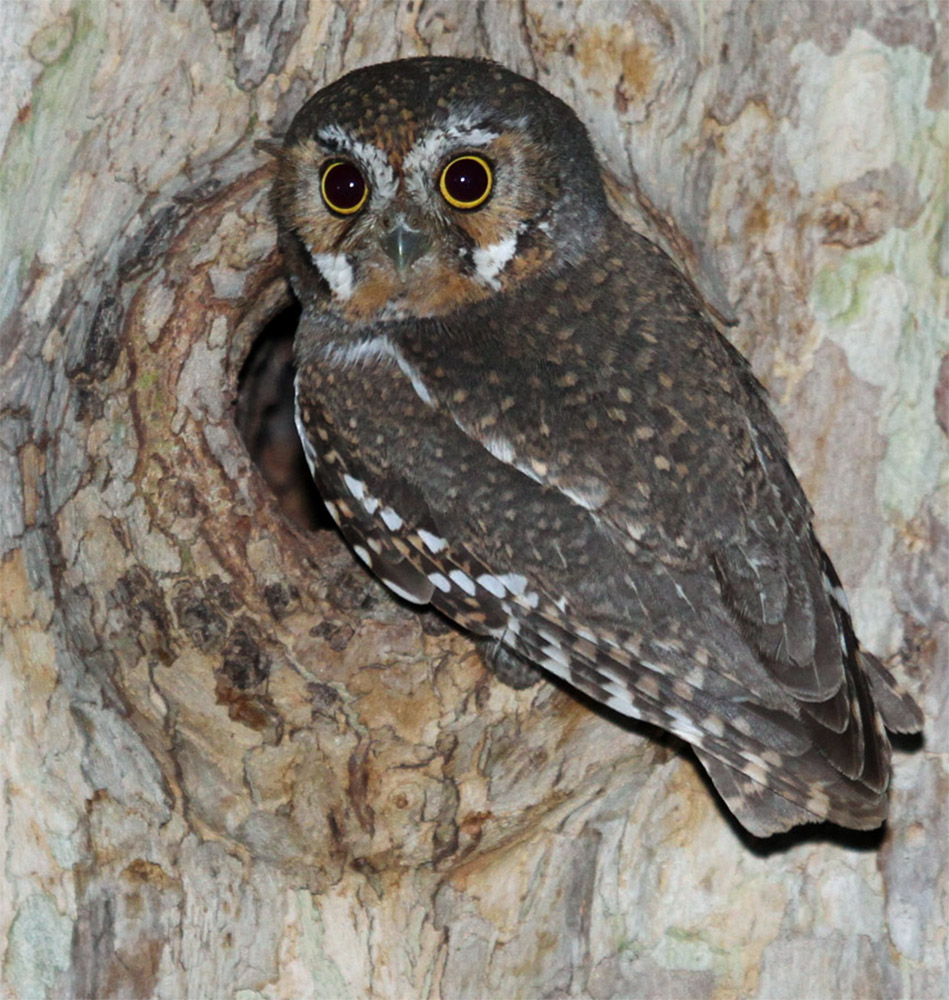
Wikipedia: Elf owl Source: OTHER
Micrathene_whitneyi_29APR12_Madera_Canyon_AZ.jpg
![]() The elf owl (Micrathene whitneyi) is a small grayish-brown bird about the size of a sparrow found in the Southwestern United States, central Mexico, and the Baja California peninsula.[2][3] It has pale yellow eyes highlighted by thin white "eyebrows" and a gray bill with a horn-colored tip. The elf owl frequently inhabits woodpecker holes in saguaro cacti; it also nests in natural tree cavities.[4] It is nocturnal and feeds primarily on insects.[5]
[more]
The elf owl (Micrathene whitneyi) is a small grayish-brown bird about the size of a sparrow found in the Southwestern United States, central Mexico, and the Baja California peninsula.[2][3] It has pale yellow eyes highlighted by thin white "eyebrows" and a gray bill with a horn-colored tip. The elf owl frequently inhabits woodpecker holes in saguaro cacti; it also nests in natural tree cavities.[4] It is nocturnal and feeds primarily on insects.[5]
[more]
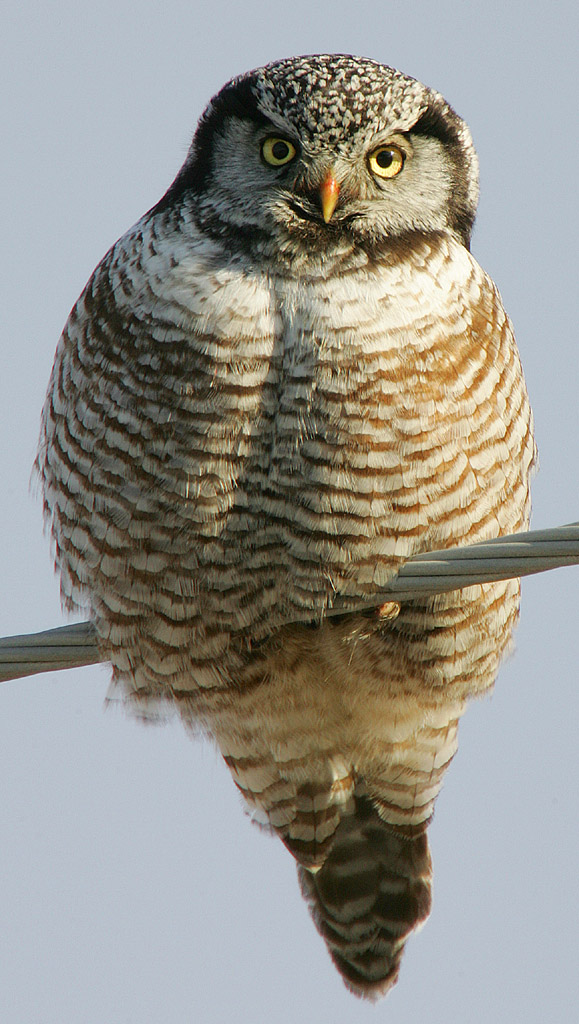
Wikipedia: Northern hawk-owl Source: OTHER
Surnia-ulula-002.jpg
This bird appears across the great seas in the following continents:
Europe, North America, Africa.
![]() The northern hawk-owl or northern hawk owl (Surnia ulula) is a medium-sized true owl of the northern latitudes. It is non-migratory and usually stays within its breeding range, though it sometimes irrupts southward. It is one of the few owls that is neither nocturnal nor crepuscular, being active only during the day. This is the only living species in the genus Surnia of the family Strigidae, the "typical" owls (as opposed to barn owls, Tytonidae). The species is sometimes called simply the hawk owl; however, many species of owls in the genus Ninox are also called "hawk owls".
[more]
The northern hawk-owl or northern hawk owl (Surnia ulula) is a medium-sized true owl of the northern latitudes. It is non-migratory and usually stays within its breeding range, though it sometimes irrupts southward. It is one of the few owls that is neither nocturnal nor crepuscular, being active only during the day. This is the only living species in the genus Surnia of the family Strigidae, the "typical" owls (as opposed to barn owls, Tytonidae). The species is sometimes called simply the hawk owl; however, many species of owls in the genus Ninox are also called "hawk owls".
[more]
Profile Wikipedia eBird Audubon AllAboutBirds Xeno-Canto
Ferruginous pygmy owl - what a name! 2023-04-16 08.56.50 Yucatan
First observed in Yucatan on 2023-04-16.
![]() The ferruginous pygmy owl (Glaucidium brasilianum) is a small owl that breeds in south-central Arizona and southern Texas in the United States, south through Mexico and Central America, to South America into Bolivia, Paraguay and Argentina.
[more]
The ferruginous pygmy owl (Glaucidium brasilianum) is a small owl that breeds in south-central Arizona and southern Texas in the United States, south through Mexico and Central America, to South America into Bolivia, Paraguay and Argentina.
[more]

Wikipedia: Burrowing owl Source: OTHER
1200px-Brazilian_burrowing_owl_%28Athene_cunicularia_grallaria%29.jpg
![]() The burrowing owl (Athene cunicularia) is a small, long-legged owl found throughout open landscapes of North and South America. Burrowing owls can be found in grasslands, rangelands, agricultural areas, deserts, or any other open dry area with low vegetation.[2] They nest and roost in burrows, such as those excavated by prairie dogs (Cynomys spp.). Unlike most owls, burrowing owls are often active during the day, although they tend to avoid the midday heat. Like many other kinds of owls, though, burrowing owls do most of their hunting from dusk until dawn, when they can use their night vision and hearing to their advantage. Living in open grasslands as opposed to forests, the burrowing owl has developed longer legs that enable it to sprint, as well as fly, when hunting.
[more]
The burrowing owl (Athene cunicularia) is a small, long-legged owl found throughout open landscapes of North and South America. Burrowing owls can be found in grasslands, rangelands, agricultural areas, deserts, or any other open dry area with low vegetation.[2] They nest and roost in burrows, such as those excavated by prairie dogs (Cynomys spp.). Unlike most owls, burrowing owls are often active during the day, although they tend to avoid the midday heat. Like many other kinds of owls, though, burrowing owls do most of their hunting from dusk until dawn, when they can use their night vision and hearing to their advantage. Living in open grasslands as opposed to forests, the burrowing owl has developed longer legs that enable it to sprint, as well as fly, when hunting.
[more]

Wikipedia: Eastern screech-owl Source: OTHER
1200px-Eastern_Screech_Owl.jpg
![]() The eastern screech owl (Megascops asio) or eastern screech-owl, is a small owl that is relatively common in Eastern North America, from Mexico to Canada.[1][2] This species is native to most wooded environments of its distribution, and more so than any other owl in its range, has adapted well to manmade development, although it frequently avoids detection due to its strictly nocturnal habits.[3]
[more]
The eastern screech owl (Megascops asio) or eastern screech-owl, is a small owl that is relatively common in Eastern North America, from Mexico to Canada.[1][2] This species is native to most wooded environments of its distribution, and more so than any other owl in its range, has adapted well to manmade development, although it frequently avoids detection due to its strictly nocturnal habits.[3]
[more]

Wikipedia: Whiskered screech-owl Source: OTHER
1200px-Megascops_trichopsis.jpg
![]() The whiskered screech owl (Megascops trichopsis) is a small screech owl found in North and Central America.
[more]
The whiskered screech owl (Megascops trichopsis) is a small screech owl found in North and Central America.
[more]
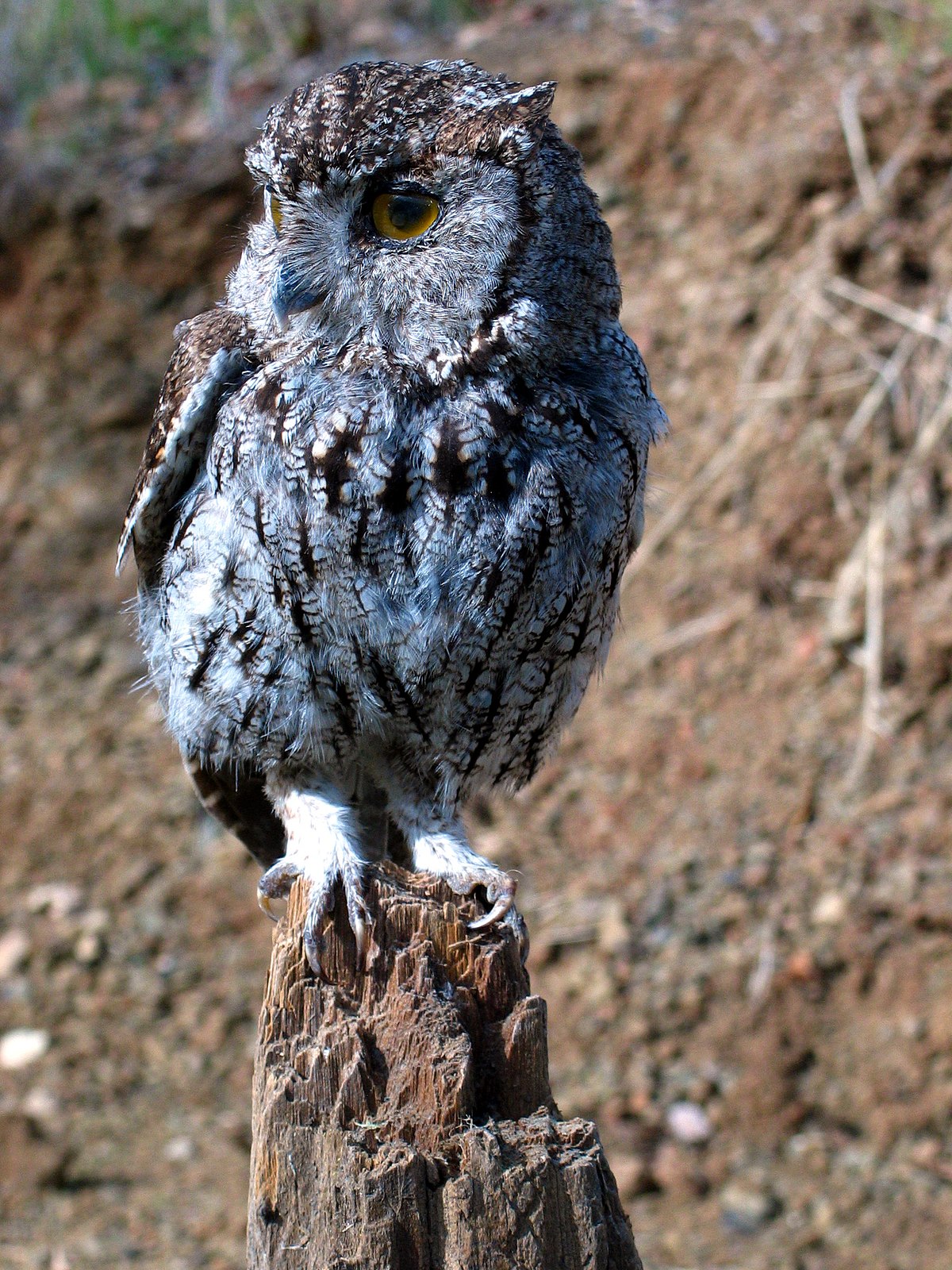
Wikipedia: Western screech-owl Source: OTHER
1200px-Megascops_kennicottii_USDOI.jpg
![]() The western screech owl (Megascops kennicottii) is a small owl native to North and Central America, closely related to the eastern screech owl. The scientific name commemorates the American naturalist Robert Kennicott.
[more]
The western screech owl (Megascops kennicottii) is a small owl native to North and Central America, closely related to the eastern screech owl. The scientific name commemorates the American naturalist Robert Kennicott.
[more]

Wikipedia: Barn owl Source: OTHER
1200px-Tyto_alba_-British_Wildlife_Centre%2C_Surrey%2C_England-8a_%281%29.jpg
This bird appears across the great seas in the following continents:
Europe, North America, South America, Africa, Asia.
![]() The barn owl (Tyto alba) is the most widely distributed species of owl in the world and one of the most widespread of all species of birds, being found almost everywhere in the world except for the polar and desert regions, Asia north of the Himalayas, most of Indonesia, and some Pacific Islands. It is also known as the common barn owl, to distinguish it from the other species in its family, Tytonidae, which forms one of the two main lineages of living owls, the other being the typical owls (Strigidae).
[more]
The barn owl (Tyto alba) is the most widely distributed species of owl in the world and one of the most widespread of all species of birds, being found almost everywhere in the world except for the polar and desert regions, Asia north of the Himalayas, most of Indonesia, and some Pacific Islands. It is also known as the common barn owl, to distinguish it from the other species in its family, Tytonidae, which forms one of the two main lineages of living owls, the other being the typical owls (Strigidae).
[more]
Vocalization: ![]() Large repertoire of mainly hissing and screeching sounds. [Link]
Large repertoire of mainly hissing and screeching sounds. [Link]
Song: ![]() Song consists of a single, drawn screech, lasting about a second and is often performed in flight. Starting in a very hoarse tone, then progressing with a rising pitch into a more burbling sound, before suddenly ending. [Link]
Song consists of a single, drawn screech, lasting about a second and is often performed in flight. Starting in a very hoarse tone, then progressing with a rising pitch into a more burbling sound, before suddenly ending. [Link]
Physical details: length=33-35 cm,
wingspan=80-95 cm,
weight=240-350 g
Habitats:
Agricultural
Profile Wikipedia eBird Audubon AllAboutBirds Xeno-Canto

Wikipedia: Elegant trogon Source: OTHER
1200px-Elegant_Trogon.jpg
General: ![]() The elegant trogon (Trogon elegans) (formerly the "coppery-tailed" trogon) is a near passerine bird in the trogon family.[2] Along with the eared quetzal, it is the most poleward-occurring species of trogon in the world, ranging from Guatemala in the south as far north as the upper Gila River in Arizona and New Mexico. The most northerly populations of subspecies ambiguus are partially migratory,[3] and the species is occasionally found as a vagrant in southeasternmost and western Texas.
[more]
The elegant trogon (Trogon elegans) (formerly the "coppery-tailed" trogon) is a near passerine bird in the trogon family.[2] Along with the eared quetzal, it is the most poleward-occurring species of trogon in the world, ranging from Guatemala in the south as far north as the upper Gila River in Arizona and New Mexico. The most northerly populations of subspecies ambiguus are partially migratory,[3] and the species is occasionally found as a vagrant in southeasternmost and western Texas.
[more]
Profile Wikipedia eBird Audubon AllAboutBirds Xeno-Canto

Wikipedia: Micronesian scrubfowl Source: OTHER
1200px-Micronesian_megapode_6.jpg
![]() The Micronesian megapode or Micronesian scrubfowl (Megapodius laperouse) is an endangered megapode which inhabits islands of the Western Pacific Ocean.
[more]
The Micronesian megapode or Micronesian scrubfowl (Megapodius laperouse) is an endangered megapode which inhabits islands of the Western Pacific Ocean.
[more]
Profile Wikipedia eBird Audubon AllAboutBirds Xeno-Canto
Plain chachalaca, Ecotucan, Bacalar. 2023-03-31 16.26.24 Yucatan
First observed in Yucatan on 2023-03-29.
![]() The plain chachalaca (Ortalis vetula) is a large bird in the chachalaca, guan and curassow family Cracidae. It breeds in tropical and subtropical environments from mezquital thickets in the Rio Grande Valley in southernmost Texas, United States to northernmost Costa Rica. In Central America, this species occurs in the Pacific lowlands from Chiapas, Mexico to northern Nicaragua and as a separate population in Costa Rica, where its range is separated by a short distance, as a disjunct population.
[more]
The plain chachalaca (Ortalis vetula) is a large bird in the chachalaca, guan and curassow family Cracidae. It breeds in tropical and subtropical environments from mezquital thickets in the Rio Grande Valley in southernmost Texas, United States to northernmost Costa Rica. In Central America, this species occurs in the Pacific lowlands from Chiapas, Mexico to northern Nicaragua and as a separate population in Costa Rica, where its range is separated by a short distance, as a disjunct population.
[more]
Profile Wikipedia eBird Audubon AllAboutBirds Xeno-Canto

Wikipedia: Red junglefowl Source: OTHER
Red_Junglefowl_-_Thailand.jpg
This bird appears across the great seas in the following continents:
North America, Asia.
![]() The red junglefowl (Gallus gallus) is a tropical bird in the family Phasianidae. It ranges across much of Southeast Asia and parts of South Asia. Red junglefowl are the primary ancestor of the domestic chicken (Gallus gallus domesticus); the grey junglefowl, Sri Lankan junglefowl and green junglefowl have also contributed genetic material to the gene pool of the chicken.[2][3]
[more]
The red junglefowl (Gallus gallus) is a tropical bird in the family Phasianidae. It ranges across much of Southeast Asia and parts of South Asia. Red junglefowl are the primary ancestor of the domestic chicken (Gallus gallus domesticus); the grey junglefowl, Sri Lankan junglefowl and green junglefowl have also contributed genetic material to the gene pool of the chicken.[2][3]
[more]

Wikipedia: Kalij pheasant Source: OTHER
1200px-Kalij_pheasant_Prasanna_Mamidala.jpg
![]() The kalij pheasant (Lophura leucomelanos) is a pheasant found in forests and thickets, especially in the Himalayan foothills, from Pakistan to western Thailand. Males are rather variable depending on the subspecies involved, but all have an at least partially glossy bluish-black plumage, while females are overall brownish. Both sexes have a bare red face and greyish legs (the latter separating it from the red-legged silver pheasant).[2] It is generally common and widespread, though three of its eastern subspecies (L. l. oatesi, L. l. lineata, and L. l. crawfurdi) are considered threatened and L. l. moffitti is virtually unknown in the wild.[2]
[more]
The kalij pheasant (Lophura leucomelanos) is a pheasant found in forests and thickets, especially in the Himalayan foothills, from Pakistan to western Thailand. Males are rather variable depending on the subspecies involved, but all have an at least partially glossy bluish-black plumage, while females are overall brownish. Both sexes have a bare red face and greyish legs (the latter separating it from the red-legged silver pheasant).[2] It is generally common and widespread, though three of its eastern subspecies (L. l. oatesi, L. l. lineata, and L. l. crawfurdi) are considered threatened and L. l. moffitti is virtually unknown in the wild.[2]
[more]
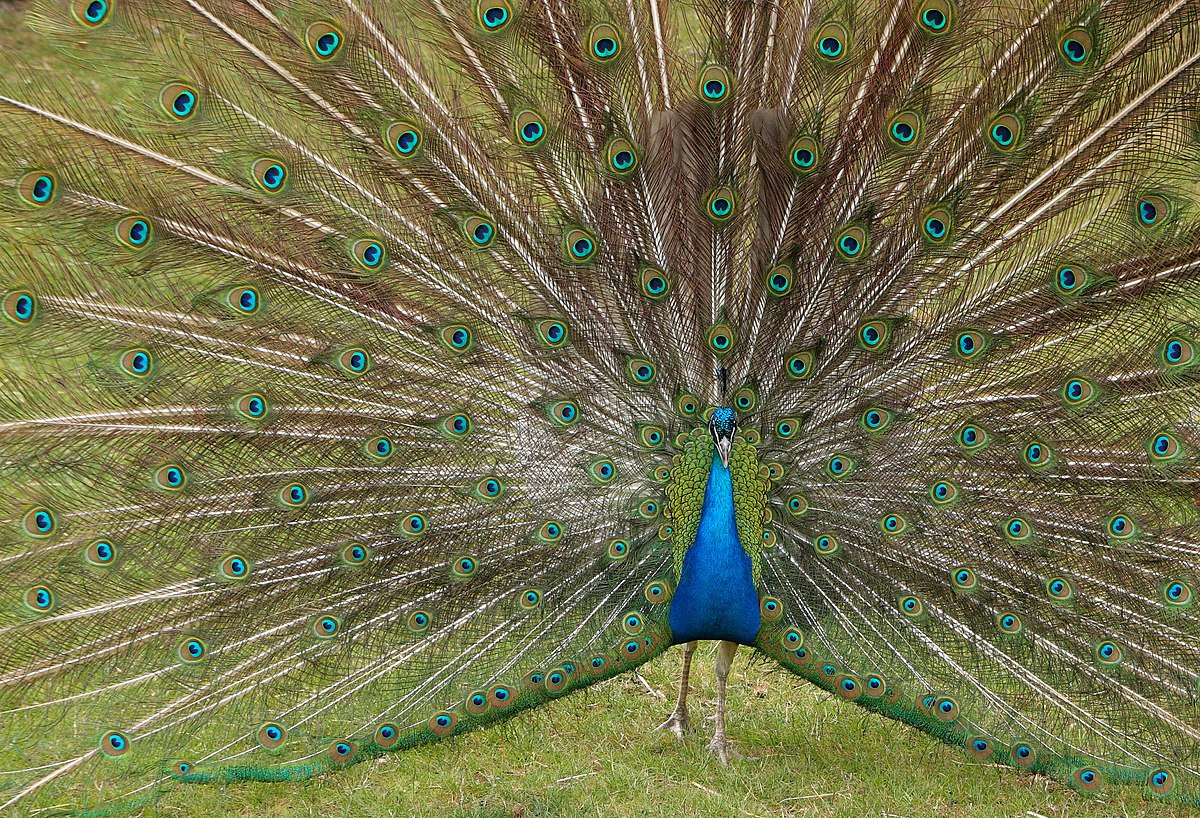
Wikipedia: Indian peafowl Source: OTHER
1200px-Peacock%2C_East_Park%2C_Hull_-_panoramio.jpg
This bird appears across the great seas in the following continents:
North America, Africa.
![]() The Indian peafowl (Pavo cristatus), also known as the common peafowl, and blue peafowl, is a peafowl species native to the Indian subcontinent. It has been introduced to many other countries.
[more]
The Indian peafowl (Pavo cristatus), also known as the common peafowl, and blue peafowl, is a peafowl species native to the Indian subcontinent. It has been introduced to many other countries.
[more]
Common pheasant (Fasan), Islay en route to Bunnahabhain, Islay. 2023-08-14 10.52.28 Islay
First observed in Islay on 2023-08-14.
This bird appears across the great seas in the following continents:
Europe, North America, Australia.
introduced, King, Flinders & Rottnest Island
Vocalization: ![]() Diverse repertoire of harsh cackling sounds. [Link]
Diverse repertoire of harsh cackling sounds. [Link]
Calls: ![]() Male call can be heard for more than a kilometer away; a very harsh, staccato and explosive "kaa" or "ka-kaa", with last syllable falling in pitch. [Link]
Male call can be heard for more than a kilometer away; a very harsh, staccato and explosive "kaa" or "ka-kaa", with last syllable falling in pitch. [Link]
Physical details: length=53-89 cm,
wingspan=70-90 cm,
weight=750-1700 g
Habitats:
Agricultural
Profile Wikipedia eBird Audubon AllAboutBirds Xeno-Canto
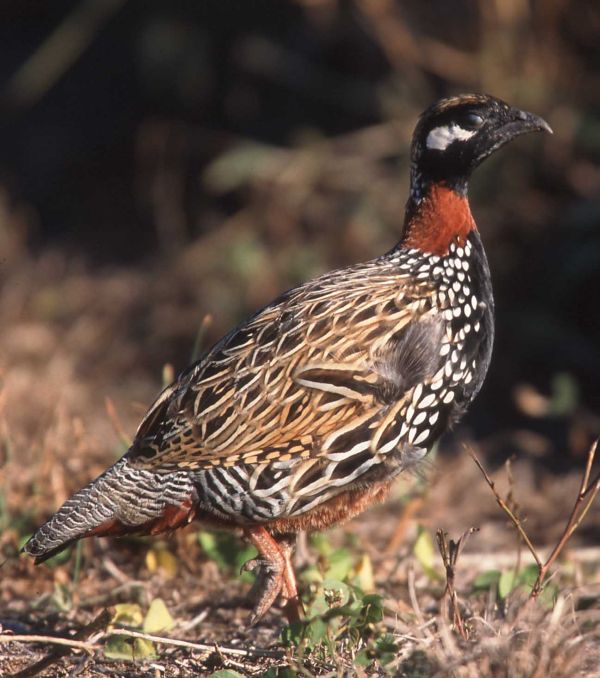
Wikipedia: Black francolin Source: OTHER
Black_Francolin.jpg
General: ![]() The black francolin (Francolinus francolinus) is a gamebird in the pheasant family Phasianidae of the order Galliformes, gallinaceous birds. It was formerly known as the Black Partridge. It is the state bird of Haryana state, India (locally known as Kaala Teetar काला तीतर).
[more]
The black francolin (Francolinus francolinus) is a gamebird in the pheasant family Phasianidae of the order Galliformes, gallinaceous birds. It was formerly known as the Black Partridge. It is the state bird of Haryana state, India (locally known as Kaala Teetar काला तीतर).
[more]

Wikipedia: Gray francolin Source: OTHER
Grey_Francolin_Tal_Chappar_Churu_Rajasthan_India_14.02.2013.jpg
![]() The grey francolin (Francolinus pondicerianus) is a species of francolin found in the plains and drier parts of the Indian subcontinent. This species was formerly also called the grey partridge, not to be confused with the European grey partridge. They are found in open cultivated lands as well as scrub forest and their local name of teetar is based on their calls, a loud and repeated Ka-tee-tar...tee-tar which is produced by one or more birds. The term teetar can also refer to other partridges and quails. During the breeding season calling males attract challengers, and decoys were used to trap these birds especially for fighting.
[more]
The grey francolin (Francolinus pondicerianus) is a species of francolin found in the plains and drier parts of the Indian subcontinent. This species was formerly also called the grey partridge, not to be confused with the European grey partridge. They are found in open cultivated lands as well as scrub forest and their local name of teetar is based on their calls, a loud and repeated Ka-tee-tar...tee-tar which is produced by one or more birds. The term teetar can also refer to other partridges and quails. During the breeding season calling males attract challengers, and decoys were used to trap these birds especially for fighting.
[more]

Wikipedia: Grey partridge Source: OTHER
1200px-Nurmkanad.jpg
This bird appears across the great seas in the following continents:
Europe, North America.
Deutschland: Brut-, Jahresvogel RL 2
Vocalization: ![]() Also various clucking sounds. [Link]
Also various clucking sounds. [Link]
Song: ![]() Song a sharp, very raspy sound, e.g. "krii-uuu-ii", with middle part lowered in pitch. Often compared to the sound of a rusty gate. [Link]
Song a sharp, very raspy sound, e.g. "krii-uuu-ii", with middle part lowered in pitch. Often compared to the sound of a rusty gate. [Link]
Physical details: length=29-31 cm,
wingspan=45-48 cm,
weight=340-450 g
Habitats:
Agricultural

Wikipedia: Chukar partridge Source: OTHER
Alectoris-chukar-001.jpg
This bird appears across the great seas in the following continents:
Europe, North America, Africa.
General: ![]() The chukar partridge (Alectoris chukar), or simply chukar, is a Palearctic upland gamebird in the pheasant family Phasianidae. It has been considered to form a superspecies complex along with the rock partridge, Philby's partridge and Przevalski's partridge and treated in the past as conspecific particularly with the first. This partridge has well marked black and white bars on the flanks and a black band running from the forehead across the eye and running down the head to form a necklace that encloses a white throat. Native to Asia, the species has been introduced into many other places and feral populations have established themselves in parts of North America and New Zealand. This bird can be found in parts of the Middle East and temperate Asia.
[more]
The chukar partridge (Alectoris chukar), or simply chukar, is a Palearctic upland gamebird in the pheasant family Phasianidae. It has been considered to form a superspecies complex along with the rock partridge, Philby's partridge and Przevalski's partridge and treated in the past as conspecific particularly with the first. This partridge has well marked black and white bars on the flanks and a black band running from the forehead across the eye and running down the head to form a necklace that encloses a white throat. Native to Asia, the species has been introduced into many other places and feral populations have established themselves in parts of North America and New Zealand. This bird can be found in parts of the Middle East and temperate Asia.
[more]
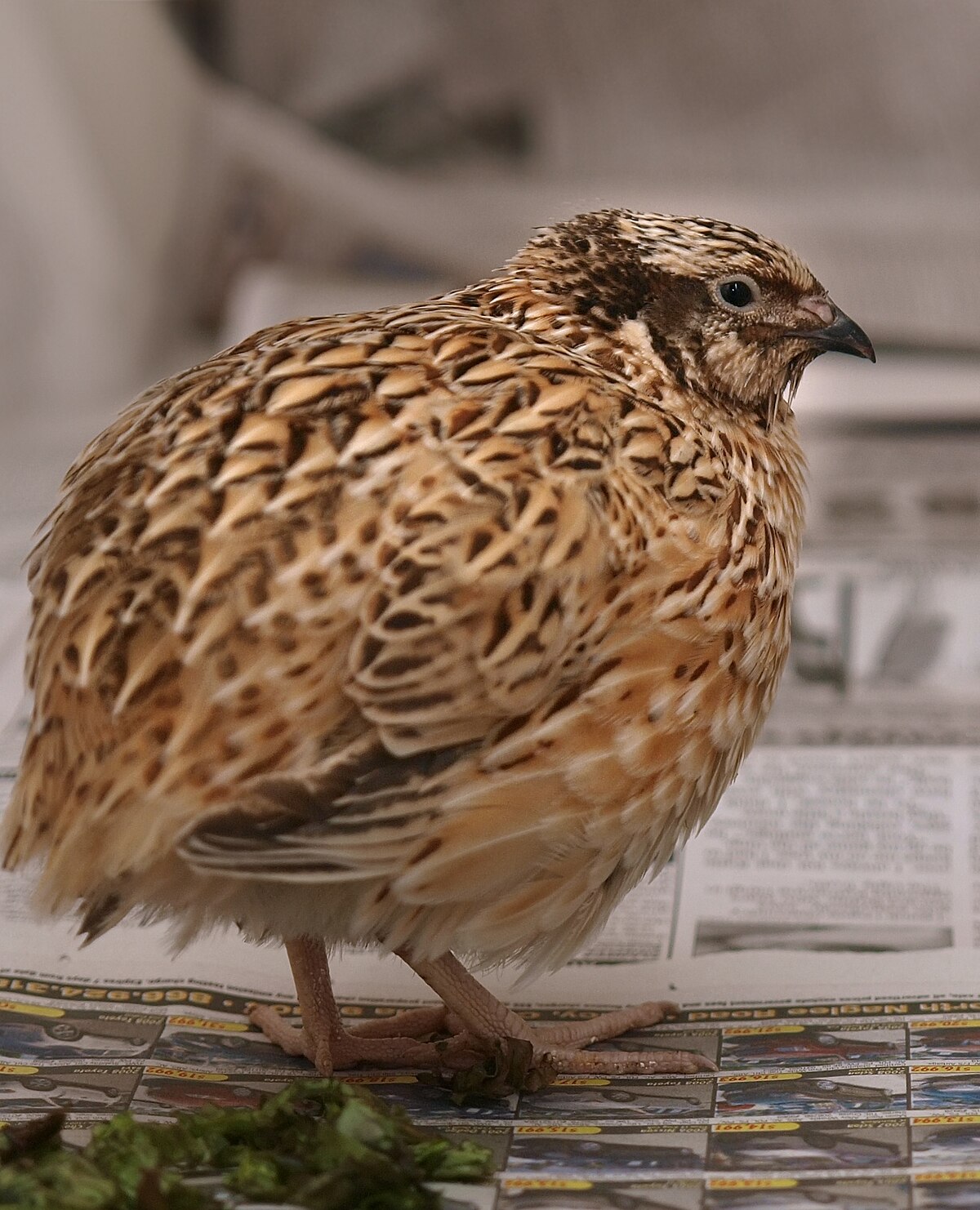
Wikipedia: Japanese quail Source: OTHER
1200px-Japanese_Quail.jpg
![]() The Japanese quail, Coturnix japonica, also known as the coturnix quail is a species of Old World quail found in East Asia. First considered a subspecies of the common quail, it is now considered as a separate species. The Japanese quail has played an active role in the lives of humanity since the 12th century, and continues to play major roles in industry and scientific research. Where it is found, the species is abundant across most of its range. Currently, there are a few true breeding mutations of the Japanese quail. The breeds from the United States are: Texas A&M, English white, golden range, red range, Italian, Manchurian, Tibetan, rosetta, scarlett, roux dilute and golden tuxedo.
[more]
The Japanese quail, Coturnix japonica, also known as the coturnix quail is a species of Old World quail found in East Asia. First considered a subspecies of the common quail, it is now considered as a separate species. The Japanese quail has played an active role in the lives of humanity since the 12th century, and continues to play major roles in industry and scientific research. Where it is found, the species is abundant across most of its range. Currently, there are a few true breeding mutations of the Japanese quail. The breeds from the United States are: Texas A&M, English white, golden range, red range, Italian, Manchurian, Tibetan, rosetta, scarlett, roux dilute and golden tuxedo.
[more]
Profile Wikipedia eBird Audubon AllAboutBirds Xeno-Canto

Wikipedia: Himalayan snowcock Source: OTHER
1200px-Himalayan_Snowcocks_Gorakshep_2014.jpg
![]() The Himalayan snowcock (Tetraogallus himalayensis) is a snowcock in the pheasant family Phasianidae found across the Himalayan ranges and parts of the adjoining Pamir range of Asia. It is found on alpine pastures and on steep rocky cliffs where they will dive down the hill slopes to escape. It overlaps with the slightly smaller Tibetan snowcock in parts of its wide range. The populations from different areas show variations in the colouration and about five subspecies have been designated. They were introduced in the mountains of Nevada in the United States in the 1960s and a wild population has established in the Ruby Mountains.
[more]
The Himalayan snowcock (Tetraogallus himalayensis) is a snowcock in the pheasant family Phasianidae found across the Himalayan ranges and parts of the adjoining Pamir range of Asia. It is found on alpine pastures and on steep rocky cliffs where they will dive down the hill slopes to escape. It overlaps with the slightly smaller Tibetan snowcock in parts of its wide range. The populations from different areas show variations in the colouration and about five subspecies have been designated. They were introduced in the mountains of Nevada in the United States in the 1960s and a wild population has established in the Ruby Mountains.
[more]
Wikipedia: Erckel's francolin Source: OTHER
Erckel%27s_Francolin.PNG
This bird appears across the great seas in the following continents:
North America, Africa.
![]() Erckel's spurfowl (Pternistis erckelii), also known as Erckel's francolin,[2] is a species of game bird in the family Phasianidae.
[more]
Erckel's spurfowl (Pternistis erckelii), also known as Erckel's francolin,[2] is a species of game bird in the family Phasianidae.
[more]
Wild turkey near Vickys mothers house. 2023-10-11 14.54.58 New England
First observed in Maryland on 2021-06-18.
This bird appears across the great seas in the following continents:
North America, Australia.
introduced, King, Flinders & Kangaroo Island

Wikipedia: Ruffed grouse Source: OTHER
1200px-Bonasa-umbellus-001edit1.jpg
General: ![]() The ruffed grouse (Bonasa umbellus) is a medium-sized grouse occurring in forests from the Appalachian Mountains across Canada to Alaska. It is non-migratory. It is the only species in the genus Bonasa.
[more]
The ruffed grouse (Bonasa umbellus) is a medium-sized grouse occurring in forests from the Appalachian Mountains across Canada to Alaska. It is non-migratory. It is the only species in the genus Bonasa.
[more]

Wikipedia: Gunnison sage-grouse Source: OTHER
Centrocercus_minimus.jpg
![]() The Gunnison grouse or Gunnison sage-grouse (Centrocercus minimus) is a species of grouse endemic to the United States. It is similar to the closely related greater sage-grouse (Centrocercus urophasianus) in appearance, but about a third smaller in size, with much thicker plumes behind the head; it also has a less elaborate courtship dance. It is restricted in range to southwestern Colorado and extreme southeastern Utah, with the largest population residing in the Gunnison Basin region in Colorado. Despite being native to a country where the avifauna is relatively well known, it was overlooked until the 1990s due to the similarities with the sage grouse, and only described as a new species in 2000—making it the first new avian species to be described from the USA since the 19th century.[4] The description of C. minimus as a separate species is supported by a molecular study of genetic variation, showing that gene flow between the large-bodied and the small-bodied birds is absent.[5]
[more]
The Gunnison grouse or Gunnison sage-grouse (Centrocercus minimus) is a species of grouse endemic to the United States. It is similar to the closely related greater sage-grouse (Centrocercus urophasianus) in appearance, but about a third smaller in size, with much thicker plumes behind the head; it also has a less elaborate courtship dance. It is restricted in range to southwestern Colorado and extreme southeastern Utah, with the largest population residing in the Gunnison Basin region in Colorado. Despite being native to a country where the avifauna is relatively well known, it was overlooked until the 1990s due to the similarities with the sage grouse, and only described as a new species in 2000—making it the first new avian species to be described from the USA since the 19th century.[4] The description of C. minimus as a separate species is supported by a molecular study of genetic variation, showing that gene flow between the large-bodied and the small-bodied birds is absent.[5]
[more]

Wikipedia: Greater sage-grouse Source: OTHER
1200px-Centrocercus_urophasianus_-USA_-male-8.jpg
![]() The greater sage-grouse (Centrocercus urophasianus), also known as the sagehen, is the largest grouse (a type of bird) in North America. Its range is sagebrush country in the western United States and southern Alberta and Saskatchewan, Canada. It was known as simply the sage grouse until the Gunnison sage-grouse was recognized as a separate species in 2000.[3] The Mono Basin population of sage grouse may also be distinct.
[more]
The greater sage-grouse (Centrocercus urophasianus), also known as the sagehen, is the largest grouse (a type of bird) in North America. Its range is sagebrush country in the western United States and southern Alberta and Saskatchewan, Canada. It was known as simply the sage grouse until the Gunnison sage-grouse was recognized as a separate species in 2000.[3] The Mono Basin population of sage grouse may also be distinct.
[more]
Profile Wikipedia eBird Audubon AllAboutBirds Xeno-Canto
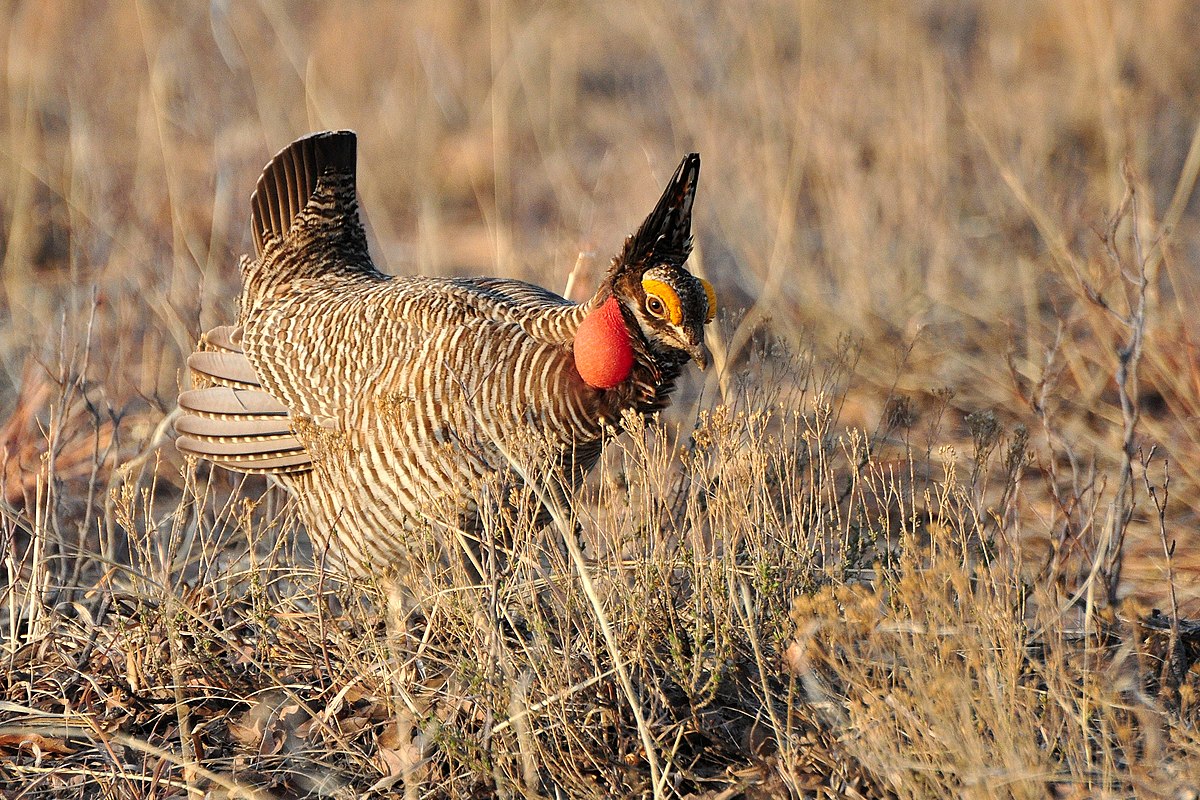
Wikipedia: Lesser prairie-chicken Source: OTHER
1200px-Lesser_Prairie_Chicken%2C_New_Mexico.jpg
![]() The lesser prairie chicken (Tympanuchus pallidicinctus) is a species in the grouse family.
[more]
The lesser prairie chicken (Tympanuchus pallidicinctus) is a species in the grouse family.
[more]
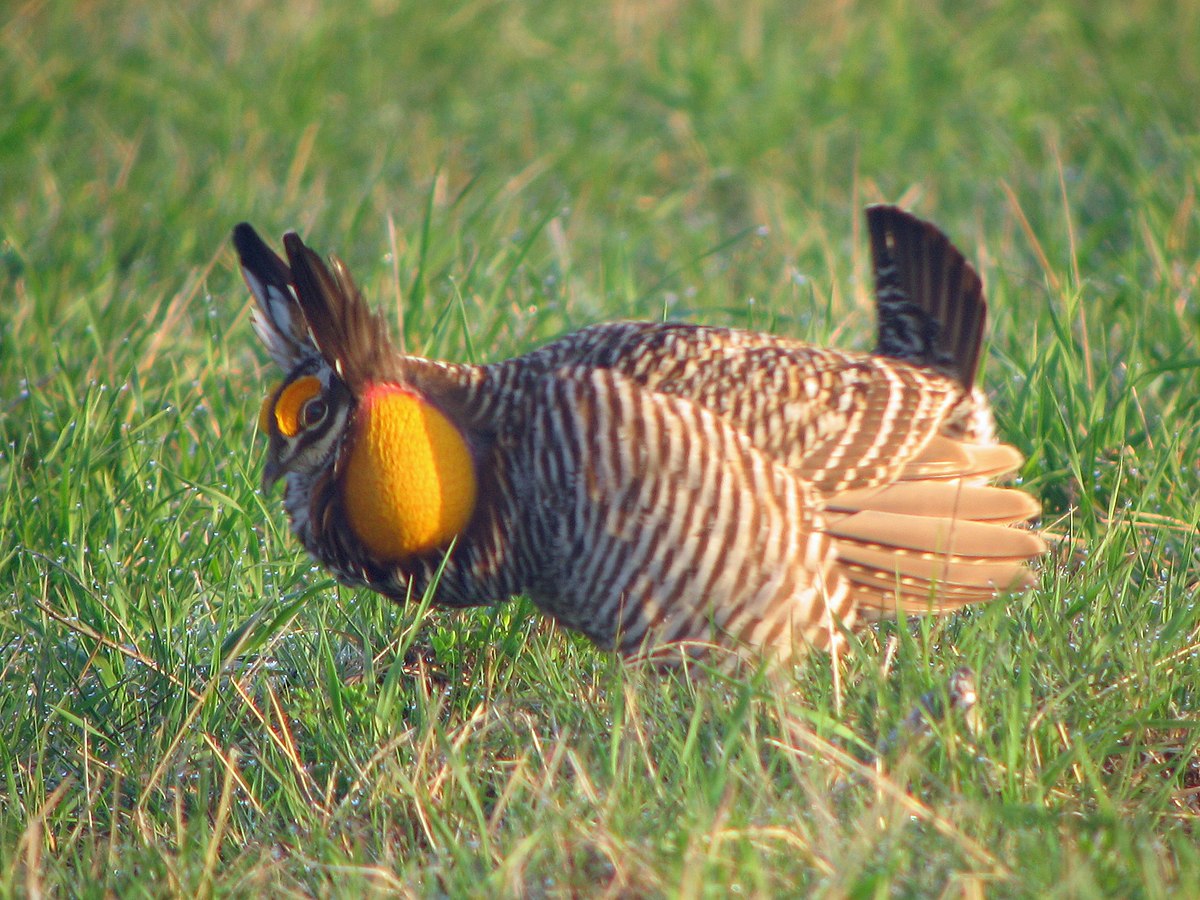
Wikipedia: Greater prairie chicken Source: OTHER
1200px-Tympanuchus_cupido_-Illinois%2C_USA_-male_displaying-8_%281%29.jpg
![]() The greater prairie chicken or pinnated grouse (Tympanuchus cupido), sometimes called a boomer,[2] is a large bird in the grouse family. This North American species was once abundant, but has become extremely rare and extirpated over much of its range due to habitat loss.[2] Conservation measures are underway to ensure the sustainability of existing small populations. One of the most famous aspects of these creatures is the mating ritual called booming.
[more]
The greater prairie chicken or pinnated grouse (Tympanuchus cupido), sometimes called a boomer,[2] is a large bird in the grouse family. This North American species was once abundant, but has become extremely rare and extirpated over much of its range due to habitat loss.[2] Conservation measures are underway to ensure the sustainability of existing small populations. One of the most famous aspects of these creatures is the mating ritual called booming.
[more]
Profile Wikipedia eBird Audubon AllAboutBirds Xeno-Canto
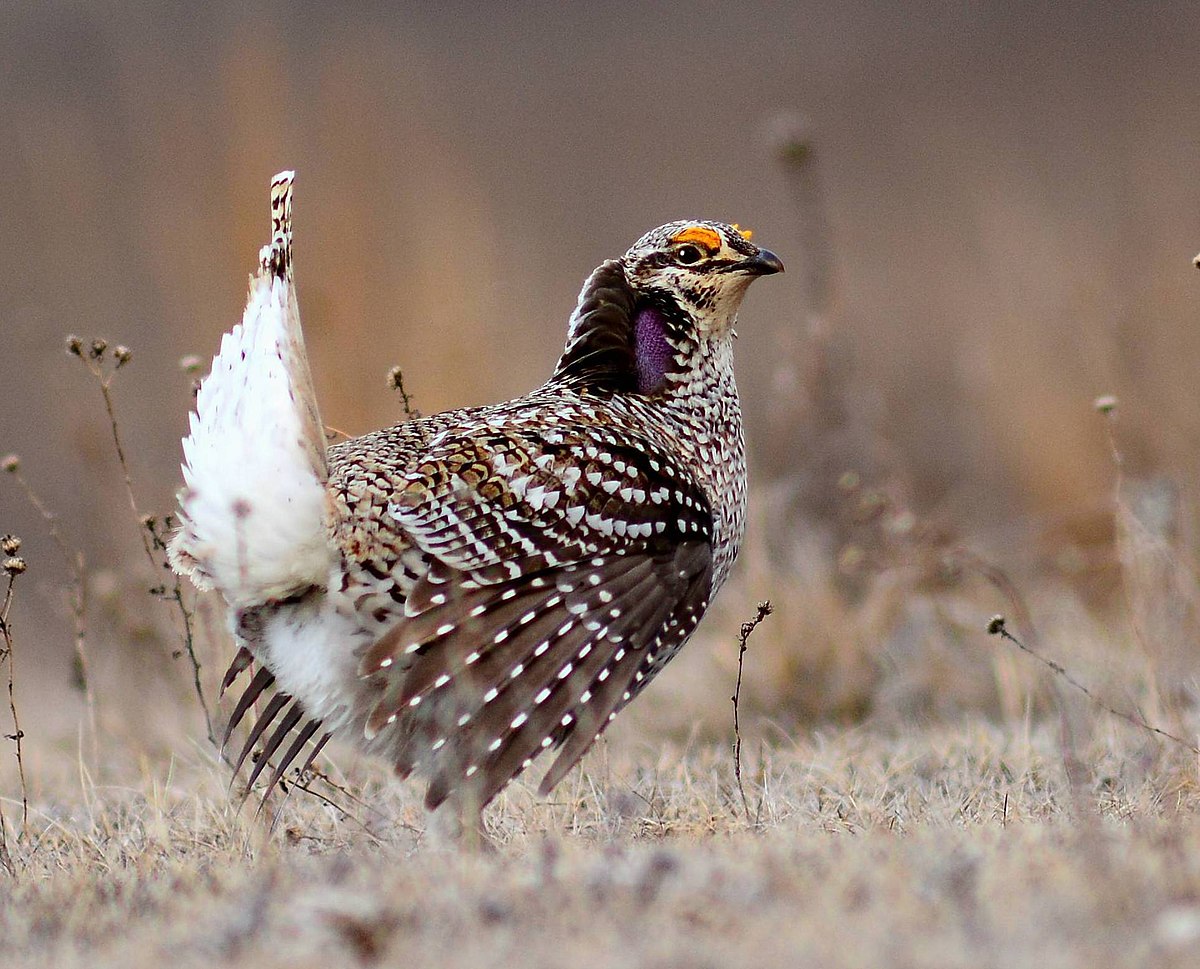
Wikipedia: Sharp-tailed grouse Source: OTHER
1200px-Sharp-Tailed_Grouse_%2826089894256%29_%28cropped%29.jpg
![]() The sharp-tailed grouse (Tympanuchus phasianellus), also known as the sharptail or fire grouse, is a medium-sized prairie grouse. One of three species in the genus Tympanuchus, the sharp-tailed grouse is found throughout Alaska, much of Northern and Western Canada, and parts of the Western and Midwestern United States. The sharp-tailed grouse is the provincial bird of the Canadian province of Saskatchewan.[2]
[more]
The sharp-tailed grouse (Tympanuchus phasianellus), also known as the sharptail or fire grouse, is a medium-sized prairie grouse. One of three species in the genus Tympanuchus, the sharp-tailed grouse is found throughout Alaska, much of Northern and Western Canada, and parts of the Western and Midwestern United States. The sharp-tailed grouse is the provincial bird of the Canadian province of Saskatchewan.[2]
[more]
Profile Wikipedia eBird Vogelwarte BirdLife ZH ornitho.ch bird-song.ch Audubon AllAboutBirds Xeno-Canto BirdID NABU
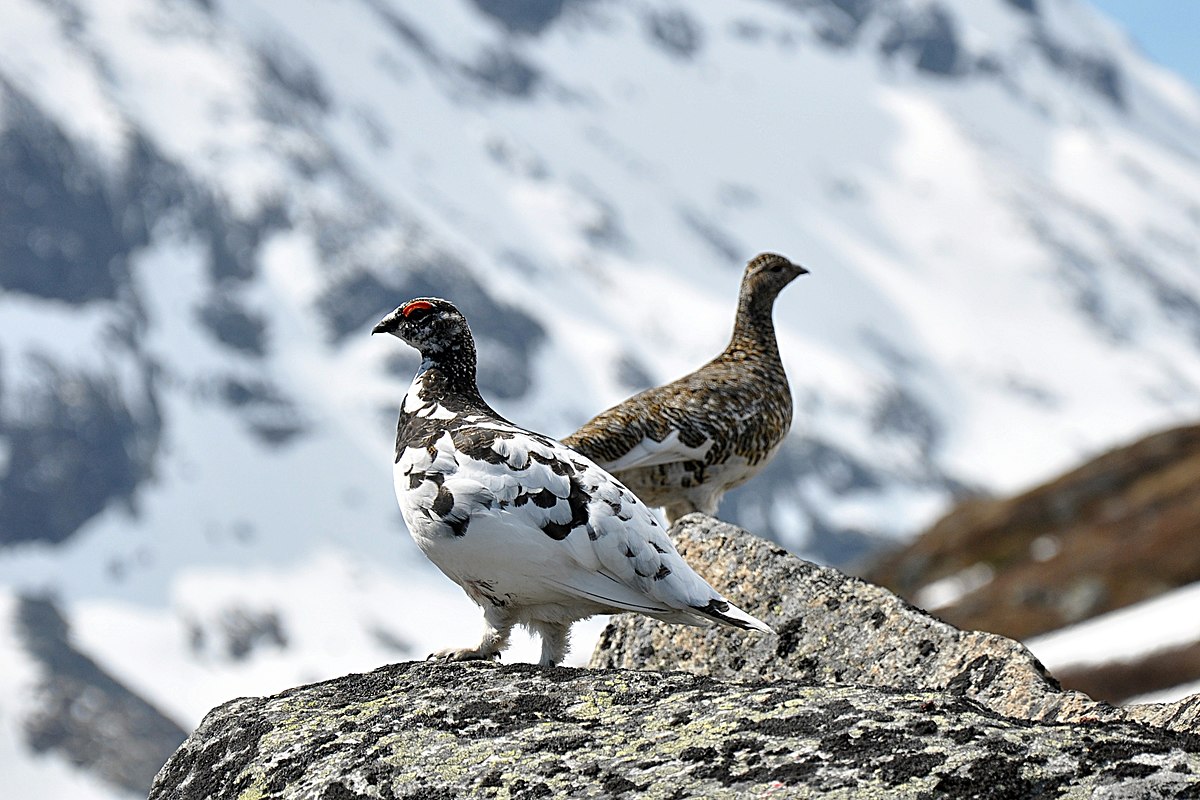
Wikipedia: Rock ptarmigan Source: OTHER
1200px-Rock_Ptarmigan_%28Lagopus_Muta%29.jpg
This bird appears across the great seas in the following continents:
Europe, North America.
Deutschland: Brut-, Jahresvogel RL R
Vocalization: ![]() Female has similar sounds, but is higher pitched and not so coarse as male. [Link]
Female has similar sounds, but is higher pitched and not so coarse as male. [Link]
Calls: ![]() Call of male a very distinct "rrrrrrr", being a rattling rapid pulse of clicks, like running a stick along a picket fence. [Link]
Call of male a very distinct "rrrrrrr", being a rattling rapid pulse of clicks, like running a stick along a picket fence. [Link]
Physical details: length=34-36 cm,
wingspan=54-60 cm,
weight=350-600 g
Habitats:
Mountain

Wikipedia: Willow ptarmigan Source: OTHER
1200px-Lagopus_lagopus_-_adult_%28Denali%2C_2010%29.jpg
This bird appears across the great seas in the following continents:
Europe, North America.
General: ![]() The willow ptarmigan (/ˈtɑːrmɪɡən/) (Lagopus lagopus) is a bird in the grouse subfamily Tetraoninae of the pheasant family Phasianidae. It is also known as the willow grouse and in Ireland and Britain, where the subspecies L. l. scotica was previously considered to be a separate species, as the red grouse. It is a sedentary species, breeding in birch and other forests and moorlands in northern Europe, the tundra of Scandinavia, Siberia, Alaska and Canada, in particular in the provinces of Newfoundland and Labrador and Quebec. It is the state bird of Alaska. In the summer the birds are largely brown, with dappled plumage, but in the winter they are white with some black feathers in their tails (British populations do not adopt a winter plumage). The species has remained little changed from the bird that roamed the tundra during the Pleistocene. Nesting takes place in the spring when clutches of four to ten eggs are laid in a scrape on the ground. The chicks are precocial and soon leave the nest. While they are young, both parents play a part in caring for them. The chicks eat insects and young plant growth while the adults are completely herbivorous, eating leaves, flowers, buds, seeds and berries during the summer and largely subsisting on the buds and twigs of willow and other dwarf shrubs and trees during the winter.
[more]
The willow ptarmigan (/ˈtɑːrmɪɡən/) (Lagopus lagopus) is a bird in the grouse subfamily Tetraoninae of the pheasant family Phasianidae. It is also known as the willow grouse and in Ireland and Britain, where the subspecies L. l. scotica was previously considered to be a separate species, as the red grouse. It is a sedentary species, breeding in birch and other forests and moorlands in northern Europe, the tundra of Scandinavia, Siberia, Alaska and Canada, in particular in the provinces of Newfoundland and Labrador and Quebec. It is the state bird of Alaska. In the summer the birds are largely brown, with dappled plumage, but in the winter they are white with some black feathers in their tails (British populations do not adopt a winter plumage). The species has remained little changed from the bird that roamed the tundra during the Pleistocene. Nesting takes place in the spring when clutches of four to ten eggs are laid in a scrape on the ground. The chicks are precocial and soon leave the nest. While they are young, both parents play a part in caring for them. The chicks eat insects and young plant growth while the adults are completely herbivorous, eating leaves, flowers, buds, seeds and berries during the summer and largely subsisting on the buds and twigs of willow and other dwarf shrubs and trees during the winter.
[more]
Calls: ![]() Very characteristic calls: "Kuwa -Kuwa -Kuwa" (go back!) Also: "kauw kauwkkkrrrkekekekekeke" with a short pause after first "kauw", then a decelerating cackle, often followed by the "go back" call. [Link]
Very characteristic calls: "Kuwa -Kuwa -Kuwa" (go back!) Also: "kauw kauwkkkrrrkekekekekeke" with a short pause after first "kauw", then a decelerating cackle, often followed by the "go back" call. [Link]
Physical details: length=37-42 cm,
wingspan=55-66 cm,
weight=450-750 g

Wikipedia: White-tailed ptarmigan Source: OTHER
1200px-White-tailed_Ptarmigan%2C_Rocky_Mountains%2C_Alberta.jpg
General: ![]() The white-tailed ptarmigan (Lagopus leucura), also known as the snow quail, is the smallest bird in the grouse family. It is a permanent resident of high altitudes on or above the tree line and is native to Alaska and the mountainous parts of Canada and the western United States. Its plumage is cryptic and varies at different times of the year. In the summer it is speckled in gray, brown and white whereas in winter it is wholly white. At all times of year the wings, belly and tail are white. The white-tailed ptarmigan has a diet of buds, leaves, flowers and seeds. The nest is a simple depression in the ground in which up to eight eggs are laid. After hatching, the chicks soon leave the nest. At first they eat insects but later move on to an adult diet, their mother using vocalisations to help them find suitable plant food. The population seems to be stable and the IUCN lists this species as being of "Least Concern".
[more]
The white-tailed ptarmigan (Lagopus leucura), also known as the snow quail, is the smallest bird in the grouse family. It is a permanent resident of high altitudes on or above the tree line and is native to Alaska and the mountainous parts of Canada and the western United States. Its plumage is cryptic and varies at different times of the year. In the summer it is speckled in gray, brown and white whereas in winter it is wholly white. At all times of year the wings, belly and tail are white. The white-tailed ptarmigan has a diet of buds, leaves, flowers and seeds. The nest is a simple depression in the ground in which up to eight eggs are laid. After hatching, the chicks soon leave the nest. At first they eat insects but later move on to an adult diet, their mother using vocalisations to help them find suitable plant food. The population seems to be stable and the IUCN lists this species as being of "Least Concern".
[more]

Wikipedia: Sooty grouse Source: OTHER
1200px-Dendragapus_fuliginosus_5058.JPG
![]() The sooty grouse (Dendragapus fuliginosus) is a species of forest-dwelling grouse native to North America's Pacific Coast Ranges.[2][3] It is closely related to the dusky grouse (Dendragapus obscurus), and the two were previously considered a single species, the blue grouse.[2][3][4]
[more]
The sooty grouse (Dendragapus fuliginosus) is a species of forest-dwelling grouse native to North America's Pacific Coast Ranges.[2][3] It is closely related to the dusky grouse (Dendragapus obscurus), and the two were previously considered a single species, the blue grouse.[2][3][4]
[more]

Wikipedia: Blue grouse Source: OTHER
1200px-Dendragapus_obscurus_USNPS.jpg
![]() The genus Dendragapus contains two closely related species of grouse that have often been treated as a single variable taxon (blue grouse). The two species are the dusky grouse (Dendragapus obscurus) and the sooty grouse (Dendragapus fuliginosus).[1] In addition, the spruce grouse and Siberian grouse have been considered part of this genus.
[more]
The genus Dendragapus contains two closely related species of grouse that have often been treated as a single variable taxon (blue grouse). The two species are the dusky grouse (Dendragapus obscurus) and the sooty grouse (Dendragapus fuliginosus).[1] In addition, the spruce grouse and Siberian grouse have been considered part of this genus.
[more]
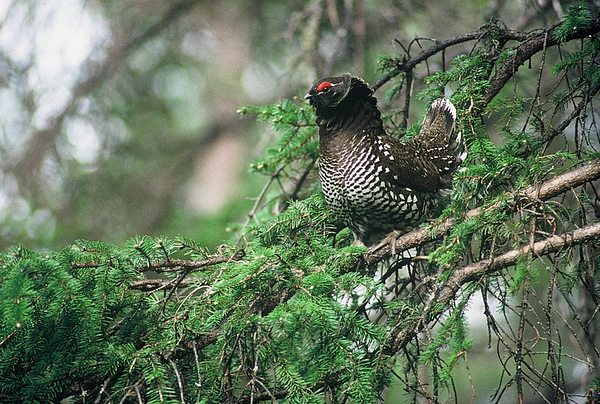
Wikipedia: Siberian grouse Source: OTHER
Falcipennis_falcipennis_displaying.jpg
![]() The Siberian grouse (Falcipennis falcipennis), Siberian spruce grouse, Amur grouse, or Asian spruce grouse,[2] is a short, rotund forest-dwelling grouse. A sedentary, non-migratory bird, it is similar to the spruce grouse and Franklin's grouse of North America, which all belong to the genus Falcipennis.
[more]
The Siberian grouse (Falcipennis falcipennis), Siberian spruce grouse, Amur grouse, or Asian spruce grouse,[2] is a short, rotund forest-dwelling grouse. A sedentary, non-migratory bird, it is similar to the spruce grouse and Franklin's grouse of North America, which all belong to the genus Falcipennis.
[more]

Wikipedia: California quail Source: OTHER
California_quail.jpg
This bird appears across the great seas in the following continents:
North America, Australia.
introduced, Norfolk & King Island

Wikipedia: Gambel's quail Source: OTHER
Gambel%27s_quail_%28Callipepla_gambelii%29_-_Flickr_-_Lip_Kee_%281%29.jpg
General: ![]() Gambel's quail (Callipepla gambelii) is a small ground-dwelling bird in the New World quail family. It inhabits the desert regions of Arizona, California, Colorado, New Mexico, Nevada, Utah, Texas, and Sonora; also New Mexico-border Chihuahua and the Colorado River region of Baja California. The Gambel's quail is named in honor of William Gambel, a 19th-century naturalist and explorer of the Southwestern United States.
[more]
Gambel's quail (Callipepla gambelii) is a small ground-dwelling bird in the New World quail family. It inhabits the desert regions of Arizona, California, Colorado, New Mexico, Nevada, Utah, Texas, and Sonora; also New Mexico-border Chihuahua and the Colorado River region of Baja California. The Gambel's quail is named in honor of William Gambel, a 19th-century naturalist and explorer of the Southwestern United States.
[more]
Profile Wikipedia eBird Audubon AllAboutBirds Xeno-Canto

Wikipedia: Scaled quail Source: OTHER
1200px-068_-_SCALED_QUAIL_%285-10-2015%29_las_cienegas_nca%2C_pima_co%2C_az_-17_%2816935159393%29.jpg
![]() The scaled quail (Callipepla squamata), also commonly called blue quail or cottontop, is a species of the New World quail family. It is a bluish gray bird found in the arid regions of the Southwestern United States to Central Mexico. This species is an early offshoot of the genus Callipepla, diverging in the Pliocene.[2]
[more]
The scaled quail (Callipepla squamata), also commonly called blue quail or cottontop, is a species of the New World quail family. It is a bluish gray bird found in the arid regions of the Southwestern United States to Central Mexico. This species is an early offshoot of the genus Callipepla, diverging in the Pliocene.[2]
[more]
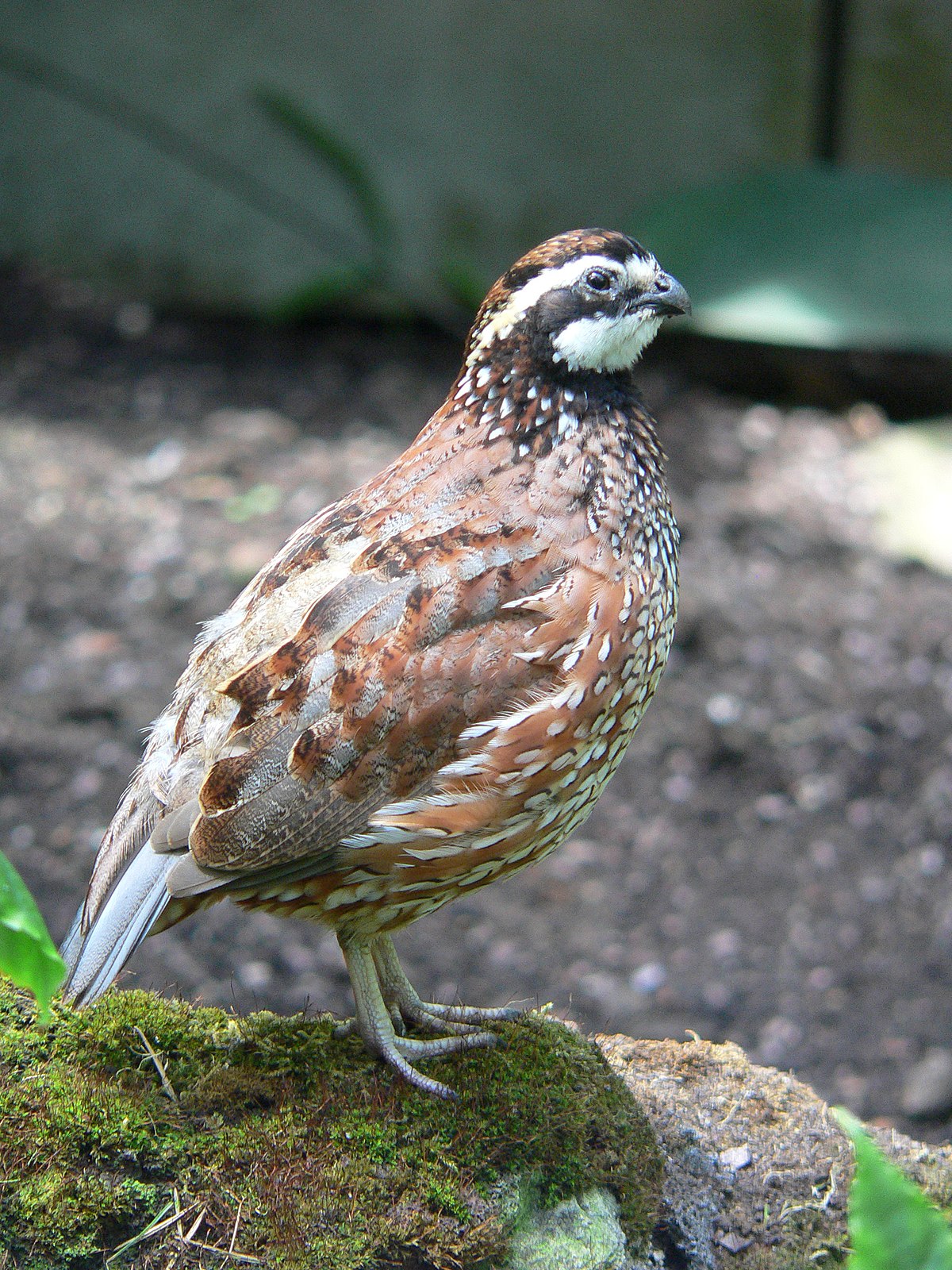
Wikipedia: Northern bobwhite Source: OTHER
1200px-Virginiawachtel_2007-06-16_065.jpg
![]() The northern bobwhite (Colinus virginianus), also known as the Virginia quail or (in its home range) bobwhite quail, is a ground-dwelling bird native to Canada, the United States, Mexico, and Cuba, with introduced populations elsewhere in the Caribbean, Europe, and Asia. It is a member of the group of species known as New World quails (Odontophoridae). They were initially placed with the Old World quails in the pheasant family (Phasianidae), but are not particularly closely related. The name "bobwhite" is an onomatopoeic derivation from its characteristic whistling call. Despite its secretive nature, the northern bobwhite is one of the most familiar quails in eastern North America, because it is frequently the only quail in its range. Habitat degradation has likely contributed to the northern bobwhite population in eastern North America declining by roughly 85% from 1966 to 2014.[3] This population decline is apparently range-wide and continuing.[4][5]
[more]
The northern bobwhite (Colinus virginianus), also known as the Virginia quail or (in its home range) bobwhite quail, is a ground-dwelling bird native to Canada, the United States, Mexico, and Cuba, with introduced populations elsewhere in the Caribbean, Europe, and Asia. It is a member of the group of species known as New World quails (Odontophoridae). They were initially placed with the Old World quails in the pheasant family (Phasianidae), but are not particularly closely related. The name "bobwhite" is an onomatopoeic derivation from its characteristic whistling call. Despite its secretive nature, the northern bobwhite is one of the most familiar quails in eastern North America, because it is frequently the only quail in its range. Habitat degradation has likely contributed to the northern bobwhite population in eastern North America declining by roughly 85% from 1966 to 2014.[3] This population decline is apparently range-wide and continuing.[4][5]
[more]

Wikipedia: Montezuma quail Source: OTHER
Cyrtonyx_montezumaeEBP20A.jpg
![]() The Montezuma quail (Cyrtonyx montezumae) is a stubby, secretive New World quail of Mexico and some nearby parts of the United States. It is also known as Mearns's quail, the harlequin quail (for the male's striking pattern), and the fool quail (for its behavior).
[more]
The Montezuma quail (Cyrtonyx montezumae) is a stubby, secretive New World quail of Mexico and some nearby parts of the United States. It is also known as Mearns's quail, the harlequin quail (for the male's striking pattern), and the fool quail (for its behavior).
[more]
Profile Wikipedia eBird Audubon AllAboutBirds Xeno-Canto
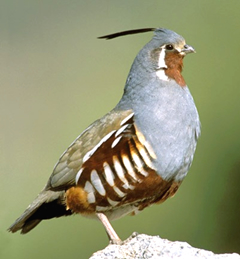
Wikipedia: Mountain quail Source: OTHER
Oreortyx_pictus.jpg
![]() The mountain quail (Oreortyx pictus) is a small ground-dwelling bird in the New World quail family. This species is the only one in the genus Oreortyx, which is sometimes included in Callipepla. This is not appropriate, however, as the mountain quail's ancestors have diverged from other New World quails earlier than the bobwhites, no later than 6 mya.[2]
[more]
The mountain quail (Oreortyx pictus) is a small ground-dwelling bird in the New World quail family. This species is the only one in the genus Oreortyx, which is sometimes included in Callipepla. This is not appropriate, however, as the mountain quail's ancestors have diverged from other New World quails earlier than the bobwhites, no later than 6 mya.[2]
[more]
Profile Wikipedia eBird Audubon AllAboutBirds Xeno-Canto

Wikipedia: Chimney swift Source: OTHER
Chimney_swift_overhead.jpg
![]() The chimney swift (Chaetura pelagica) is a bird belonging to the swift family Apodidae. A member of the genus Chaetura, it is closely related to both the Vaux's swift and the Chapman's swift; in the past, the three were sometimes considered to be conspecific. It has no subspecies. The chimney swift is a medium-sized, sooty gray bird with very long, slender wings and very short legs. Like all swifts, it is incapable of perching, and can only cling vertically to surfaces.
[more]
The chimney swift (Chaetura pelagica) is a bird belonging to the swift family Apodidae. A member of the genus Chaetura, it is closely related to both the Vaux's swift and the Chapman's swift; in the past, the three were sometimes considered to be conspecific. It has no subspecies. The chimney swift is a medium-sized, sooty gray bird with very long, slender wings and very short legs. Like all swifts, it is incapable of perching, and can only cling vertically to surfaces.
[more]
Profile Wikipedia eBird Audubon AllAboutBirds Xeno-Canto
Wikipedia: Short-tailed swift Source: OTHER
Chaetura_brachyura_-_Short-tailed_Swift.JPG
![]() The short-tailed swift (Chaetura brachyura) is a bird in the Apodidae, or swift family.
[more]
The short-tailed swift (Chaetura brachyura) is a bird in the Apodidae, or swift family.
[more]
Profile Wikipedia eBird Audubon AllAboutBirds Xeno-Canto

Wikipedia: Vaux's swift Source: OTHER
Vaux%27s_Swift_-_La_Paz_-_Costa_Rica_MG_1768_%2826435571450%29.jpg
![]() Vaux's swift (Chaetura vauxi) is a small swift native to North America and northern South America. It was named for the American scientist William Sansom Vaux.
[more]
Vaux's swift (Chaetura vauxi) is a small swift native to North America and northern South America. It was named for the American scientist William Sansom Vaux.
[more]
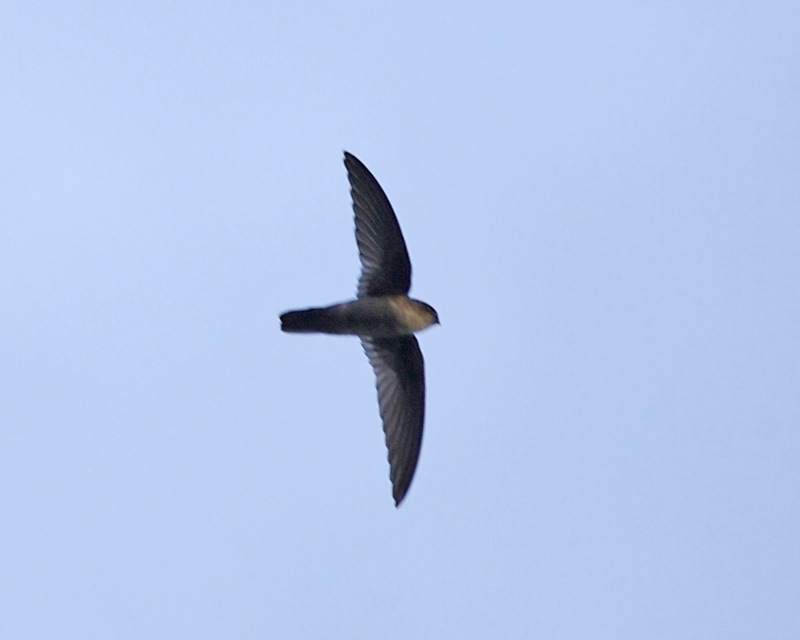
Wikipedia: Uniform swiftlet Source: OTHER
Uniform_Swiftlet_%28Aerodramus_vanikorensis%29.jpg
This bird appears across the great seas in the following continents:
North America, Australia.
vagrant
Profile Wikipedia eBird Audubon AllAboutBirds Xeno-Canto
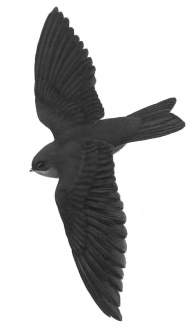
Wikipedia: Caroline Islands swiftlet Source: OTHER
Island_Swiftlet.jpg
General: ![]() Collocalia inquietus
Collocalia inquietus
Collocalia vanikorensis inquietus
Aerodramus vanikorensis inquietus
[more]

Wikipedia: White-rumped swiftlet Source: OTHER
Whiterumpedswiftlet.jpg
![]() The white-rumped swiftlet (Aerodramus spodiopygius) is a species of swift in the family Apodidae.
[more]
The white-rumped swiftlet (Aerodramus spodiopygius) is a species of swift in the family Apodidae.
[more]
Profile Wikipedia eBird Audubon AllAboutBirds Xeno-Canto
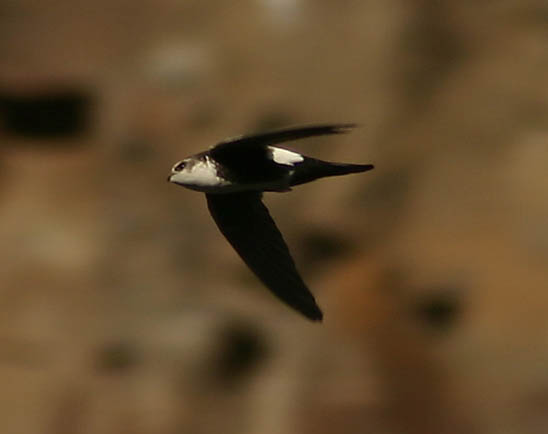
Wikipedia: White-throated swift Source: OTHER
White-throated_Swift_%28Aeronautes_saxatalis%29_in_flight.jpg
![]() The white-throated swift (Aeronautes saxatalis) is a swift of the family Apodidae native to western North America, south to cordilleran western Honduras.[2] Its coastal range extends as far north as Northern California, while inland it has migratory populations found throughout the Great Basin and Rocky Mountain regions, ranging as far north as southern British Columbia.[2] White-throated swifts are found in open areas near cliffs, rock faces, or man-made structures, where they roost. Swifts are social birds, and groups are often seen roosting and foraging for flying insects together.[2]
[more]
The white-throated swift (Aeronautes saxatalis) is a swift of the family Apodidae native to western North America, south to cordilleran western Honduras.[2] Its coastal range extends as far north as Northern California, while inland it has migratory populations found throughout the Great Basin and Rocky Mountain regions, ranging as far north as southern British Columbia.[2] White-throated swifts are found in open areas near cliffs, rock faces, or man-made structures, where they roost. Swifts are social birds, and groups are often seen roosting and foraging for flying insects together.[2]
[more]
Profile Wikipedia eBird Audubon AllAboutBirds Xeno-Canto

Wikipedia: Anna's hummingbird Source: OTHER
1200px-Anna%27s_hummingbird.jpg
![]() Anna's hummingbird (Calypte anna) is a medium-sized bird species of the family Trochilidae. It was named after Anna Masséna, Duchess of Rivoli.[2]
[more]
Anna's hummingbird (Calypte anna) is a medium-sized bird species of the family Trochilidae. It was named after Anna Masséna, Duchess of Rivoli.[2]
[more]
Profile Wikipedia eBird Audubon AllAboutBirds Xeno-Canto

Wikipedia: Costa's hummingbird Source: OTHER
Hummingbird.jpg
![]() Costa's hummingbird (Calypte costae) is a bird species in the hummingbird family Trochilidae. It breeds in the arid region of the southwest United States and northwest Mexico; it winters in western Mexico.
[more]
Costa's hummingbird (Calypte costae) is a bird species in the hummingbird family Trochilidae. It breeds in the arid region of the southwest United States and northwest Mexico; it winters in western Mexico.
[more]
Profile Wikipedia eBird A-Z Animals Audubon AllAboutBirds Xeno-Canto

Wikipedia: Rufous hummingbird Source: OTHER
1200px-USFWS_ribes_sanguineum_%2826123508822%29.jpg
![]() The rufous hummingbird (Selasphorus rufus) is a small hummingbird, about 8 cm (3.1 in) long with a long, straight and slender bill. These birds are known for their extraordinary flight skills, flying 2,000 mi (3,200 km) during their migratory transits. It is one of seven species in the genus Selasphorus.
[more]
The rufous hummingbird (Selasphorus rufus) is a small hummingbird, about 8 cm (3.1 in) long with a long, straight and slender bill. These birds are known for their extraordinary flight skills, flying 2,000 mi (3,200 km) during their migratory transits. It is one of seven species in the genus Selasphorus.
[more]

Wikipedia: Broad-tailed hummingbird Source: OTHER
1200px-Male_Broad-tailed_Hummingbird_1.jpg
![]() The broad-tailed hummingbird (Selasphorus platycercus) is a medium-sized hummingbird species found in highland regions from western United States and Western Canada to Mexico and Guatemala.[2][3]
[more]
The broad-tailed hummingbird (Selasphorus platycercus) is a medium-sized hummingbird species found in highland regions from western United States and Western Canada to Mexico and Guatemala.[2][3]
[more]

Wikipedia: Calliope hummingbird Source: OTHER
1200px-Calliope_Hummingbird_by_Dan_Pancamo.jpg
![]() The calliope hummingbird (Selasphorus calliope) (pronunciation kə-ˈlī-ə-pē)[2] is the smallest bird native to the United States and Canada.[3] It has a western breeding range mainly from California to British Columbia, and migrates to the Southwestern United States, Mexico, and Central America for its wintering grounds.[3] It was previously considered the only member of the genus Stellula, but recent evidence suggests placement in the genus Selasphorus.[4] This bird was named after the Greek muse Calliope. The former genus name means "little star".
[more]
The calliope hummingbird (Selasphorus calliope) (pronunciation kə-ˈlī-ə-pē)[2] is the smallest bird native to the United States and Canada.[3] It has a western breeding range mainly from California to British Columbia, and migrates to the Southwestern United States, Mexico, and Central America for its wintering grounds.[3] It was previously considered the only member of the genus Stellula, but recent evidence suggests placement in the genus Selasphorus.[4] This bird was named after the Greek muse Calliope. The former genus name means "little star".
[more]
Profile Wikipedia eBird Audubon AllAboutBirds Xeno-Canto

Wikipedia: Allen's hummingbird Source: OTHER
1200px-Allen%27s_Hummingbird_Guarding_Flower_Patch.jpg
![]() Allen's hummingbird (Selasphorus sasin) is a species of hummingbird that breeds in the western United States. It is one of seven species in the genus Selasphorus.
[more]
Allen's hummingbird (Selasphorus sasin) is a species of hummingbird that breeds in the western United States. It is one of seven species in the genus Selasphorus.
[more]

Wikipedia: Violet-crowned hummingbird Source: OTHER
1200px-Amazilia_violiceps_101693783.jpg
![]() The violet-crowned hummingbird (Leucolia violiceps) is a medium-sized hummingbird. It is 10 cm long and weighs approximately 5 g.
[more]
The violet-crowned hummingbird (Leucolia violiceps) is a medium-sized hummingbird. It is 10 cm long and weighs approximately 5 g.
[more]

Wikipedia: Buff-bellied hummingbird Source: OTHER
1200px-Buff-bellied_Hummingbird-Sabal_Palm_Bird_Sanctuary-TX_-_2015-05-21at11-43-412_%2821421266100%29.jpg
![]() The buff-bellied hummingbird (Amazilia yucatanensis) is a medium-sized hummingbird. It is 10–11 cm (3.9–4.3 in) long and has a mass of 4–5 g (0.14–0.18 oz).
[more]
The buff-bellied hummingbird (Amazilia yucatanensis) is a medium-sized hummingbird. It is 10–11 cm (3.9–4.3 in) long and has a mass of 4–5 g (0.14–0.18 oz).
[more]
Profile Wikipedia eBird Audubon AllAboutBirds Xeno-Canto

Wikipedia: Berylline hummingbird Source: OTHER
Berylline_Hummingbird_%28cropped%29.jpg
![]() The berylline hummingbird (Saucerottia beryllina) is a medium-sized hummingbird. It is 8–10 cm long, and weighs 4-5 g.
[more]
The berylline hummingbird (Saucerottia beryllina) is a medium-sized hummingbird. It is 8–10 cm long, and weighs 4-5 g.
[more]
Profile Wikipedia eBird Audubon AllAboutBirds Xeno-Canto
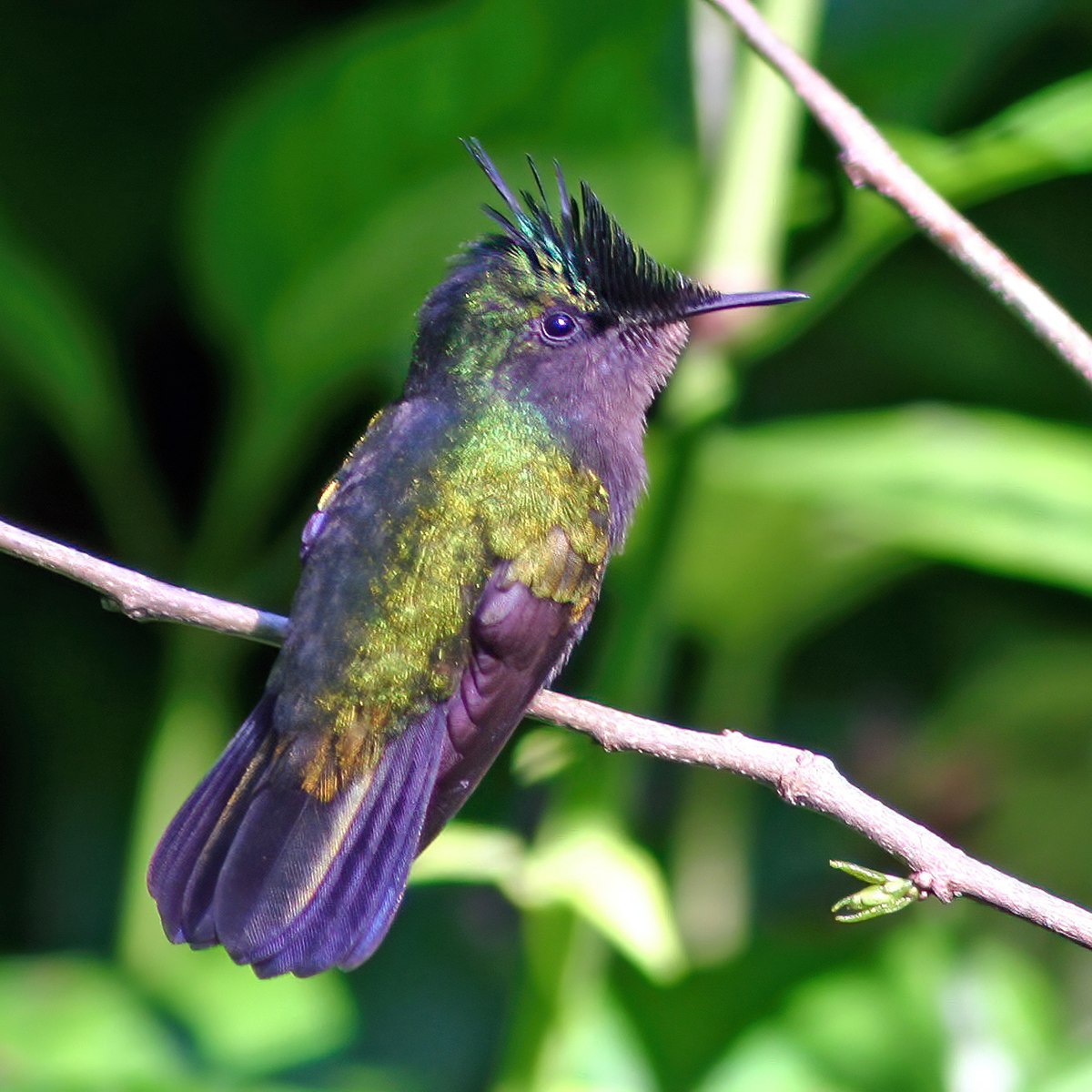
Wikipedia: Antillean crested hummingbird Source: OTHER
1200px-Antillean_crested_hummingbird.jpg
![]() The Antillean crested hummingbird (Orthorhyncus cristatus) is a species of hummingbird in the family Trochilidae. Found across Anguilla, Antigua and Barbuda, Barbados, Dominica, Grenada, Guadeloupe, Martinique, Montserrat, north-east Puerto Rico, Saba, Saint-Barthélemy, Saint Kitts and Nevis, Saint Lucia, Saint Martin, Saint Vincent and the Grenadines, Sint Eustatius, the British Virgin Islands, the U.S. Virgin Islands, and the Lesser Antilles, while it has also been recorded as a vagrant in Florida, USA.[2]
[more]
The Antillean crested hummingbird (Orthorhyncus cristatus) is a species of hummingbird in the family Trochilidae. Found across Anguilla, Antigua and Barbuda, Barbados, Dominica, Grenada, Guadeloupe, Martinique, Montserrat, north-east Puerto Rico, Saba, Saint-Barthélemy, Saint Kitts and Nevis, Saint Lucia, Saint Martin, Saint Vincent and the Grenadines, Sint Eustatius, the British Virgin Islands, the U.S. Virgin Islands, and the Lesser Antilles, while it has also been recorded as a vagrant in Florida, USA.[2]
[more]

Wikipedia: Antillean mango Source: OTHER
1200px-Antillean_Mango.jpg
![]() The Antillean mango (Anthracothorax dominicus) is a species of hummingbird in the family Trochilidae.
It is found on the Caribbean islands of Hispaniola (both the Dominican Republic and Haiti), Puerto Rico, the British Virgin Islands, and Virgin Islands, U.S..
[more]
The Antillean mango (Anthracothorax dominicus) is a species of hummingbird in the family Trochilidae.
It is found on the Caribbean islands of Hispaniola (both the Dominican Republic and Haiti), Puerto Rico, the British Virgin Islands, and Virgin Islands, U.S..
[more]
Profile Wikipedia eBird Audubon AllAboutBirds Xeno-Canto

Wikipedia: Green-throated carib Source: OTHER
1200px-Green_throated_carib_shs.jpg
![]() The green-throated carib (Eulampis holosericeus) is a species of hummingbird in the genus Eulampis, which contains one other species. It has two subspecies, holosericeus and chlorolaemus, the former occurring in Puerto Rico and the latter in Grenada.
[more]
The green-throated carib (Eulampis holosericeus) is a species of hummingbird in the genus Eulampis, which contains one other species. It has two subspecies, holosericeus and chlorolaemus, the former occurring in Puerto Rico and the latter in Grenada.
[more]

Wikipedia: Ruby-throated hummingbird Source: OTHER
Rubythroathummer65.jpg
![]() The ruby-throated hummingbird (Archilochus colubris) is a species of hummingbird that generally spends the winter in Central America, Mexico, and Florida, and migrates to Canada and other parts of Eastern North America for the summer to breed. It is by far the most common hummingbird seen east of the Mississippi River in North America.
[more]
The ruby-throated hummingbird (Archilochus colubris) is a species of hummingbird that generally spends the winter in Central America, Mexico, and Florida, and migrates to Canada and other parts of Eastern North America for the summer to breed. It is by far the most common hummingbird seen east of the Mississippi River in North America.
[more]

Wikipedia: Black-chinned hummingbird Source: OTHER
1200px-Archilochus-alexandri-003.jpg
![]() The black-chinned hummingbird (Archilochus alexandri) is a small hummingbird occupying a broad range of habitats.[2] It is migratory, spending winter as far south as Mexico.
[more]
The black-chinned hummingbird (Archilochus alexandri) is a small hummingbird occupying a broad range of habitats.[2] It is migratory, spending winter as far south as Mexico.
[more]
Profile Wikipedia eBird Audubon AllAboutBirds Xeno-Canto

Wikipedia: Blue-throated mountain-gem Source: OTHER
Lampornis_clemenciae.jpg
![]() The blue-throated mountaingem, also known as the blue-throated mountain-gem or blue-throated hummingbird (Lampornis clemenciae) is a species of hummingbird, a member of the family Trochilidae of birds.
[more]
The blue-throated mountaingem, also known as the blue-throated mountain-gem or blue-throated hummingbird (Lampornis clemenciae) is a species of hummingbird, a member of the family Trochilidae of birds.
[more]
Profile Wikipedia eBird Audubon AllAboutBirds Xeno-Canto
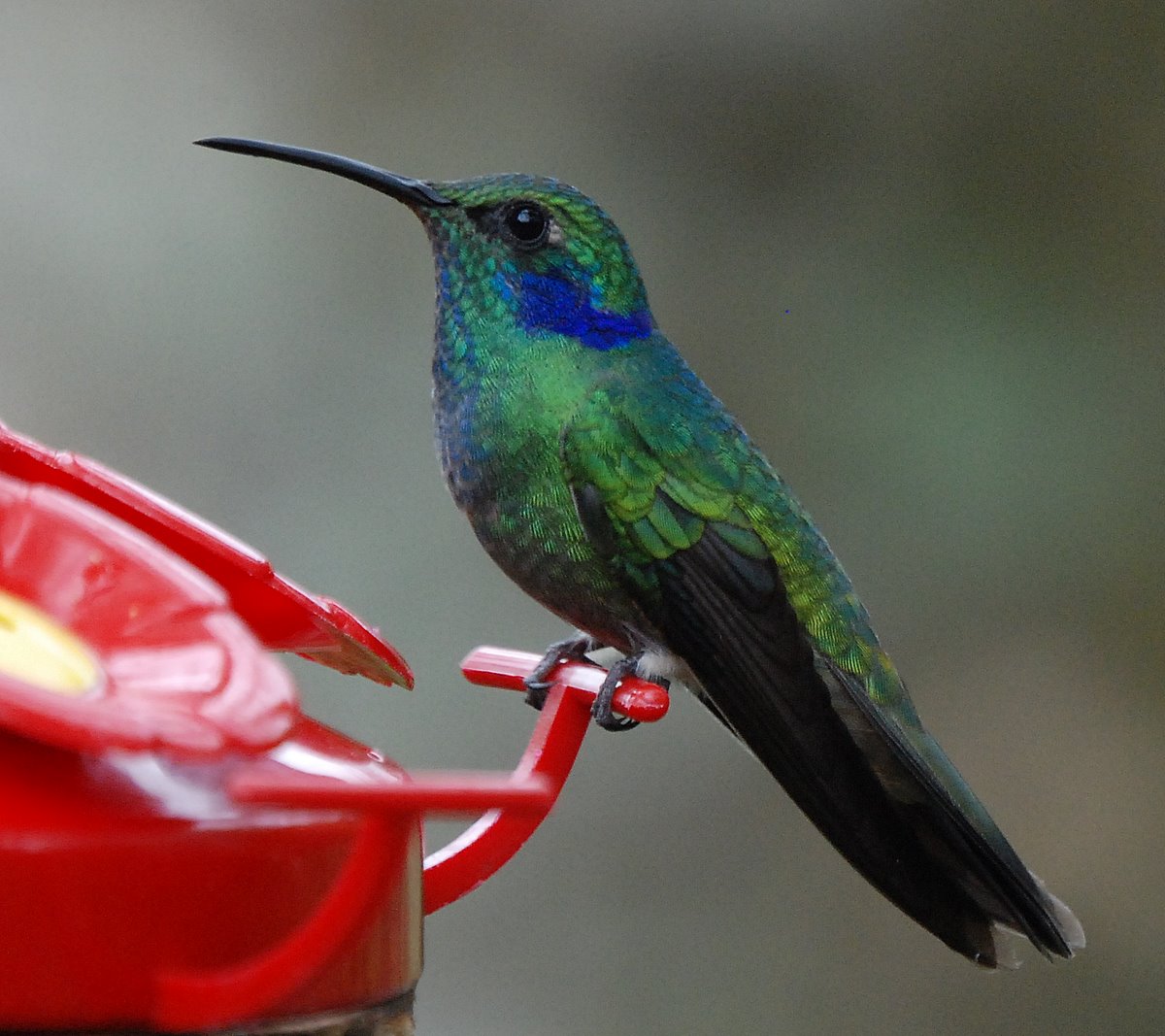
Wikipedia: Mexican violetear Source: OTHER
GreenVioletear.jpg
![]() The Mexican violetear (Colibri thalassinus) is a medium-sized, metallic green hummingbird species commonly found in forested areas from Mexico to Nicaragua. This species, together with the lesser violetear were previously considered conspecific, and together called the green violetear.
[more]
The Mexican violetear (Colibri thalassinus) is a medium-sized, metallic green hummingbird species commonly found in forested areas from Mexico to Nicaragua. This species, together with the lesser violetear were previously considered conspecific, and together called the green violetear.
[more]
Profile Wikipedia eBird Audubon AllAboutBirds Xeno-Canto

Wikipedia: Lucifer hummingbird Source: OTHER
1200px-Lucifer_hummingbird_-_Flickr_-_GregTheBusker_%281%29.jpg
![]() The lucifer sheartail or lucifer hummingbird (Calothorax lucifer) is a medium-sized, 10 cm long, green hummingbird with a slightly curved bill and distinctive outward flare of its gorget feathers. Its habitat is in high-altitude areas of northern Mexico and southwestern United States. It winters in central Mexico.
[more]
The lucifer sheartail or lucifer hummingbird (Calothorax lucifer) is a medium-sized, 10 cm long, green hummingbird with a slightly curved bill and distinctive outward flare of its gorget feathers. Its habitat is in high-altitude areas of northern Mexico and southwestern United States. It winters in central Mexico.
[more]
Profile Wikipedia eBird Audubon AllAboutBirds Xeno-Canto

Wikipedia: Rivoli's hummingbird Source: OTHER
MagnificentHummingbird.jpg
![]() Rivoli's hummingbird (Eugenes fulgens) is a large hummingbird. It was usually considered the only member of the genus Eugenes and is also called the magnificent hummingbird. Many taxonomic authorities, such as the International Ornithological Committee, split the northern nominate subspecies E. f. fulgens from the larger southern race of Costa Rica and Panama, E. f. spectabilis, into distinct species,[2] in which case the nominate fulgens is renamed Rivoli's hummingbird and spectabilis is named the Talamanca hummingbird or admirable hummingbird.
[more]
Rivoli's hummingbird (Eugenes fulgens) is a large hummingbird. It was usually considered the only member of the genus Eugenes and is also called the magnificent hummingbird. Many taxonomic authorities, such as the International Ornithological Committee, split the northern nominate subspecies E. f. fulgens from the larger southern race of Costa Rica and Panama, E. f. spectabilis, into distinct species,[2] in which case the nominate fulgens is renamed Rivoli's hummingbird and spectabilis is named the Talamanca hummingbird or admirable hummingbird.
[more]

Wikipedia: Broad-billed hummingbird Source: OTHER
1200px-Broad-billed_Hummingbird_%2833591583320%29.jpg
![]() The broad-billed hummingbird (Cynanthus latirostris) is a small-sized hummingbird that resides in Mexico and the southwestern United States.[2] The bird displays sexual dimorphism, and the juveniles resemble the female adult more than the male adult. The broad-billed hummingbird is a bright coloured bird with a broad and bright red bill. The bird is also known for its other common names – the Colibrí Pico Ancho in Spanish and Colibri circé in French.[3] It is a diurnal bird.[3]
[more]
The broad-billed hummingbird (Cynanthus latirostris) is a small-sized hummingbird that resides in Mexico and the southwestern United States.[2] The bird displays sexual dimorphism, and the juveniles resemble the female adult more than the male adult. The broad-billed hummingbird is a bright coloured bird with a broad and bright red bill. The bird is also known for its other common names – the Colibrí Pico Ancho in Spanish and Colibri circé in French.[3] It is a diurnal bird.[3]
[more]

Wikipedia: Common poorwill Source: OTHER
1200px-Common_Poorwill.jpg
![]() The common poorwill (Phalaenoptilus nuttallii) is a nocturnal bird of the family Caprimulgidae, the nightjars. It is found from British Columbia and southeastern Alberta, through the western United States to northern Mexico. The bird's habitat is dry, open areas with grasses or shrubs, and even stony desert slopes with very little vegetation.
[more]
The common poorwill (Phalaenoptilus nuttallii) is a nocturnal bird of the family Caprimulgidae, the nightjars. It is found from British Columbia and southeastern Alberta, through the western United States to northern Mexico. The bird's habitat is dry, open areas with grasses or shrubs, and even stony desert slopes with very little vegetation.
[more]
Profile Wikipedia eBird Audubon AllAboutBirds Xeno-Canto

Wikipedia: Antillean nighthawk Source: OTHER
1200px-Antillean_Nighthawk_%28Chordeiles_gundlachii%29%3B_with_distinctive_white_patch%2C_resting_in_Cabo_Rojo_National_Wildlife_Refuge%2C_Puerto_Rico.JPG
![]() The Antillean nighthawk (Chordeiles gundlachii) is a nightjar native to the Caribbean, The Bahamas, and Florida Keys.
[more]
The Antillean nighthawk (Chordeiles gundlachii) is a nightjar native to the Caribbean, The Bahamas, and Florida Keys.
[more]

Wikipedia: Common nighthawk Source: OTHER
1200px-Common_Nighthawk_%2814428313550%29.jpg
![]() The common nighthawk (Chordeiles minor) is a medium-sized [3][4] crepuscular or nocturnal bird[3][5] of the Americas within the nightjar family, whose presence and identity are best revealed by its vocalization. Typically dark[3] (grey, black and brown),[5] displaying cryptic colouration and intricate patterns, this bird is difficult to spot with the naked eye during the day. Once aerial, with its buoyant but erratic flight, this bird is most conspicuous. The most remarkable feature of this aerial insectivore is its small beak that belies the massiveness of its mouth. Some claim appearance similarities to owls. With its horizontal stance[3] and short legs, the common nighthawk does not travel frequently on the ground, instead preferring to perch horizontally, parallel to branches, on posts, on the ground or on a roof.[5] The males of this species may roost together but the bird is primarily solitary. The common nighthawk shows variability in territory size.[4]
[more]
The common nighthawk (Chordeiles minor) is a medium-sized [3][4] crepuscular or nocturnal bird[3][5] of the Americas within the nightjar family, whose presence and identity are best revealed by its vocalization. Typically dark[3] (grey, black and brown),[5] displaying cryptic colouration and intricate patterns, this bird is difficult to spot with the naked eye during the day. Once aerial, with its buoyant but erratic flight, this bird is most conspicuous. The most remarkable feature of this aerial insectivore is its small beak that belies the massiveness of its mouth. Some claim appearance similarities to owls. With its horizontal stance[3] and short legs, the common nighthawk does not travel frequently on the ground, instead preferring to perch horizontally, parallel to branches, on posts, on the ground or on a roof.[5] The males of this species may roost together but the bird is primarily solitary. The common nighthawk shows variability in territory size.[4]
[more]
Profile Wikipedia eBird Audubon AllAboutBirds Xeno-Canto

Wikipedia: Lesser nighthawk Source: OTHER
1200px-Chordeiles_acutipennis_-_Lesser_Nighthawk.jpg
![]() The lesser nighthawk (Chordeiles acutipennis) is a nightjar found throughout a large part of the Americas.
[more]
The lesser nighthawk (Chordeiles acutipennis) is a nightjar found throughout a large part of the Americas.
[more]

Wikipedia: Chuck-will's-widow Source: OTHER
1200px-Chuck-wills-widow_RWD7.jpg
![]() The chuck-will's-widow (Antrostomus carolinensis) is a nocturnal bird of the nightjar family Caprimulgidae. It is found in the southeastern United States near swamps, rocky uplands, and pine woods. It migrates to the West Indies, Central America, and northwestern South America.
[more]
The chuck-will's-widow (Antrostomus carolinensis) is a nocturnal bird of the nightjar family Caprimulgidae. It is found in the southeastern United States near swamps, rocky uplands, and pine woods. It migrates to the West Indies, Central America, and northwestern South America.
[more]

Wikipedia: Eastern whip-poor-will Source: OTHER
Caprimulgus_vociferusAAP065B.jpg
![]() The eastern whip-poor-will (Antrostomus vociferus) is a medium-sized (22–27 cm) nightjar from North America. The whip-poor-will is commonly heard within its range, but less often seen because of its camouflage. It is named onomatopoeically after its song.[2]
[more]
The eastern whip-poor-will (Antrostomus vociferus) is a medium-sized (22–27 cm) nightjar from North America. The whip-poor-will is commonly heard within its range, but less often seen because of its camouflage. It is named onomatopoeically after its song.[2]
[more]

Wikipedia: Mexican whip-poor-will Source: OTHER
1200px-Antrostomus_arizonae.jpg
![]() The Mexican whip-poor-will, (Antrostomus arizonae), is a medium-sized (22–27 cm) nightjar from the southwestern United States and Mexico.[2] The whip-poor-will is more often heard within its range, but less often seen. It is named onomatopoeically after its song.[3]
[more]
The Mexican whip-poor-will, (Antrostomus arizonae), is a medium-sized (22–27 cm) nightjar from the southwestern United States and Mexico.[2] The whip-poor-will is more often heard within its range, but less often seen. It is named onomatopoeically after its song.[3]
[more]

Wikipedia: Buff-collared nightjar Source: OTHER
Buff-collared_Nightjar.jpg
![]() Caprimulgus ridgwayi
[more]
Caprimulgus ridgwayi
[more]
Classification errors:
Double-crested cormorant / Ohrenscharbe (Nannopterum auritum)
Double-crested cormorants hang out on the lightpost in Campeche. 2023-04-06 16.59.40 Yucatan
First observed in Yucatan on 2023-04-06.
![]() The double-crested cormorant (Phalacrocorax auritus) is a member of the cormorant family of water birds. Its habitat is near rivers and lakes as well as in coastal areas, and is widely distributed across North America, from the Aleutian Islands in Alaska down to Florida and Mexico. Measuring 70–90 cm (28–35 in) in length, it is an all-black bird which gains a small double crest of black and white feathers in breeding season. It has a bare patch of orange-yellow facial skin. Five subspecies are recognized. It mainly eats fish and hunts by swimming and diving. Its feathers, like those of all cormorants, are not waterproof and it must spend time drying them out after spending time in the water. Once threatened by the use of DDT, the numbers of this bird have increased markedly in recent years.
[more]
The double-crested cormorant (Phalacrocorax auritus) is a member of the cormorant family of water birds. Its habitat is near rivers and lakes as well as in coastal areas, and is widely distributed across North America, from the Aleutian Islands in Alaska down to Florida and Mexico. Measuring 70–90 cm (28–35 in) in length, it is an all-black bird which gains a small double crest of black and white feathers in breeding season. It has a bare patch of orange-yellow facial skin. Five subspecies are recognized. It mainly eats fish and hunts by swimming and diving. Its feathers, like those of all cormorants, are not waterproof and it must spend time drying them out after spending time in the water. Once threatened by the use of DDT, the numbers of this bird have increased markedly in recent years.
[more]
Ruby-crowned kinglet (Corthylio calendula)
Profile Wikipedia eBird A-Z Animals Audubon AllAboutBirds Xeno-Canto
Ruby-crowned kinglet. 2022-04-29 10.02.10 Maryland
First observed in Maryland on 2022-04-29.
![]() The ruby-crowned kinglet (Regulus calendula) is a very small passerine bird found throughout North America. It is a member of the kinglet family. The bird has olive-green plumage with two white wing bars and a white eye-ring. Males have a red crown patch, which is usually concealed. The sexes are identical (apart from the crown), and juveniles are similar in plumage to adults. It is one of the smallest songbirds in North America. The ruby-crowned kinglet is not closely related to other kinglets, and is put in its own subgenus, Corthylio. Three subspecies are currently recognized.
[more]
The ruby-crowned kinglet (Regulus calendula) is a very small passerine bird found throughout North America. It is a member of the kinglet family. The bird has olive-green plumage with two white wing bars and a white eye-ring. Males have a red crown patch, which is usually concealed. The sexes are identical (apart from the crown), and juveniles are similar in plumage to adults. It is one of the smallest songbirds in North America. The ruby-crowned kinglet is not closely related to other kinglets, and is put in its own subgenus, Corthylio. Three subspecies are currently recognized.
[more]